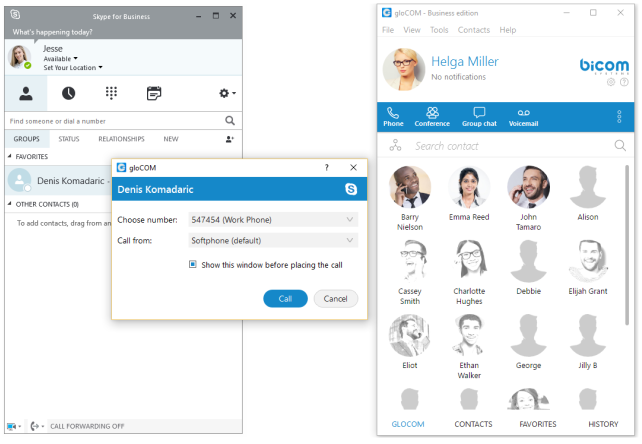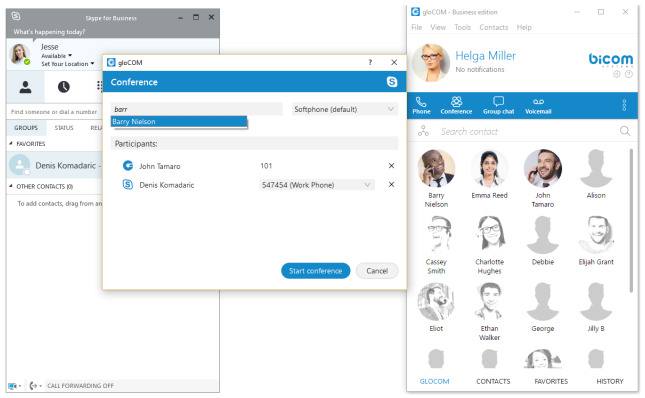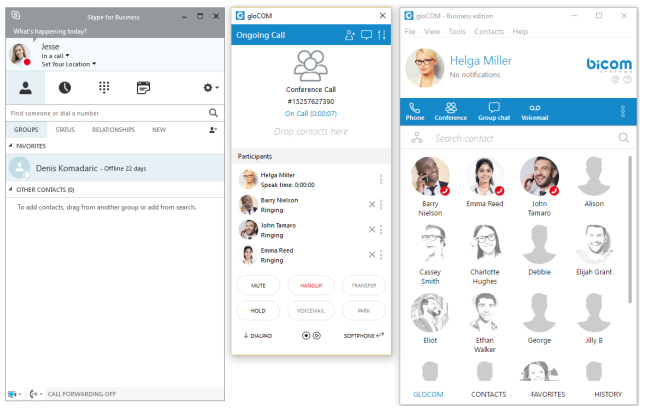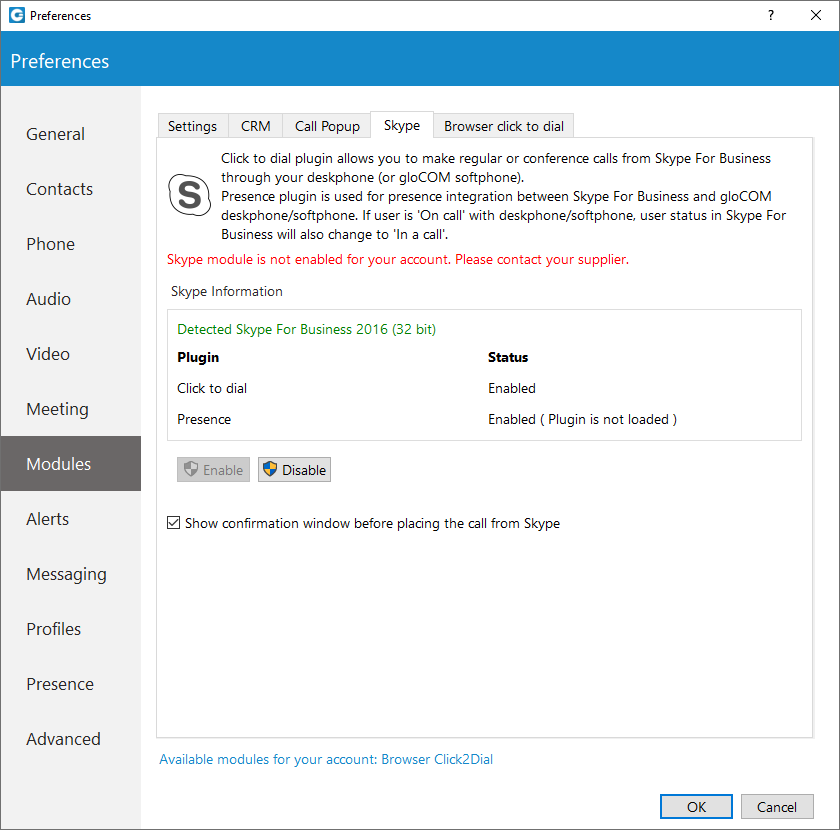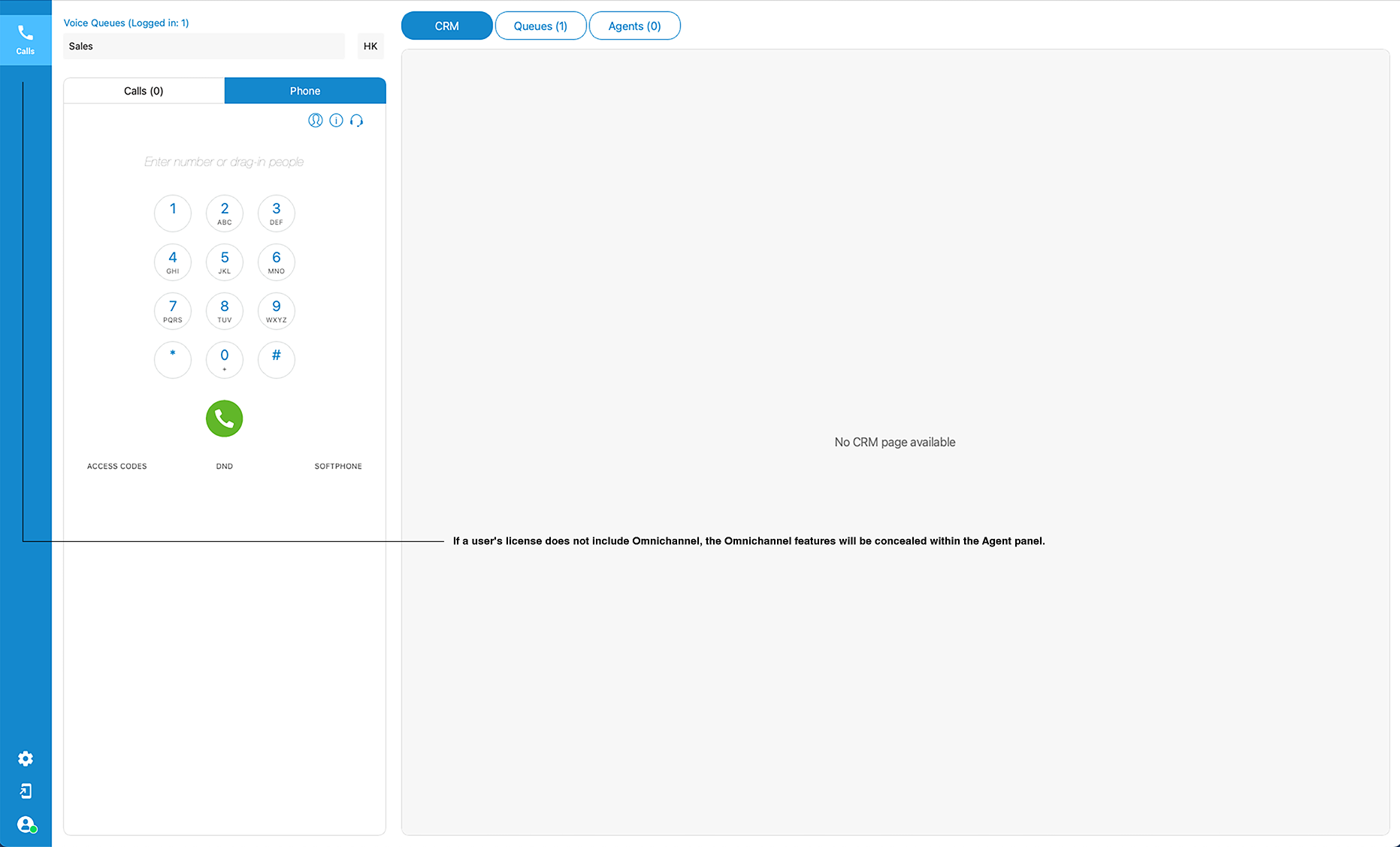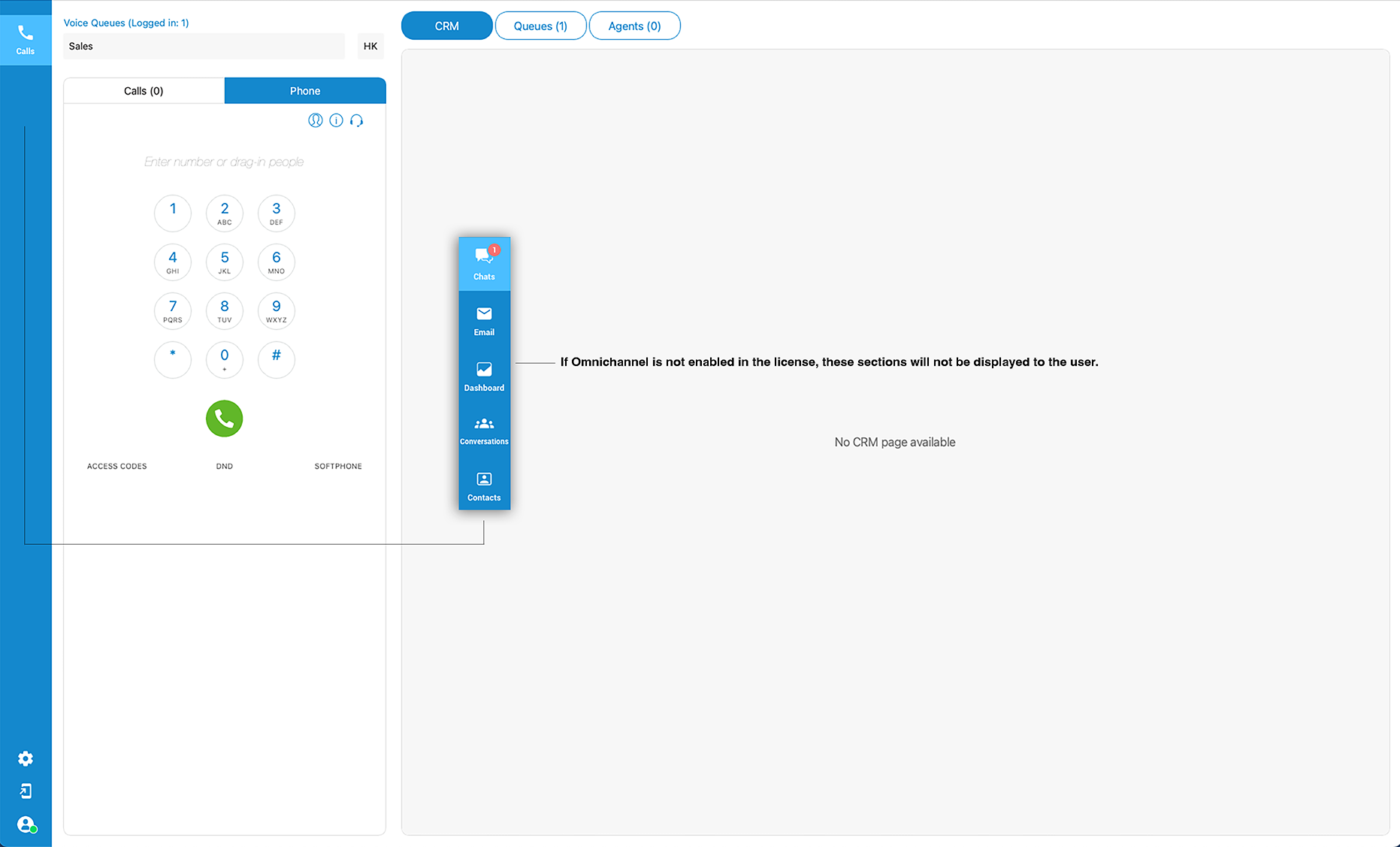¶ Installation
We suggest to always use the standard setup.exe instead of the MSI package if possible because the standard setup.exe takes care of prerequisites and installs them automatically for the user.
Please download gloCOM 7.2 from our official website www.bicomsystems.com. After the download is finished, click on the icon to start the installation.
The welcome window starts the installation process. Click on the Next button to proceed with the installation or click on the Cancel button to exit the installation wizard.
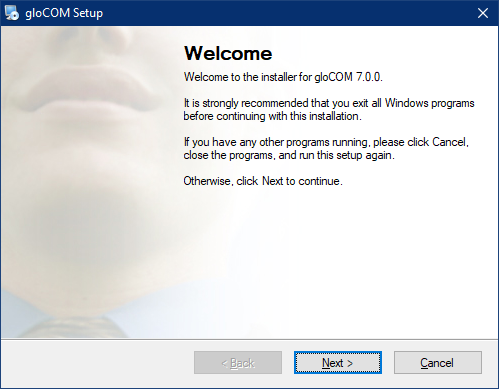
Read the license agreement and select I agree if you accept the License Agreement. Click on the Next button to proceed with the installation or click on the Cancel button to exit the installation wizard.
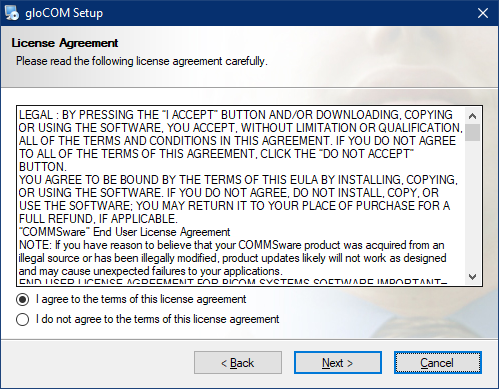
The Installation Folder window sets the default location where the gloCOM installation will reside. By default C:\Program Files\Bicom Systems\gloCOM is offered. To select a different location, click on the Change button. When done, click on the Next button to proceed with the installation or click on the Cancel button to exit the installation wizard.
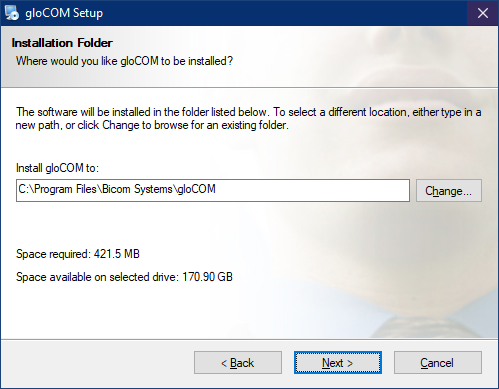
The Shortcut Folder window sets how the gloCOM shortcut will be displayed on the Windows Start menu. Select the preferred shortcut under the Shortcut Folder select box and click on the Next button to proceed with the installation, or click on the Cancel button to exit the installation wizard.
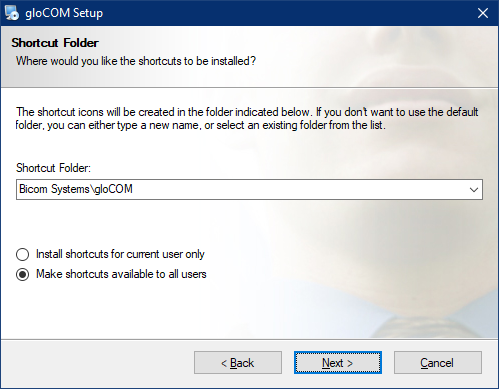
The Ready-to-Install window summarizes the Installation wizard steps and displays all of the selected options. If you agree with these, click on the Next button to proceed with the installation or click on the Cancel button to exit the installation wizard.
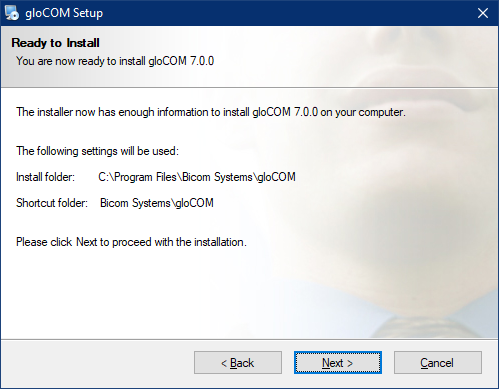
The Installing gloCOM window shows the installation in progress.
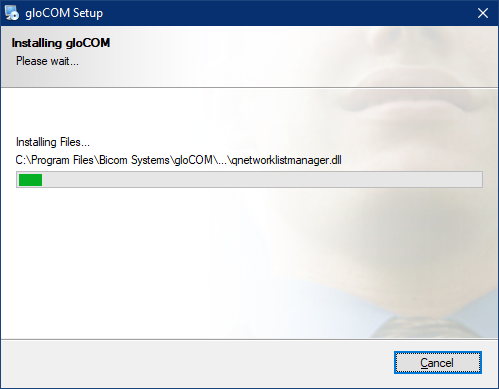
After this step, you'll see the Installation Successful window. Click on the Finish button to close the window and finish the installation.
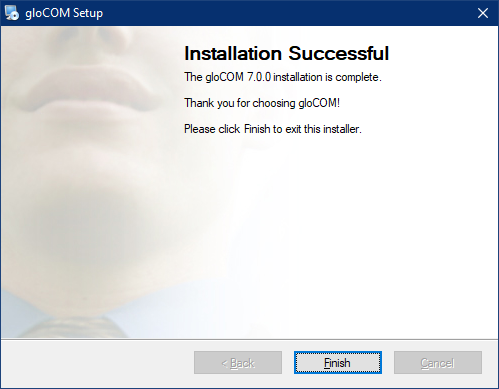
¶ MSI package Installation
In order to install gloCOM from an MSI package, the following are the prerequisites and must be installed before MSI package :
-
Microsoft .NET Framework 4 (or above) (optional, if the user wants to use functionalities like Outlook plugin, Skype For Business integration etc...)
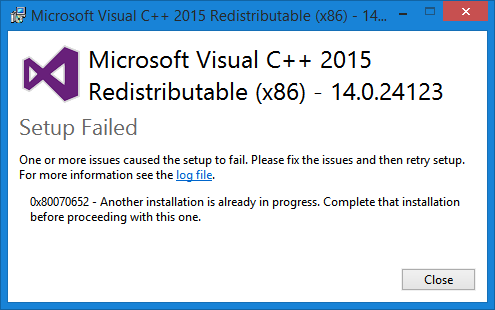
If there is no Visual C++ installed users might get installation errors.
IMPORTANT: Windows Terminal Server installation
¶ Configuring gloCOM
After the installation process, you need to configure gloCOM. Click on the gloCOM icon and the Profile Wizard will appear. To continue with the configuration click the Next button.
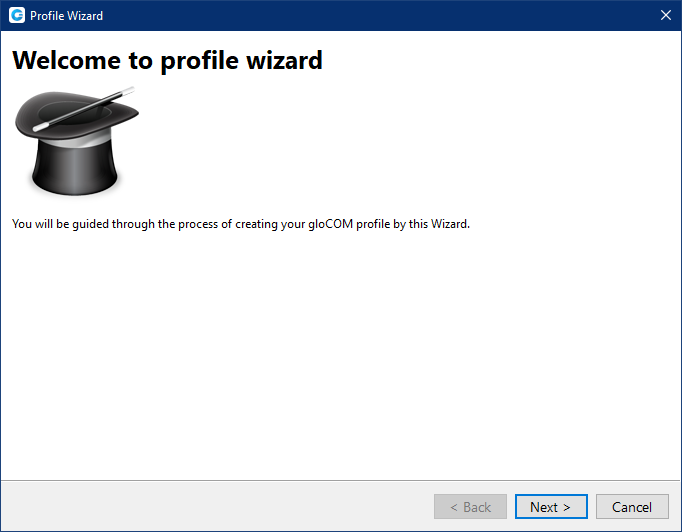
1. Account details
Make sure you have received your account details from your system administrator or account manager.
The received details must include:
Account
- E-mail: for example example@bicomsystems.com
- User password: for example 93sU2e_2%
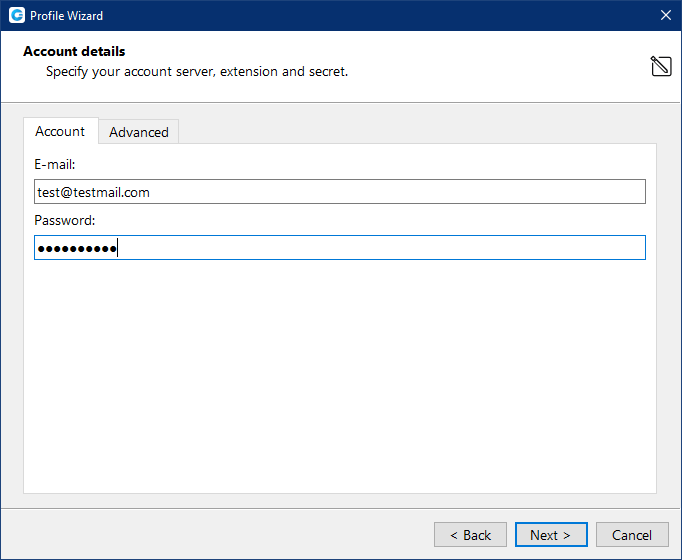
Advanced
- Server address: The user can enter the DNS domain or the server address (for example: voip.test.com or 134.23.211.23). In the case of the DNS domain, the application will perform a DNS SRV lookup, and it will try to connect to each server that the application obtains based on their priorities. In the case of the server address, the application will try to connect directly to the given address.
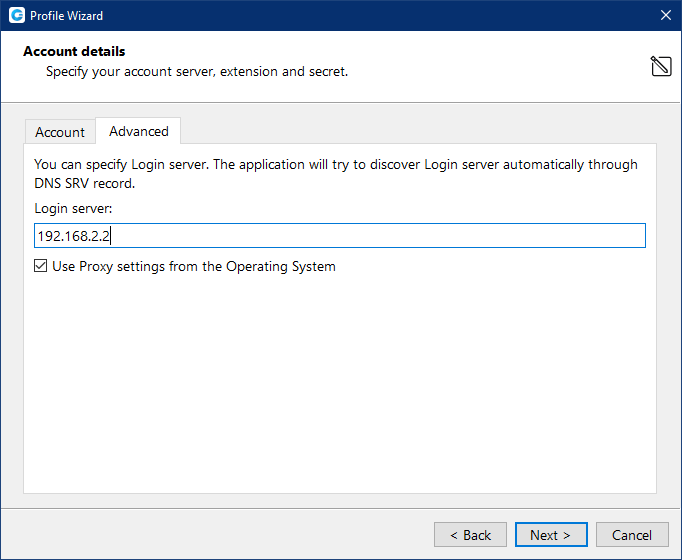
Your administrator can set up a DNS domain for SRV lookup on the server-side. SIP registration will be done for all obtained records, and the first one that succeeds will be in use. This way, failover can be performed for scenarios with more than one SBC. In that case, if the primary SBC goes down, the second one will be in use.
From gloCOM 6.0, instead of an extension and secret, users will provide their e-mail assocciated with extension and User password.
After you click Next, gloCOM will try to connect to the specified server with the user's account details. If the account details are wrong, a red warning will appear. Otherwise, a Change Password pop-up window will appear telling you to change your password since this is the first time you are logging in. Your password has to be at least 8 characters and 85% secure. Users are required to change this password on login and once changed it is hashed and unknown to all administrators of the system.
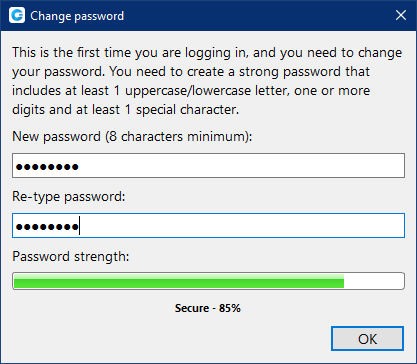
2. gloCOM edition
Select gloCOM edition. You may choose between Office, Business, Agent (Call Center), or Supervisor (Call Center).
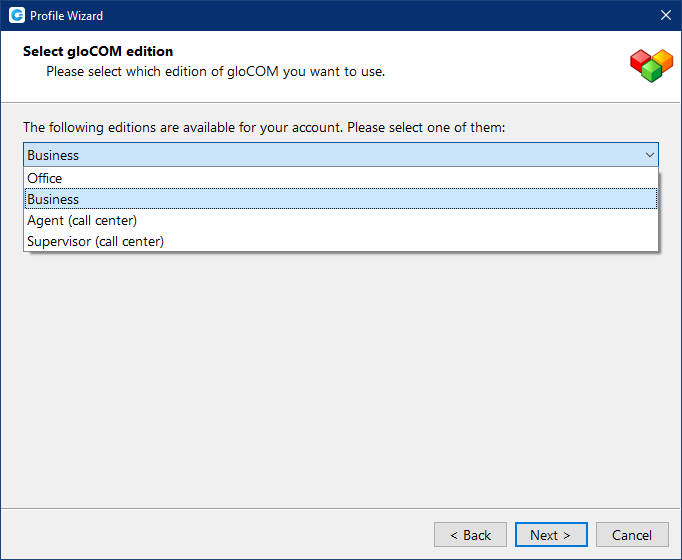
3. Setup office and mobile phone
Setup your Office phones. If you choose softphone, you will be able to place and receive calls using your computer. If you choose desk phone, you can control calls on your IP desk phone from your computer. Selecting the checkboxes for both desk phone and softphone will allow users to switch between devices when initiating a call and also to pick which device they would like to answer incoming calls on.
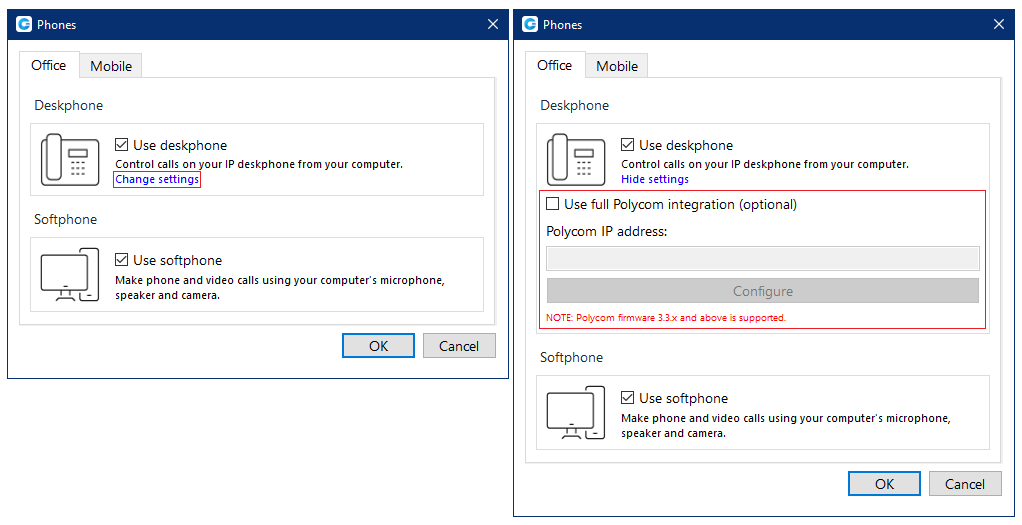
If you use Polycom phones, click on Change settings. Provide the phone's IP address and click Configure. This will help gloCOM to identify and configure Polycom phones.
In gloCOM, users can assign Mobile Numbers that they would like to receive calls on when not at their desk. Click the Mobile tab and click + icon to add Mobile phone number and it’s label.
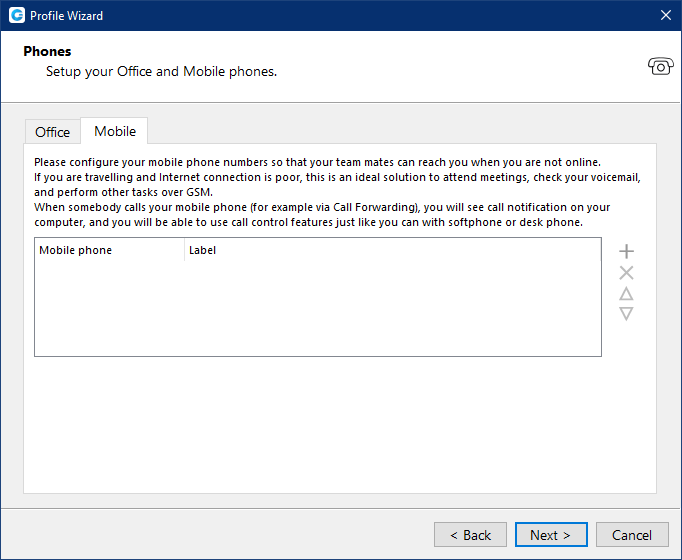
The entered Mobile phone number can be with or without the plus(+) sign.
Click the Next button and a configuration summary window will appear. Please check the profile details and make sure they are correct.
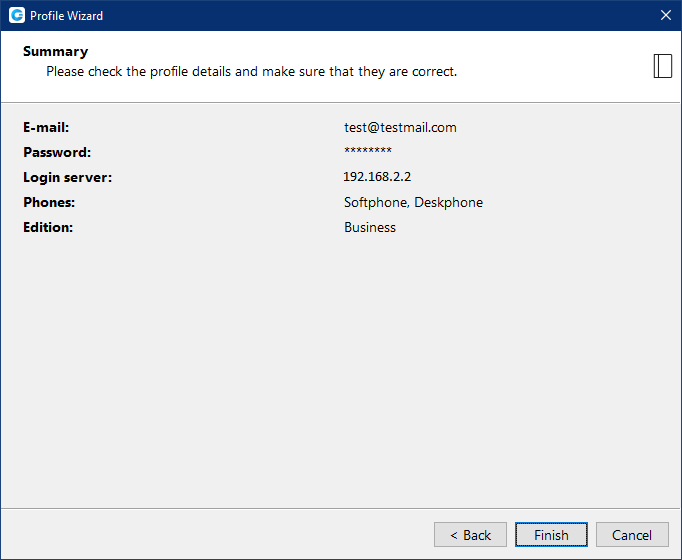
Click the Finish button and you will be automatically logged in with your account. Now you are ready to use gloCOM with all its features.
¶ Working with gloCOM
¶ Log In
- E-mail: Provide the e-mail address that is assigned to your extension.
- Password: Enter the password that you created during the gloCOM configuration.
- Remember password Check if you want gloCOM to save your password.
- Log In automatically on startup: When this option is turned on, gloCOM will log in automatically. Every time gloCOM is started, it will automatically log in.
- Forgot my password: If the user forgets their password, they can recover it by clicking the Forgot my Password link. The user will receive a password recovery link via email.
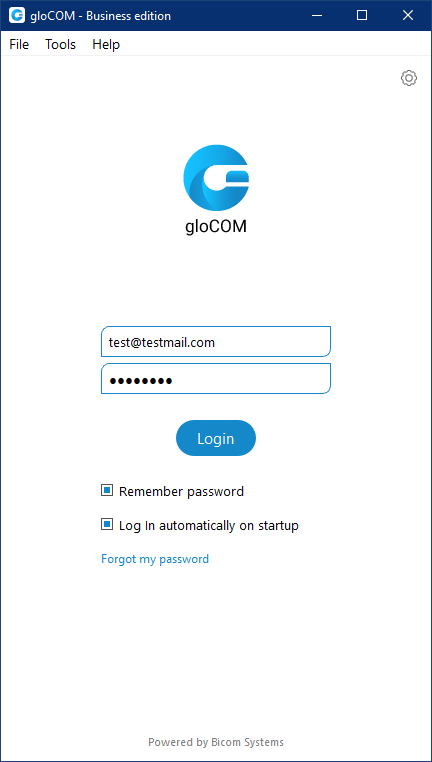
Please bear in mind that one can use only one email address associated with a single extension. Using the same email address for multiple extensions is not supported.
- Login Failure message: In case of invalid credentials, a message will appear displaying the following: "Login Failed: Username or Password is Incorrect".
Login options for Agent/Supervisor edition
-
Agent number: Enter the Agent number received from your PBXware administrator.
-
Agent pin: Enter the Agent pin received from your PBXware administrator.
-
 Enable/disable Agent login details (only for Supervisor edition).
Enable/disable Agent login details (only for Supervisor edition).
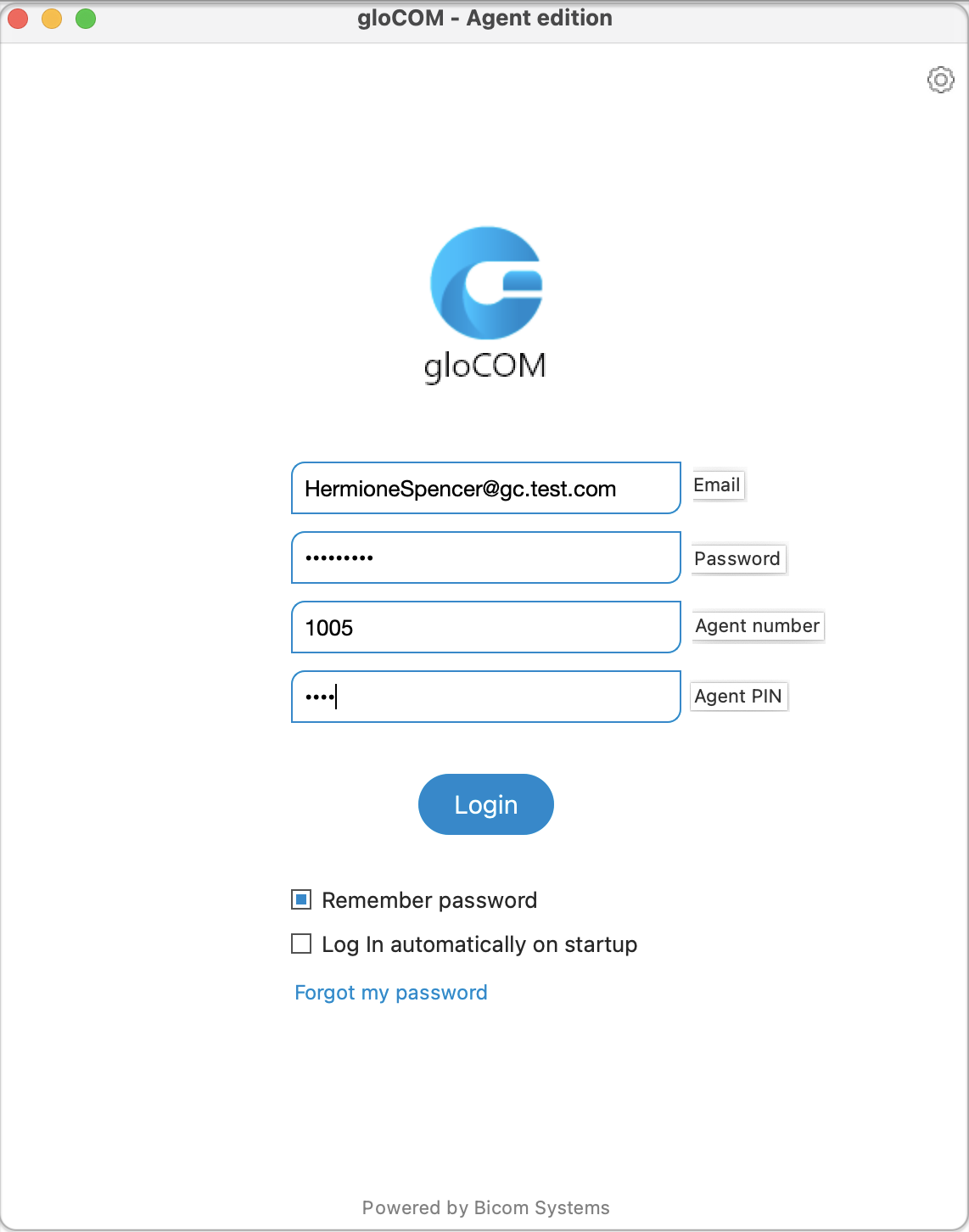
PBXware administrator defines the Agent number and the Agent pin through the PBXware GUI.
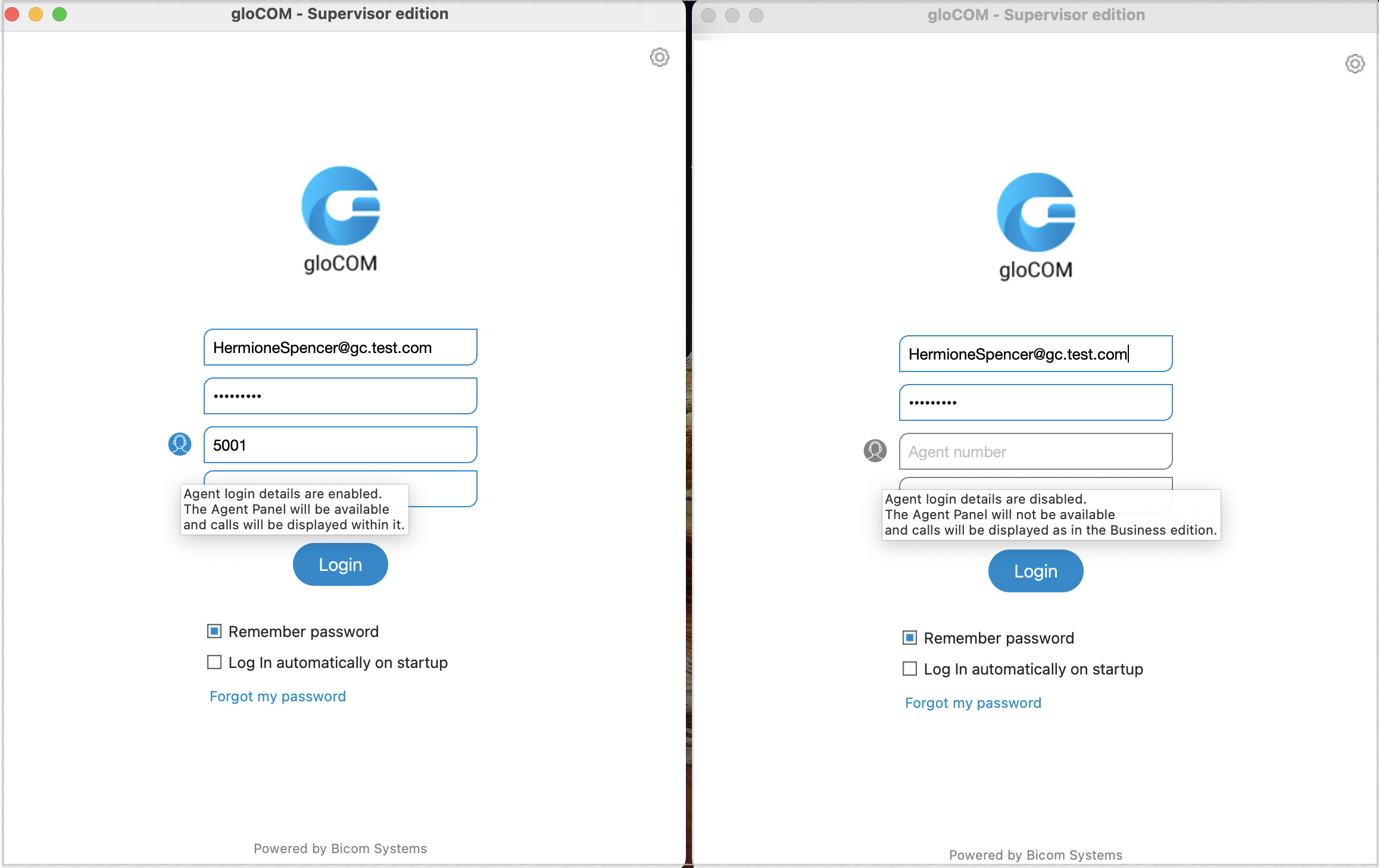
In the Agent and the Supervisor edition (if Agent options are enabled), a valid Agent number and PIN must be entered in order to log in to the application.
¶ SSL Certificate
When connecting to the server with an insecure/invalid certificate, a warning message appears asking permission to connect.
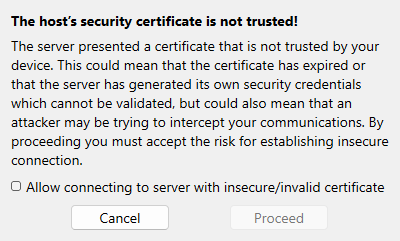
Once permission has been granted, the app will connect, changing the configuration for the server the user was trying to connect to. The app will not ask the user for permission on the next login.
However, this configuration can be modified by navigating to the Preferences -> Advanced section and turning the "Allow connecting to server with insecure/invalid certificate" option off, allowing the application to ask the user for permission on the next login. This option is turned off by default, which means it will not allow insecure connections.
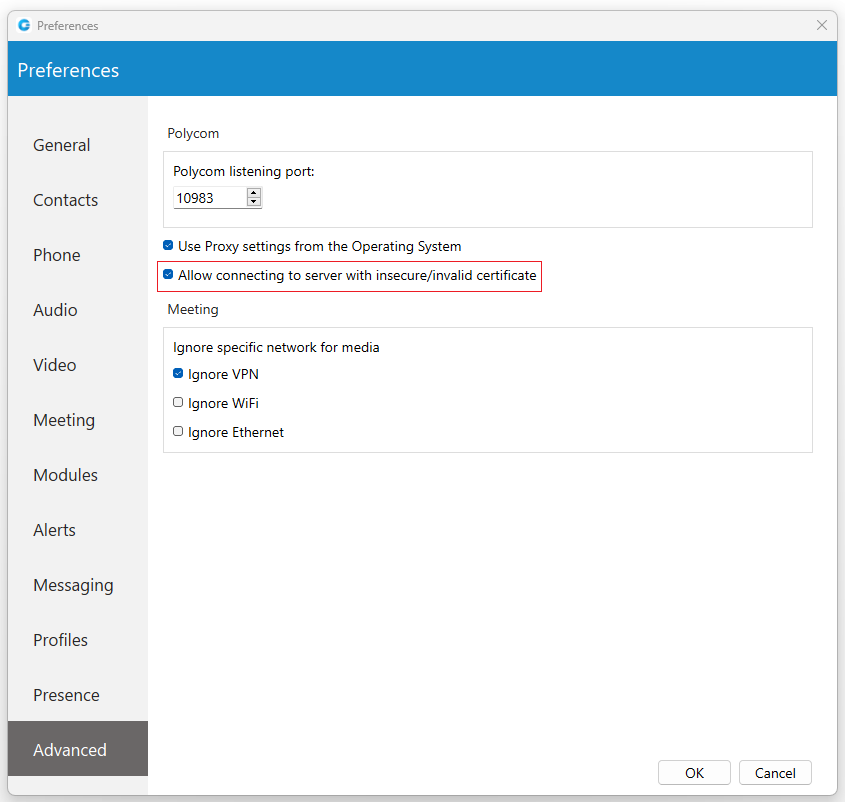
¶ Two-Factor Authentication (2FA) on Login
2FA is an additional layer of security used to ensure that users trying to gain access to an online account are who they say they are. First, a user will enter their username and password. Then, instead of immediately gaining access, they will be asked to provide a code generated by the authenticator app to proceed with the login.
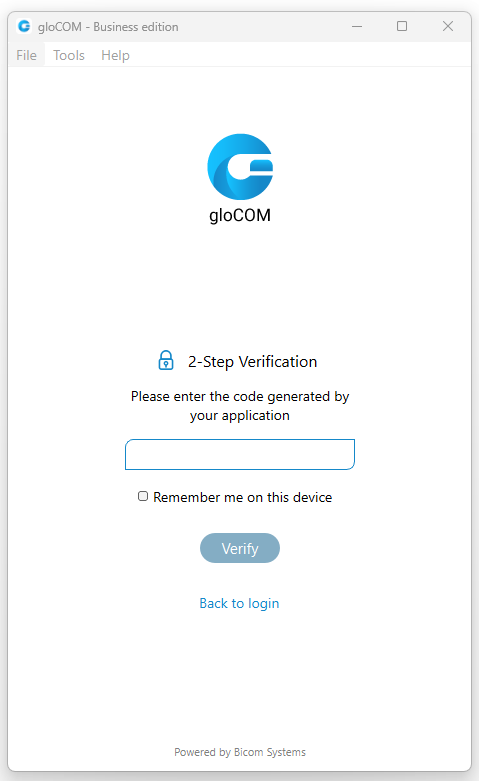
To set 2FA up, log in to the app, navigate to Online Self Care, click the 2-Step Verification button, and follow the instructions.
In case the user has not set up 2FA and if 2FA has been enforced on the server side, the following message will be displayed after clicking the Login button: "2-Step Verification needs to be configured on the Online self care to proceed with login. Configure it now.". Otherwise, the user can access the app by entering their username and password.
After setting 2FA up, on the next login, the user will be asked to provide the code generated by the authenticator app in order to proceed with the login. Also, users can check the "Remember me on this device" option, so they do not have to enter the 2FA code every time they try to log in.
Clicking the Remembered devices button within Online Self Care displays a list of all of the user's currently logged devices. Clicking the Logout button will log the user out of the desired device.
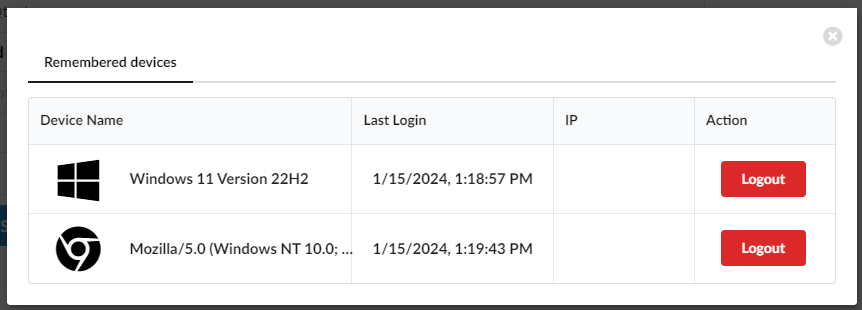
Older versions of the app do not support 2FA.
2FA verification can be reset through Online Self Care. Also, it can be reset by the server administrator.
¶ Toolbar
- User image: Represents the user’s profile image that can be changed at any time. Clicking on it brings a Personal Information window. Click the avatar image and select the new image from a computer as a new avatar image. gloCOM now supports higher resolution avatars, allowing users to set up resolution between 256x256 and 512x512 pixels.
- Username: Represents the user name displayed within the application.
- Notifications: Displays any notifications (unread messages, missed calls, pending meeting invites, new voicemails), otherwise displays No notifications.
- Phone: Opens a softphone window next to the gloCOM main window.
- Voice Conference: Opens a Voice conference window next to the gloCOM main window.
- Chat: Opens a Chat window with all user's conversations.
- Voicemail: Opens a Voicemail window next to the gloCOM main window.
- SMS: Opens a SMS window with all user's conversations.
- Fax: Offers the choice to send a fax or view received faxes. Based on the user's choice, an additional window will open next to gloCOM.
- Personal Dialer: Opens a Dialer window next to the gloCOM main window.
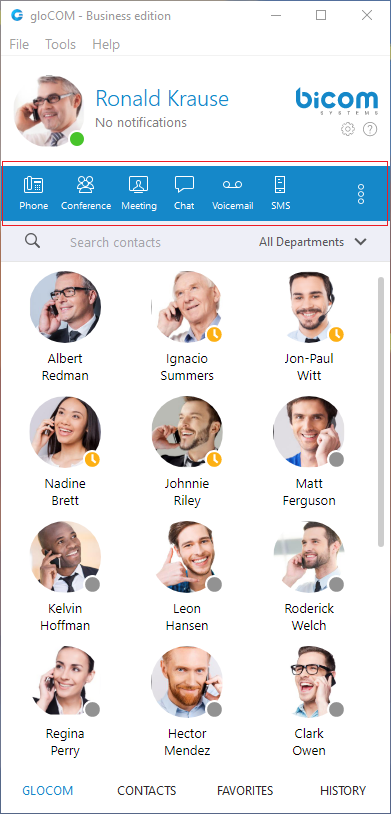
To get access to the Fax and My Dialer modules, please contact your Administrator.
![]()
- Surveillance Camera: Opens up a Surveillance Camera preview. This option will work only if the user has their surveillance camera set up on the IP address in Tools --> Preferences --> Video --> Surveillance Camera.
- Online Self Care: In order to login to Online Self Care, the user needs to point their browser to: http://$IPADDRESS/ (For Example: http://192.168.1.1/).
- Email: The email address assigned to the extension (ex. The provided email address is used as a username for logging into Online Self Care (e.g. email@example.com)) ([a-z] [0-9] [@_.-]).
- Password: Password assigned to the extension ([a-z] [0-9] [@_.-]).
- Parked calls: Once a call is parked, anyone can pick it up by pressing the Pick Call button next to the parked call or dialing the number of the parked extension. On the PBXware, a default parking lot is defined within the Access Codes section. Pressing the Park button during a call will display a drop-down menu that allows the user to select a parking lot.
The user can filter parked calls by checking the option "Show my calls only". This way, they will see only their parked calls within the parked calls window.
- Show Login QR Code: Show Login QR Code as a part of the gloCOM Desktop allows users easier login to their mobile app by scanning QR Code generated by the gloCOM Desktop app.
- Preferences: Opens a Preferences window. Refer to the Preferences chapter for detailed instructions.
- Help: Redirects to our official website: www.bicomsystems.com. Additional documentation and guides are available on our official website www.bicomsystems.com If you still have any questions, please feel free to contact our support department.
- Reset Profile picture to Default: Allows users to reset their profile picture to the default value (no profile picture). Clicking on the avatar image within the Personal Information dialog opens a pop-up window with the following options: Change Avatar, Reset to default avatar, and Cancel. Clicking the Reset to default avatar option resets the profile image to its default value.
If the user has not set their avatar image, clicking the default avatar image within the Personal Information dialog opens File Explorer (Finder on macOS) window, which allows them to select their avatar image.
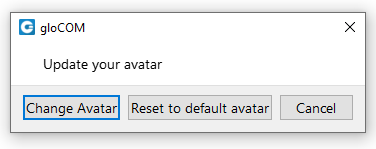
If the SMS feature is not included in the license, you will not see the SMS module within the gloCOM toolbar.
System notification provides the user with some important information about the system. For example, the user is using an outdated version of the application. The notification will be shown every time the user logs in to the application. To dismiss the notification, click the Dismiss button.
¶ Personal Dialer
Personal Dialer enables users to load a CSV file inside gloCOM and to dial numbers from that file one after another. This is useful for people who dial the same list of numbers every day, so they don’t have to copy-paste each number. When you open the Personal Dialer module, you are presented with this window:
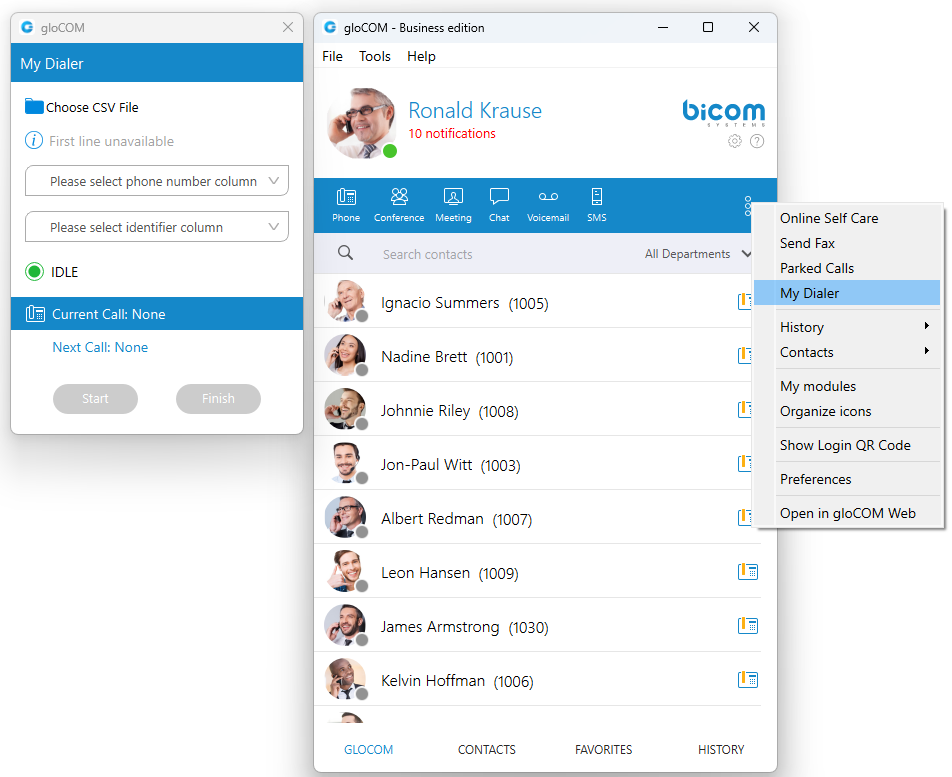
After loading a file first line from the file is shown in the info section, so a user can have a preview of the file structure. Then they have to select the phone number column, so gloCOM knows what to dial. Optionally they can choose an identifier column which is useful for labeling numbers with a name.
For example in the file:
- 101, Joana Smith, Street A Miami
- 102, James Tartos, Street B London
The first column would be a number, and the second would be an identifier (person name, company name, etc.). This identifier is used in the Current Call and Next Call labels so a user can have an idea of who is going to be dialed next. After he presses the Start button gloCOM proceeds to call the first number from the list if there are no other calls at the moment. Numbers are being dialed one after another, but a user can pause the dialer at any time if they want to. Dialing is finished after the end of the list is reached, or if a user finishes dialing.
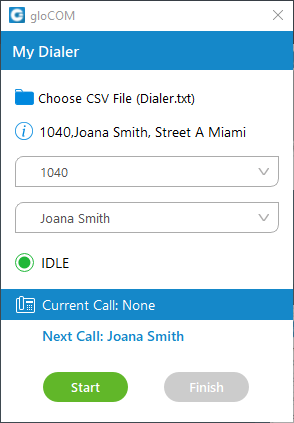
¶ Destinations and gloCOM Modules
gloCOM can place a call to any system destination, for example: extensions, queues, conferences, voicemail, system calls, or parking. Through PBXware GUI an administrator can hide non-gloCOM extensions so they are not displayed in the user list. Calls can be placed with a drag-and-drop motion from one extension to another, or directly from the phone display to the extension, for example. Right-clicking on a contact name offers more possible actions regarding the selected extension.
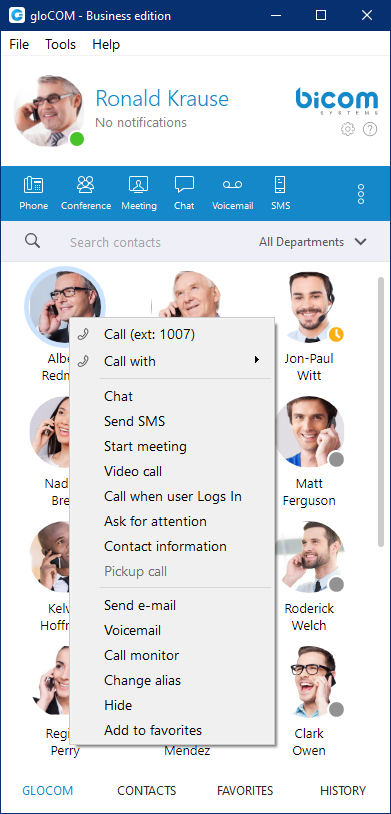
This way the user can:
- Make a call from gloCOM
- Chat with the selected contact
- Start a meeting with the selected contact
- Make a Video Call from gloCOM
- Call the selected contact On Available
- Ask for attention
- See more information about the contact
- Pickup call
- Send an email to a contact
- Leave a Voicemail
- Monitor calls
- Change the contact's alias
- Hide contact
- Add the selected contact to Favorites
¶ Placing Phone Calls
1. Open Phone module
- Click on the Phone module icon to show the Phone module.
2. Dial entering the phone number
- Use the Phone module dial keypad or keys on your keyboard to enter the phone number you want to dial.
- Click on the Dial button to place a call.
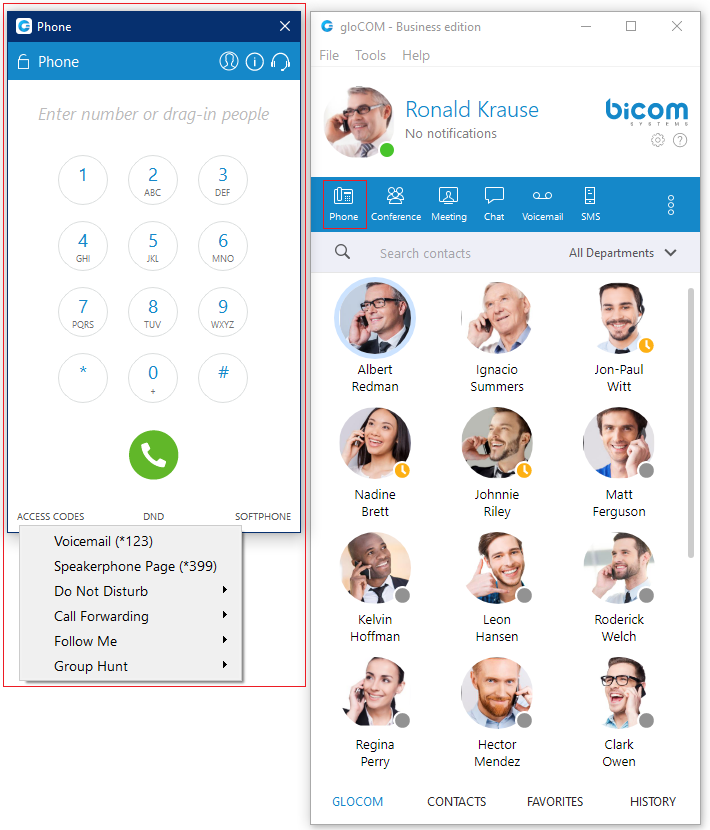
1. PCI compliance
The user is on a phone call with an agent, and the caller needs to perform a payment, he needs to say his credit card obviously. Agents turn on an option in gloCOM that will detect DTMF from the caller, and enter them into a text field by simulating keypress with DTMF digit. This way caller does not send credit card by voice, but rather through DTMF, straight into the field on a website for payment. Inside the call window, there is an icon for activating this feature. After activating, DTMF that other side inputs are written wherever your cursor is positioned. You can stop receiving remote DTMF by either pressing the icon again, click on the Stop Remote DTMF button or by ending the call.
2. Show entered DTMF
This feature enables you to see entered DTMF in the call window, so you can make sure you have entered the correct digits.
3. Dial with Drag and Drop
- With your mouse click and hold any contact from the contact list, then drag the selected contact from the gloCOM list to the phone module area, and Release (Drop) the contact.
- Click the Dial button to place a call.
Live call
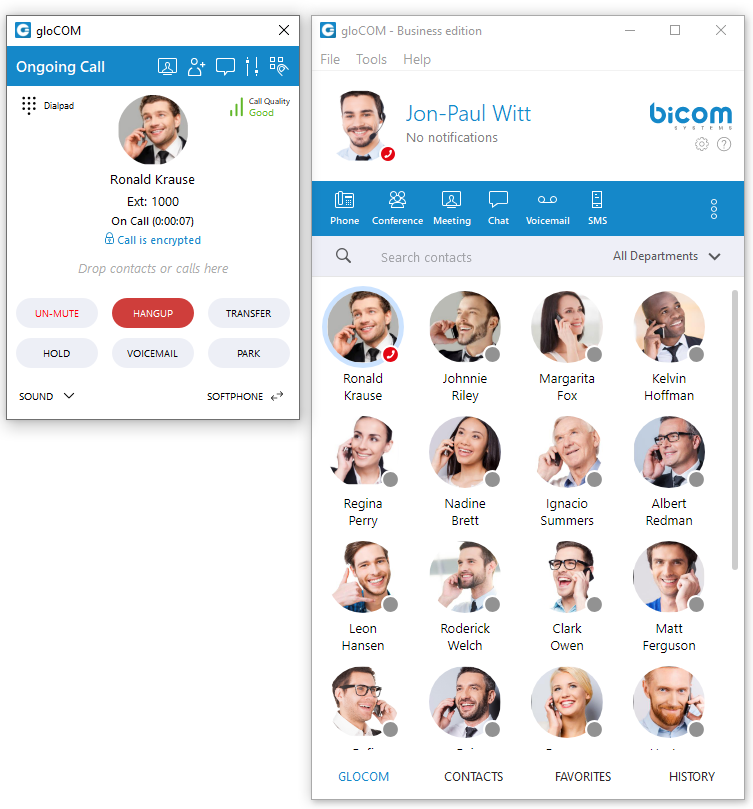
4. Transfer options:
- Blind/transfer to a phone number: Type in some number (i.e. mobile phone) and transfer the call to it.
- Transfer to another ongoing call: If a user has 2 or more active calls, he can transfer the calls from one to another.
- Transfer a call using drag and drop: During a live call, the user can transfer the call by dropping it onto the desired contact inside the contact list. While dragging, a transfer indicator will be displayed. Both transfer types, Blind and Supervised, can be used. The user can select which one they want to use while hovering over the contact. Transfer using the drag-and-drop option does not apply to conference calls.
One simple scenario is:
A gloCOM user is talking to John Doe. He receives a call from Allison Smith while speaking to John Doe. The gloCOM user is now able to add Allison Smith to the existing call with John Doe and all 3 participants will now hear each other.
When trying to transfer a call via gloCOM, when choosing a contact from your list you can now see the google and outlook contacts in a dropdown list. Also, users can press enter to confirm the transfer.
5. Call encryption
During an ongoing call, there is an indicator that shows call encryption if a call is encrypted. Call encryption settings are configured on the server by default, but the user can override them within the gloCOM app by going to Preferences → Phone → Advanced.
There is a checkbox that indicates the use of the default encryption set by the PBX. By unchecking it, the user can change options between TCP, UDP, and TLS. The user is required to log out and log in after changing these options.
The indicator should only be present when the TLS encryption is enabled and if the softphone is in use (in all other cases, the indicator will not be displayed). Clicking it will bring up a pop-up message explaining the encryption.
6. Echo Cancellation
Echo Cancellation as a part of the gloCOM Desktop app is a method used to improve voice quality by preventing an echo from being created or removing it after it is already present.
The time required for Echo Cancellation to start removing echo is up to 10 seconds. It is important to note that the Echo Cancellation only works for softphones.
7. Switch phone
During a live call, you can use the Switch Phone button to initiate ringing across all registered devices or a specific device (softphone, desk phone, and mobile app), so the user can continue the call on another device. A perfect example would be switching from your desk phone to your mobile when you need to leave your office but would like to continue your call. The same applies to conference calls.
8. Copy number from an active call
Copying a number during a call can be done by selecting it and pressing the CTRL+C keys on the keyboard or clicking on it.
The following tooltip message will be displayed while hovering over the number: "Click the number to copy it."
9. Call Monitor
If your administrator enables Call Monitor on your extension in PBXware Enhanced Services, you will be able to listen to any call-in in real-time. When a call is placed, right-click on the user that is on call and choose Call Monitor. You can escalate from silent monitoring to barging in to speaking with all parties.
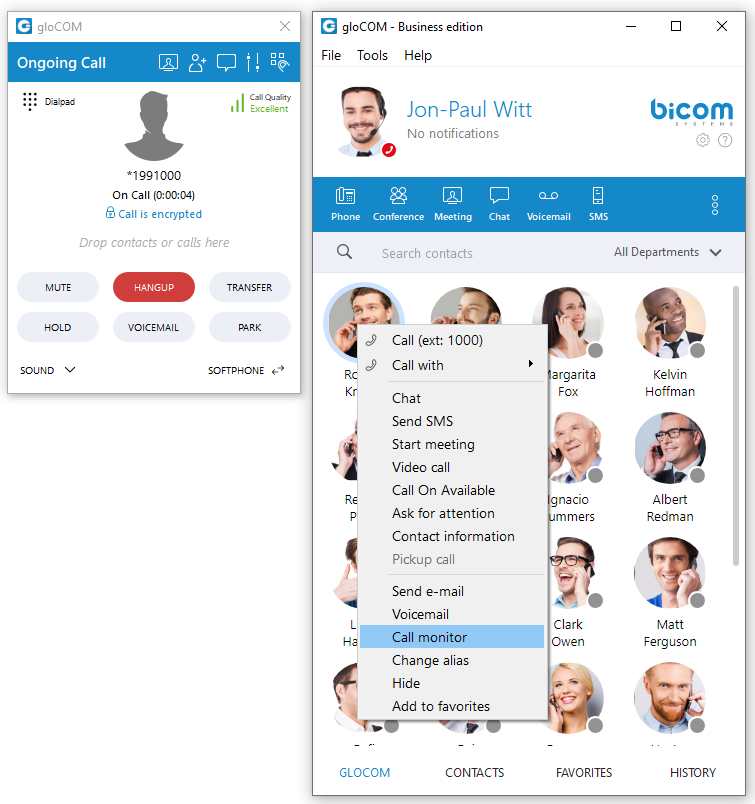
gloCOM brings a unified call history between Desktop, Web and Mobile applications. Call history is stored for up to a month on the server and synced between all user devices. It means that the user will be up to date with their recent calls all the time. The application makes sure that the user’s call history is synced on every login and that they have recent calls available on their device.
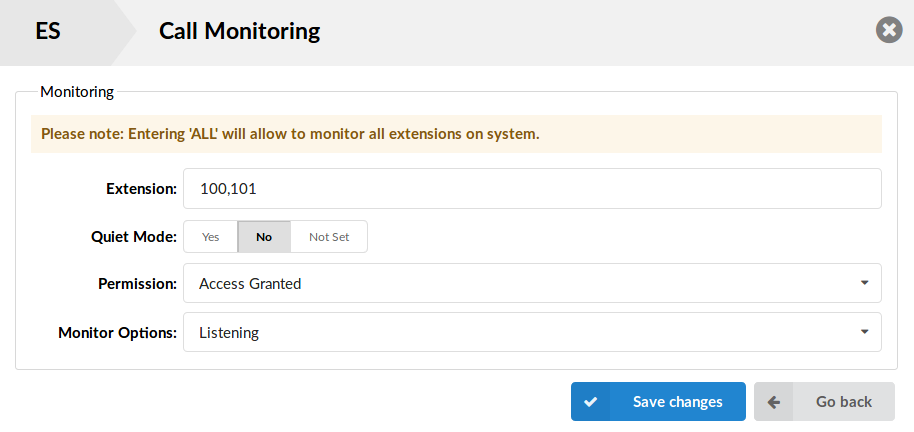
¶ Phone
The phone module area where information about possible missed calls is shown.
- From the phone module you can set up an office and mobile phone by clicking the settings icon next to missed calls information.
- Select your audio device by clicking the Headset icon. The drop-down menu with the following options will appear:
- Select the microphone device: Allows you to select which device you want to use as an input device.
- Select the speaker device: Allows you to select which device you want to use as an output device.
- Select the ringing device: Allows you to select which device you want to use as a ringtone device.
- Preferences: It points to the Preferences → Phone → Audio devices section where you can also select which input, output, and ringtone device you want to use or to test your audio devices.
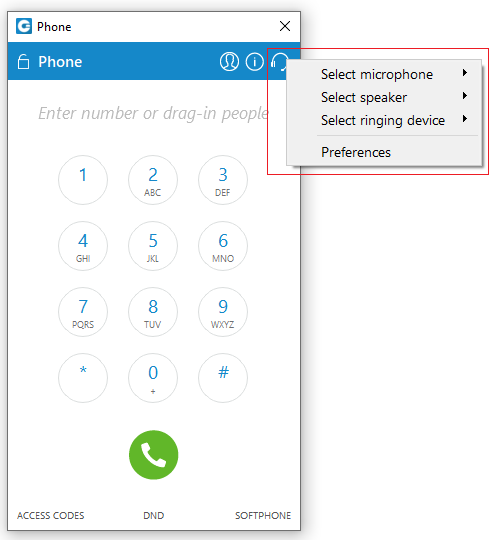
Also, you can change your audio device during a live call by clicking the Sound button.
Default ringtones are different for inbound and outbound calls when using a softphone.
- A green (or eventually red) circle shows the Phone module connection status. If green is shown, the Phone module is connected and the user can place calls. If a red circle is shown, the Phone module is not connected and the user is unable to place a call, in which case the user should contact their system administrator.
- In the Phone module, you can see which phone mode is set by default. Click on the dropdown menu, and choose between Softphone, Deskphone, and Mobile App. Next to this dropdown, there is a DND icon with the option to set your status to Do Not Disturb.
- Phone module area where contact is shown after the Drag-and-Drop action.
- Phone module area where a dialed contact's phone number is shown.
- Speaker volume tuner. Adjust the speaker volume by moving the slider up or down. Do not increase volume more than needed because it can induce hearing loss.
- Microphone volume tuner. Adjust the microphone volume by moving the slider up or down.
- Phone module dial keypad. Used for entering phone numbers.
Users are able to block caller ID directly from gloCOM. Two options are available: Hide Caller ID and Hide Caller ID for the next call only.
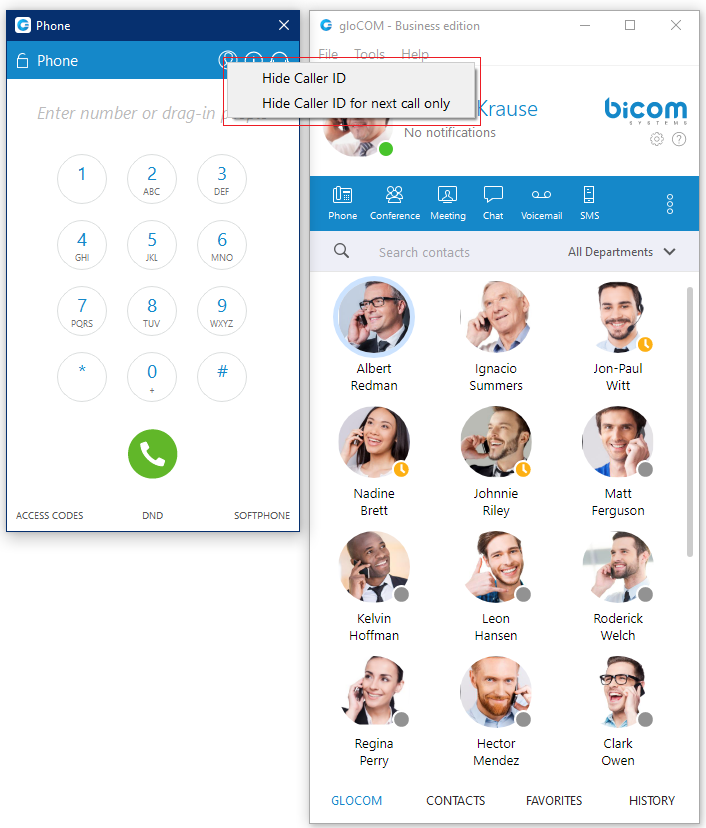
When a user presses and holds down any key inside the Phone Dialer except 0, it will display the pressed number or sign. However, when the user presses and holds down the 0 key, it will display the + (plus) sign.
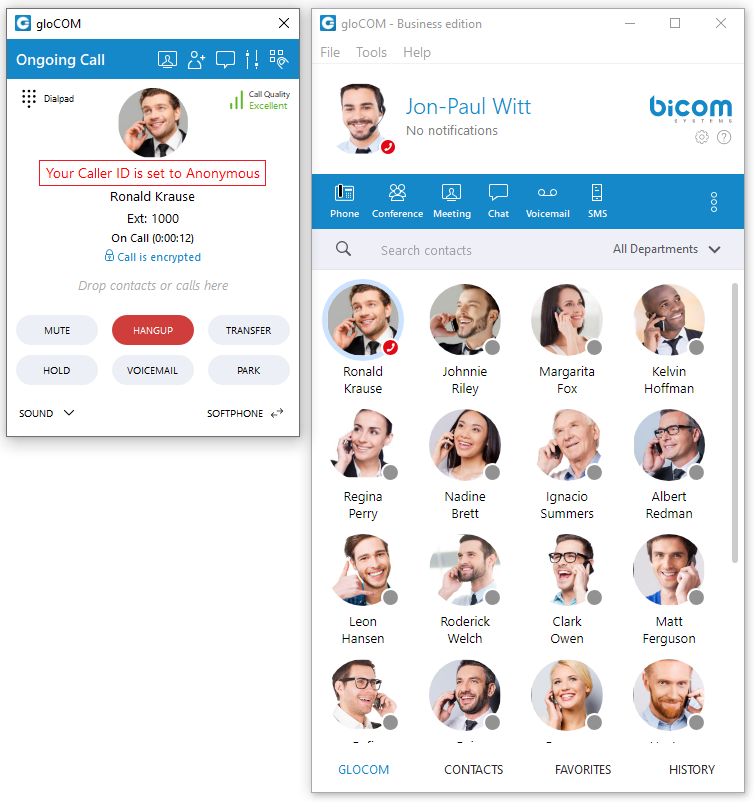
¶ Call Quality Metrics
Call Quality Metrics provides the user with details about the call and network quality during a call.
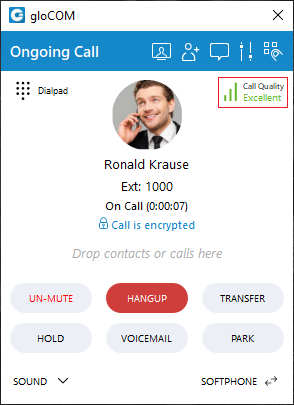
These details include information like:
- MOS Score
- Round Trip Time
- Packet Loss
- Jitter
For example, if the quality of a call is Excellent, there is no problem with the connection, there is little latency, and there is no packet loss. Otherwise, there are some problems with connection, latency, and packet loss.
In a word, it helps with troubleshooting potential network issues during a call.
During a call, a Call Quality indicator will appear in the upper right corner of the call window, giving rough information about the call and network quality. The Call Quality window will appear by clicking on it, providing more detailed information about MOS Score, Round Trip Time, Packet Loss, and Jitter.
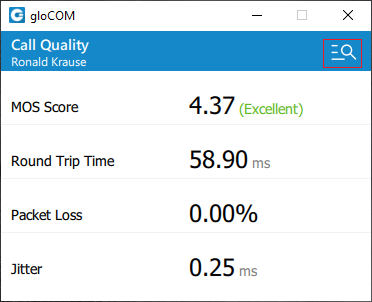
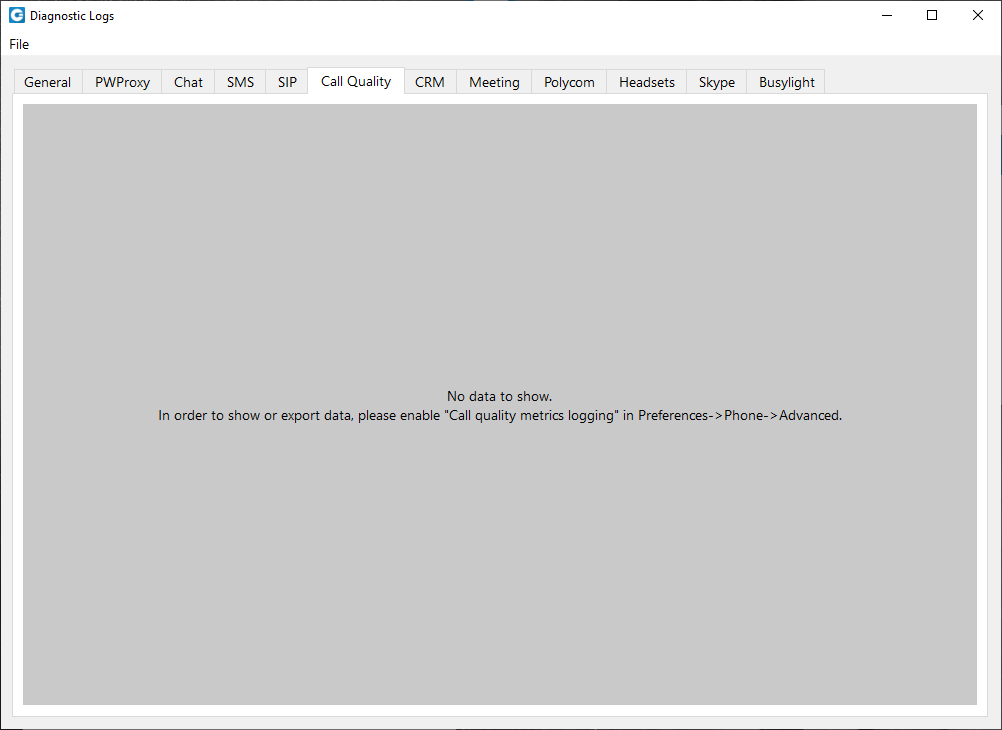
To export this information, click on the Open call quality diagnostic logs. By default, this option is disabled, and to enable it, please navigate to Preferences -> Phone -> Advanced and check the Enable call quality metrics logging.
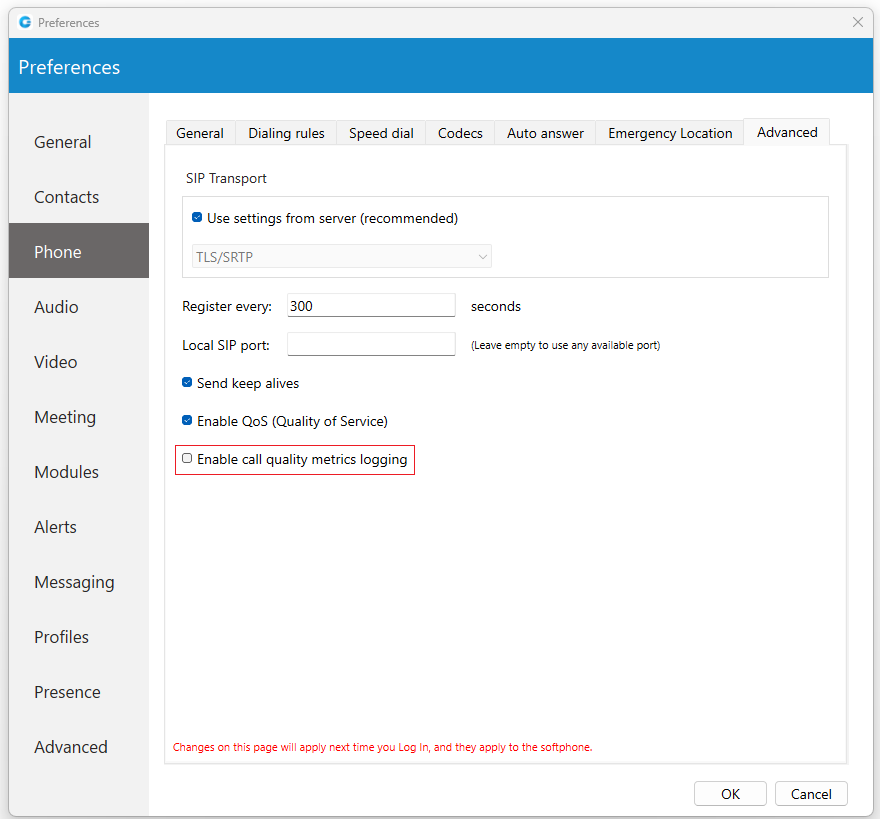
After enabling it, under the Call Quality tab within the Diagnostic Logs, the user will be presented with the Call Quality information for the last 50 calls. To export the Call Quality information, the user needs first to select the call from the drop-down menu for which they want to create a report and click on the Export call quality report button.
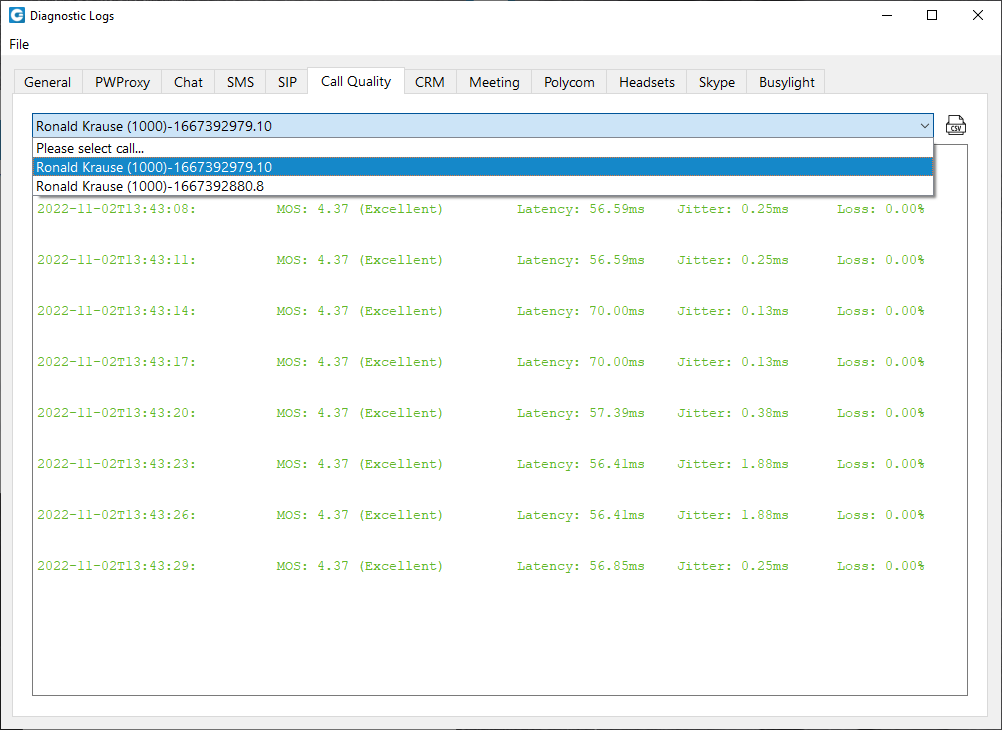
¶ Auto Answer
Auto Answer, as a feature, allows users to answer incoming calls automatically without using the answer button.
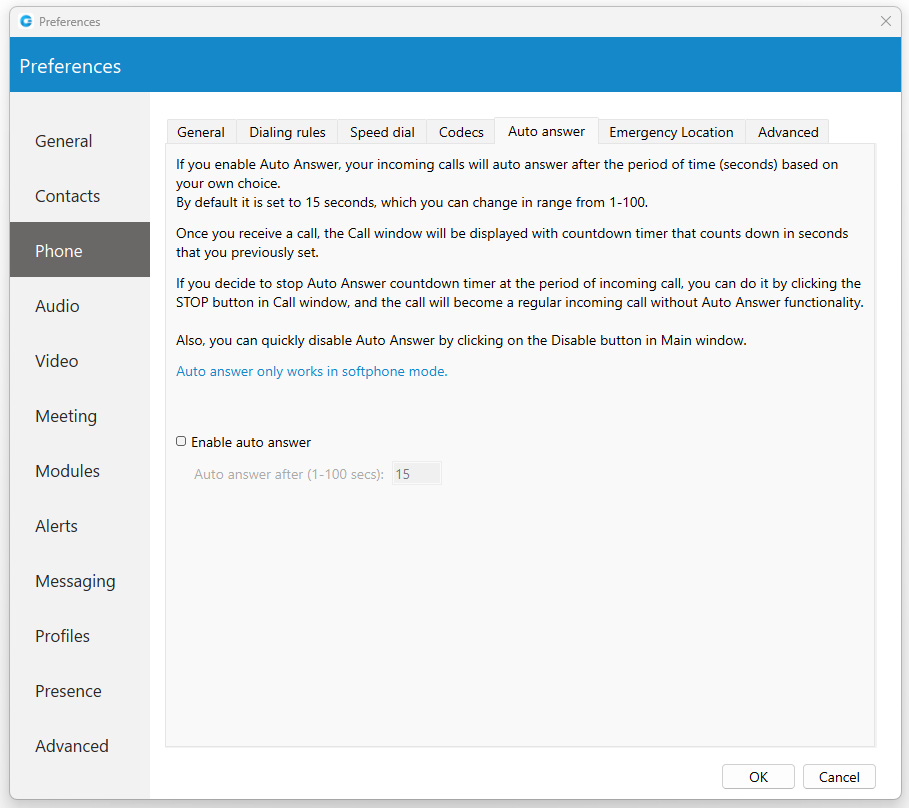
To turn on this feature, please navigate to Preferences -> Phone -> Auto Answer section and check the Enable auto answer option. By default, this option is disabled.
If the Auto Answer option is enabled, incoming calls will be automatically answered after a certain period of time (seconds) based on the settings within the application.
By default, it is set to 15 seconds, which can be changed in a range between 1 to 100 seconds.
Once the call is received, the call window will be displayed with a countdown timer that counts down in seconds previously set by the user.
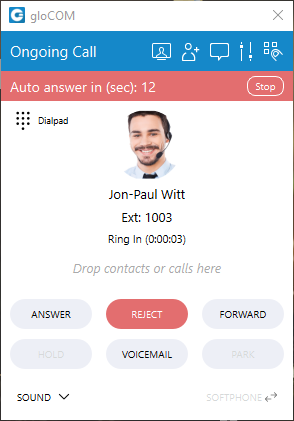
In case of another incoming call, an Auto Answer functionality will not be triggered while there is already an active call. Instead, it will wait until the active call ends.
By clicking the Stop button, the Auto Answer countdown timer within the call window will be stopped. The call becomes a regular incoming call without Auto Answer functionality.
To disable the Auto Answer functionality, the user can click the Disable button in the main gloCOM window. Additionally, the user can navigate to the Preferences -> Phone -> Auto Answer section and uncheck the Enable auto answer option.
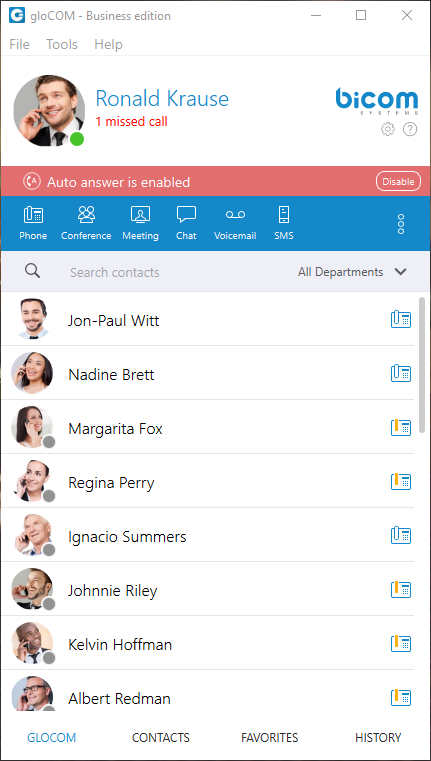
Auto Answer only works in softphone mode.
¶ Voice Conference
- Plus sign used to invite a contact using his landline or mobile number.
- Select a box to choose from a conference room
 .
. - The Voice Conference module area where contact is shown after Drag-and-Drop.
- To remove a contact from a list, click
 .
. - Click on the Start button to start the Voice Conference.
- Click on Close to close the Voice Conference.
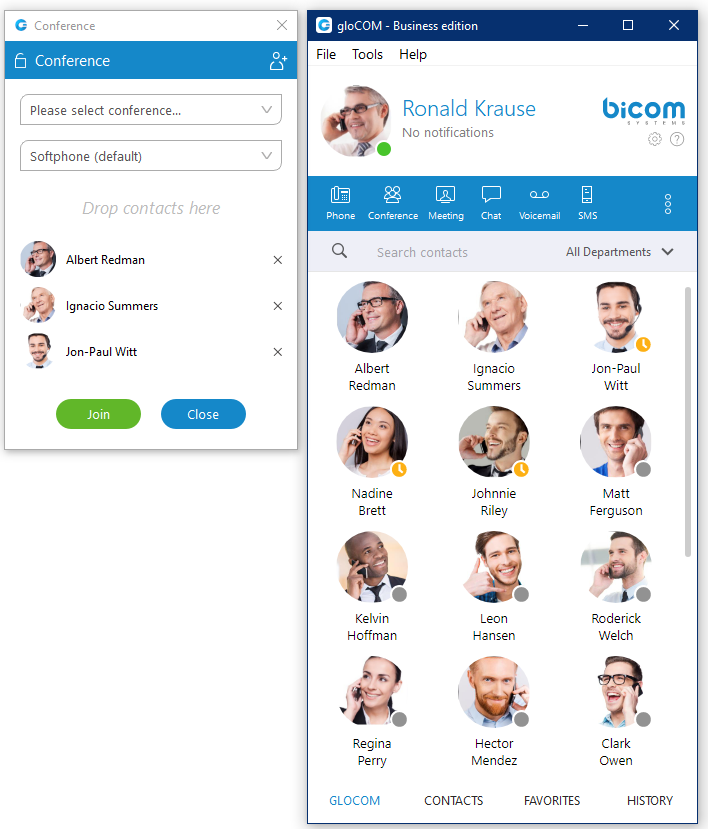
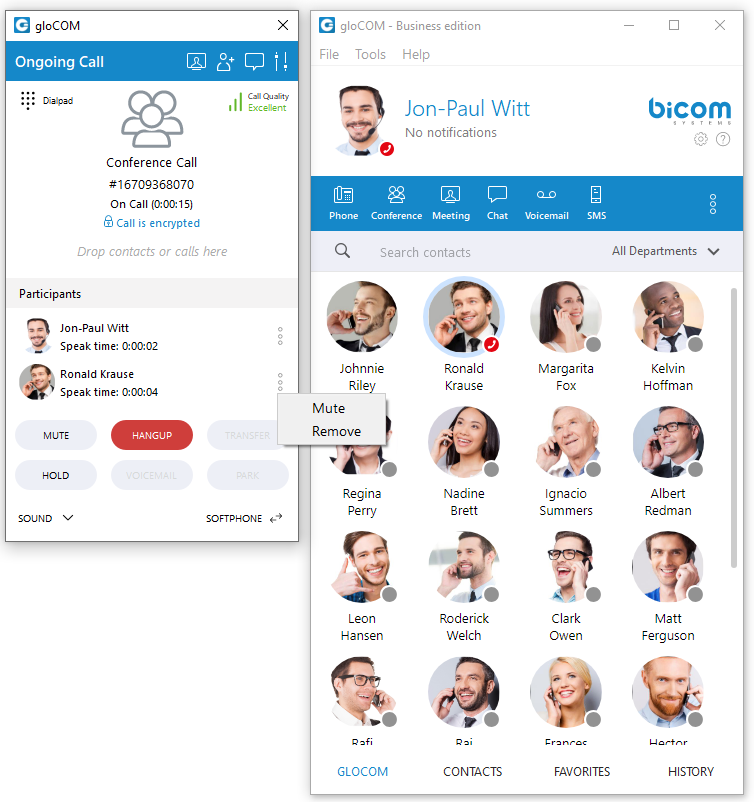
Conference can be created from the dropdown list, and Instant and Predefined conferences can be selected.
- Instant conferences: User can create a conference by adding one or more people to an ongoing call. With this option, you can add extensions or any number available from your contact list. If you missed the conference call, you are still able to join the conference from the Call History tab provided that a conference still exists. There are two ways to do that: double-click on the conference number or right-click on the conference number and then choose a call or call with.
- Predefined conferences: Users can join predefined conference rooms and add other participants.
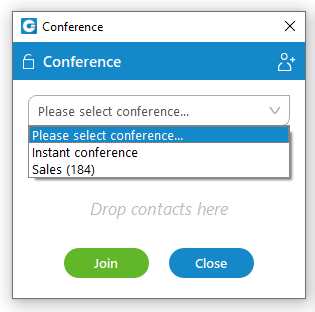
¶ Meeting
gloCOM meeting is a gloCOM module that allows the user to launch video-meetings without the hassle of switching applications and keeping all of your gloCOM contacts. gloCOM meeting enables the meeting with multiple users simultaneously with key features such as: video conferencing, audio conferencing, chat, screen sharing, and local recording. gloCOM meetings can be private (invite only) or public (anyone with the number or link can join). In order to use gloCOM meeting, the user must first acquire gloCOM and the gloCOM meeting add on.
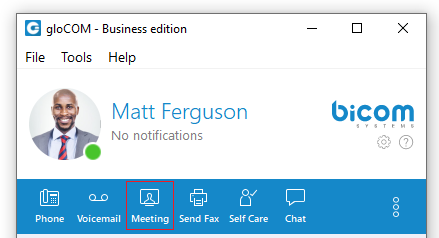
¶ Granting necessary permissions
If you have a problem with using a microphone or camera with gloCOM meeting on Mac OS please check security options described in this section.
gloCOM needs permission to:
- Camera for video communication.
- Microphone for audio communication.
- Screen Recording and Accessibility for screen sharing and remote control.
The user can enable these options by going to: Settings → Security and Privacy → Privacy.
If the necessary permissions for camera and/or microphone have not been granted, the user will see a dialogue asking them to grant the permissions. There will also be a red exclamation mark next to the icons in the option bar.
Here you will find the options to enable your camera and microphone.
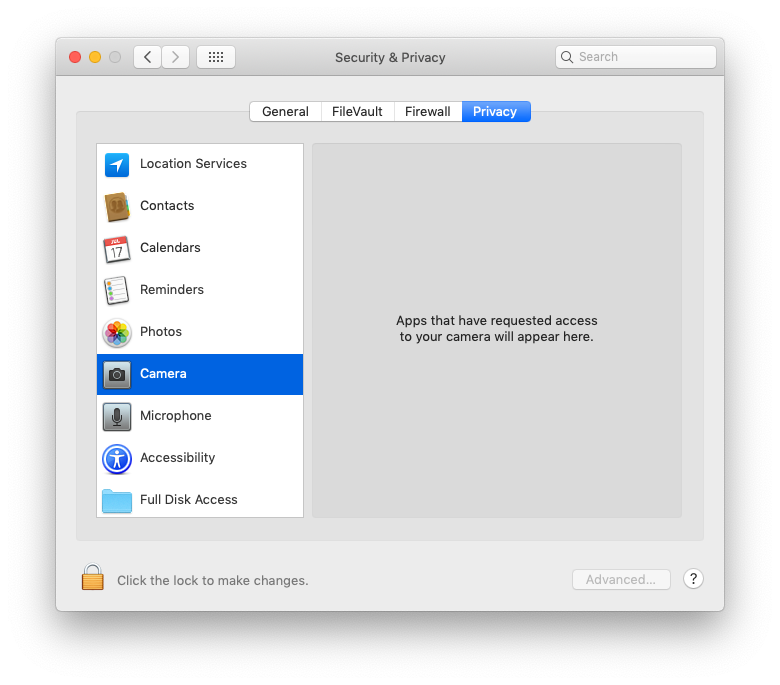
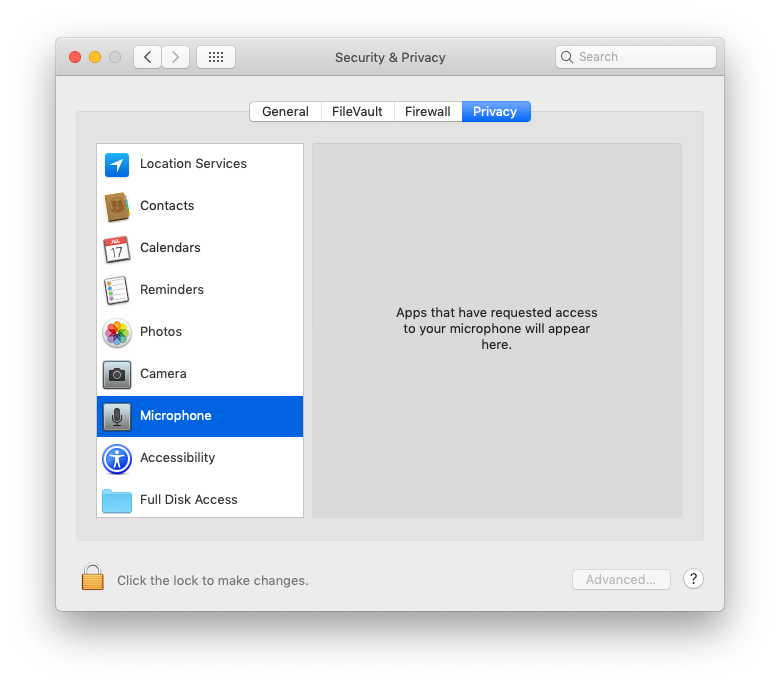
You will have a pop up that looks like this to confirm you are giving permission.
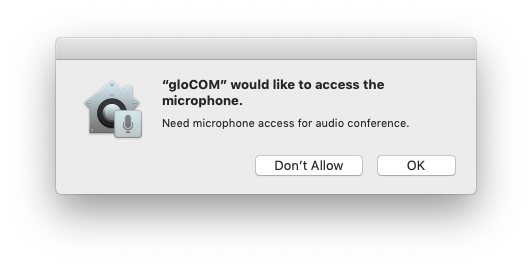
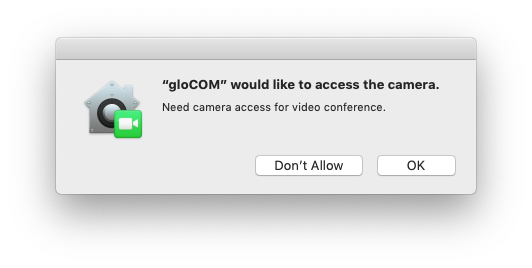
When they are enabled you can disable access at any time by unchecking the tick box.
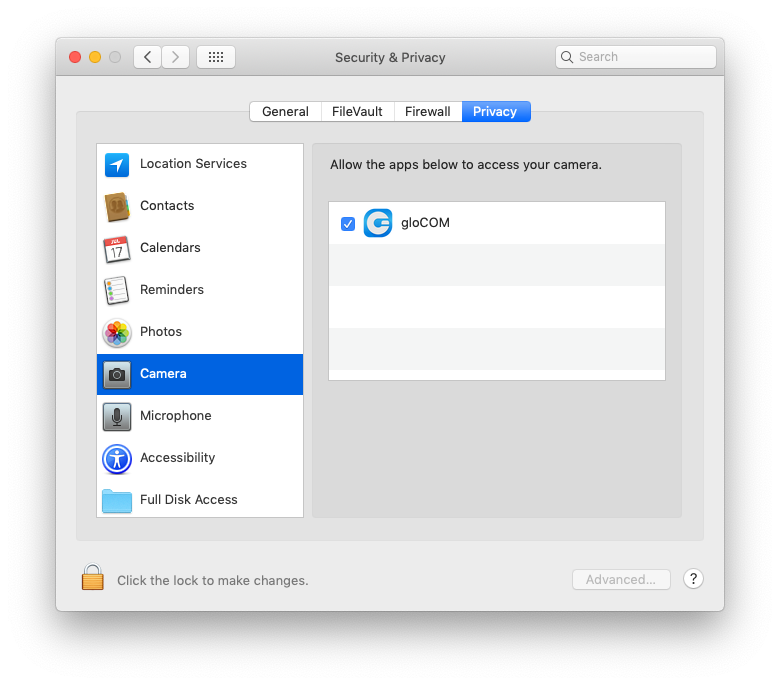
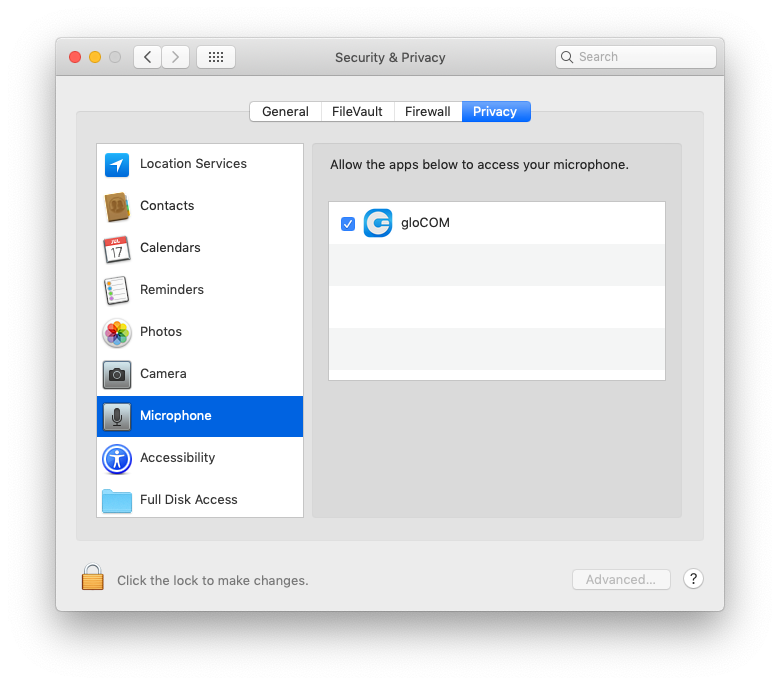
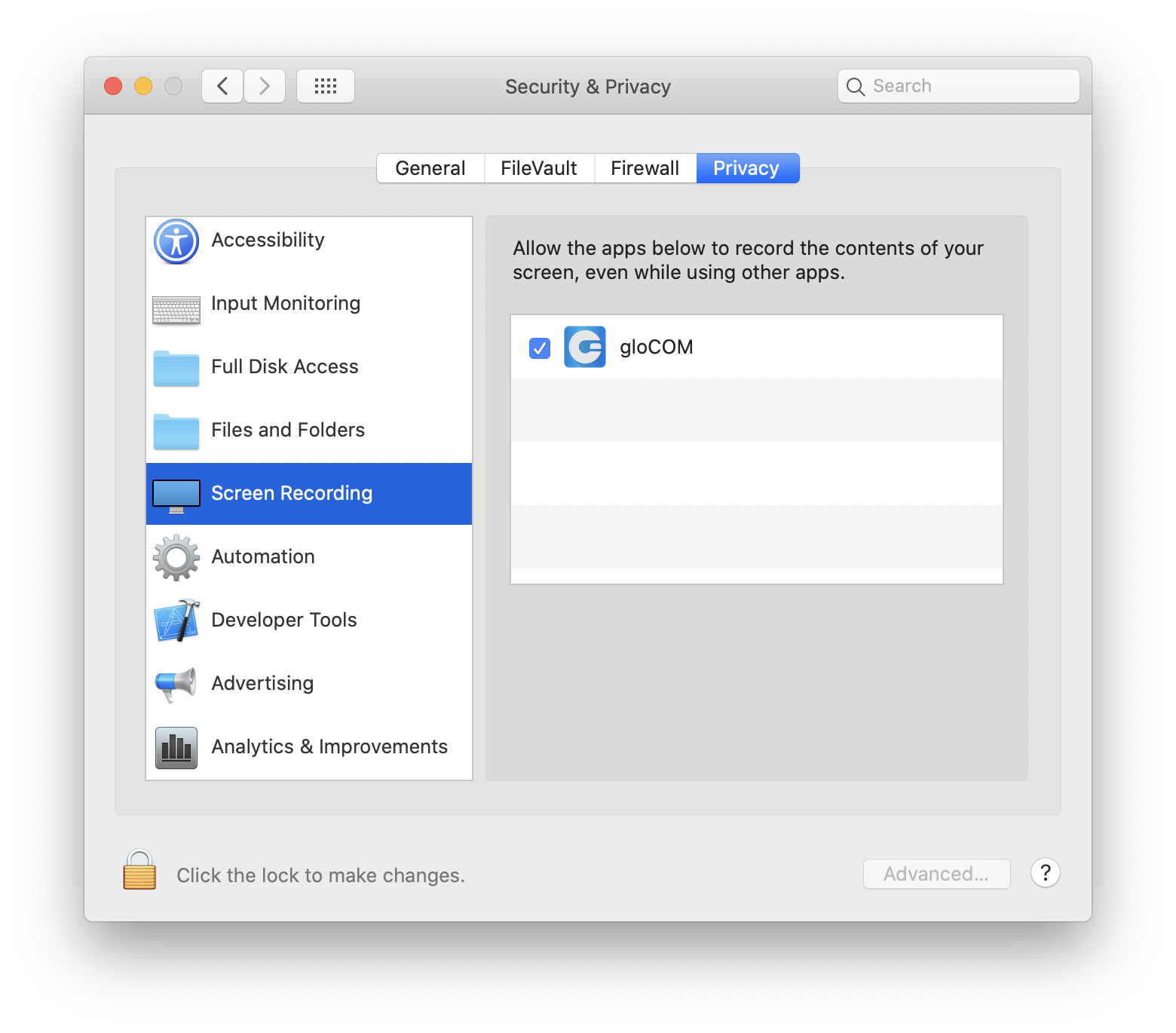
¶ Starting A Meeting
To launch gloCOM meeting you must first have gloCOM open, then simply click on the icon labeled Meeting, this will open up a small window that will allow you to drag contacts in. Once you have all the contacts that you want you can instantly start the meeting. If you wish for anyone to access this meeting then tick on the Public checkbox.
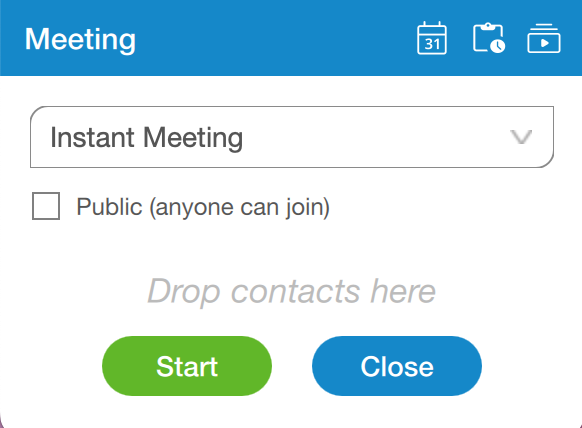
There are also alternative methods of starting a meeting. The user can find a contact in the list and right-click on their name, this will give the option to start a meeting instantly. This is useful to avoid having to navigate the meeting menu and to start one on one meetings quicker.
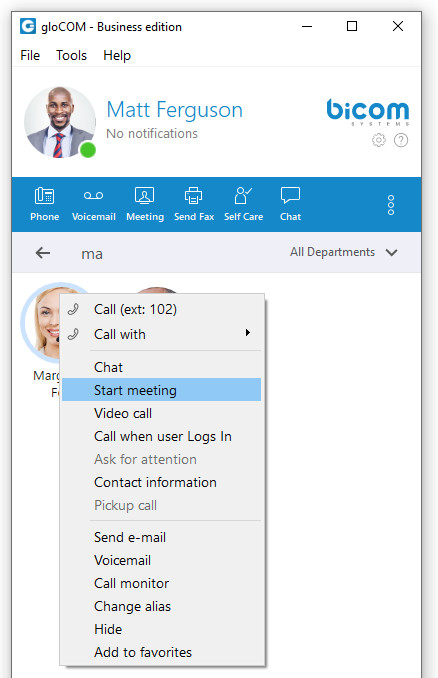
One final method to start a meeting is from a chat. This can be done for both one on one and group chats. Just navigate to the conversation and find the Meeting icon in the top-right.
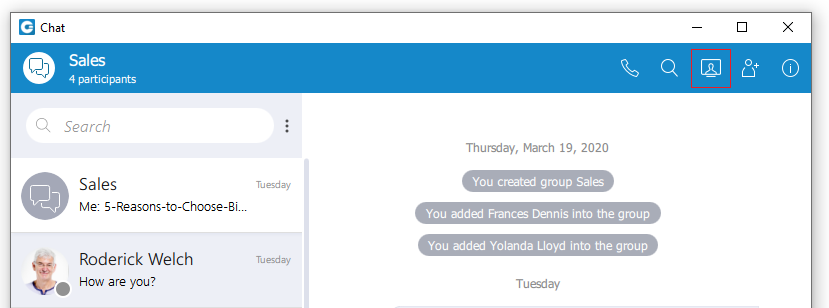
When meeting is started from the chat, invite link will be automatically sent to the chat. Using this link user can easily join meeting either via web or mobile application.

In order to have this link in a chat, user should check this option in gloCOM Meeting preferences.
¶ Meeting List
If the user wishes to view any of the ongoing, scheduled or previous meetings, they can open the Meeting List. To do this, open the Meeting window and click the Meeting List icon in the top-right. There will be a busy indicator in meeting details until all data is available.
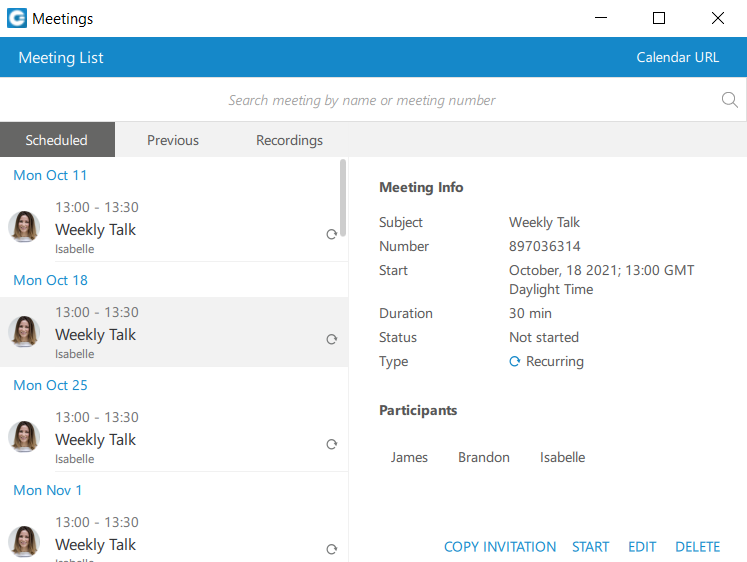
The meeting list will give you the following information:
- Start and end time (The time of day it will occur)
- Date (Which day you will have the meeting)
- Name/subject (What the given topic for the meeting is)
- ID number (The randomly assigned number to distinguish meetings)
- Duration (How long the meeting will be)
- Status (The state of the meeting e.g. finished or upcoming)
- Participants (Who is supposed to attend the meeting)
¶ Scheduled Meetings
Scheduled meetings are all meetings scheduled in the future. There is also a special category of In Progres meetings that contains all currently active meetings the user has been invited to.

¶ Recurring Meetings
A Recurring meeting is a meeting that will repeat every set time (every day, week or month), e.g. every week on Tuesday you have a sales meeting.
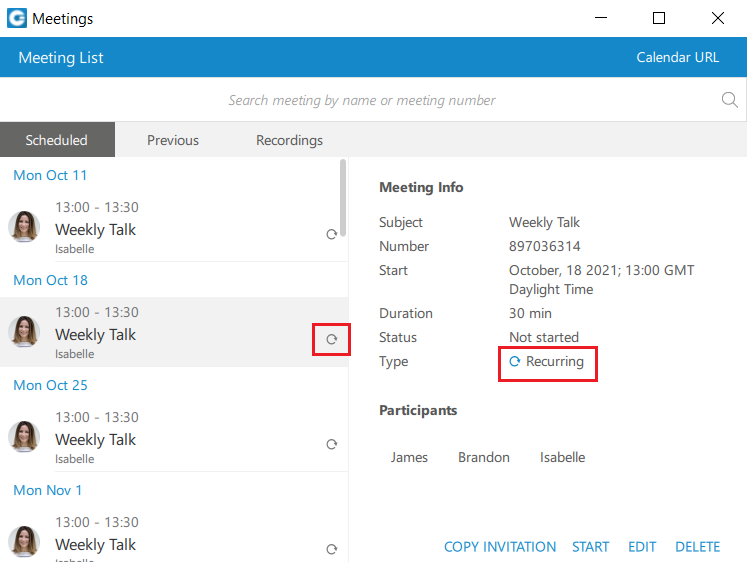
You may edit recurring meetings to suit your needs if you need to reschedule.
¶ Previous Meetings
Under this tab, the user can find all meetings that have ended.
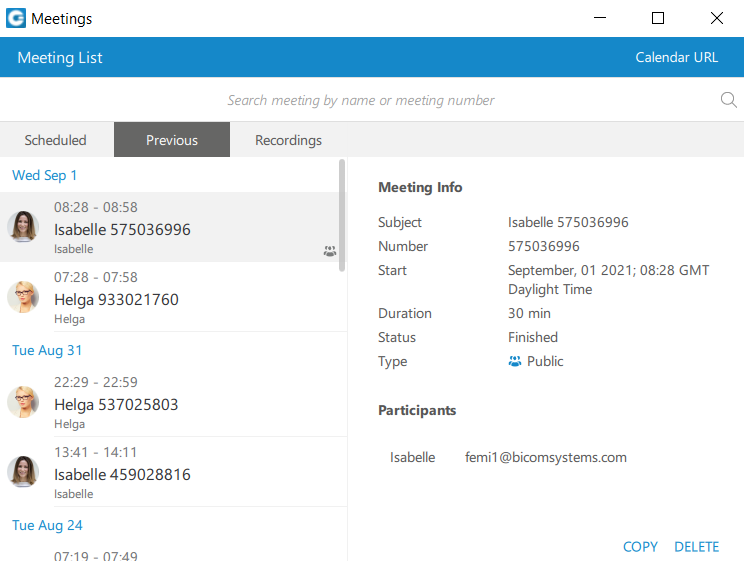
¶ Meeting Recording(s)
When recording meetings, the application stores all the necessary information to generate a recording later on. This is done to prevent the recording process from interfering with a meeting in progress, because converting a recording requires significant computer resources. To find meetings that you can create recordings for, the user should open the Meeting List and then the Recordings tab. They can now select a meeting and click Convert to start the conversion process. They can also Open the recording location on the computer, or Delete the recording.
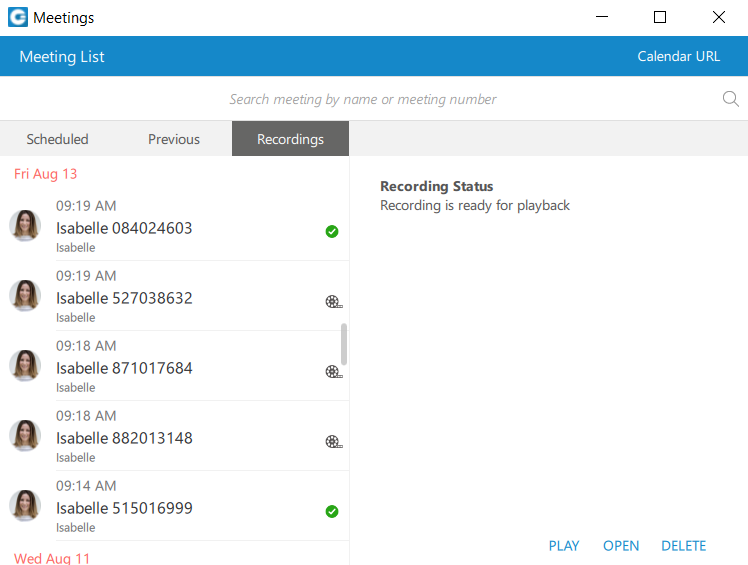
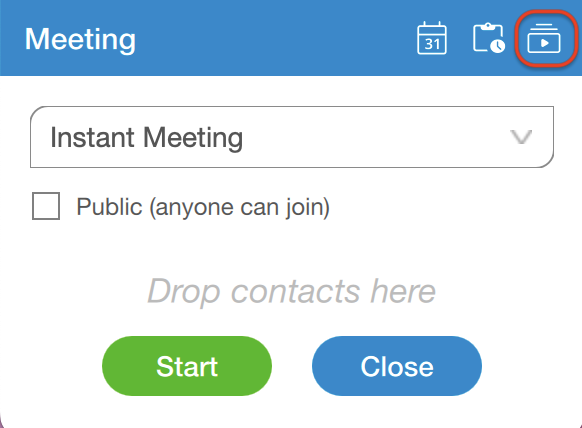
Alternatively, if the user wishes to automatically convert every meeting recording, the user must go to Preferences → Meeting → Recording and check Automatically convert recordings after meeting is ended.
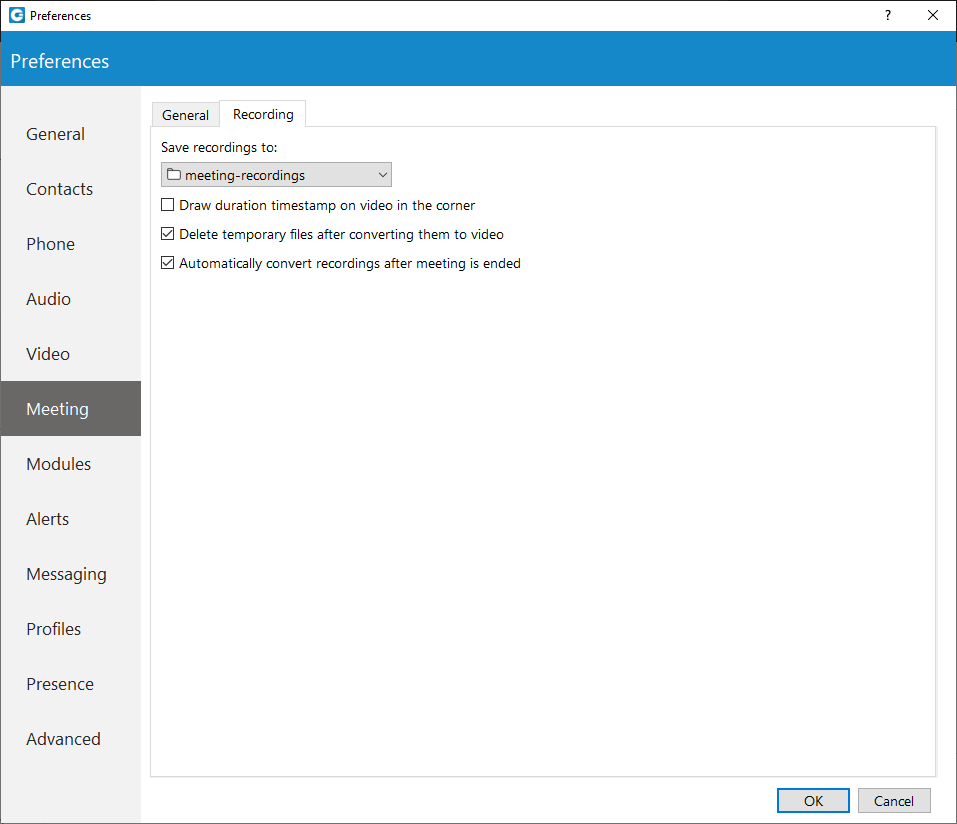
¶ Schedule A Meeting
You are also able to schedule a meeting beforehand. To be able to schedule a meeting click on the button to the left of the meeting list.
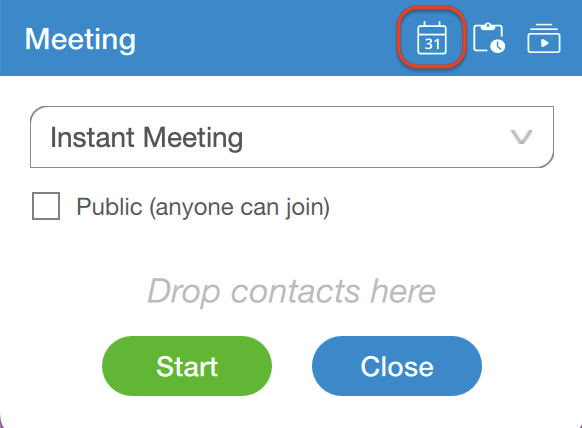
These are the options available to edit:
- Time (the time of day it will occur)
- Date (which day you will have the meeting)
- Duration (how long the meeting will be)
- Time Zone (this will display the time zone your meeting will be scheduled in)
- Subject (what the given topic for the meeting is)
- Participants (who is supposed to attend the meeting, you can invite them via contacts or email)
- Whether it is recurring (if it will repeat e.g. every Thursday at 3 pm) and how long it will recur for (e.g. stop after 10 meetings)
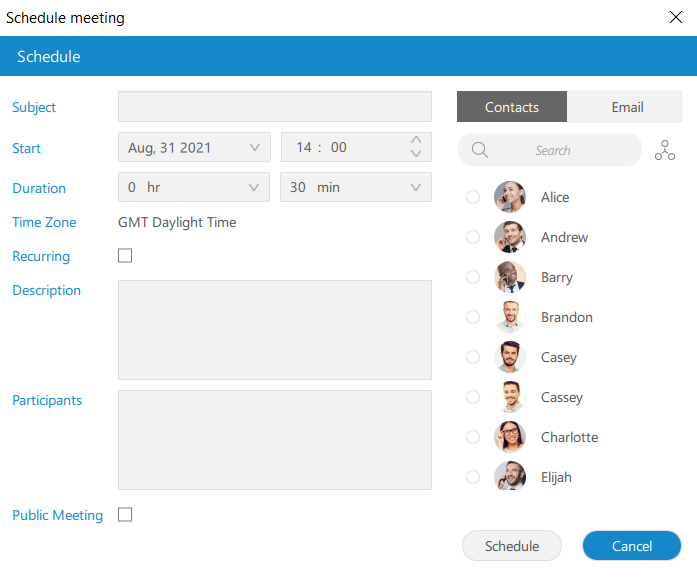
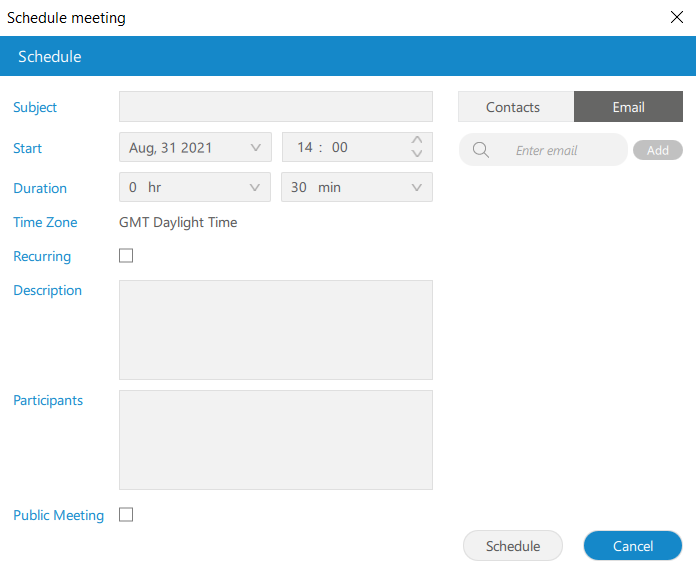
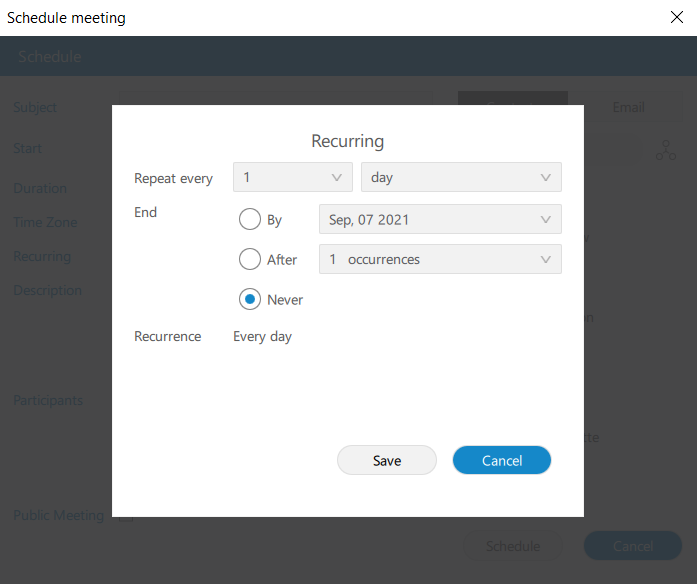
¶ Join By number
There is an additional option to Join by number, in which the user enters an already existing meeting number to join the meeting. To access it, the user clicks on the drop-down list in the Meeting window and selects Join by number. They can now enter the meeting number supplied to them by the organizer.
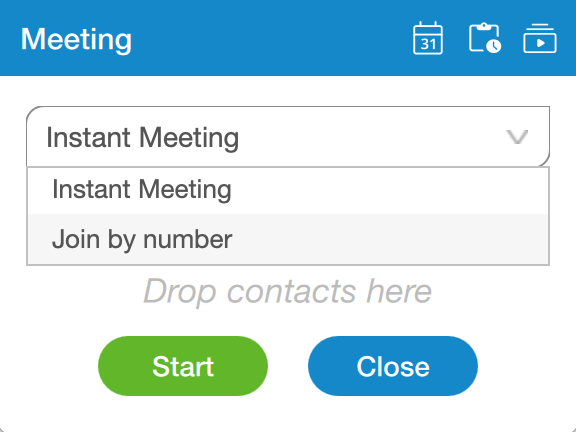
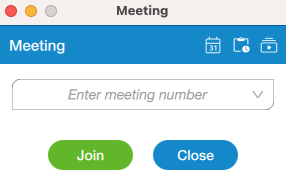
¶ Meeting Interface
The user can invite as many participants as they want to the meeting.
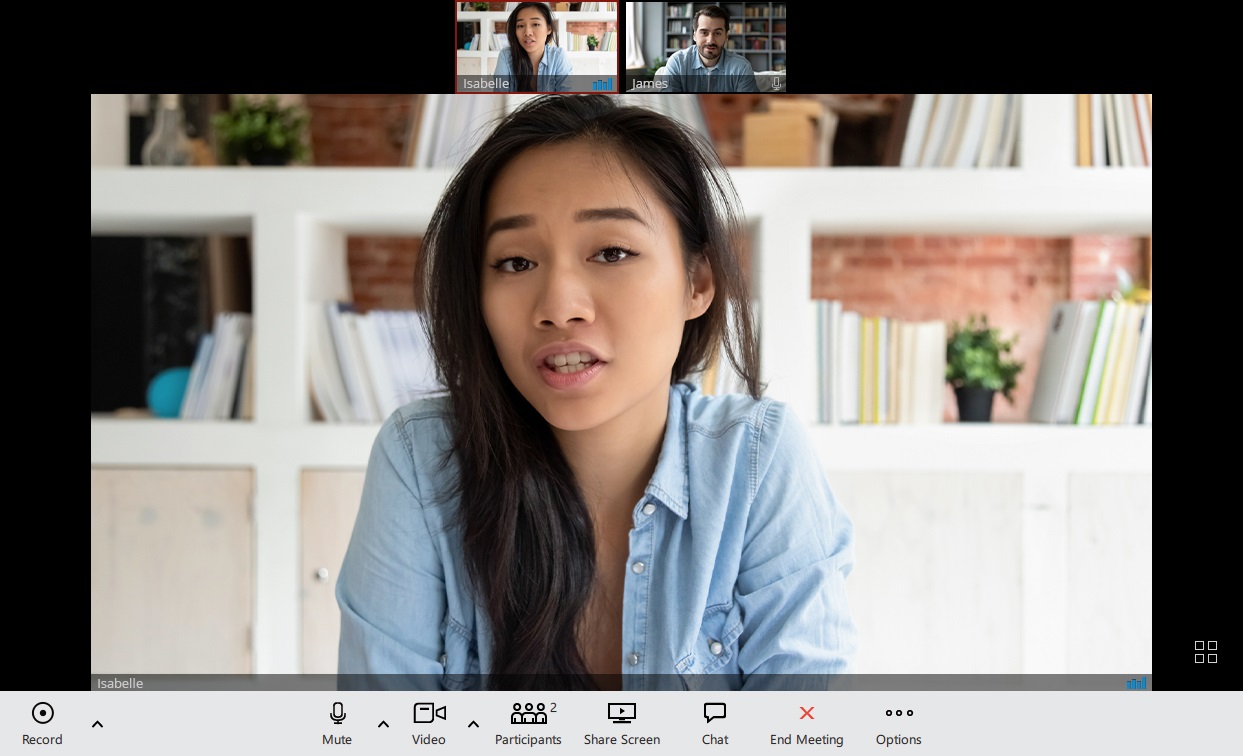

The meeting interface consists of:

- Local Recording record audio, video, chat history and and screen sharing to a computer. The user can click the record button located in the bottom left to record the meeting, the recording can also be paused and stopped, the user must be joined by computer for their audio to be recorded. If the user joins in any other way, ex. via deskphone, their audio will not be in the recording
- Mute your own microphone (Disable/Enable the audio coming from your device)
- Disable/enable your own video (Turn on or off the video shown from your camera)
- View the participant's list (See the participants in the meeting, if someone is missing you have the option to reinvite them. This will give the participant a new invite message to join the meeting.)
- Share your own screen (Broadcast your screen to the participants of the meeting)
- Open the chat window for the meeting (The meeting window will expand with the chat on the right, here you can view messages of the participants and input your own messages. You can close the meeting chat by clicking on the chat button again.)
- Leave the meeting (Ability to leave when you have the necessary feedback)
- Options - shows additional options for screen sharing, video, participants and meeting
- Mute participants as the meeting organizer allows the user to Mute participants:
- Mute participants as organizer: The meeting organizer can mute other participants from the carousel or the participant list.
- Mute all participants as organizer: The meeting organizer can mute every other participant from the participant list.
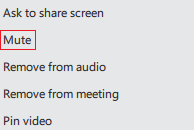
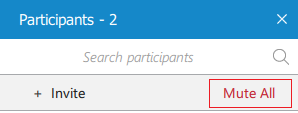
- Toggle meeting privacy between regular and private during an ongoing meeting. The organizer can toggle the meeting from private to public
and public to private.
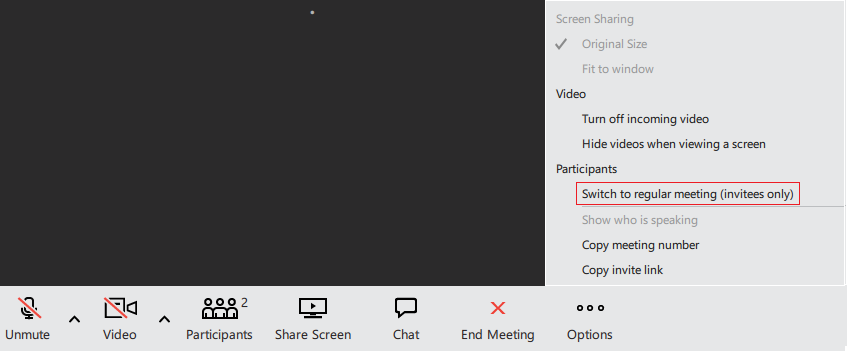
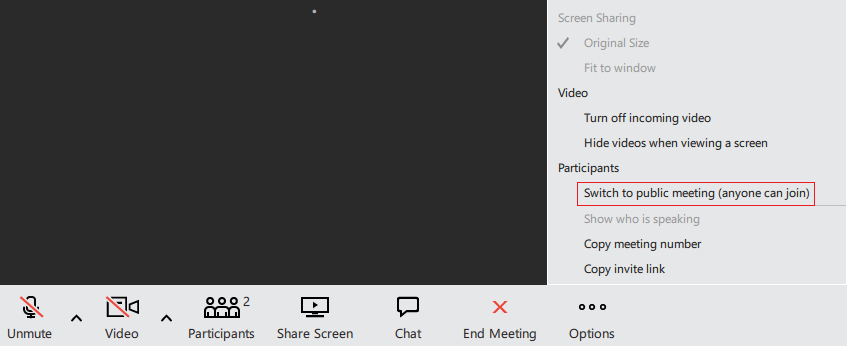
- Statistic provides the user with details about the network quality during the meeting. The statistics include metrics about Audio, Video and Screensharing quality.
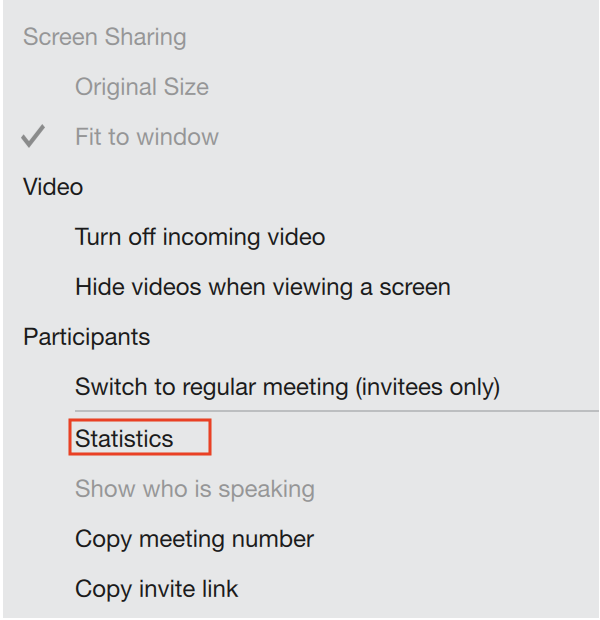
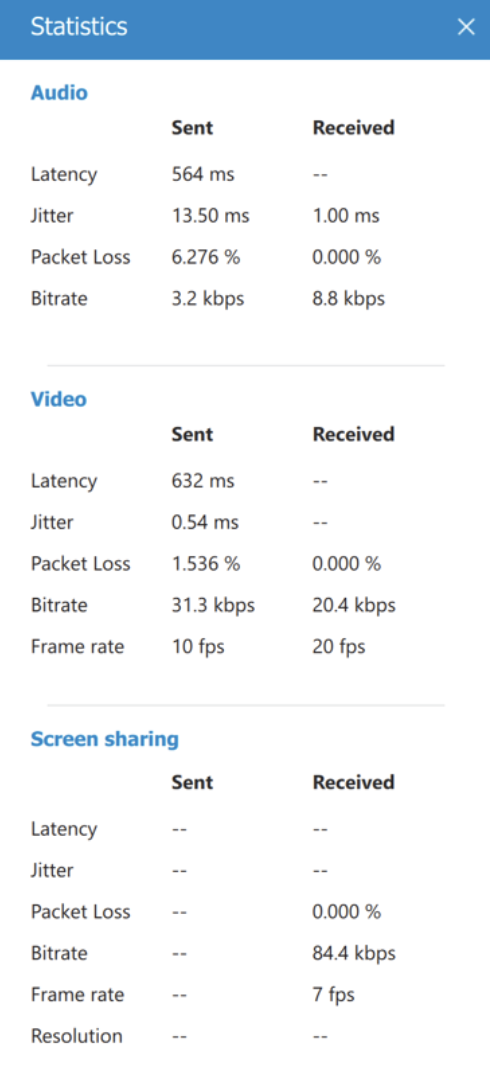
If there is a problem with network connection that is affecting audio quality, a notification in the lower left corner of the Meeting window will be displayed informing the user about the cause of bad audio.
There is also an option to change the layout of other participants in the meeting (bottom right corner). The user can switch between Speaker and Grid layout. Speaker layout puts one video stream in the focus. That video stream is either the person currently speaking, or the one user pins. This is also the default view when there is a screen sharing session active.
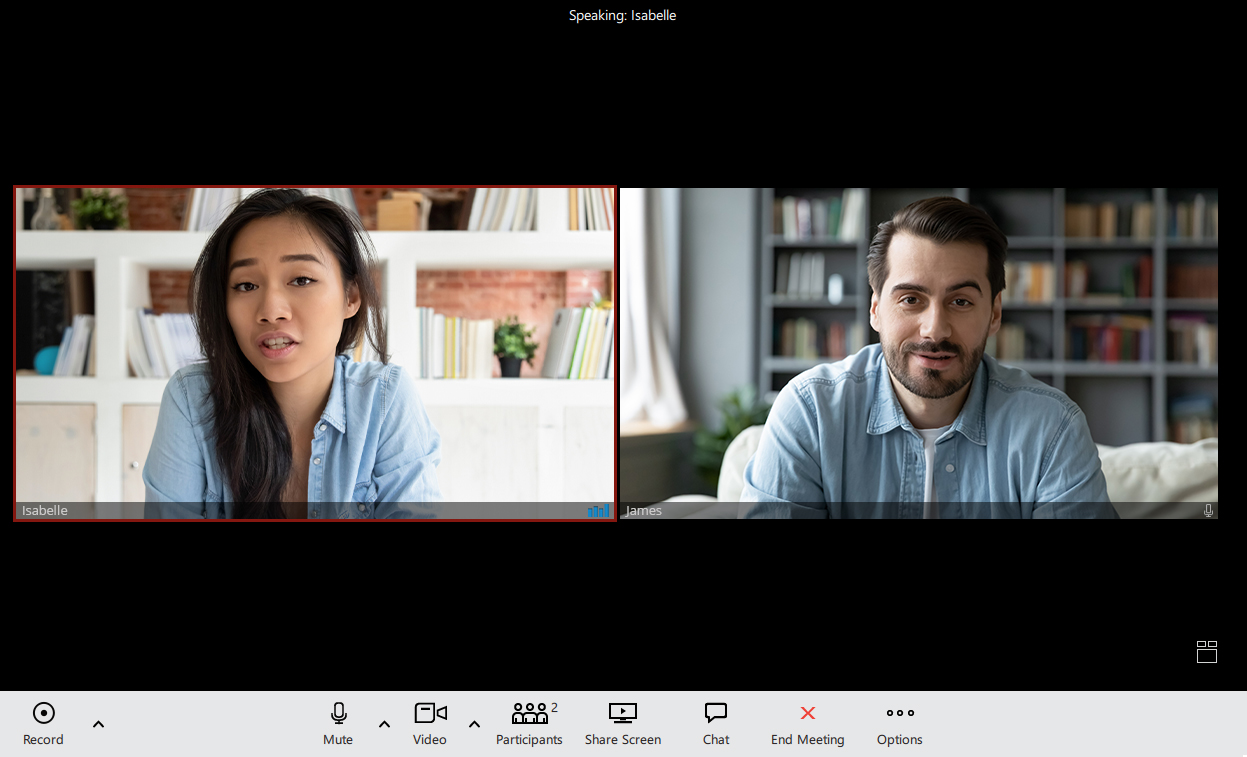
If you click on the more options button on a user you will be granted the following options:
- Ask to share screen (prompts the participant to share their screen for the meeting to see, helps the participant achieve it faster).
- Mute (removes the ability to hear that person, useful for if they have a bad microphone).
- Remove from meeting (kicks a participant ideal for if they no longer need to be in the meeting).
- Pin video (makes their video the main video on display for you).
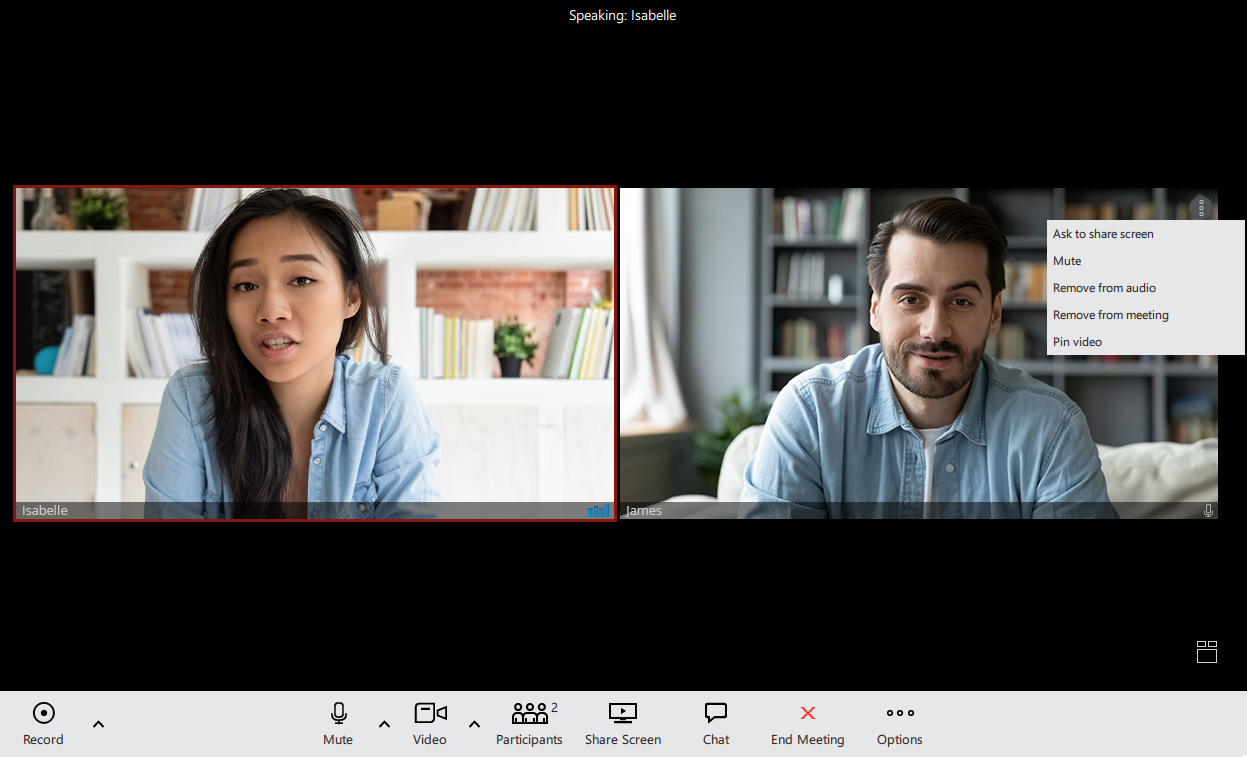
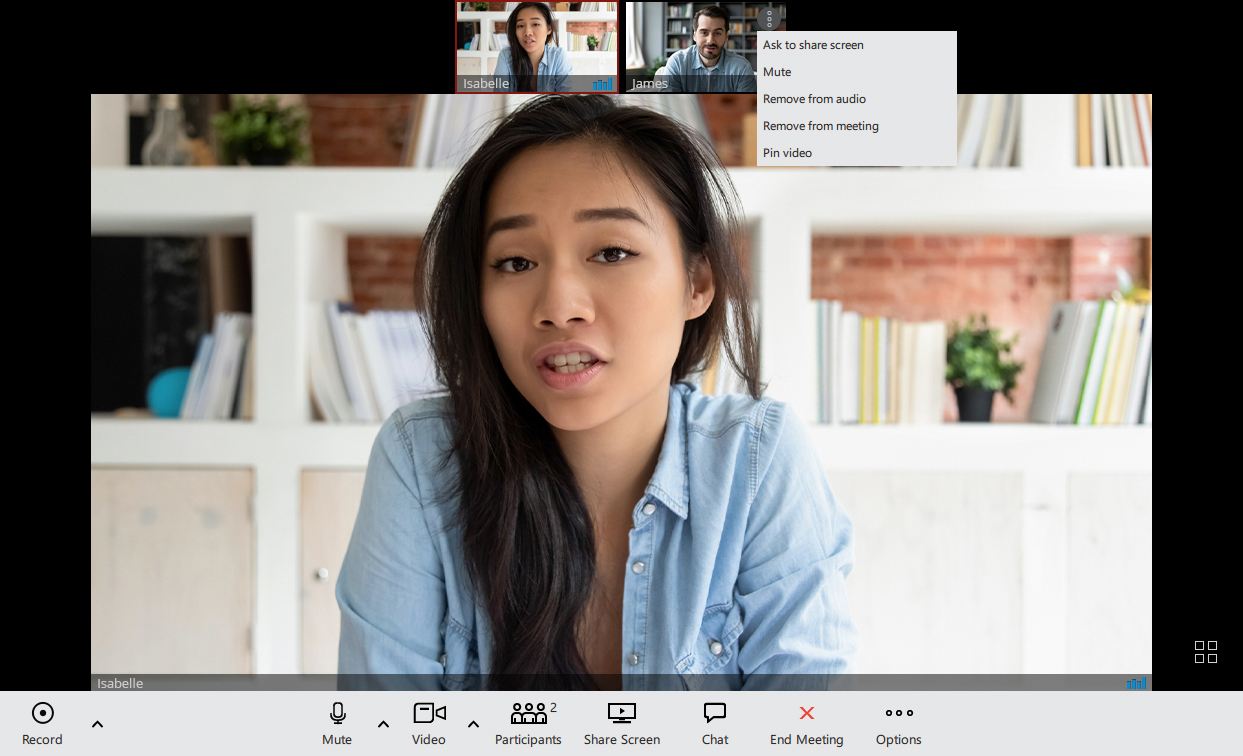
The grid view in the meeting will automatically change the number of video streams based on the number of participants in the meeting.
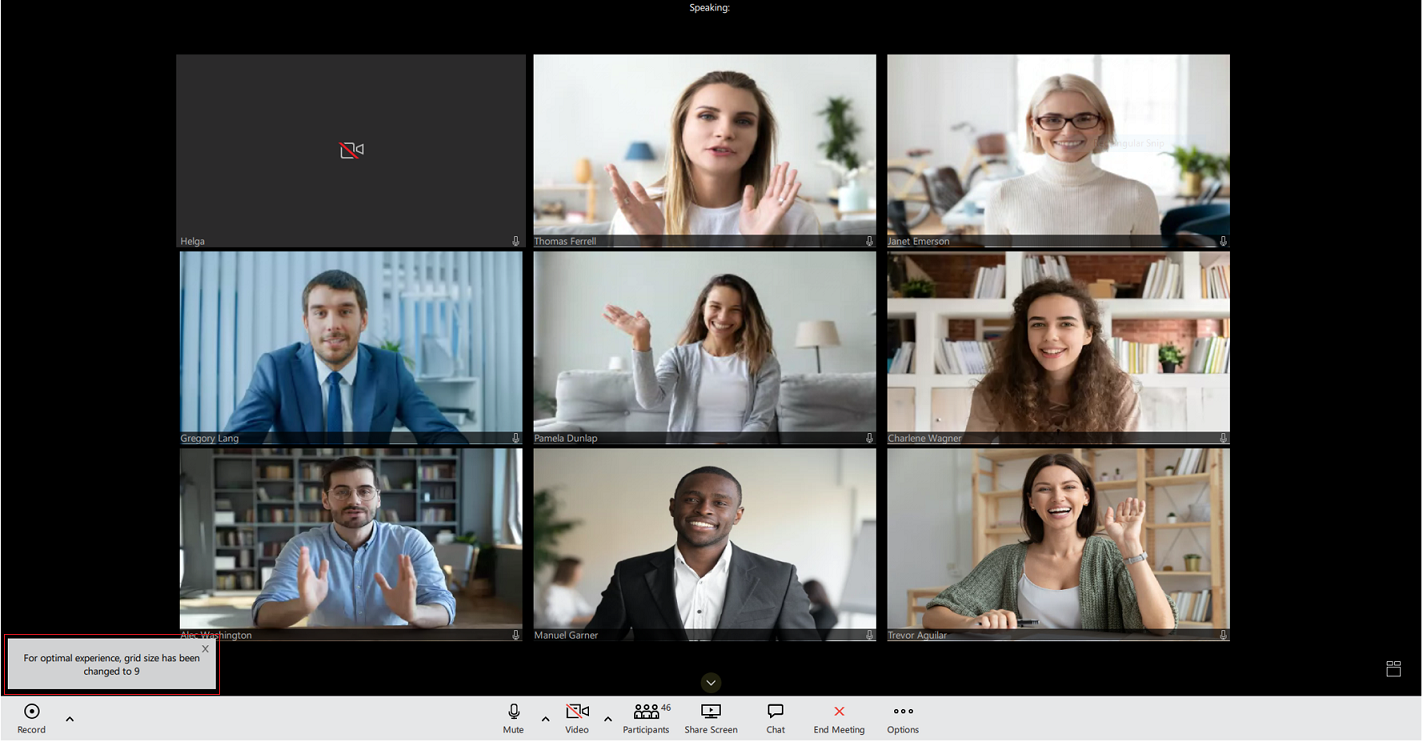
It follows the following conditions:
- Up to 45 participants = grid size 12 (user + 11)
- 46 - 60 participants = grid size 9 (user + 8)
- Over 60 participants = grid size 6 (user + 5)
Participants will be sorted to have those who spoke last to be among the first video streams.
The Meeting is now able to run 100 active video participants in one meeting.
¶ Meeting Recordings
Local Recording record audio, video and and screen sharing to a computer. The user can click the record button located in the bottom left to record the meeting, the recording can also be paused and stopped, the user must be joined by computer for their audio to be recorded. If the user joins in any other way, ex. via deskphone, their audio will not be in the recording.
Configurable 'Recording reminder' option
The Recording reminder feature reminds the user to record an important meeting, as this is often forgotten and only later enabled when someone reminds or remembers.
By default, this option is disabled. If the user wants to change these default settings, they can do so under General Meeting Preferences by checking the Ask to record on meeting join option.
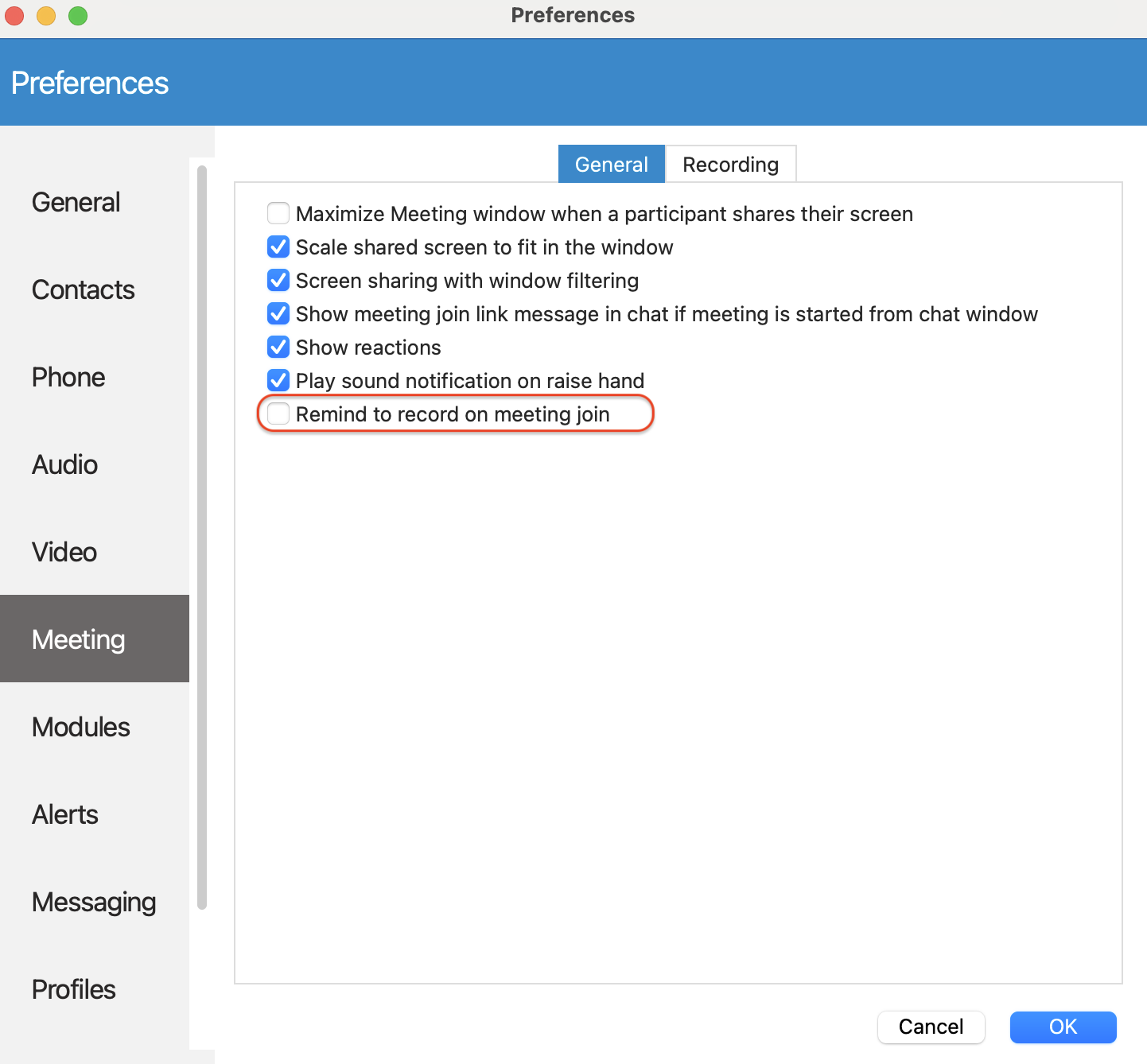
When this option is enabled - Any time a user creates or joins a meeting, a pop-up window appears asking if the user wants to record the meeting.
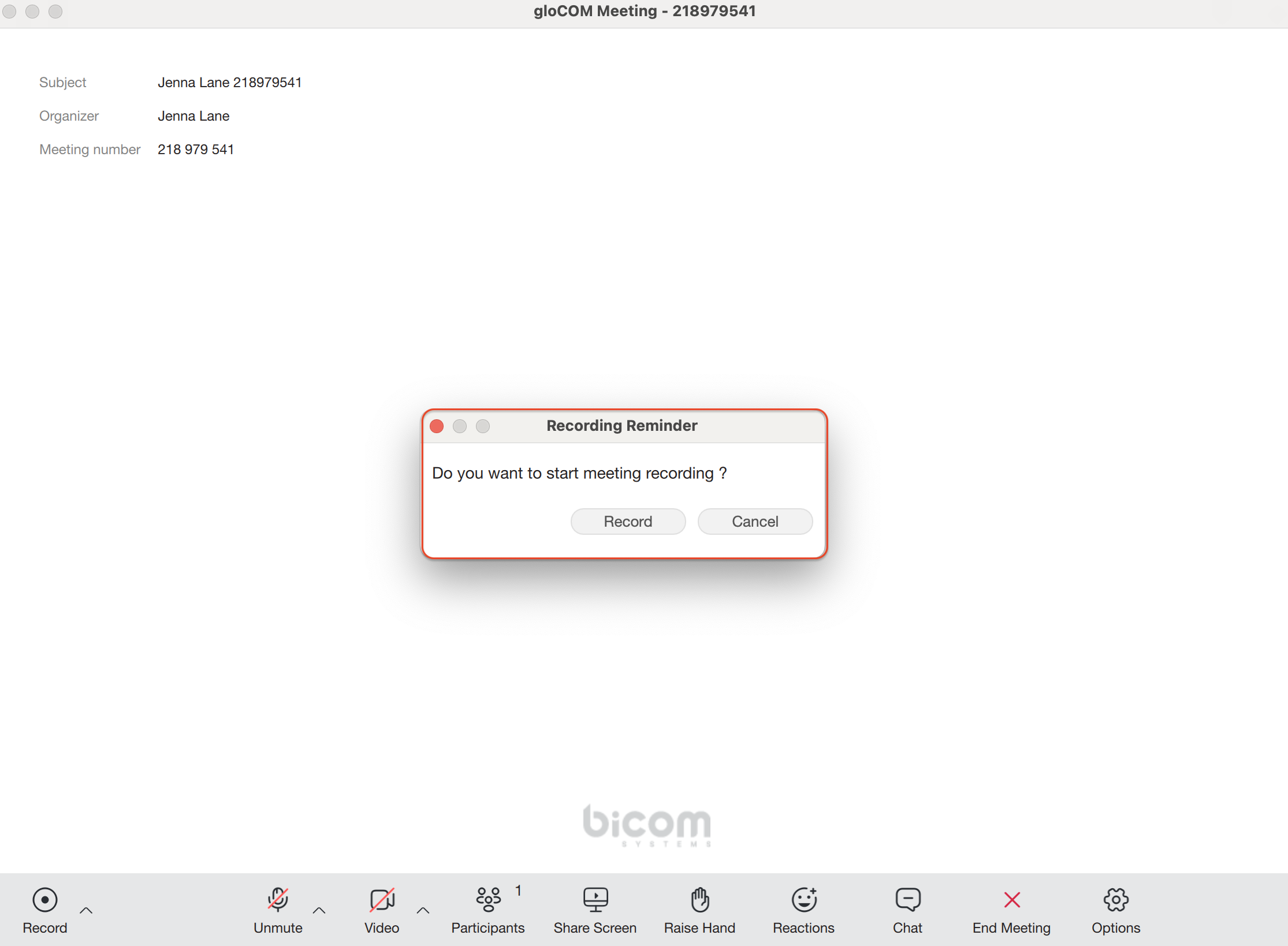
To record the meeting, the user should press the Record button in the pop-up window and after that recording will start. The user should choose the Cancel button if does not want to record that meeting.
Save chat history in meetings recordings
As part of the recordings output, like audio and video files, now chat history is included as well, in the form of a text file, since it is an important part of the conference. This file will contain all data - such as links, emojis, text messages, etc that participants exchange through the meeting chat.
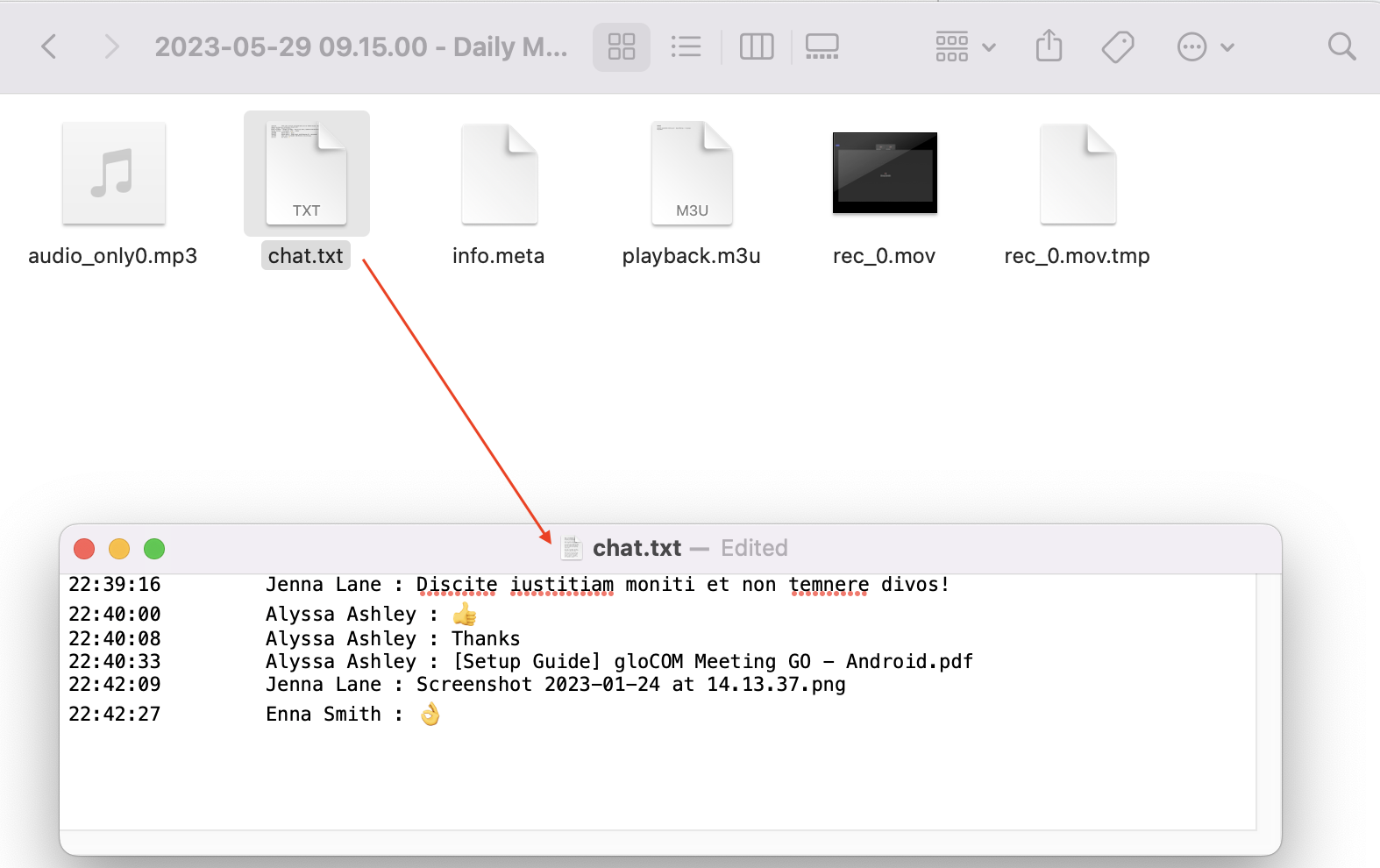
¶ Selecting Audio Input and Output
When the user clicks on the arrow next to the Mute button they will be given the following options:
- Select Microphone (select which device they want to pick up your audio)
- Select Speaker (select which device they want the audio to play through)
- Switch phone (ability to switch the audio device they are using e.g. softphone to desk phone)
- Leave audio (ability to leave the audio channel to only view the video)
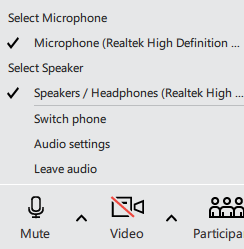
In addition to this, the user can Mute themselves (press the Mute icon) to not let anyone else hear them. If the user is currently muted and attempts to speak, a prompt will appear to inform the user they are muted.
You are muted notification will appear when a user attempts to speak while muted.

¶ Selecting Video Device
Once you click on the arrow next to the Video icon you will be given the option to select which device you want to capture video. This should display all the devices that you have connected and ready to use. You also have the option to click on the Video icon to remove the video you are displaying.
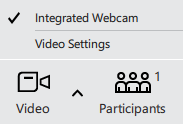

¶ Screen Sharing
If you wish to share your screen during the meeting, simply click on the Share Screen button or request someone to prompt you with one. Then your screen should look something like this.
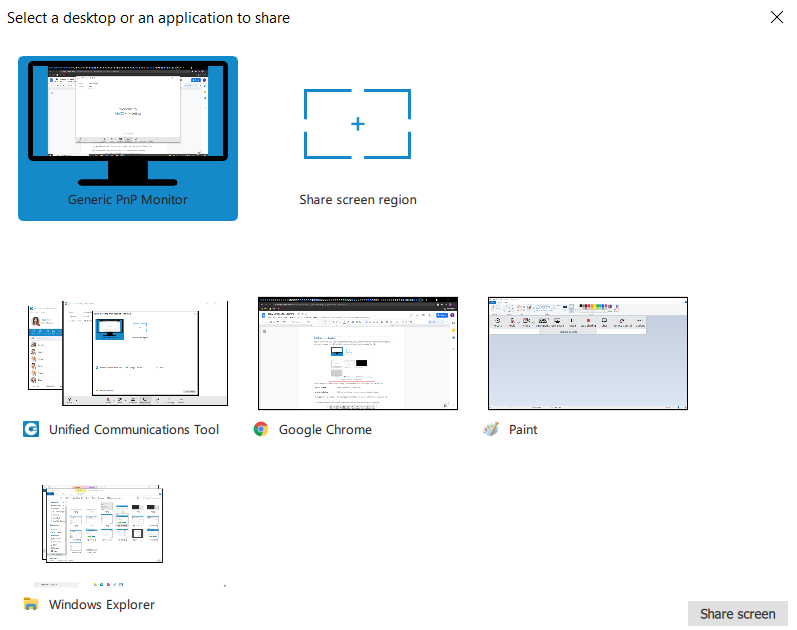
You will be given several options when you wish to share your screen with other participants:
- Whole screen (Share everything on your screen),
- A select window (Only one application you have open, e.g. Google Chrome) or share
- A region of your screen (An area of your screen that you can choose the zones for e.g. top left).
Once you have selected one click on share screen and it will be broadcast to the meeting.
Once you start sharing your screen, you can access the icons at the top of your screen. Here you have all of the previous options, in addition, you have control to:
- Pause sharing (Momentarily stop screen sharing)
- Stop sharing (Permanently stop screen sharing)
- Remote control (Once you give control to a participant they will have the ability to use your computer e.g. move a mouse and input from a keyboard.)
- Clipboard sharing (Copy current clipboard text and, while using the remote control in a meeting, paste it on the remote-controlled host.)

Clipboard sharing
To enable this option, the Presenter, on the desktop app, should give remote control to another user and also press the Share Clipboard button. After that, the user can copy some text to the clipboard and using a remote control paste it on the presenter side.

If the presenter disable clipboard sharing (pressing the Share clipboard button again), this feature will not work anymore.
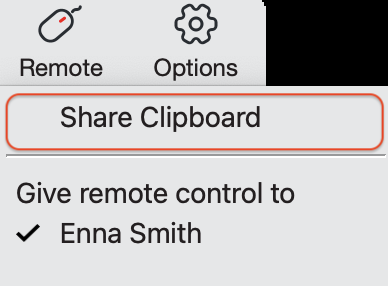
Presenter, on web application, can not give Remote control nor enable Clipboard sharing (to web/desktop users). In other words, it is not possible to take control of someone's computer and access their clipboard if they are in a meeting using the web app.

Only presenters that using desktop app can give Remote control and enable Clipboard sharing (to web/desktop users).
Under options, you have the added functionality to:
- Original size (Change the meeting application to the original size)
- Fit to window (Change the meeting application to the size of the window)
- Hide video panel (Hide the options of the meeting panel from the top of the screen)
- Turn off the incoming video (Remove the video of other participants from reaching you)
- Copy meeting number (Faster method to copy the meeting number)
¶ In-meeting reactions
In-meeting reactions allow users to express themselves visually during the meeting by using heart, like, celebrate, applause, laughing, surprised, sad and dislike emoticons in real-time.

Users can access this feature by clicking the Reactions icon in the Meeting main toolbar. This will open the Reactions menu, and the user can choose which emoticons to use.
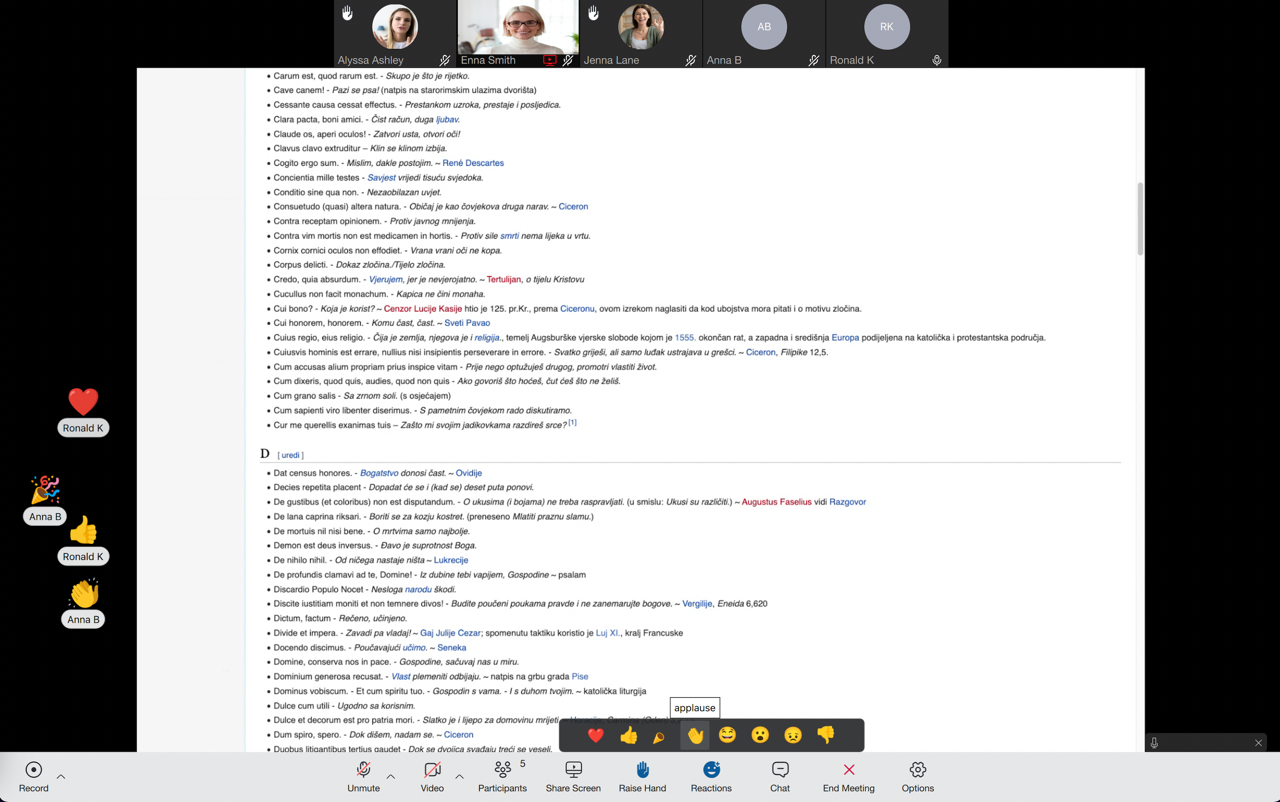
When the user clicks a certain reaction, an animated version of the icon will float upwards from the left side of the screen along with the name of the sender below the reaction.
Only one reaction can be sent at a time.
If users want to hide others’ reactions, they can do so under General Meeting Preferences by unchecking the Show reactions checkbox. By default, this option is checked and reactions are visible.
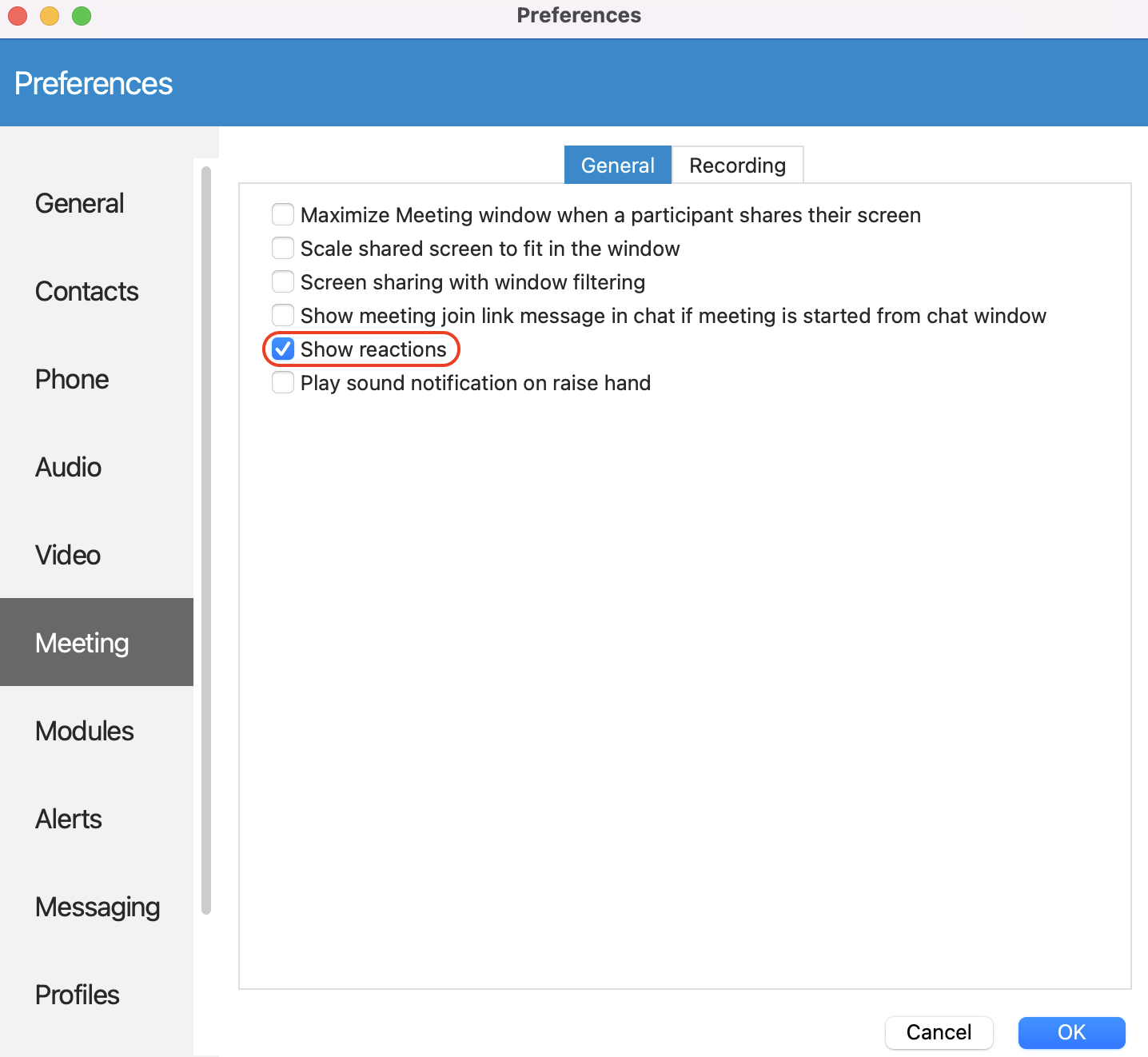
¶ Raise Hand
The Raise Hand feature is a straightforward option to catch a speaker's attention without interrupting them or disrupting an online meeting. Users can access it from the main Meeting toolbar.
As soon as the user Raise Hand, the icon colour in the user’s main toolbar is changed, so that the user is aware that the option is active.

And vice versa - as soon as the user lowers hand, the icon is not marked any more - colour is set back to transparent.

Participants’ Raised hands are displayed in the upper left corner of their video stream in the Meeting screen (in both - carousel and grid view) and in the Participants list next to the participant name.
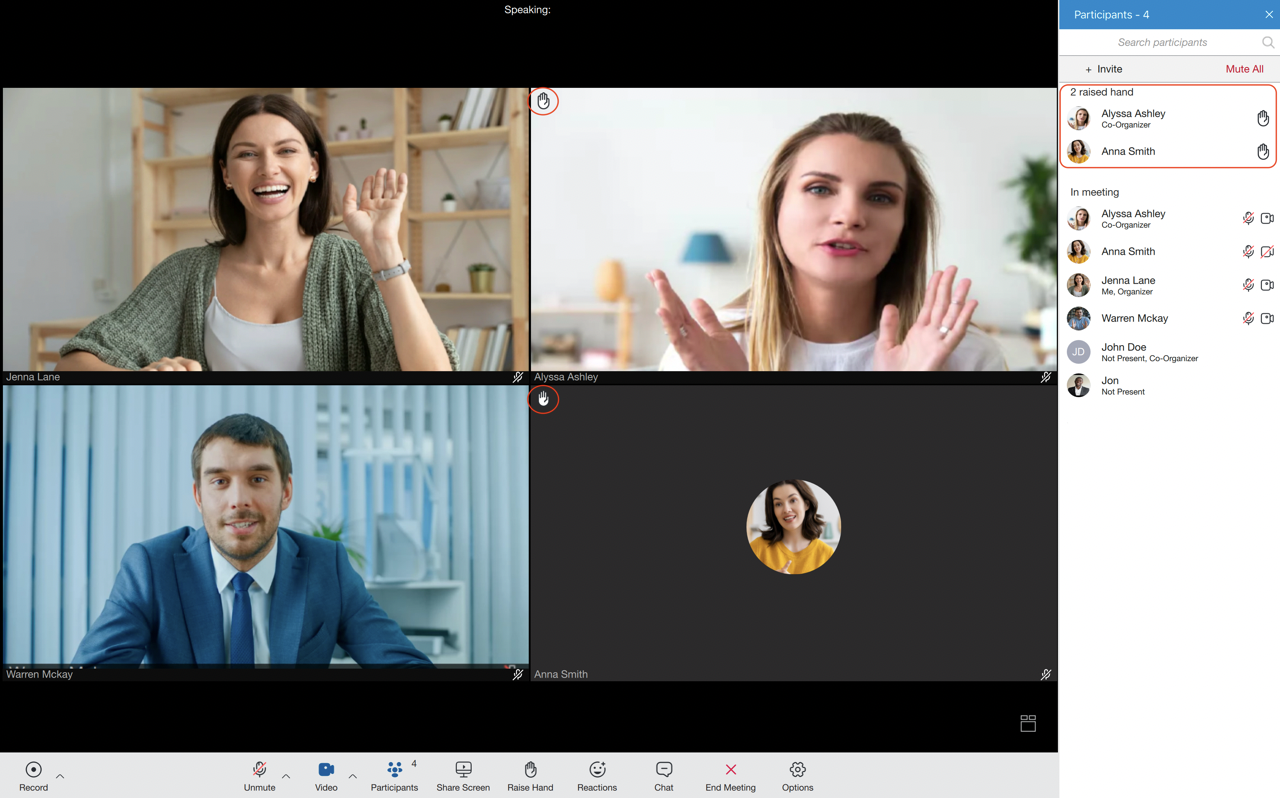
Additionally, on desktop application, the user will also get a notification message in lower right corner that someone has raised the hand.

Sound notification on the Raise Hand option is also presented. If a user wants to mute it, they can do it under General Meeting Preferences by unchecking the Play sound notification on raise hand checkbox. By default, this option is enabled.
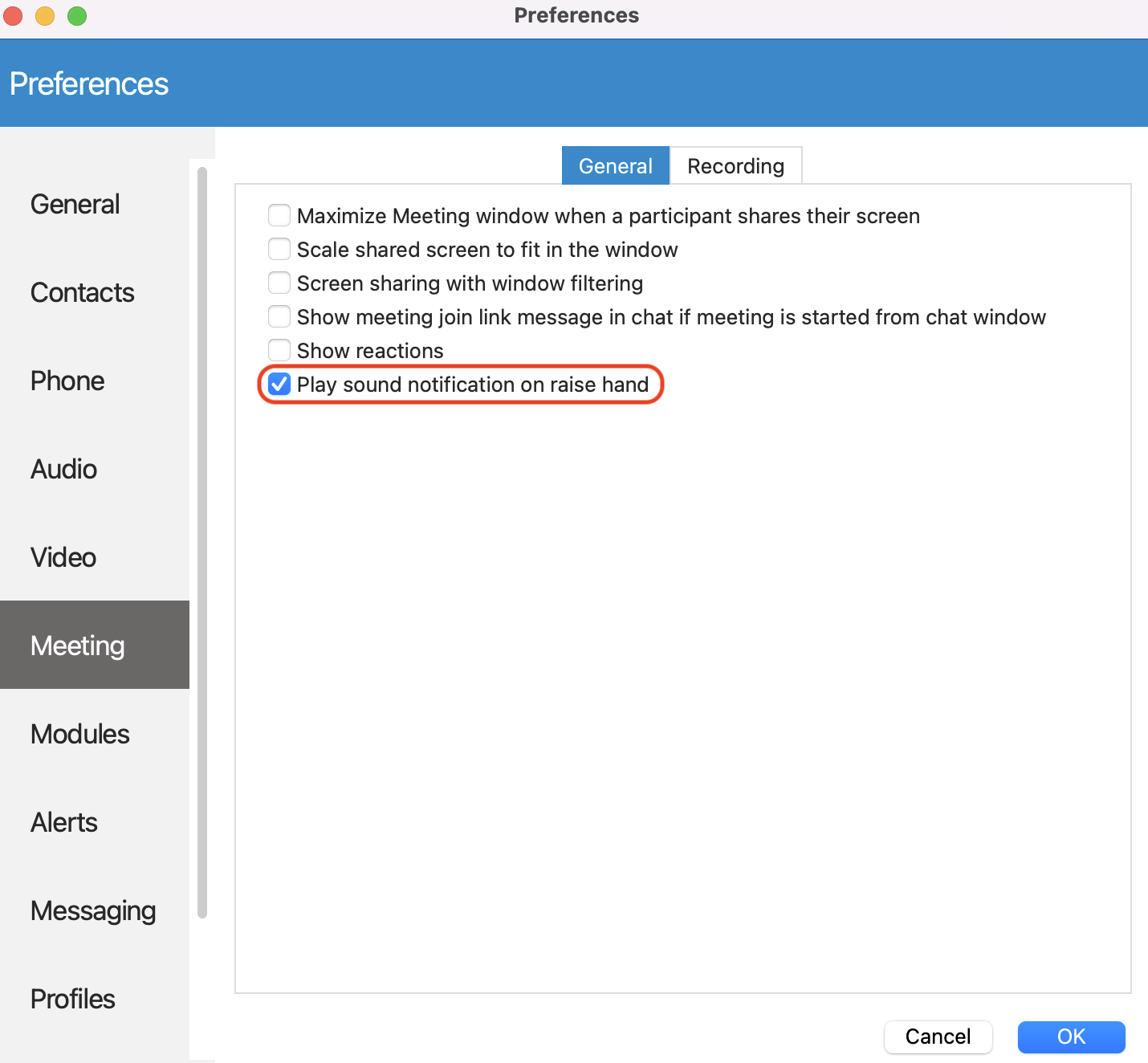
While in screen-sharing mode, the presenter will be notified properly when someone has raised a hand.

When a reaction is received on the presenter’s side, the floating control bar will appear and in the participants list a raised hand will appear as well. This one will be blinking, changing colour from transparent to blue, so it is easier to notice. As long as there is at least one raised hand, this image is displayed in the Participants button. The presenter can open the participants list to see more details.
When the user raises a hand, the organizer is able to lower it, by clicking on raised hand icon next to the user’s name in the participants list.
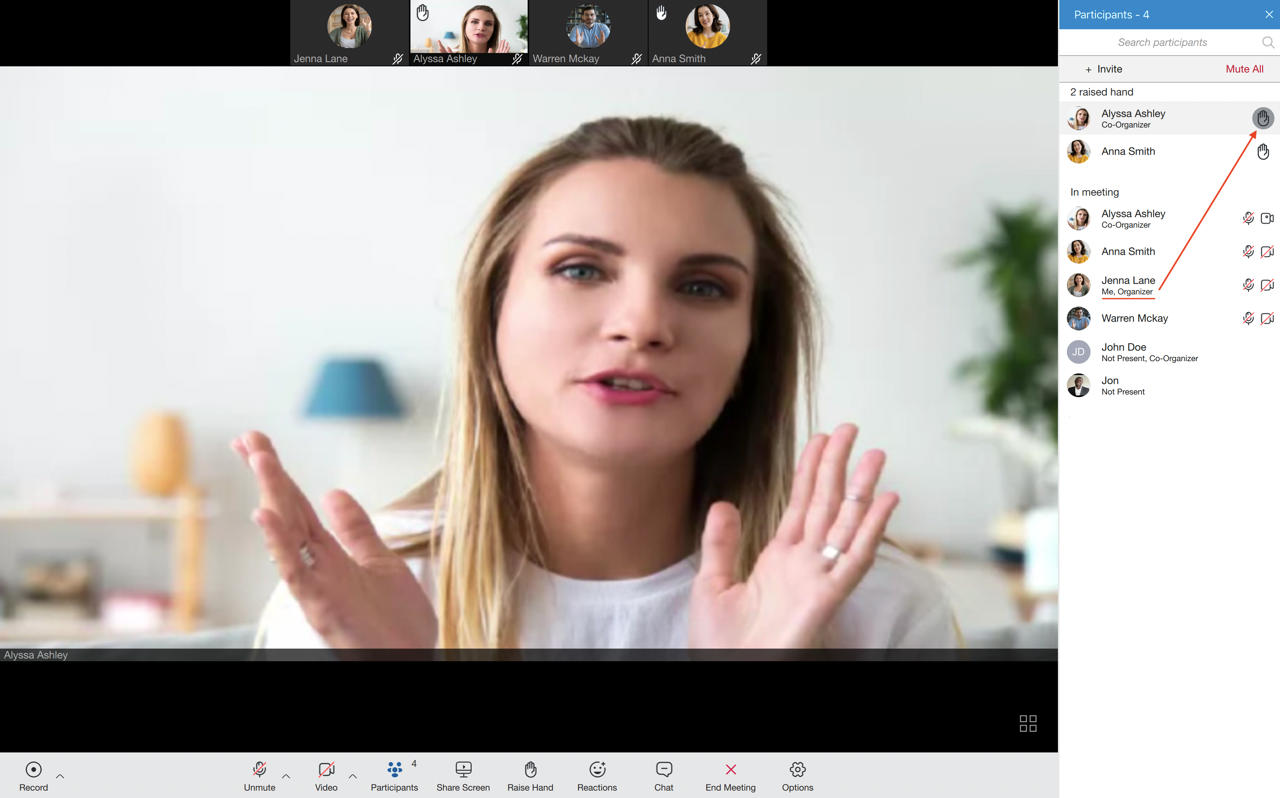
¶ Pre-expiry notification
Pre-expiry notification is a feature designed to automatically send a notification to all meeting participants ten minutes before the end of the maximum meeting duration based on the license/package type. This notification serves as a gentle reminder that the meeting is approaching its conclusion. If message is not closed, it will countdown automatically time till the end of the meeting. Also if someones joins meeting less then ten minutes before the end, it will get a message with exact time ramains for that meeting.
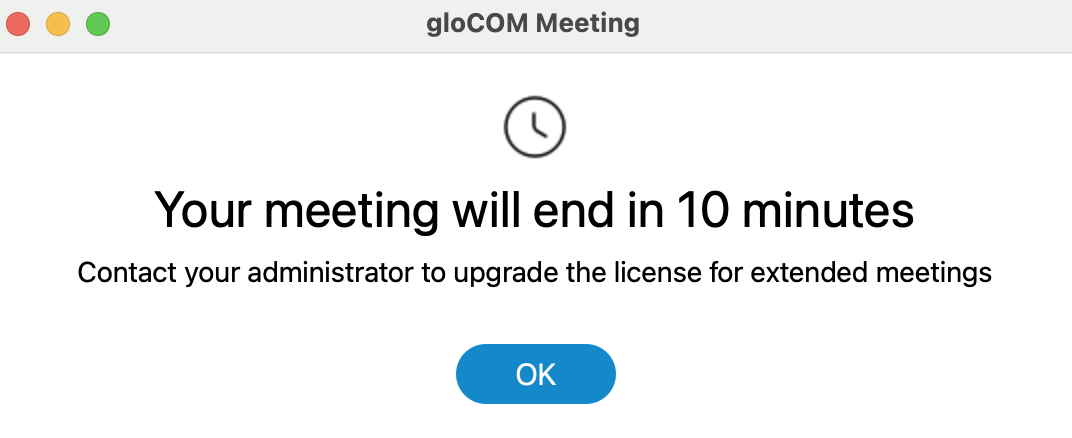
This message pop-ups in front on all opened windows on your machine, even if Meeting screen on desktop app is minimized!
¶ Multiple co-organizers of the meeting
Using the co-organizer role in Meetings ensures that there is more than one person that can manage important settings in a meeting. It’s a very useful role if the organizer will not be present and as a support to the organizer in terms of being able to co-manage.
¶ Assign co-organizers
One single Meeting can have multiple coorganizers. Meeting participants can be promoted to Coorganizers from desktop app as follows:
- While scheduling a meeting - participants added to the meeting can be promoted to co-organisers
- When the Meeting has already started, from the participants list - using right click on the name will allow Organizers to assign this role to the participant
¶ Add coorganizers while Scheduling meeting
After adding participants to the meeting (While scheduling a meeting), right click on the participant name will open a drop-down menu that contains the Assign Co-Organizer option. Press this option to promote the participant to the Co-organizer role. Note that the participant has been added to the Co-organizers list in the Schedule meeting window.
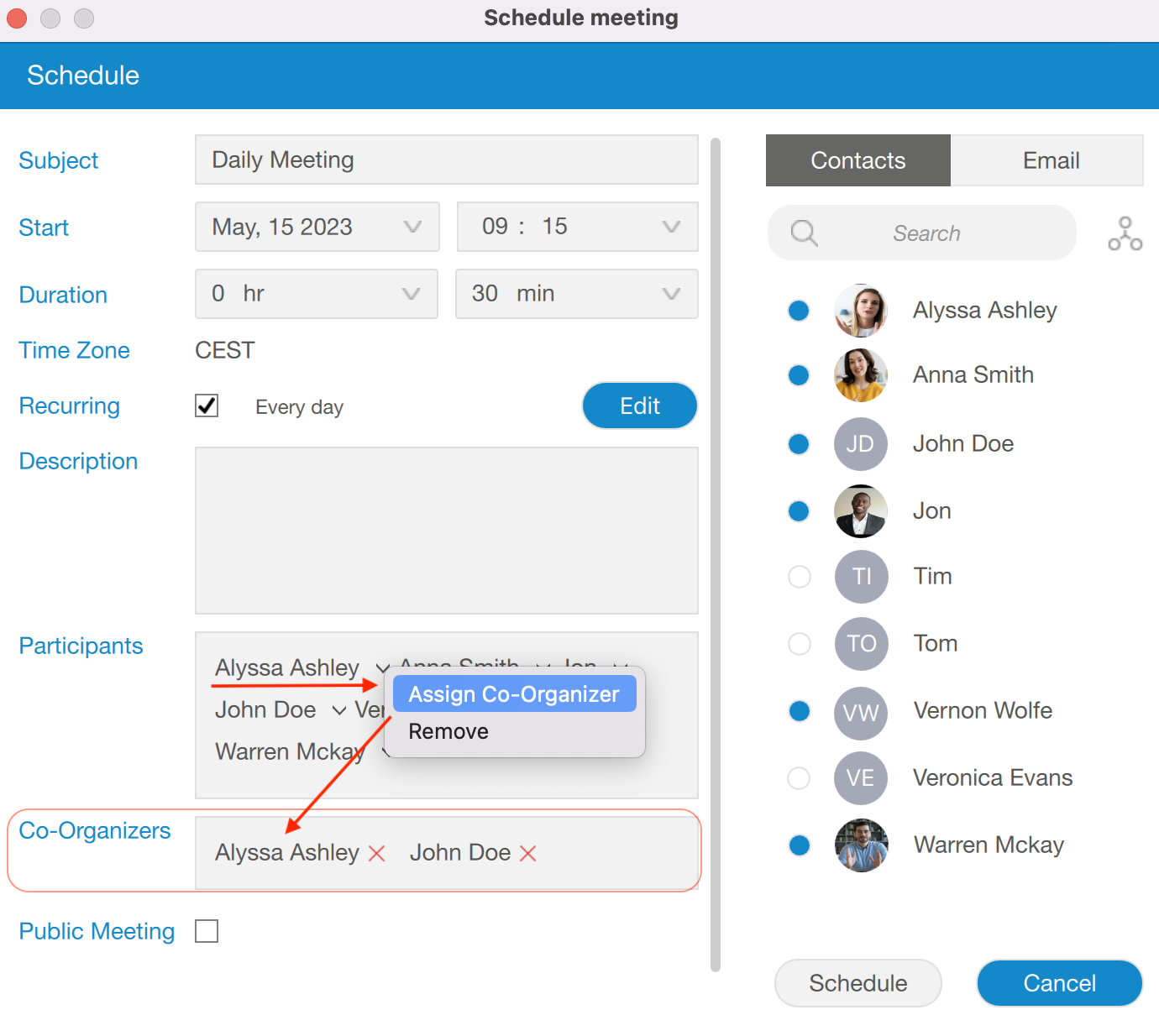
If you mistakenly promote some participants to be co-organizers and want to remove them from co-organizers, it is possible by clicking on the X sign next to the co-organizer name. Co-organizer will be removed.

These co-organizer roles are also visible in corresponding Meeting details, in the Scheduled Meetings list:
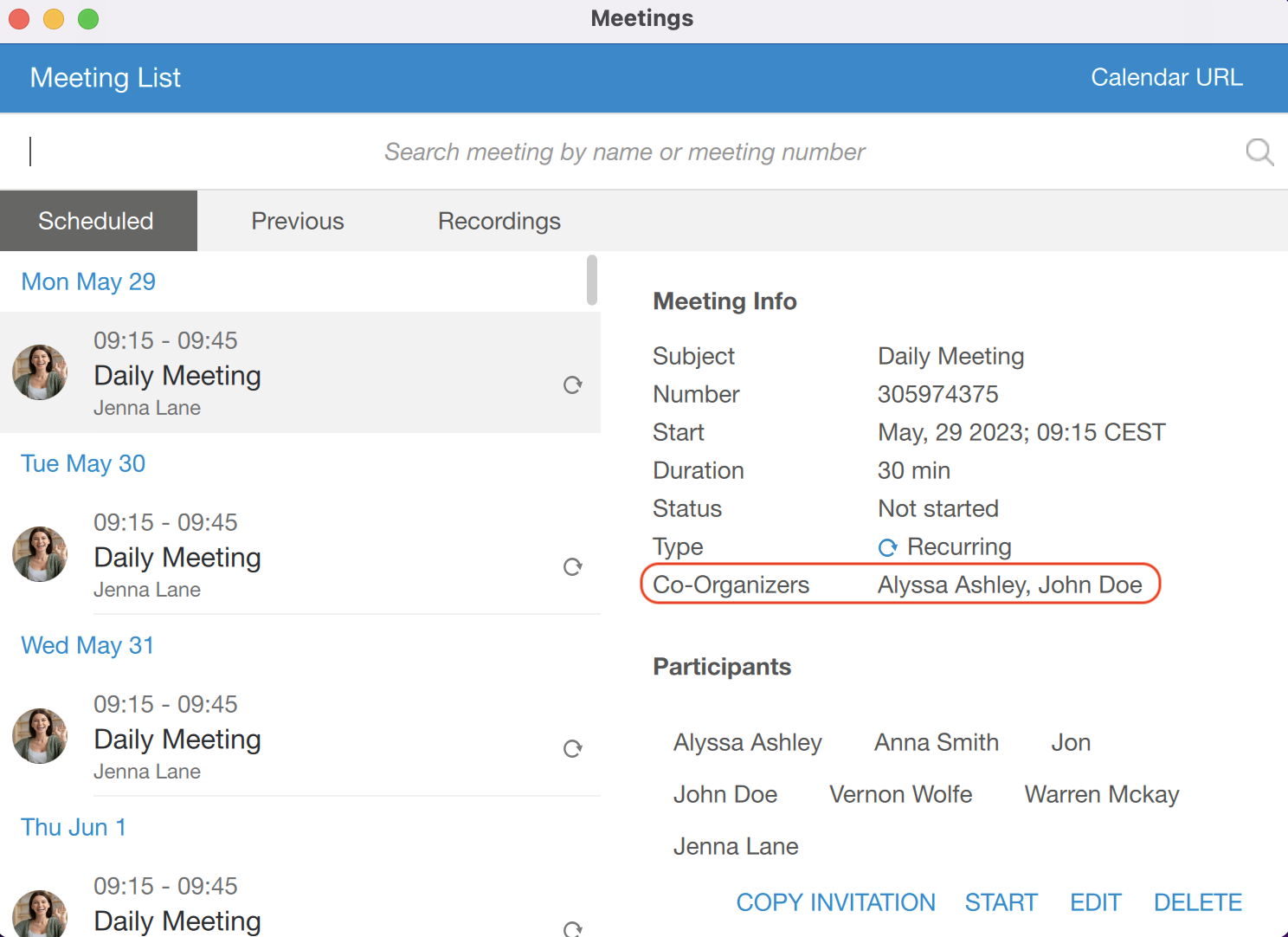
¶ Add coorganizers from Participants list
Organizers have permission to assign co-organizers during the meeting. This is possible from participant list. Right click on the participant’s name will show all options for managing participants. Press Assign Co-Organizer option to promote selected participant to Co-organizer.
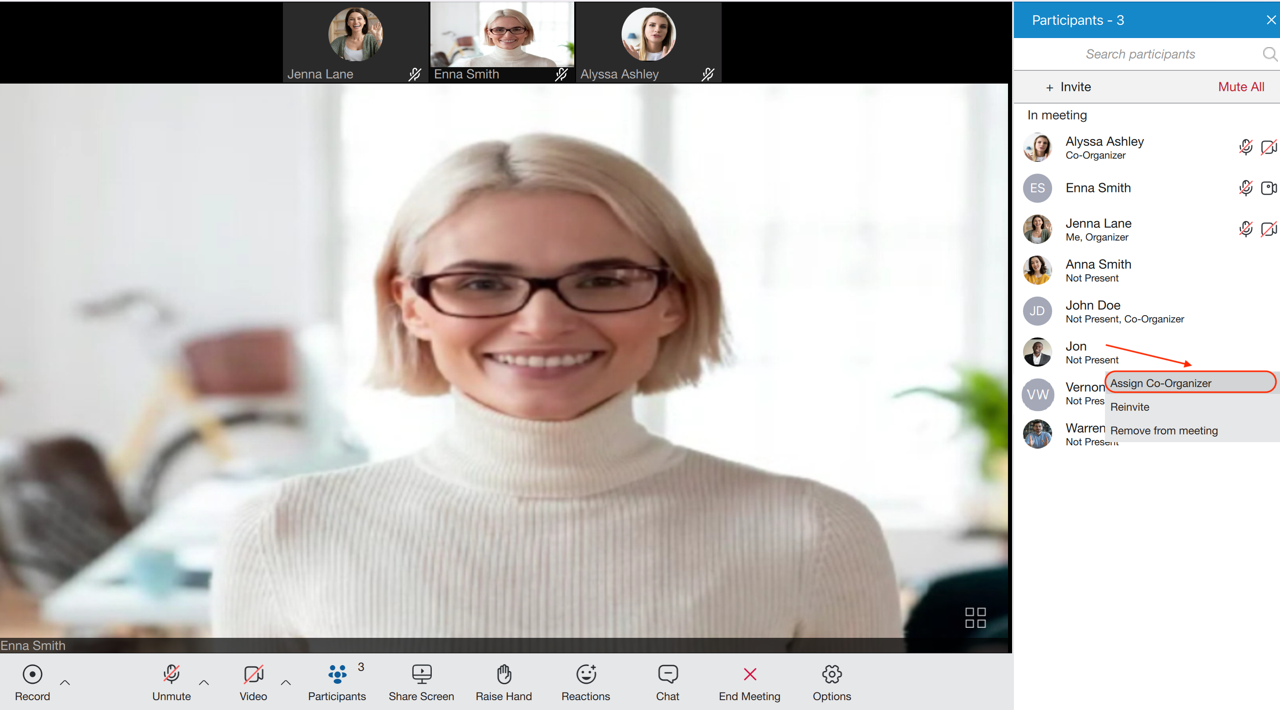
All co-organizers that join meeting via desktop app will have Co-Organizer label in meeting participants list, right below their name - the same way all other labels are added.
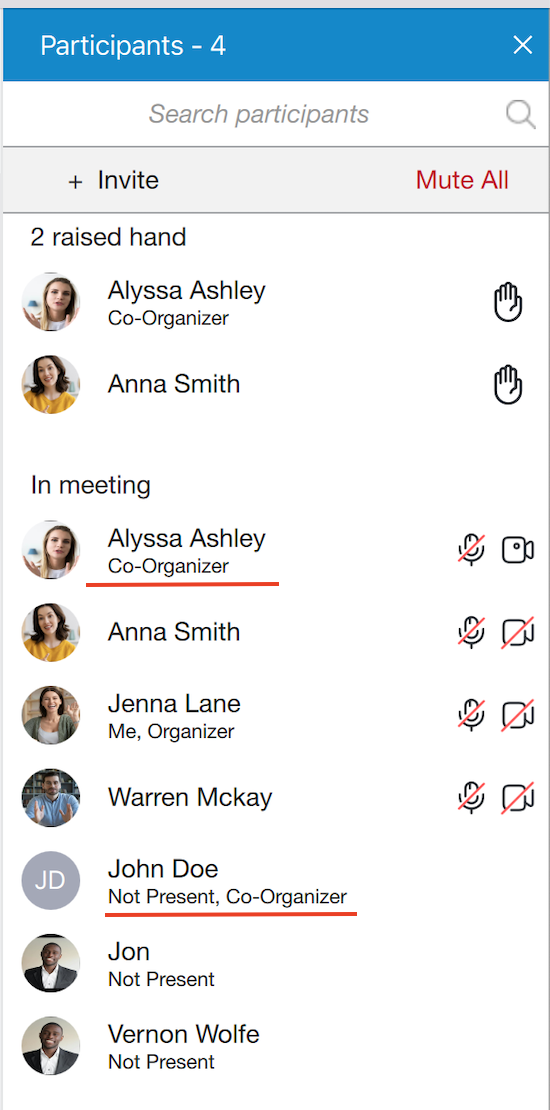
¶ Co-Organizers permissions
Once they are created, the Co-organizers themselves will be able to:
- Start, Edit and Delete the meeting from Schedule meetings list
- Add & remove participants, assign co-organizers, etc while editing the meeting
- Add and remove participants during the meeting
- Mute and Remove participants from the audio during the meeting
- Assign co-organizers during the meeting
- Lower participants Raised hands during the meeting
- End the meeting
¶ Start, Edit and Delete the meeting from the Schedule meetings list
As a Co-organizer, you are able to Start, Edit and Delete meetings from the meeting list. To do so, navigate to the Meeting list and select meeting. These options are available the same way as you are the organizer.

While editing the meeting from Schedule meeting list, you are allow to add & remove participants and assign co-organizers as well.
¶ Co-Organizer permissions in a Meeting
In a meeting, Co-organizer has almost the same permissions as the organizer. Most of these options are available from the Participants list:
- Click on Invite button to add new participants
- Right click on participant name in the list to manage that particular participant using one of the following options: Assign co-organizer, Mute, Remove participants from the audio and Remove participants from the meeting
- Press Raised hand icon next to the participant name to Lower the participant Raised hand
- End the meeting - Co-Organizers that join the meeting via the desktop app have the option to End the meeting - the same way as Organizers can do it.
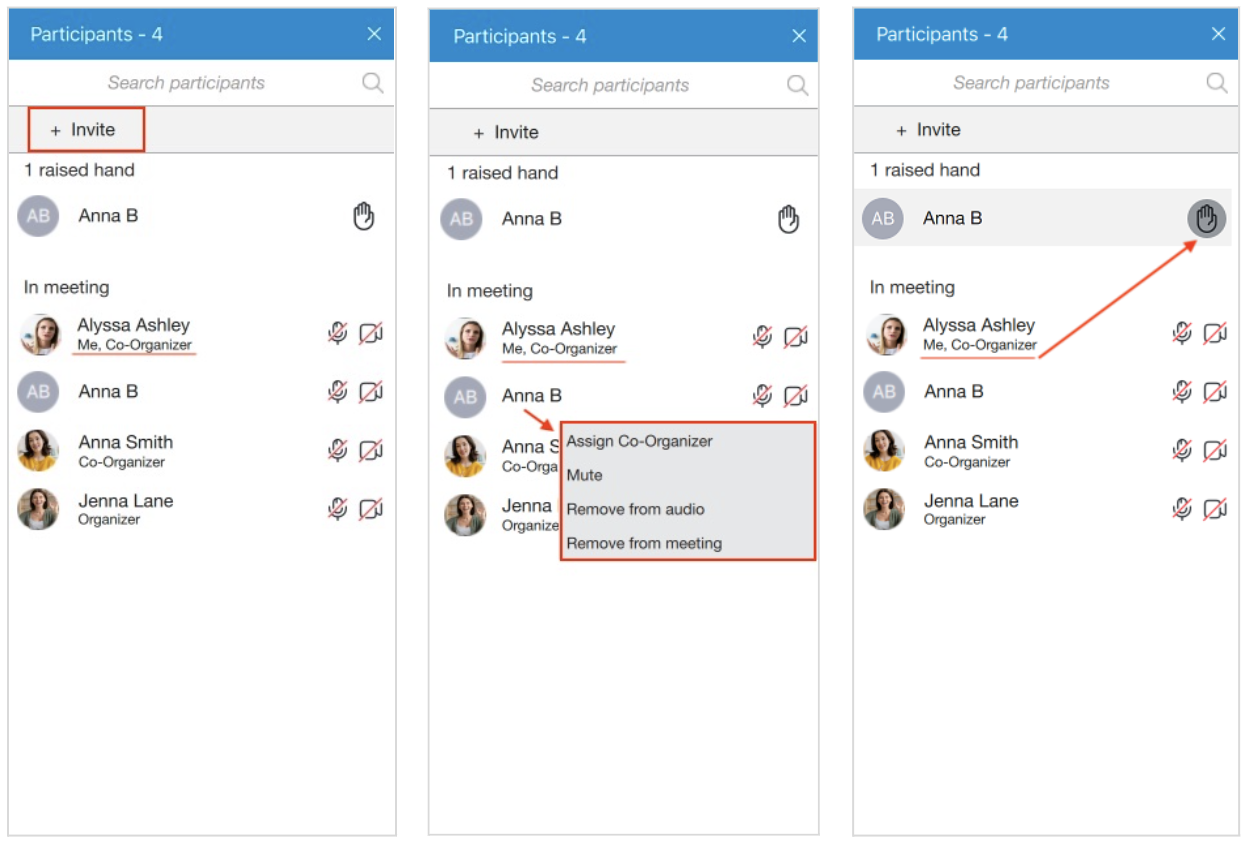
¶ Outlook integration
Outlook integration allows user to manage gloCOM Meetings from Outlook. This includes following:
- Schedule a Meeting
- Start Instant Meeting
- Start Meeting with multiple contacts
- Cancel a Meeting
- Convert existing event to gloCOM Meeting
Schedule a meeting
User can Schedule gloCOM Meeting from outlook main tab.
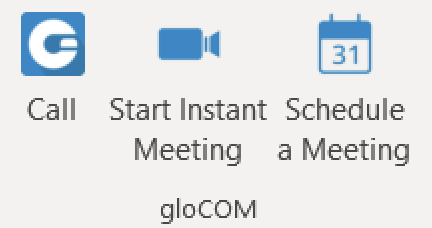
After cliking on to Schedule meeting, user should see an outlook meeting appointment window with a schedule settings dialog where can set the meeting private or public.
After confirmation, outlook appointment interface is filled out with meeting data.
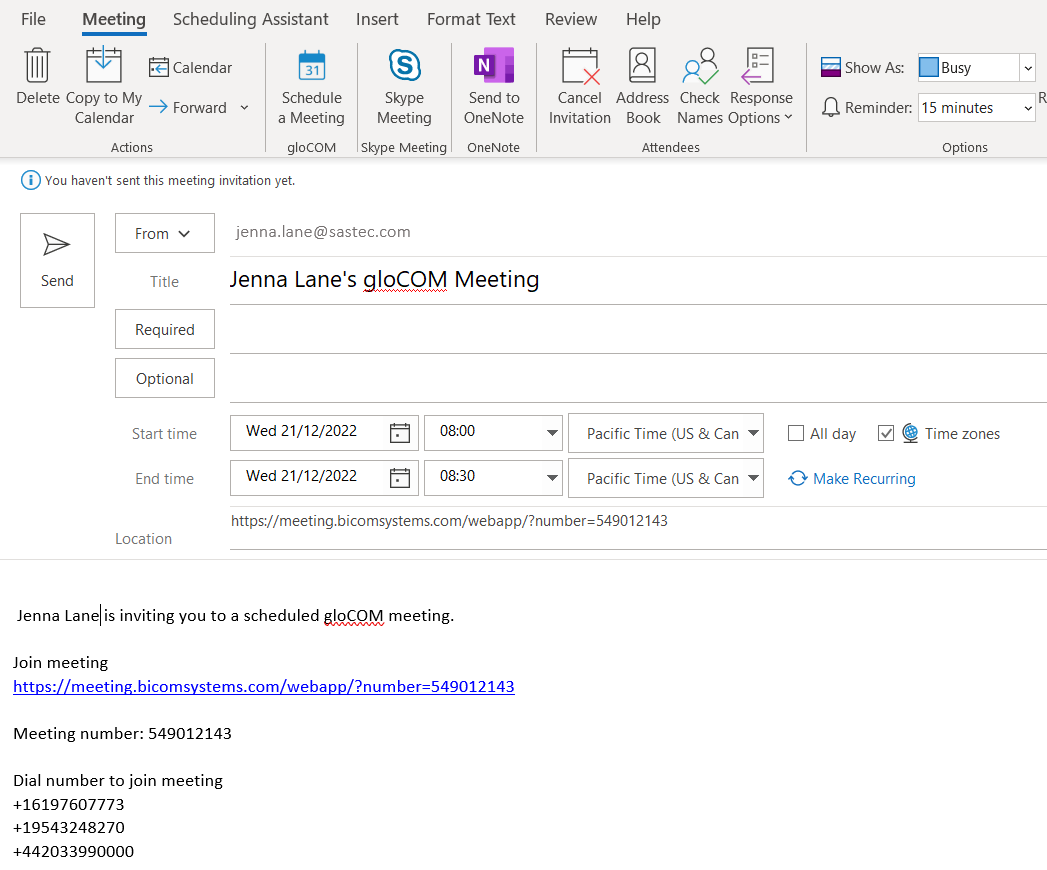
A user is allowed now to edit this invitation - to change subject, body; set date and time, add participants, etc. When enter all necessary data, user should Send invite to participants.
Meeting then will be added to gloCOM Meeting list.
Starting instant Meeting with one or multiple contacts
User is able to Start Instant Meeting from outlook main tab if press gloCOM Start Instant Meeting icon. This will start instant meeting without any participants.
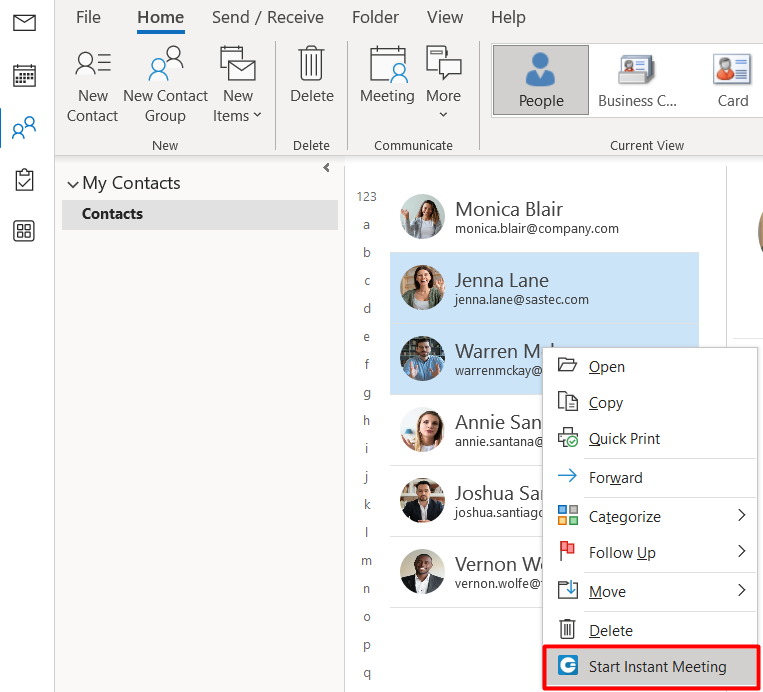
Another option is to Start Instant Meeting with one or multiple contacts, by selecting them from the contact list in outlook. Selected contacts will receive a Meeting invitation.
Cancelling a Meeting
In order to Cancel the Meeting, user should open that Meeting from the outlook calendar list, and choose gloCOM Cancel Meeting option.
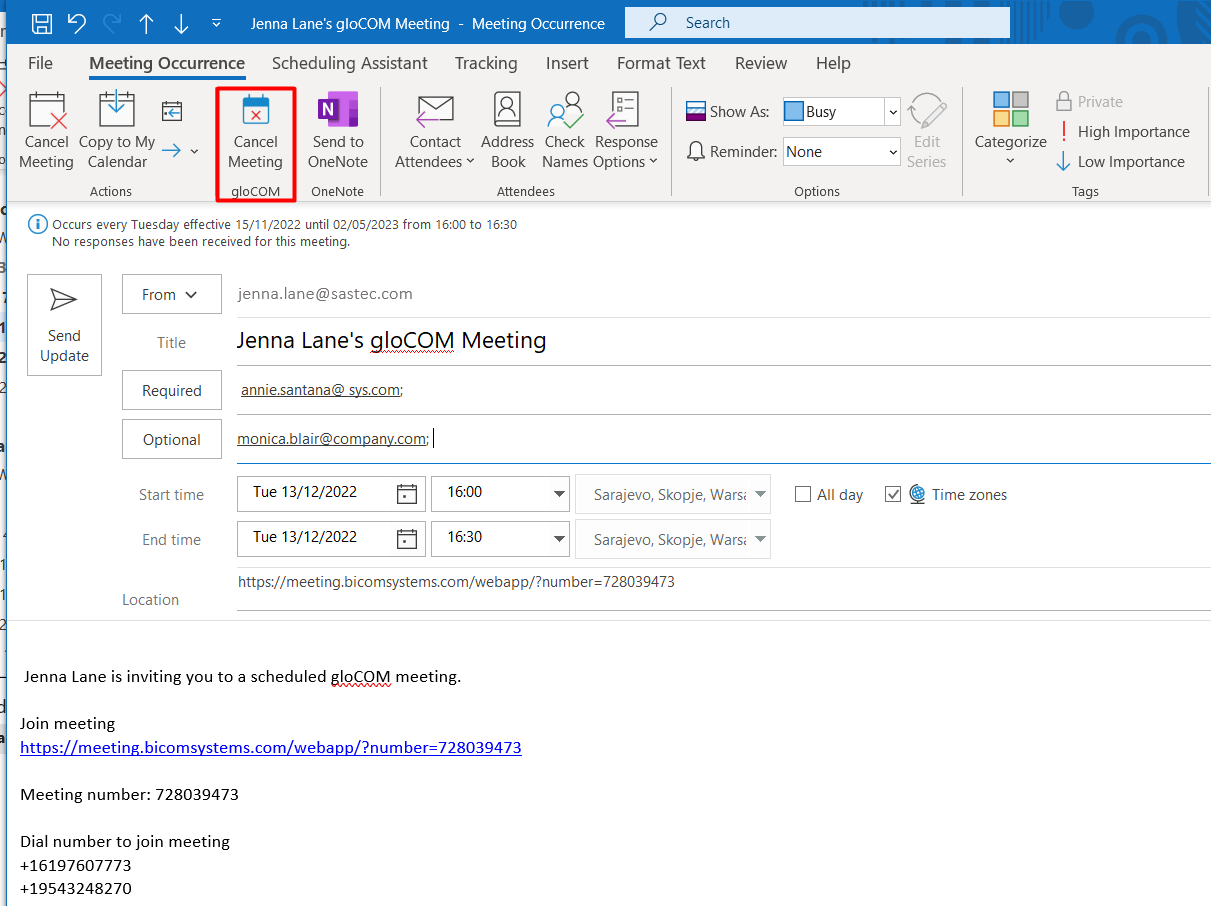
After that, user should press Sent Update icon to inform all invitees about cancellation.
Meeting then will be removed from gloCOM Meeting list.
This option will only delete gloCOM Meeting. Outlook appointment will not be deleted.
Convert existing event to gloCOM Meeting
To convert outlook appointment into gloCOM Meeting, user should do the following steps:
- Find an existing event in Outlook calendar and open it
- Click on Schedule meeting icon
- Edit your meeting if needed
- Send Update to participants
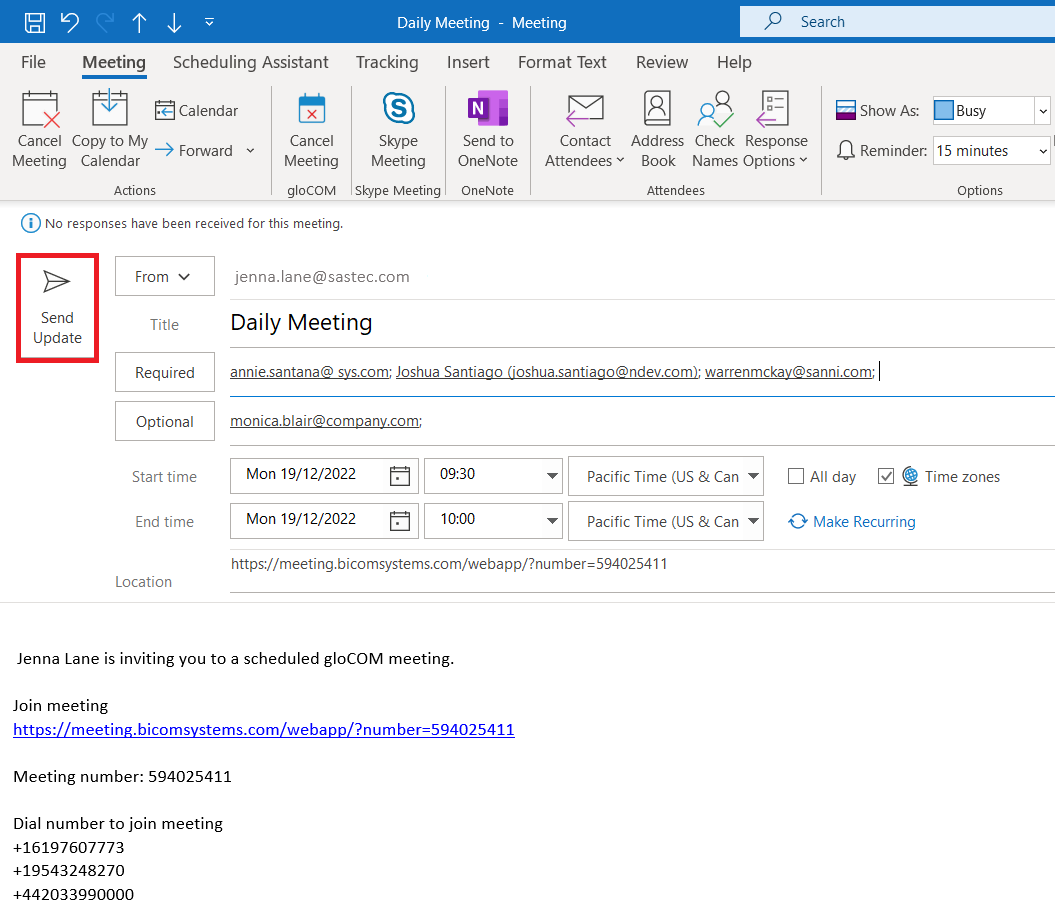
Meeting is now added to gloCOM Scheduled Meetings list.
¶ Meeting Licences
The limitations of the Meeting packages are as follows:
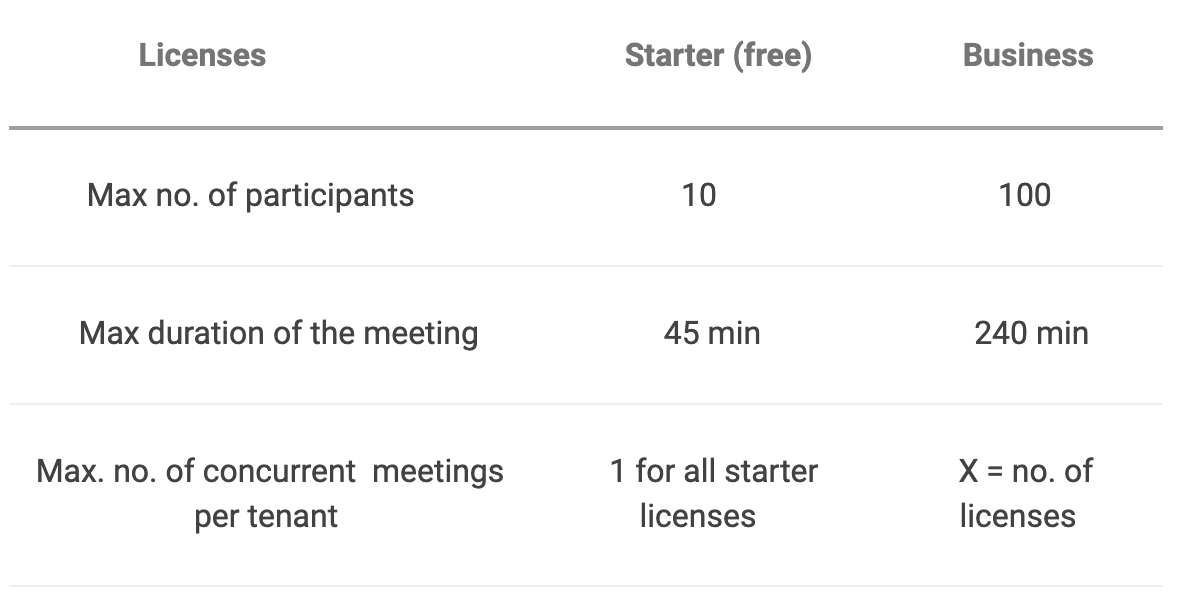
Starter package is defaualt one. This means that will be automatically assigned to all gloCOM Meeting users.
So, if user exceeds limitations for current package type, following info messages appears:
- Message when user exceed number of invitees - when scheduling meeting or adding participant to existing meeting
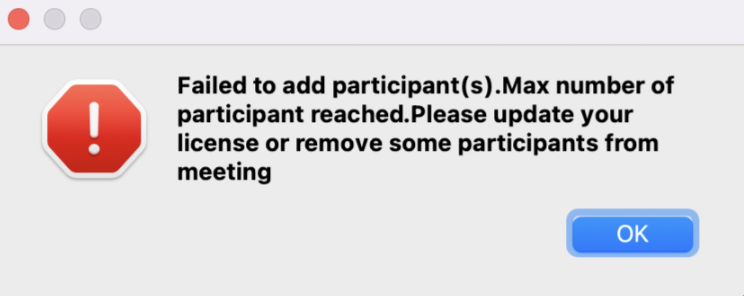
- Message when user exceed number of meetings for current license type
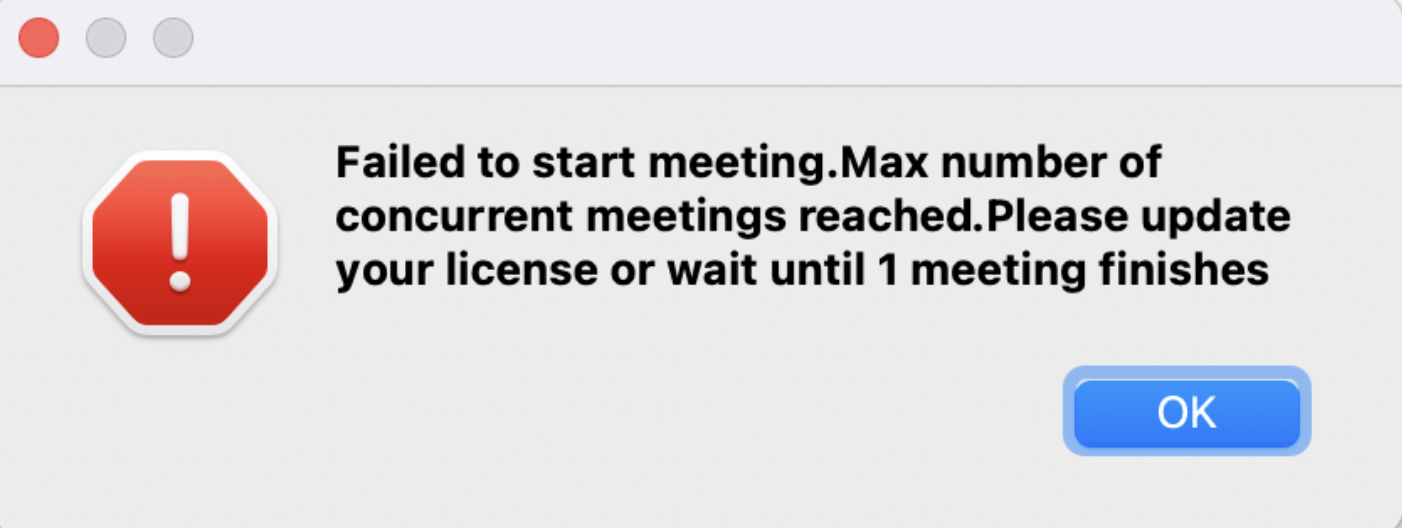
- Message when user does not have license
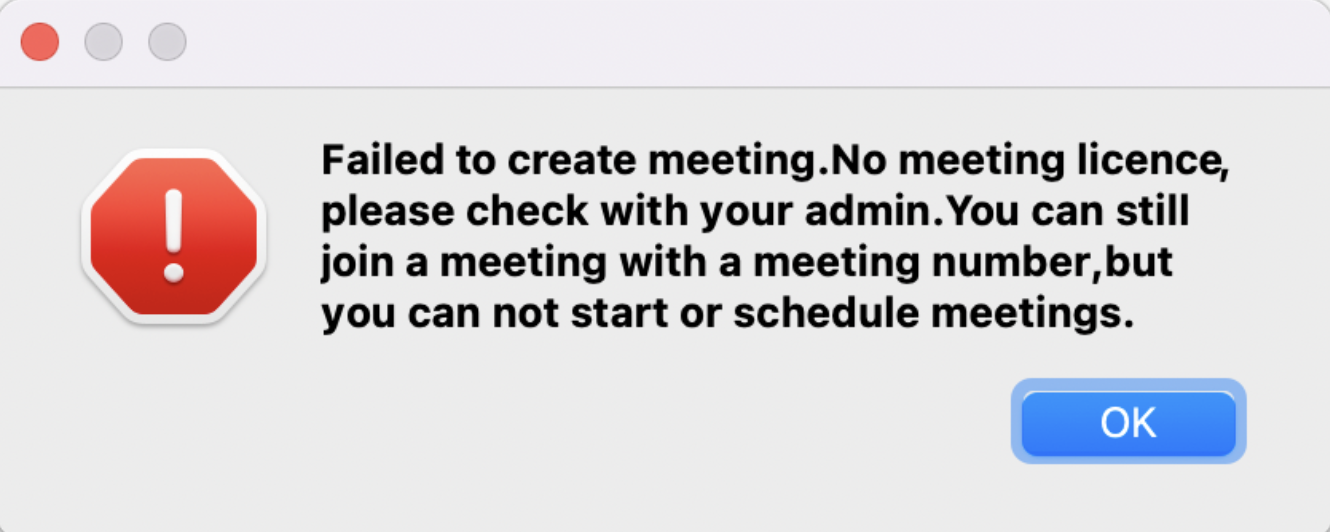
¶ Chat
gloCOM brings a unified chat between Desktop, Web and Mobile applications. Chat history is stored on the server and is always synced between all your devices. This means that if you need to leave the office but you were having an important chat discussion with your colleagues you can seamlessly continue chatting using your mobile application. Also, in case you change your PC or laptop your full chat history will be synced the first time you log in on the new computer.
¶ Full history sync
After every log in the application makes sure that your chat history is always synced and that you have all messages available on your device.
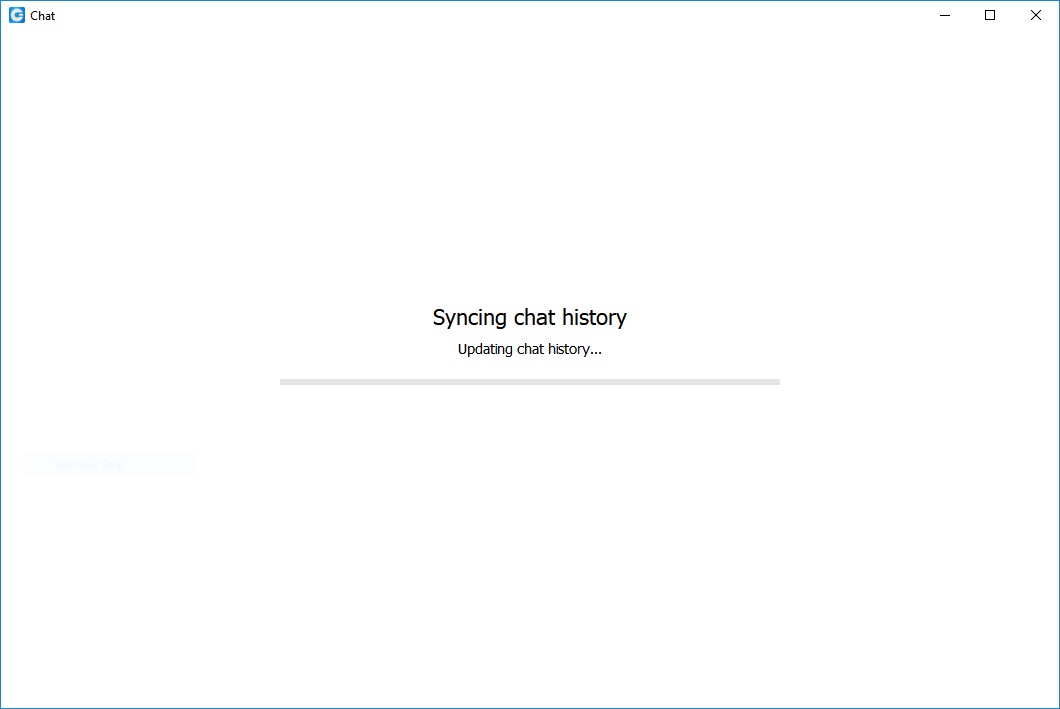
![]() During the sync there is an indication on the chat module icon in the main window to inform the user that the sync is currently in progress.
During the sync there is an indication on the chat module icon in the main window to inform the user that the sync is currently in progress.
If you open the chat window during sync you will see an informative message, with a progress bar indicating the sync progress.
If chat sync has failed there is a warning in the chat window with the option to retry the sync by pressing the Retry button.

In case that chat sync has failed because chat server was down at the time you logged in, the application will automatically start the sync process again, once it detects that the server is back up.
¶ Chat server unavailable
If chat server is down you cannot send nor receive messages until it gets back up.
![]() While the chat server is down there is an indication on the Chat module icon in the main window to alert the user.
While the chat server is down there is an indication on the Chat module icon in the main window to alert the user.
If you open the chat window while the server is down, there is also an informative message that the chat server is not connected.

As soon as the application detects that the chat server is back up the warning is dismissed and you can continue chatting where you left off.
¶ Starting conversations
Click the Chat module icon in the main gloCOM window to open the chat window. The conversation list on the left side of the window displays all users' conversations, while the right shows the currently selected conversation.
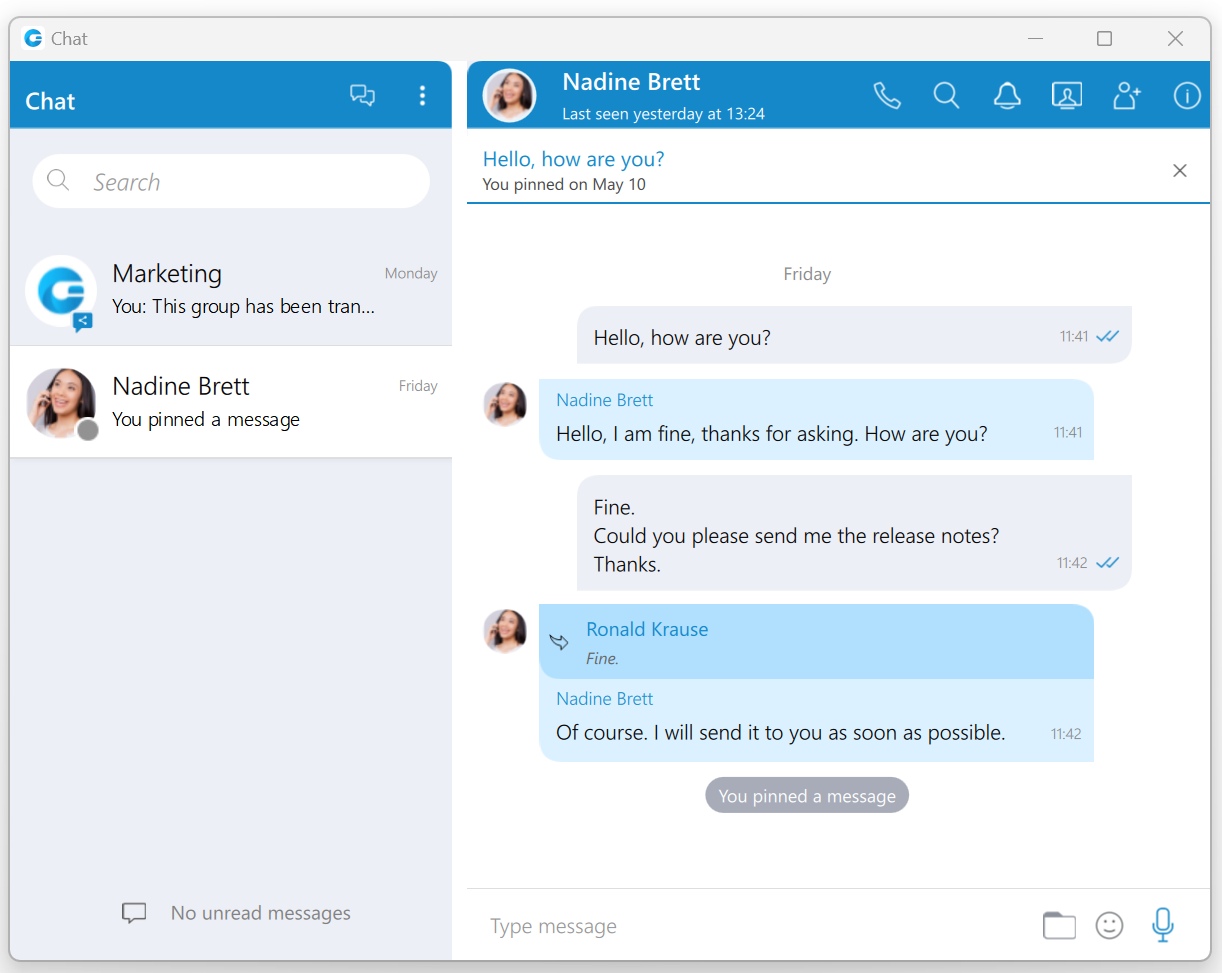
There are a few ways to start a conversation, or to open the existing conversation with another user:
- Click on the chat icon when hovering over a user in the main window (only for Grid View).
- Right-click on a user in the main window, and choose the option Chat from the menu.
- Double click on a user in the main window (if your default double click action is set to Chat inside the Preferences).
- Select multiple users in the main window, right-click, and choose the option Group chat from the menu to create instant groups from the main window.
- Search for a user inside the chat window and click on the desired user.
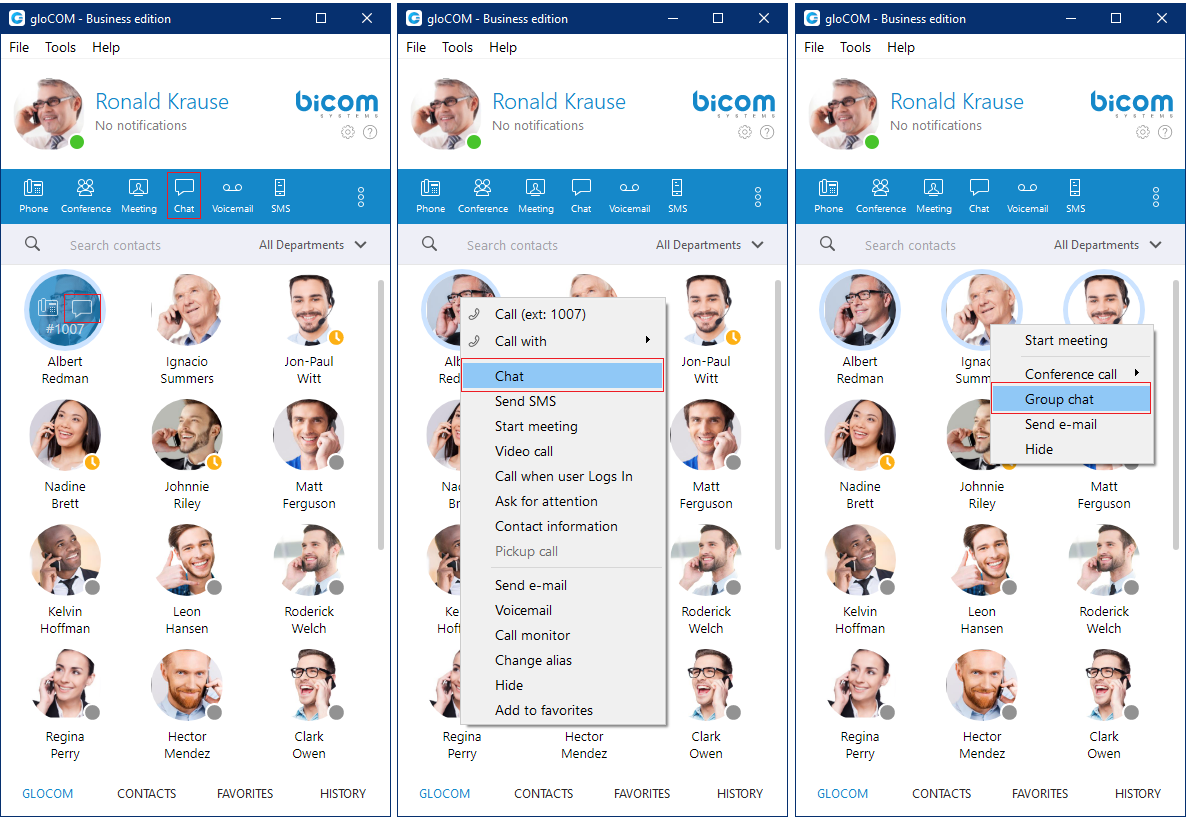
¶ Top blue bar
The top blue bar at the top of the window consists of two parts. The Create Group and Options buttons are positioned on the left side.
The Create Group button is used for creating groups, while the Options button contains the following options:
- Create Group
- Close All Chats
- Show Closed Chats
- Legacy Chat History
- Re-sync the entire chat history
- Options
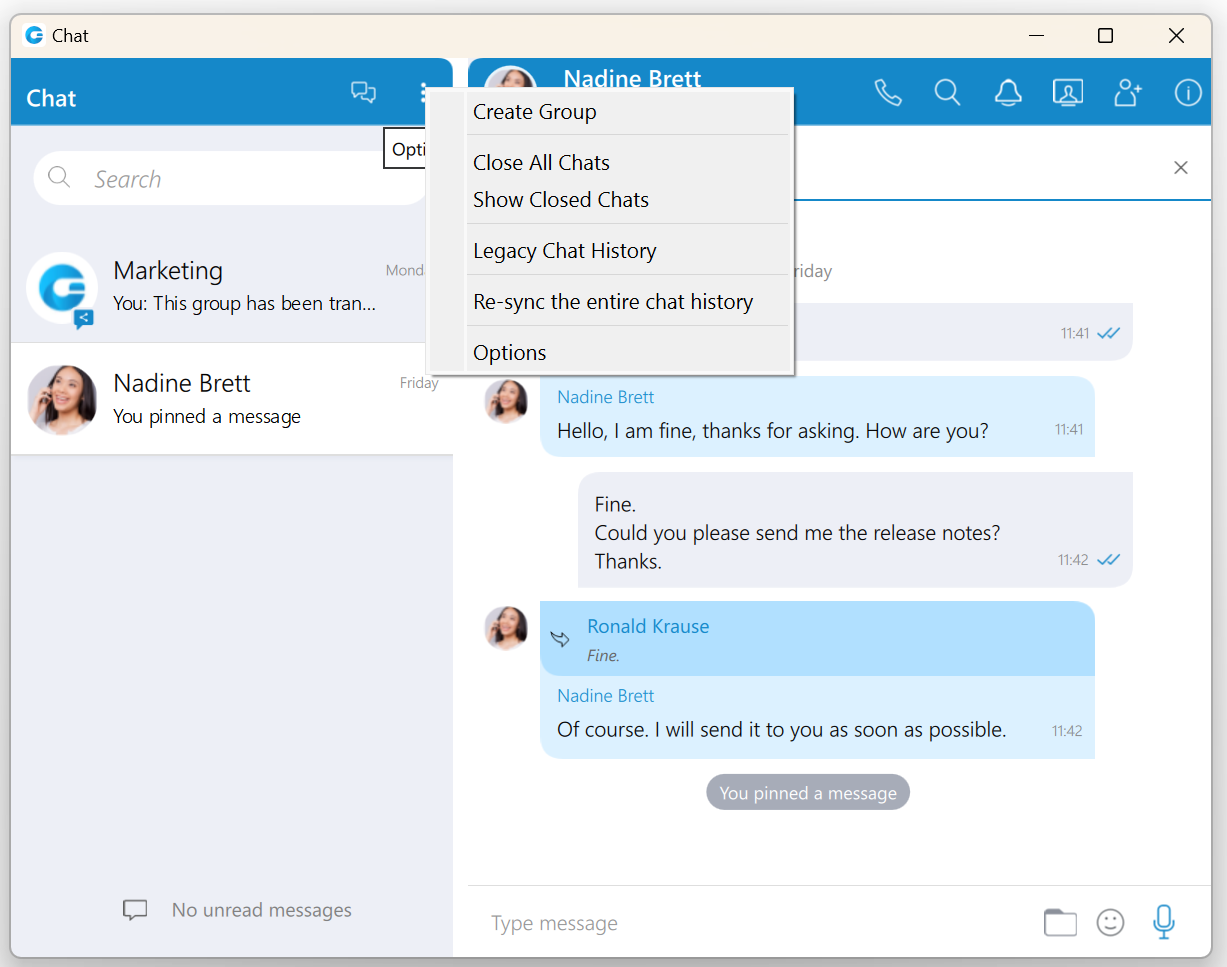
Create Group Chat option is used for creating group conversations (as the group creator, you are automatically the group administrator). Two types of groups are available. The first type of groups are ordinary groups, meaning that the chat history will not be available to newly added participants. The second type of groups are groups with visible chat history, meaning that the full chat history will be available to newly added participants.
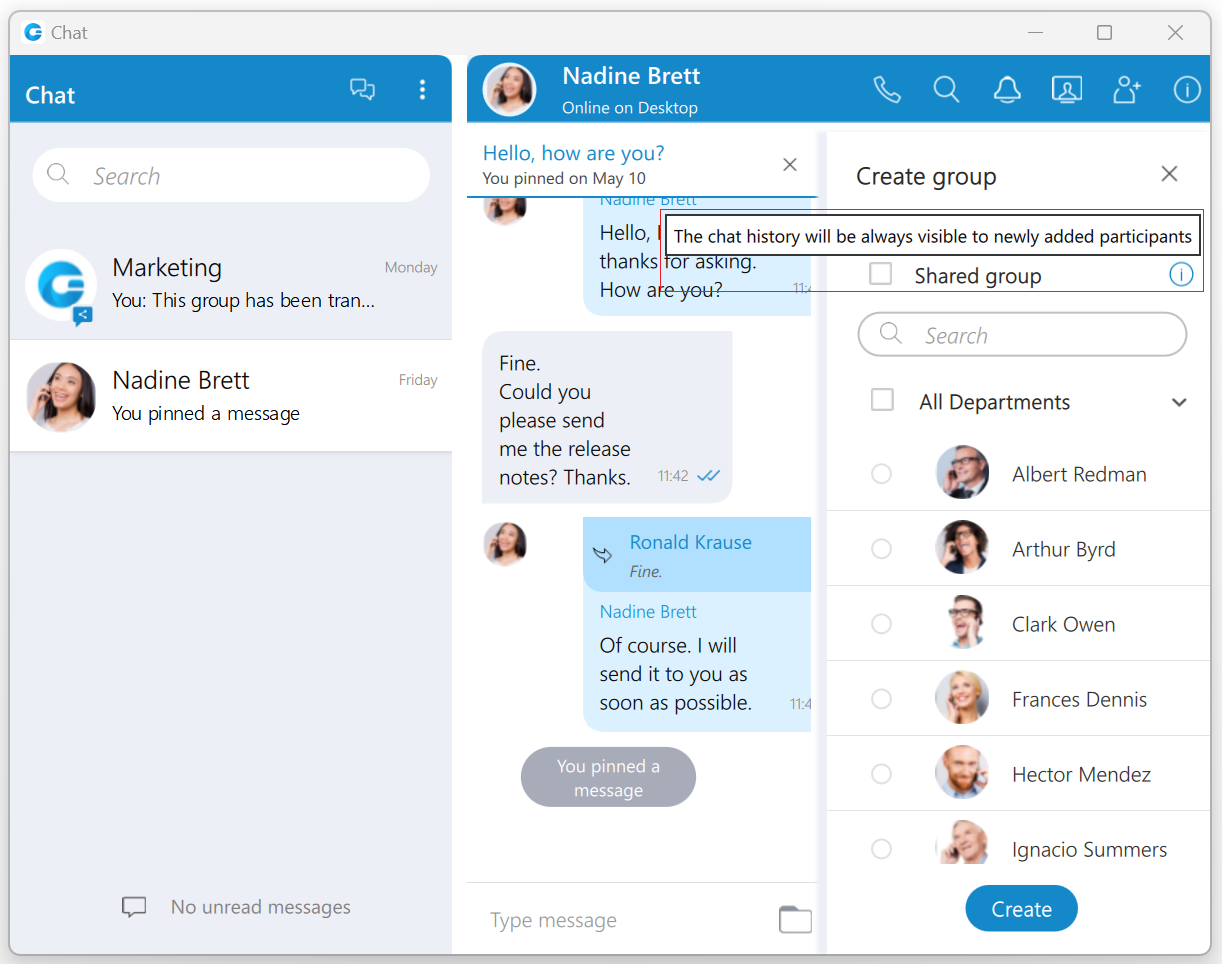
To create a group with visible chat history, check the option Allow full history visibility.
 - Indicates that the chat history is visible to newly added participants.
- Indicates that the chat history is visible to newly added participants.
The group name may or may not be provided during the group creation. If the user does not provide a group name, the group name will be just Group. However, the user can change the group name at any time after creating the group by clicking on the group name.
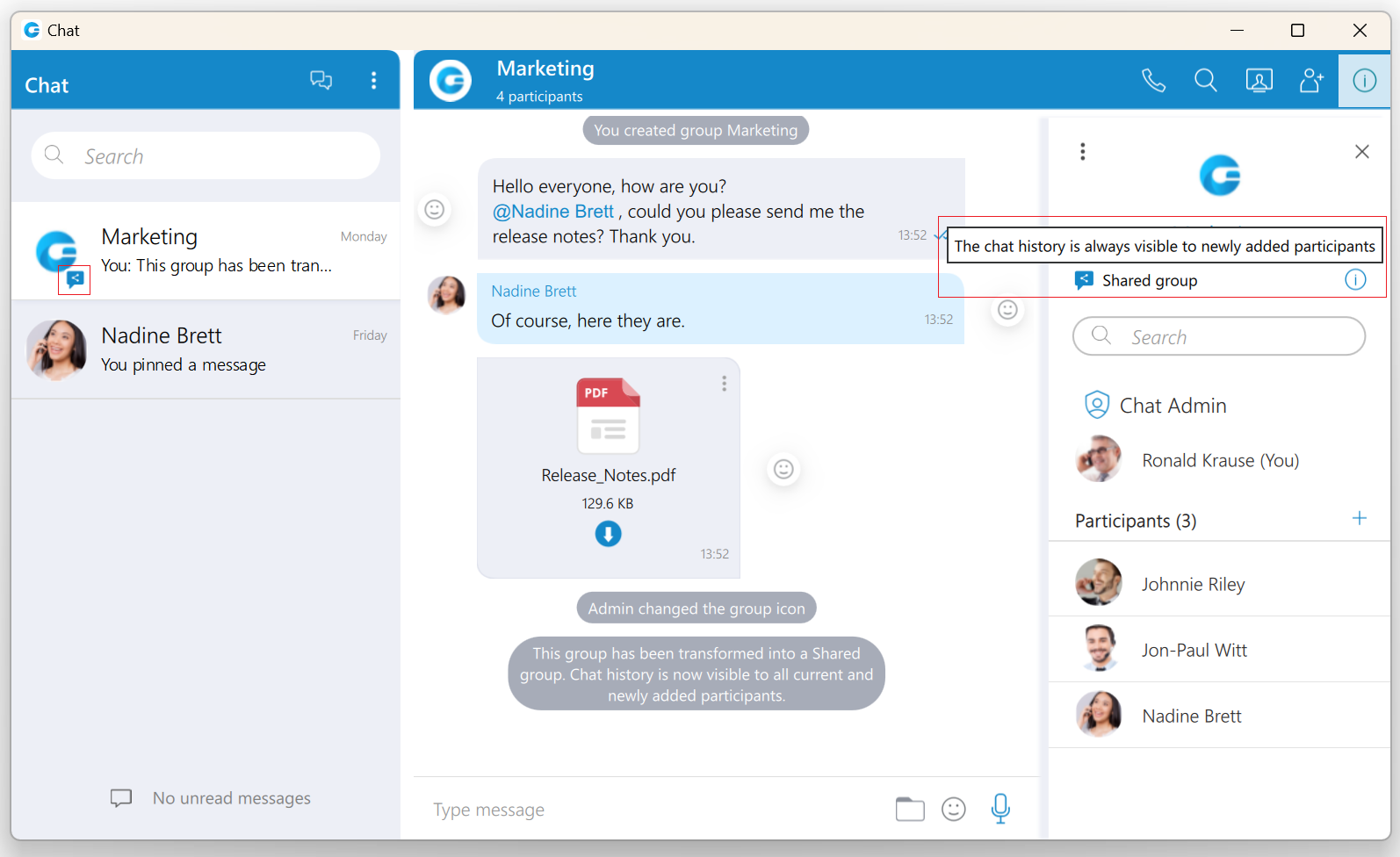
Filtering and selecting contacts are the same as described in the conference section. The user can filter contacts by name, extension number, and department. Created groups are permanent, meaning the user will remain a group member after closing the application.
It is possible to have multiple groups with the same participants and the same or different names. For example, you could create Sales Reports and New Release groups. Both groups can have the same participants, and the user can use them for various topics, so unrelated matters are not mixed up in a single conversation.
Group chat can be created from one-on-one conversations and conference calls.
Close All Chats option is used to close all your conversations easily without having to close each one manually.
Show Closed Chats option is used to see all of your closed conversations so you can find them and move them back to active.
Legacy Chat History option is used to show chat history from previous versions so you would not lose all of the messages you had in your chat history prior to the update to gloCOM version 6.0. This chat history is kept only for those purposes since old chat messages cannot be migrated to the new chat.
Re-sync the entire chat history option is used to manually re-sync the entire chat history. This option should be used only in case of chat history corruption.
Options option is used to quickly navigate to Chat section in the Preferences window.
The right side of the bar provides information about the currently selected conversation, such as its avatar, the user's name (or a group name in case of a group conversation), and various action buttons available for that conversation. Click on the name to open the Contact Information (in case of the group conversation, the info section will be opened after clicking the name or the label below)
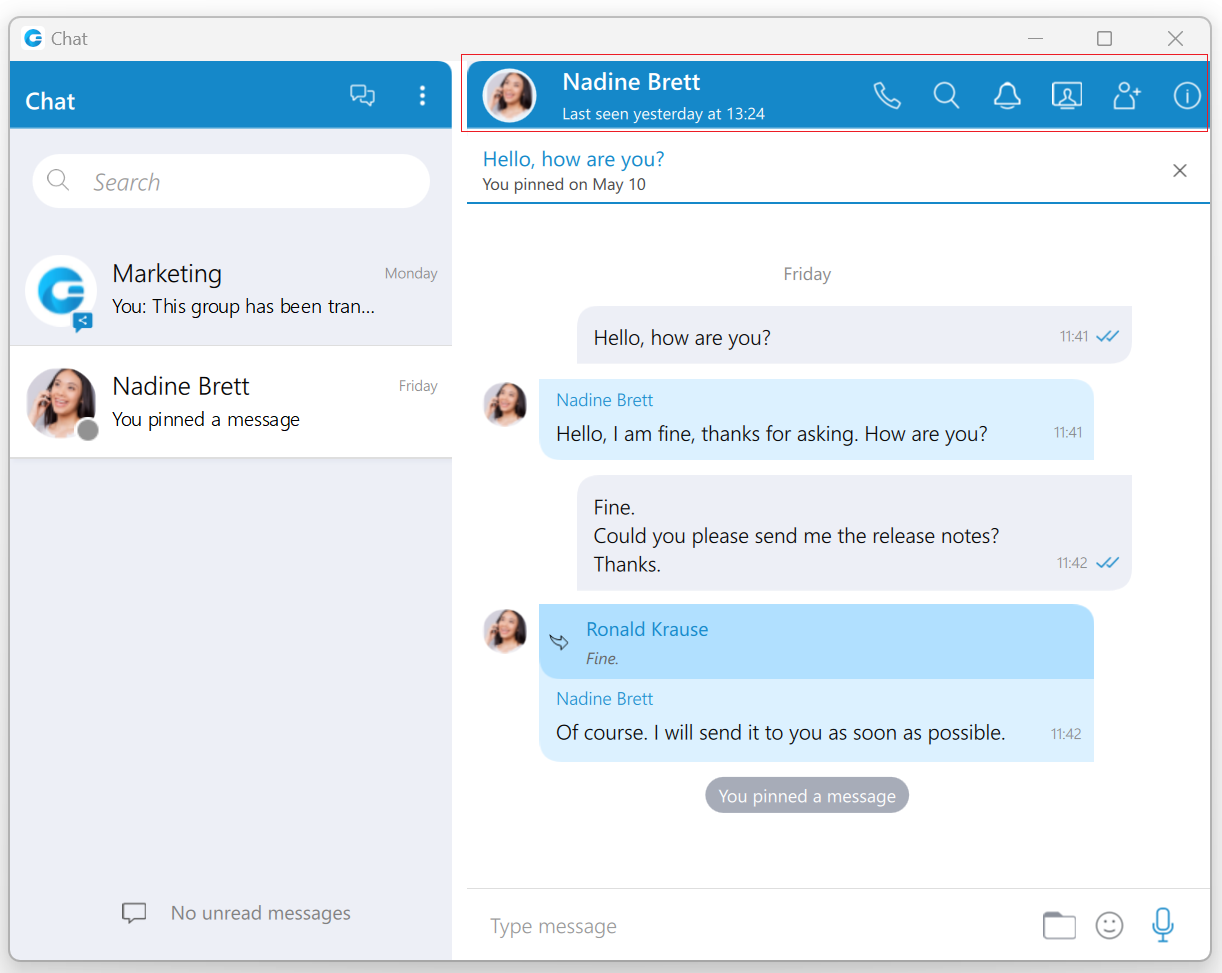
Below the name is information about the user's presence and status, e.g., is the user currently online, what is the user's status message (if any), is he currently away from the Desktop, etc. For group conversations, a label indicates the number of participants in the conversation.
The list of the action buttons is as follow:
 Call the currently selected user (create a voice conference in case of a group conversation).
Call the currently selected user (create a voice conference in case of a group conversation).
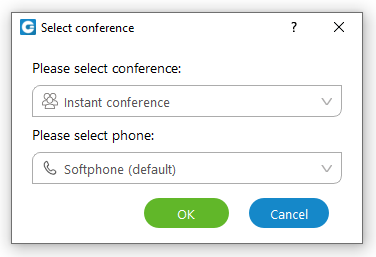
 Search for messages from the current conversation.
Search for messages from the current conversation.
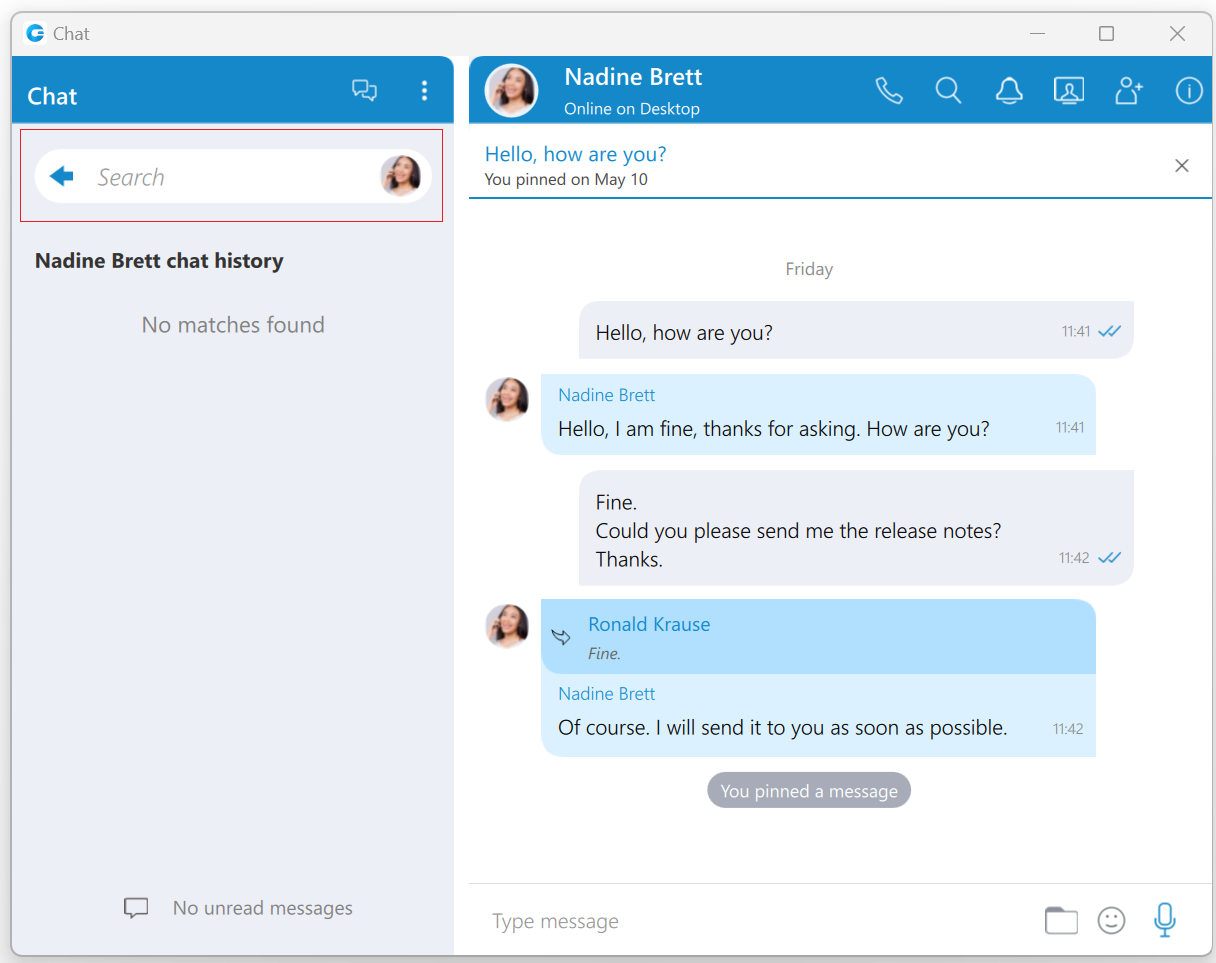
 Ask for attention - the user in the current conversation will be notified that you need their immediate attention. Not available for group conversations.
Ask for attention - the user in the current conversation will be notified that you need their immediate attention. Not available for group conversations.
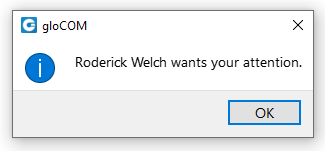
 Start or Schedule a meeting with all chat participants.
Start or Schedule a meeting with all chat participants.
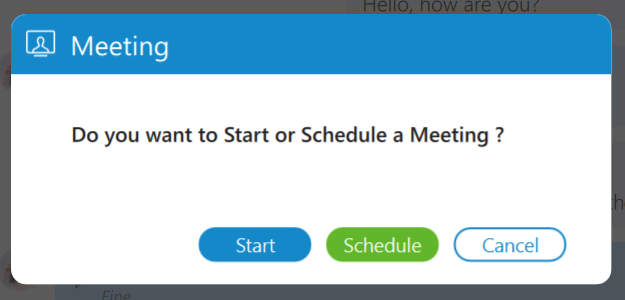
 Add more users into currently selected conversation.
Add more users into currently selected conversation.
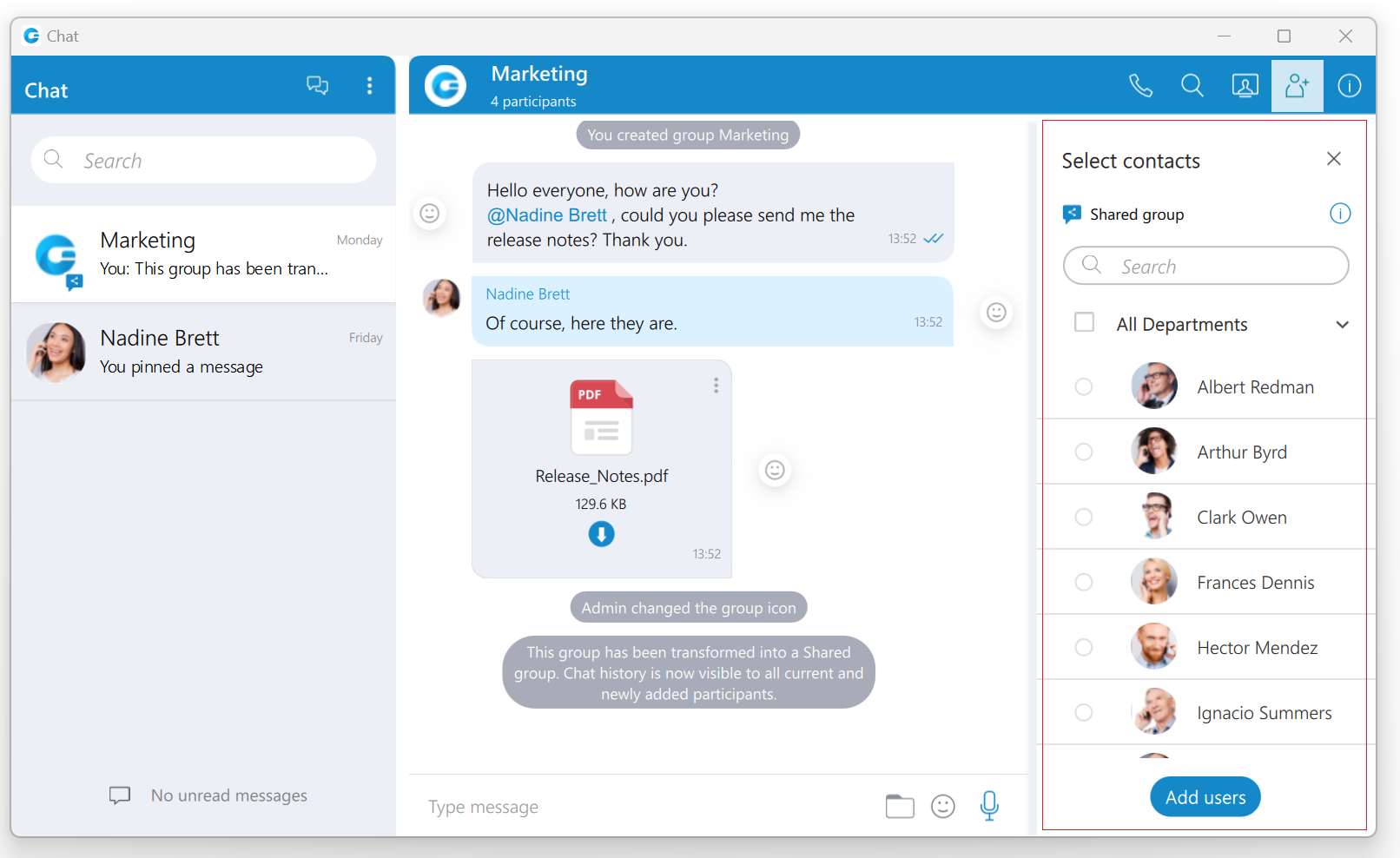
 Open the chat info.
Open the chat info.
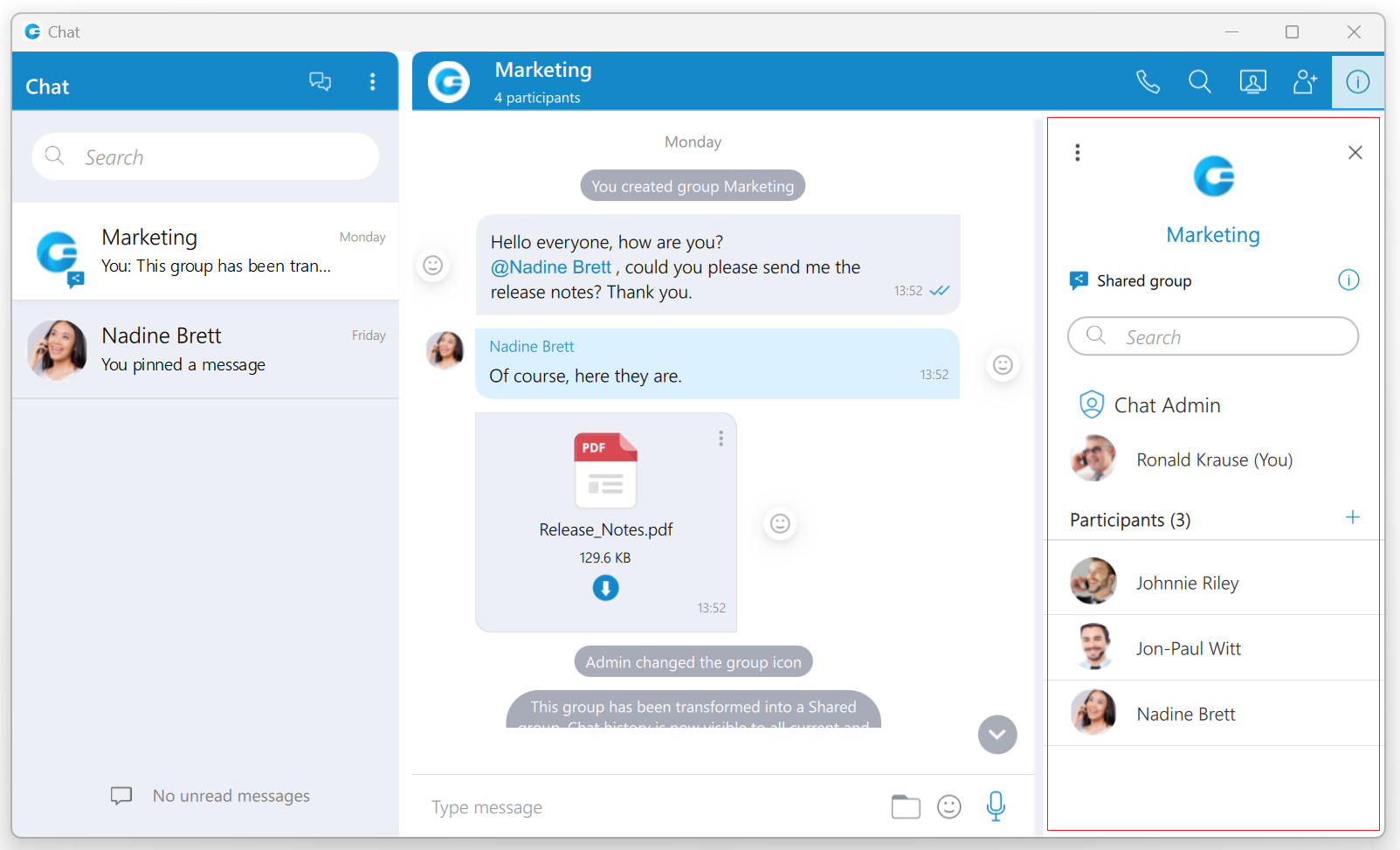
When adding users into the currently selected conversation you can filter users list by searching for a user’s name or extension. You can also filter by department, or even add a whole department into the conversation. Added participants cannot read previous messages in the conversation.
To collapse the users list and show a list of departments click on the name of the currently expanded department. To select all users from the currently expanded department, click on the checkbox next to the department name.
¶ Chat Info
¶ Single chat conversations
Info drawer shows all participants within the selected conversation. Furthermore, it allows users to add more participants to the selected conversation by clicking on the + sign located on the right of the Participants label. This way, the user can easily create a group chat conversation from a single chat conversation. Additionally, by hovering over each participant, the user can see information about their presence and available actions.
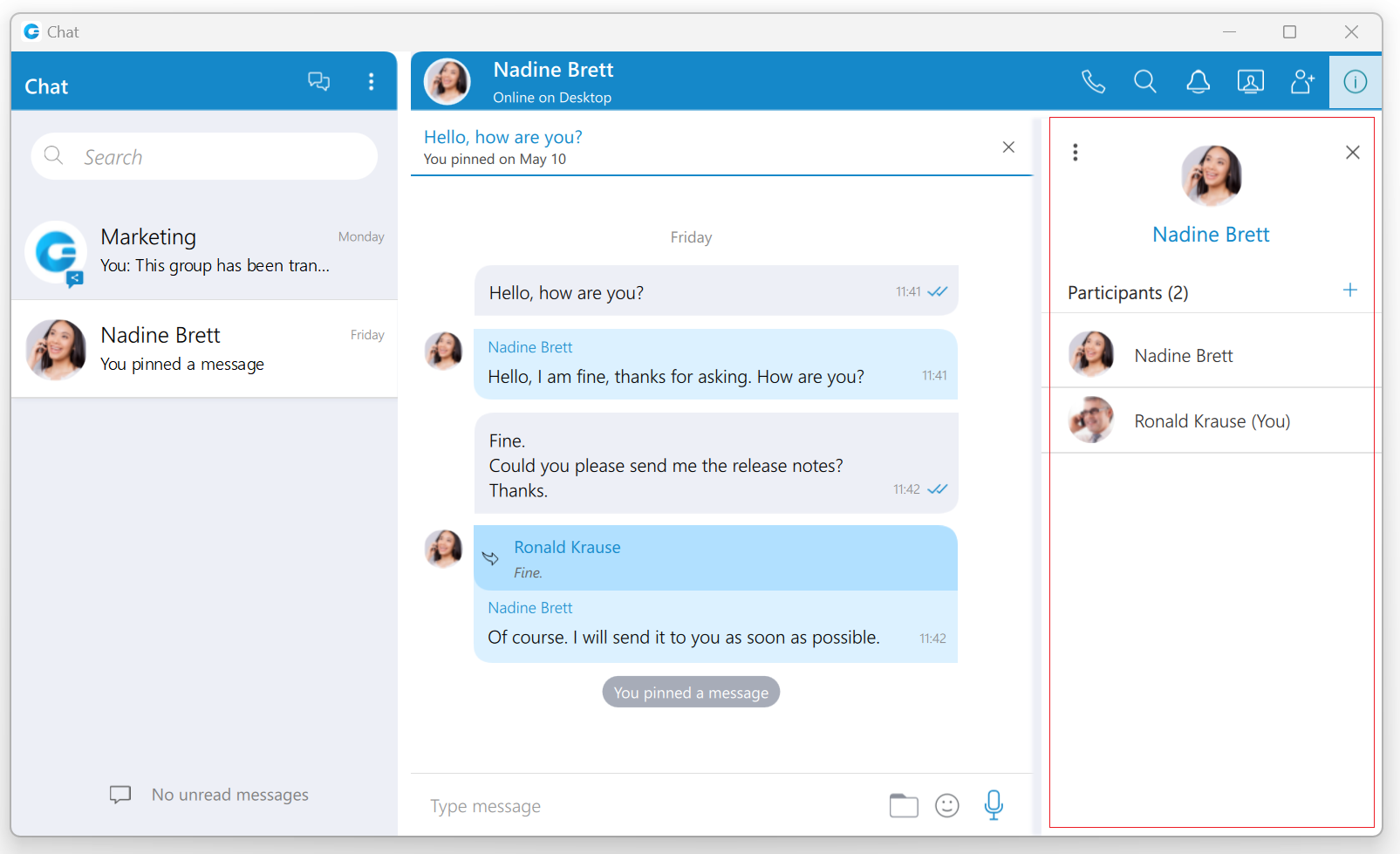
![]() The Options button contains:
The Options button contains:
- The Show Files option shows all shared files within the selected conversation.
- The Delete conversation option deletes the selected conversation.
While hovering over a participant, the following action is available:
 Call the hovered participant.
Call the hovered participant.
¶ Group chat conversations
The Info drawer shows the group chat icon, the group name, the type of group, the group administrator, and all participants of the selected group conversation. A group administrator can change the group chat icon and group name, remove participants from the group, and select a new group administrator.
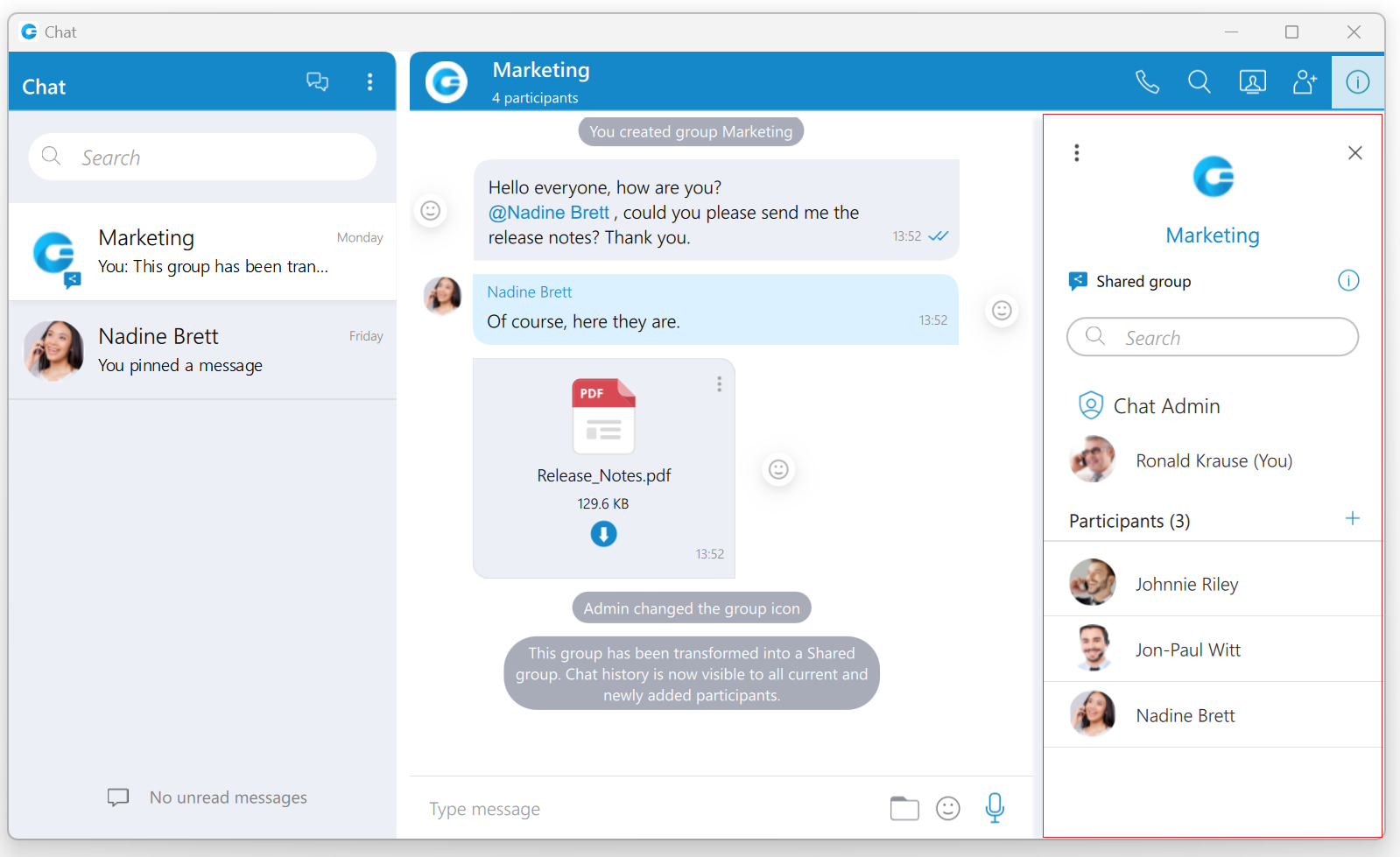
[7.2] The Set group chat icon option allows the group administrator to set/change the group chat icon at any time. Clicking on the group chat icon opens the file explorer window, where an image from the computer can be selected as a new group chat icon. In case the group chat icon has already been set, clicking on it will open a drop-down menu with the following options:
- Change icon: This option allows the administrator to change (update) the group's chat icon.
- Reset to default: This option resets the group's chat icon to the default value.
To change a group name, the administrator needs to click on the group's current name, type in a new name, and press the Enter key on their keyboard.
Furthermore, the administrator can add new participants to the selected conversation or filter participants of the conversation. Additionally, by hovering over each participant, the user can see information about their presence and available action buttons.
While hovering over a participant, the following action buttons are available:
-
 Call the hovered participant.
Call the hovered participant. -
 Open the single chat conversation with the hovered participant.
Open the single chat conversation with the hovered participant. -
 Remove the hovered participant.
Remove the hovered participant.
![]() The Options button contains Show Files,Transform into Shared group, Mute, and Leave options.
The Options button contains Show Files,Transform into Shared group, Mute, and Leave options.
- Show Files: This option shows all shared files within the selected conversation.

- [7.2] Transform into Shared group: This option allows the admin to change the existing standard group into a shared group with full history visibility to all existing and newly added participants. Once transformed, it cannot be undone. Caution should be exercised when using this option.(It will be displayed within the drop-down menu only for the standard group chat conversations.)
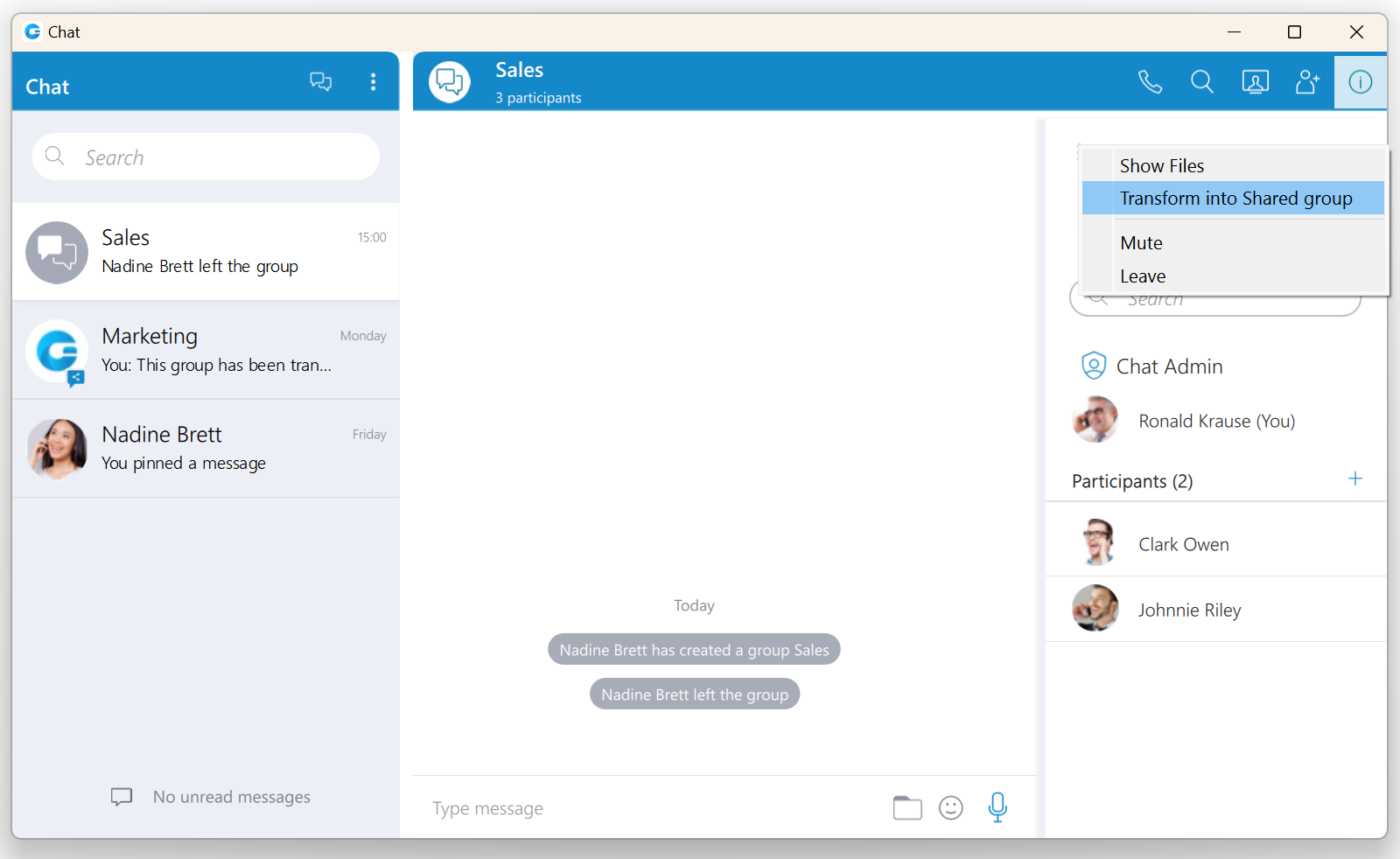
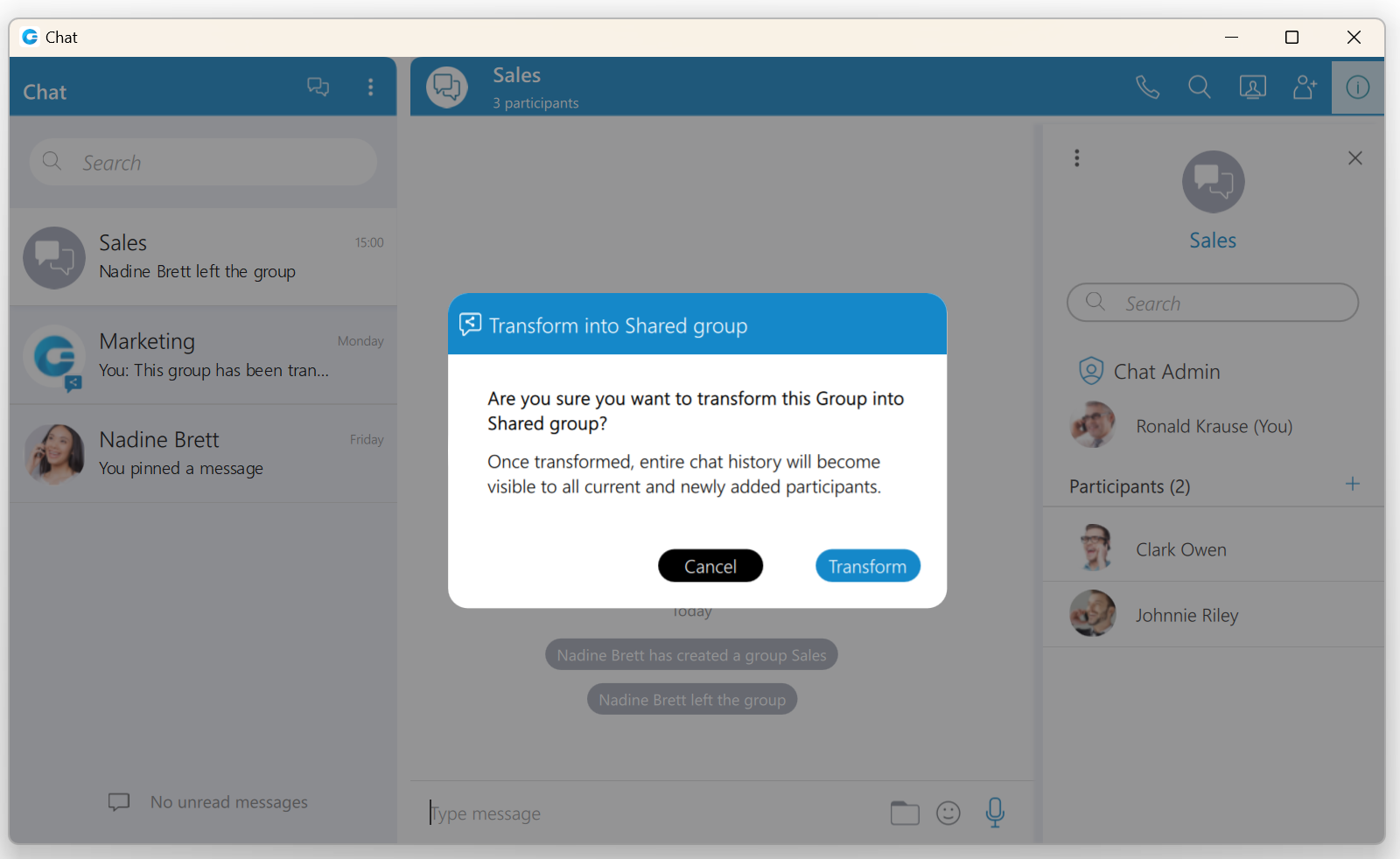
- Mute/Unmute: This option mutes/unmutes the selected conversation.
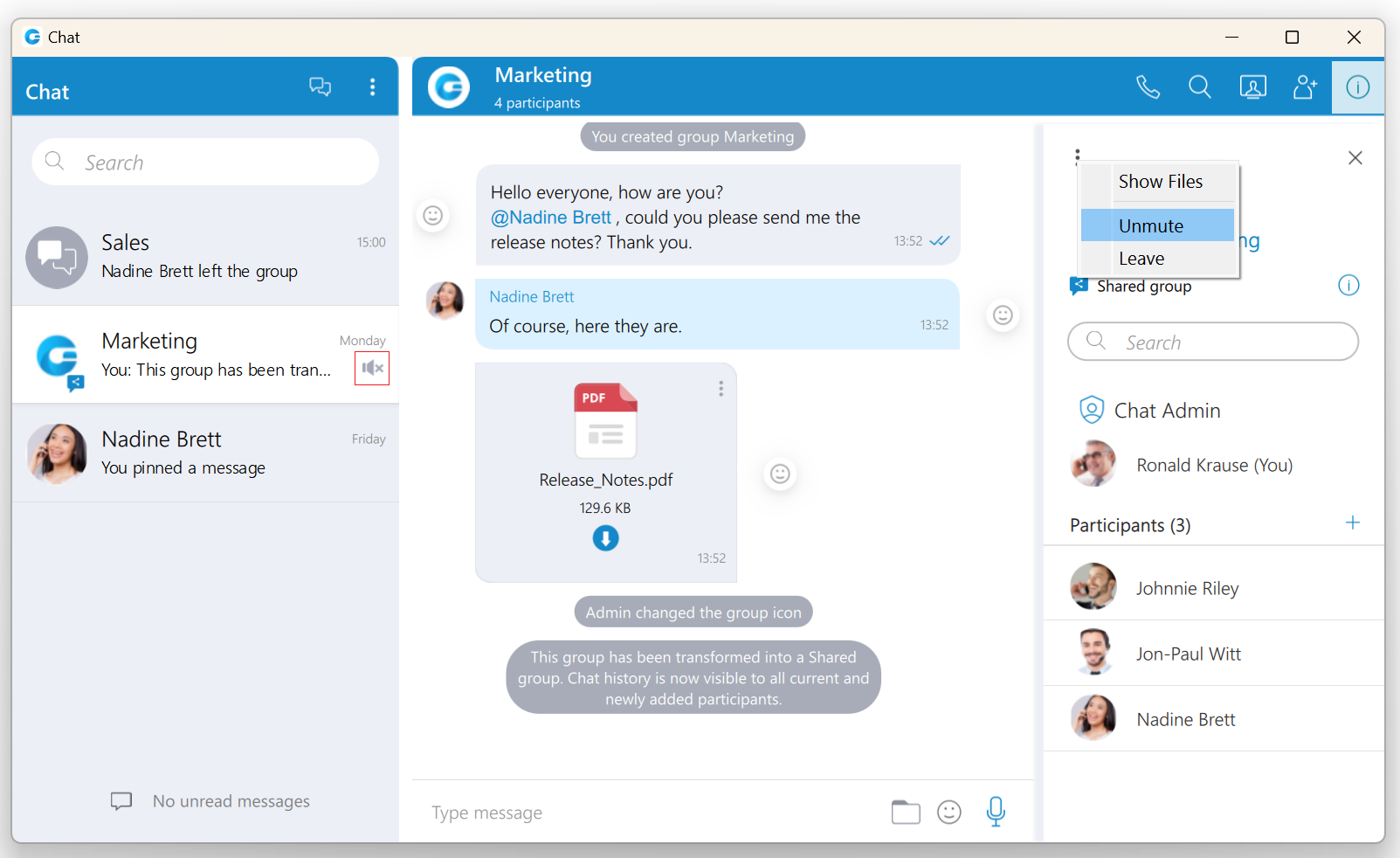
- Leave: option allows the user to leave the selected group conversation and choose what they want to do:
- Leave: It will leave the group and keep the chat history.
- Leave & Delete: It will leave the group and delete all chat history.
- Cancel: It will cancel the leaving process.

Finally, the group administrator can select a new group administrator by clicking the Transfer button next to their name and selecting a new one. To confirm the transfer process, click on the Transfer button at the bottom of the Info drawer. As a result, a confirmation dialog pops up asking for the confirmation.
Click the Cancel button at the bottom of the Info drawer to cancel the transfer process.
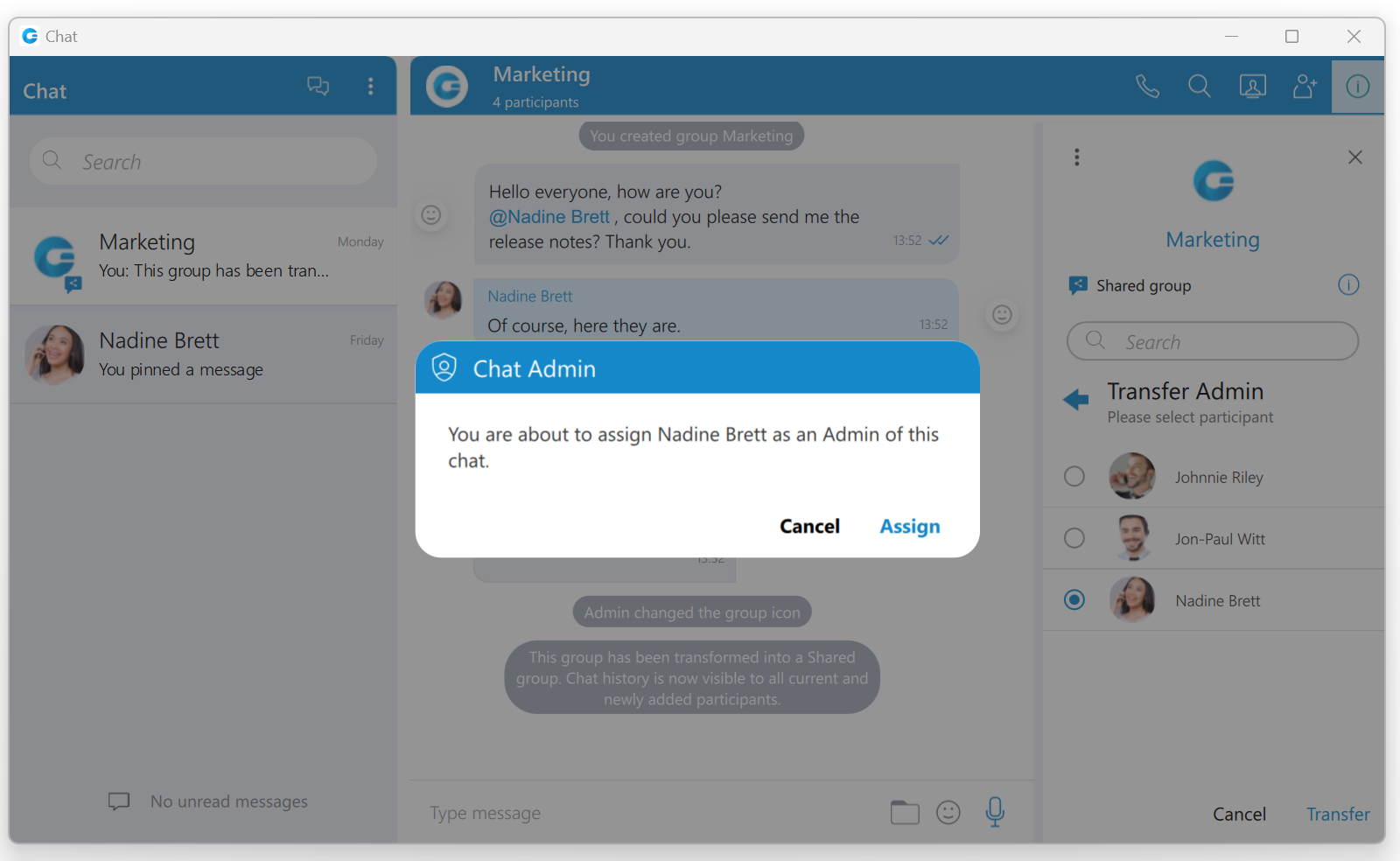
If the group chat does not have an administrator, anyone can become an administrator by clicking the Assign myself button below the "No admin assigned" label. As a result, a confirmation dialog pops up asking for the confirmation.
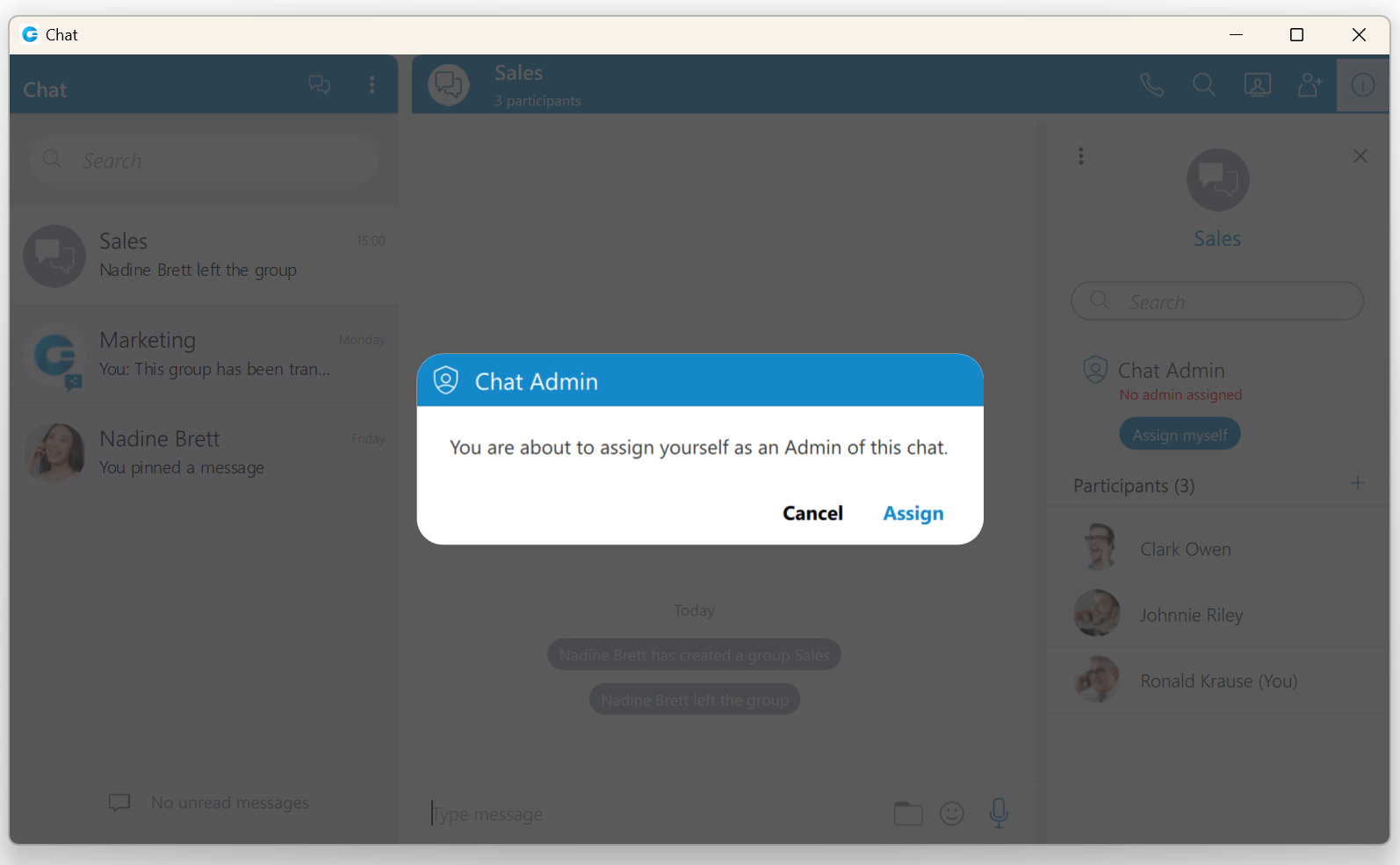
¶ Files overview
Selecting the Show Files option from the drop-down menu displays all sent and received files inside the conversation.

You can search for a particular file by its name. Click the file thumbnail or the file name to open the file if it is available, or offers to download it if the file has not been downloaded yet.
File name, file size, sender, and time are shown for each file. Depending on the file direction (incoming/outgoing) and file status (uploading/uploaded/ready to download/downloading/downloaded) the button on the right of the file name provides certain actions:
 Click to download the file.
Click to download the file. File is already downloaded, click to show the menu and choose from Open, Show in Windows Explorer for Microsoft Windows (Show in Finder for macOS) and Save As options.
File is already downloaded, click to show the menu and choose from Open, Show in Windows Explorer for Microsoft Windows (Show in Finder for macOS) and Save As options.
- Open option opens the file in the default application
- Show in Windows Explorer/Show in Finder option opens the folder containing the file and selects the file which is useful for locating the file on the file system.
- Save As option creates a copy of the file in the desired location with the pre-filled file name. The file name, by default, will be the same as the file's name within the gloCOM Desktop application.
 Show progress of currently uploaded/downloaded file.
Show progress of currently uploaded/downloaded file. Click to cancel current uploading/downloading. Visible when you hover the progress circle.
Click to cancel current uploading/downloading. Visible when you hover the progress circle.
¶ Mention participants in group chat conversations
The mention as a feature represents a good way to get someone's attention within the group conversation. It allows the user to mention one or more participants and provide the context of their mentioning within the message. The mentioned participants will receive a notification even in the group conversations they have currently muted.

To mention a participant, the user needs to enter the @ sign followed by the name of the desired participant. Immediately after entering the @ sign, the list of the participants who can be mentioned will be displayed above the input field.
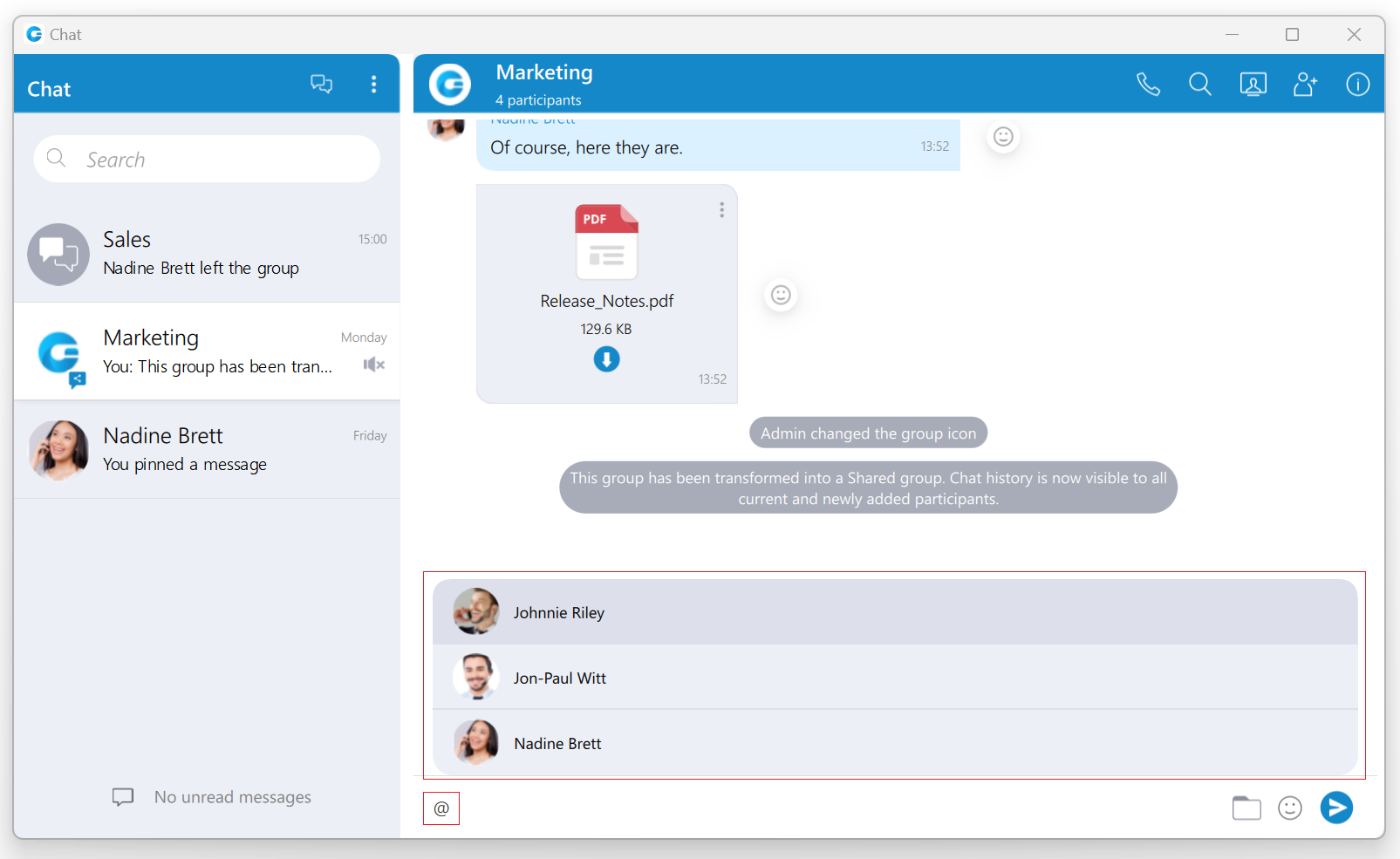
Only participants from the group chat conversation can be mentioned.
The user has a few possibilities for selecting participants:
- The first includes scrolling through the list using the up and down arrow keys and selecting the participant by pressing the Enter (Return) key on their keyboard or using the mouse wheel and clicking on the participant.
- The second is to continue entering the participant's name after the @ sign. In that case, the list above the input field will only display participants whose names match the entry.
The mentioned participant will be colored in blue within the conversation.

Clicking on the mentioned participant within the conversation brings a pop-up menu with the following options:
- Call
- Chat with
- Contact information
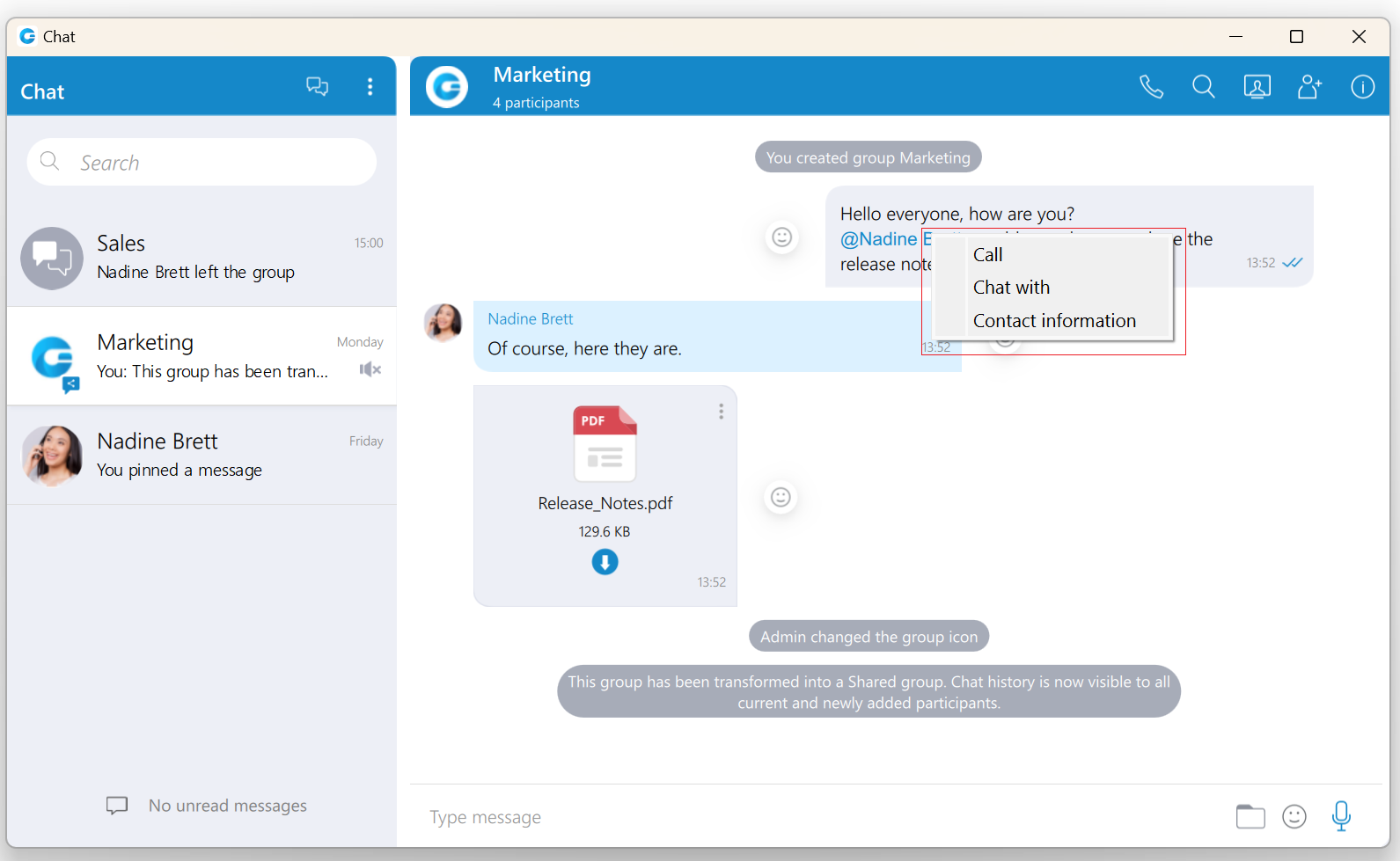
¶ Search and Chat History
The Search field below the Create Group and Options buttons, has multiple purposes:
- Start a new conversation or open an existing conversation by searching for a user’s name, a user’s extension or a group name, and click on the desired item in the list
- Chat history
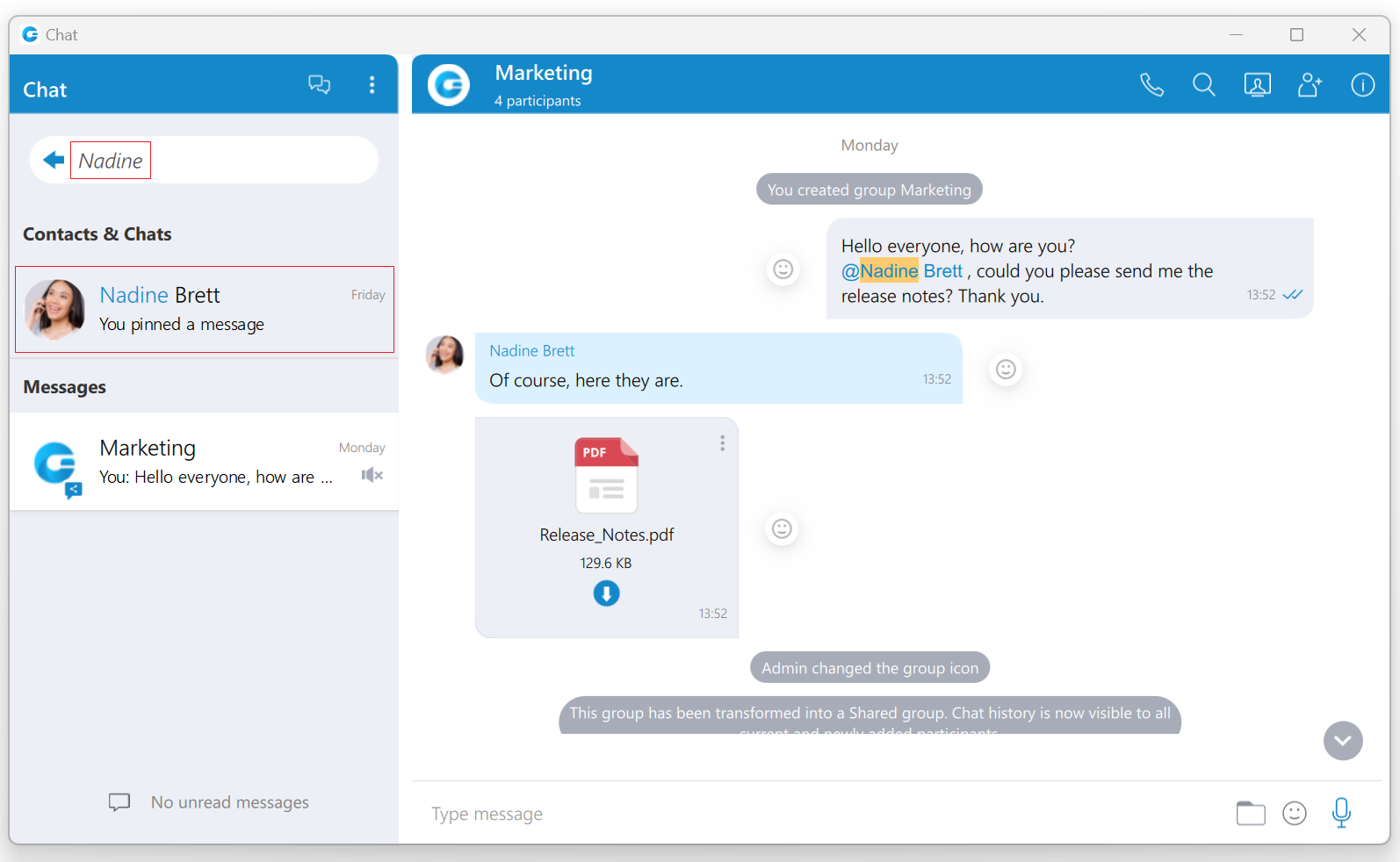
Unlike the versions prior to gloCOM 6.0 chat history is now integrated into the chat window so you don’t have to open another window to search for a message. When you type in a term in the search field, the application is going to find all users or existing conversations that match the term, and also find all messages that match the term. Users and existing conversations are positioned on the top, followed by all messages that match the term, sorted from the most recent one to the oldest one.
If you click on any item in the Contacts & Chats section, the application is going to open the selected conversation and clear the search field.
On the other hand, if you click on an item in the Messages section, the application is going to open the conversation, focus the desired message and load a few messages around it to give you the context of the conversation at that point. From there, you can scroll up/down to load older/newer messages, where every occurrence of the searched term is going to be highlighted.
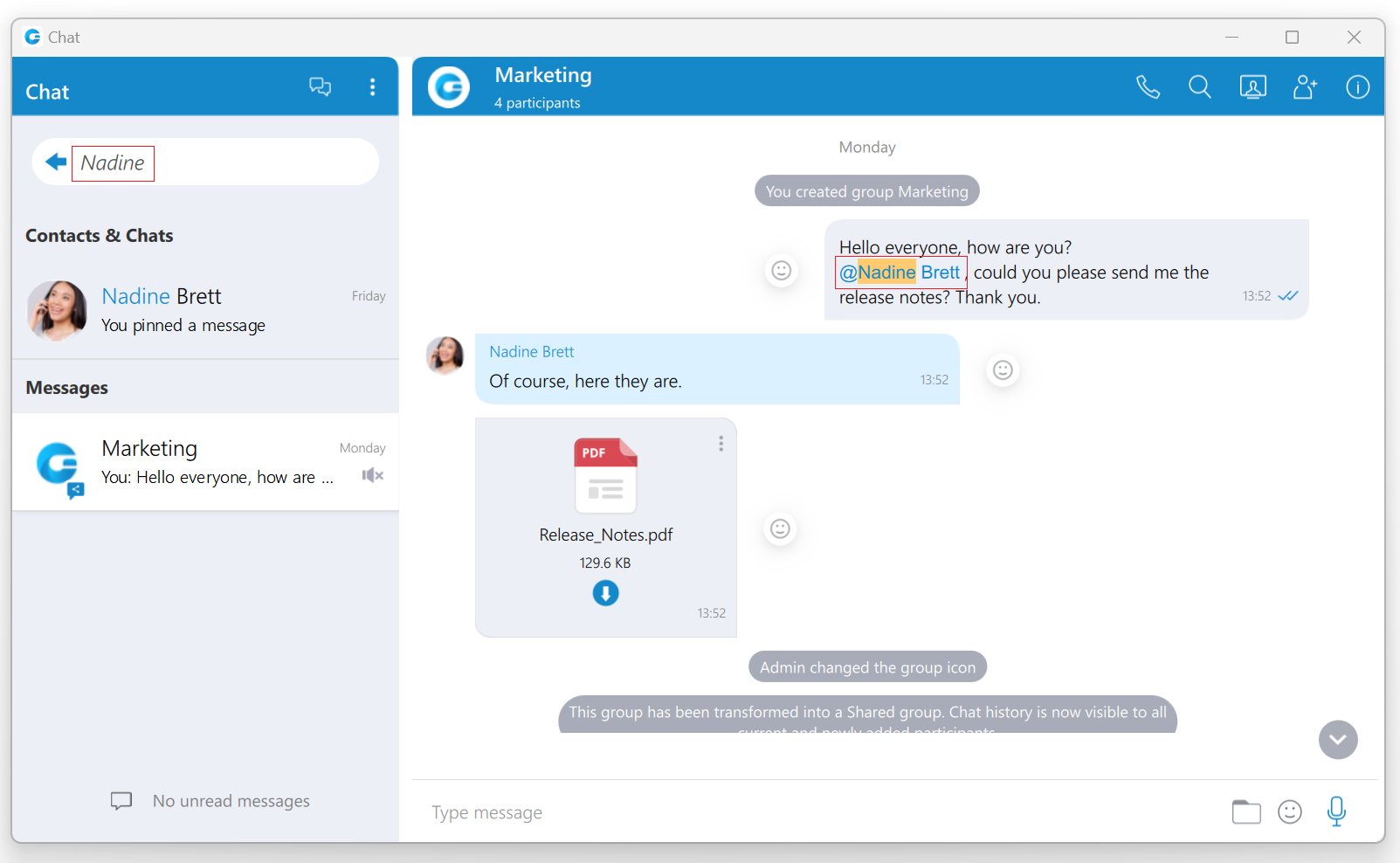
Once you have found what you were looking for, you can delete the term in the search field to exit the search mode or click on the  button on the left side of the search field. This enables you to search your entire chat history without ever leaving the chat window.
button on the left side of the search field. This enables you to search your entire chat history without ever leaving the chat window.
If you type in more than one word in the search field, the application is going to find all messages that contain both of those words in any order.
For example, searching for "Hello Bob" matches all of these:
- Hello, how are you Bob?
- Bob? Hello? Are you there?
- Hello Bob, do you have a few minutes?
- hello Bob, how are you?
But maybe you just wanted to find the last two messages, where words Hello and Bob are right next to each other and in the right order (where the word Hello comes before Bob). In that case you have to put quotation marks around the term.
For example, search for “Hello Bob” matches just these:
- Hello Bob, do you have a few minutes?
- hello Bob, how are you?
As you can see in the examples above search in the chat window is case insensitive.
¶ Conversations list
Below the search field is a list of all chat conversations sorted by their most recent activity. These conversations are persistent, meaning they will appear in the chat window even after restarting the application. To remove the conversation permanently, users have to delete the conversation, which can be done from the info drawer. However, to close the conversation, hover over the conversation and press the x button that appears in the top right corner of the conversation. This way, users can keep only those conversations they are currently interested in visible. Closing all conversations can be done by selecting the Close All Chats option from the Options drop-down menu above the search field. Any activity within closed conversations will move them back to the active conversation list (new messages, new participants added, etc.). Hence, users will always catch the latest messages and events. Users can find closed conversations using the search field above the conversation list or by selecting the Show Closed Chats option from the Options drop-down menu above the search field. From there, any closed conversation can be moved back to the active conversation list by clicking on it or the  icon at the top right corner while hovering over it. Click the Back to active chats label to return to the active conversations list.
icon at the top right corner while hovering over it. Click the Back to active chats label to return to the active conversations list.
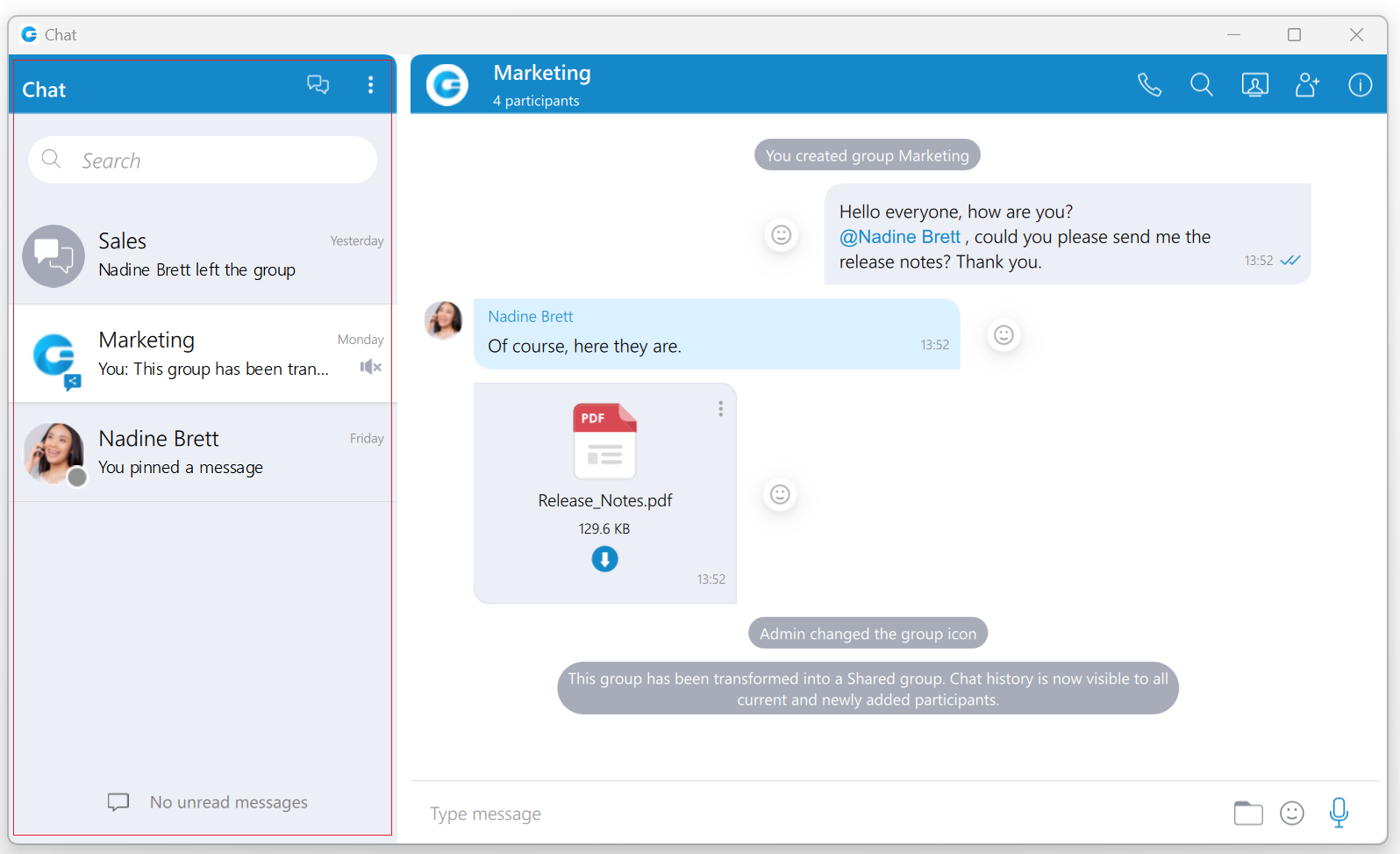
Conversation with a user which has been deleted from PBXware will be marked with a prefix (Deleted). You can no longer send messages to this conversation, but it is still useful because of the chat history and all existing messages with that user before deletion.
When you hover a session, besides the x icon there is a dots icon in the top left corner of the conversation.
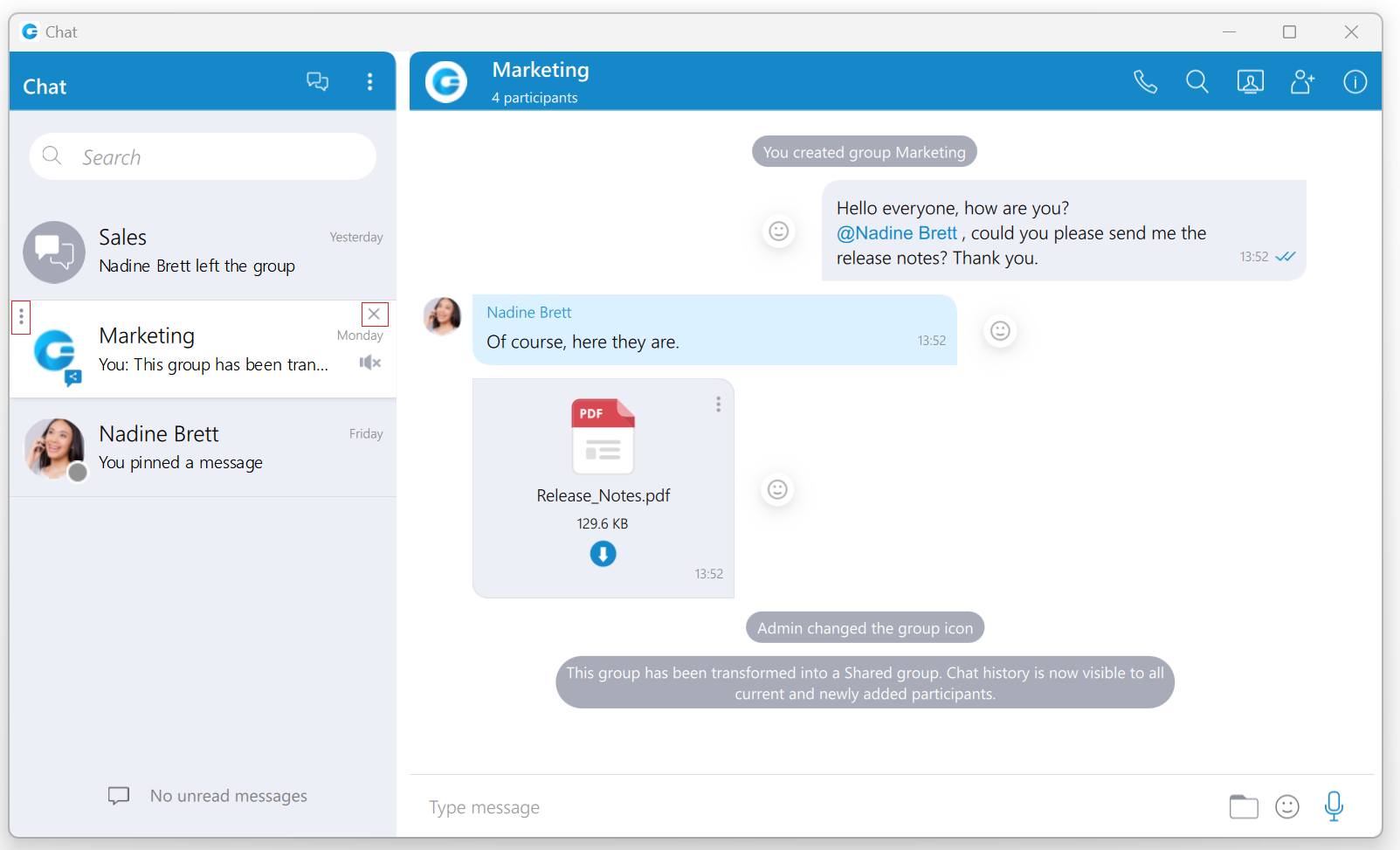
Click on it will open a drop-down menu with the following options:
- Search
- Call
- Pin Chat
- Mark as Read/Unread
- Mute (only for group conversations)
- Close All Except This Conversation
Also, right-clicking on the chat conversation in the conversations list will open the same drop-down menu.
Search option allows you to search for messages from that conversation. This is useful to search only for messages from a specific user unlike global search which searches for messages from all conversations. There are two ways to get out of this mode: by clicking on the back icon ![]() located on the left side of the search field, or by pressing the ESC key.
located on the left side of the search field, or by pressing the ESC key.
Call option allows you to call the user or to create a conference call in case of a group chat.
Pin Chat allows you to pin the most used conversations on the top of the conversation list. The last pinned conversation is always on the top of the conversation list. You can unpin the conversation in the same way as pin, and also by clicking on the pin icon ![]() that appears if a conversation is pinned. The user can rearrange pinned conversations according to their needs by using the drag and drop options. This allows them to define priority for pinned conversations.
that appears if a conversation is pinned. The user can rearrange pinned conversations according to their needs by using the drag and drop options. This allows them to define priority for pinned conversations.
Mark as Read/Unread allows the user to explicitly mark the conversation as Read/Unread. If they mark the conversation as Unread, the Unread indicator will show up for that conversation. It informs the user to look at this conversation again and take some actions if needed. Any action inside the chat conversation with the unread status will remove the Unread indicator. Also, opening the conversation or explicitly marking it as read will remove the indicator.
Mute option is used if you want to stop receiving notifications for a group chat maybe because there are too many messages exchanged and it distracts you. You can unmute a group chat in the same way as mute, and also by clicking on the speaker icon ![]() that appears if a conversation is muted. You can also Mute/Unmute a conversation from the Chat Info screen.
that appears if a conversation is muted. You can also Mute/Unmute a conversation from the Chat Info screen.
Close All Except This Conversation option allows you to close all conversation except this one. This is useful if you have only one conversation you are currently engaged in, so you want to hide all others so they don’t distract you.
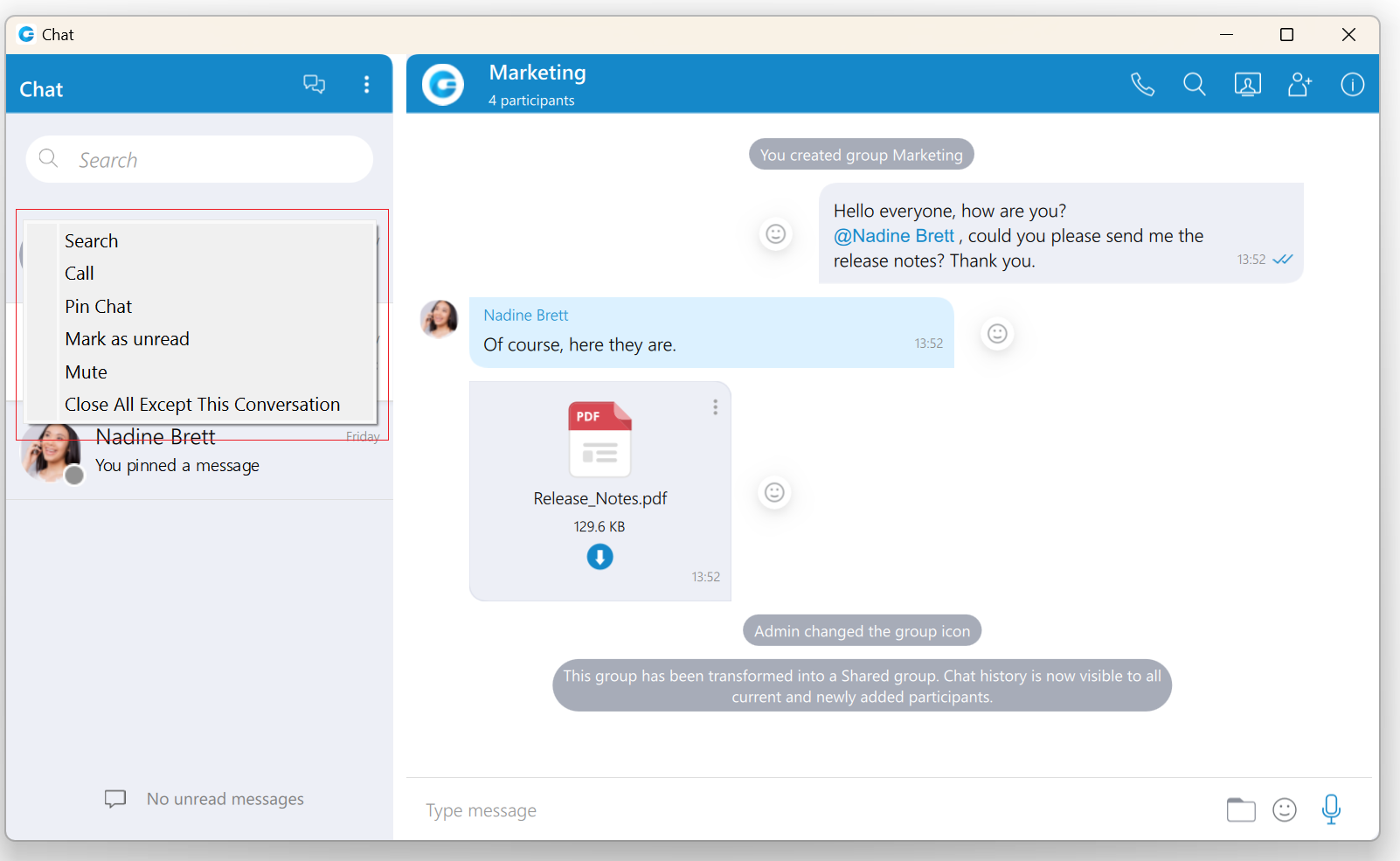
For each 1 on 1 conversation in the list you can see:
- User’s avatar with his status icon
- User’s name
- Last message in the conversation
- Time of the last message in the conversation
- Number of unread messages (if any)
For each group conversation in the list you can see:
- Group chat icon
- Group name
- Last message in the conversation
- Time of the last message in the conversation
- Number of unread messages (if any)
While in search mode conversations list will change its items according to the searched term which is explained in the Search and Chat History section.
¶ Unread messages indicator
An indicator for unread messages is at the bottom of the conversation list. This is helpful if users have scrolled down and do not see their most recent conversations or when they are in search mode.
If there are any unread messages the label and the icon are emphasized in blue color to draw the user's attention.

Click on a label to open up a menu showing a list of all conversations with unread messages indicating the number of unread messages in the parenthesis. Also, there is an option to mark all messages as read.
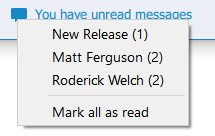
Marking all messages as read will effectively send seen to all those conversations even though you haven’t read those messages yet. Clicking on any other option besides Mark all as read opens the selected conversation. This can be used as a quicker way to find conversations with unread messages instead of looking for them in the conversations list.
If there are no unread messages, the label is not emphasized and serves only as an indicator, without any functionality.

¶ Messages view
On the right side of the chat window you can see the messages of the currently selected conversation.
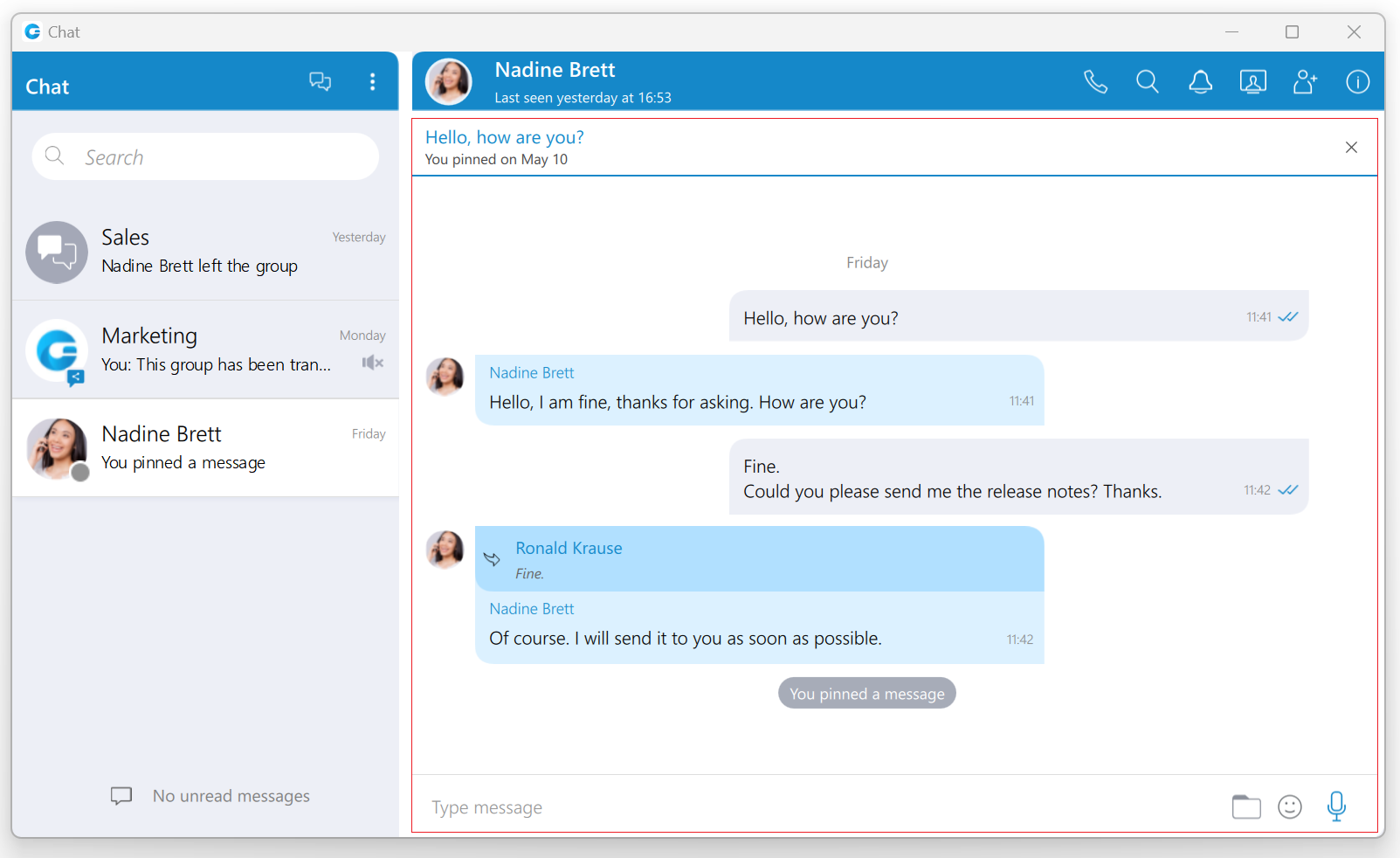
In case there are no unread messages in the conversation, the application will load last 20 messages and place the scrollbar on the bottom. If you want to load older messages, you just scroll up until you reach the top. This way you can scroll all the way to the beginning of the conversation.
In case there are unread messages in the conversation, the application will load all unread messages plus 20 additional older messages. The scrollbar will be positioned on the first unread message with the  indicator so you know where should you continue reading the messages.
indicator so you know where should you continue reading the messages.
The keyboard's up and down arrow keys can be used for scrolling messages through chat/SMS conversations.
The typing indicator is presented above the input field of the message window and within the conversation list so you can see when somebody is typing to you. In the case of a group conversation, if more than one participant is typing at the same time, the typing message will take the form N participants are typing where N is the number of typing participants.
While you are inside of the group conversation, left-click on the participant's name or avatar inside the messages window will show a popup menu with three options:
- Call: Call the participant directly.
- Chat with: Start a one to one conversation with the participant.
- Contact information: Show the contact information.
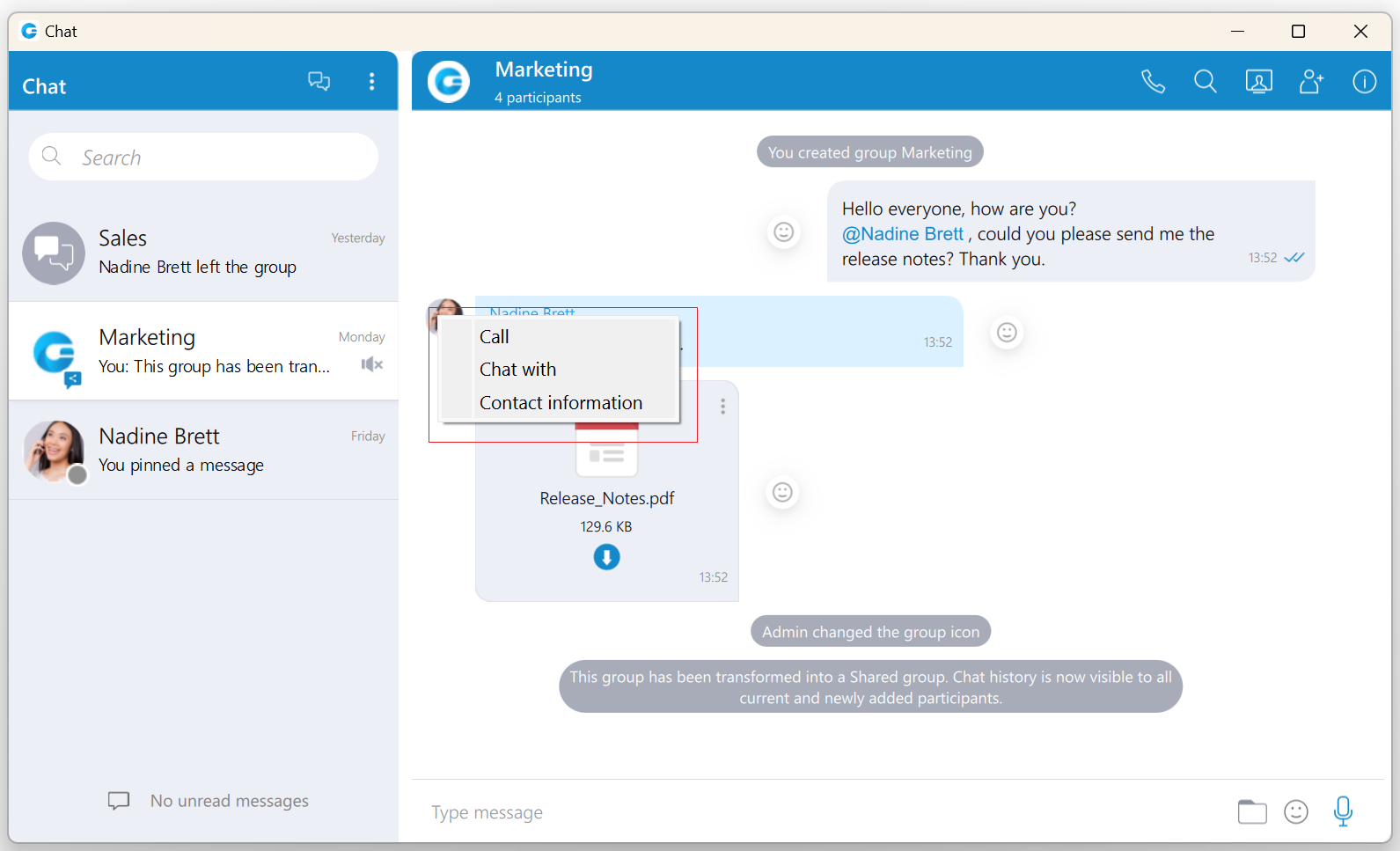
While scrolling up in the currently selected conversation, a scroll indicator ![]() appears in the bottom right corner of the messages view so you can easily move to the end of the conversation. If you receive a new message while searching/viewing the older messages, the scroll indicator will show the number of messages received. Clicking on the scroll indicator
appears in the bottom right corner of the messages view so you can easily move to the end of the conversation. If you receive a new message while searching/viewing the older messages, the scroll indicator will show the number of messages received. Clicking on the scroll indicator ![]() will take you to the first received message.
will take you to the first received message.
¶ Message Reactions
As the picture shows, every outgoing/incoming message has a reaction button on the left/right side of the message that allows users to react to a message.
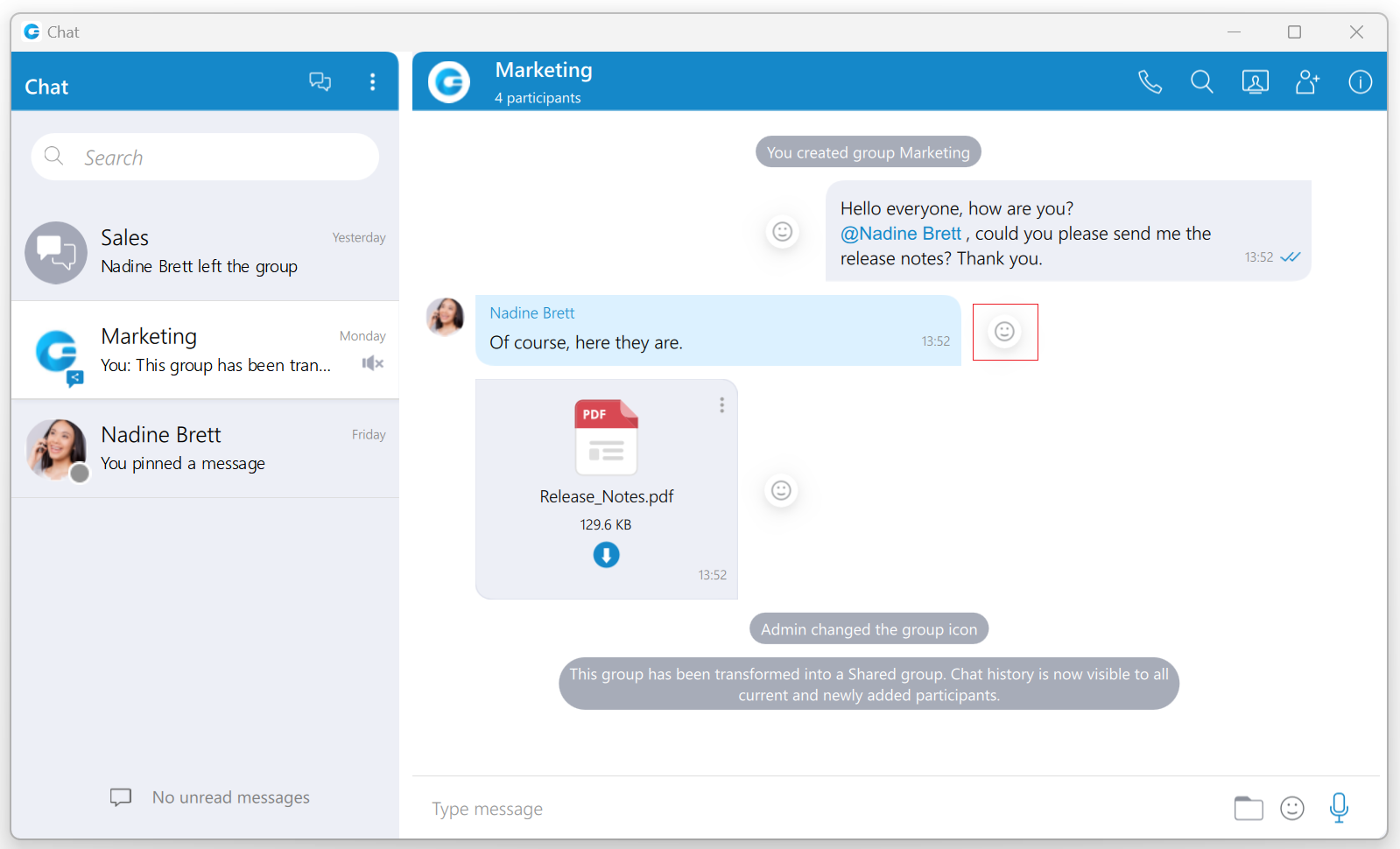
Hovering over it brings up a pop-up window containing a list of reactions that can be used to react to a message. After selecting one of the reactions, the same will be displayed next to the message instead of the reaction button, along with the last reaction (if any) and the total reaction count.
The selected reaction will be highlighted within the reactions pop-up.
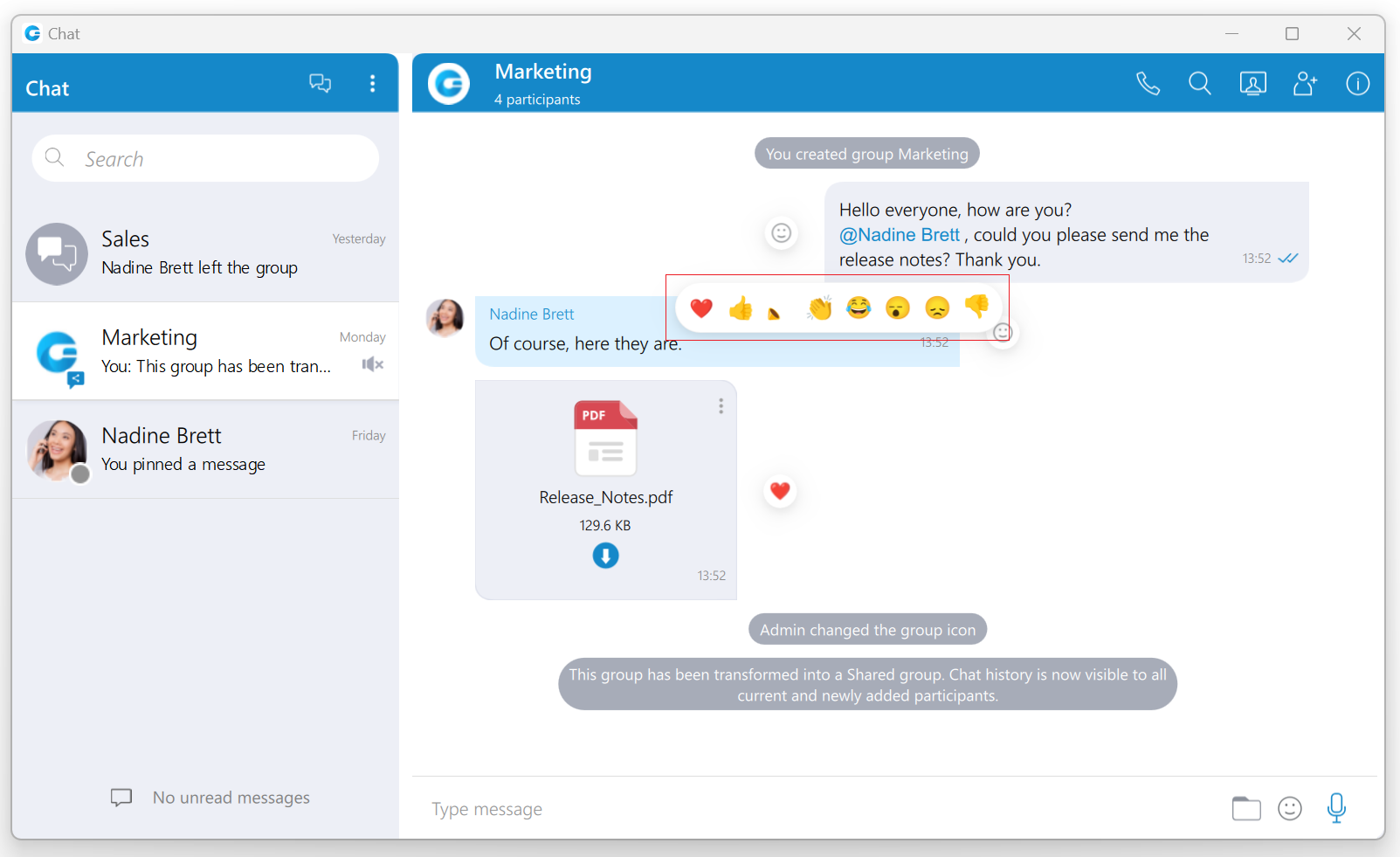
The user will receive a notification for every outgoing message when somebody reacts to it.

If a user has already reacted to a message, re-opening the reactions pop-up will present their reaction as selected. Clicking on the same reaction will remove it, and clicking on a different one will change it.
Reactions are available only for group conversations.
Besides the information about the delivery and seen status, the message Info contains information about reactions (if any).
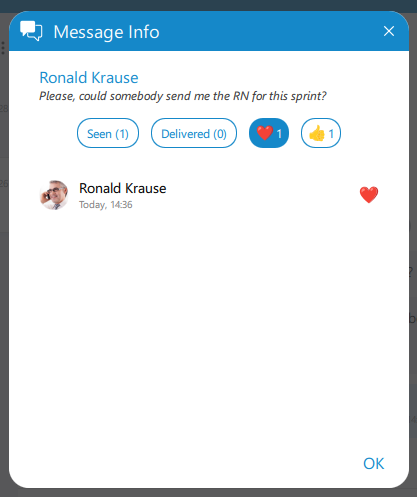
¶ Message states
For outgoing messages there is an indicator explaining the current state of the message:
 Sending: The message is on its way to the server.
Sending: The message is on its way to the server. Sent: The message is sent and has reached the server.
Sent: The message is sent and has reached the server. Delivered: The message is delivered to the other user(s).
Delivered: The message is delivered to the other user(s). Seen: The message has been read by the other user(s).
Seen: The message has been read by the other user(s). Failed: The message could not reach the server.
Failed: The message could not reach the server.
¶ Text selection and context menu
You can select text inside of messages by pressing and dragging your mouse across the messages area. Click anywhere on the messages area to unselect all messages.
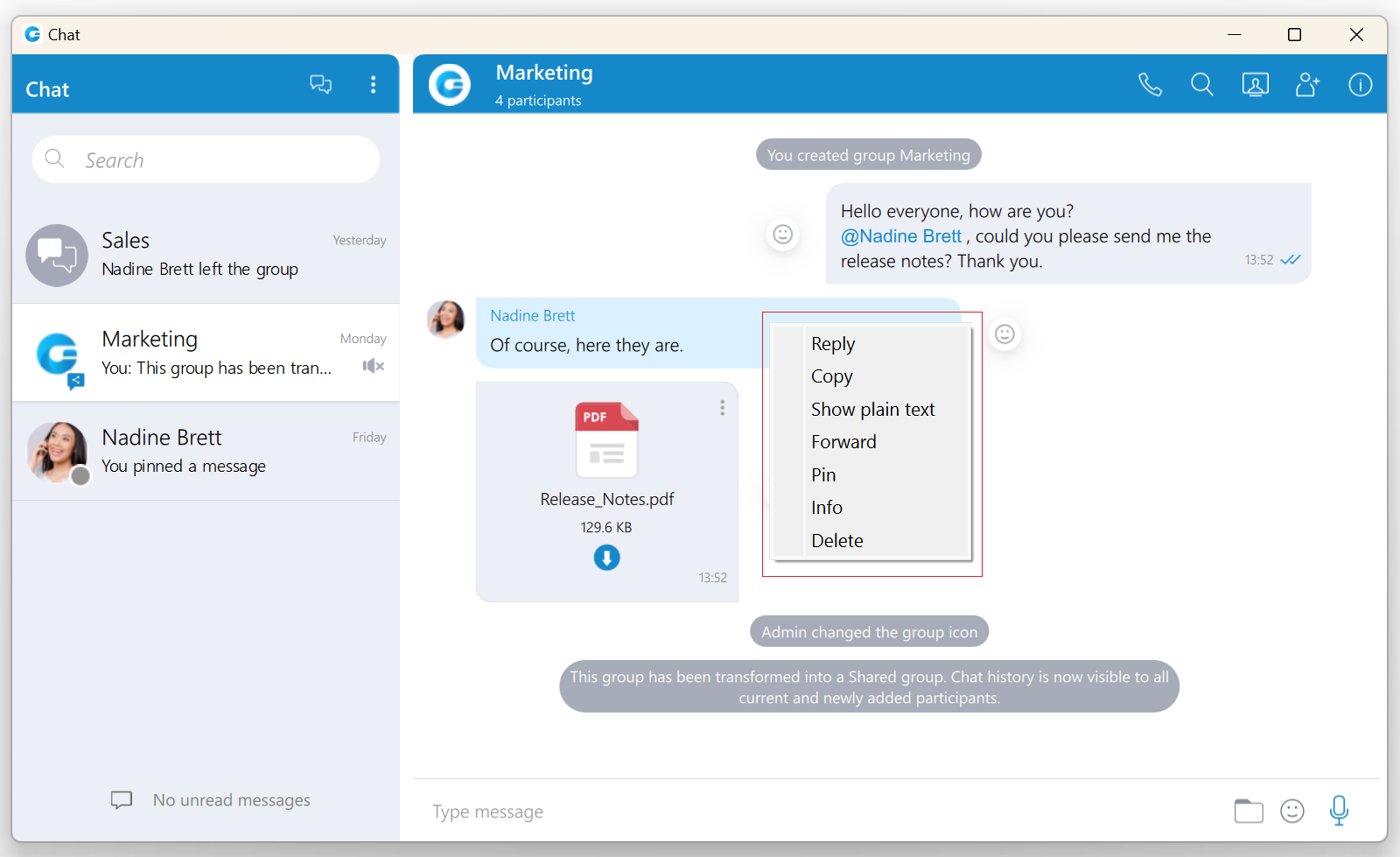
While there is any selected text in the messages area, right-clicking brings a context menu with the Copy option to copy all selected messages in the clipboard. You could also press CTRL+C on Windows, or Command(⌘)+C on macOS to copy all selected messages in the clipboard.
If you right click inside a message bubble (gray or blue rectangle) while there is no selected text, a context menu appears with the Reply, Copy Message, Show plain text, Forward, Pin Message, Info (only for groups) and Delete Message options.
Reply option allows the user to reply to a specific message. To reply to a message, hover over it, and click on the reply button, or right-click on the message, and from the drop-down menu, select the Reply option. As a result, the message that the user wants to reply to will appear above the input field. Clicking on the replied message inside the chat will take the user to the original message.
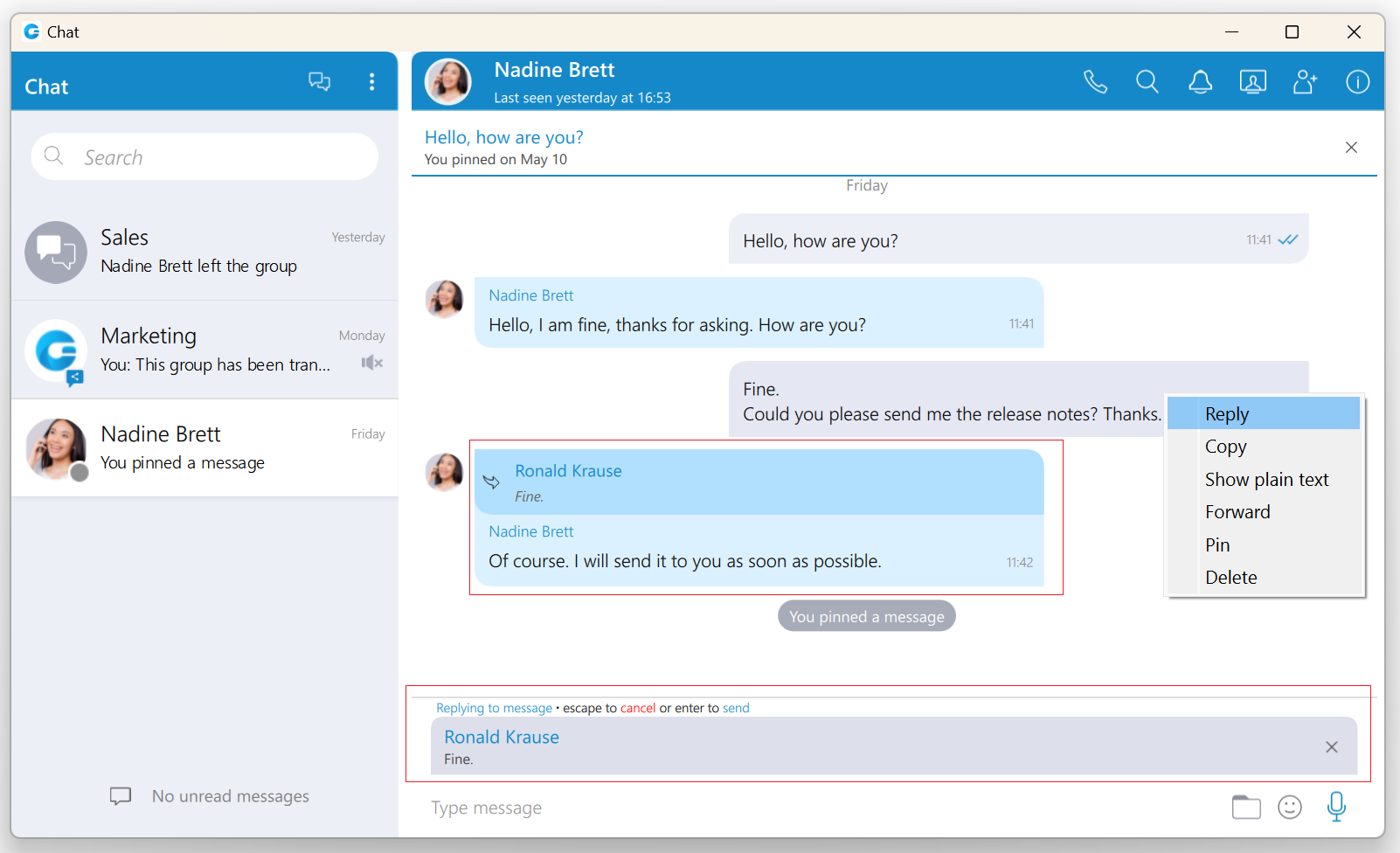
Copy option is used to copy all message content to the clipboard.
Show plain text option is used to disable all message formatting (links, emojis, etc.), to see the original message source. If you right-click on the message again after you’ve pressed the Show plain text option, there is a Show rich text option to revert it and to see the formatted message with links and emojis.
Forward option is used to forward messages and files from one conversation to another. You can forward the message or file up to 10 conversations at once.
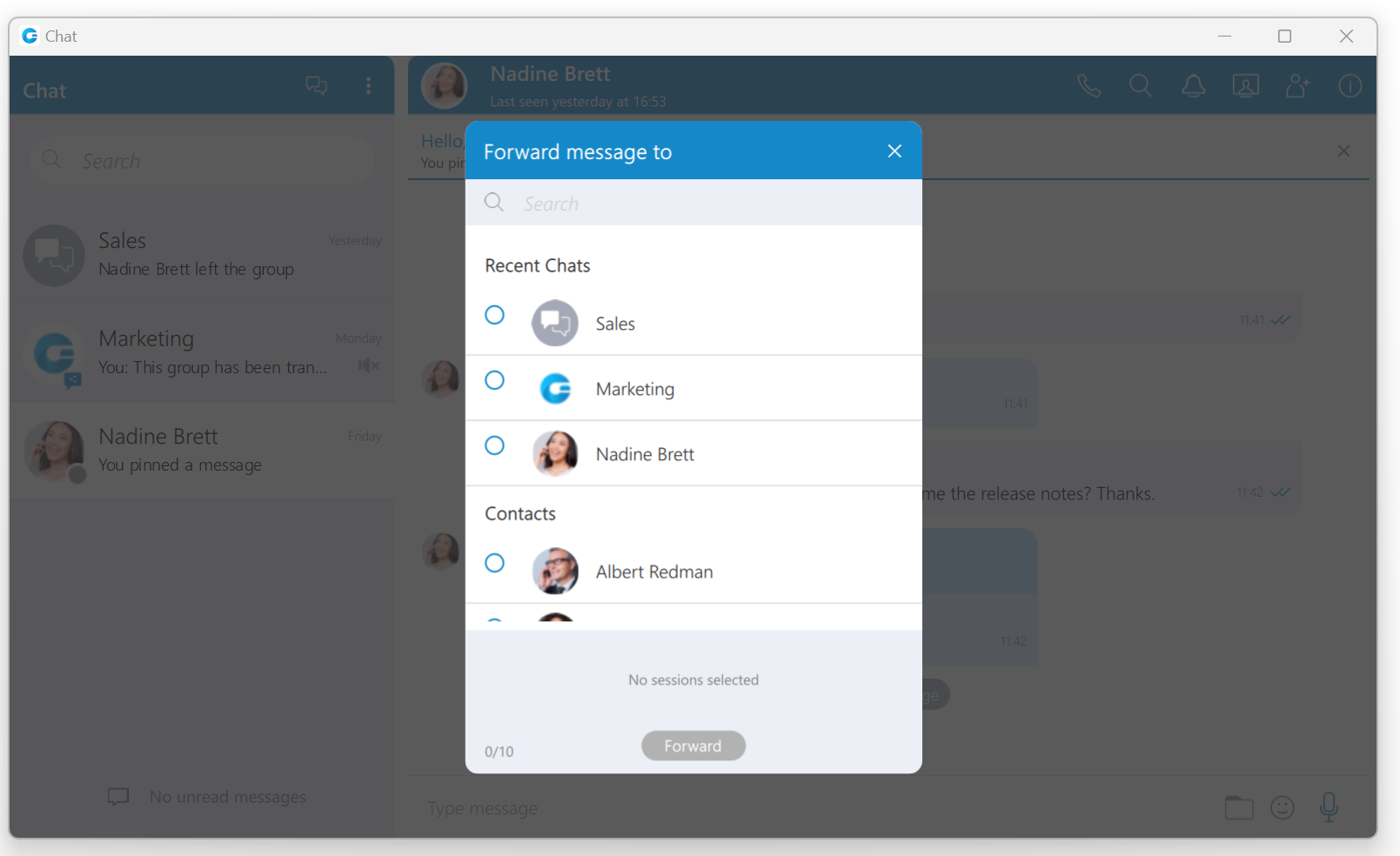
Pin/Unpin options are used to pin/unpin an important message or file message to the top of the conversation window. Anyone can pin/unpin the message inside the conversation. You can pin one message at the same time. By clicking on the pinned message, will redirect you to that message inside the conversation.
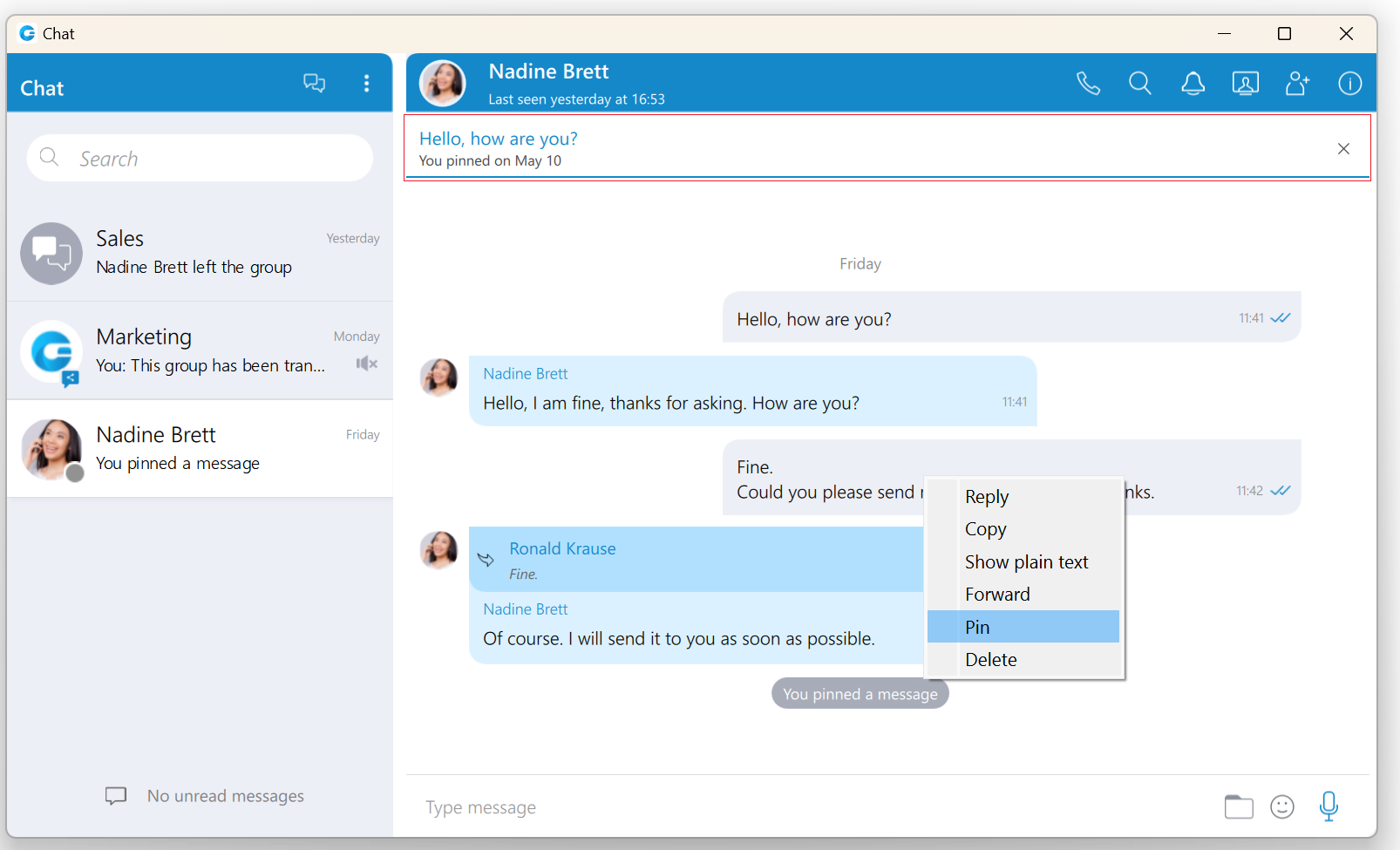
Info allows the user to see the information about the delivery and seen status of a single message within a group chat conversation.
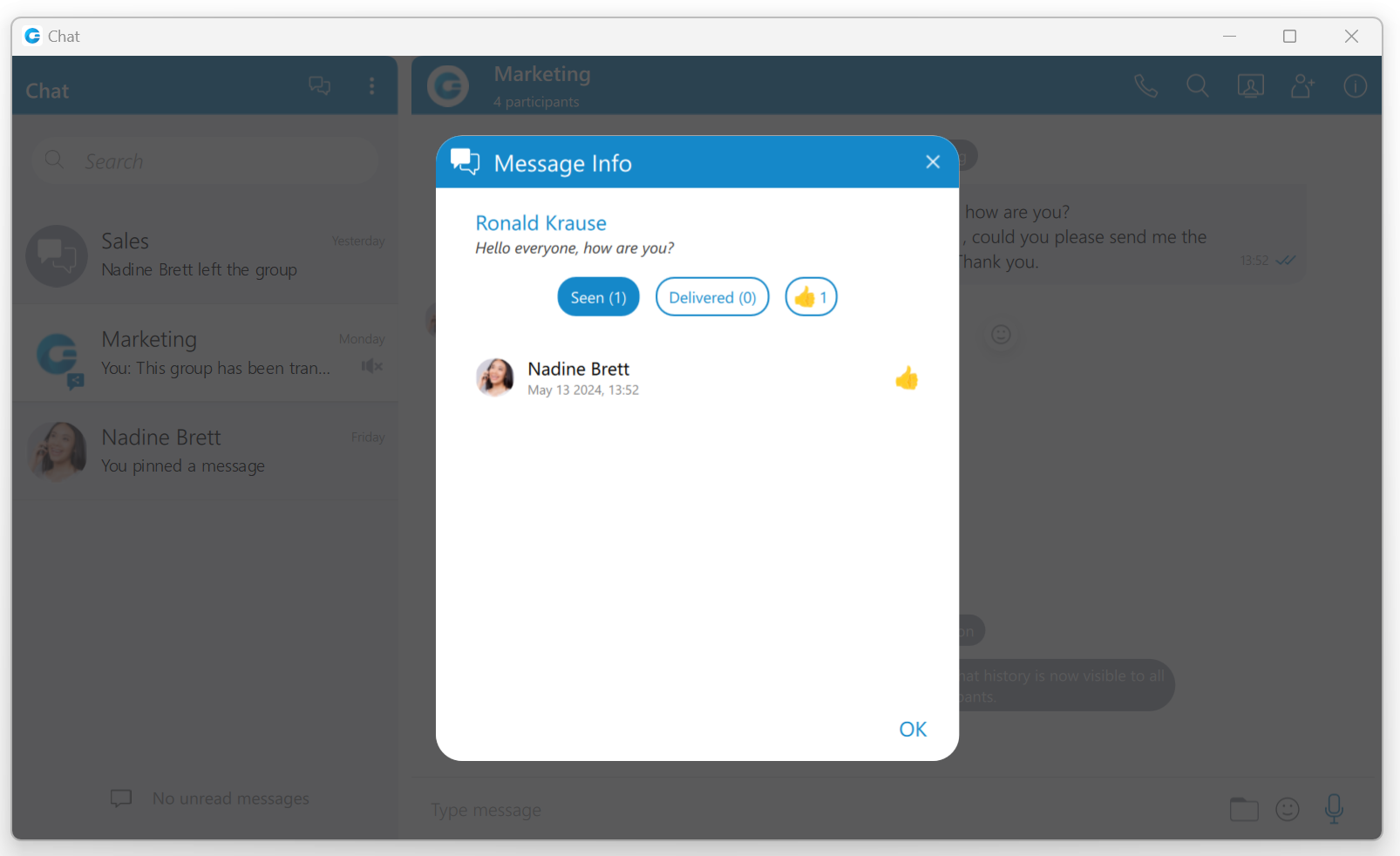
After a certain period of time, information about the seen/delivered status will automatically clear from the server, and the following message will be displayed within the info message dialog: "Seen and delivered information is automatically cleared and may not be available after certain period of time."
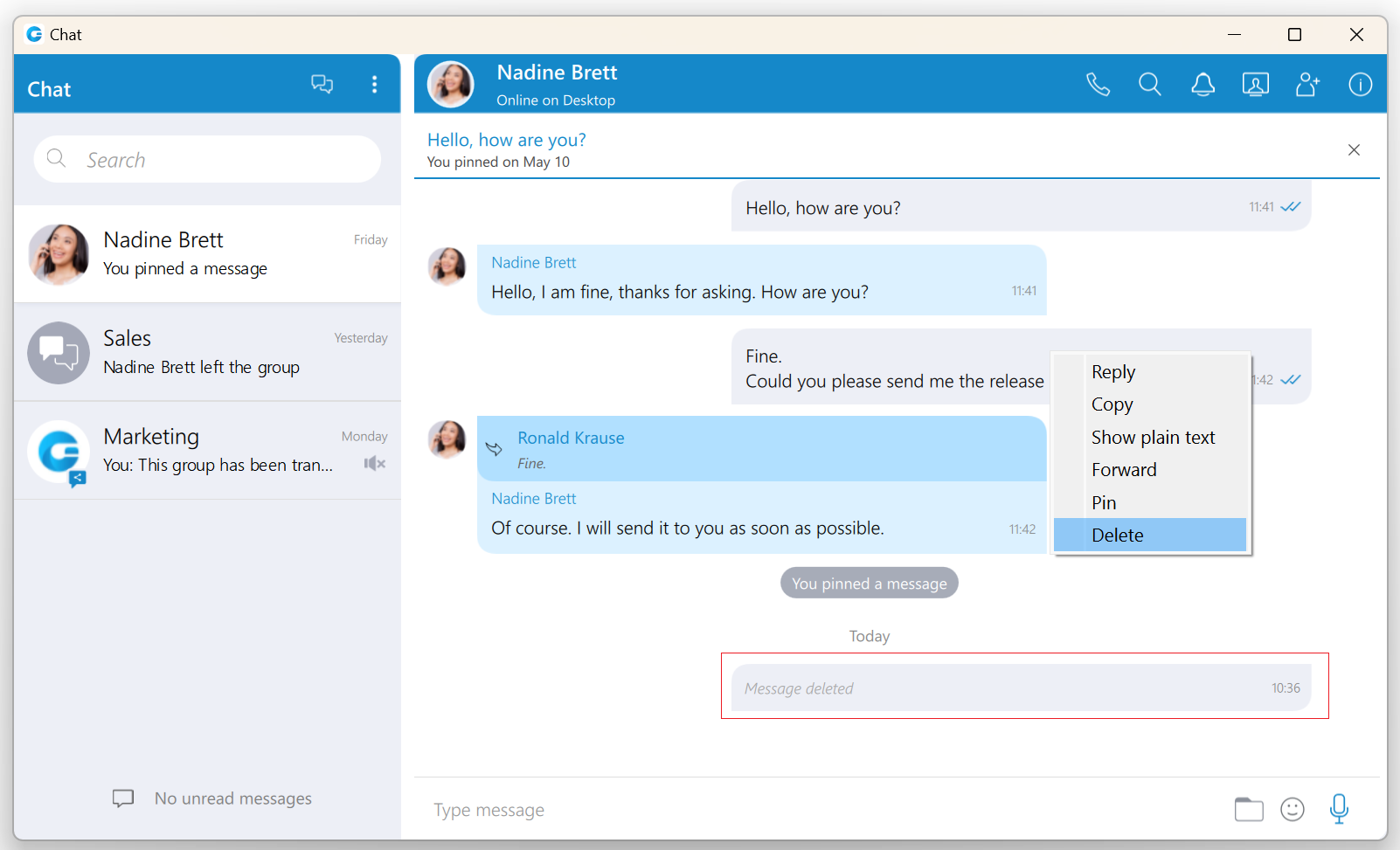
Delete allows users to delete text and file messages. To delete the desired message, users can just right-click on it, and from the drop-down menu, select Delete option.
After selecting the Delete option, the confirmation dialog will show up with two options for outgoing messages:
- Delete for myself with the following sub-content: This message will be deleted only for you. Other chat members will still be able to see it. Are you sure you want to proceed?
- Delete for everyone with the following sub-content: This message will be deleted for all participants. Are you sure you want to proceed?
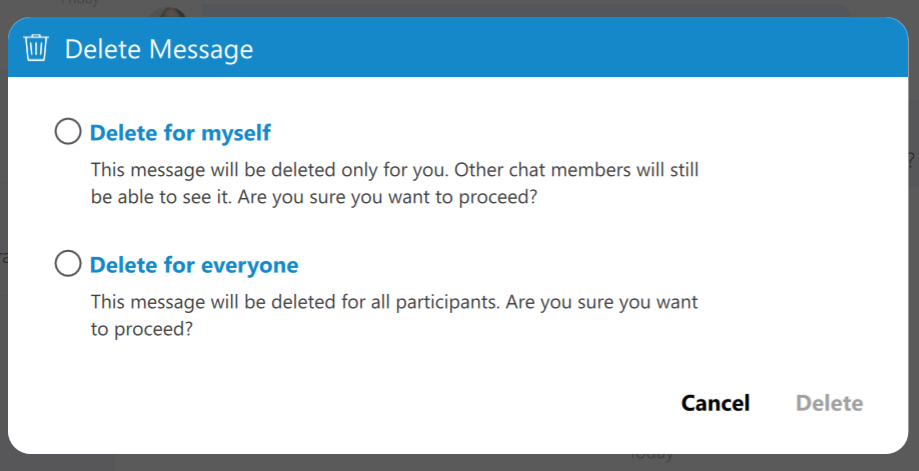
And for incoming messages, there is only one option:
- Delete for myself with the following sub-content: This message will be deleted only for you. Other chat members will still be able to see it. Are you sure you want to proceed?
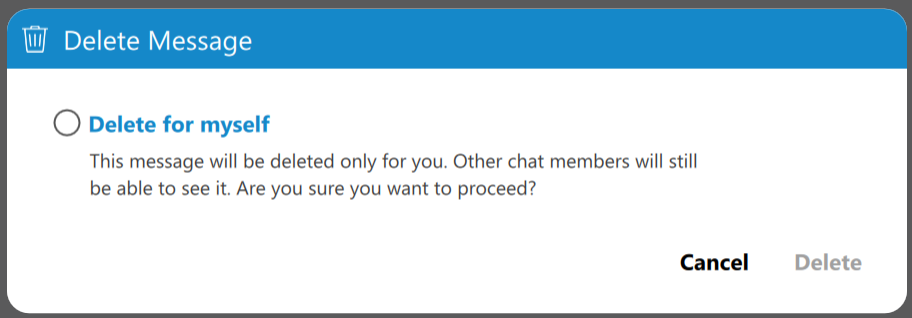
In addition to the options mentioned above, the confirmation dialog contains the Delete and Cancel buttons.
After deleting the message, the Message deleted indicator shows up.
¶ File message
Besides regular text messages, you can use the chat in gloCOM to share files.
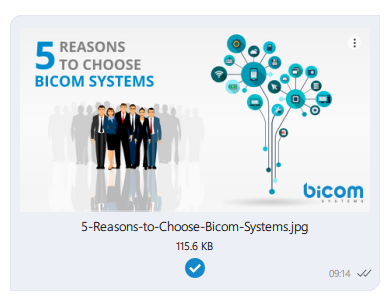
For image and video files there is a thumbnail that is automatically downloaded. Under the thumbnail, there is information about the file name and the file size. At the bottom of the file message there is an icon used to open, download, show upload/download progress or retry file upload/download depending on the file status. This is explained in detail in the Files Overview section. Also, at the top right of the file message, there is a 3 dots icon. Clicking on the icon opens a menu with options to download, open, locate the file on the file system, or create a copy of the file.
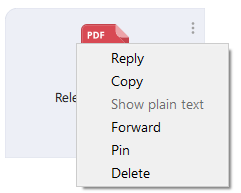
¶ Clipboard
gloCOM Desktop supports clipboard functionality for images and files. It means that the clipboard now can be used for copying/pasting images from the external app (such as image viewer, browsers, etc.) or for copying/pasting images and files from the File Explorer (Finder on macOS) directly into the chat session. With this at their disposal, users are no longer limited to just using an image/file picker and drag & drop feature for sending images and files.
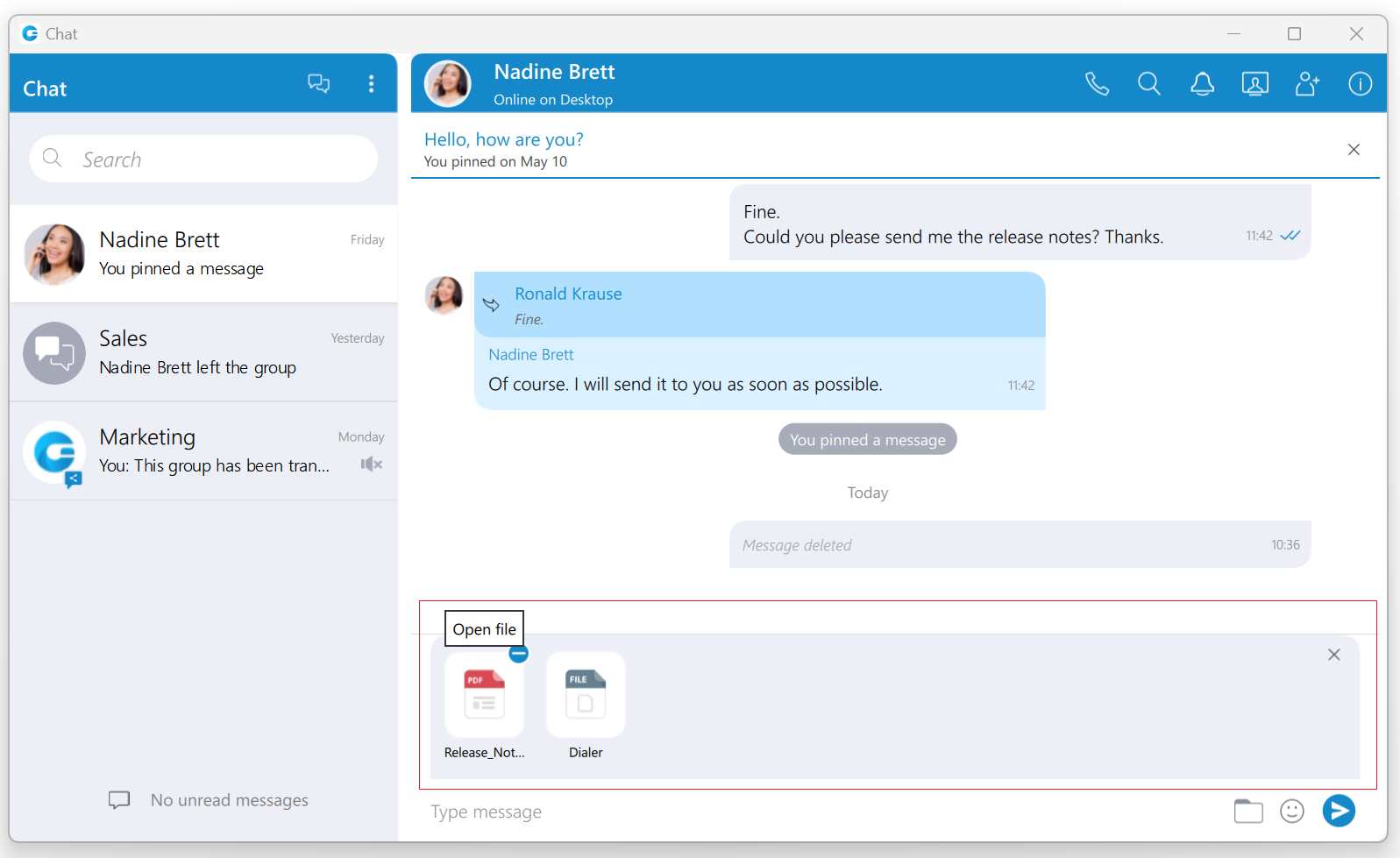
While using clipboard functionality for sending images and files, instead of sending them immediately after pasting into the chat, the application creates an attachment list that includes thumbnails within the selected chat session. Clicking on the thumbnail opens the file in the proper viewer app (image viewer for the pictures, the default video player for videos, etc.). This way, users have the opportunity to double-check selected files and images before sending.
Adding files to the attachment list while using the clipboard can be done in two ways:
- Using CTRL(Cmd on macOS) + C/V for copying/pasting files or
- Using the mouse right-clicking to copy/paste files.
Every image sent using the clipboard will be saved into the gloCOM downloads directory.
Furthermore, hovering over the file inside the attachment list displays a blue circle with the white dash at the thumbnail's upper right corner. Click on it to discard the file from the list. Discarding all files from the list can be done by clicking the x button in the upper right corner of the attachment list.
While the attachment list is active and the user selects files using a file picker or drags them into the chat, they will be attached to the attachment list. Otherwise, the app will send them immediately.
In addition, while the attachment list is present within the selected chat conversation, the user can write a text message simultaneously. In that case, the app will send the text message first and then the attached files one by one.
The maximum number of files attached to the attachment list at once is limited to five (5). Once the limit is reached, a pop-up message will appear displaying the following: Could not add files since it would violate the maximum files limit! (Max. count of all attachments: 5).
For larger images, the copy operation will take a while. During this time, the application will change the cursor type to loading, indicating that the file is being copied.
¶ Input field
Type message field on the bottom of the chat window is used to send messages to the currently selected conversation. After typing a message press the Enter (Return) key on your keyboard to send a message. To type in a new line press Shift + Enter or Ctrl + Enter (Command + Enter for macOS).

The length of the message that can be sent is limited to 10 000 characters.
 A folder icon allows the user to send files. Clicking on it opens up a dialog where the user can pick up to 5 files to be sent to the currently selected conversation. Also, the user can send files by dragging them from Windows Explorer (Finder on macOS) to the messages area within the chat window.
A folder icon allows the user to send files. Clicking on it opens up a dialog where the user can pick up to 5 files to be sent to the currently selected conversation. Also, the user can send files by dragging them from Windows Explorer (Finder on macOS) to the messages area within the chat window.
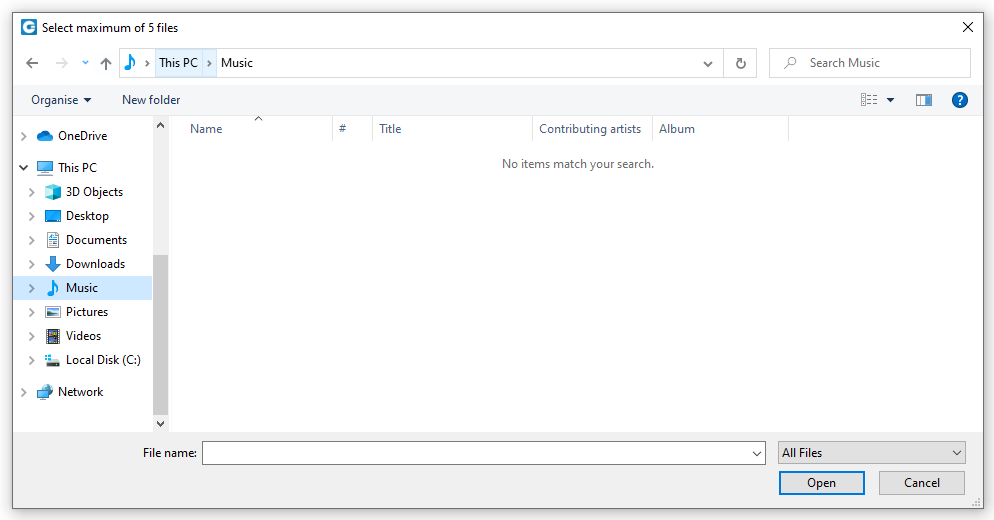
 An emoji icon allows the user to send emojis. Clicking on it shows an emojis window where the user can browse through emojis separated into categories. At the bottom of the emojis window is a list of the most recently used emojis.
An emoji icon allows the user to send emojis. Clicking on it shows an emojis window where the user can browse through emojis separated into categories. At the bottom of the emojis window is a list of the most recently used emojis.
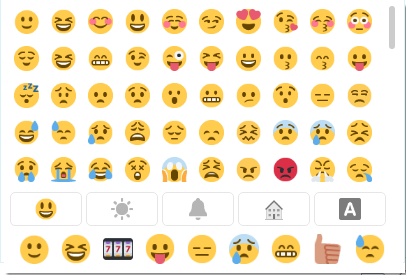
![]() A microphone icon allows the user to record voice messages for up to 2 minutes.
A microphone icon allows the user to record voice messages for up to 2 minutes.
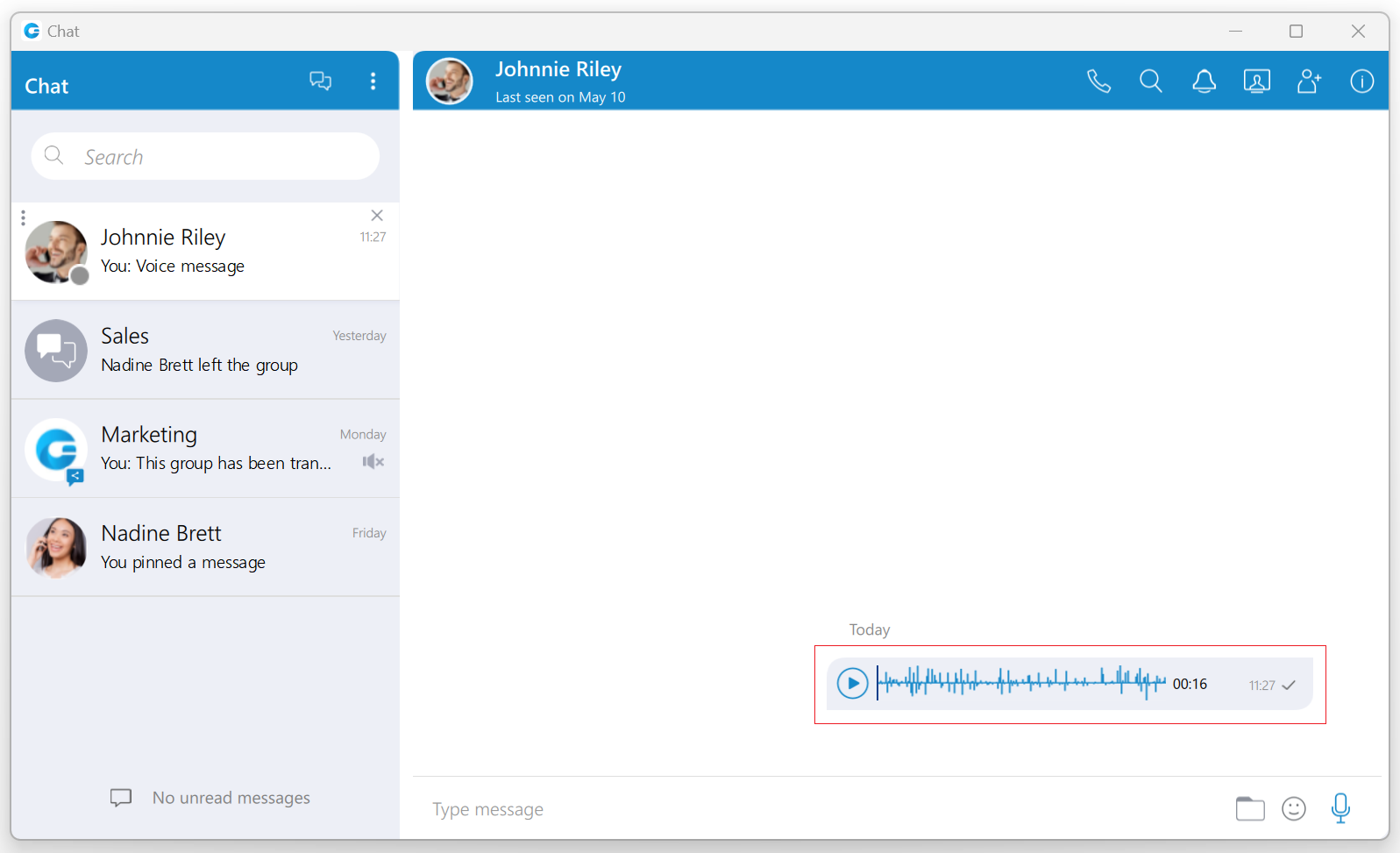
While recording, the user has the ability to use the following options:
- Discard voice message: It will discard a voice message.
- Stop recording voice message: It will stop recording. This way, the user can listen to the voice message before sending or discarding it.
- Send voice message: It will stop the voice message and send it immediately without the chance to listen to it.

While recording is active, sending text and file messages will be disabled until the user sends or discards the voice message.
Playing voice messages is possible within a chat by pressing the play button. It is possible to go back and forth through a selected voice message by clicking on the waveform.
Some chat features that are described above can be enabled/disabled depending on the server settings.
¶ SMS/MMS
These features allow the user to send/receive SMS/MMS messages.
The MMS message is an enhancement to the standard SMS message. The main difference between SMS and MMS messages is that the user can send multimedia and other files in their messages. It includes media such as videos, pictures, audio clips, GIFs, and much more. The maximum size of uploaded files is 500 KB or up to ten (10) files per message. Additionally, MMS allows for up to 1000 characters of text in a message, which is a lot more than for a standard SMS.
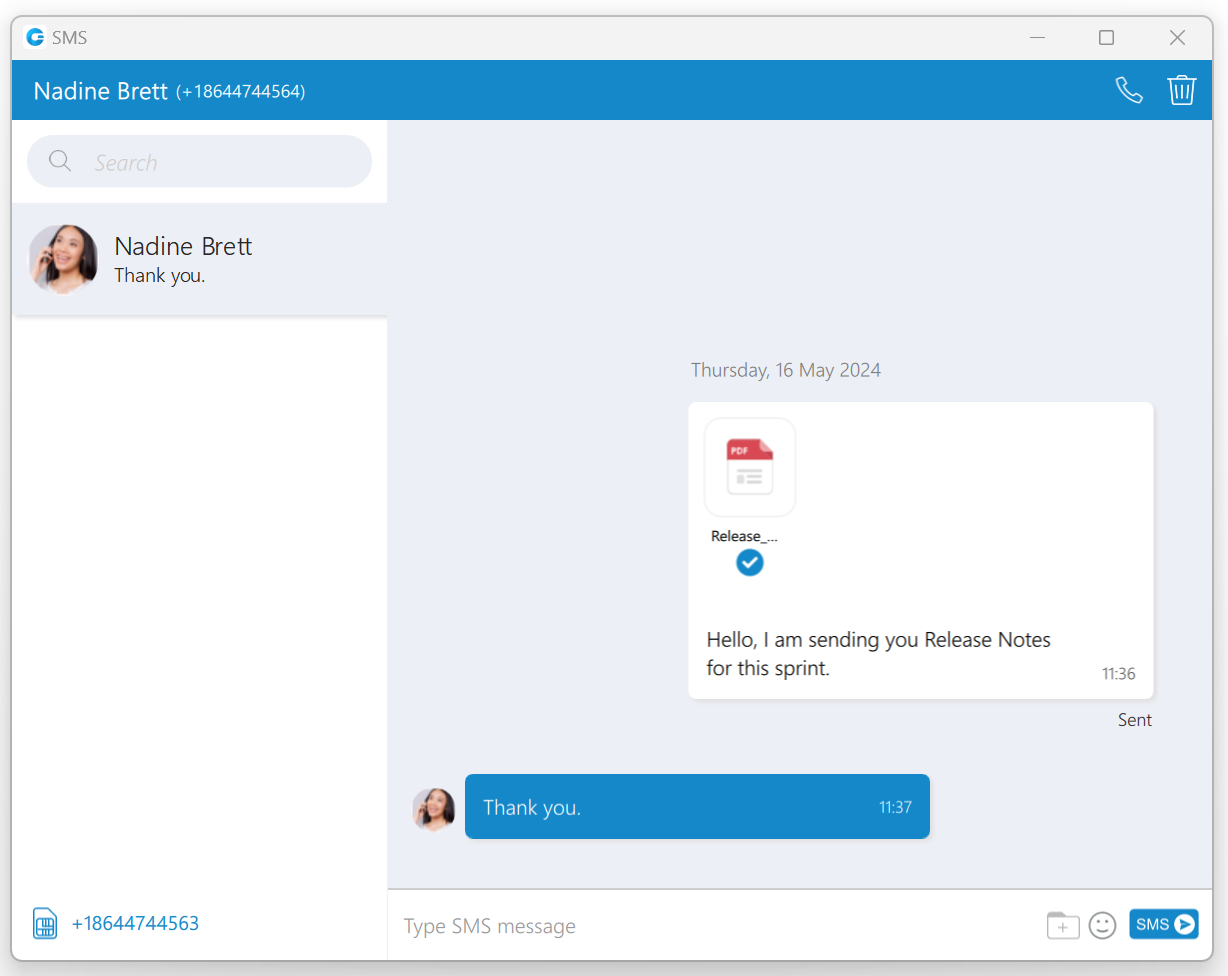
The gloCOM applications allow users to synchronize their SMS conversations and messages across multiple devices, ensuring they can access their messages from any device they use.
¶ SMS Number
If the user has associated an SMS number with their Extension, they need to open the Personal Information screen to see it.
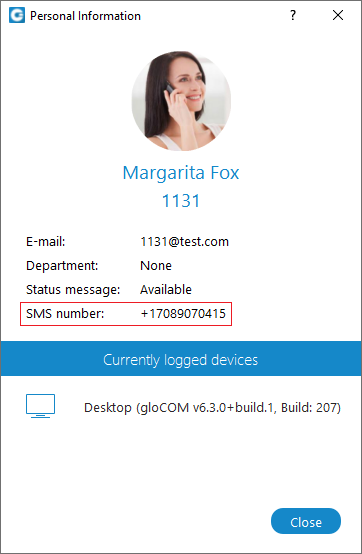
To see the SMS number of the contact, right-clicking on contact, and from the drop-down menu, select the Contact Information.
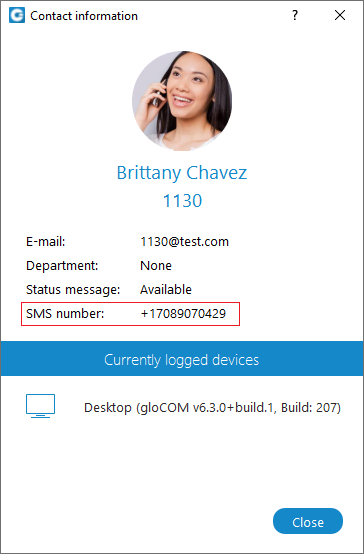
¶ Shared SMS Number
An SMS number can be shared between multiple extensions. In case when the user receives a message from the number used by multiple extensions, the SMS conversation will be displayed as in the picture.
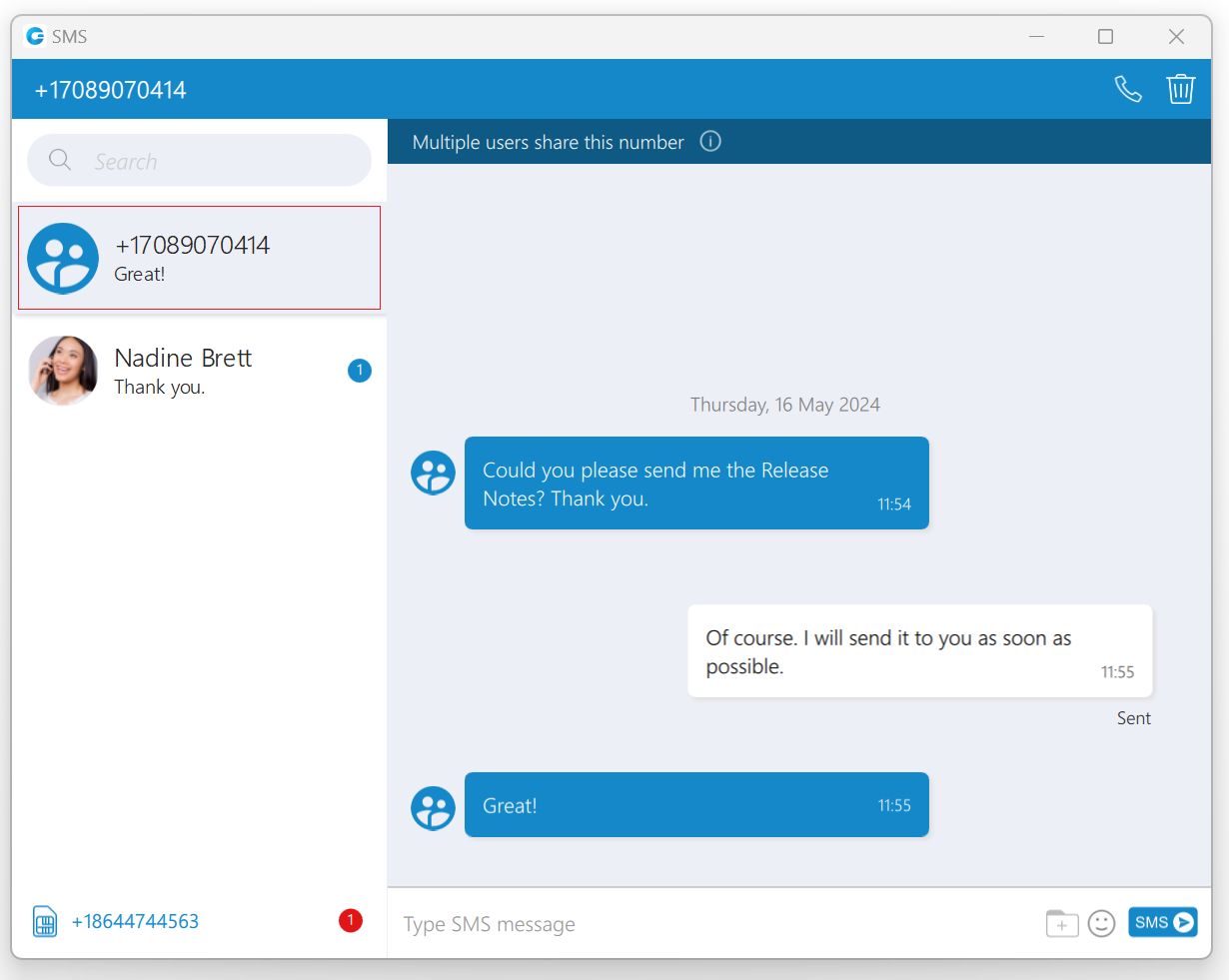
All extensions using this number can see all sent/received messages.
Furthermore, click the Multiple users share this number label within the conversation to see who uses this SMS number.
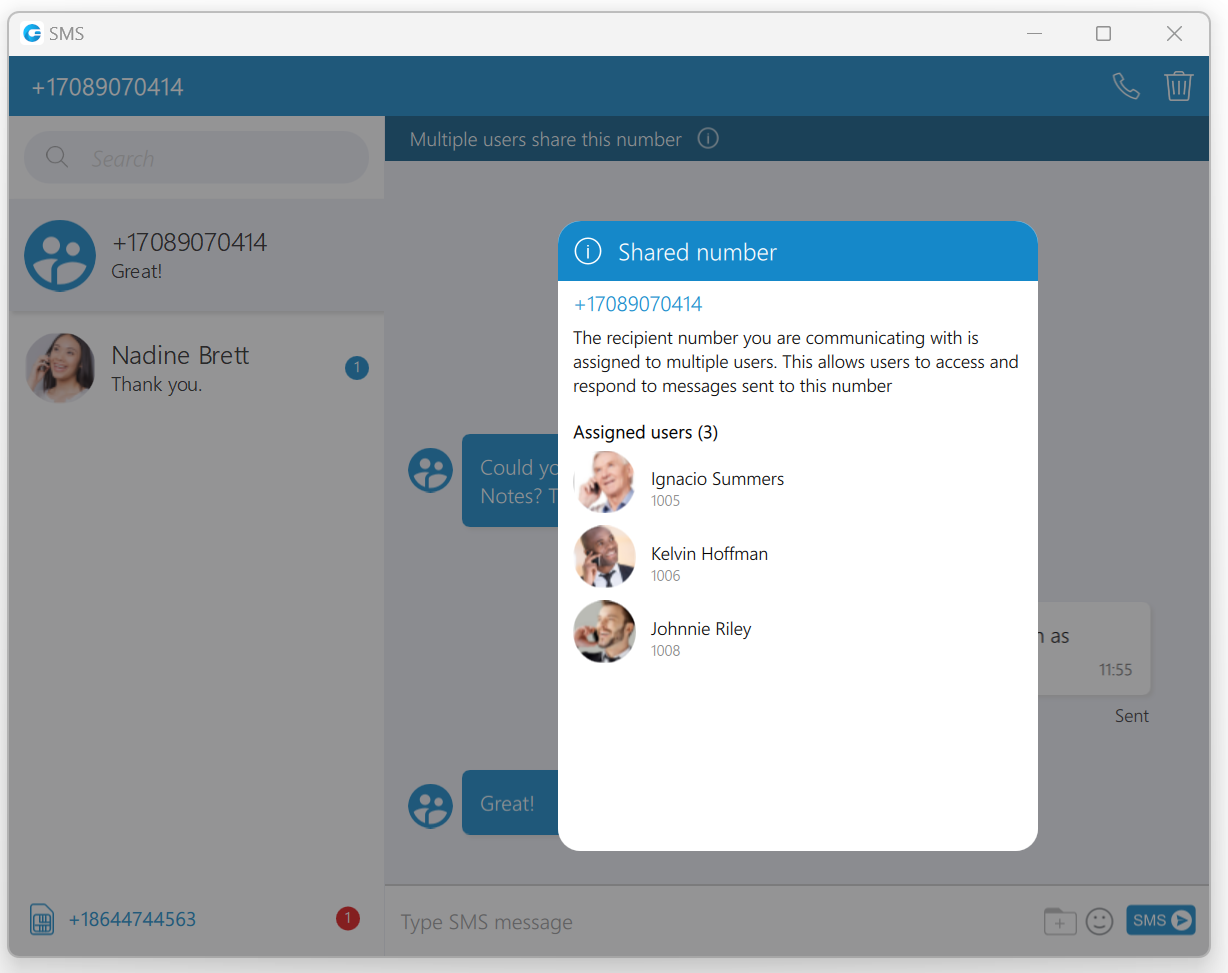
Messages of the other users you share the number with will have a header with their name and avatar, as in the picture. Your messages will not have this header.
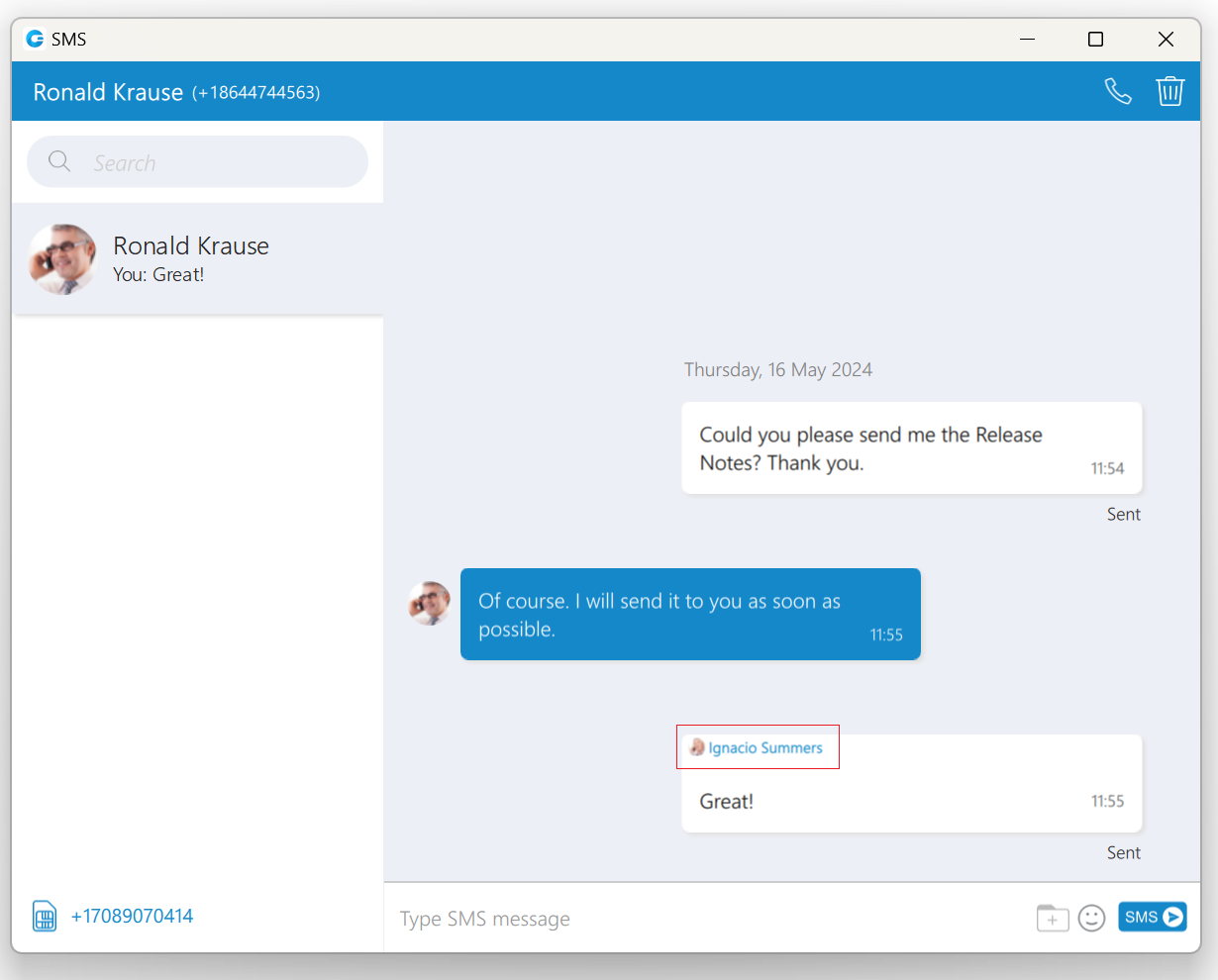
¶ Start SMS conversation
There are two ways to start an SMS conversation:
The first way is to open the SMS window by clicking on the SMS icon in the toolbar within the main gloCOM window. The SMS window will appear. Next, enter the name or number of the contact inside the search field and click the result to start a conversation.
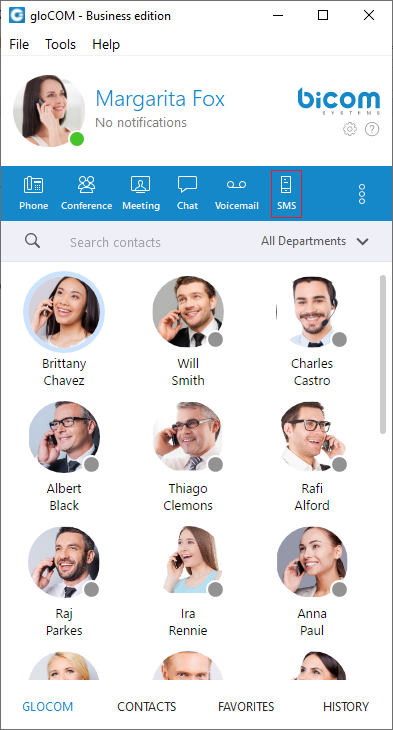
The second way is right-clicking on the contact, and from the drop-down menu select Send SMS.
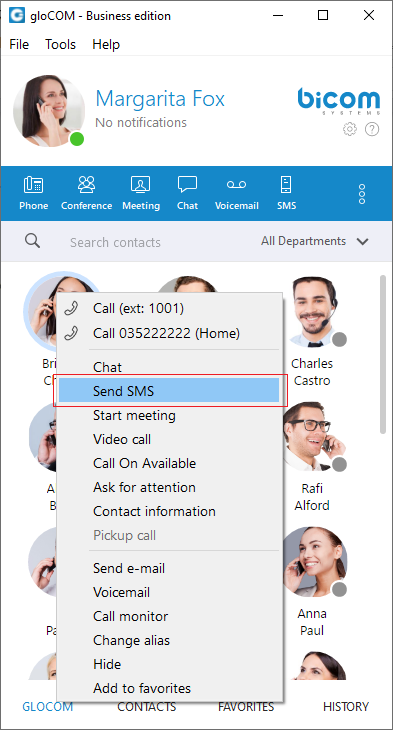
If the contact has multiple phone numbers, the pop-up window will appear with all their numbers, and the user will be able to select which number they desire to send an SMS/MMS message.
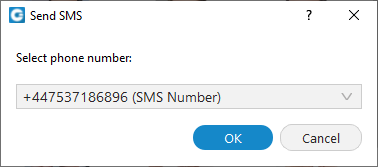
¶ SMS/MMS Notifications
SMS/MMS notifications have the same behavior as chat notifications. When the SMS/MMS message is received, a notification pops up.


The app will display the number of unread SMS messages within a gloCOM main window, taskbar, tray icon, and at the bottom of the SMS window.

To turn off the SMS notifications, please navigate to Preferences → Alerts and uncheck the Notify me when I receive a new SMS message option.
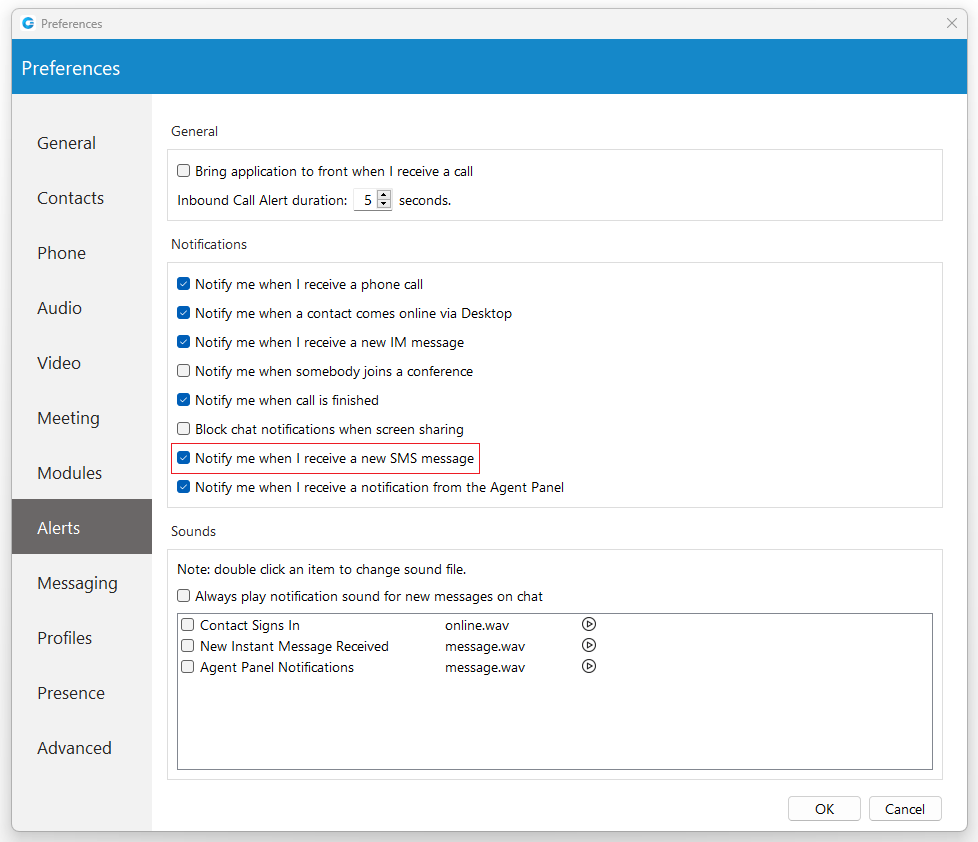
SMS notifications are unchecked by default.
¶ SMS Window
At the top left side of the blue bar is displayed an SMS number of contact the user is currently talking to.
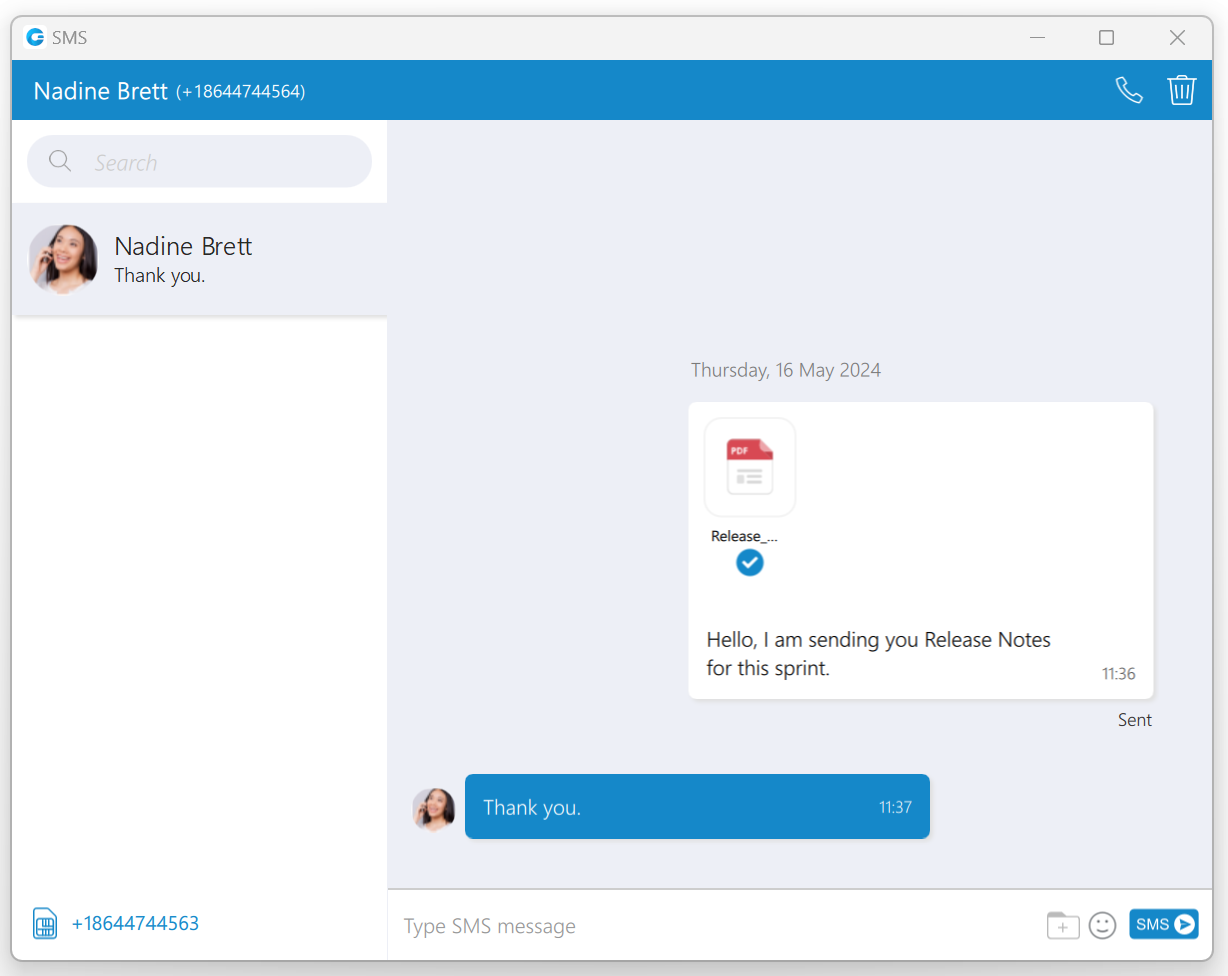
On the right side of the blue bar, there are two options:
-
 Call the currently selected user.
Call the currently selected user. -
 Delete the current conversation.
Delete the current conversation.
The search field is below the contact’s SMS number. The user can use it for filtering contacts, conversations, and searching messages.
Below the search field is a conversation list of all user’s conversations sorted by their most recent activity.
Next to it is the messages view. Deleting messages can be done by right-clicking on the desired message and selecting the Delete option from the drop-down menu.
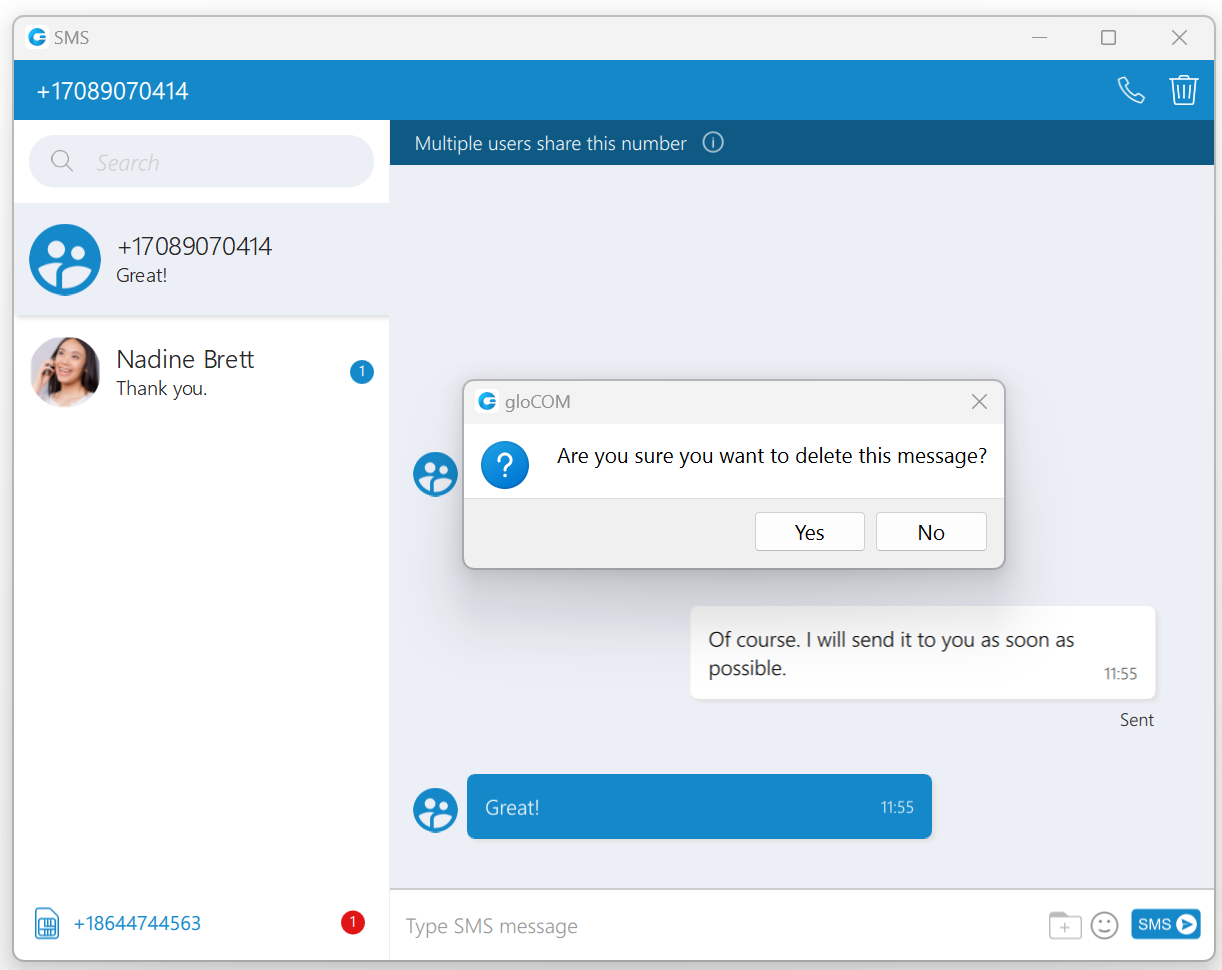
Besides the Delete option, users can copy highlighted text by selecting the Copy option from the drop-down menu.
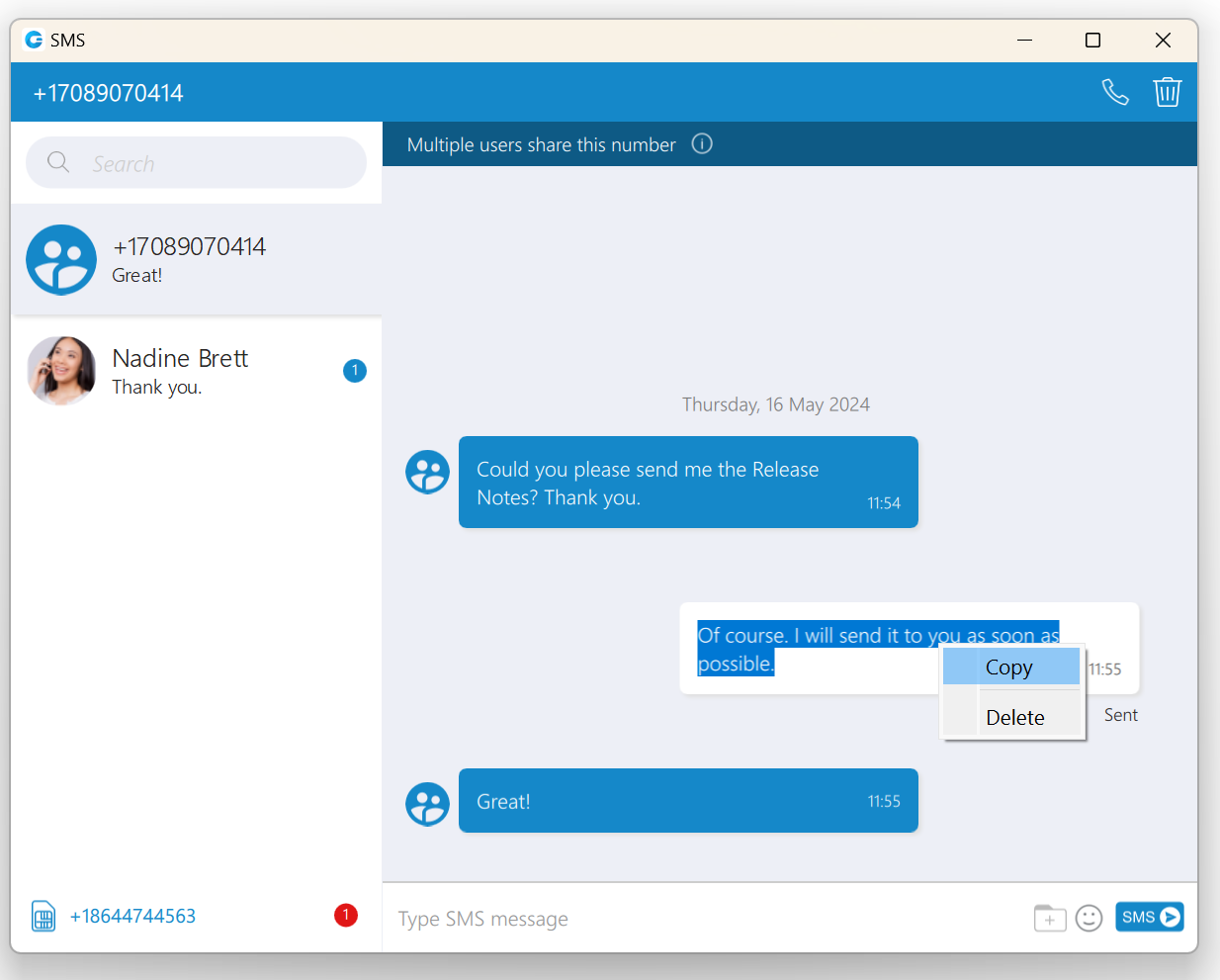
The white rectangle represents outgoing messages, and the blue represents incoming messages.
An input field is below the messages view. Click the send SMS icon on the right side of the input field to send an SMS message. The Enter key on the keyboard represents a new line.
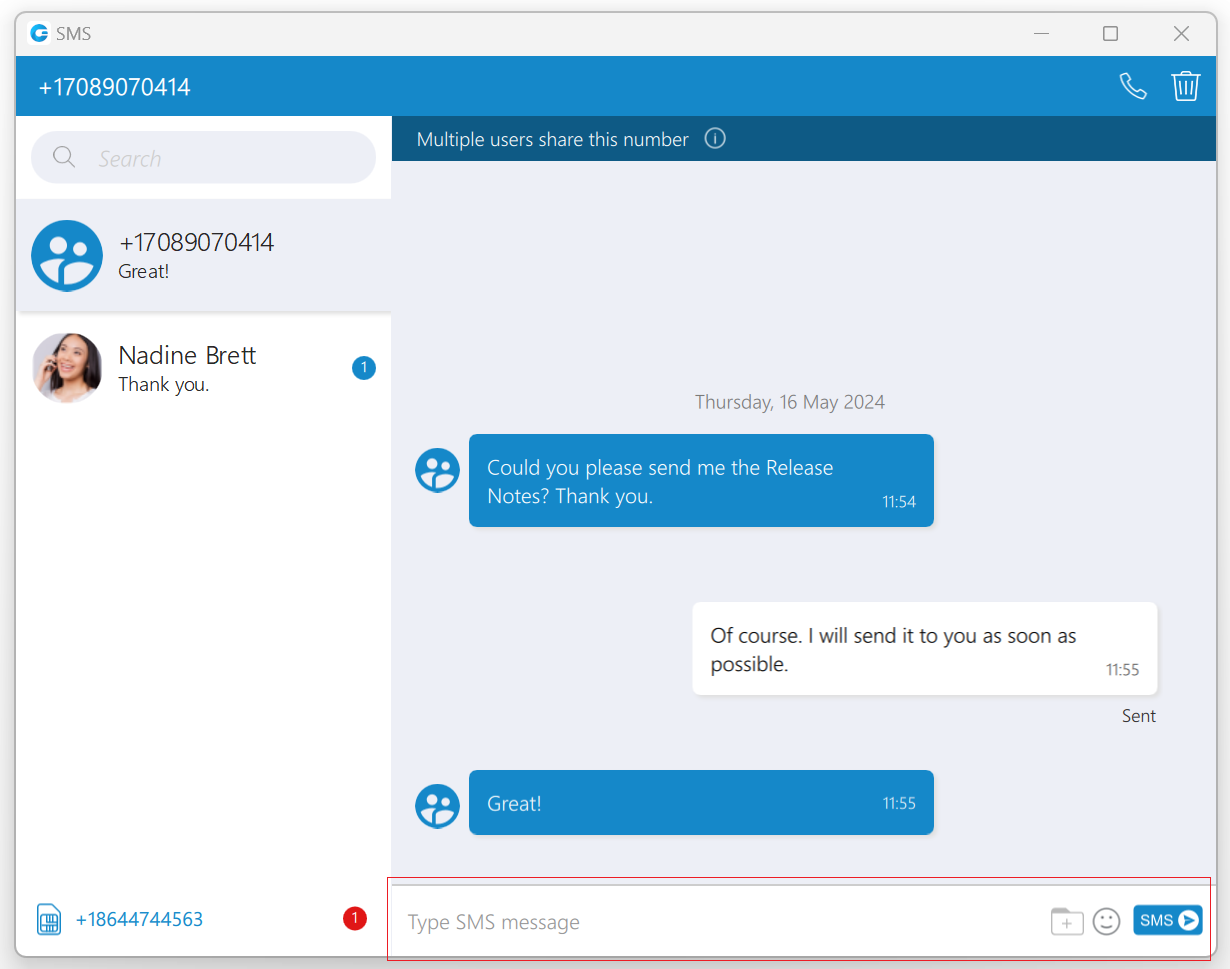
It is not possible to send more than four (4) messages at a time. Also, the character counter appears above the send SMS icon as soon as you start typing the message.
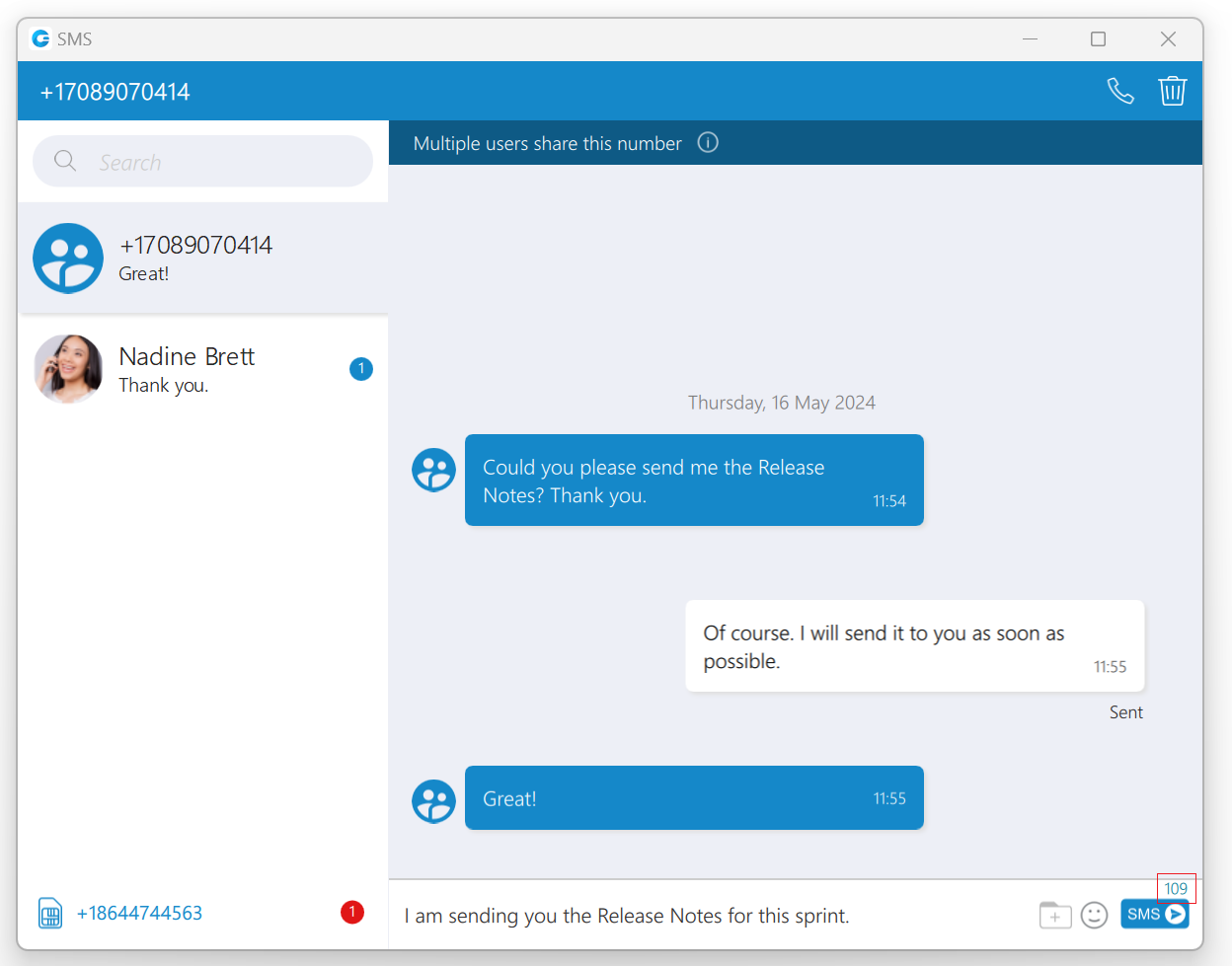
A folder  icon that is used for sending files can be found next to the Send SMS icon. Clicking the icon opens up a dialog where the user can select up to ten (10) files to be sent to the currently selected conversation.
icon that is used for sending files can be found next to the Send SMS icon. Clicking the icon opens up a dialog where the user can select up to ten (10) files to be sent to the currently selected conversation.
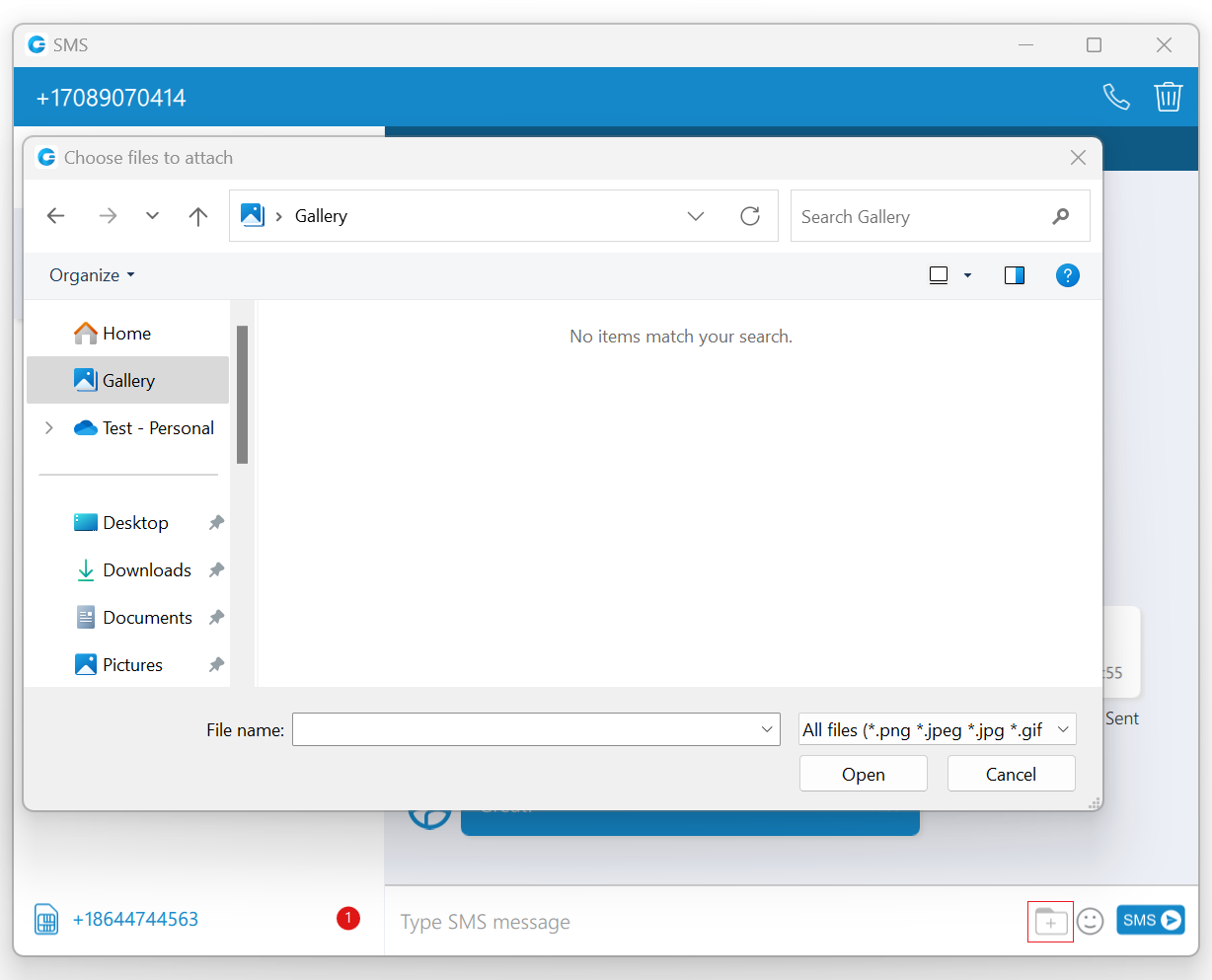
 An emoji icon allows the user to send emojis. Clicking on it shows an emojis window where the user can browse through emojis separated into categories. At the bottom of the emojis window is a list of the most recently used emojis.
An emoji icon allows the user to send emojis. Clicking on it shows an emojis window where the user can browse through emojis separated into categories. At the bottom of the emojis window is a list of the most recently used emojis.

The user can upload a max of 500 KB of multimedia data.
Additionally, the user can send files by dragging them from Windows Explorer (Finder on macOS) to the message area inside the SMS window. If the amount of the selected data is larger than 500 KB or if more than ten (10) files are selected, a pop-up message will appear displaying the following: Maximum size of attached files for MMS reached. All files that exceed the previously mentioned limits will be discarded.
Please note that supported MMS files are as follows:
- Image Files: jpeg, png, gif
- Audio Files: MP3, OGG, AMR
- Text Files: PDF, Vcard, txt
- Video Files: mp4
The application will compress images (jpeg and png) before sending, which gives the user the ability to send images larger than 500 KB. The application will preserve the quality as much as possible and adjust the resolution as needed.
If a file is selected, an SMS message becomes an MMS message, which can be seen above the Send SMS/MMS icon as the counter of the remaining kilobytes is displayed instead of the character counter.
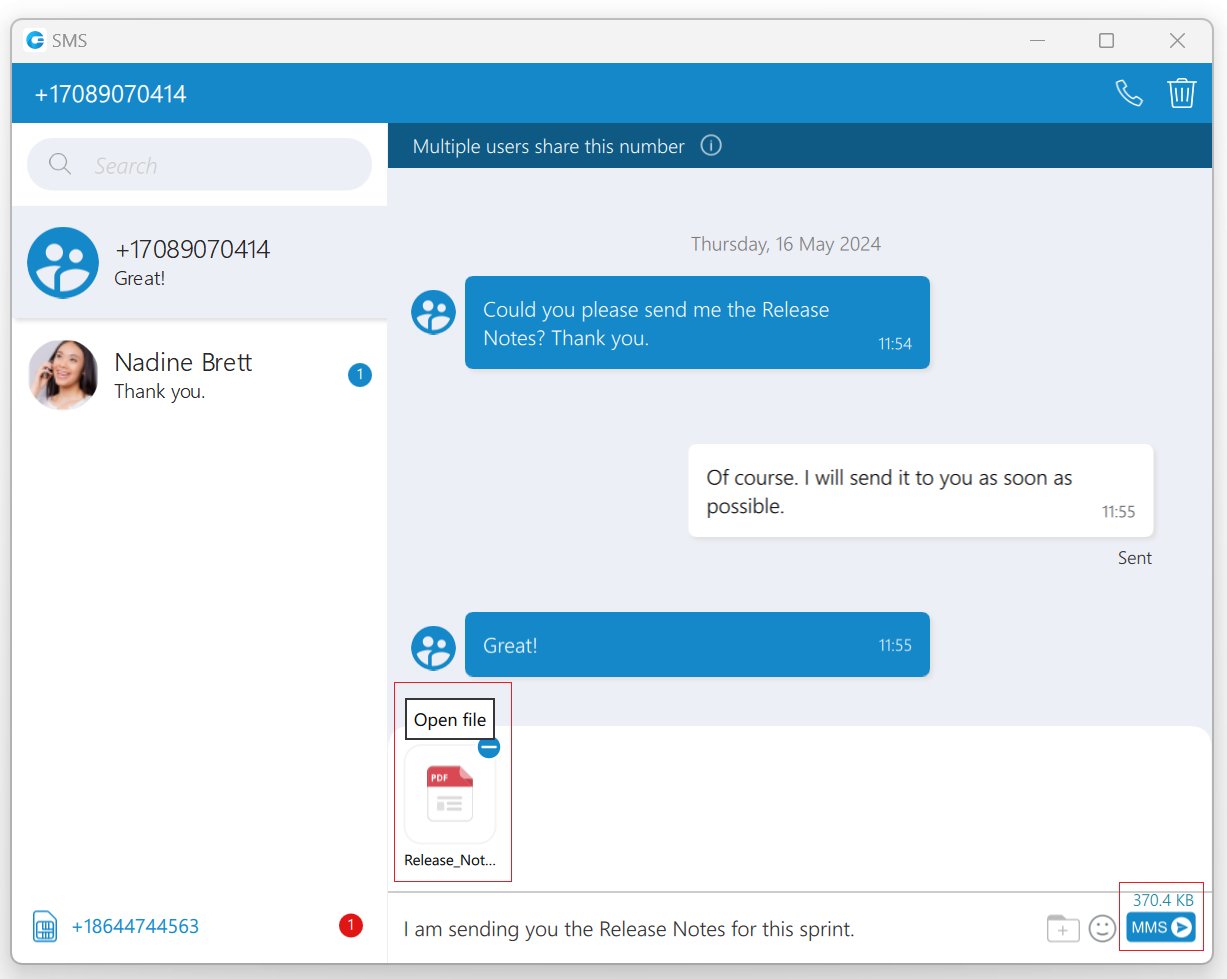
After selecting the files, a thumbnail with the file name for each selected file will be displayed above the text area within the input field. Also, it is possible to remove selected files from the MMS message by hovering over them and selecting the blue circle with a white dash at the top right corner of the thumbnail.
The gloCOM will automatically download all files smaller than 500 KB. If the file is not downloaded for any reason, the user can click on it to download it.
The associated SMS number (or the alert icon) is displayed at the bottom left side of the SMS window. What will be displayed depends on whether the SMS option is enabled or not.
If the user has associated an SMS number with their Extension, the SMS number will appear. It means that they can send/receive SMS/MMS messages. Click on it to copy it to the clipboard.
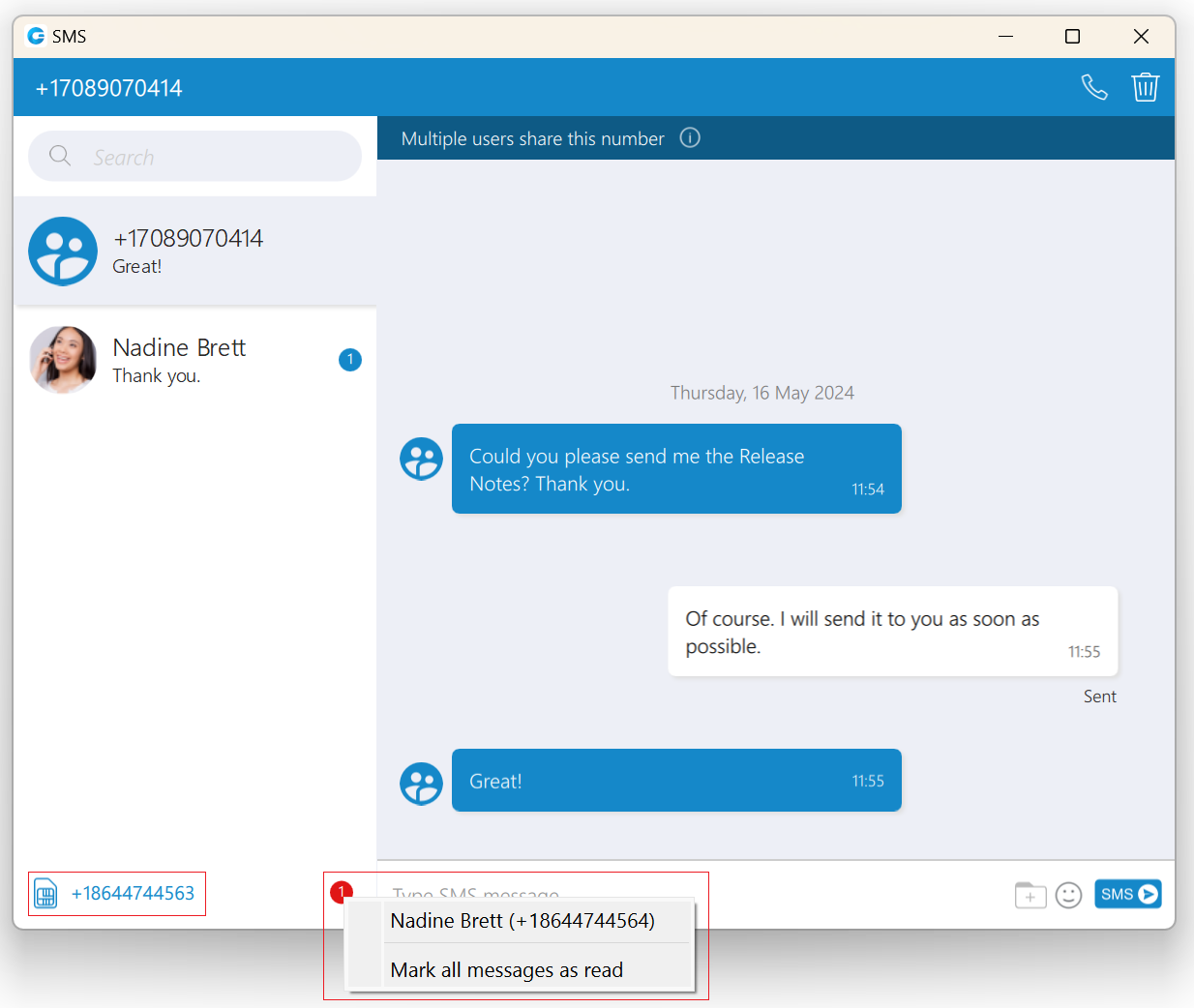
Next to it is an unread SMS messages indicator. It informs the user if there are currently unread SMS messages. It has the same behavior as the unread messages indicator within the chat window.
If there are unread messages, the red circle will appear with the number of missed SMS messages inside it to draw the user’s attention.
Click on it to open up a menu showing a list of all conversations with unread messages indicating the number of unread messages in the parenthesis. Also, there is an option to mark all messages as read.
Marking all messages as read will effectively treat all messages as read and remove the unread count indicator even though you have not read them yet. Clicking on any other option besides Mark all as read opens the selected conversation. It can be used as a quicker way to find conversations with unread messages instead of looking for them in the conversations list. If there are no unread messages, the red circle will not appear.
If the SMS number is not associated with the user Extension, the alert icon will appear instead of the SMS number with the message, No SMS number assigned. It means that the SMS/MMS messages cannot be sent or received.
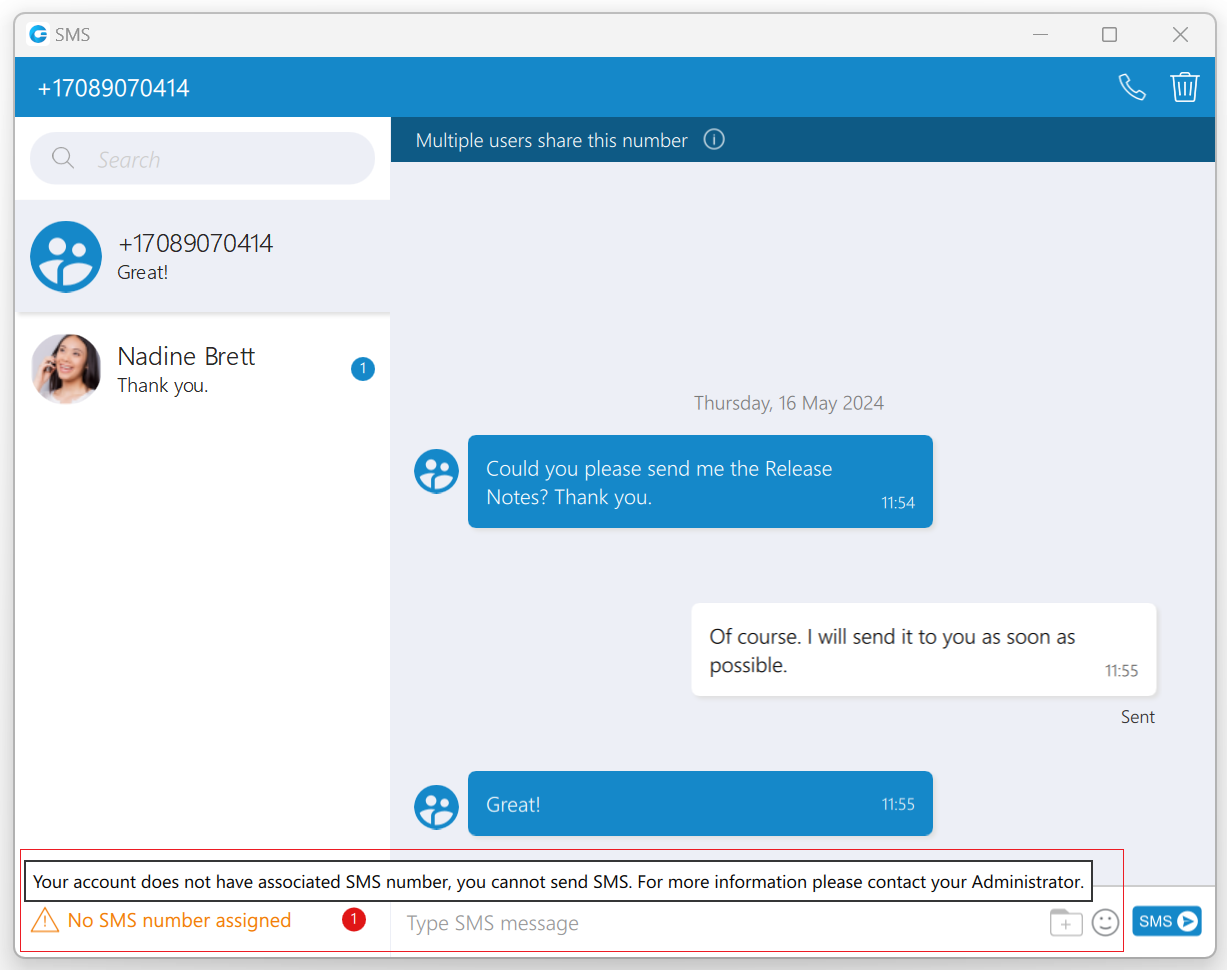
¶ SMS Message States
The SMS/MMS message has only three states:
- Sending
- Sent (It does not mean that the message is delivered.)
- Failed ((When the SMS/MMS message is in this state, click the Retry option to send it again.)
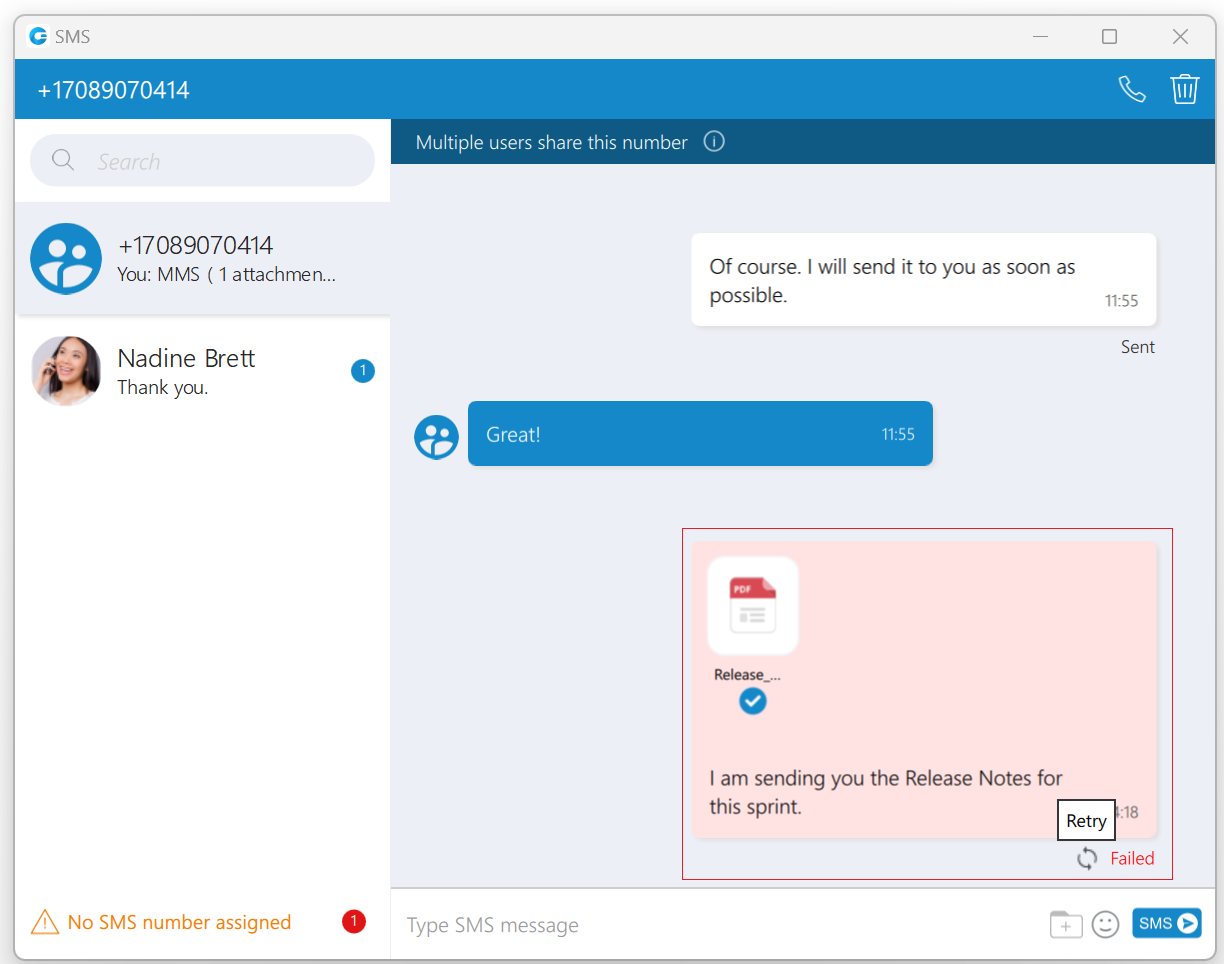
¶ Enable/Disable SMS messaging on Desktop
By default, SMS/MMS messaging is enabled within the gloCOM Desktop application. The user can disable it if they do not want to use the gloCOM Desktop application for SMS/MMS messaging.
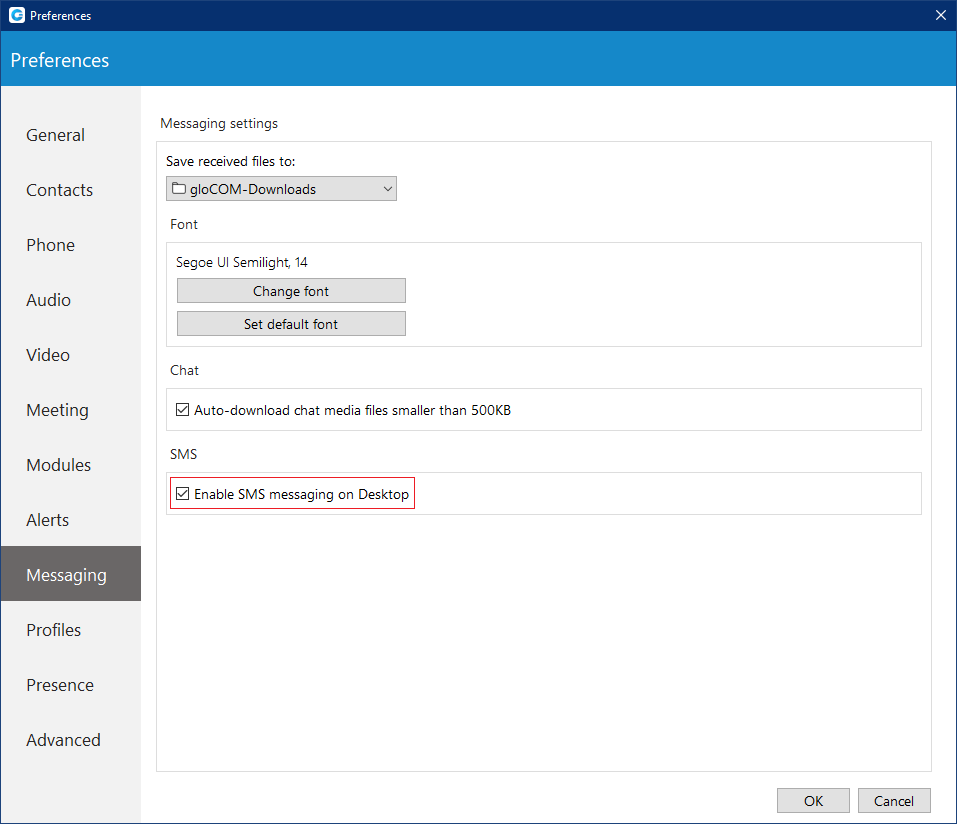
To disable SMS/MMS messaging, please navigate to the Preferences --> Messaging and uncheck the Enable the SMS messaging on Desktop option. Unchecking this option will disable sending/receiving SMS/MMS messages through the gloCOM Desktop application, but users can still send/receive SMS/MMS messages through the gloCOM GO application.
Enabling/Disabling SMS messaging on Desktop can only be done when the PBXware version is older than the PBXware 7.
¶ Export old SMS History
To export an old SMS history, please navigate to Preferences -> Messaging and click the Export old SMS history button.
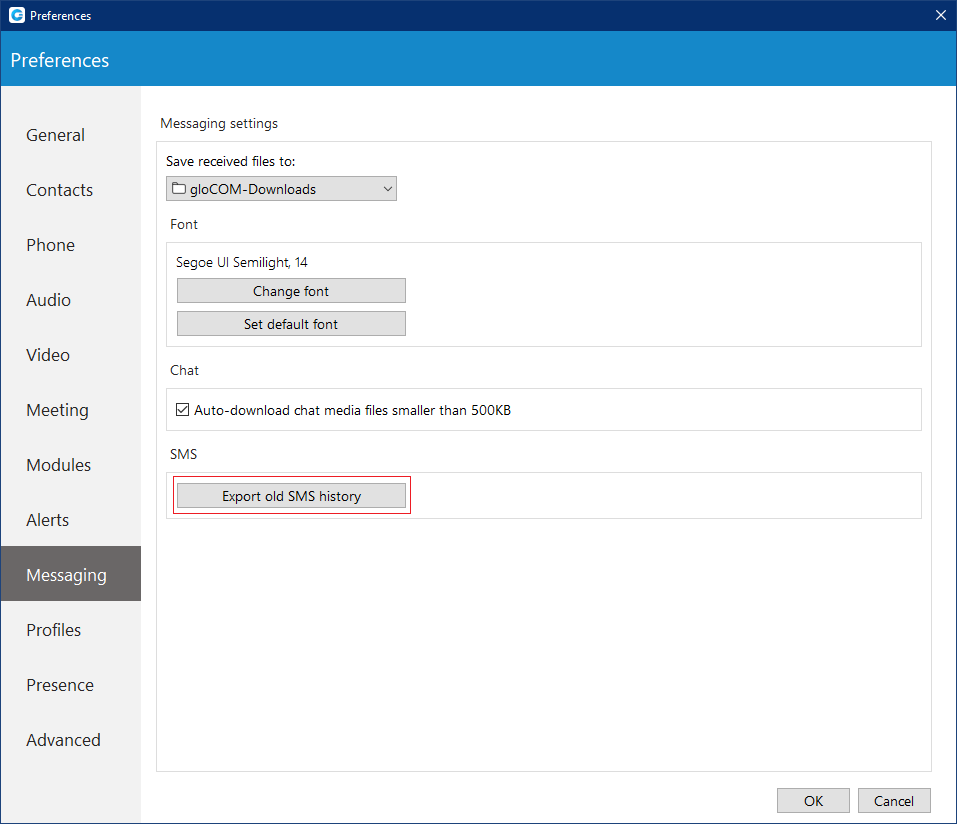
The Export old SMS history button will be displayed only when the old SMS history exists.
After clicking the button, a file picker will show up, allowing the selection of the desired location for exporting an old SMS history. All old SMS conversations will be exported as individual files within the new SMS folder created by the application. In the case of MMS messages, the application saves existing files within the SMS folder.
¶ Presence
gloCOM brings a unified presence that is synced across all of your devices (Desktop, Mobile, and Web). For a currently online user, you can see if they are connected via Desktop, via Mobile, via Web, or even all three. For users who are not currently connected, you can see when was their last activity, in order to have a better understanding of their availability. For example, if you see that the user was last seen a few minutes ago, you might assume they will probably be able to respond to your calls/messages. On the other hand, if a user has not been seen for a few days, it might indicate they have limited availability and are out of the office. User’s presence and availability are represented by the icon visible in the bottom right of their avatar. Details about a user’s presence are shown in a tooltip after hovering over them in both grid and list view. The tooltip contains information such as: the device that the user is connected with, their last activity, their status message, and their phone status (idle, on-call, do not disturb, etc.).
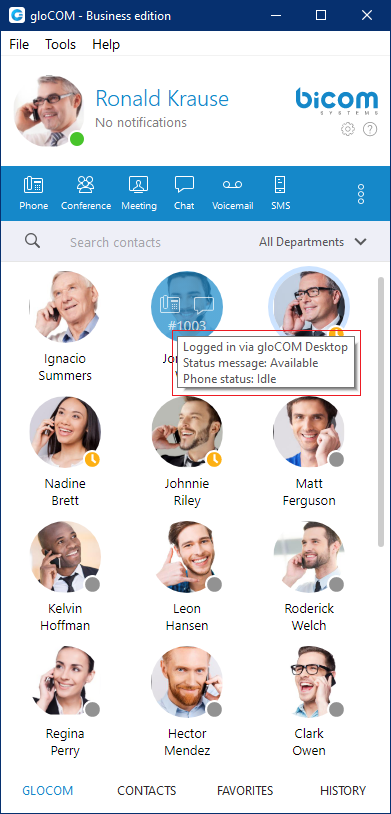
Status icon indicator can be any of the following:
 If there is no icon in the bottom right of the user’s avatar, it means that they are currently online and available.
If there is no icon in the bottom right of the user’s avatar, it means that they are currently online and available. This icon defines the "Ringing" status of the extensions. It will be displayed when the user is being called, except when the user is already on a call, in which case the status will be “On Call”.
This icon defines the "Ringing" status of the extensions. It will be displayed when the user is being called, except when the user is already on a call, in which case the status will be “On Call”. The user is currently on a phone call.
The user is currently on a phone call. The user is currently online, and they’ve set their status to Busy.
The user is currently online, and they’ve set their status to Busy. The user is currently online, and they’ve set their status to Do not Disturb.
The user is currently online, and they’ve set their status to Do not Disturb. This icon has multiple meanings:
This icon has multiple meanings:
- The user is currently online, and they’ve set their status to Away.
- The user is currently connected via Desktop, but they are Away from Desktop.
- The user is not currently connected, but they were last active less than N hours, where the N represents the value that depends on the settings set on the server (For example, 8 hours, 15 minutes, etc.)..
 The user was not active in the last N hours, where the N represents the value that depends on the settings set on the server (For example, 8 hours, 15 minutes, etc.).
The user was not active in the last N hours, where the N represents the value that depends on the settings set on the server (For example, 8 hours, 15 minutes, etc.).
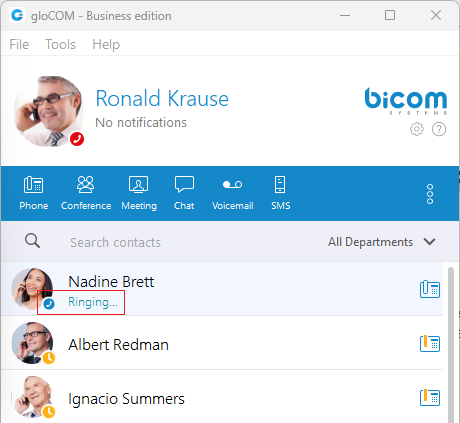
¶ Status and status message
You can choose your own status by clicking on the status icon in the bottom right of your avatar in the main window, or by clicking on the tray icon.
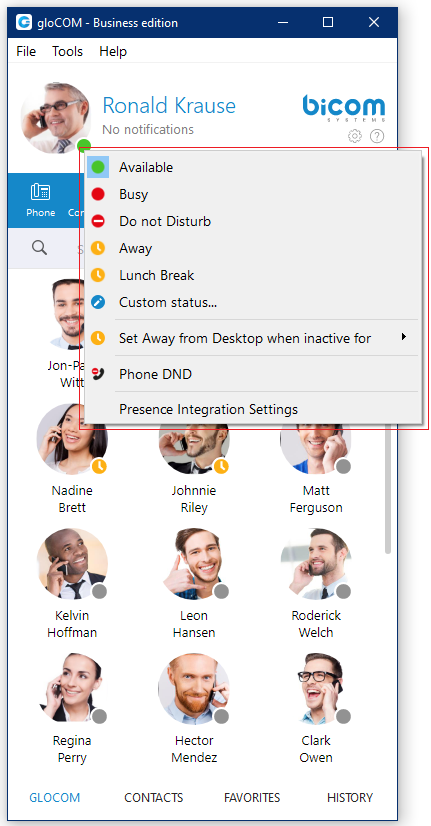
A menu will pop up and you can choose between:
- Available
- Busy
- Do not disturb
- Away
- Any of the statuses defined by the PBXware administrator
- Custom status
PBXware administrator can add statuses through PBXware GUI and those will appear as an option in the menu for all users. For example, an administrator could add Lunch Break status so users can easily inform others when they are using their lunch break and are not at their desk.
Also, you can set your own custom status, and write any message to describe your current availability. For example, if you have to attend a meeting, and you are not available to respond to calls or messages, you could choose Custom status… from the menu, select Busy from the dropdown, and type In a meeting as a message. This informs all other users that you are busy and the reason for that is you’re currently attending a meeting. This allows all users to have a better understanding of each others availability since each user can type a custom message to describe their current availability.
After you choose any of the statuses, you also have to specify status expiration. This allows you to let the application revert your status back to Available after a certain period of time. Using the example mentioned above, you could set your status to Lunch Break with the expiration of 1 hour, so when you come back to the office you don’t have to remember to change your status back to Available since the application will automatically do that for you.
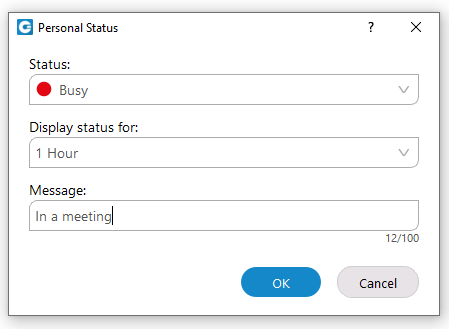
When setting status expiration you can choose between:
- Today
- 1 hour
- 4 hours
- 8 hours
- 12 hours
- 2 days
- 5 days
- This week
- Always
¶ Do not Disturb status
Setting your status to Do not Disturb (including custom Do not Disturb statuses) disables chat notifications, conference join notifications, and notifications informing you that someone has come online via Desktop. This allows you to easily remove distractions during an important period of the day when you need to fully concentrate on the task at hand. Note that this overrides the settings in the Alert section inside of the Preferences window.
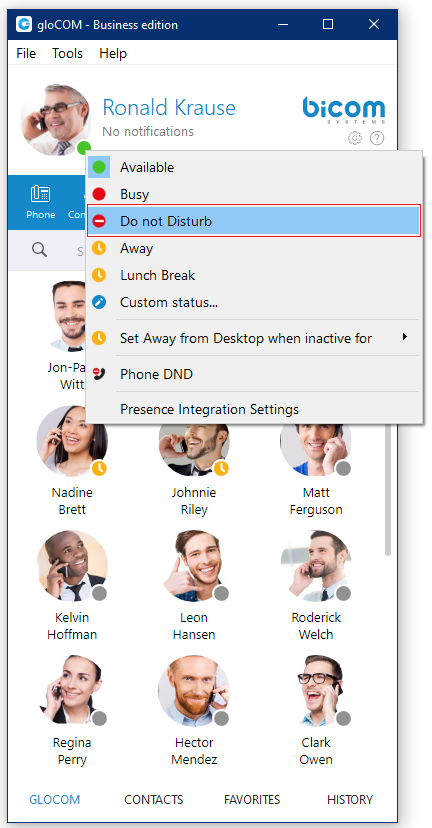
¶ Away from Desktop
When there is no user activity on your computer for a certain period of time gloCOM can inform other users that you are away from your desk. This can be configured by clicking on the status icon next to your avatar in the main window, hovering over the Set away from Desktop when inactive for item and choosing the desired option.
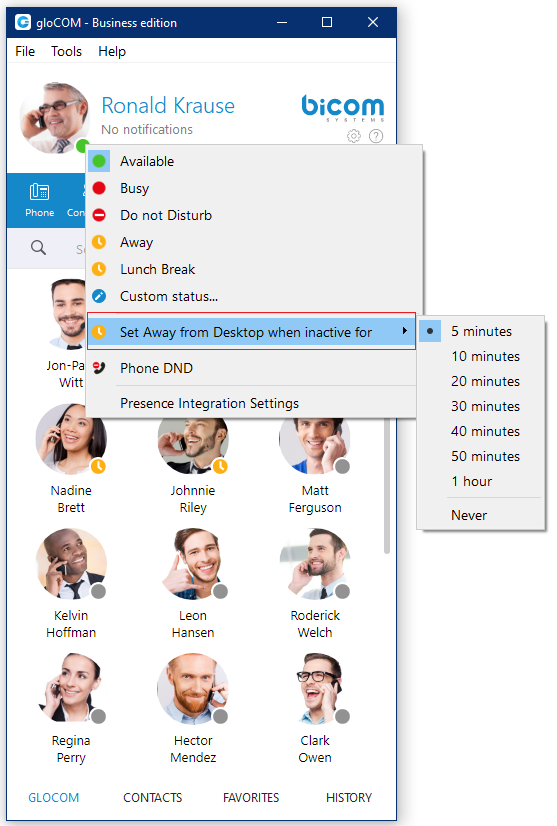
¶ Voicemail
- Select a Voicemail message and click
 to delete it. Please note, voicemail delete is permanent.
to delete it. Please note, voicemail delete is permanent. - Click
 to move the selected voicemail message to the old messages directory.
to move the selected voicemail message to the old messages directory. - Click
 to place a call to a contact who left a voicemail message.
to place a call to a contact who left a voicemail message. - Click
 to save a voicemail file to the disk.
to save a voicemail file to the disk. - Click
 to play the selected voicemail message.
to play the selected voicemail message. - Click
 tab to show new voicemail messages.
tab to show new voicemail messages. - Click
 tab to show old voicemail messages.
tab to show old voicemail messages.
While playing voicemail messages, the waveform shows up for the selected voicemail. It is possible to go back and forth through selected voicemail by clicking on the waveform.
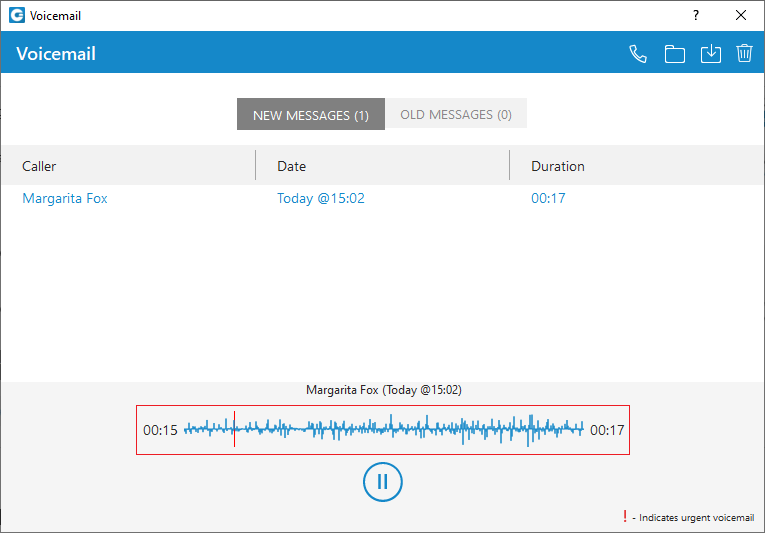
The Extension name and number will be shown within the voicemail window for the internal voicemails. Otherwise, only the number will be shown.
¶ Agent Panel (available in gloCOM Agent edition)
¶ gloCOM Agent Edition

The Agent edition offers a wide range of features that allow agents to provide exceptional customer service and manage their workload efficiently. However, in order to access these features, users must have the Contact Center edition enabled within their license.
By enabling the Contact Center edition, users will gain access to powerful tools such as conversation history, queue management, and real-time metrics that help agents make data-driven decisions. With these tools at their disposal, agents can streamline their workflows and provide better service to their customers, leading to increased customer satisfaction and loyalty.
Do not hesitate to contact Support for more information on enabling and purchasing the Contact Center edition.
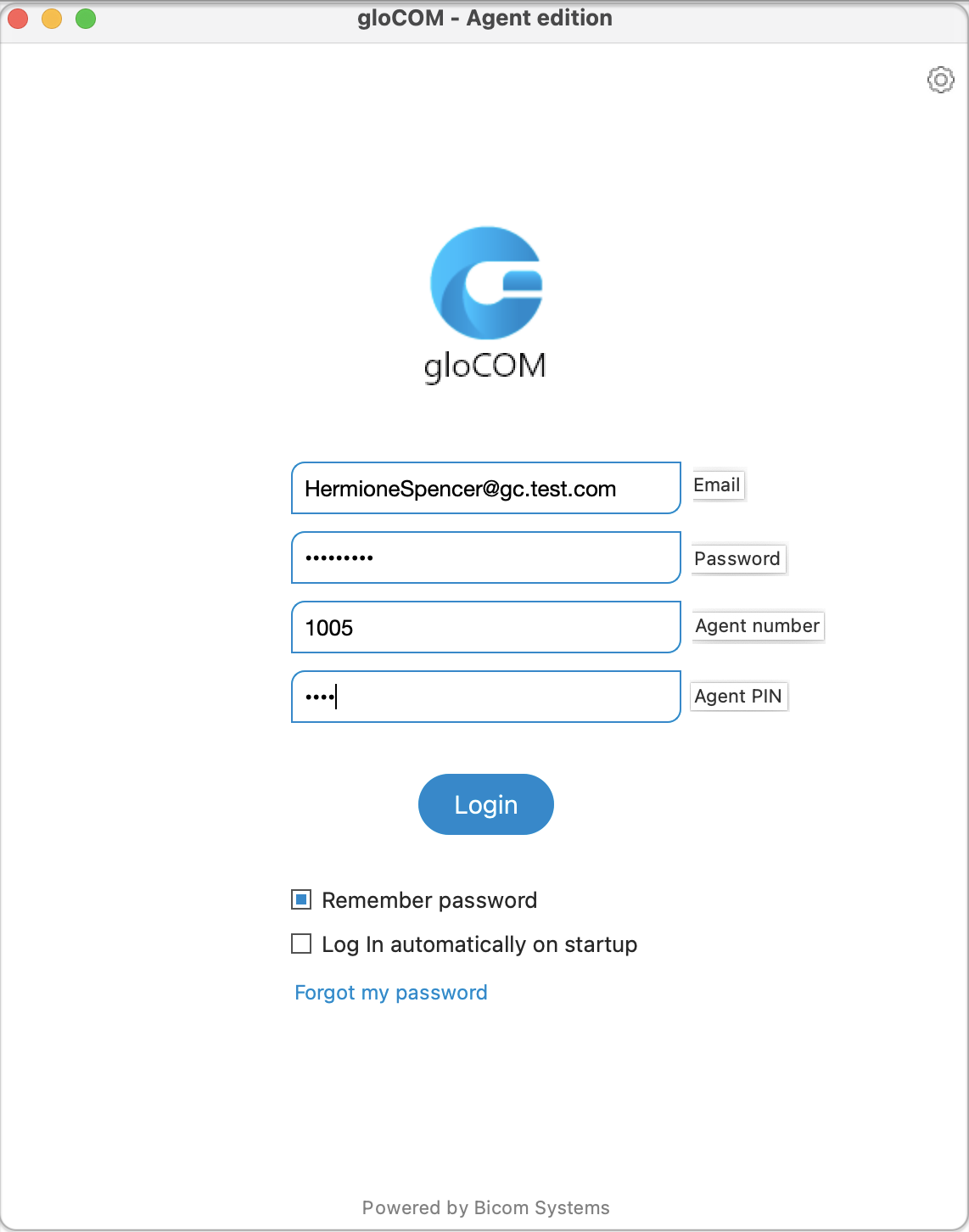
To use this application, users need to provide their login information, such as their Agent number, PIN, Email, and Password. Once agents log in, they can access a variety of features to manage their workload and handle customer interactions. They can use the app to manage conversations on multiple channels, track performance metrics, and access important information in real-time.
The user-friendly interface and useful functions of the gloCOM Agent Edition help agents work better and provide exceptional customer service. Overall, it's an important tool for any Contact Center looking to enhance their performance and keep their customers happy.
¶ Agent Login Window
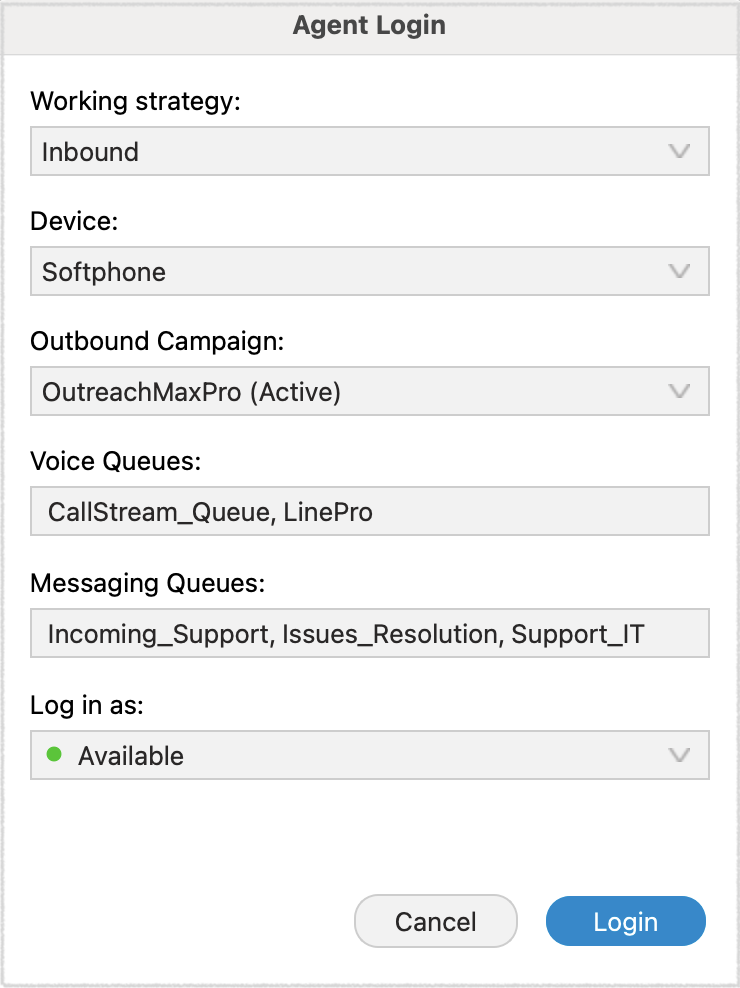
After entering the login credentials and clicking on the "Login" button, the Agent login window will appear, providing the following information:
- Working Strategy
- Device
- Outbound Campaign
- Voice Queues
- Messaging Queues
- Log In As
¶ Working Strategy
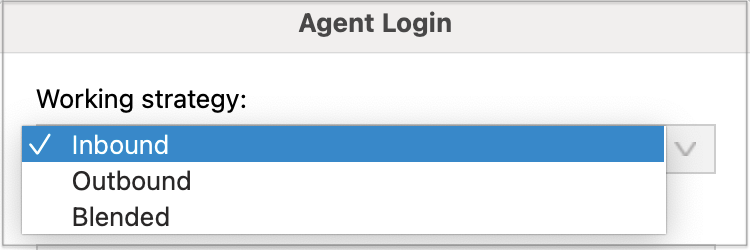
Agents have the flexibility to choose between three different agent strategies: outbound, inbound, and blended mode. Each strategy serves a specific purpose and can be tailored to your business needs.
Inbound Mode
Inbound mode enables agents to handle customer interactions by working exclusively within queues. This strategy is ideal when your focus is on addressing incoming calls or other forms of customer communication. Agents in inbound mode are dedicated to addressing customer queries, resolving issues, and providing support.
Outbound Mode
Outbound mode is designed for proactive customer outreach. Agents working in this mode focus solely on outbound campaigns, making calls to customers to initiate contact, provide information, conduct surveys, or offer promotions. Outbound mode allows your team to engage with customers in a targeted manner, ensuring your message reaches the intended audience.
Blended Mode
Blended mode is a dynamic strategy that automatically adjusts agent assignments based on real-time call center conditions. In this mode, the system intelligently moves agents between inbound and outbound strategies to optimize their productivity. If the inbound queues are not busy, agents are switched to outbound mode to maximize their utilization. Conversely, when there are customers waiting in the queue, agents are moved from outbound to inbound strategy to ensure prompt customer service. Blended mode strikes a balance between inbound and outbound activities, enhancing overall efficiency.
¶ Device
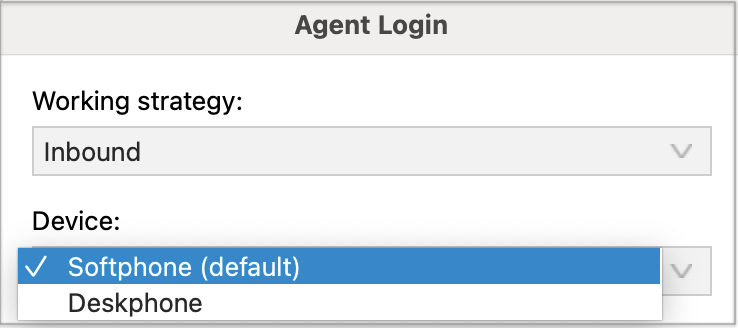
When it comes to choosing a device for dialing and receiving calls, agents have two options available:
Deskphone
Deskphones are traditional devices designed specifically for voice communication. They typically offer a handset, a dial pad, and programmable buttons for various functions.
Softphone Softphones are software applications that enable you to make and receive calls using a computer or mobile device. They use Voice over Internet Protocol (VoIP) technology to transmit voice signals over the internet.
¶ Outbound Campaign
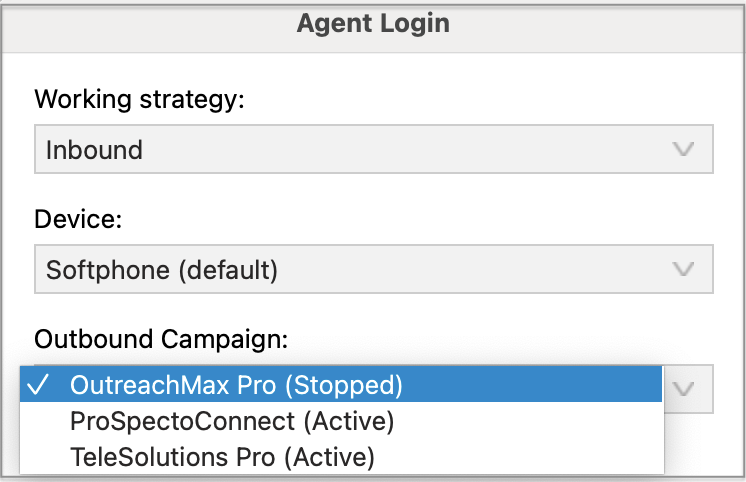
During an agent's login session, they are assigned to a specific campaign in which they will operate. While an agent can be associated with multiple campaigns, they can only work within a single campaign during a login session.
¶ Voice Queues
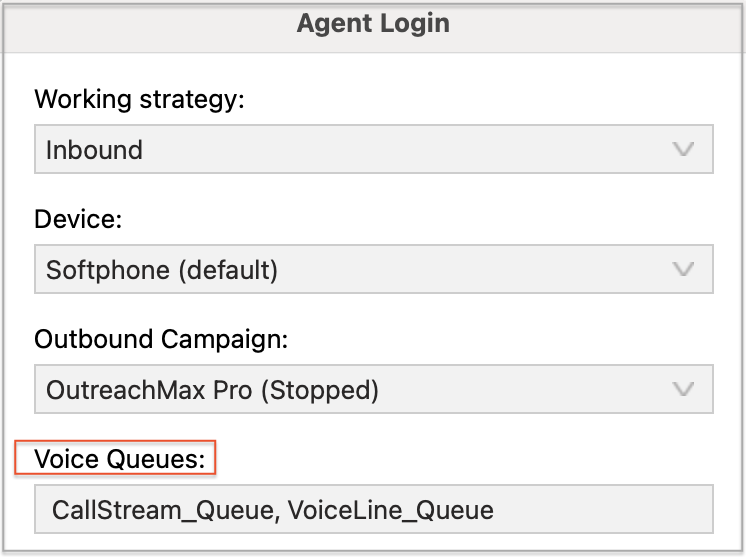
In this specific section, agents have the capability to view the voice queues to which they are presently assigned.
¶ Messaging Queues
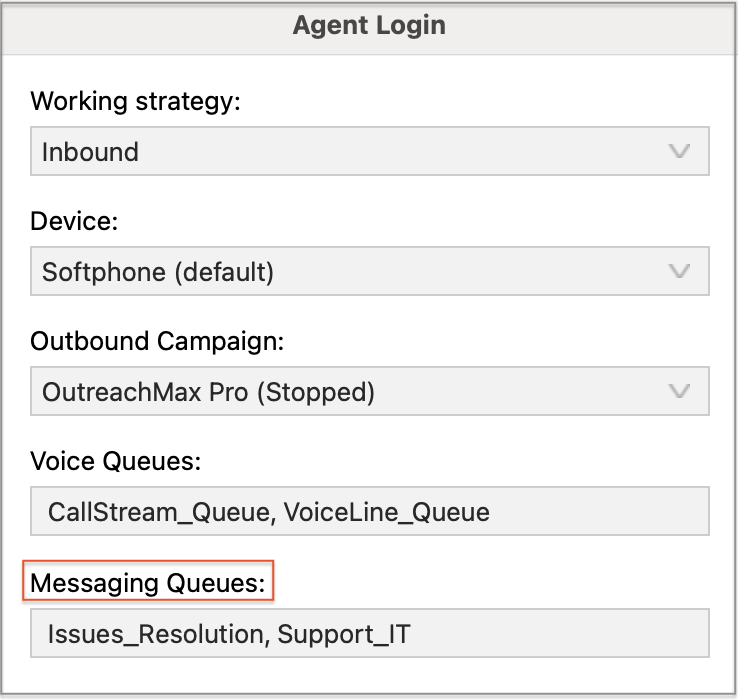
Within this section, agents have visibility into the messaging queues they are presently allocated.
¶ Log In As
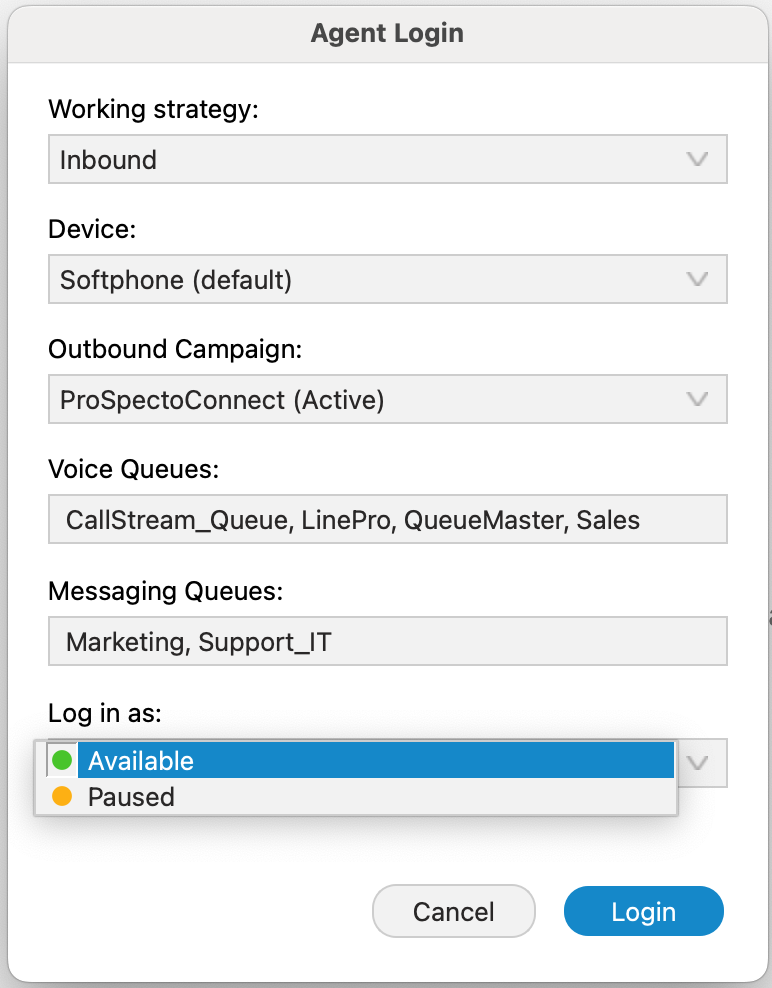
During an agent's login session, they have the flexibility to choose their login state as either Available or Paused. These states define the agent's availability to receive and handle incoming calls. Here's a brief explanation of each state:
- Available State
When an agent sets their login state to "Available," it means they are ready and willing to receive incoming calls. In this state, the agent is actively logged in and prepared to engage with customers or handle assigned tasks. - Paused State:
The "Paused" state allows agents to temporarily suspend call activities while remaining logged in. When an agent selects the "Paused" state, it indicates that they need a temporary break or interruption from taking calls.
When the desired options have been selected, the agent should click on the Login button in order to log in.
If an agent is not part of any voice or messaging queues and has no assigned campaigns, they cannot log into the app.
¶ Agent Panel
The Agent Panel is a valuable tool built to enhance customer service agents' efficiency by combining all essential features into a single, user-friendly window. It enables agents to handle multiple calls, feedback forms, CRM popups, and callbacks, collaborate with other agents, and manage queues effortlessly. This documentation provides a comprehensive overview of the Agent Panel's features and demonstrates how it simplifies multitasking for agents.
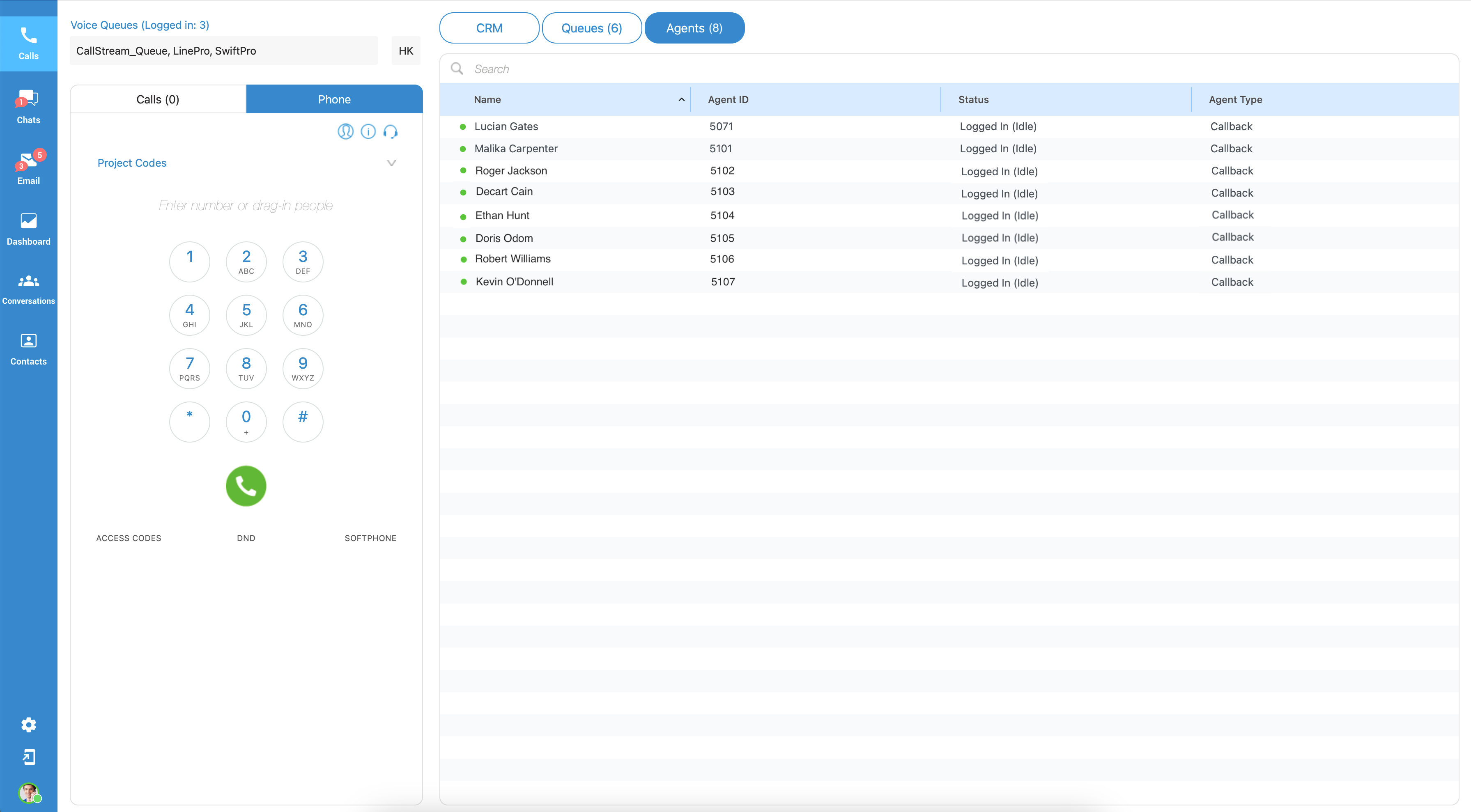
The Agent Panel offers a convenient solution by directly integrating the phone dialer, phone-related settings, and Omni-channel capabilities within its window. This design eliminates the need for agents to switch between multiple windows while placing calls or handling various communication channels. By having all the necessary tools in one centralized location, agents can experience a more streamlined and efficient workflow.
¶ Agent panel - Navbar
The navigation bar of the Agent panel is divided into three main sections, each serving a different purpose.
![]() The first section of the navigation bar is dedicated to the Contact Center aspect related to Voice calls. It provides functionality and tools specifically designed for voice call management.
The first section of the navigation bar is dedicated to the Contact Center aspect related to Voice calls. It provides functionality and tools specifically designed for voice call management.
The second section of the navigation bar focuses on the messaging part of the Contact Center, known as OmniChannel. The elements within this section enable Agents to handle chats, emails, and other forms of messaging interactions. The following components are included:
![]() This feature allows Agents to engage in real-time conversations with customers through chat channels.
This feature allows Agents to engage in real-time conversations with customers through chat channels.
![]() It provides a reliable interface to handle email inquiries, compose responses, and manage email-based customer interactions.
It provides a reliable interface to handle email inquiries, compose responses, and manage email-based customer interactions.
![]() The dashboard component offers Agents an overview of their ongoing messaging activities. It provides key metrics, performance indicators, and real-time data related to chat and email interactions.
The dashboard component offers Agents an overview of their ongoing messaging activities. It provides key metrics, performance indicators, and real-time data related to chat and email interactions.
![]() This feature enables Agents to view and manage ongoing conversations, as well as closed conversations across multiple messaging channels.
This feature enables Agents to view and manage ongoing conversations, as well as closed conversations across multiple messaging channels.
![]() This feature serves as a central hub for managing contact information. Agents can add, edit, merge, and delete contacts, as well as access a customer's conversation history across multiple channels for improved customer service.
This feature serves as a central hub for managing contact information. Agents can add, edit, merge, and delete contacts, as well as access a customer's conversation history across multiple channels for improved customer service.
![]() The third section of the navigation bar empowers Agents to customize settings related to voice calls, application preferences, voice alerts, and personal profile configurations.
The third section of the navigation bar empowers Agents to customize settings related to voice calls, application preferences, voice alerts, and personal profile configurations.
Full utilization of Omnichannel and its features requires additional activation through a valid license.
¶ Voice Calls
¶ Calls
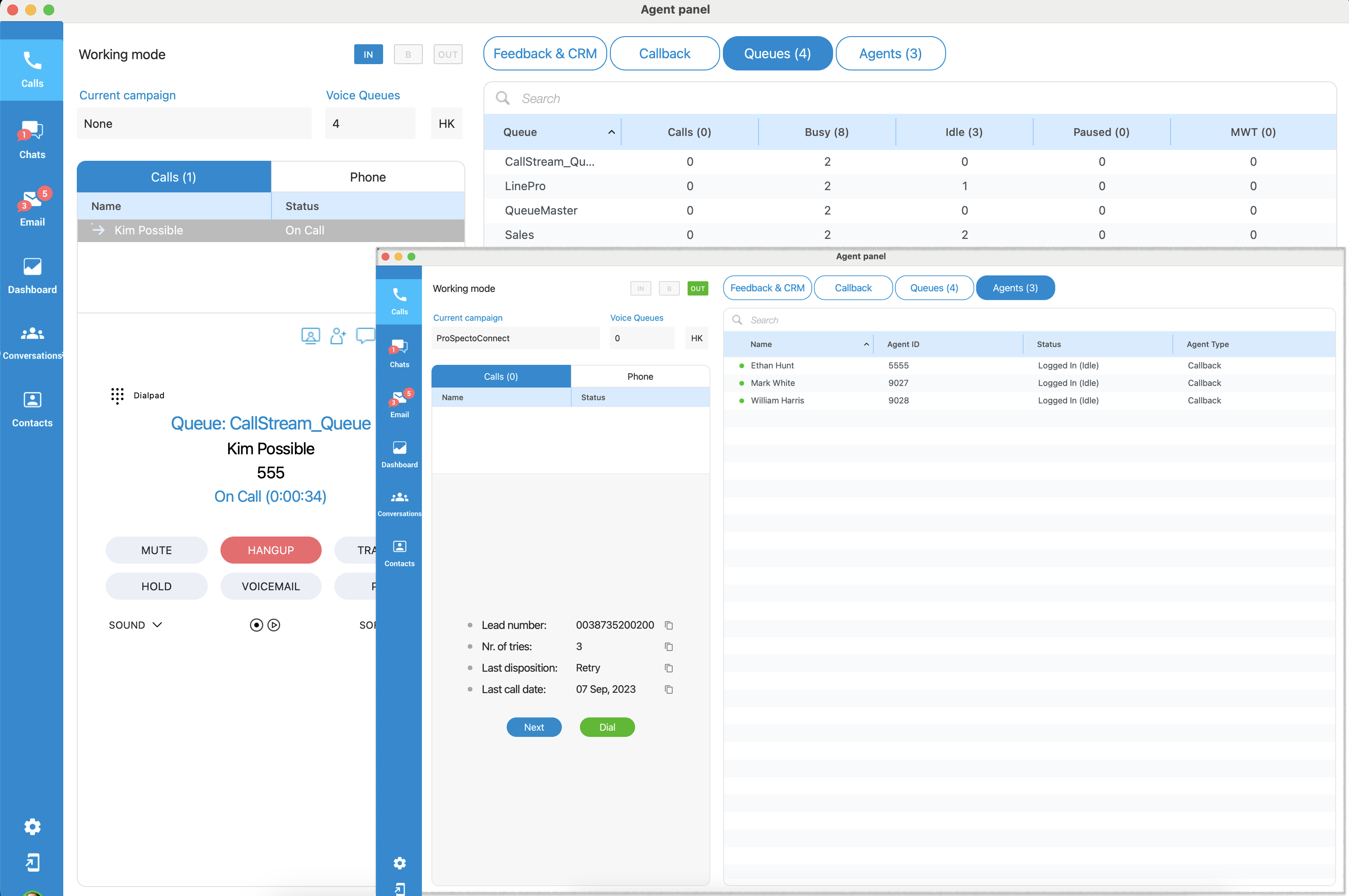
The Calls section of the navigation bar provides Agents with information and tools related to inbound and outbound calls in the Contact Center. It offers several functionalities that enable Agents to handle calls efficiently. Here's an overview of what users will find in this section:
¶ Working Mode

In a call center environment, agents have the flexibility to work in different strategies: inbound, outbound, or blended mode. To indicate the current strategy, direction buttons have been introduced. There are three types of direction buttons, . each representing a specific strategy. Here's a breakdown of the buttons and their corresponding strategies:
. each representing a specific strategy. Here's a breakdown of the buttons and their corresponding strategies:
When the  option is selected, it signifies that the agent is currently working in an inbound strategy. Inbound strategy involves handling incoming customer calls.
option is selected, it signifies that the agent is currently working in an inbound strategy. Inbound strategy involves handling incoming customer calls.
When the  option is selected, it indicates that the agent is working in an outbound strategy. Outbound strategy involves proactive customer outreach, where agents make outbound calls as part of campaigns.
option is selected, it indicates that the agent is working in an outbound strategy. Outbound strategy involves proactive customer outreach, where agents make outbound calls as part of campaigns.
When the  option is selected, it signifies that the agent is working in blended mode. Blended mode is a dynamic strategy that automatically transitions agents between inbound and outbound activities based on call center conditions.
option is selected, it signifies that the agent is working in blended mode. Blended mode is a dynamic strategy that automatically transitions agents between inbound and outbound activities based on call center conditions.
The Blended mode is based on the 'Minimum idle Agents per Queue" parameter, which can be found and updated on the PBX systems. The blended mode can be automatic or manual:
- Automatic mode - The system automatically switches between Inbound and Outbound modes.
- Manual mode - The Agent can select a working strategy manually between the Inbound, Outbound, and Blended mode by clicking on a specific button.
On every change, direction buttons are updated, so that agent has an overview of operation mode in real-time.
Below the Working mode section, there are ''Current campaign'' and ''Queues'' labels:
 The Current Campaign label - displays the name of the campaign in which the agent is currently working during the login session. This information helps identify the specific campaign or project to which the agent is dedicated. In the outbound strategy scenario, where agents primarily engage in proactive customer outreach, the "Queues" label will display "0" since the focus is on campaign-driven activities rather than queue-based interactions.
The Current Campaign label - displays the name of the campaign in which the agent is currently working during the login session. This information helps identify the specific campaign or project to which the agent is dedicated. In the outbound strategy scenario, where agents primarily engage in proactive customer outreach, the "Queues" label will display "0" since the focus is on campaign-driven activities rather than queue-based interactions.
 The Queues label - indicates the number of queues in which the agent is actively working during the login session. In the case of an agent working in the inbound strategy, the "Current campaign" label will display "None" since inbound operations typically do not revolve around specific campaigns.
The Queues label - indicates the number of queues in which the agent is actively working during the login session. In the case of an agent working in the inbound strategy, the "Current campaign" label will display "None" since inbound operations typically do not revolve around specific campaigns.
 If an agent is removed from the campaign while they are actively online, a warning message will promptly appear within their interface under this label.
If an agent is removed from the campaign while they are actively online, a warning message will promptly appear within their interface under this label.
An Agent can not work in a Campaign and a Queue at the same time.
¶ HotKeys
This option refers to Keyboard  shortcuts that Agents use to select a particular Disposition faster. This feature can significantly improve Agent's performance. When using Hot Keys, Agents do not have to use the interface.
shortcuts that Agents use to select a particular Disposition faster. This feature can significantly improve Agent's performance. When using Hot Keys, Agents do not have to use the interface.
Hovering over the HK button, the Agent gets the list of dispositions and their keyboard shortcuts for the current Campaign/Queue.
the Agent gets the list of dispositions and their keyboard shortcuts for the current Campaign/Queue.
Dispositions can be configured on the system and displayed within the App in the area next to the HK button.
Hotkeys are used only if users have active Dialer/Queue calls that are answered or completed. In all other cases, nothing happens.
¶ Agent Session State
![]()
If an error occurs during the Agent login session, the following message will be displayed within the Agent Panel window:
The user may click on the label above to get more detailed information about the error.
The error message can be displayed in several cases:
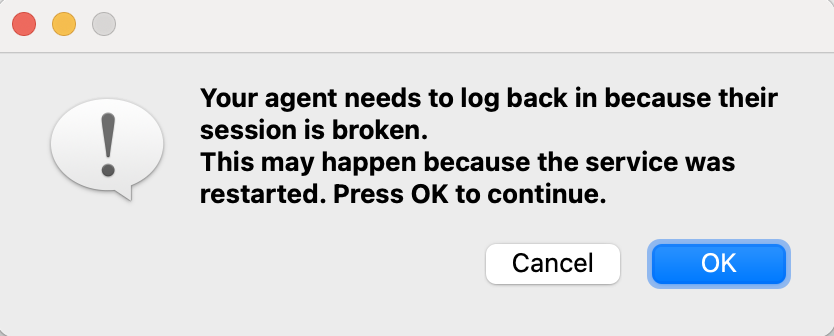
- Your agent needs to log back in because their session is broken. You are not logged into any queue nor campaign. This may happen because the service was restarted.
- Your agent needs to log back in because their session is broken. This may happen because the service was restarted.
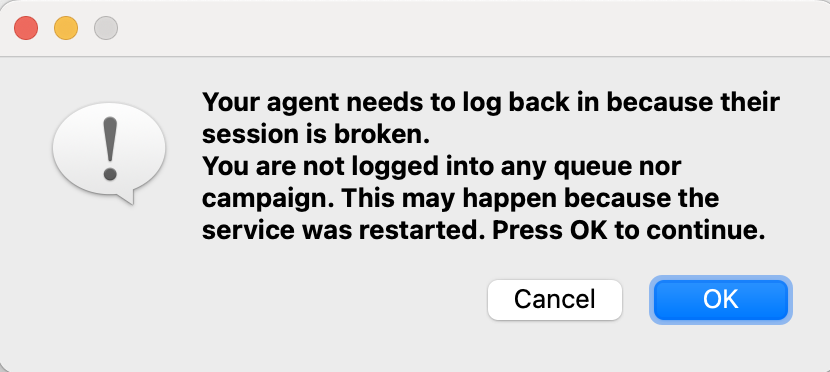
To solve this error, the user must re-login or click the 'OK' button. (The app restarts automatically).
¶ Call Centre Status
If an error occurs with the Call Centre connection status, the error message will be displayed within the ''Agent Panel'' window:
Also, the user will be notified if the license limit for the Dialer module is reached:
¶ Call handling
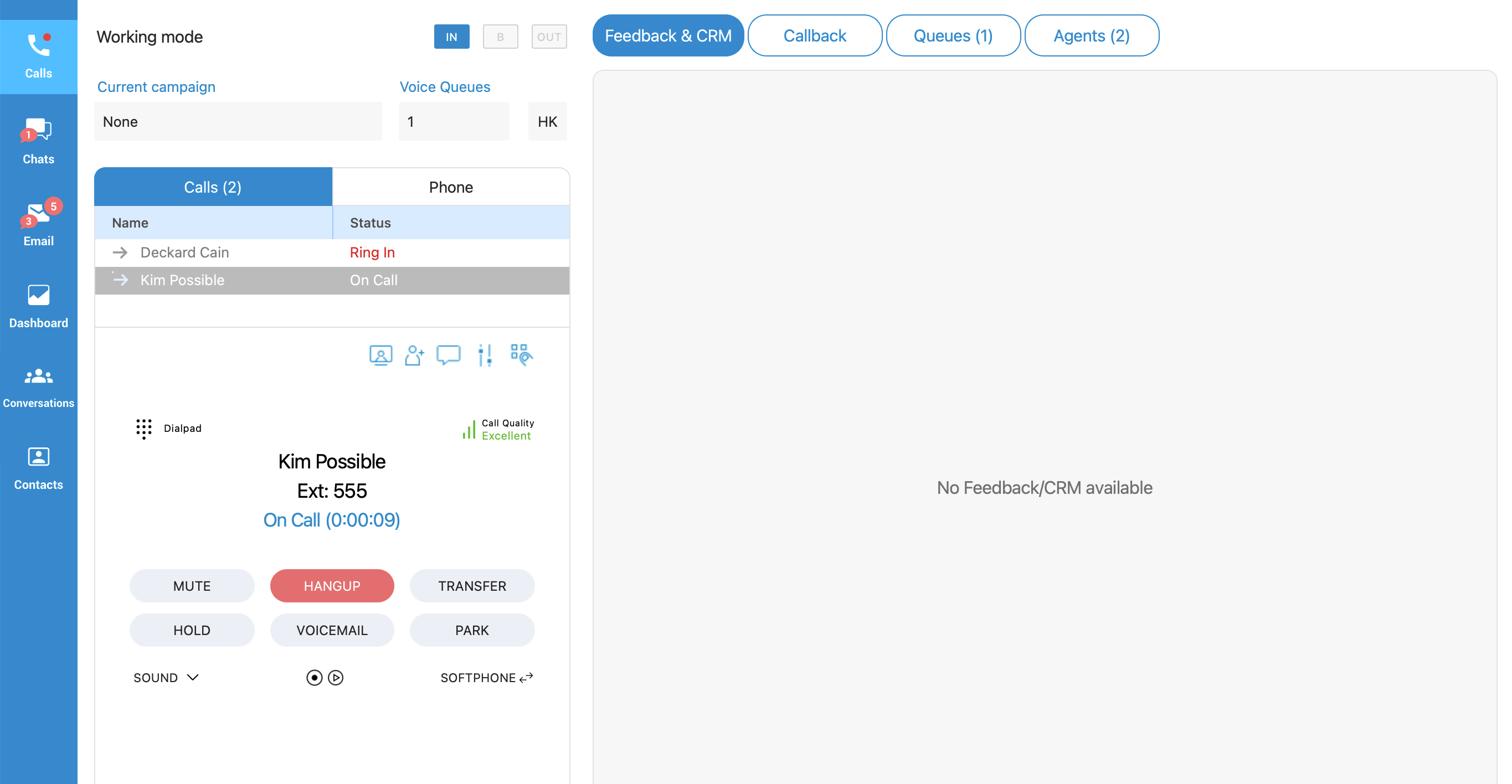
The Calls section displays current calls and allows Agents to handle multiple calls easily.
The list shows the call direction (inbound![]() or outbound
or outbound ![]() ), the name or number of the contact, and the call status (''Ring In, On-call, On Hold''). Switching between calls is possible by selecting the desired call.
), the name or number of the contact, and the call status (''Ring In, On-call, On Hold''). Switching between calls is possible by selecting the desired call.
Below Calls, the ''Call widget'' section displays information about calls, and Agents can use it to handle calls.
¶ Advanced Call Handling
¶ Dialer Calls (Outbound Call Center)
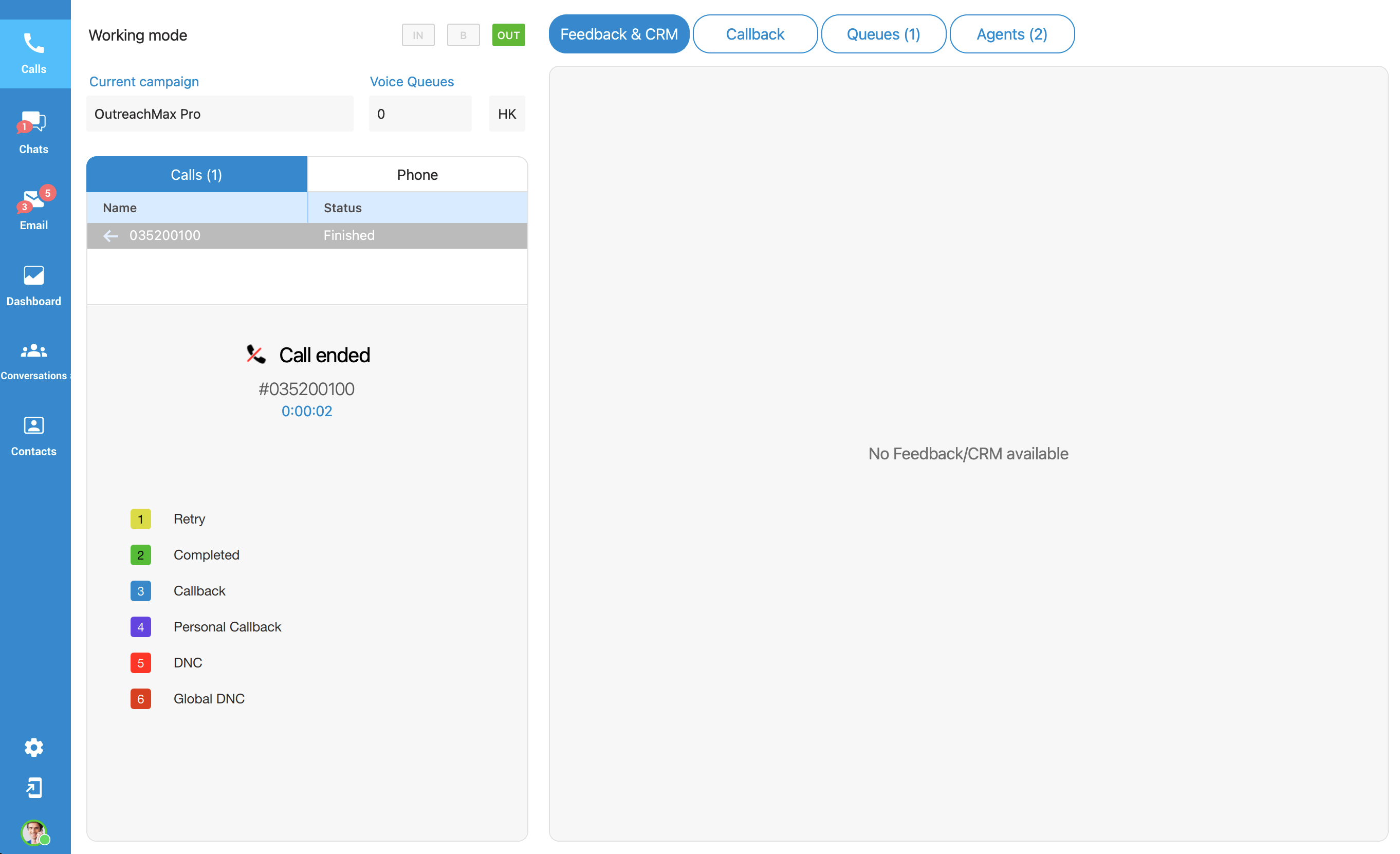
Handling dialer calls are slightly different from regular calls, where each call may belong to a specific campaign.
The campaign has four different strategies:
- Power strategy
- Preview strategy
- Progressive strategy
- Voice Messaging
Each campaign has the capability to define specific options that agents should submit after a call. These options, known as dispositions, allow agents to categorize and provide information about the outcome or status of each call. Additionally, PBXware enables the configuration of feedback forms that are associated with individual campaigns. To configure and manage dispositions and feedback forms, adjustments need to be made within PBXware system.
Please note that the application interface changes depending on the strategy. Also, each campaign has various options (Dispositions, Feedback Forms) that Agents could submit.
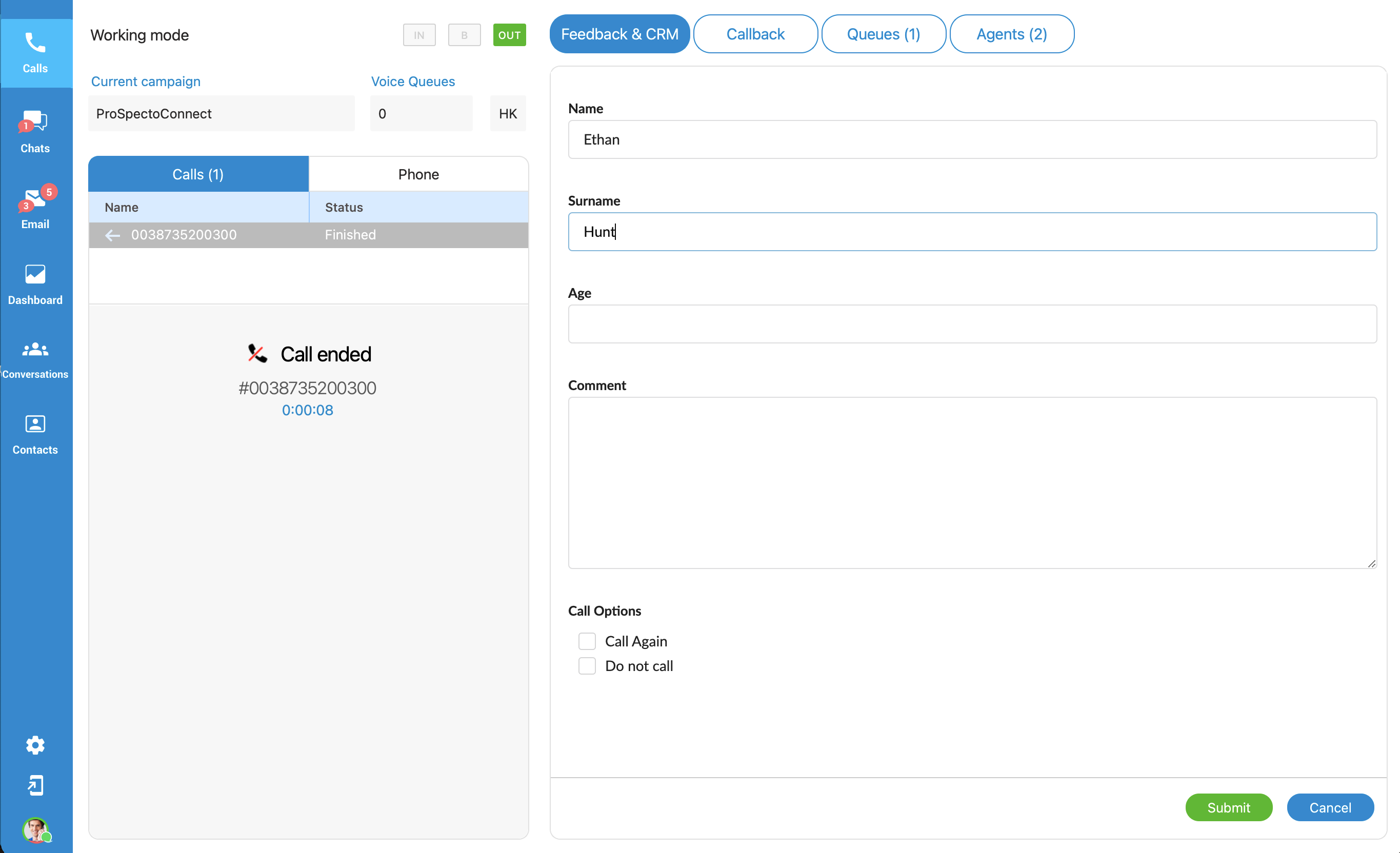
Unlike regular calls, the dialer call is considered completed when both dispositions and feedback form have been submitted (if enabled), and only then the call is removed from the calls list. If enabled, dispositions are displayed when the audio call is finished and remain visible until the user submits a disposition. On the other hand, if enabled, the feedback form is always visible, until it is submitted.
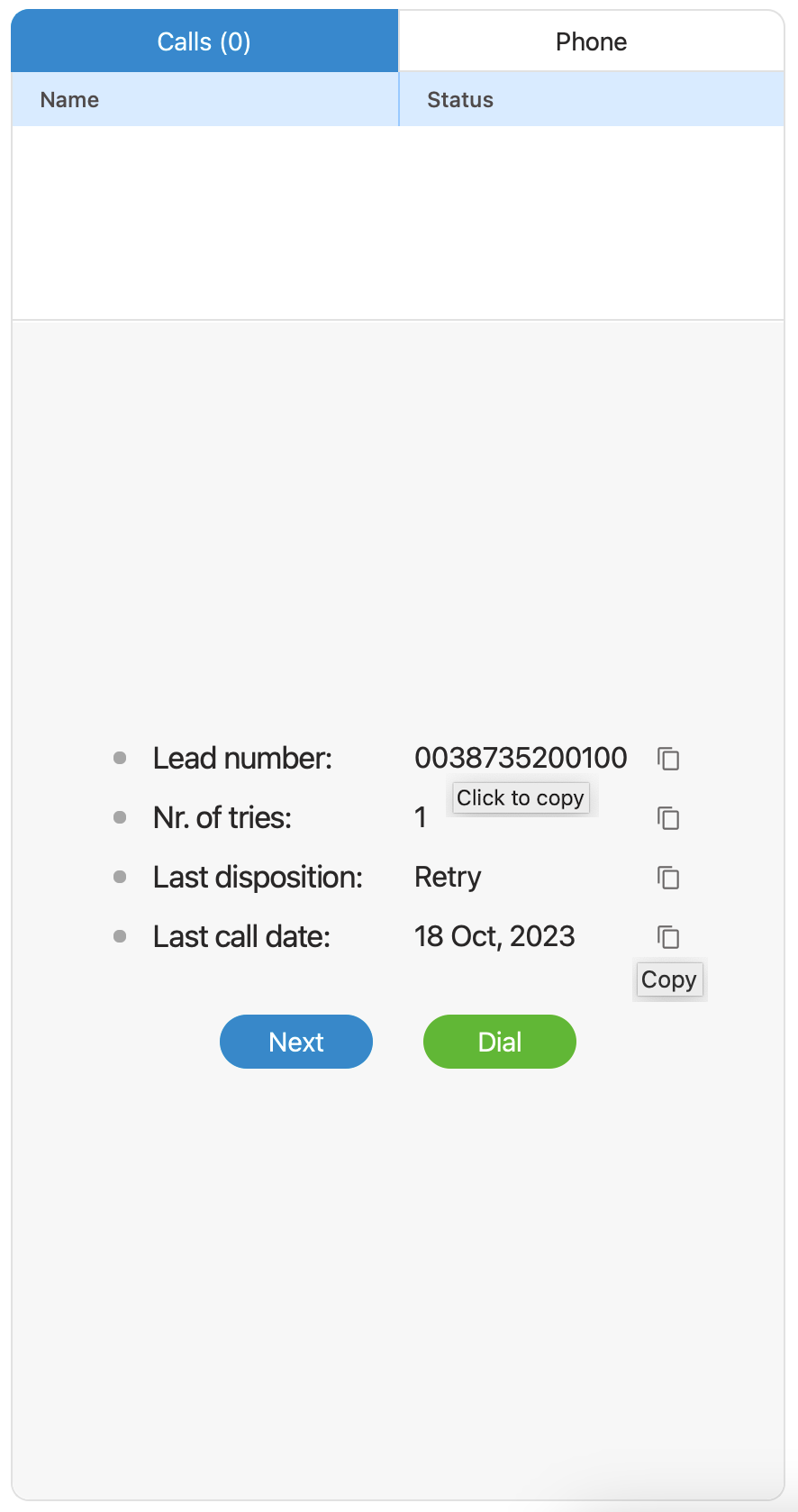 Agents can easily copy lead numbers or other information from the agent panel. They can do so by left-clicking on the field name to copy to the clipboard or by clicking the button next to the label for the same clipboard functionality.
Agents can easily copy lead numbers or other information from the agent panel. They can do so by left-clicking on the field name to copy to the clipboard or by clicking the button next to the label for the same clipboard functionality.
¶ Power strategy
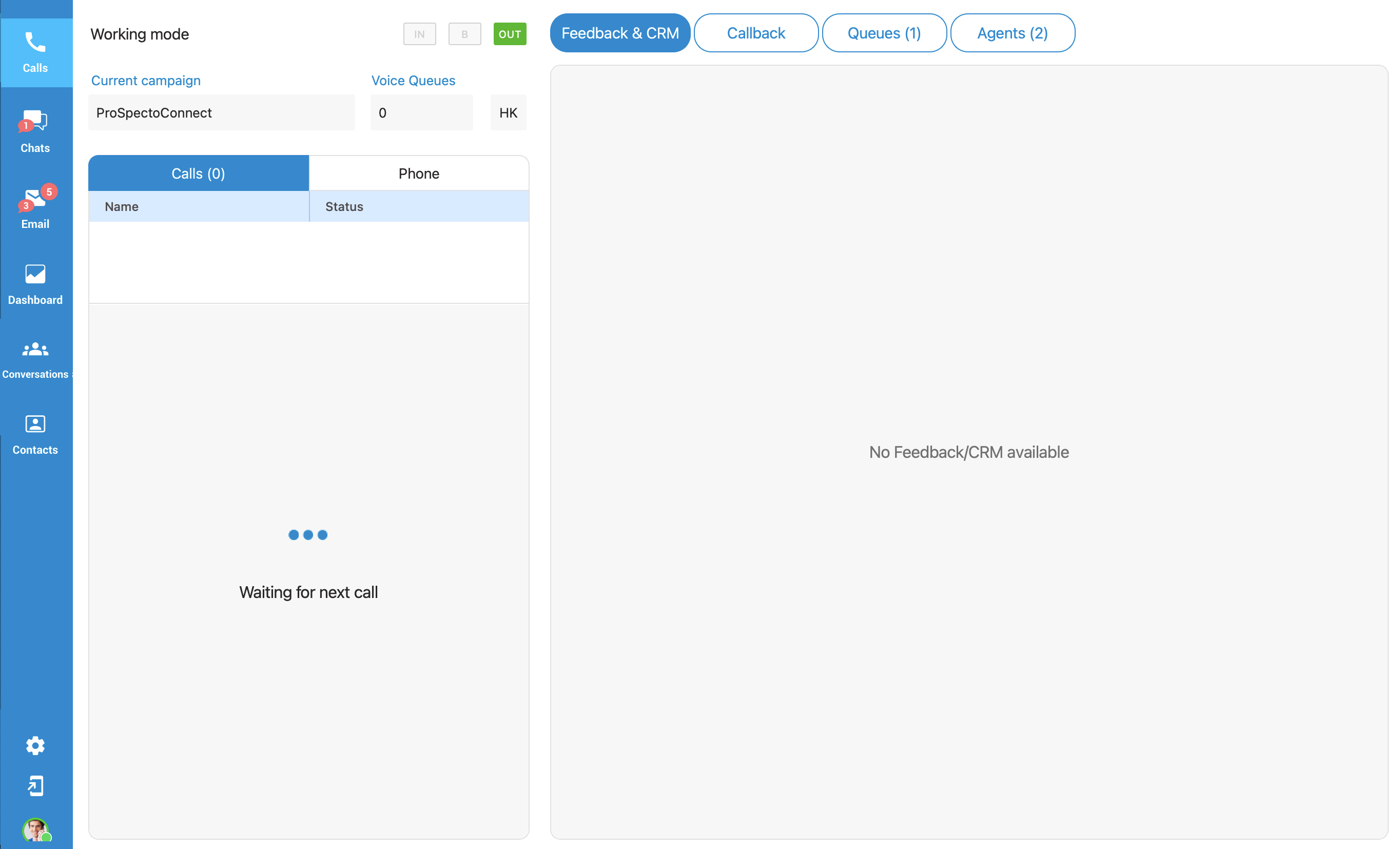
The Power strategy is a dialing method where multiple calls are automatically initiated for each available agent. It aims to maximize agent productivity by reducing idle time between calls.
When using the Power strategy, the campaign dials leads based on Idle Agents multiplied by the power number.
It works as follows:
• The campaign fetches leads based on power.
• The campaign dials leads for each Agent times number of power. (Number of power can be set on PBX system.)
• The Agents are placed in the pool.
• The Lead who answers first will be connected to one of the Agents, and others (leads) will be dropped.
¶ Preview strategy
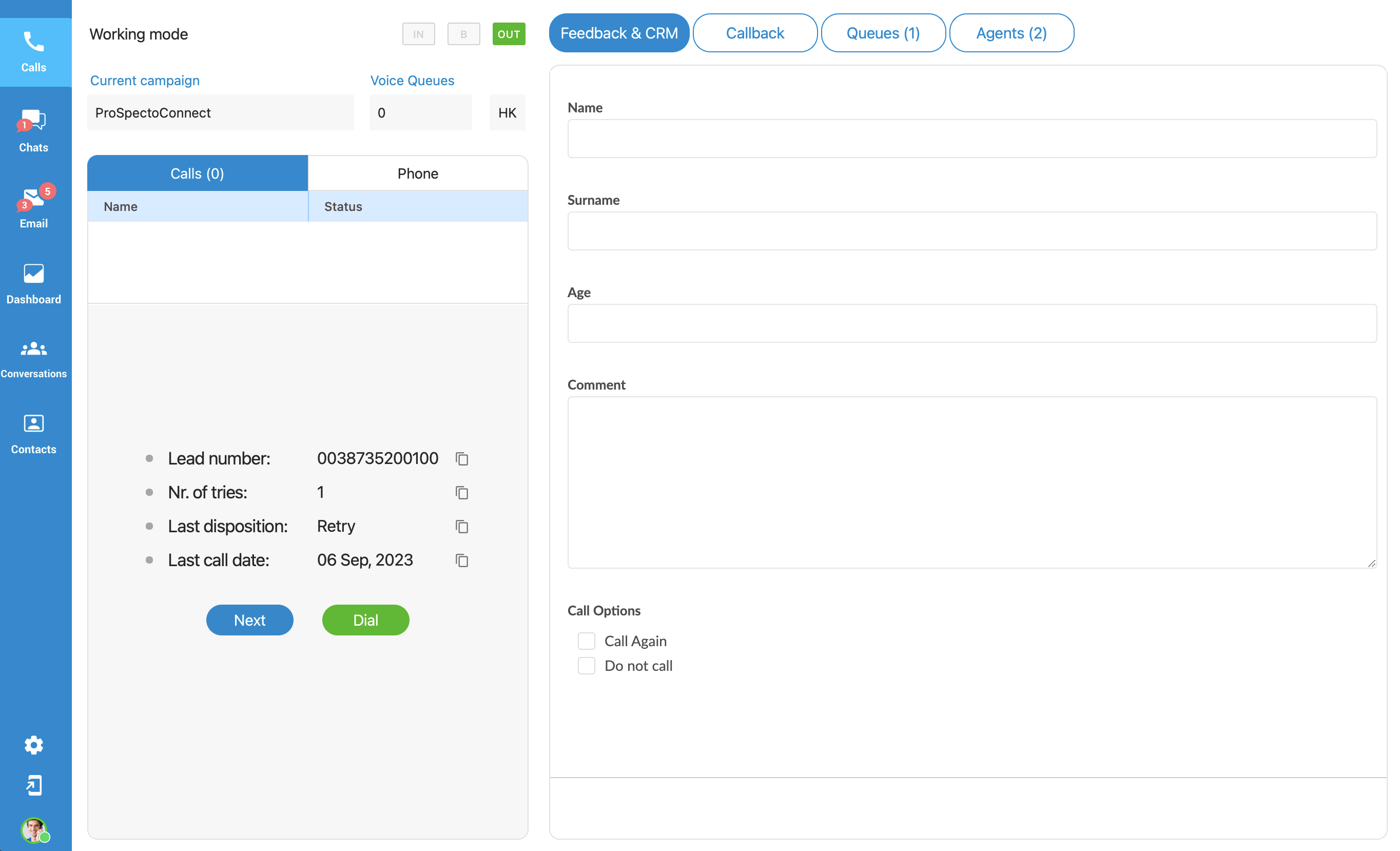
This strategy allows an Agent to have a preview of lead details so they can decide whether to dial the lead or not.
The Agent can fetch the next lead from the Campaigns list by clicking the ![]() button. If the Agent decides to call the lead, then they need to press the
button. If the Agent decides to call the lead, then they need to press the ![]() button.
button.
Feedback Form is displayed but cannot be edited until the call starts.
¶ Progressive strategy
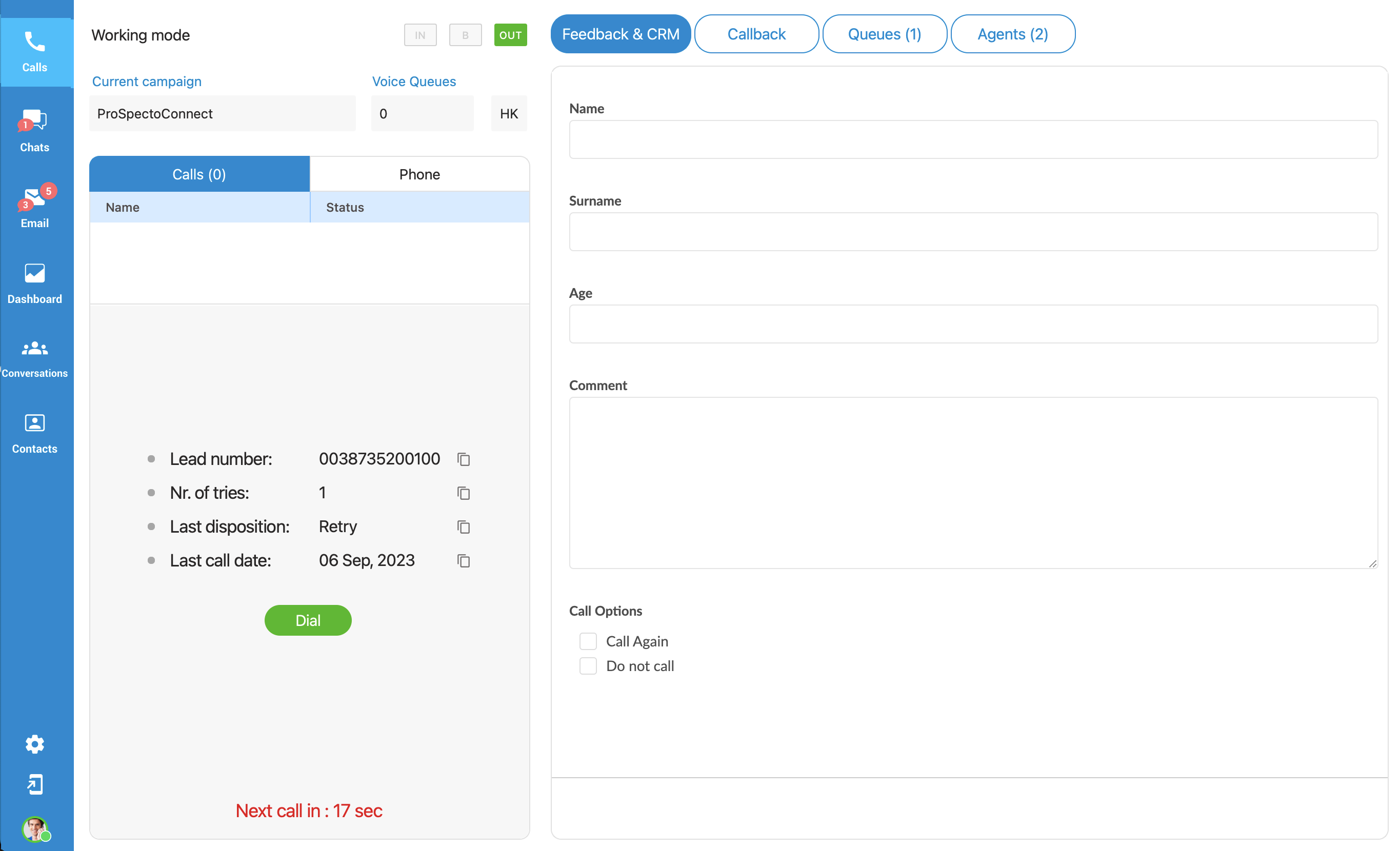
The Progressive strategy works the same as a preview. The only difference is the Agent has a timeout in which they must perform a dial, and there is no possibility to manually fetch the next lead.
If the Agent does not perform dial inside the desired time frame, the system will automatically dial the next lead.
There is an option in PBXware called ''Preview Timeout'' that indicates how long it will take before the system dials lead automatically. This information is shown below the ![]() button.
button.
¶ Enhanced Ring Groups Calls
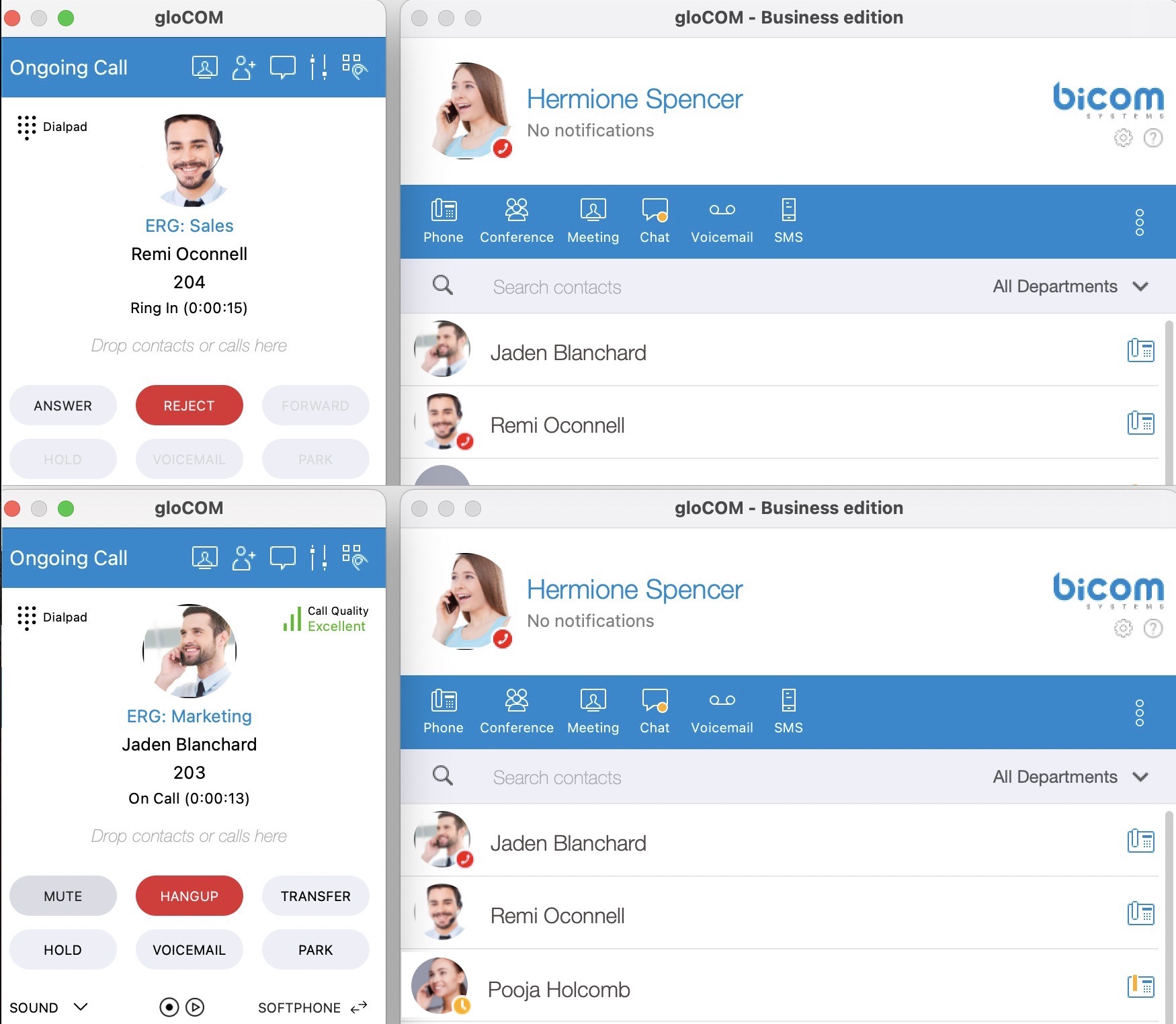
Calls from Enhanced Ring Groups are supported for the Business, Office, Agent, & Supervisor edition.
The user can see the name of the ERG that has been calling for all incoming calls.
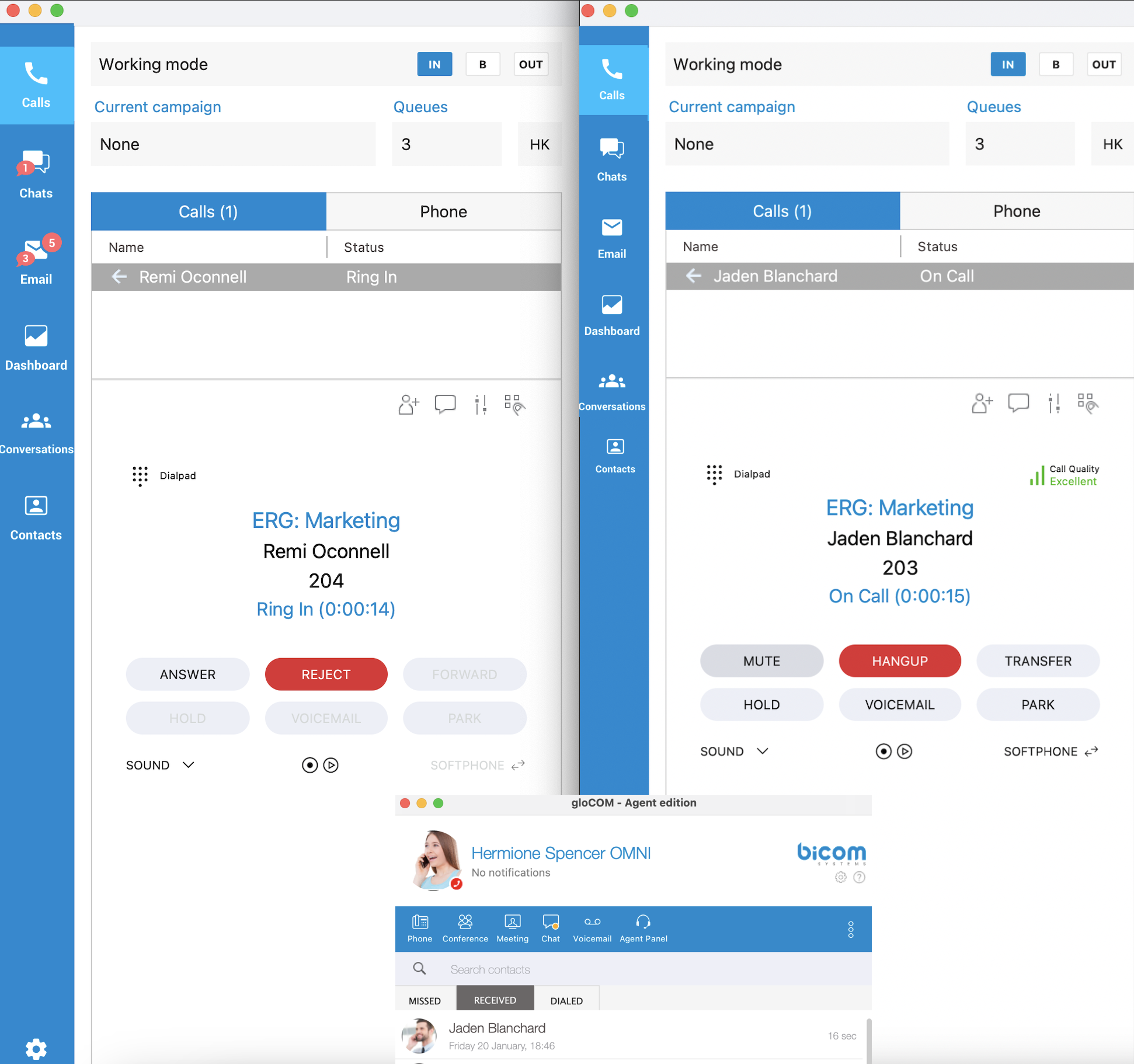
¶ Feedback Forms
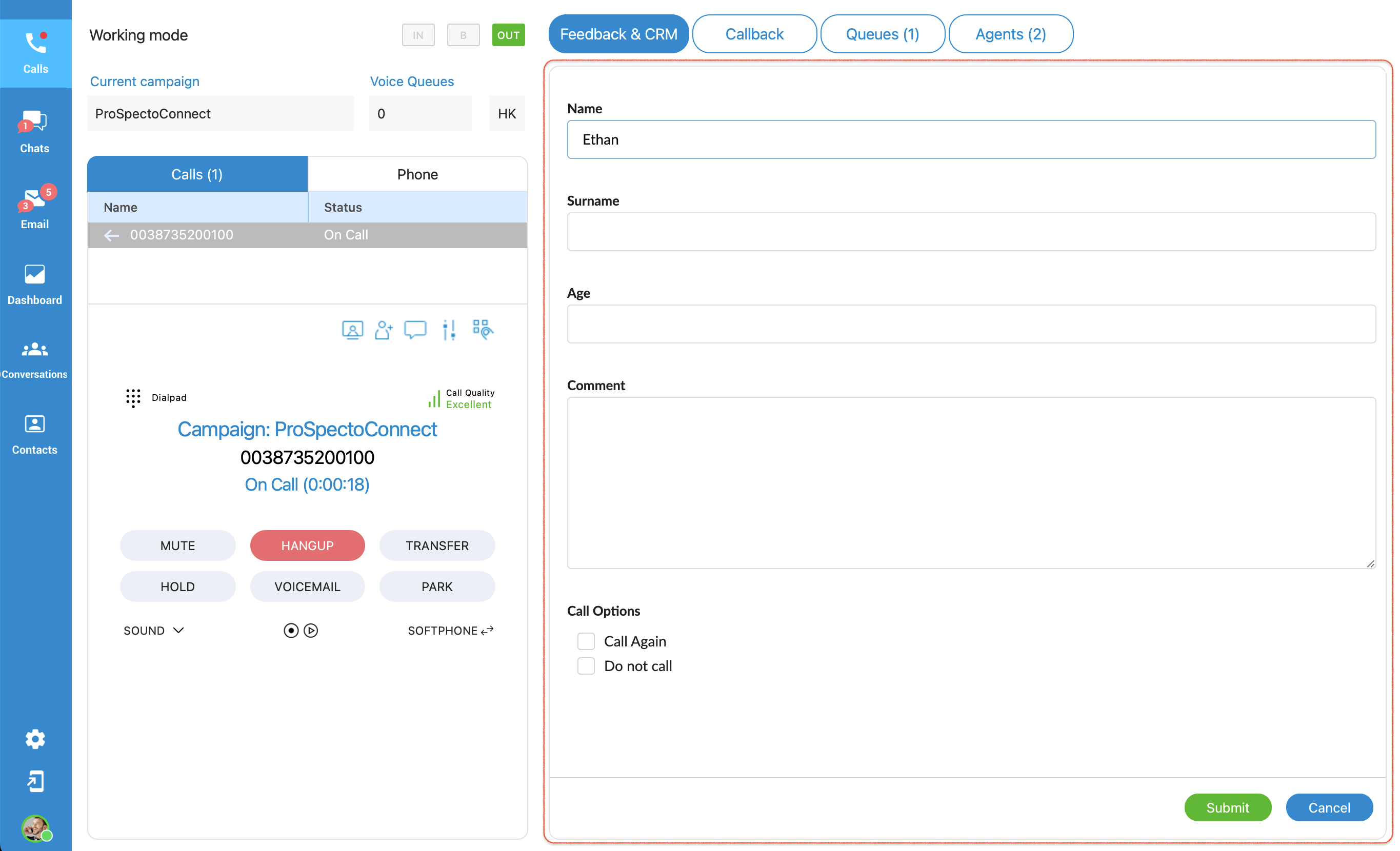
Agents can use Feedback forms to obtain customer feedback. The main goal is to understand better the overall customer experience, which can help improve products or services and even the fundamental understanding of the business users.
Feedback forms are used for Queues and Campaigns. They are displayed whenever there is a new call into the Queue or a new call from the Campaign. In order to show the Feedback form within the App, it has to be loaded on PBXware, and the option 'Send Feedback Forms' must be set to 'Yes'. Otherwise, a Feedback form is not available.
To edit the Feedback form, the user may click the  button that is placed on the bottom right side of ''Feedback widget''.
button that is placed on the bottom right side of ''Feedback widget''.
When editing is done, clicking the  button to send all data to the server.
button to send all data to the server.
If the user clicks the  button, all entered information will be lost, and the Feedback form will be closed.
button, all entered information will be lost, and the Feedback form will be closed.
In the Preview/Progressive strategy, a Feedback form is visible before the call is started, but in that case is possible only to read information, not to edit it. That helps an Agent to decide if they want to call that contact or go to the next one. The Feedback form stays visible even after the call is finished until the user submits or closes it.
If the call is rejected, the Feedback form will not be displayed.
¶ Screen Pop
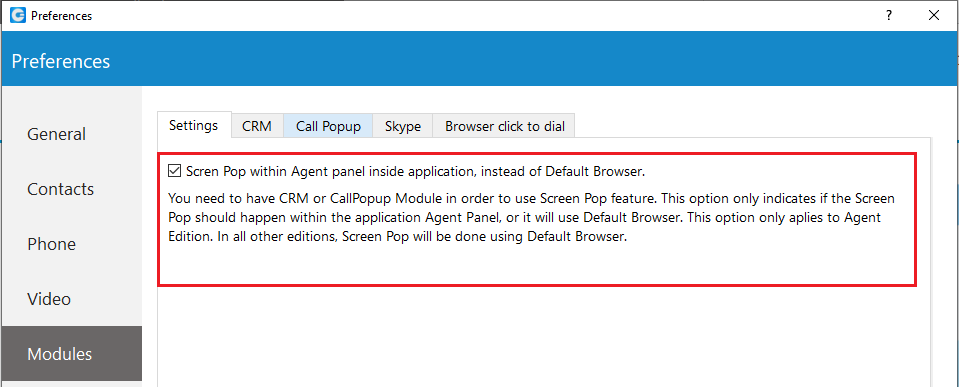
In order to use the CRM feature, the CallPopup module needs to be enabled.
Within settings (Preferences->Modules->Settings), the user must check the option ''Screen Pop within the Agent panel inside the application instead of Default Browser''.
If this feature is enabled, the Screen Pop will appear within the application inside the ''Agent Panel'' window; otherwise, it will use ''Default Browser''.
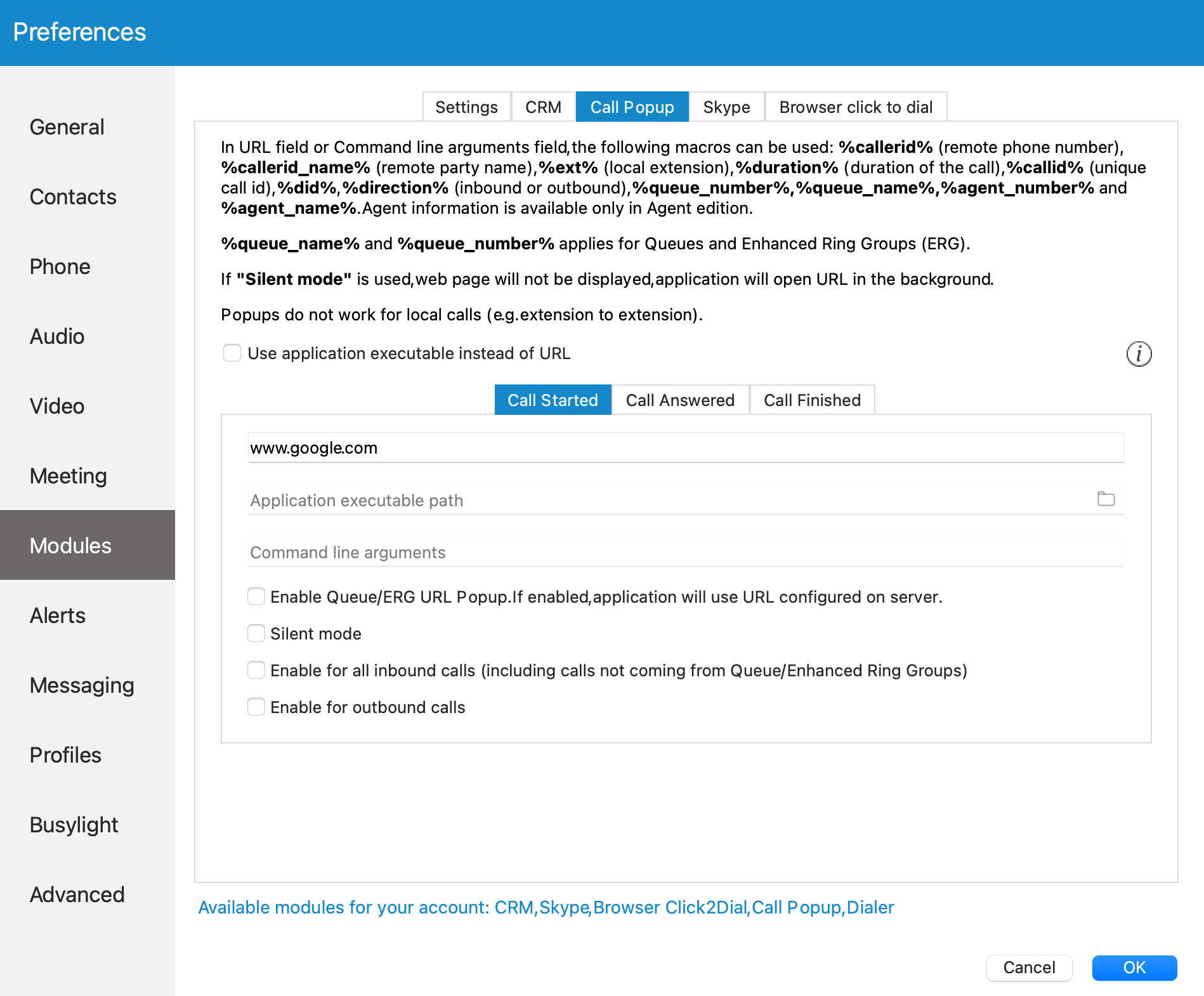
The system offers the capability to trigger a screen pop based on the URL configured for each specific Queue. This means that when an interaction, such as a call, is received within a particular Queue, the system can automatically open a designated web page or URL associated with that Queue.
However, it's important to note that this functionality is conditional upon a specific system setting. To enable this feature, you need to ensure that the option labeled ''Enable Queue/ERG URL Popup'' is selected. This setting can be found in the app preferences under the ''Modules'' section and specifically within the ''Call Popup'' tab.
When this option is checked or enabled, it signifies that the application will utilize the URL previously configured on the server to facilitate the screen pop behavior. In practical terms, this means that the designated web page or URL will open automatically when an interaction is initiated within the specified Queue.
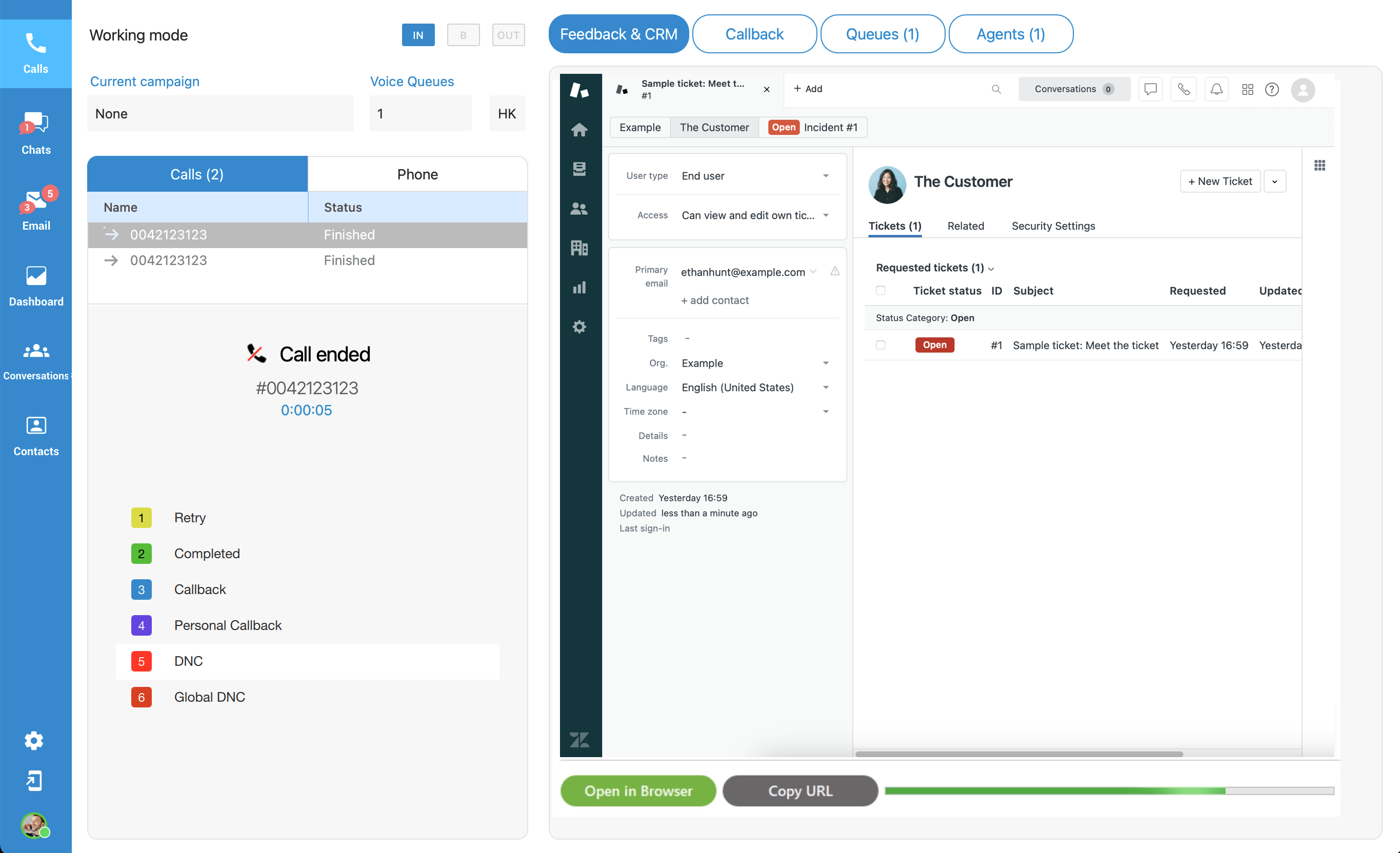 While loading the page, there is a progress bar that indicates that the page has not been fully loaded yet.
While loading the page, there is a progress bar that indicates that the page has not been fully loaded yet.
To stop the page loading click on the Stop button.
If the page fails to load, an icon Reload will appear, making it possible to reload the web page.
To the left of the reload icon, a warning icon Warning is placed, so the user can get more information about page status by hovering over the icon.
Also, two actions are possible:
 Opens the page in ''Default Browser''
Opens the page in ''Default Browser''
 Copies the URL of the page that is loading/loaded
Copies the URL of the page that is loading/loaded
¶ CRM Pop
The CRM module offers seamless integration with a range of CRM systems, including Salesforce, SugarCRM, Zoho, Microsoft Dynamics, Bullhorn, and Zendesk. It provides a host of valuable features, such as call popups and logging, automated contact synchronization, one-click dialing, robust search functionality, CDR (Call Detail Record) upload capabilities, and more.
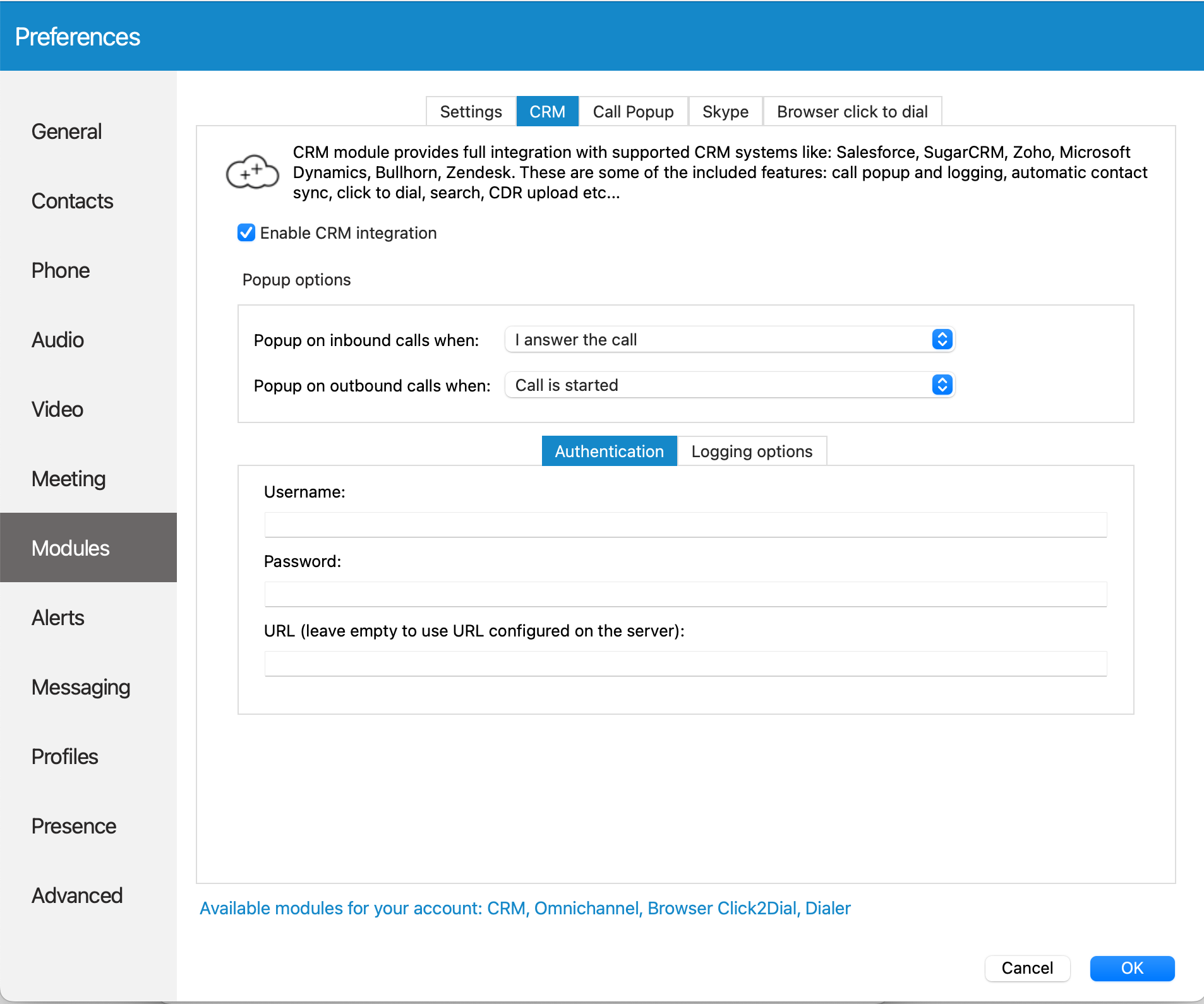
Underneath the CRM tab, there’s an option that enables the CRM Integration.
¶ Personal Callback
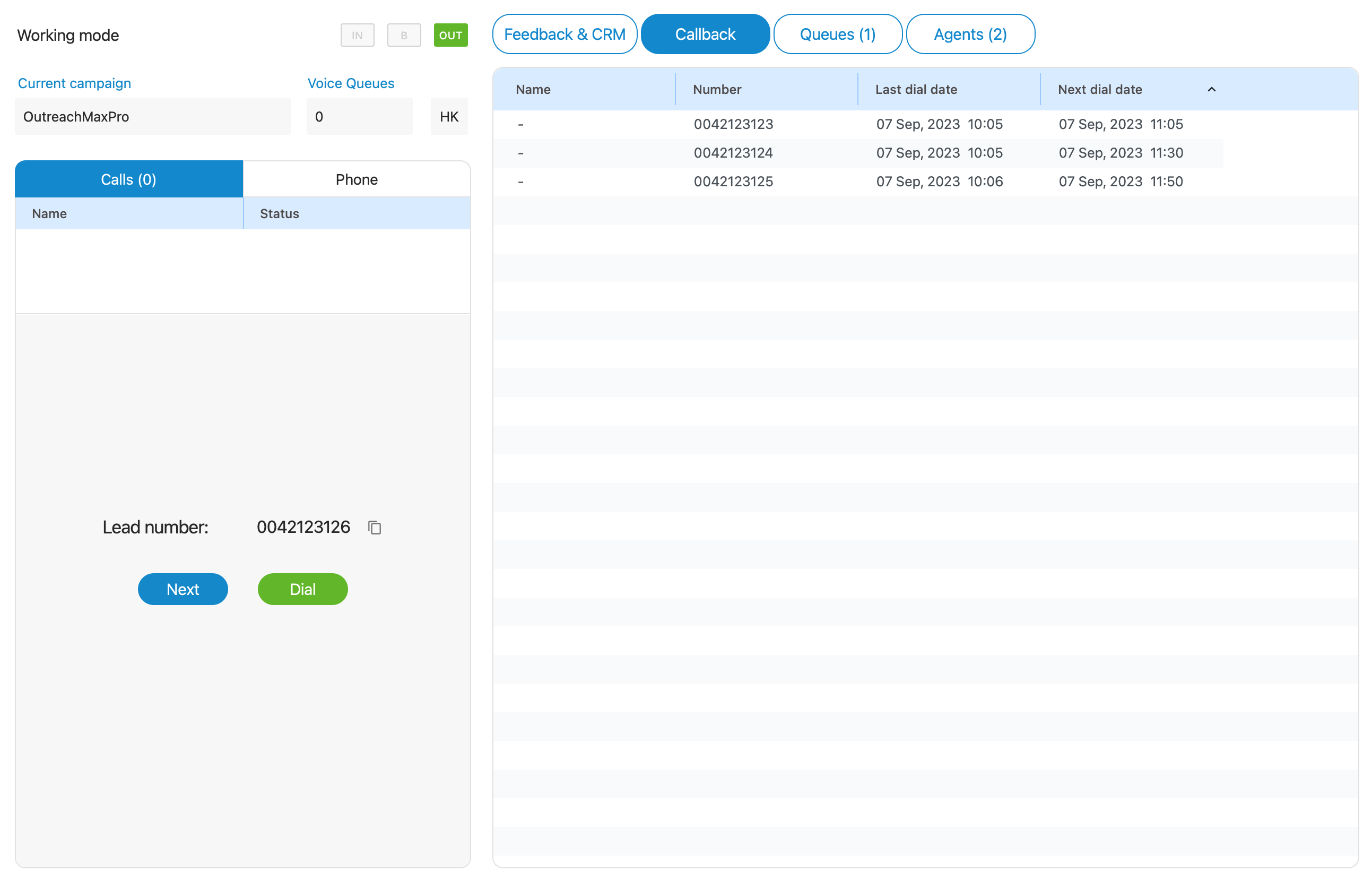
When Agents select the disposition of the Personal Callback type, the system will automatically create a list of all upcoming personal callbacks and place the list inside the Callback tab within the Agent panel.
A name, number, last dial date, and next dial date represent every personal callback.
The Agent may edit the personal callback list by simply right-clicking on it.
The additional options will be presented:
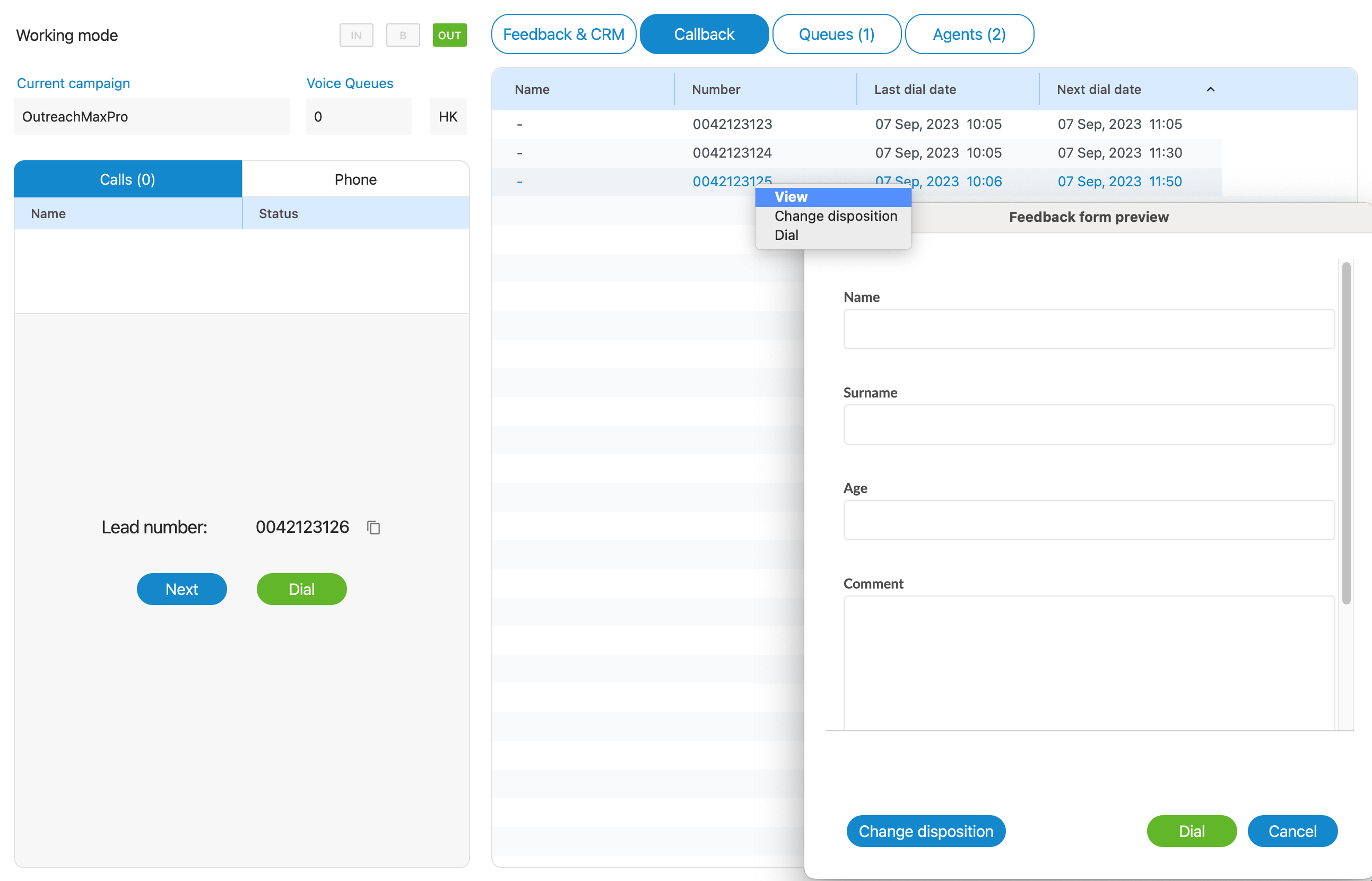
View - opens a new dialog with detailed information about the lead (Feedback form). From this dialog, it is also possible to dial callback and change the disposition of the callback.
This is a default option available with a double mouse click.
Change disposition - opens a new dialog where it is possible to change callback disposition
Dial - Dial callback
¶ Queues tab
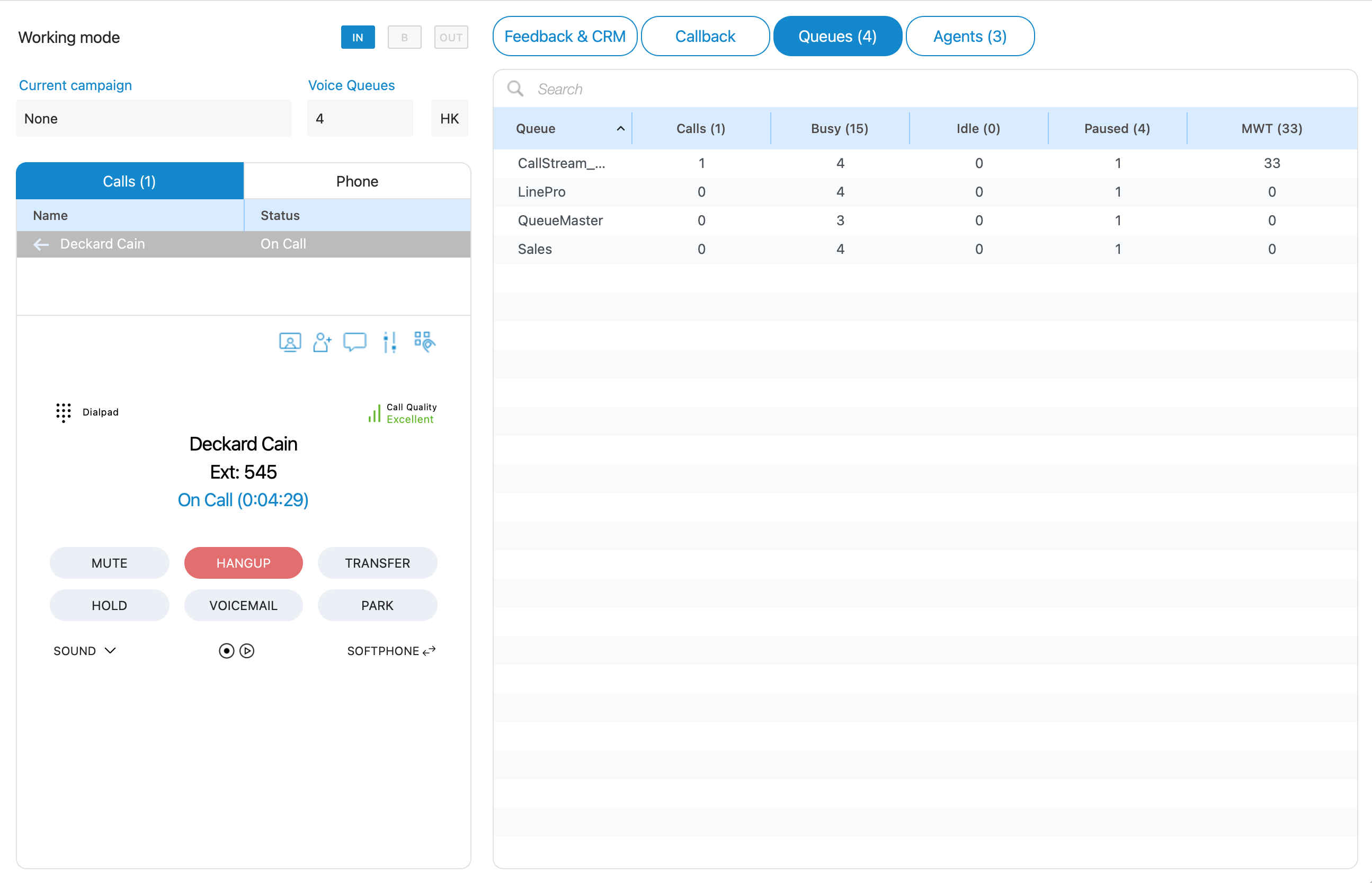
The Queues tab section allows Agents to search through all queues on the system by queue name or queue number.
The total number of queues and which Queue will be displayed within the Agent panel can be managed through Queues Settings (Agent Panel Settings->Voice Settings)
For each Queue, the following information is shown:
- Queue name
- Calls
- Busy
- Idle
- Paused
- MWT(MaxWaitTime)
¶ Agents tab
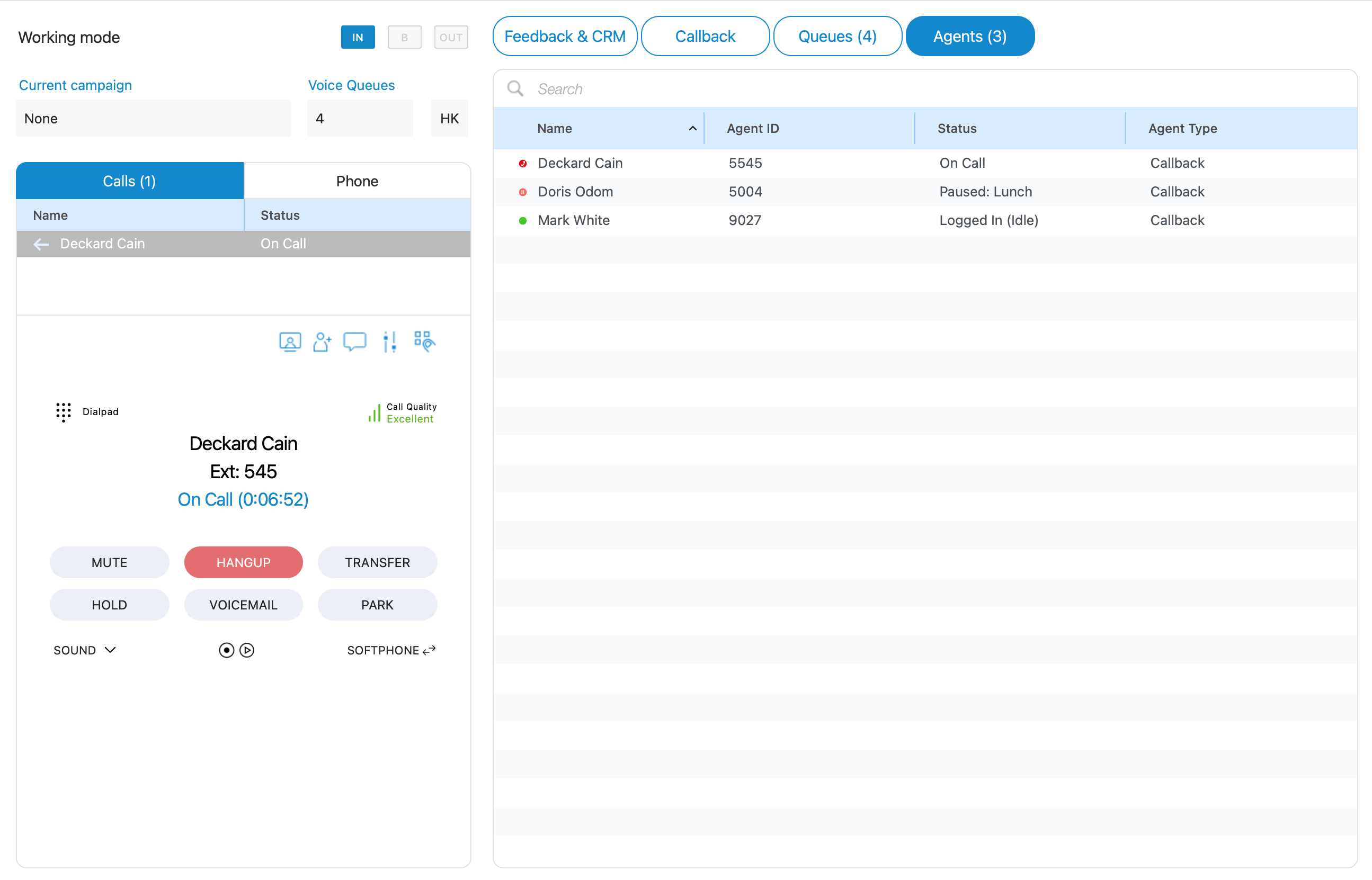
The Agents tab section allows Agents to search through all agents on the system(by name or agent number), call specific agents, or chat with them. Currently, the Agents tab shows logged-in agents, but users can manage this via the Agent Settings(Agent Panel Settings->Voice Settings) and choose which Agents will be displayed within this tab.
The following information is displayed for each Agent: ''Name'', ''Agent ID'', ''Status'', and ''Agent Type''.
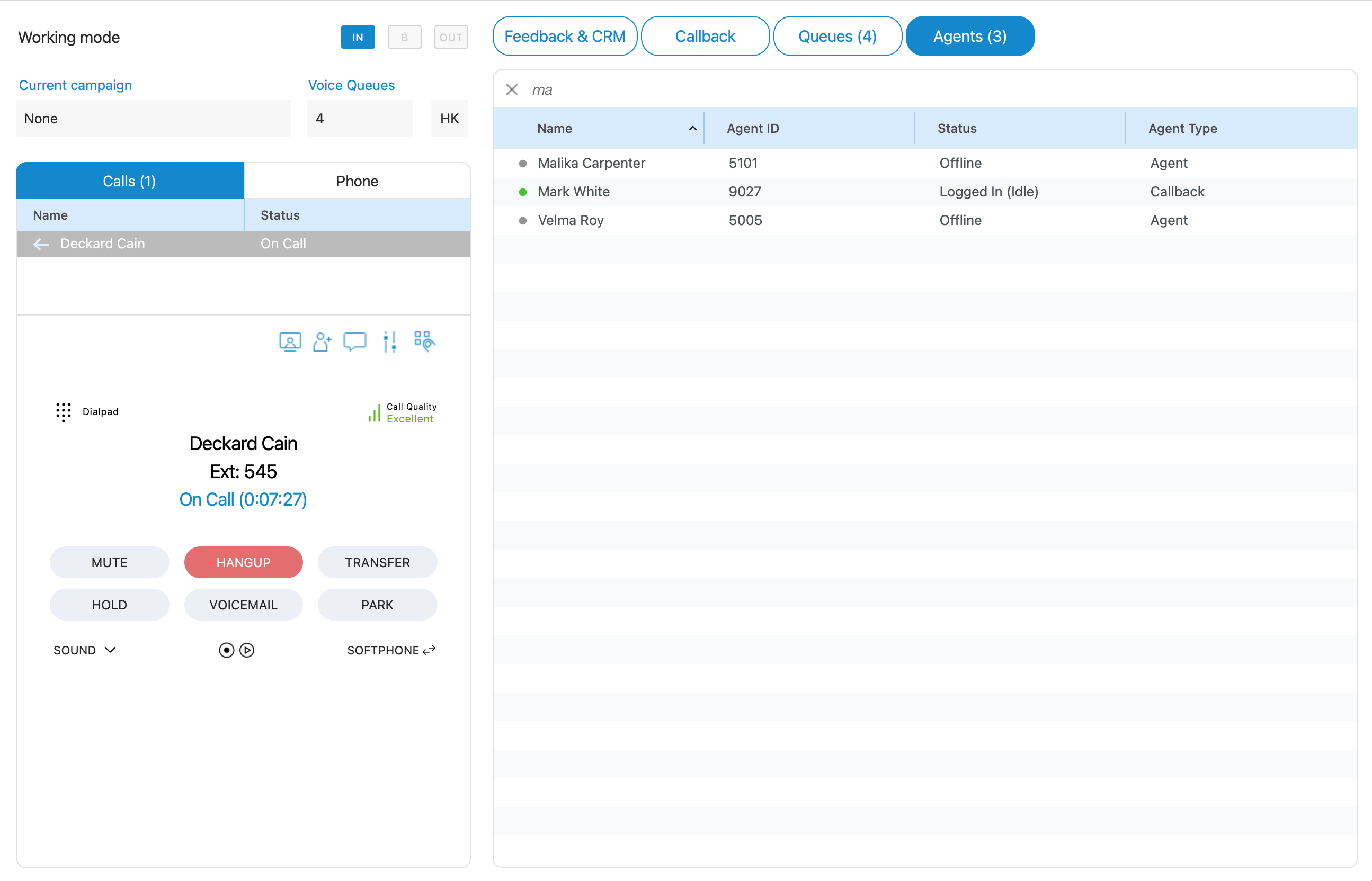
-
Name - Displays the Agent's Name(E.g., Issac Bains)
-
Agent ID - Displays the Agent's Number(E.g., 1001)
-
Status - Displays the Agent's status(E.g.,Idle, Paused)
-
Agent Type - Displays the Agent's type(E.g., Callback)
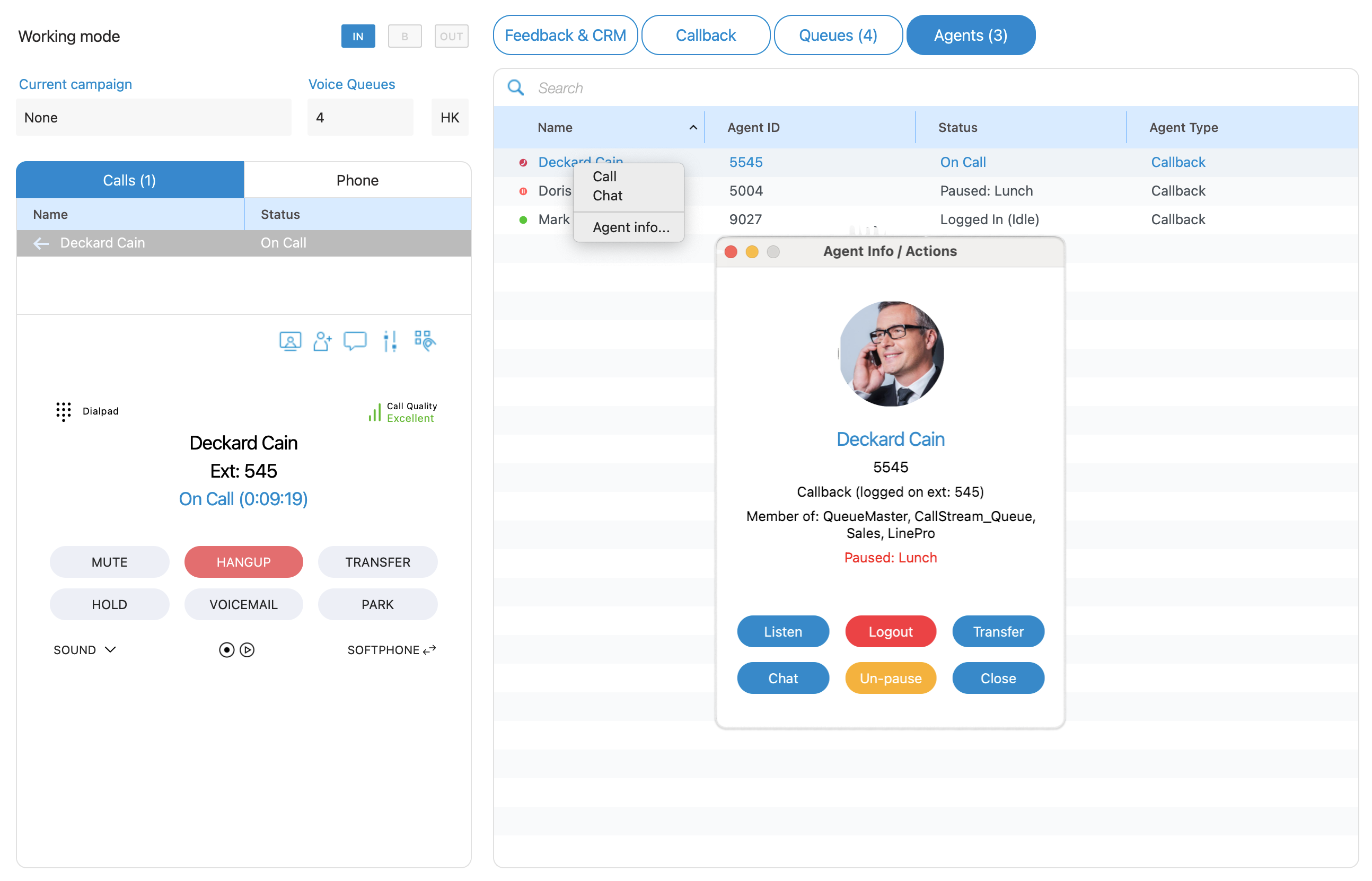
The Agent may right-click on a specific agent and bring up the following options:
i. Call - with this option, the user can make a call to the selected Agent.
ii. Chat - the user can start a chat with the selected Agent.
iii. Agent info - Opens a dialog containing all information about the Agent, like Agent name, Agent number, Agent login type, and Queues of which an Agent is a member.
¶ Queues and Campaigns Dispositions
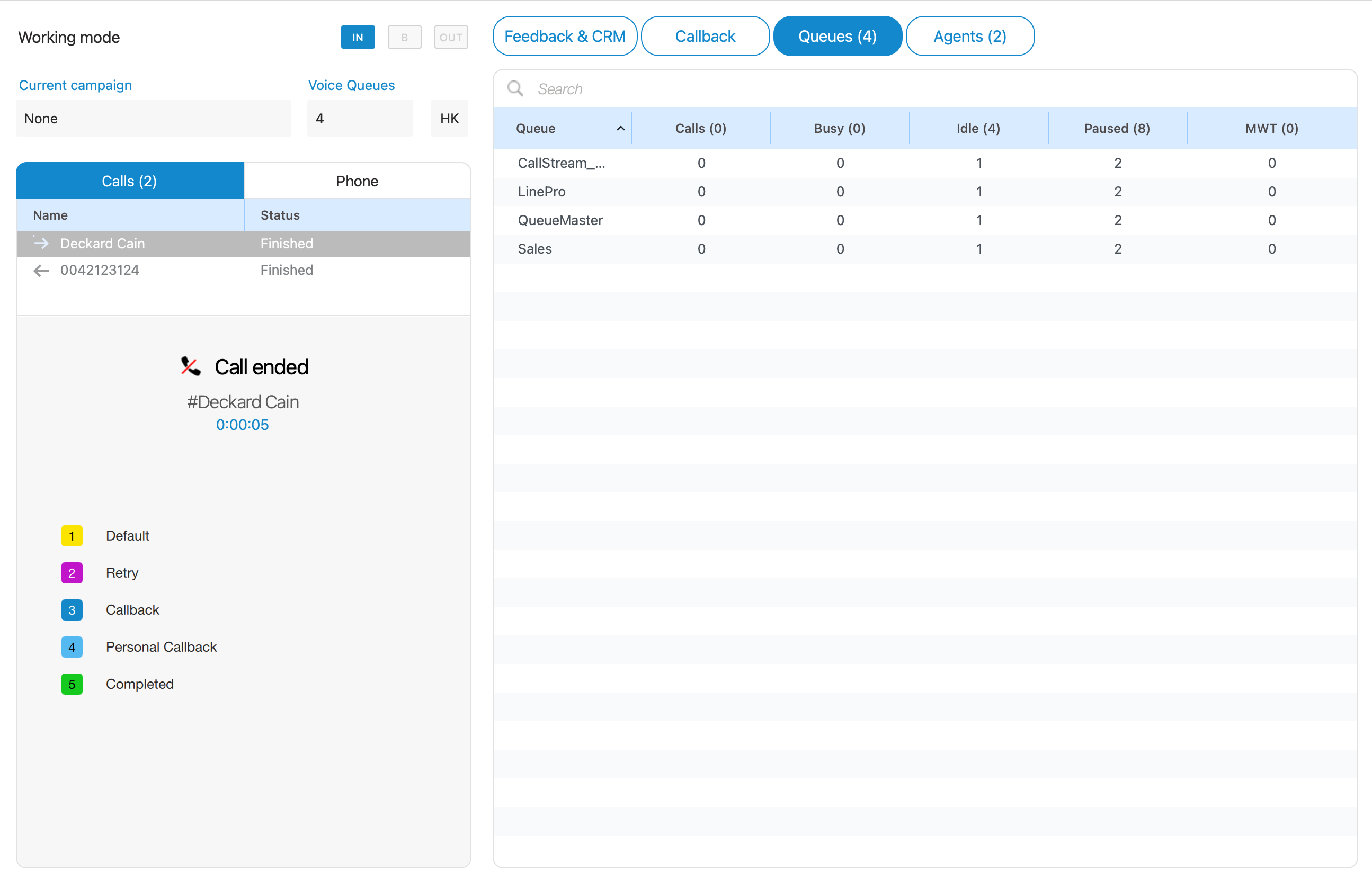
Within the system, it is entirely possible to configure Dispositions on a per-Queue or per-Campaign basis. Dispositions represent predefined categories or outcomes that are used to categorize and document the results of calls made within a specific Queue or Campaign.
When a call within a Queue or Campaign concludes, the system facilitates an organized and user-friendly process for Agents. A list of previously established Dispositions becomes readily available within the Agent panel. This list is designed to assist Agents in efficiently documenting the outcome of the call. Agents can conveniently choose a Disposition from this list that best aligns with the specific outcome or result of the call they just handled.
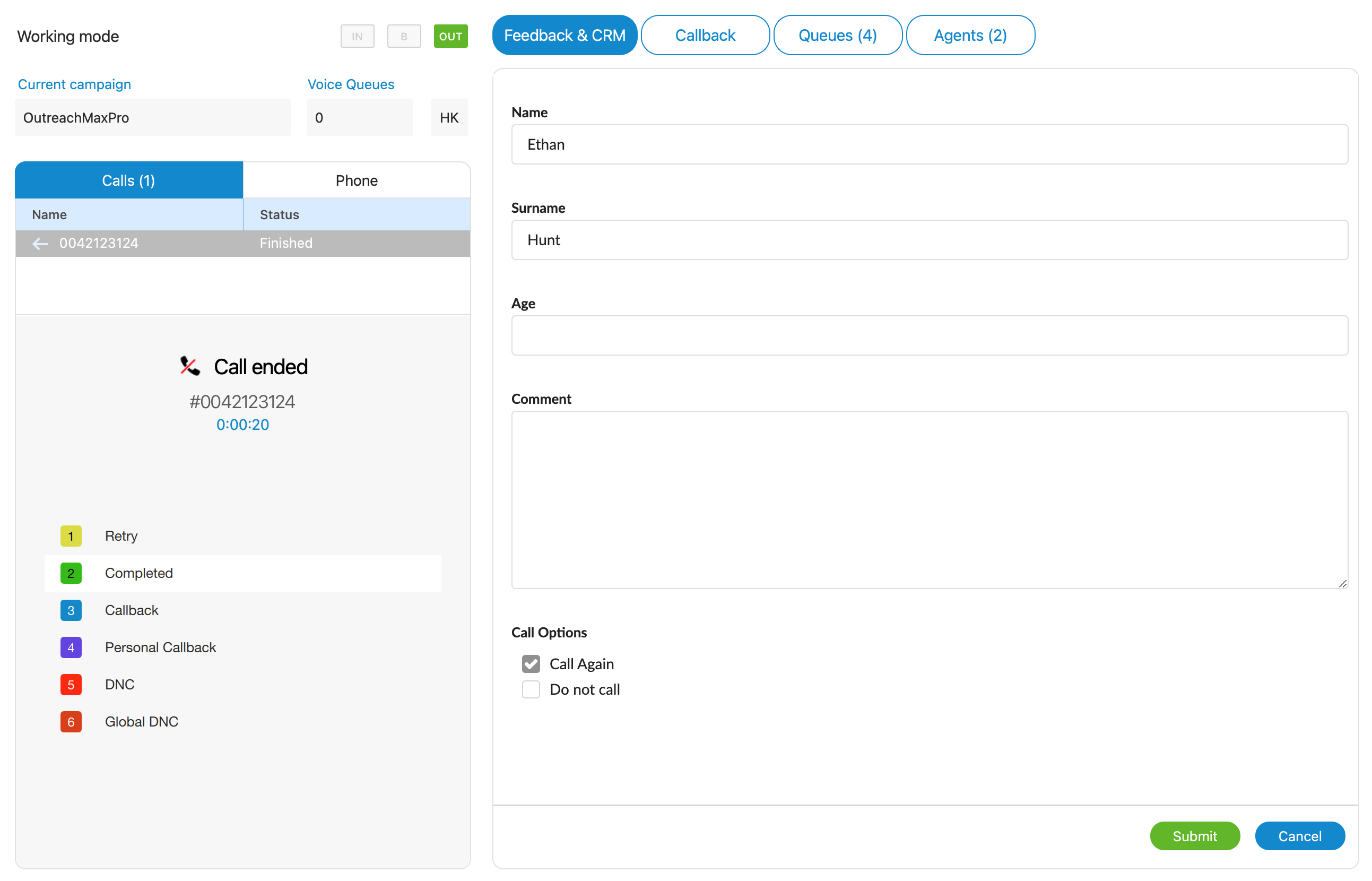
Each Disposition has the following information:
Name - describes Disposition name, so Agents know what will happen if they press a specified disposition button (i.e., Retry, Callback, Personal Callback, DNC)
Hotkey - refers to a keyboard shortcut that Agents use to improve their performance(i.e., If the hotkey of a disposition is ‘1’, to submit this disposition an Agent can press the number '1’ on their keyboard. After pressing '1’ if the Disposition is submitted, the message “Disposition submitted successfully” will appear)
Color - each Disposition can have its color, which helps Agents to find and select Dispositions accurately
¶ OmniChannel
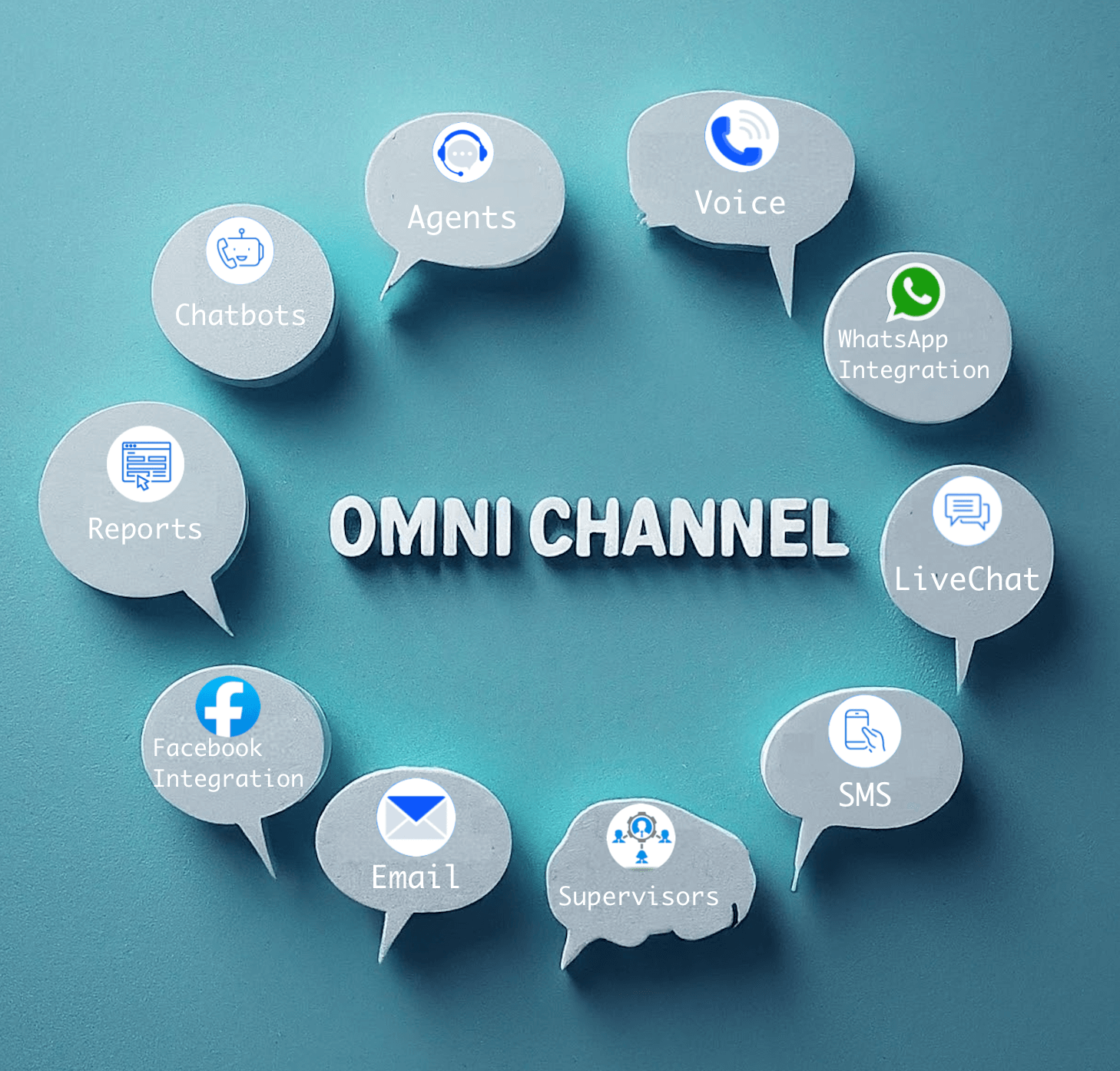
Omnichannel is a robust application that extends the power of Contact Center features, allowing your customers to interact with your business across multiple communication channels like voice calling, emailing, live chat messaging, socials and SMS texting.
An Omnichannel Contact Center combines all your communication channels into a single, easy-to-use interface. Every channel will be able to integrate and relate with one another so the customer can switch effortlessly between channels.
The main focus is creating a consistent customer experience, engaging with the people already interacting with your brand/company to ensure they get a seamless and improved customer experience, regardless of what channel they are using.
Note: For users whose license does not encompass Omnichannel capabilities, or those operating on a version of PBXware devoid of Omnichannel support, all Omnichannel features will be veiled and unattainable within the Agent panel. This arrangement ensures users engage solely with functionalities permitted by their specific license or software edition.
Several sections are related to the OmniChannel (or Messaging) part of the Contact Center Edition:
¶ Chats
The "Chats" feature within the application provides agents with live updates on ongoing customer interactions across various channels, including the Visitor app (Live Chat), Socials, and SMS. Agents can leverage this feature to effectively handle their assigned conversations by performing actions such as assigning, transferring, closing, or banning customers and accessing conversation histories conveniently.
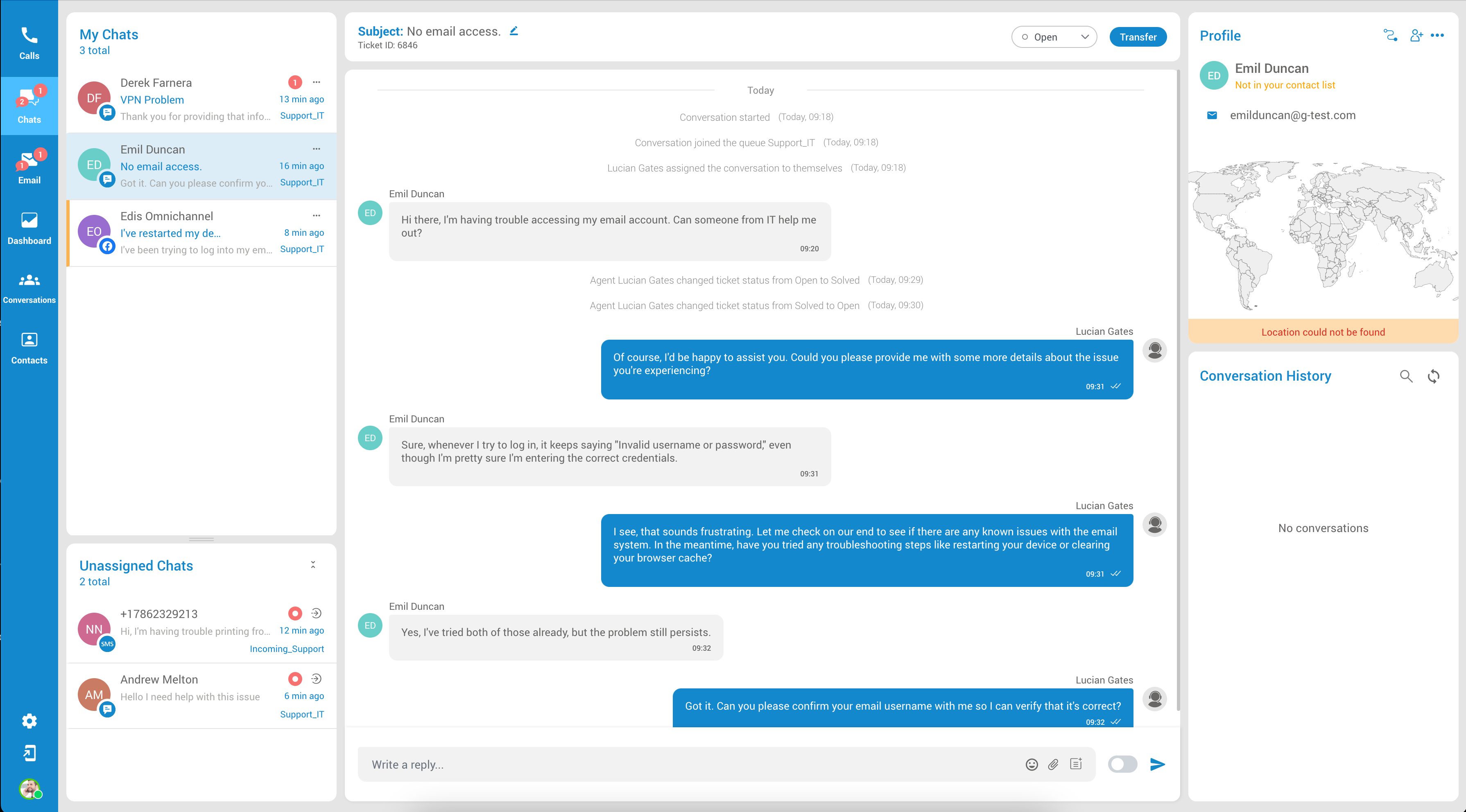
Adding live chat to an omnichannel plan is like having a super tool for talking with customers in many different ways. It helps everything work together smoothly, so when customers want to ask questions or talk, they can use different methods like chat, SMS, or email. This super tool also lets helpers reply fast, talk to many people simultaneously, and give great help!
The Chat landing page is divided into six sections, each representing the following:
¶ My Chats
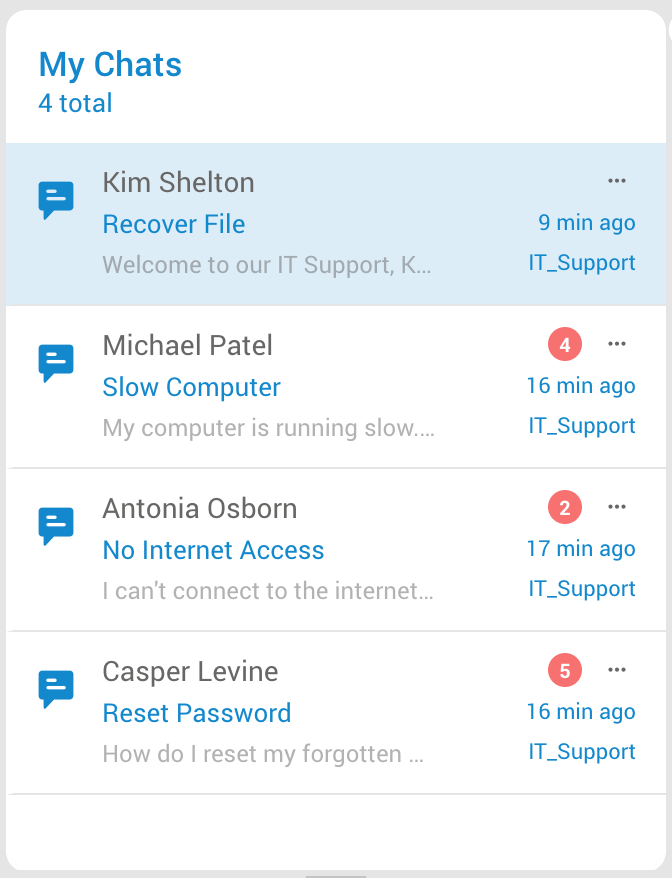
The 'MyChats' section of the application displays information about the conversations assigned to the agent. This section provides agents with a quick overview of their workload and helps them manage their time efficiently.
Agents can take various actions on each conversation in the 'MyChats' section. They can open the conversation to view the full conversation history, respond to the conversation, transfer the conversation to another agent, or close the conversation once it is resolved.
In addition to the number of conversations, the section also displays the following information for each conversation:
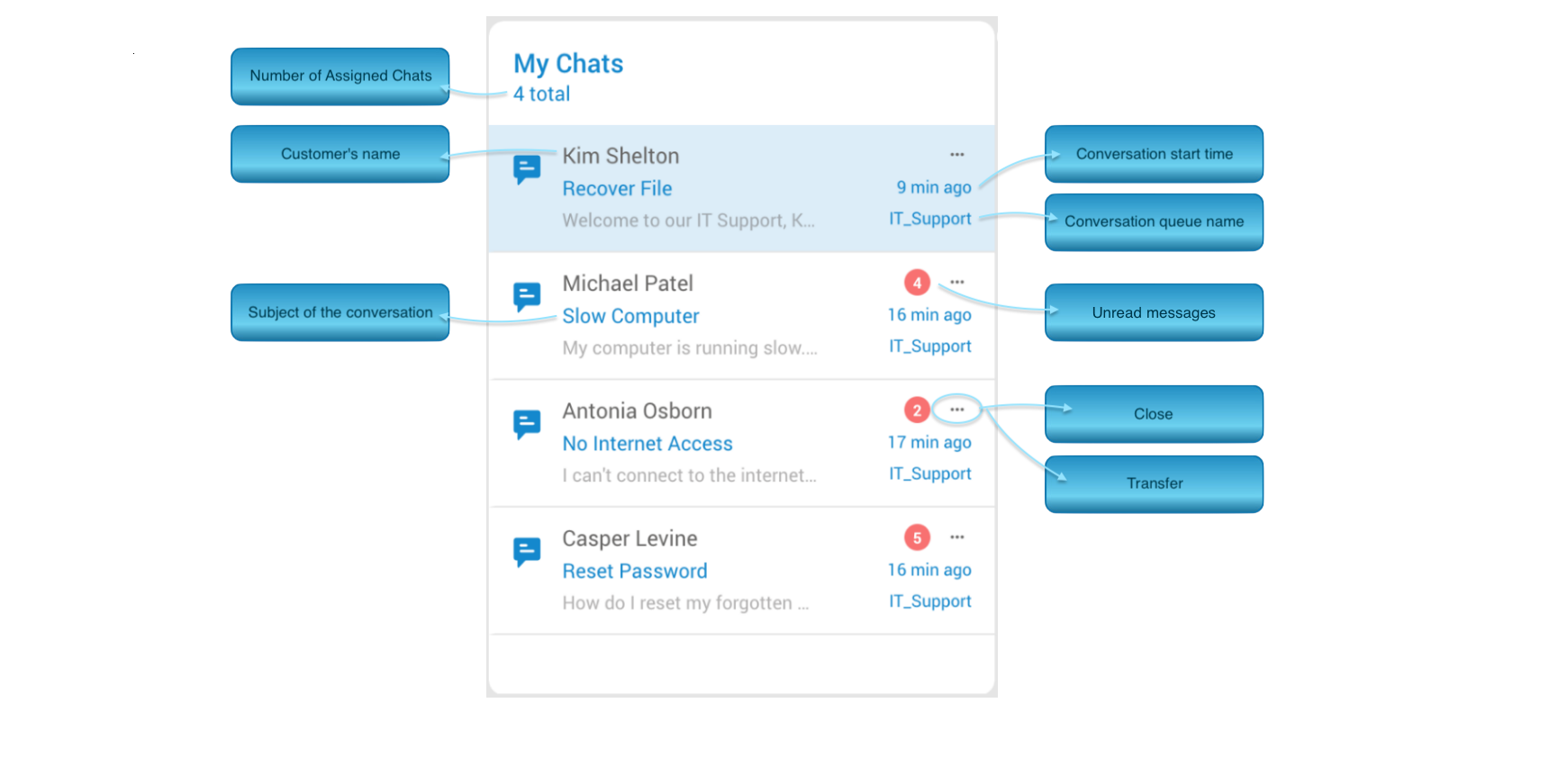
-
The number of Assigned Chats - This represents the number of assigned chats/conversations to the agent, which will change accordingly as the agent is assigned more conversations or when conversations are closed.
-
The Customer's name or the Customer's number - This helps agents identify the customer they are talking to and personalize their interactions.
-
Subject of the conversation - Brief description of the problem or request.
-
Conversation start time - Time when the conversation was started. This gives agents a reference point for the conversation and helps them manage their time efficiently.
-
Conversation queue name - Name of the queue where the conversation was opened. This helps agents identify the source of the conversation and enables them to provide appropriate support.
-
Unread messages - This notification represents the count of unread messages and will appear whenever there are new unread messages within the conversation.
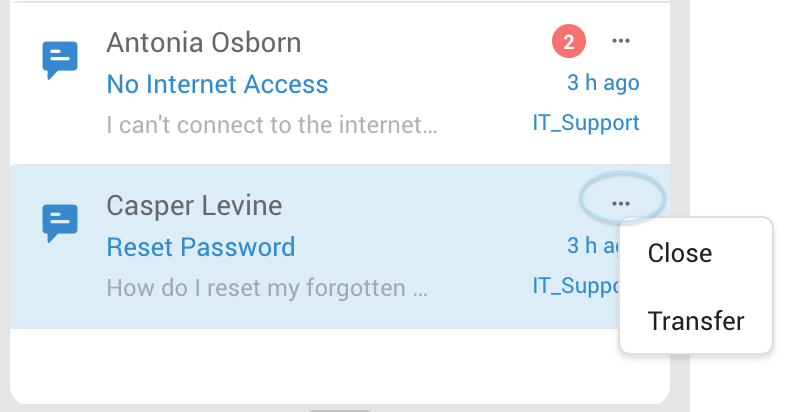
As previously stated, agents have the ability to transfer or close conversations within this section. Upon clicking the three-dot button, two additional options will be displayed.
Close Conversation
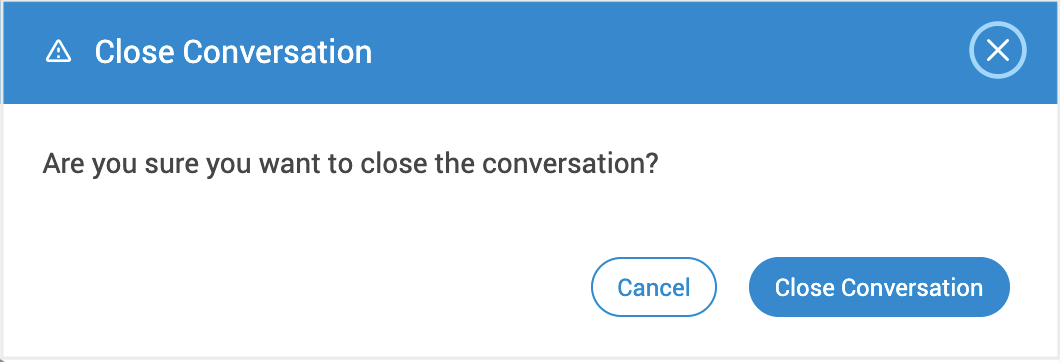
When an agent tries to close a conversation, a confirmation dialog box will pop up. It asks, "Are you sure you want to close the conversation?" This safeguard prevents accidental chat closures, ensuring the user truly means to end the conversation. The selected conversation will be permanently closed by choosing the Close Conversation option. Furthermore, it will be removed from the "MyChats" section and archived in the "Conversation History."

After successfully closing a conversation, the corresponding notification will appear within the agent panel.
Transfer Conversation
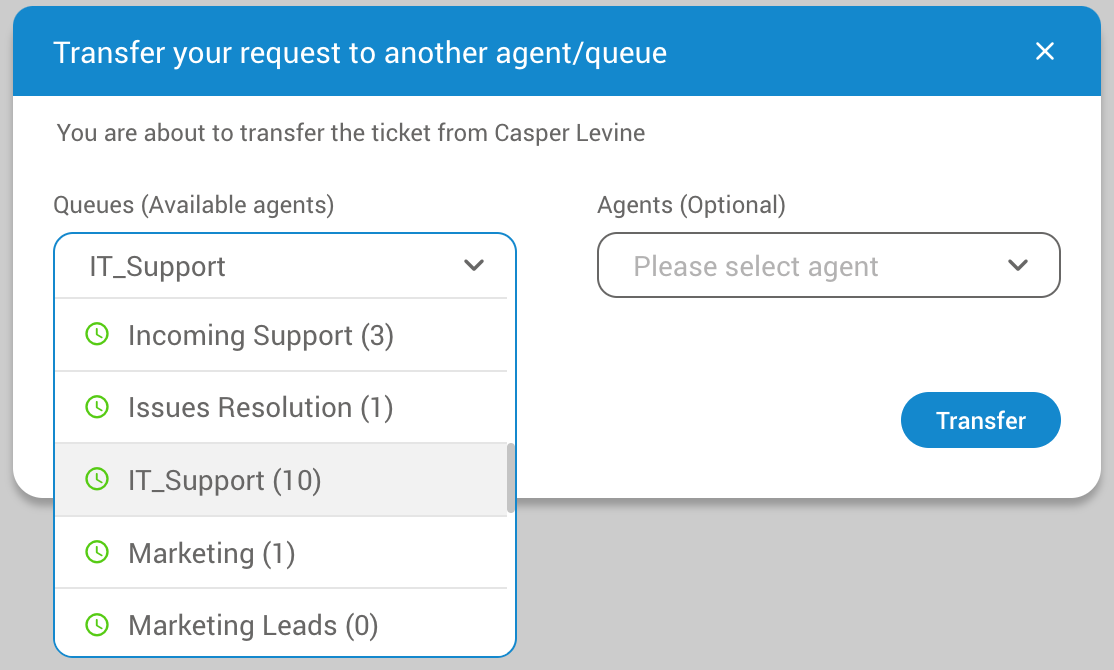
A new window will appear when the agent selects a conversation and clicks the Transfer option. From there, the agent can choose the queue to which the selected conversation will be transferred or select the specific agent to whom the conversation will be assigned.
When a conversation is transferred directly to an agent, it will be automatically assigned to that specific agent regardless of which queue the agent belongs to. This means that the agent will be solely responsible for managing the conversation and responding to the customer's queries.
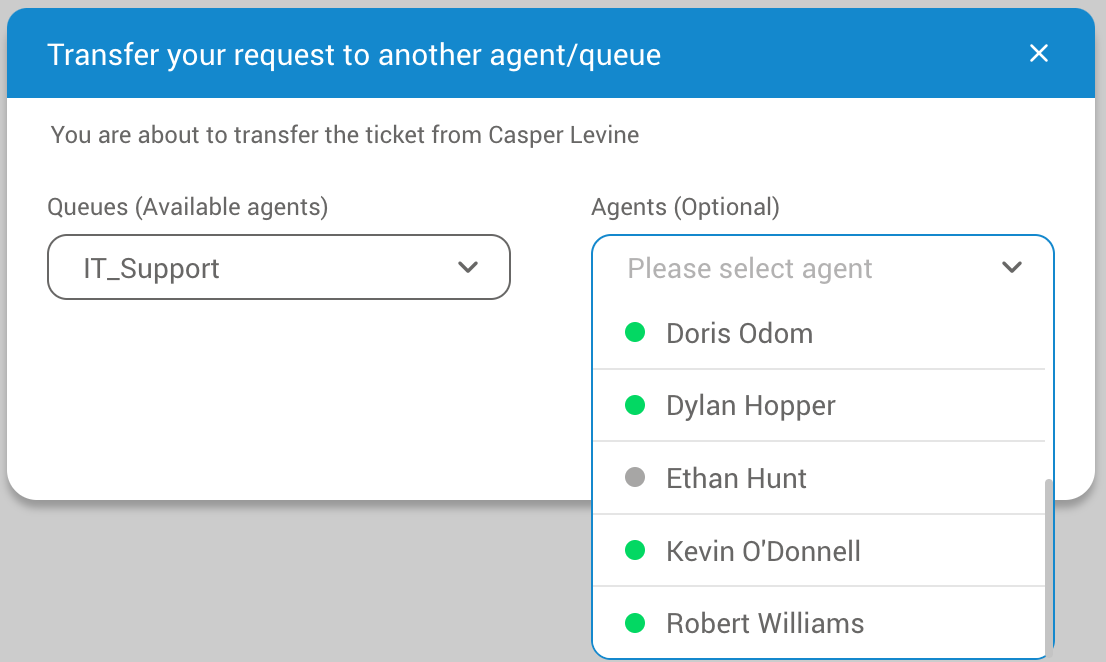
Conversely, if a conversation is transferred to a queue where no agents were selected, it will be sent to the unassigned conversations section for the selected queue. This allows agents who are available and logged in to the queue to take ownership of the conversation and provide support to the customer.

After successfully transfering the conversation, a corresponding notification will appear within the agent panel.

Transferring conversations to queues without agents, which are empty, is not permitted. However, transferring to a queue during non-working hours is still an option. In both instances, the transfer window will generate relevant warning messages.

¶ Unassigned Chats
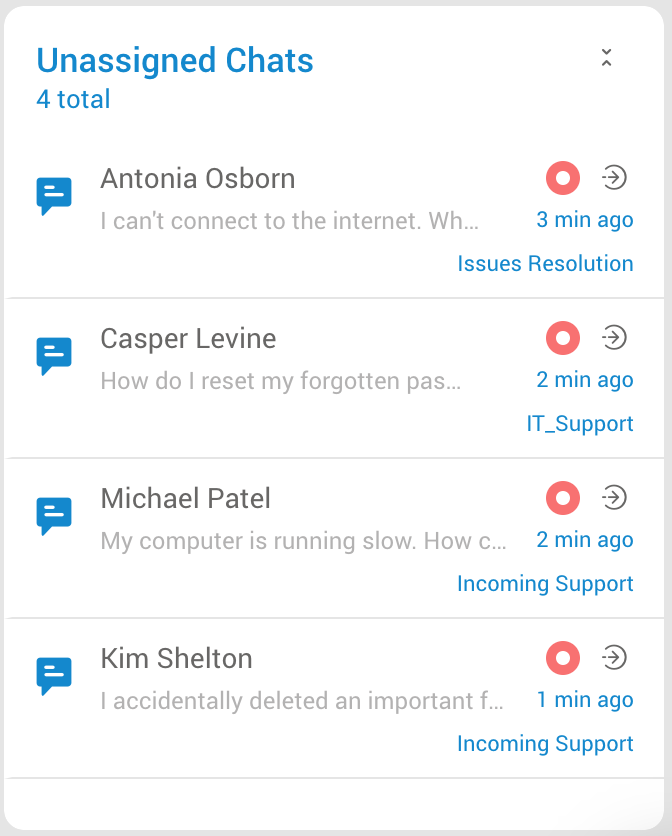
The 'Unassigned Chats' section of the application displays information about all unassigned conversations for each queue that the agent is part of. This section helps agents identify conversations waiting for a response and allows them to take ownership of the conversation.
For each unassigned conversation, the section displays the following information:
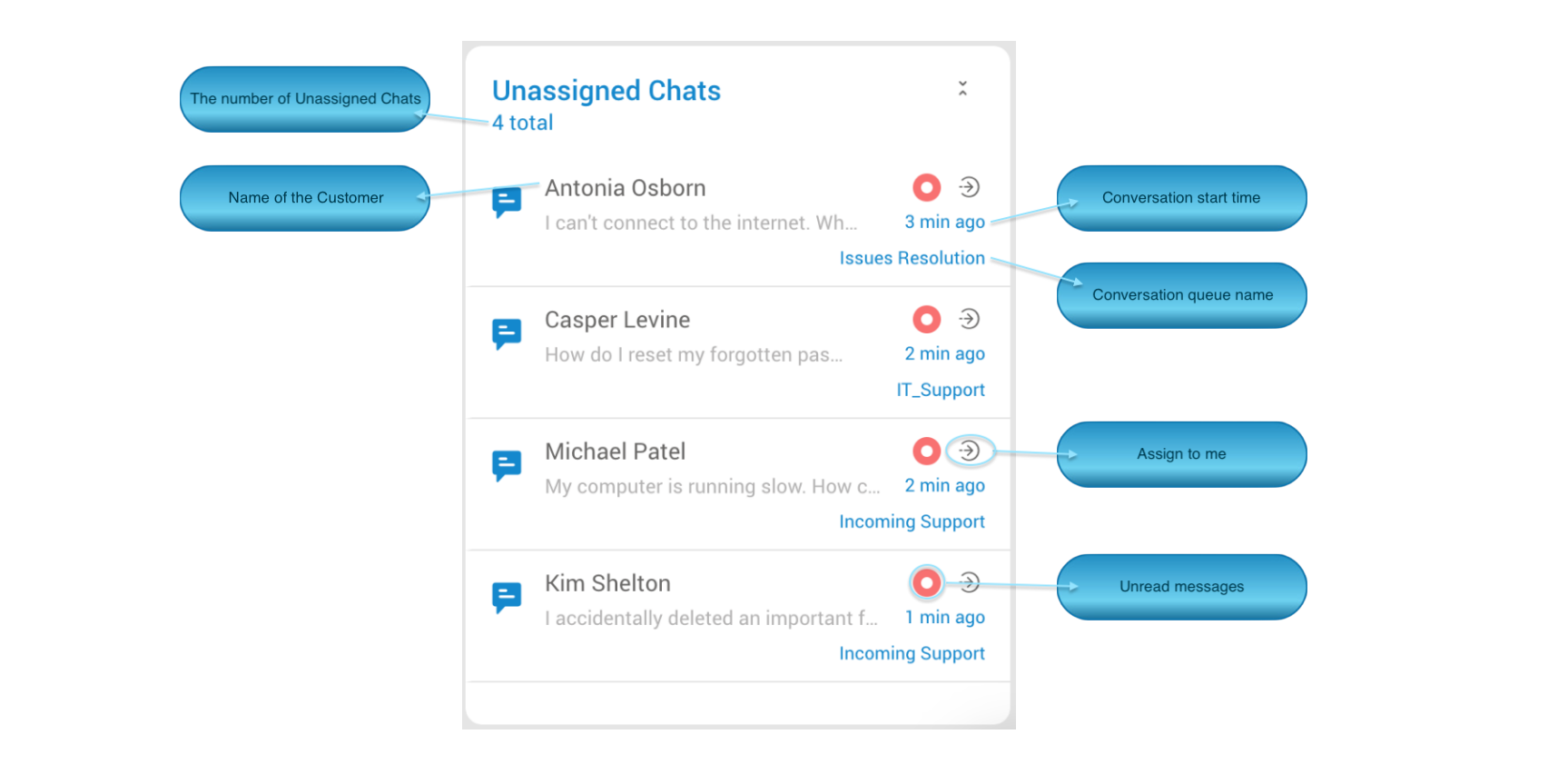
- The Customer's name or the Customer's number - This helps agents identify the customer they are talking to and personalize their interactions.
- The number of Unassigned Chats - This represents the number of unassigned chats and will change as new conversations are created.
- Conversation start time - The time when the customer started the conversation. This gives agents a reference point for the conversation and helps them manage their time efficiently.
- Conversation queue name - Name of the queue where the conversation was opened. This helps agents identify the source of the conversation and enables them to provide appropriate support.
- Unread messages - Notification for unread messages will appear whenever there are new unread messages within the unassigned conversation. These notifications differ slightly from the "MyChats" section notifications since they do not display the number of new messages.
- Assign to me button: This button allows the Agent to manually assign conversations to themselves, indicating they are willing and able to take on the conversation. This is especially useful when the queue is busy and automatic routing is delayed or when the conversation requires specific expertise that only the Agent possesses.
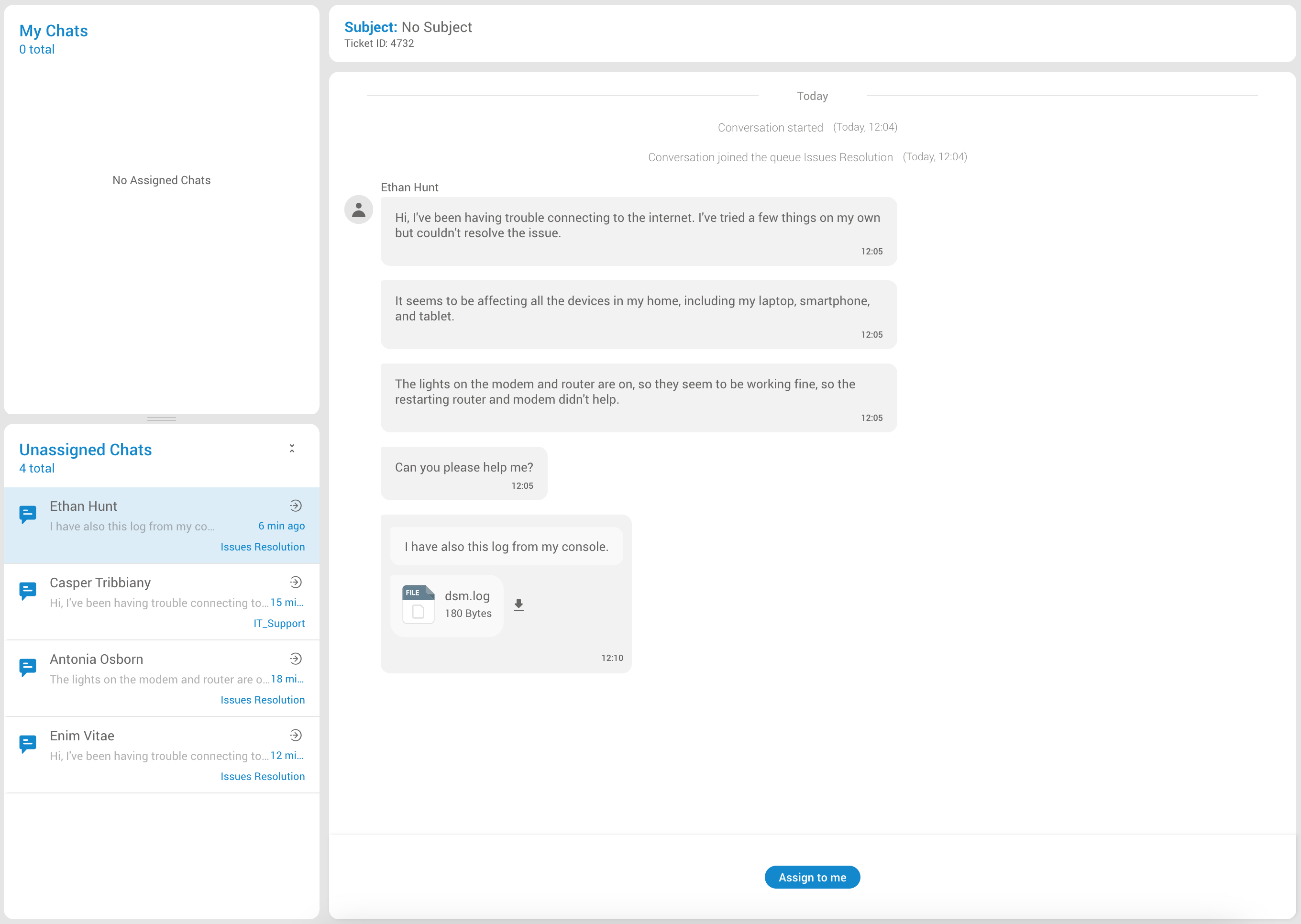
When an agent clicks on an unassigned conversation in the 'Unassigned Chats' section, the app provides a preview of the conversation. This preview includes important information about the conversation, allowing the agent to quickly assess the nature of the query and determine whether they are best suited to handle it. From this window, agents may assign selected conversations to them by clicking the 'Assign to me' button.
Also, by clicking on the conversation, agents can scroll up the previous conversations with that specific customer (if there are any), which includes any attachments associated with the conversation. This allows agents to see through any documents, images, or other files that the customer has shared, providing them with valuable context to resolve the customer's query effectively.
¶ Omni Conversations Assigment
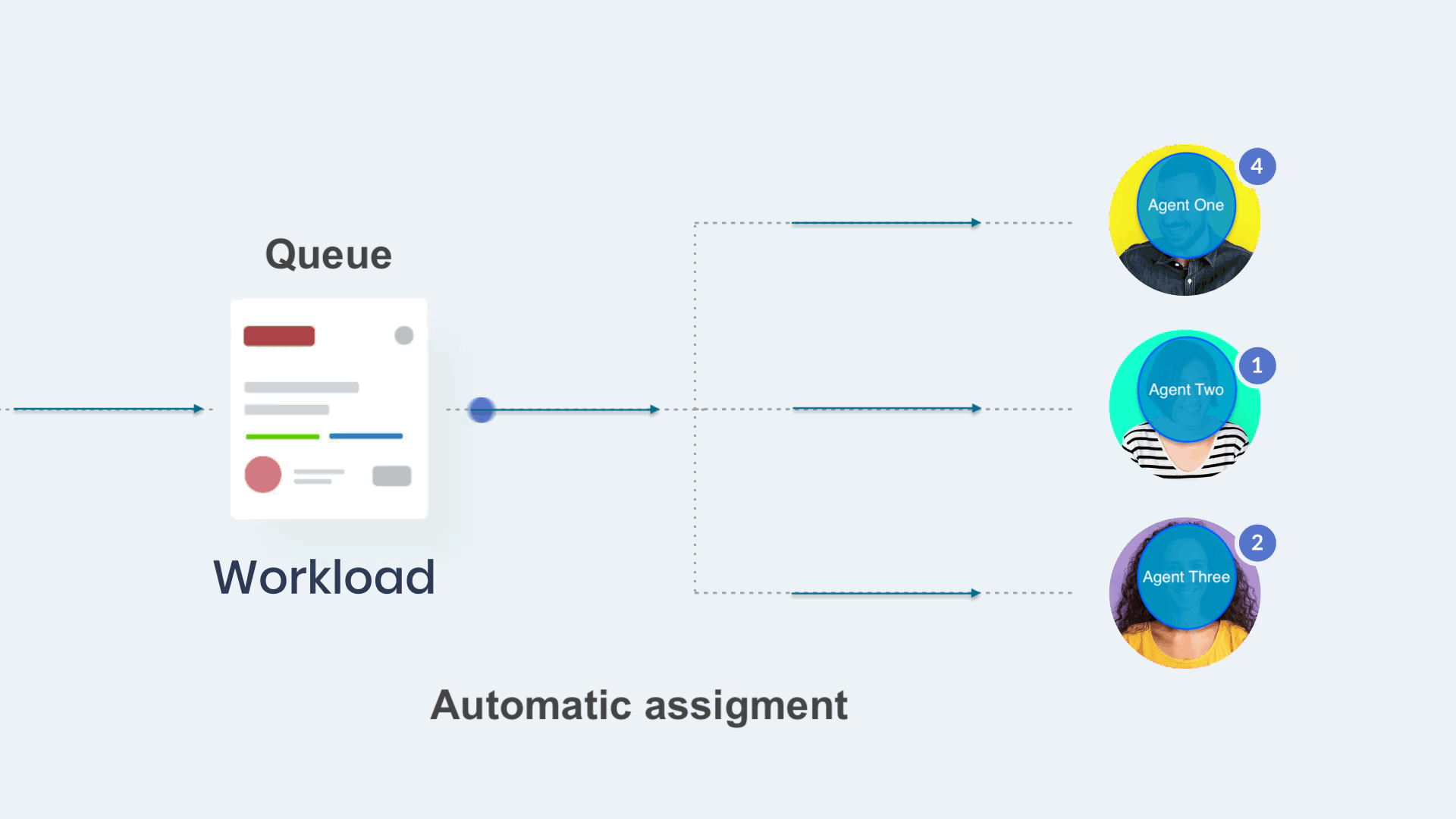
When it comes to the assigning methods, the app provides two options for assigning conversations to agents: automatic assignment and manual assignment.
In cases where automatic assignment is enabled within the PBX system, conversations will be automatically assigned to agents based on a set of predefined rules or criteria.
If the automatic assignment isn't turned on, the agent has the option to manually assign the conversation to themselves by choosing the 'Assign to me' selection.
¶ Automatic Assigment
Automatic or AA assigment is triggered by next events:
- Conversation Creation
If a conversation is created outside of operation hours for a particular queue, it triggers the algorithm to auto-assign the conversation.
(This means a conversation is started when the queue is not open.)
- Conversation Transfer
If a conversation is transferred outside of operation hours for a queue, the algorithm auto-assigns the conversation.
(The conversation is transferred during non-working hours of the queue.)
- Conversation Closure
When an agent closes a conversation, the algorithm assigns a new conversation based on the current workload and capacity.
(This means after the agent initiates close conversation option, the system will automatically assign a new conversation to that particular agent, depending on the agent's workload and capacity.)
- Beginning of Operation Times
The algorithm auto-assigns conversations at the beginning of operation times for the queue.
(The queue started working.)
- Adding New Agents
When new agents are added to a queue from the PBXware GUI, the algorithm auto-assigns conversations.
(This occurs because the number of agents available for the queue has been increased, and the system distributes the workload accordingly among these agents.)
- Agent Login
When an agent logs into the system, the algorithm auto-assigns conversations based on the predefined rules.
(Similar to the event of adding a new agent to the queue, workload is distributed among available agents.)
- Unpausing an Agent
When an agent is unpaused, the algorithm auto-assigns conversations according to the agent's current capacity and workload.
(When an agent returns from pause break, the system will auto-assign conversations according to the agent's current capacity and workload.)
- Change of Agent's Status
When an agent switches their status from "active" to "inactive," the algorithm automatically reassigns conversationss to ensure a balanced workload.
¶ Manual Assigment
If the automatic assignment is not enabled, the agent can assign the conversation manually by selecting the  option. This allows the agent to take ownership of the conversation and handle the query themselves.
option. This allows the agent to take ownership of the conversation and handle the query themselves.
The manual assignment option is particularly useful for situations where the agent has specialized knowledge or expertise in a particular area and is better equipped to handle the query. By manually assigning the conversation, the agent can ensure that the customer receives the best possible support and that their query is resolved as efficiently as possible.
The Agent can assign conversations manually even if the system is set to assign conversations automatically.
¶ Chat - Subject Section

Within this section, agents have the ability to modify a conversation's status, indicating its progress or current state. Additionally, agents can transfer conversation or edit the subject of the conversation and easily track the ID of the current conversation.
¶ Subject of the Conversation
Agents can edit the subject of the conversation in this section. This can be particularly useful for ensuring that completed conversations are easy to find and review, especially
if the conversation involves a complex or nuanced issue.

Any updates on the subject will trigger a corresponding notification.
¶ Status of a Conversation
Conversations within the system can have four different statuses that indicate the current stage or state of the conversation:
Open Status
This status is set by default when a conversation is assigned to an agent, either through manual or automatic assignment.
Waiting Status
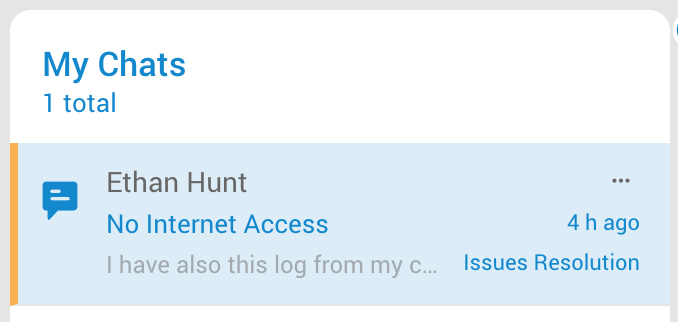
The "Waiting" status indicates that the agent is awaiting additional information from the customer. This could be specific details such as ID numbers, operating system details, or any other relevant information required to proceed with assisting the customer.
Solved Status
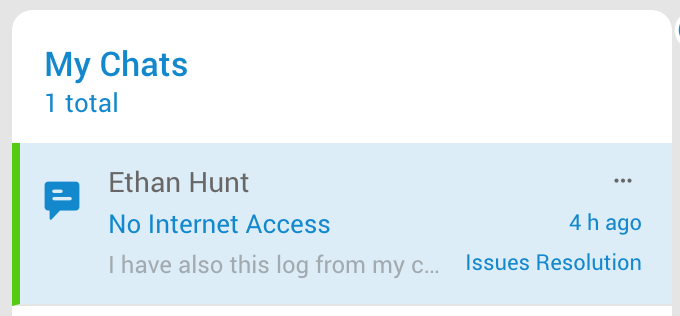
When a conversation reaches the "Solved" status, it signifies that the agent has completed their assistance and resolution process. However, the conversation is still awaiting confirmation from the customer regarding the resolution. The agent may have successfully solved the customer's problem or provided a solution, but it is necessary to check with the customer if everything is working as expected. Once the customer confirms their satisfaction or provides any further feedback, the conversation can be closed.
Closed Status
The closed status allows agents to mark a chat or conversation as completed. Once a conversation is closed, it will be removed from the agent's 'My Chats' section and displayed in the 'Conversation History' section.
¶ Transfer Conversation

The 'Transfer' button allows agents to transfer a selected chat or conversation to another agent or queue. When transferring a chat to another agent, the chat will be automatically assigned to the selected agent, regardless of which queue they belong to. If the chat is transferred to a queue, it will be sent to the unassigned conversations section of that queue.
¶ Conversation Card
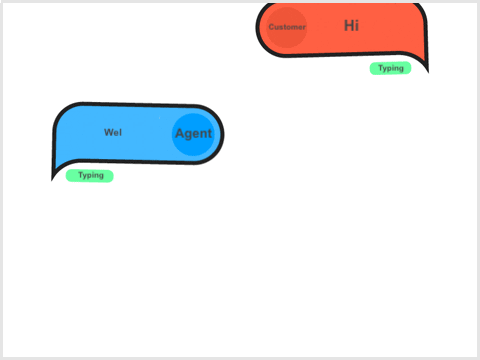
A text-based communication feature that allows customers and agents to chat in real-time. This means that conversations happen in the same way as any other chat, with messages being sent and received almost instantly.
When chatting with a customer,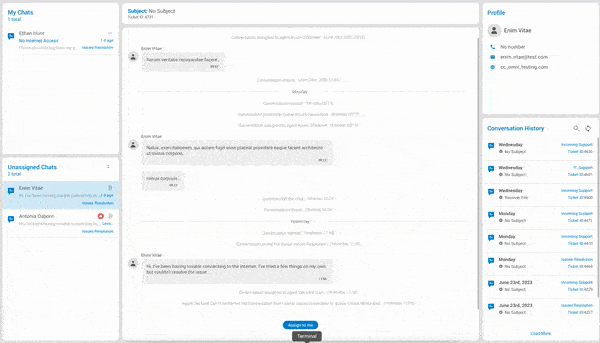 the agent can scroll through the conversation history to review what has been discussed previously. The app enables agents to enhance their messages by incorporating emojis, canned responses, and WhatsApp templates. This feature enhances context, accelerates response times, and improves conversation management efficiency.
the agent can scroll through the conversation history to review what has been discussed previously. The app enables agents to enhance their messages by incorporating emojis, canned responses, and WhatsApp templates. This feature enhances context, accelerates response times, and improves conversation management efficiency.
Additionally, the app provides support for file attachments, allowing agents to send and receive different types of files during the conversation. However, there is a size limit of 20MB for each file that can be uploaded.
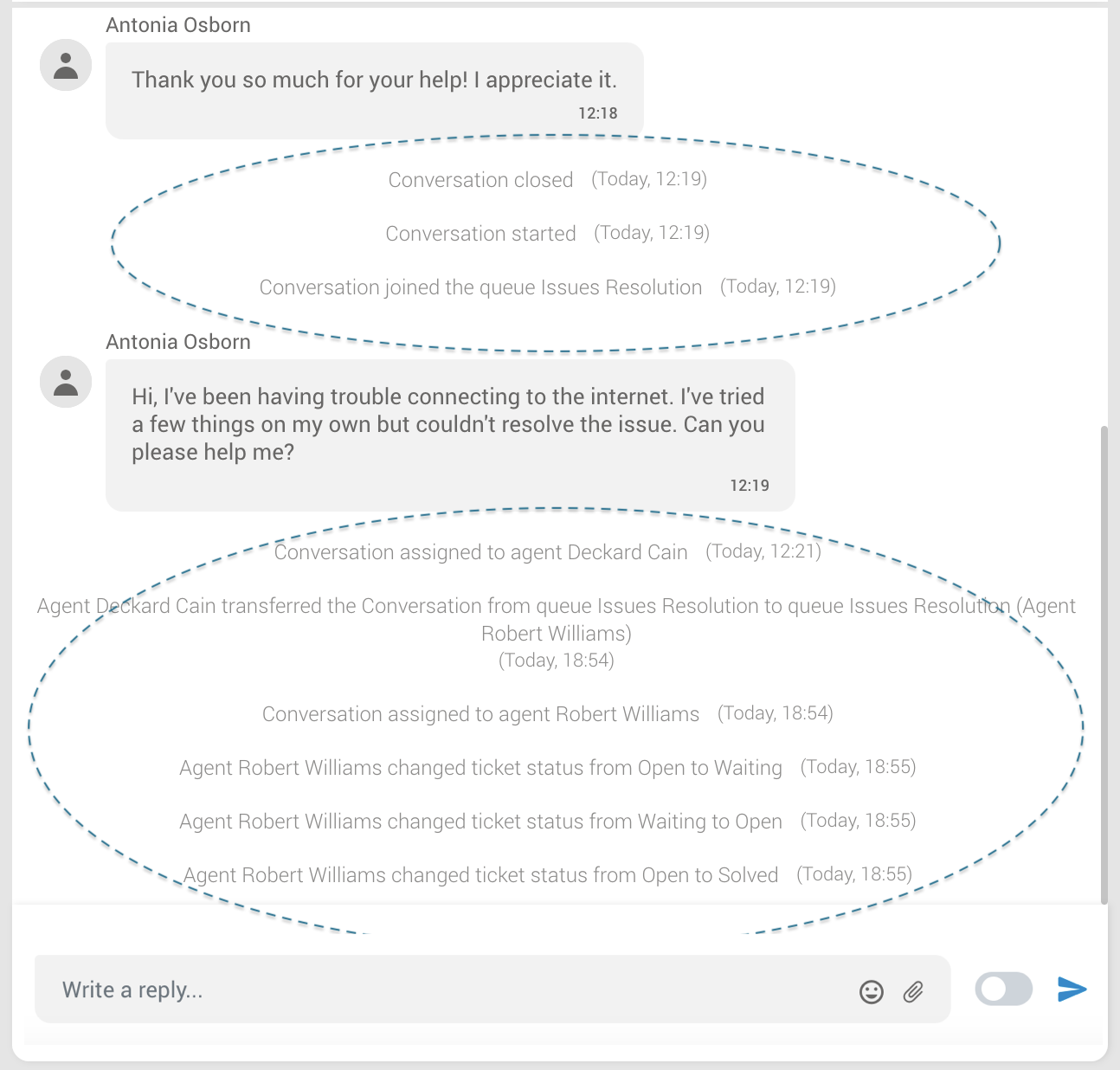
The conversation card provides agents with a snapshot of essential information related to a conversation. When agents select a conversation, they are directed to a screen displaying the conversation card. The card includes the conversation's start time and queue assignment, information about the assigned agent, the transfer history, if applicable, and the conversation's status and closure details.
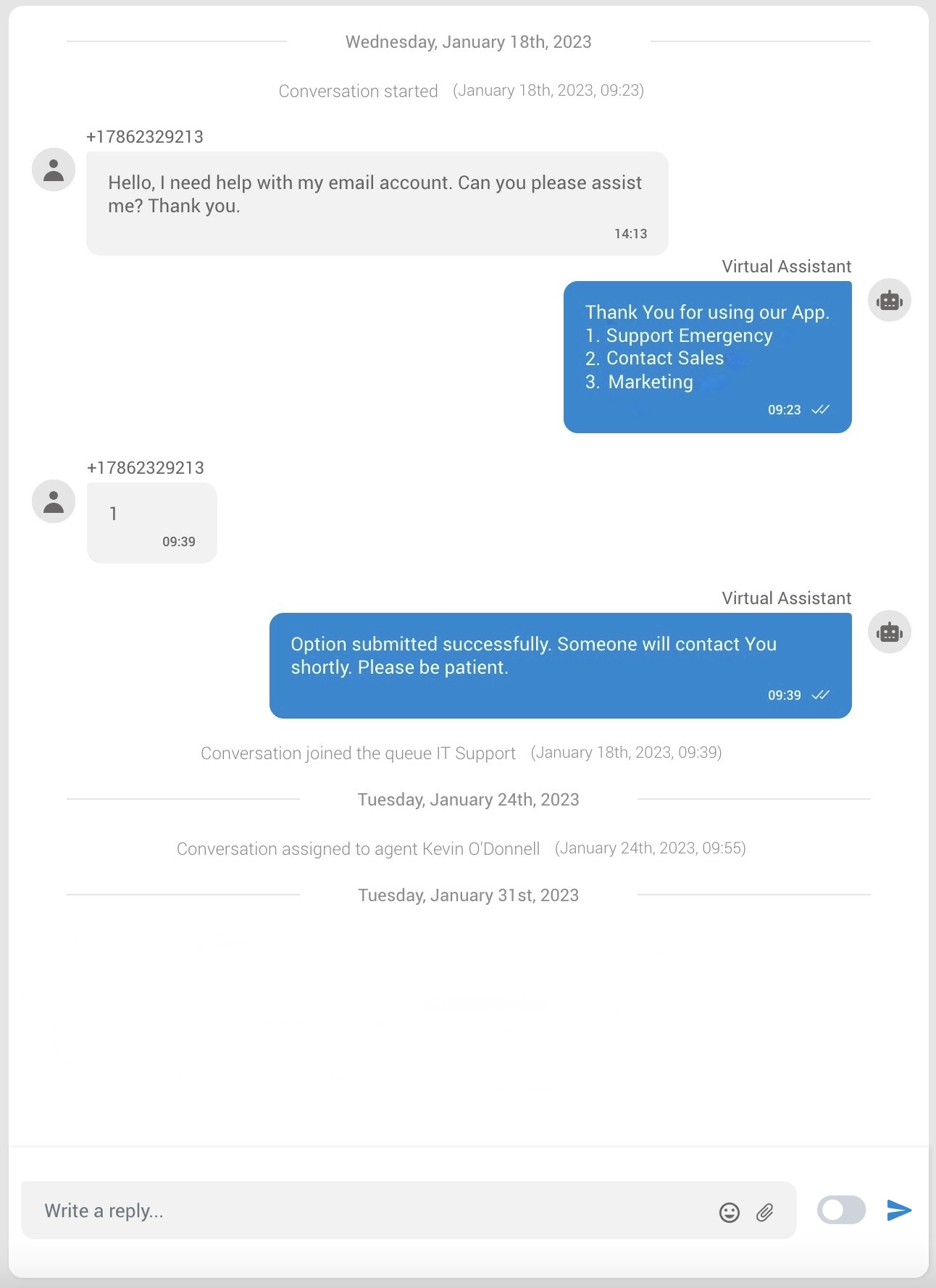
Please note that if the chatbot (Virtual Assistant) has been configured in the system for 'Live Chat' and 'SMS Chat', any conversations between the chatbot and the customer will also be displayed inside the Conversation card. This ensures that the agent has visibility into any automated interactions that have taken place with the customer before they start the conversation.
¶ Messaging Guidelines for WhatsApp and Facebook
¶ WhatsApp Messaging Rules
When communicating with customers via WhatsApp, adhere to specific constraints:
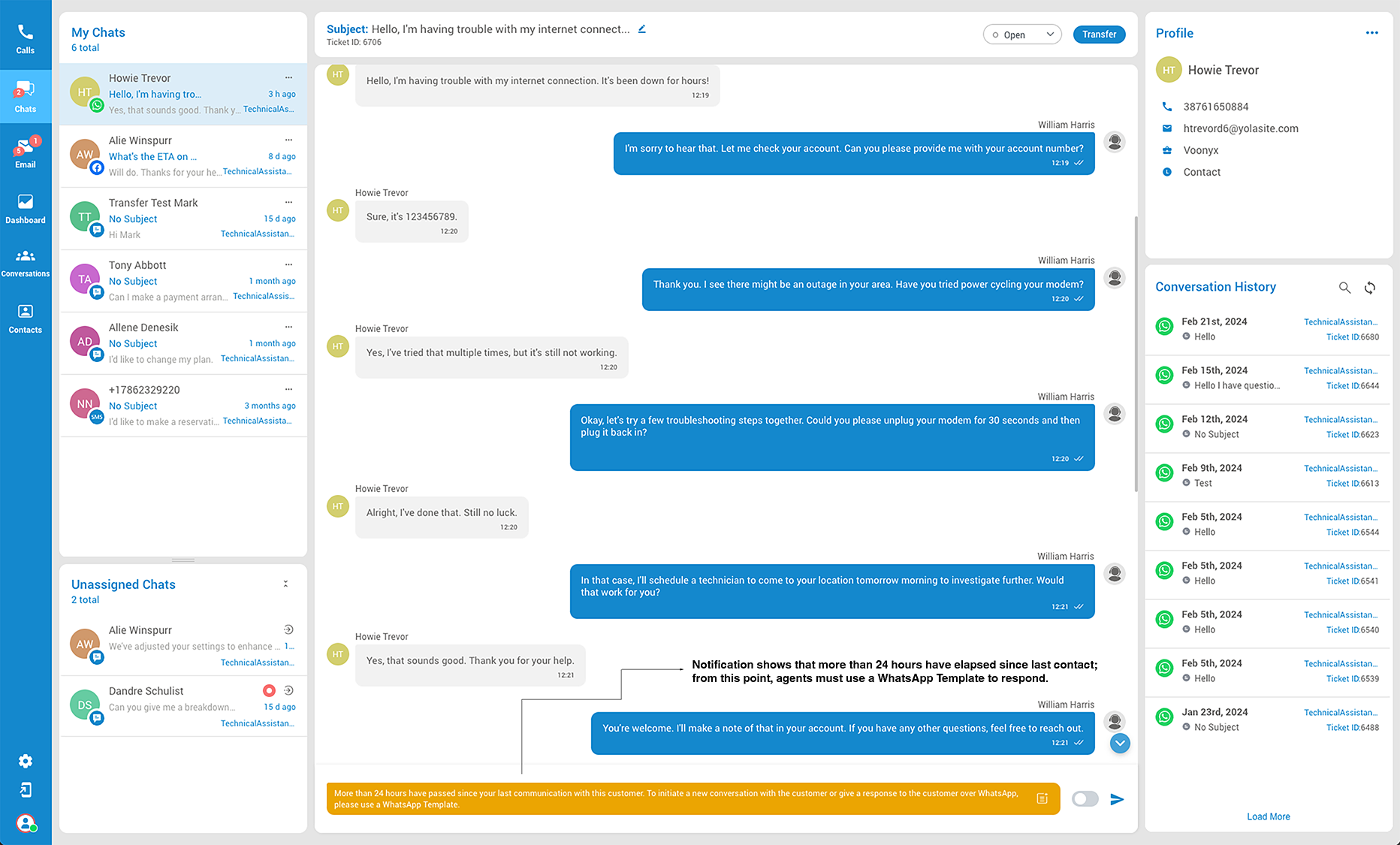
- 24-Hour Rule: If more than 24 hours have passed since the last message from a customer, agents can only respond using pre-approved WhatsApp Templates. Direct new messages are not allowed without customer initiation.
- Customer Initiation: Agents cannot send new messages until the customer initiates the conversation again.
- Template Usage: Agents are restricted to responding with WhatsApp Templates after the 24-hour window to ensure compliance with WhatsApp's policies.
¶ Facebook Messaging Rules
For Facebook, different rules apply:
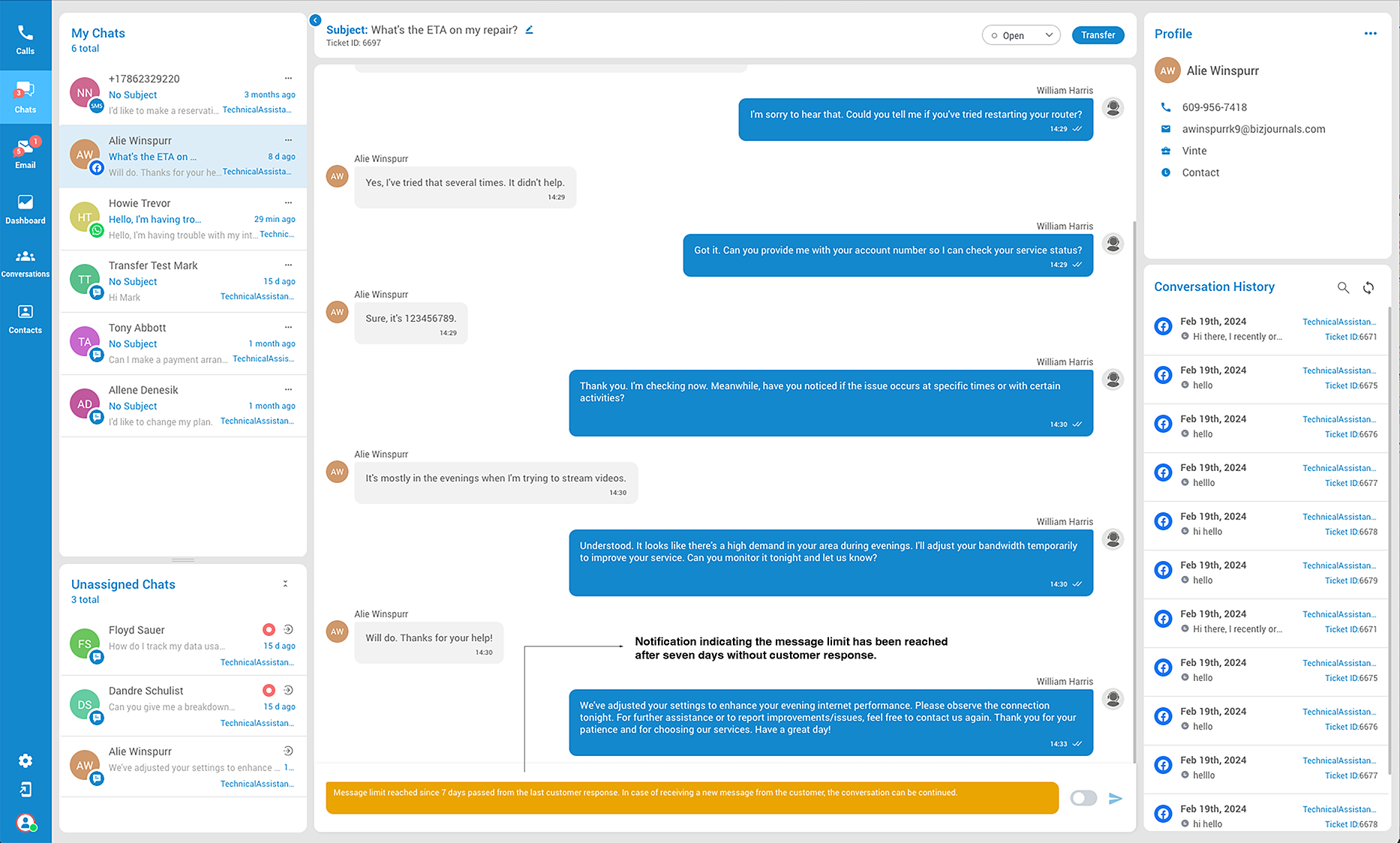
- 7-Day Limit: If 7 days have passed since the last customer response, the agent cannot reach out proactively. The conversation can continue once the customer sends a new message.
¶ Best Practices
- Timely Responses: Respond within allowed time frames to maintain engagement and comply with platform rules.
- Use Templates Wisely: On WhatsApp, prepare for common scenarios with templates to ensure compliant responses post-24-hour window. On Facebook, monitor interactions to avoid surpassing the 7-day limit.
- Monitor Conversations: Regularly check for new customer messages on both platforms to provide timely and appropriate responses.
Adhering to these guidelines ensures effective communication with customers while complying with platform-specific messaging rules.
¶ Echo Messages
When replying to customer messages through the Agent panel, there are distinctions based on the origin of the message:
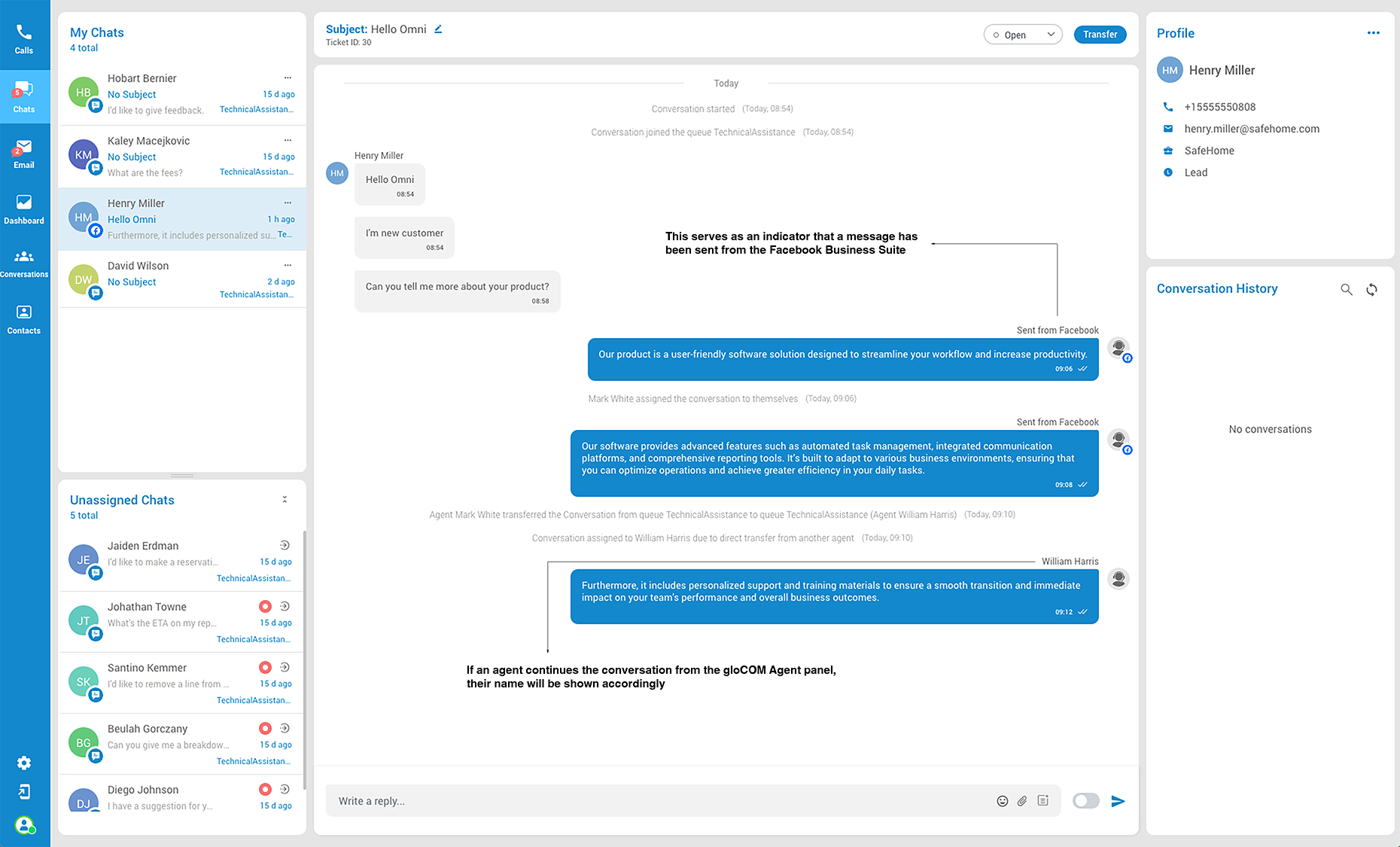
-
Answering from Facebook Business Manager: If a user responds to a conversation in the Agent panel that originated through Omnichannel but was answered from Facebook Business Manager, the Agent panel will display "Sent from Facebook" to indicate the source of the response.
-
Continuing Conversation from Agent Panel: If an agent continues responding to an ongoing conversation directly from the Agent panel, their name will be displayed with the message.
¶ LiveChat Profile
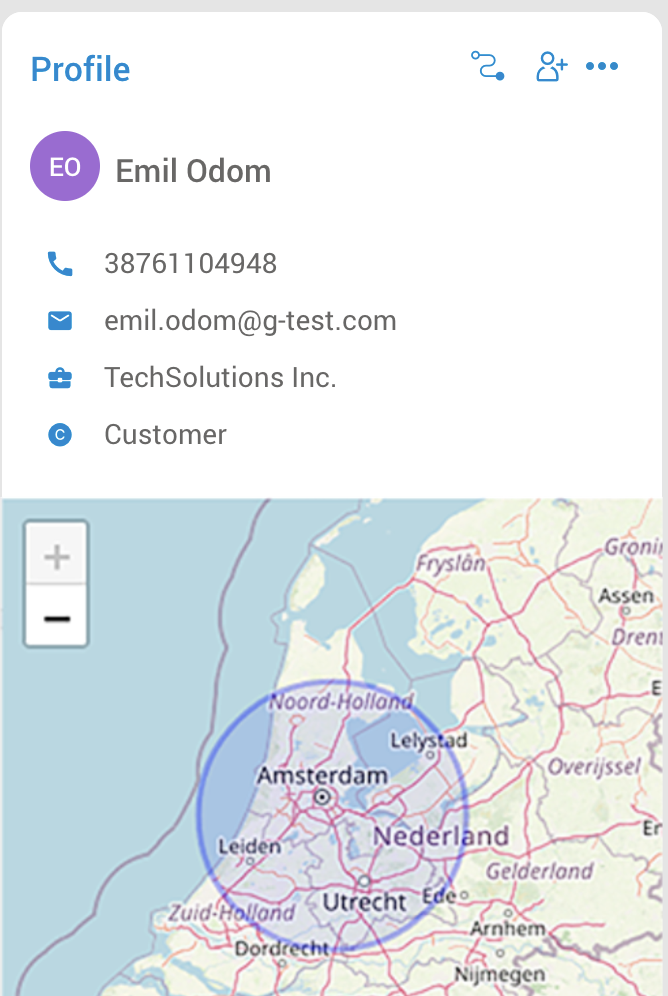
The Profile section displays customer used. Information may include:
- Name - The customer’s name.
- Email - The customer’s email address.
- Phone number - The customer’s phone number.
- Facebook Page (if available) - This identifies the customer’s Facebook page.
- Geo Location of the Customer - Knowing the customer’s geographical location provides valuable context for tailoring support services based on regional preferences or specific needs. It can also help identify trends or issues that might be localized to certain areas.
From the Profile section (top-right) agents have the ability to:
-
Link/unlink a conversation to existing Contact - Opens a view listing suggested contacts and a search field for finding additional contacts.
-
Create a new contact and link the conversation to it - Opens a form to input new contact information; upon saving, this new contact is automatically linked to the conversation.
-
Ban Customer - Restrict interactions with specific customers.
Linked conversations differ from unlinked conversations in that when an agent links a conversation to an existing contact or adds a new contact and links the conversation to it, that conversation appears within the History section.
This section displays all linked conversations to that contact across all channels. So, if a customer contacts agents over time via voice calls, SMS, email, Facebook, etc., all conversations will be visible within the History section. (This info will be provided if agents have linked conversations to that particular customer)
This helps agents provide better service by allowing them to refer back to past conversations for context. Overall, it simplifies support, enabling agents to offer personalized assistance more effectively.
How to Link Conversation
To link unlinked tickets, you can opt to connect them to an existing contact or create a new one. If you choose to link to an existing contact, you can browse or search for them from a dropdown menu displaying suggested contacts.
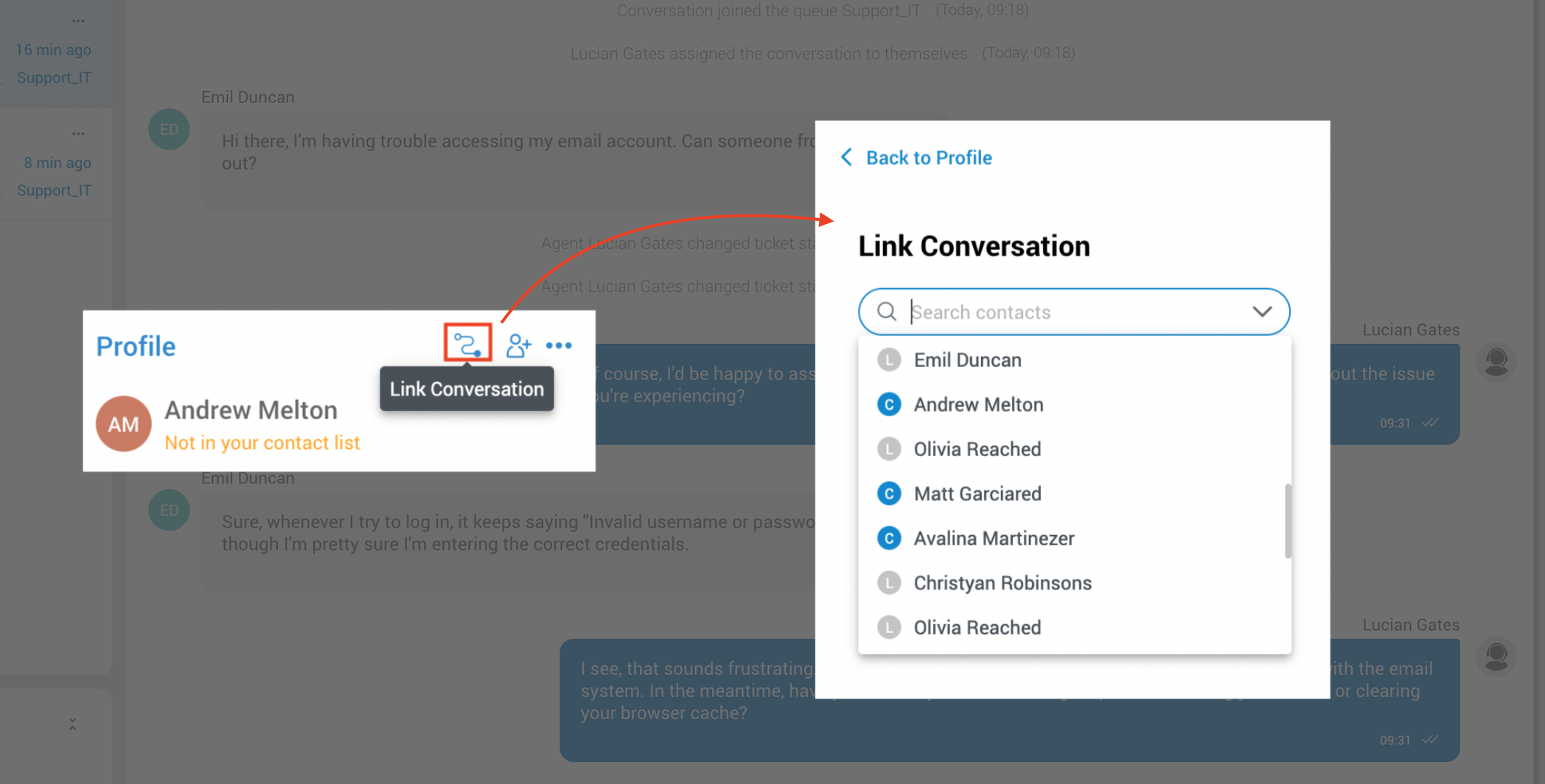
Alternatively, if you’re creating a new contact, simply fill out the information form and save it to automatically link the conversation.
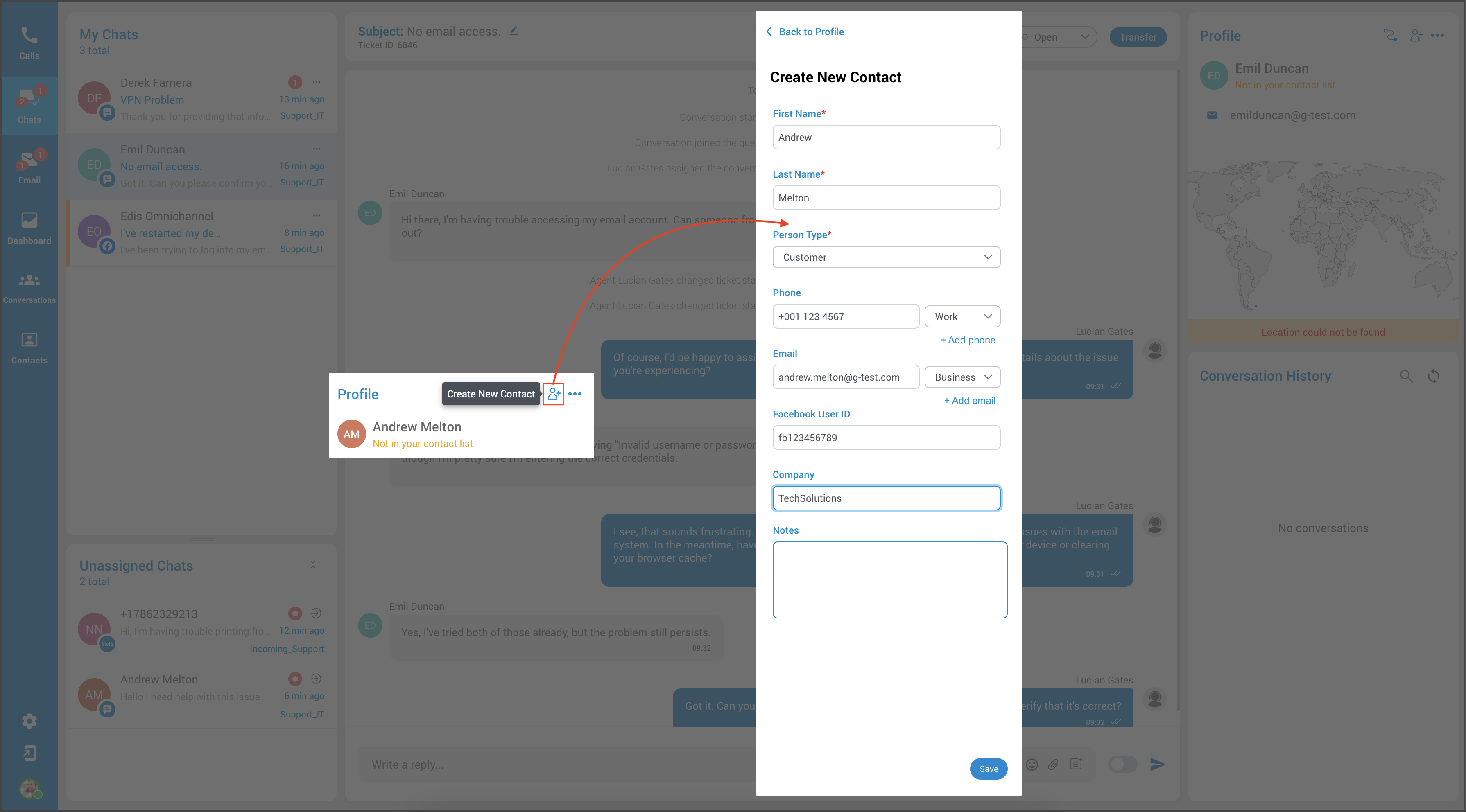
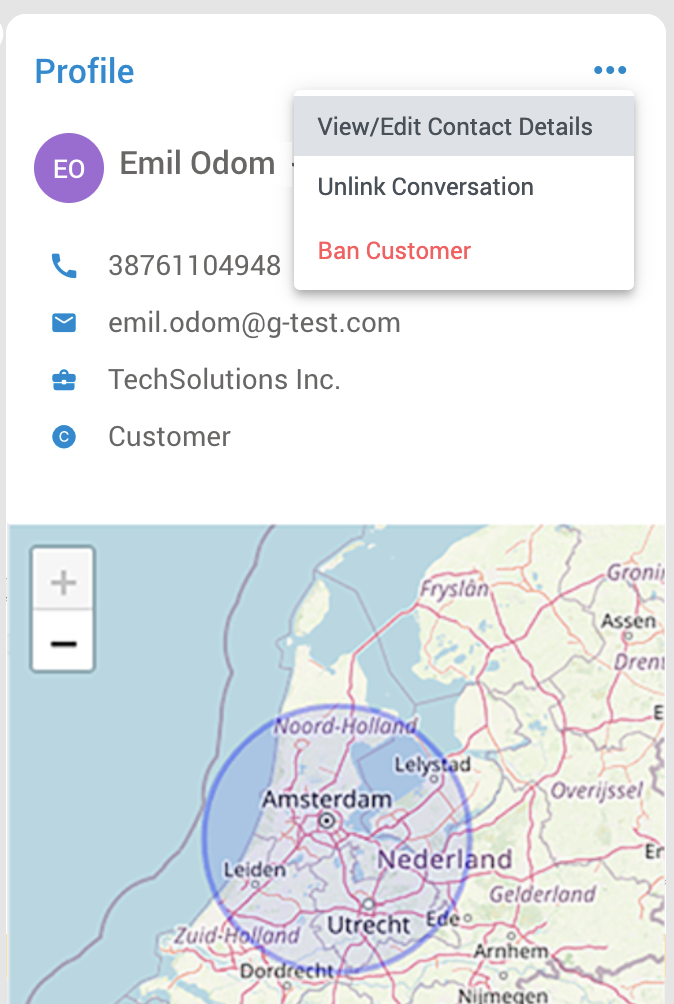
For tickets already linked to a contact, the Profile Card provides all available contact information. In the three dots menu, agents will find additional options:
- View/Edit Contact Details - Allows access to and modification of the contact’s information.
- Unlink Contact - Detaches the current conversation from the linked contact.
- Ban Customer - Restrict interactions with specific customers.
¶ Ban Customer (LiveChat only)
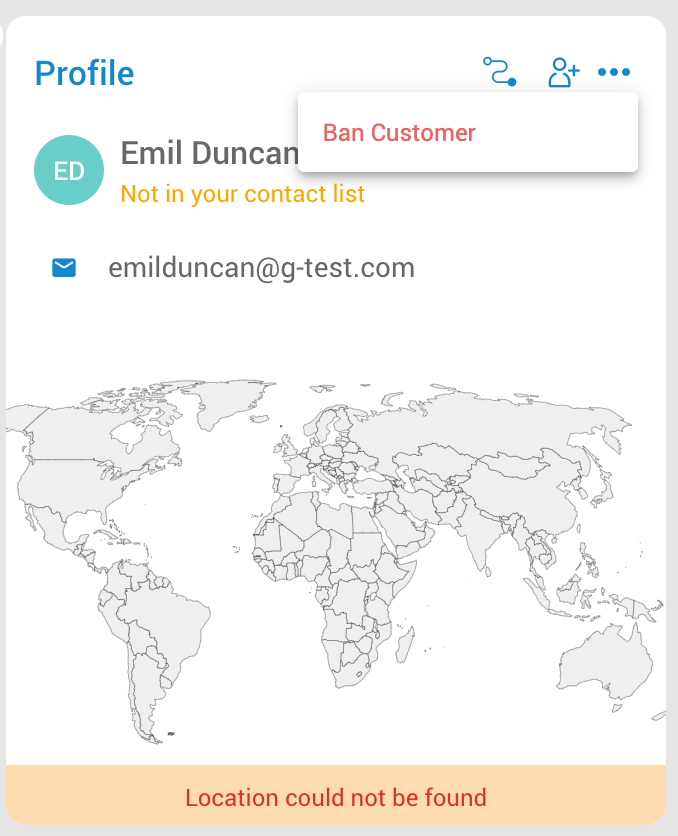
Another valuable feature within this section is the Ban Customer option. This functionality empowers agents to restrict interactions with specific customers with whom they are presently engaged, preventing those banned customers from either continuing ongoing conversations or initiating new ones.
To initiate the ban, agents simply need to click the three-dot button within the interface and then select the 'Ban Customer' option.
Hereafter, a new window will open within the agent panel. In this window, agents are provided with the capability to specify the duration for which the ban will remain in effect.
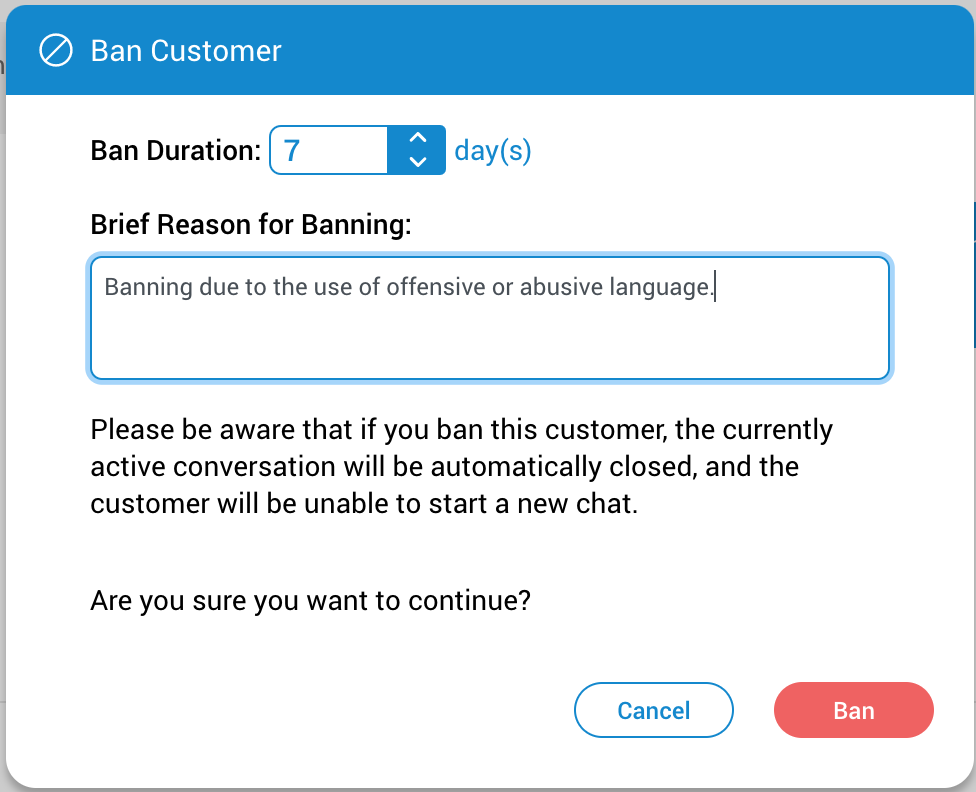
Furthermore, they are required to provide a clear and valid reason for the customer's ban, ensuring that the cause behind the action is well-documented.
Common reasons for banning customers include harassment of call center agents, use of offensive language, making false claims, repeated violations of terms of service, or engaging in fraudulent activities.

By selecting the 'Ban' button, the agent initiates a ban on the current customer. As a result, a short notification will appear, and the ongoing conversation with that customer is automatically terminated.
The list of banned customers can be found under Settings >> Security section.
¶ Conversation History
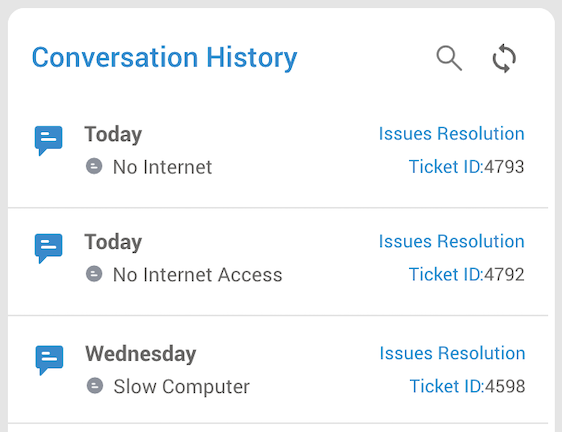
The Conversation History feature allows agents to access the full history of past conversations with a particular customer. This list is automatically updated every five minutes, or agents can manually refresh it at any time.
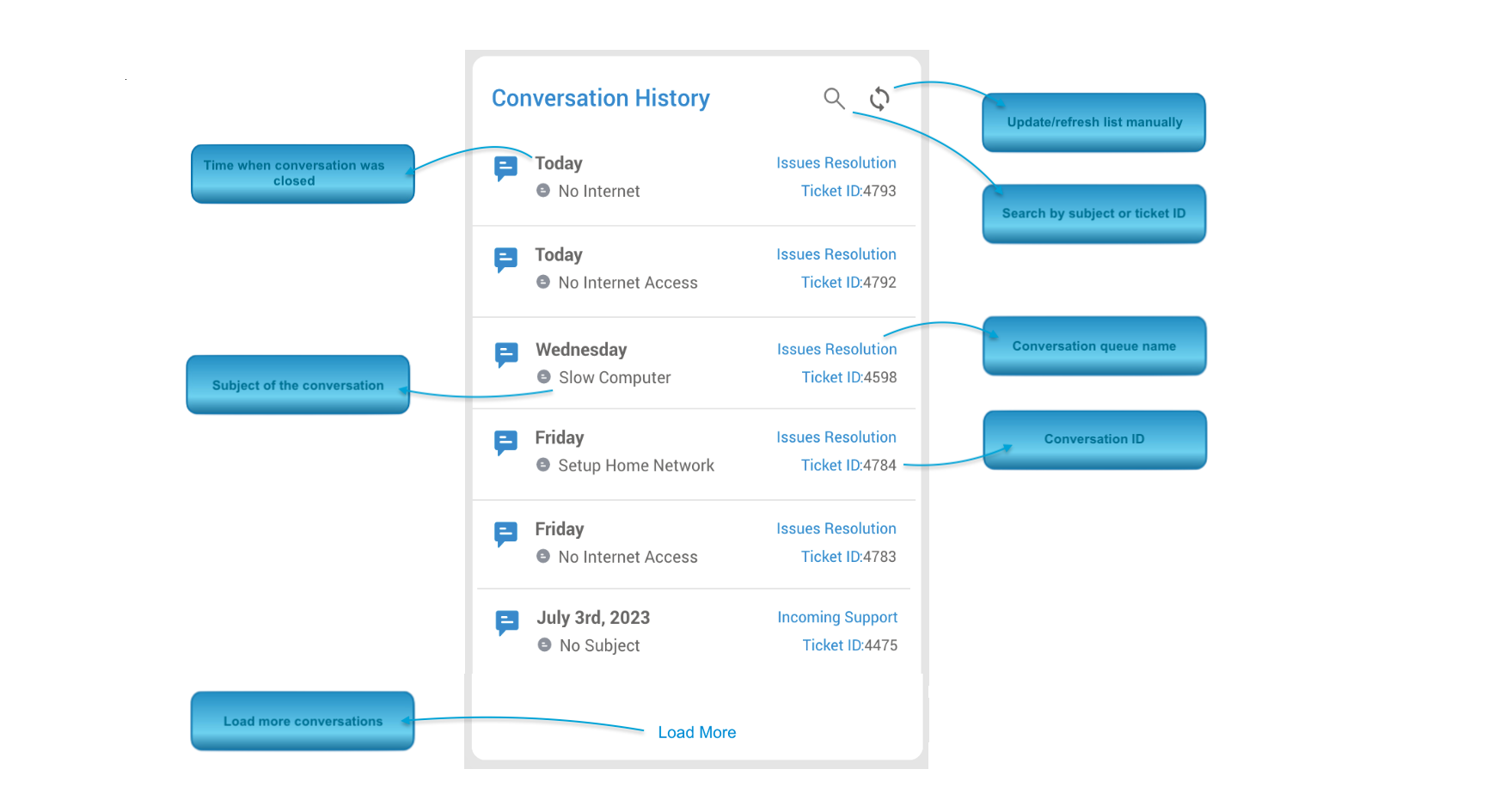
By default, the Conversation History section displays up to eight closed conversations at a time. Agents can load more conversations by clicking the 'Load More' button at the bottom of the list.
By clicking on a specific conversation, agents can view the entire chat log, as well as any attachments or notes associated with the conversation.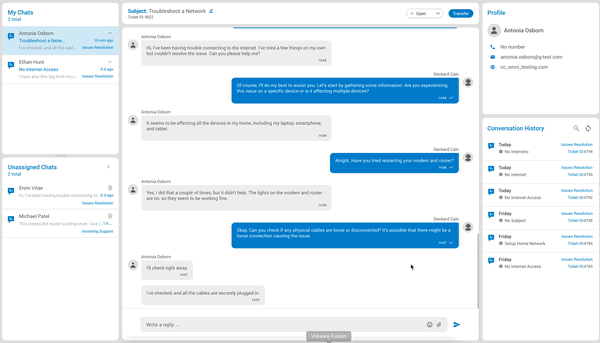 The chat log is displayed in chronological order, with the most recent message displayed at the top.
The chat log is displayed in chronological order, with the most recent message displayed at the top.
This feature is especially useful for agents who need to quickly access information from previous conversations, such as customer preferences or previous issues. With access to this historical data, agents can provide more personalized and effective support to customers.
To expand desired chat, the Agent can simply select/click on the closed conversation within this window.
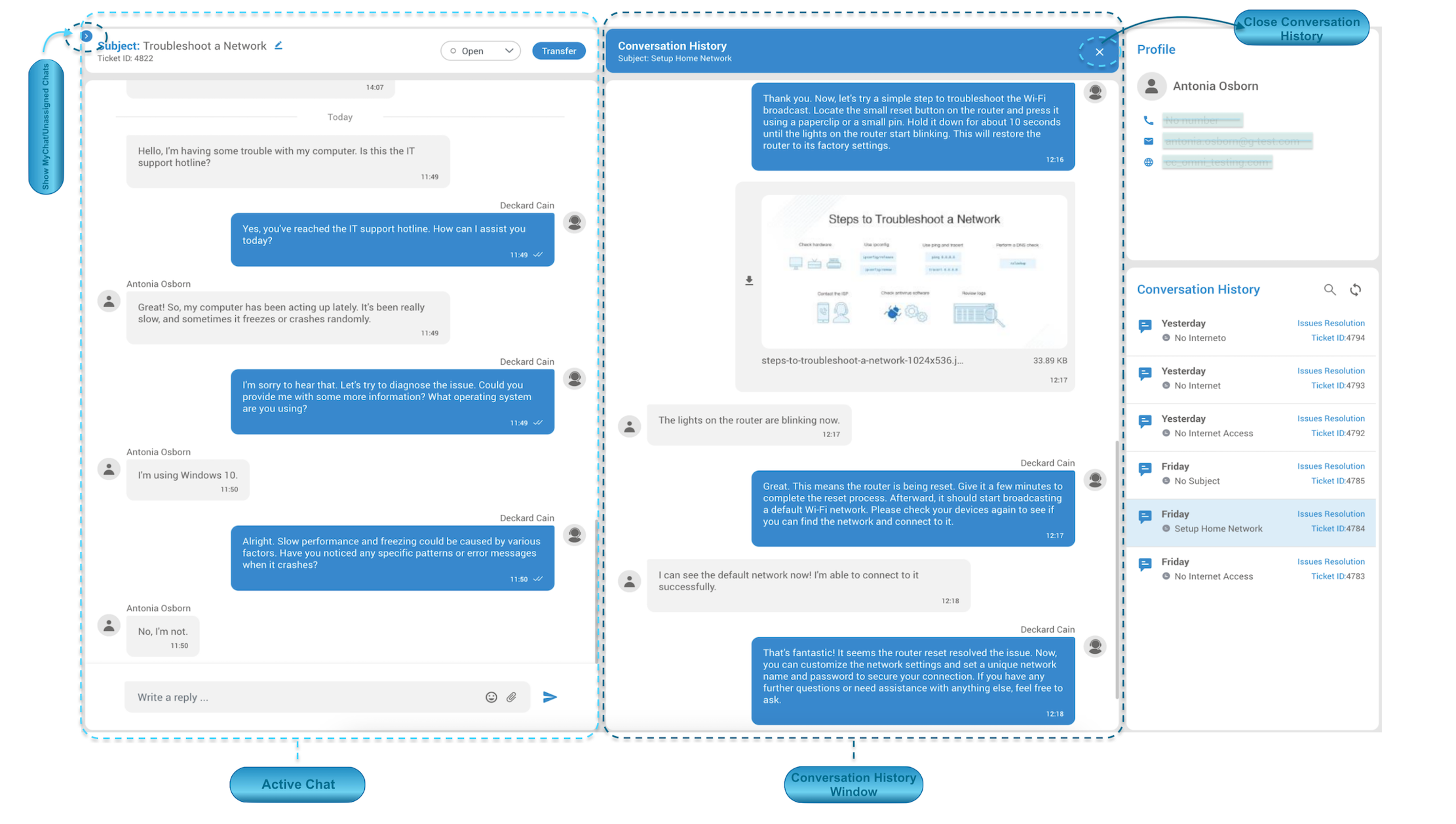
The 'Email' section within the gloCOM Agent Edition holds significant importance by offering agents comprehensive insights into ongoing and resolved email conversations.
This component plays a vital role in the omnichannel setup as it easily enables a seamless transition between ways of talking to customers.
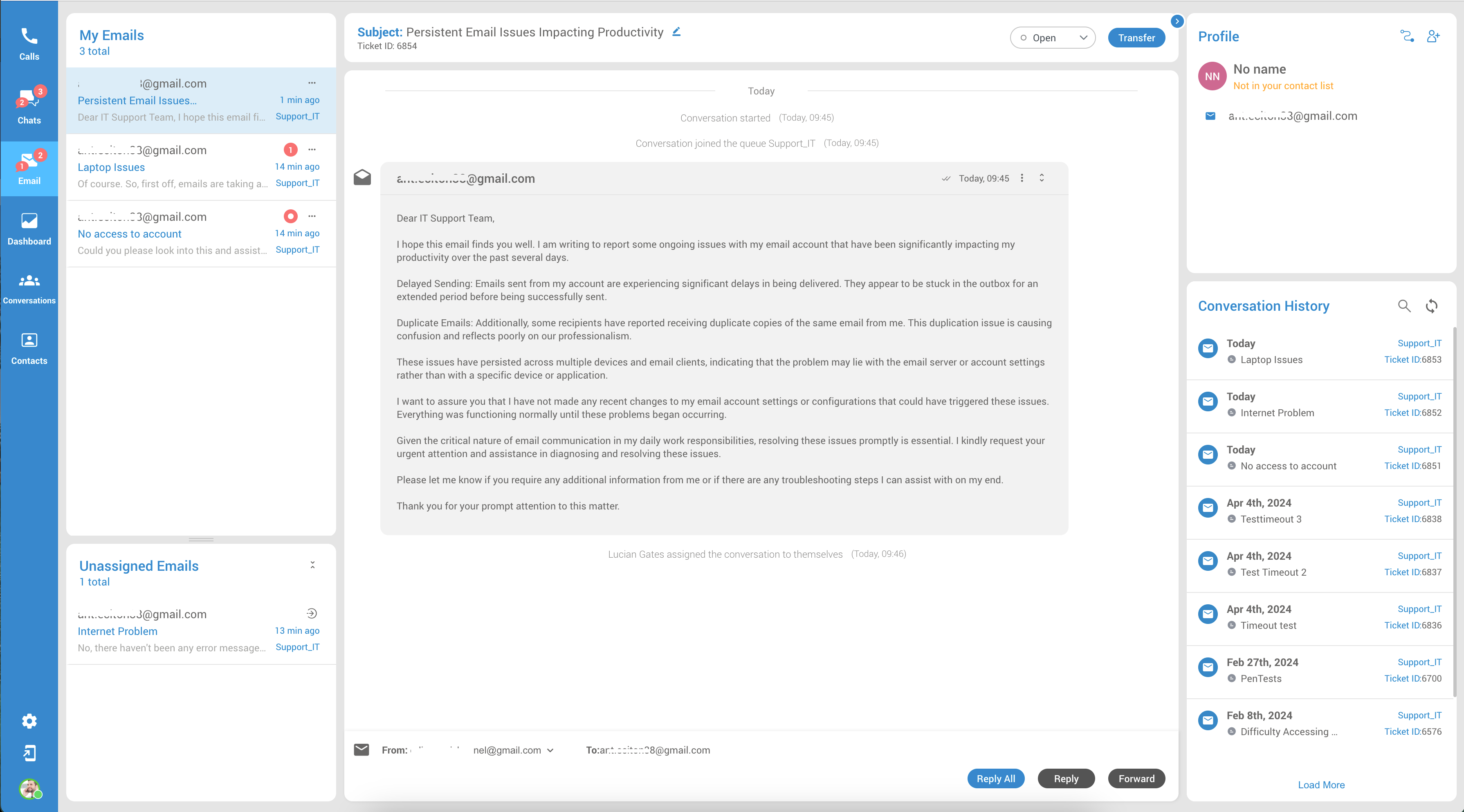
With email added, agents can explain things well, share files, and give organized responses. They can also follow up on past talks, which keeps customers happy and stops them from repeating things.
The Email landing page is divided into six sections, each representing the following:
¶ My Emails
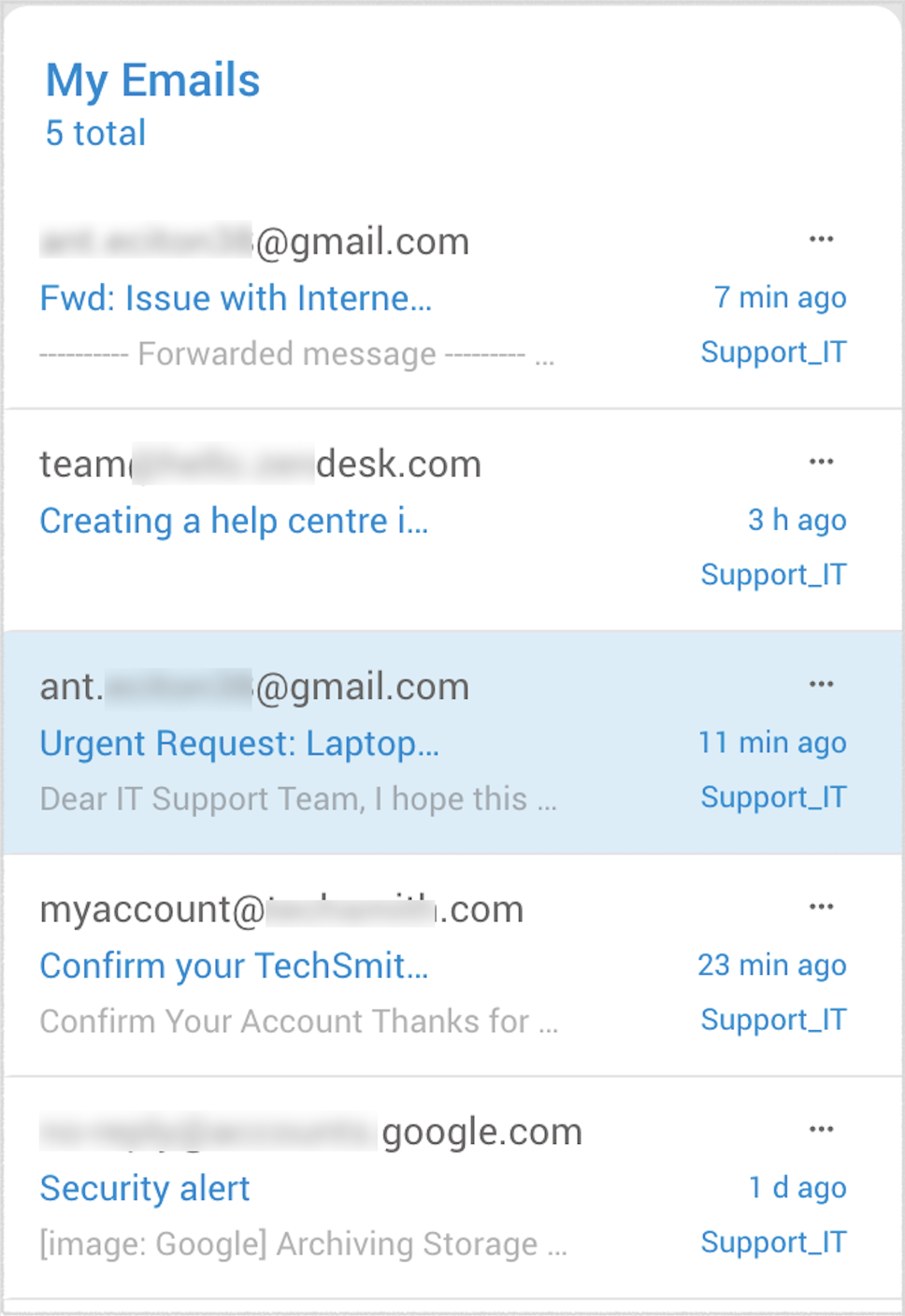
The MyEmail feature simplifies handling email conversations assigned to agents. In this application section, agents can access details about their email tasks.
This section includes the overall count of email conversations assigned to them, as well as the number of conversations requiring replies.
Additionally, MyEmail provides other relevant information:
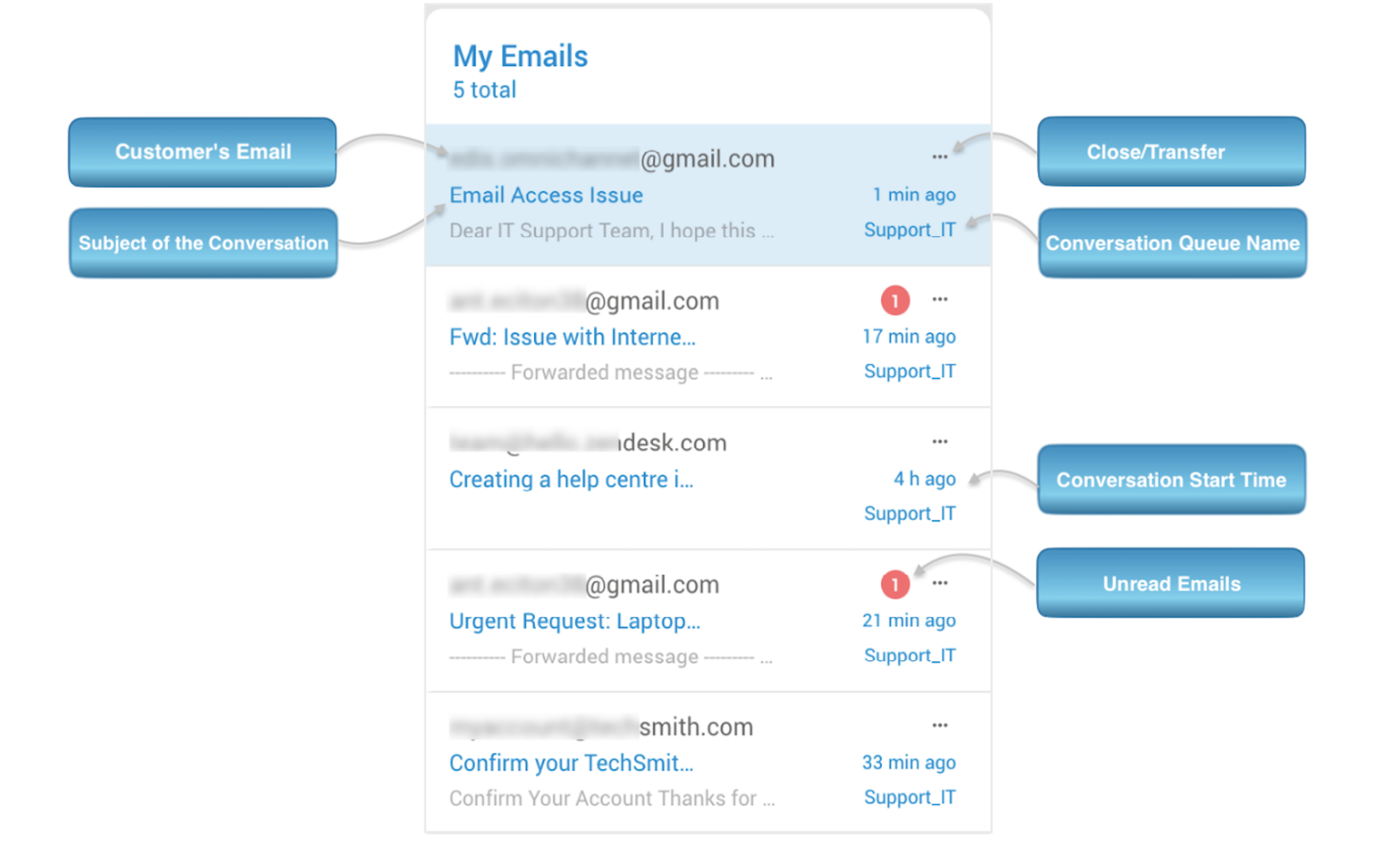
- Customer's Email: This is the email of the customer who initiated the conversation.
- Subject of the Conversation: Brief description of the problem or request.
- Close/Transfer: Additional options for close and transfer emails.
- Conversation Queue Name: This reveals the queue where the conversation originated, assisting agents in understanding its source and offering relevant support.
- Conversation Start Time: Time when the conversation was started. This gives agents a reference point for the conversation and helps them manage their time efficiently.
- Unread Emails: Represents the number of unread emails.
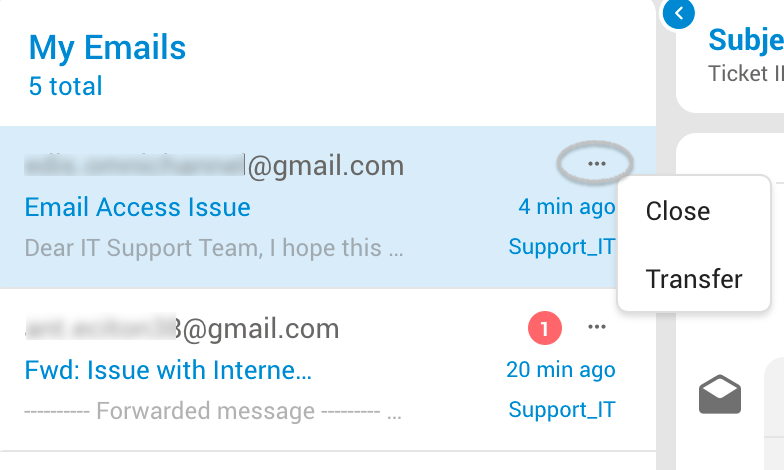
Within this section, agents can pick a particular conversation to continue helping the customer. Agents have the option to transfer chosen conversations to other agents or queues, or they can decide to close the conversation after it's done.
Close Conversation
When agents choose a conversation and click the "Close" option, the selected conversation will be permanently closed. As a result, it will be removed from the "MyEmails" section and archived in the "Conversation History."
Transfer Conversation
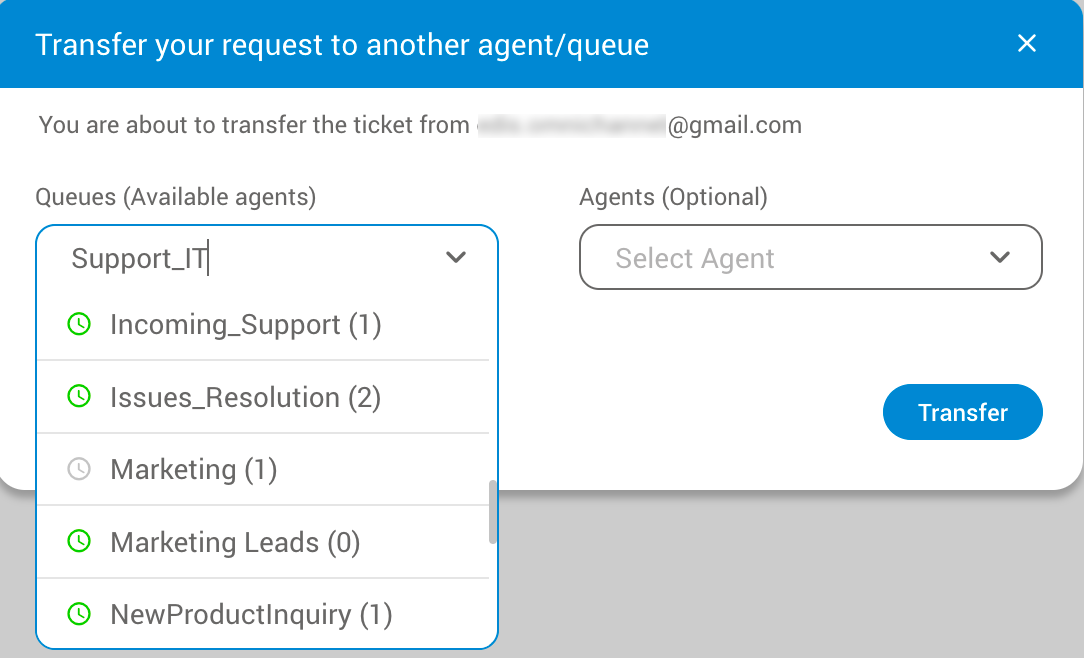
A new window will pop up when the agent selects a conversation and clicks on the "Transfer" option. From there, the agent can choose the queue to which the selected conversation will be transferred or select the specific agent to whom the conversation will be assigned.
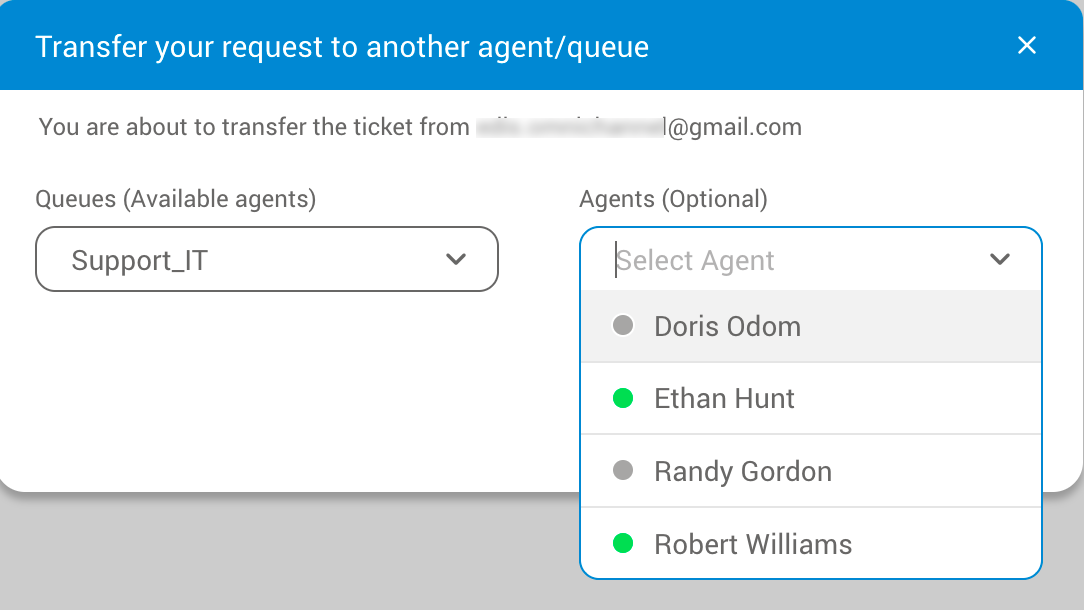
If chat is transferred directly to the Agent, it will be automatically assigned to that specific Agent (no matter which queue the Agent belongs to). Otherwise, if the conversation was transferred to the Queue where no Agents were selected, it will be sent to unassigned conversations for the selected Queue.
¶ Unassigned Emails
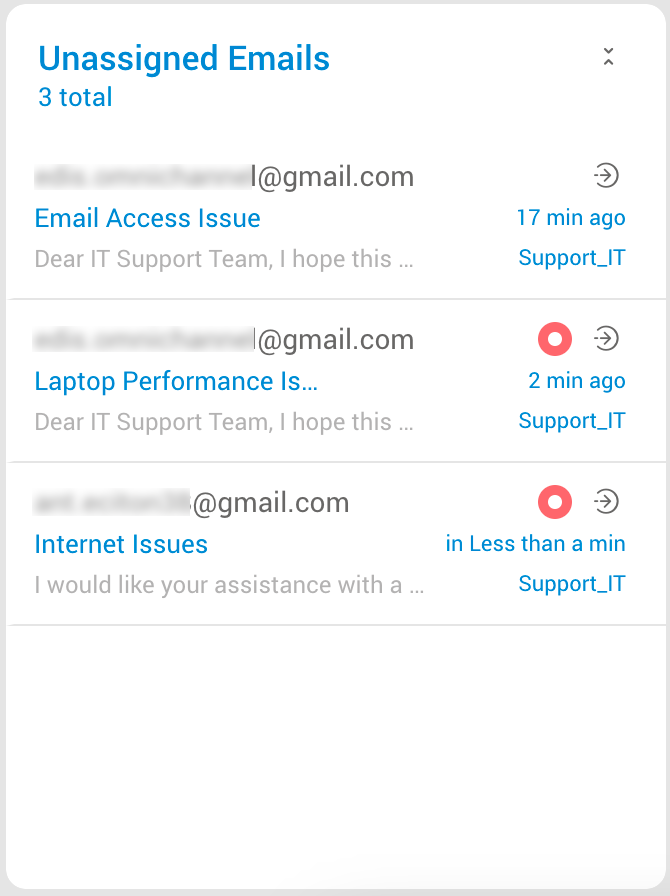
The Unassigned Emails part of the application shows details about conversations that haven't been assigned to any specific agent yet. It lets agents see which conversations are waiting for a reply and gives them the option to take responsibility for these conversations.
For each unassigned conversation, the section displays the following information:
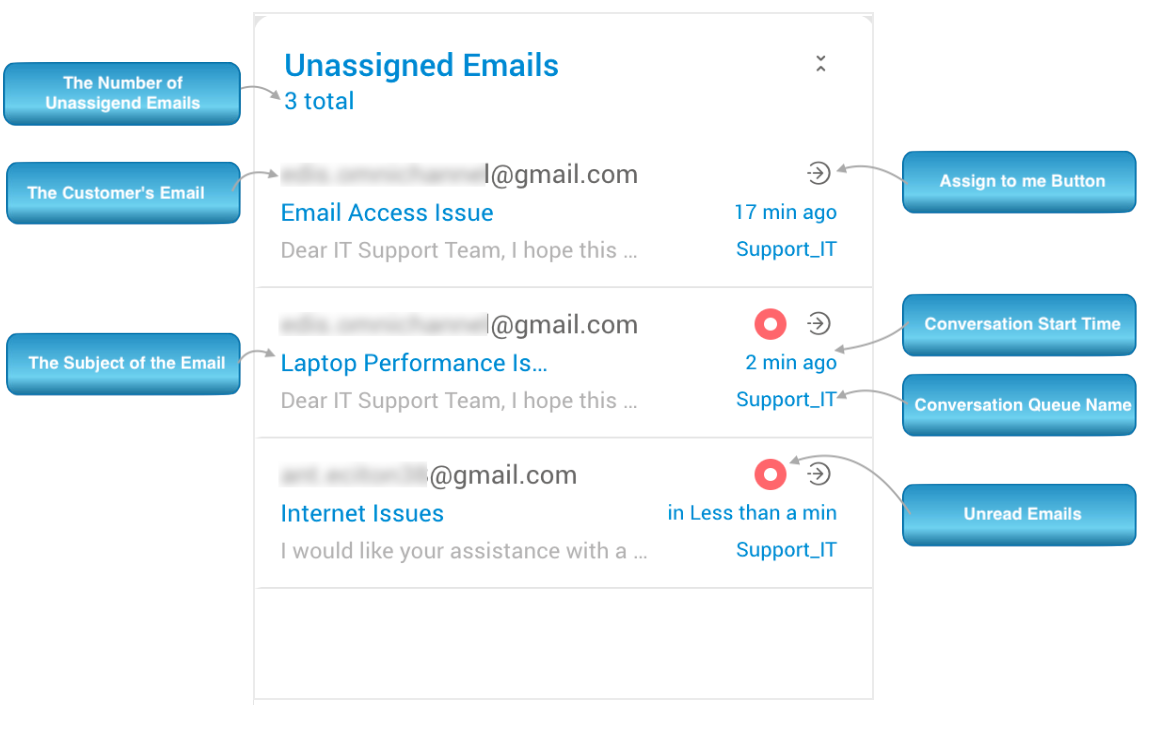
- The Number of Unassigned Emails - This represents the number of unassigned emails.
- The Customer's Email - This helps agents identify the customer they are talking to and personalize their interactions.
- Subject of the Conversation: Brief description of the problem or request.
- Assign to me Button: This button allows the Agent to manually assign emails to themselves, indicating they are willing and able to take on the conversation. This is especially useful when the queue is busy and automatic routing is delayed, or when the conversation requires specific expertise that only the Agent possesses.
- Conversation Start Time - Time when the customer started the conversation. This gives agents a reference point for the conversation and helps them manage their time efficiently.
- Conversation Queue Name - Name of the queue where the conversation was opened. This helps agents identify the source of the conversation and enables them to provide appropriate support.
- Unread Emails - Notification for unread Emails.
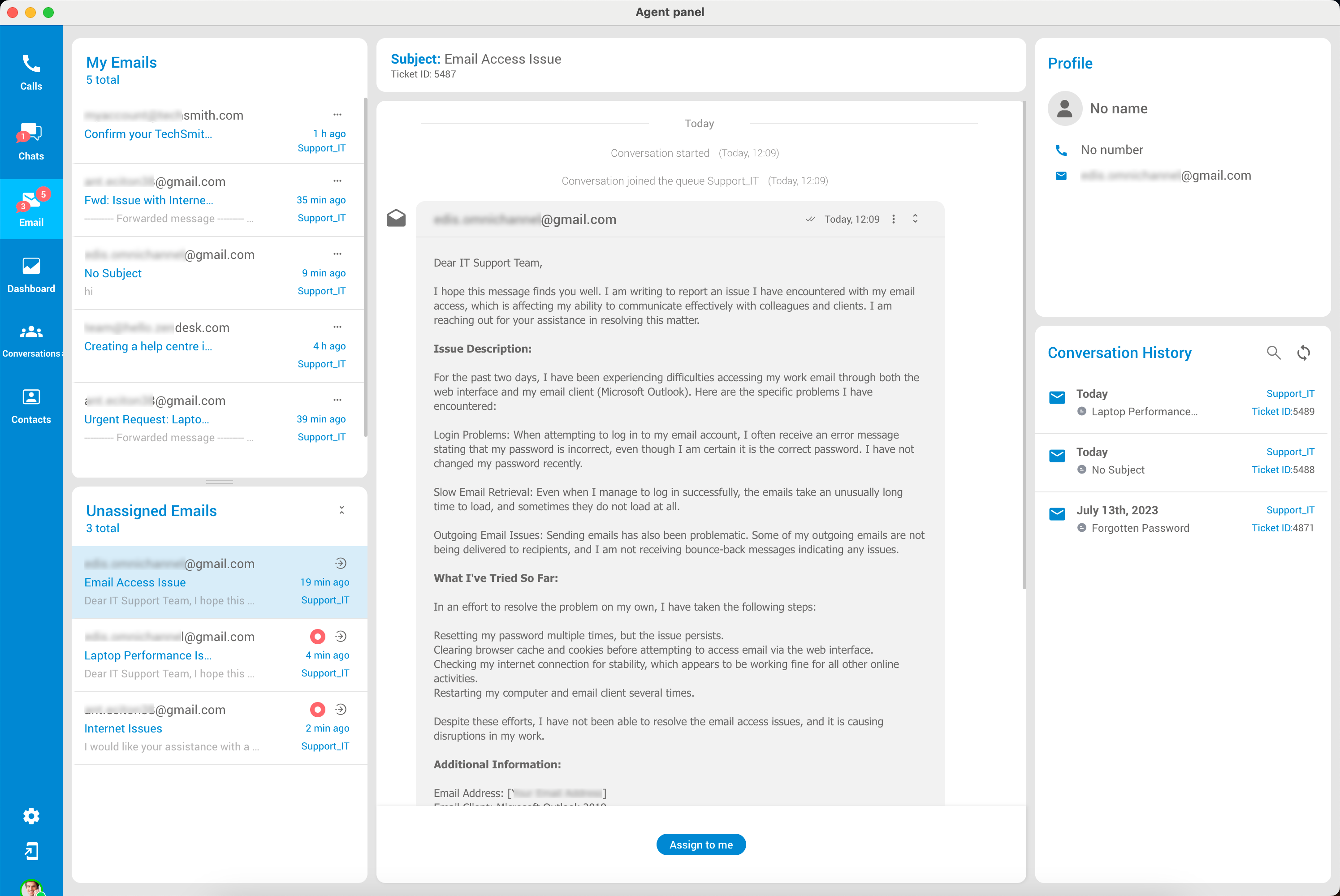
When agents click on an unassigned emails in the 'Unassigned Emails' section, they get a quick look at it. This preview gives them key details about the conversation so they can decide if it's something they can handle well.
Agents can also see the conversation's history by clicking on the conversation. This includes any files that were shared, like documents or images. This background info helps agents better understand the customer's situation and find effective solutions.
The rules for assigning conversations to agents are the same as those applied in the Chat section.
¶ Email Subject Section

Within this section, agents have the ability to modify an email conversation's status, indicating its progress or current state. Additionally, agents can edit the subject of the email conversation and easily track the conversation's unique ID.
¶ Subject of the Conversation
Agents can edit the subject of the conversation in this section. This can be particularly useful for ensuring that completed conversations are easy to find and review, especially if the conversation involves a complex or nuanced issue.
¶ Email Conversation Statuses
Email conversations in the system can have four different statuses that reflect their current stage or state:
Open Status
This status is assigned automatically when an email conversation is given to an agent, either through manual or automatic assignment.
Waiting Status
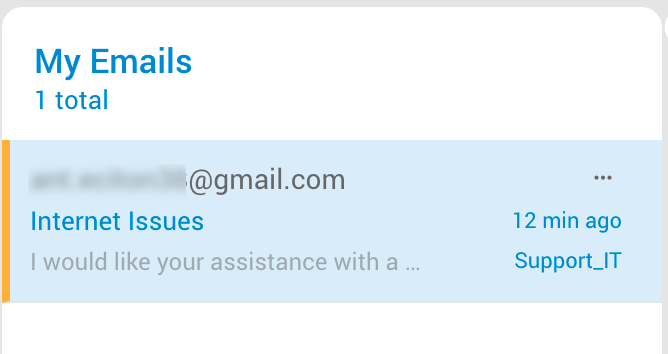
The "Waiting" status shows that the agent is waiting for more information from the customer. This could be specific details like ID numbers or operating system info needed to assist the customer.
Solved Status
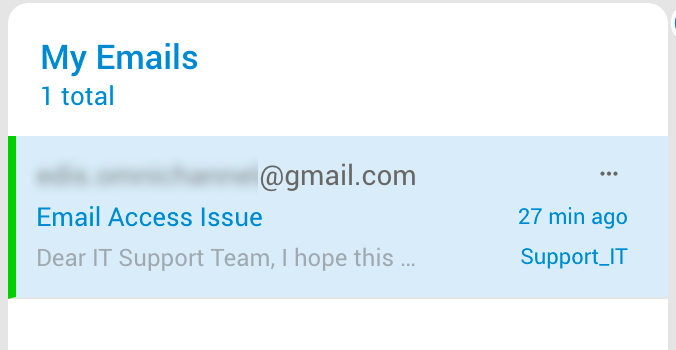
When an email conversation is marked as "Solved," it means the agent has finished helping and resolving the issue. However, customer confirmation is still needed. The agent might have fixed the problem or provided a solution, but it's important to make sure everything is working for the customer. After the customer confirms they're satisfied or gives more feedback, the email can be closed.
Closed Status
The "Closed" status lets agents mark an email as done. Once closed, the conversation moves from the agent's active list to the conversation history for reference.
¶ Transfer Conversation

The Transfer button enables agents to move a chosen chat or conversation to another agent or queue. When transferring to another agent, the selected agent becomes the new owner, regardless of their queue. If transferred to a queue, the chat goes to that queue's unassigned conversations section.
¶ Email Conversation Card
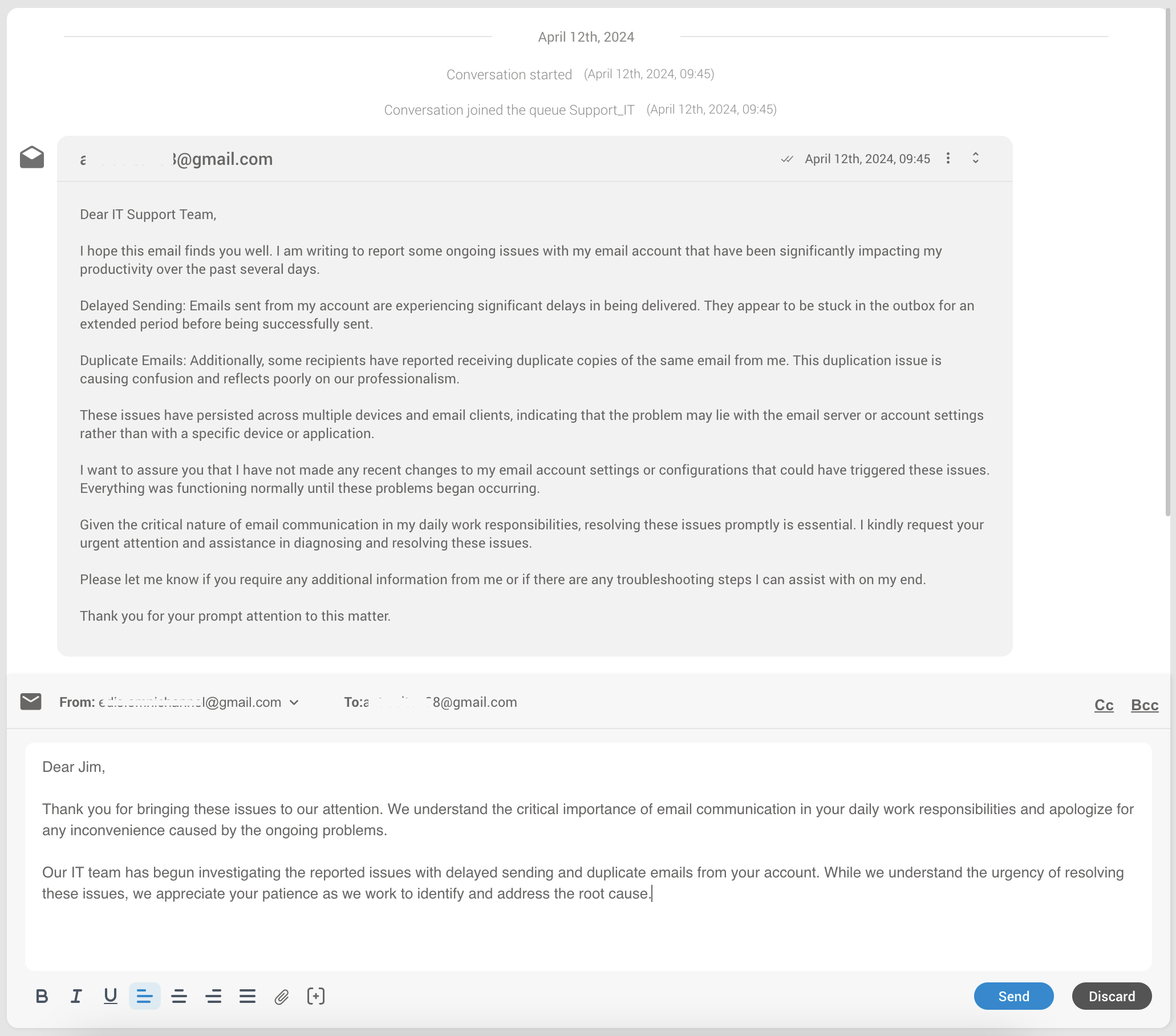
The application includes an email-based communication feature that enables agents to send and receive emails.
During a conversation with a customer, agents have the ability to scroll through the conversation history, facilitating a quick review of previous discussions.
Similarly to MyChats, when agents select a conversation/email, the conversation card on their screen provides a quick overview of all the important details. This card includes information about when the conversation started, its associated queue, and details about the assigned agent. If the conversation was transferred, it also displays who initiated the transfer and when.
¶ Email Profile
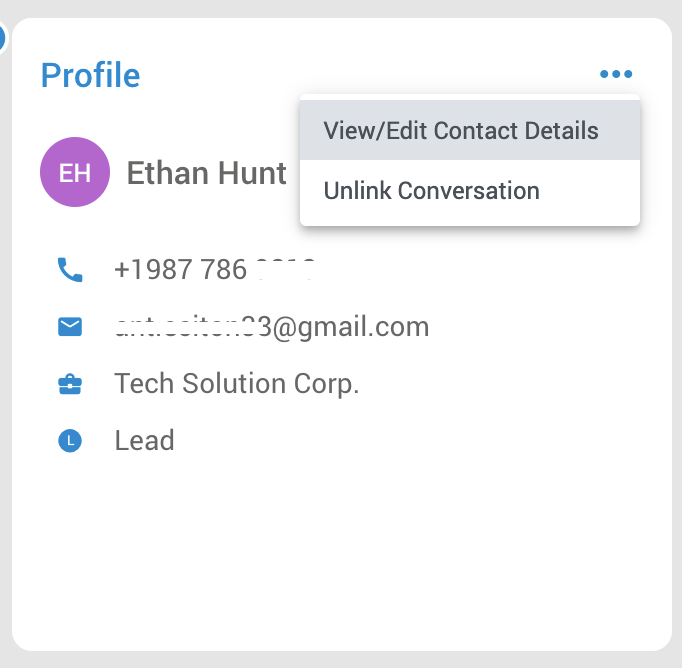
The Profile Card displays customer information which varies based on the communication channel used.
From the Profile section agents have the ability to:
- Link/unlink a conversation to existing Contacts - Opens a view listing suggested contacts and a search field for finding additional contacts.
- Create a new contact and link the conversation to it - Opens a form to input new contact information; upon saving, this new contact is automatically linked to the conversation.
Linked conversations differ from unlinked conversations in that when an agent links a conversation to an existing contact or adds a new contact and links the conversation to it, that conversation appears within the History section. This section displays all linked conversations to that contact across all channels. So, if a customer contacts agents over time via voice calls, SMS, email, Facebook, etc., all conversations will be visible within the History section. (This info will be provided if agents have linked conversations to that particular customer)
This helps agents provide better service by allowing them to refer back to past conversations for context. Overall, it simplifies support, enabling agents to offer personalized assistance more effectively.
How to Link Conversation

To link unlinked tickets, you can opt to connect them to an existing contact or create a new one. If you choose to link to an existing contact, you can browse or search for them from a dropdown menu displaying suggested contacts.
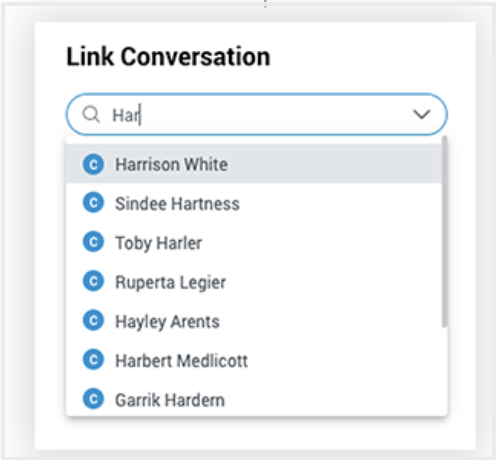
Once you find the right one, select it and confirm the link.

Alternatively, if you’re creating a new contact, simply fill out the information form and save it to automatically link the conversation.
For tickets already linked to a contact, the Profile Card provides all available contact information. In the three dots menu, agents will find additional options:
- View/Edit Contact Details - Allows access to and modification of the contact’s information.
- Unlink Contact - Detaches the current conversation from the linked contact.
¶ Email Conversation History
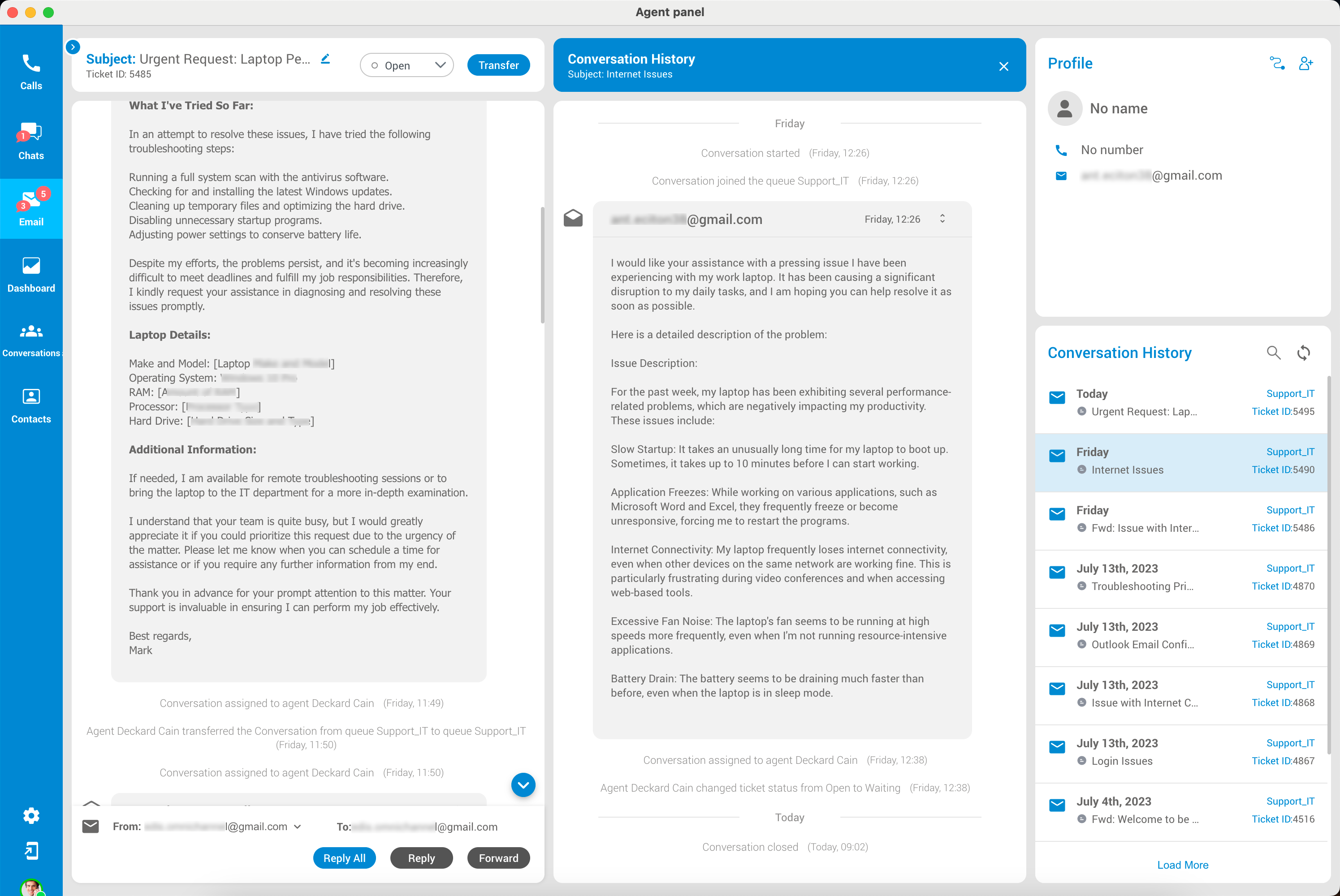
The Conversation History feature empowers agents to access the complete record of past conversations with a specific customer. This list is automatically updated every five minutes, or agents can manually refresh it whenever needed.
By selecting a specific conversation, agents can review the entire chat log, along with any attachments or notes associated with that conversation. The chat log is presented in chronological order, with the most recent messages displayed at the top.
The Agent can select/click on the closed discussion within this window to expand desired conversation.
By default, the Conversation History section shows up to eight closed conversations at a time. Agents can load more conversations by simply clicking the 'Load More' button at the bottom of the list.
¶ Dashboard
The Dashboard serves as the agent's control center, offering a holistic view of their activities and performance. It's a centralized hub that provides a comprehensive overview of their interactions across voice and messaging channels.
Additionally, the Dashboard includes a dedicated section for queue monitoring, enabling agents and supervisors to track the activity and workload of their assigned queues efficiently. The 'My Performance' tab offers valuable insights into their daily activities. Three main sections are:
¶ Agents
The Agent Dashboard displays important information about the agent's activities on different channels and conversations. When agents open this section, they will be prompted with the info about all other agents they are working with across the system. This information proves valuable when agents require assistance from their peers or supervisors.
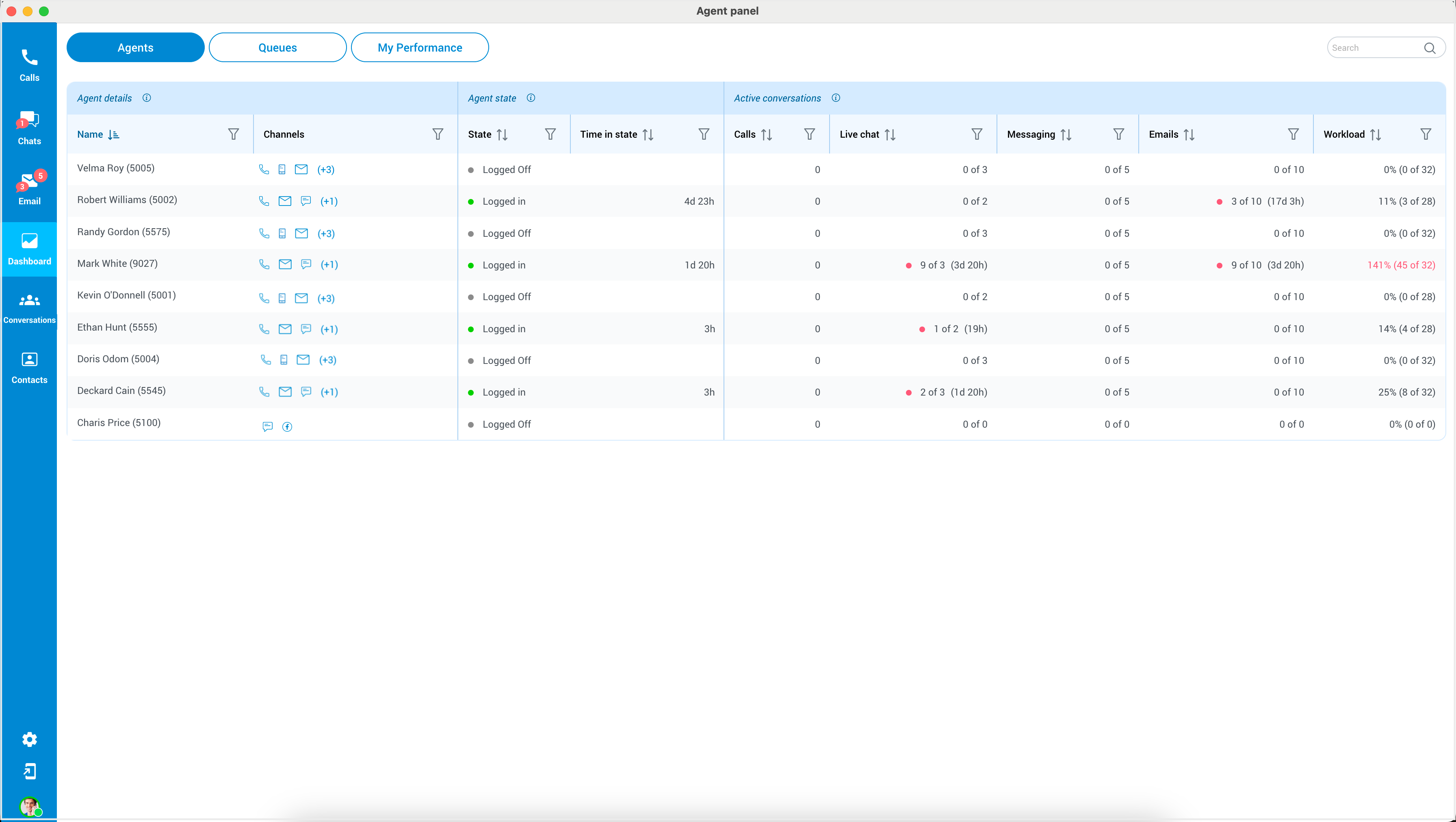
The dashboard has three sections:
- Agent Details

Within this section, users will find details about each agent, including their Name and the Channels for which they provide support.
To access more information about a specific agent,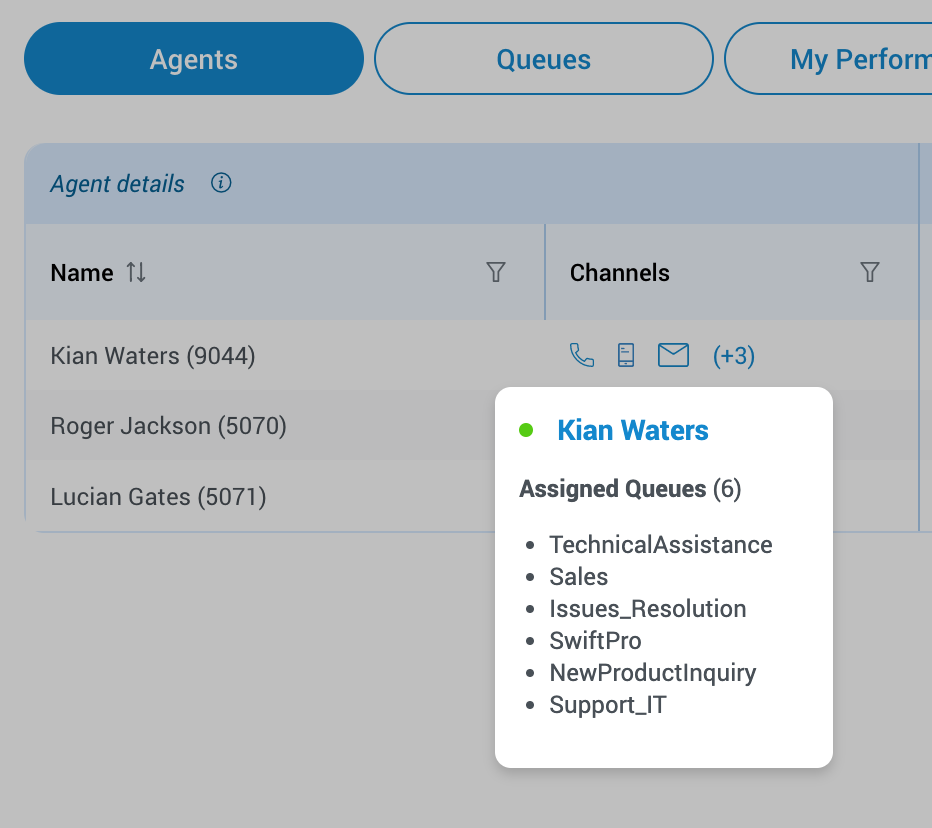 hover over their name and click the adjacent
hover over their name and click the adjacent ![]() button. This action will provide users with insights into the agent's current state and all the queues they are associated with.
button. This action will provide users with insights into the agent's current state and all the queues they are associated with.
 For a comprehensive understanding of the columns labeled 'Name' and 'Channels,' click on the icon next to the "Agent Details" label. This will provide users with detailed descriptions of these columns.
For a comprehensive understanding of the columns labeled 'Name' and 'Channels,' click on the icon next to the "Agent Details" label. This will provide users with detailed descriptions of these columns.
Users also have the option to filter agents based on their name or the channels they are actively working with.
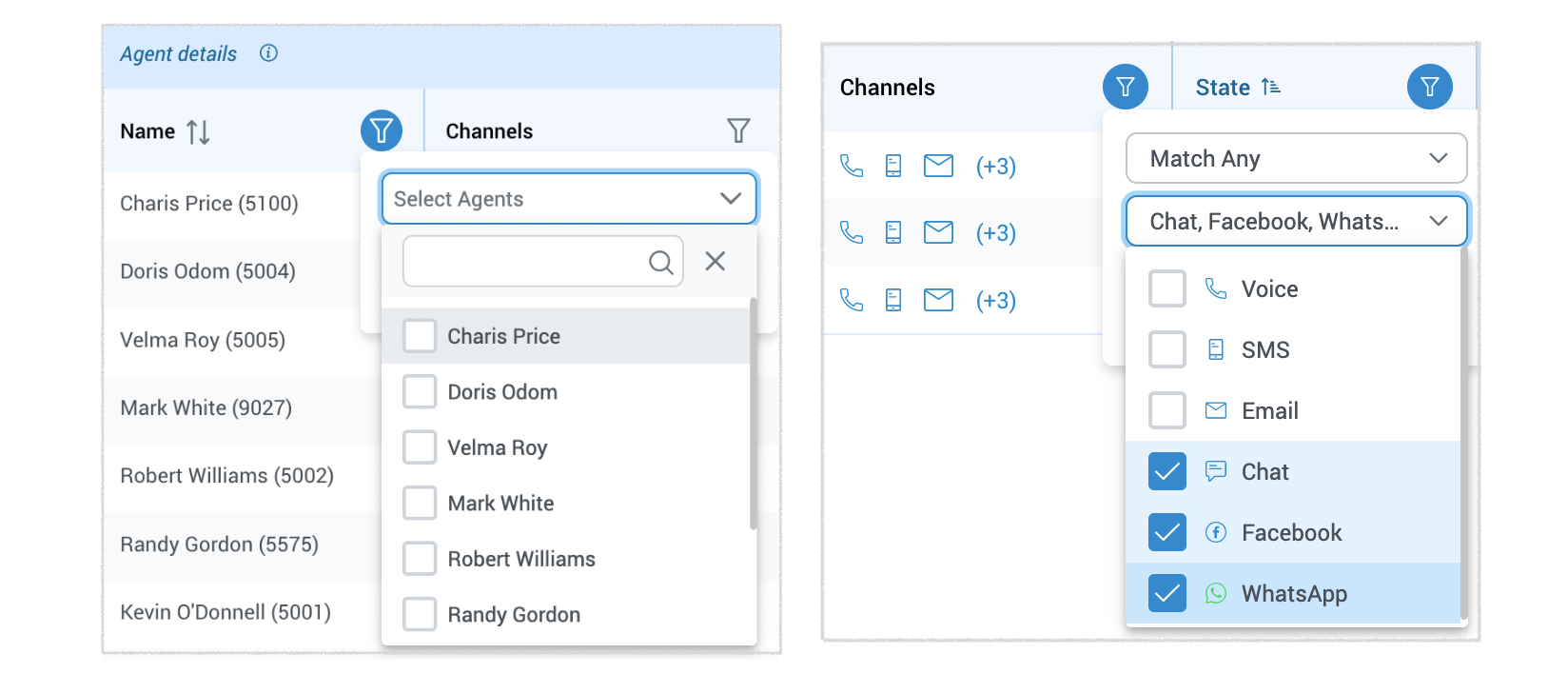
- Agent State
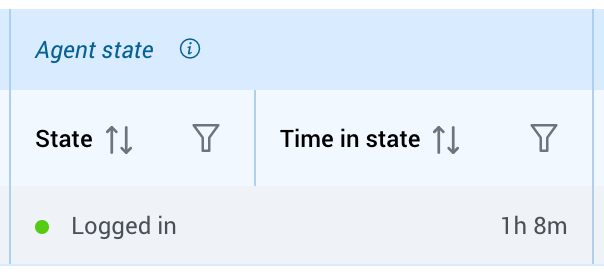
This section represents the agent's login state and how long they have been in that state. The following states are possible:
- Logged off - The agent is not currently available to handle any queue, possibly because they are not scheduled to work or are facing technical issues.
- Logged In - The agent is actively available to handle customer requests.
- Paused - The agent is momentarily unavailable for customer requests, which might be due to breaks, lunch, meetings, or other reasons.
To gain a thorough grasp of the "State" and "Time in State" columns, click on the icon adjacent to the "Agent State" label.
click on the icon adjacent to the "Agent State" label.
Users are also empowered to filter agents by their login state or the time in that state.
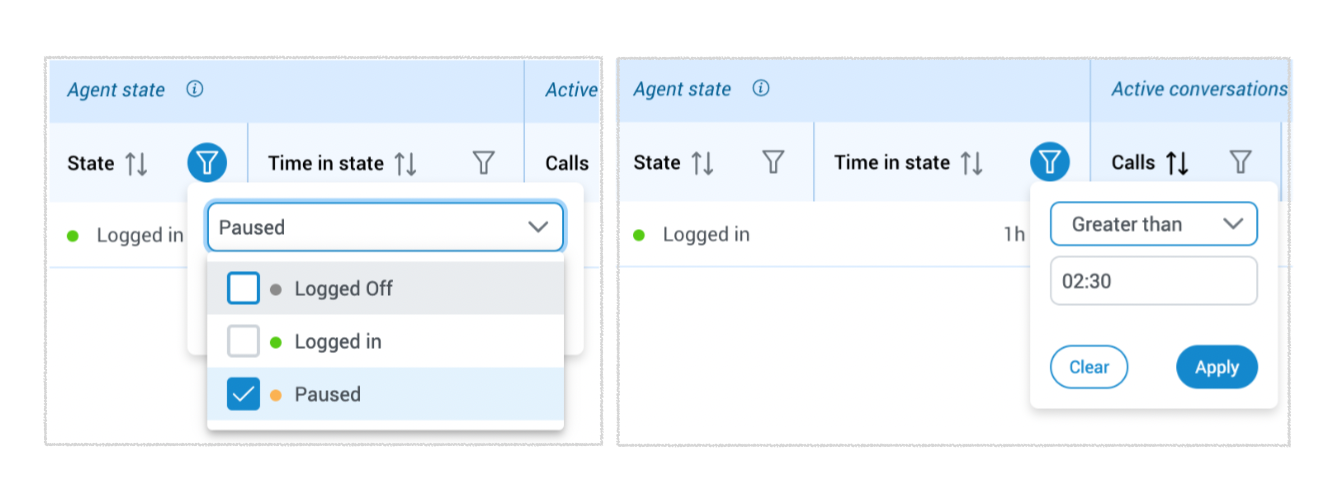
- Active Conversations

This section displays the number of active conversations on each communication channel and their duration. It also shows the workload capacity of the agent. Also, the following information is displayed:
- Calls - Represents the number of active conversations for voice communication channel.
- Live Chat - Represents the number of active conversations for live chat communication channel.
- Messaging - Represents the number of active conversations for social and SMS communication channel.
- Email - Represents the number of active conversations for email communication channel.
- Workload - This number, calculated using specific formulas and adjustable on the PBX system, represents the percentage of the agents' workload within all queues they are a part of. It provides information about how many conversations agents currently have compared to their maximum workload capacity.
For a comprehensive understanding of each columns regarding this section, click on the icon next to the "Active Conversation" label.
click on the icon next to the "Active Conversation" label.
Users also have the option to filter active conversations based on 'Calls', 'Live Chat', 'Messaging', 'Emails', and 'Workload'.

Overall, the Agent Dashboard provides a comprehensive view of the agent's current state and activities on different channels and conversations.
To remove all applied filters, users can click the
button in the agent panel's top right corner.
¶ Queues
The Queue section page provides agents with a quick and easy way to understand the activity and workload of their Queue, allowing them to respond to customer inquiries more effectively. Within this section, agents can access information regarding the queues they are actively engaged with.
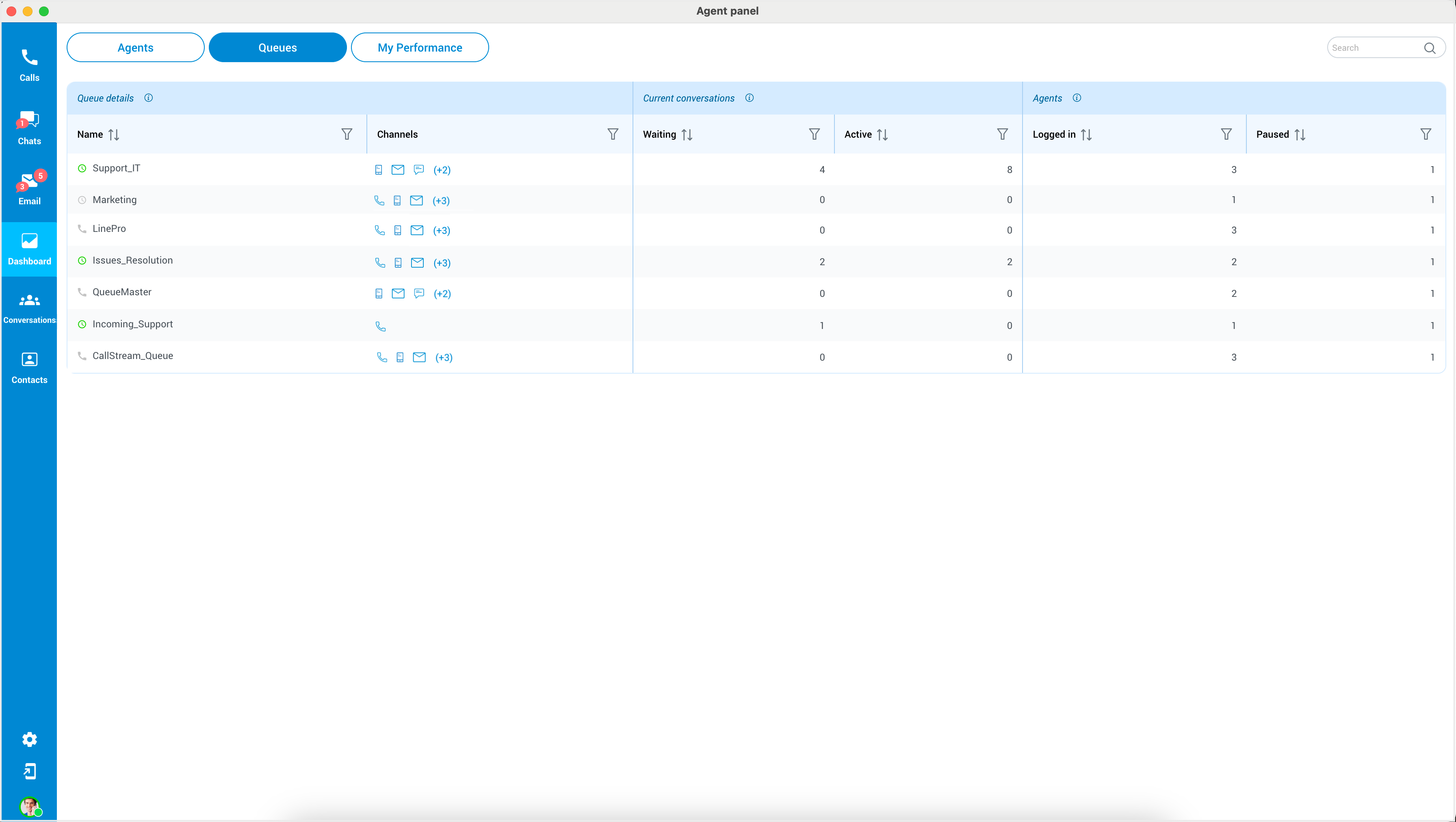
The page consists of three sections:
- The Queue Details section provides agents with important information
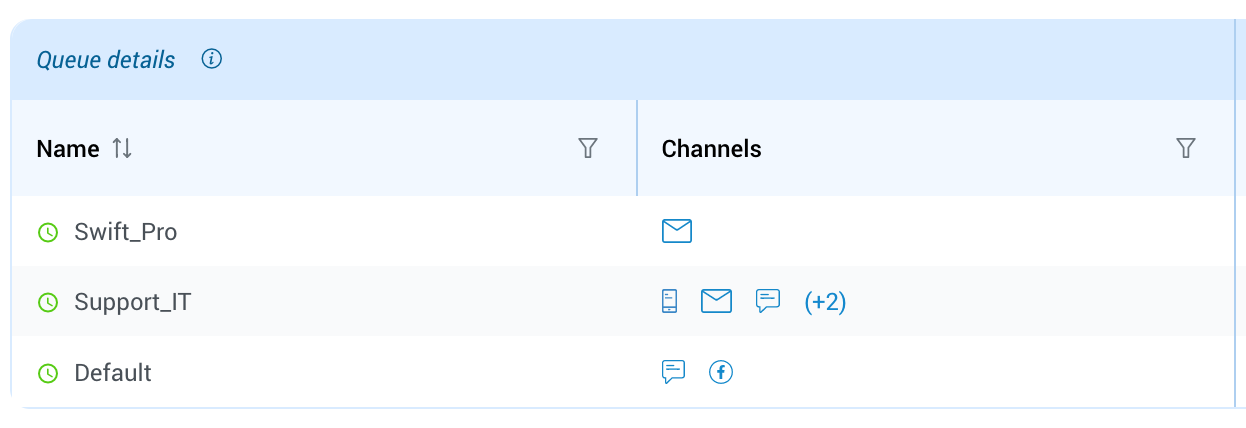 about each queue. It displays the name of the queue and the communication channels in which the queue is utilized.
about each queue. It displays the name of the queue and the communication channels in which the queue is utilized.
Furthermore, on the left side of each queue's name, there are icons that indicate the queue's operation times (OT). A green icon signifies that the queue is operational during working hours, while a gray icon indicates that the queue is not operational during non-working hours. For voice queues, a phone icon is displayed.
To access information about which agents are assigned to a specific queue,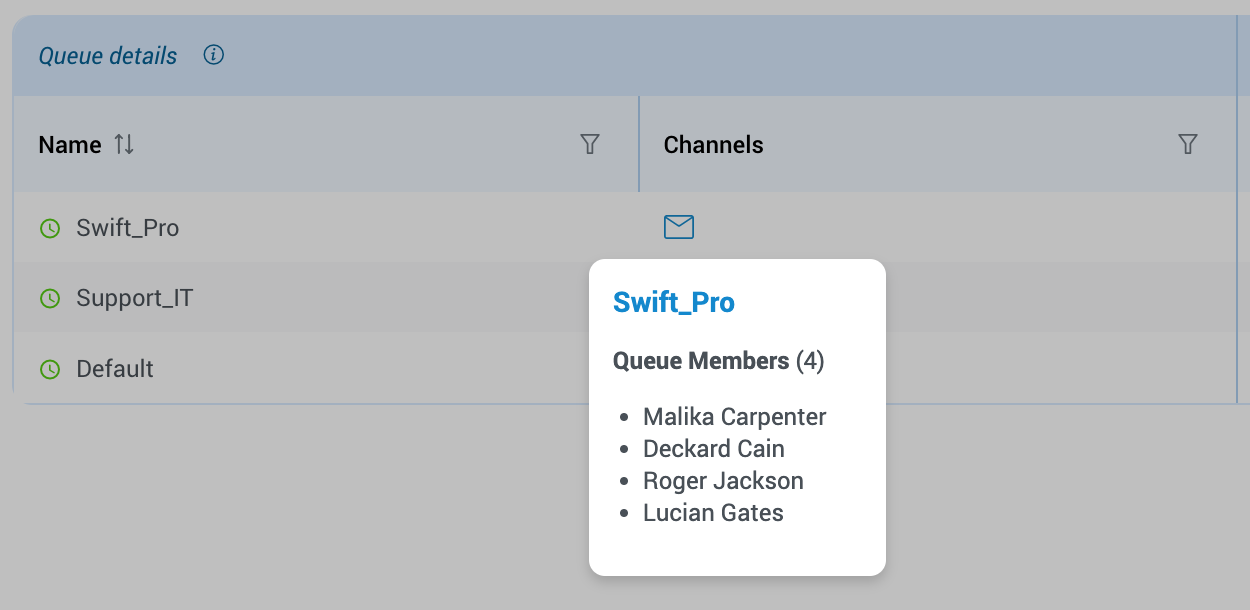 hover over the queue name and click the adjacent
hover over the queue name and click the adjacent  button.
button.
The descriptions beside the labels are consistent with the previous documentation, and filters are also provided for this section.

- The Current Conversations section shows the number of waiting
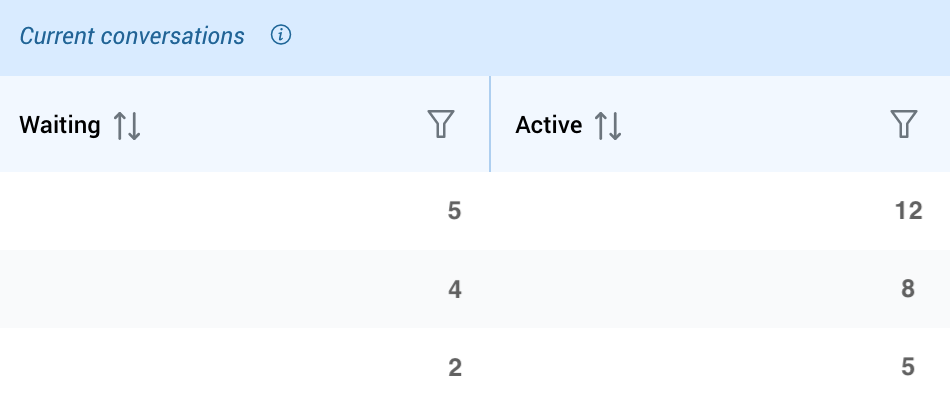 and active conversations in the Queue. Agents can quickly determine how many conversations are currently waiting for a response and how many are actively being worked on.
and active conversations in the Queue. Agents can quickly determine how many conversations are currently waiting for a response and how many are actively being worked on.
- The Agents' States section displays the number of currently logged-in
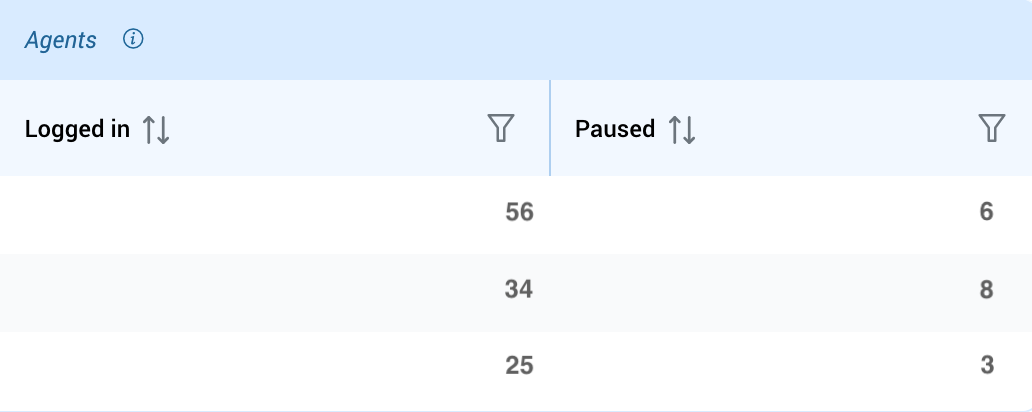 and paused agents in the Queue. This information helps agents understand the current availability of their team members, allowing them to coordinate their efforts more effectively.
and paused agents in the Queue. This information helps agents understand the current availability of their team members, allowing them to coordinate their efforts more effectively.
¶ My Performance
This page illustrates the agent's capacity to manage multiple tickets simultaneously, offers insights into their workload and daily activity, and provides valuable metrics such as the number of completed conversations, speed of answer, handling time, etc.
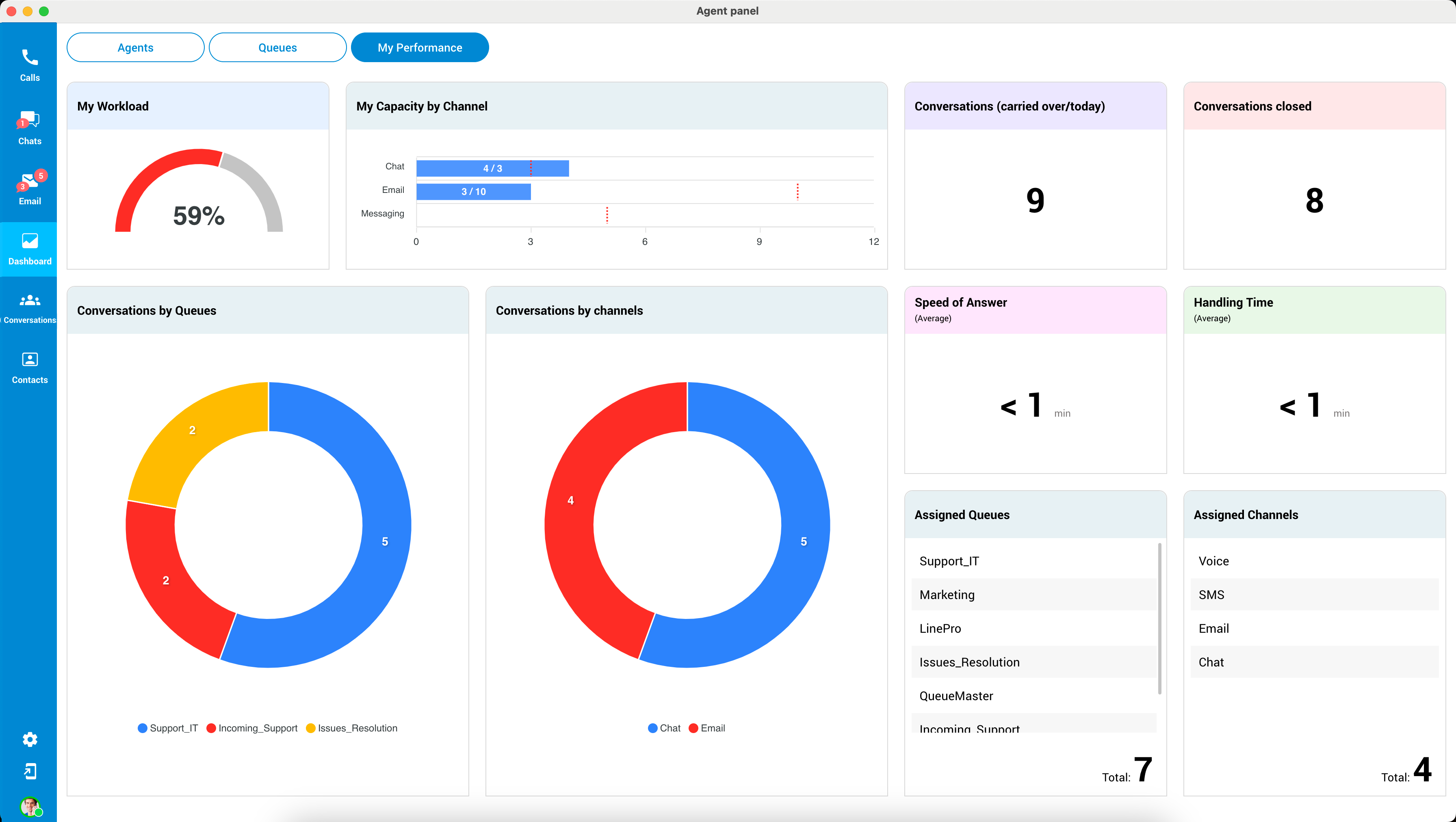
-
My Workload: This section visually represents the user's workload as a percentage, calculated by considering the number of ongoing conversations across different channels like chat, SMS, or email. The meter is divided into two sections: red and grey. The red section represents the utilized(used) working units, while the grey section indicates the remaining working units.
-
My Capacity by Channel: This area displays a graph that helps agents monitor the number of active conversations and their maximum capacity for handling conversations.
-
Conversations(carried over/today): This metric showcases the sum of conversations agents have carried over from prior days combined with the count of new conversations received today.
-
Conversations Closed: This provides an overview of how many conversations an agent has on the current day.
-
Conversations by Queues: This section provides information on the number of conversations an agent has handled for each queue.
-
Conversations per Channels: This displays the number of conversations an agent has handled for each communication channel, such as live chat, SMS, email, etc.
-
Speed of Answer: This metric shows the average time an agent takes to respond to a conversation.
-
Handling Time: This displays the average time an agent spends handling a conversation.
-
Assigned Queues: This shows the queues to which an agent is currently assigned.
-
Assigned Channels: This displays the communication channels to which an agent is currently assigned.
By providing these metrics, the My Performance tab helps agents track their progress and identify areas where they can improve their performance.
¶ Partial Service Availability
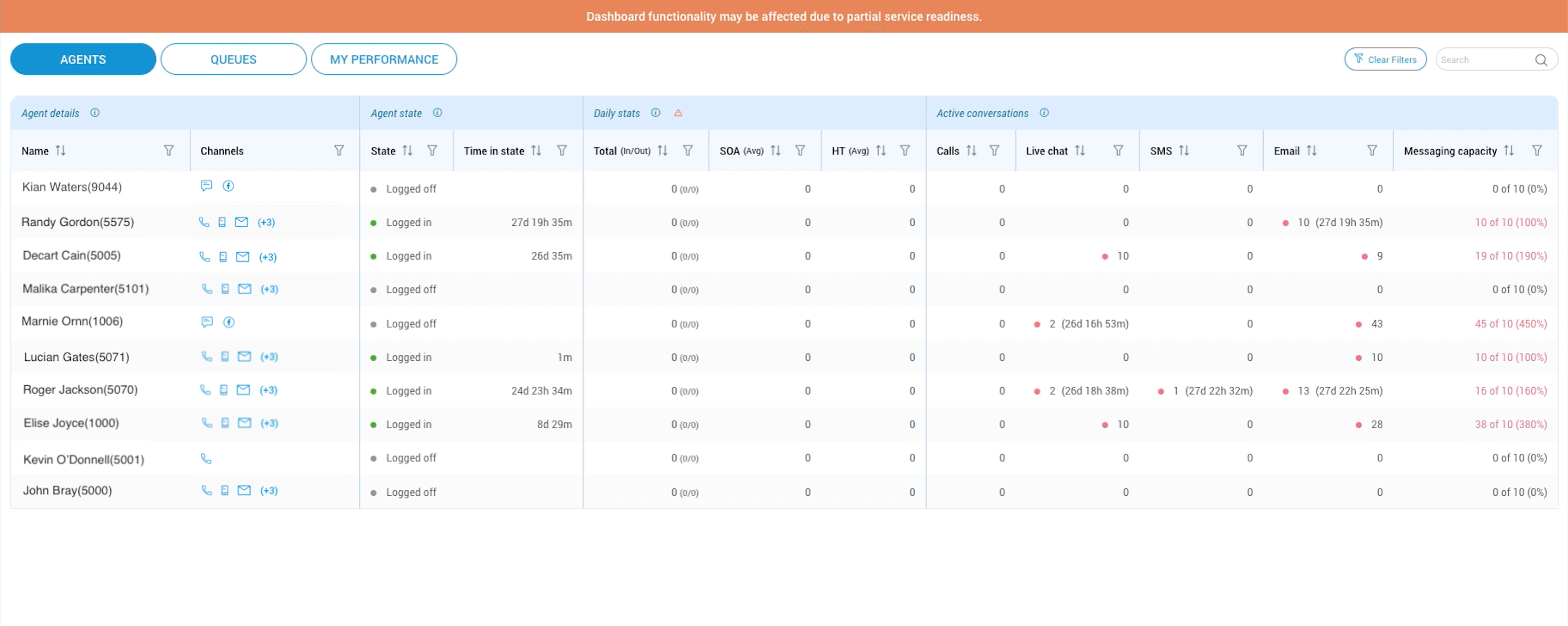
If there's a partial service availability issue, the Agent Panel will show a message stating, "Dashboard functionality may be affected due to partial service readiness." This means that the complete set of services may not be accessible, leading to potential disruptions in the display of messages within conversations.
In specific instances, hovering over the service error will unveil a message like "Error while loading daily stats," accompanied by a warning sign. This example illustrates the error message that might appear in such situations.
¶ Conversations
The Conversations section allows agents and supervisors to quickly and easily view all active and waiting conversations in the system and promptly assign conversations to themselves or other agents as needed (only for supervisors). It is a critical tool for managing customer interactions and ensuring all customer inquiries are addressed promptly and effectively.
¶ Active Conversations
The Conversations section of the app displays information about active conversations and conversations that are currently waiting to be assigned to an agent.
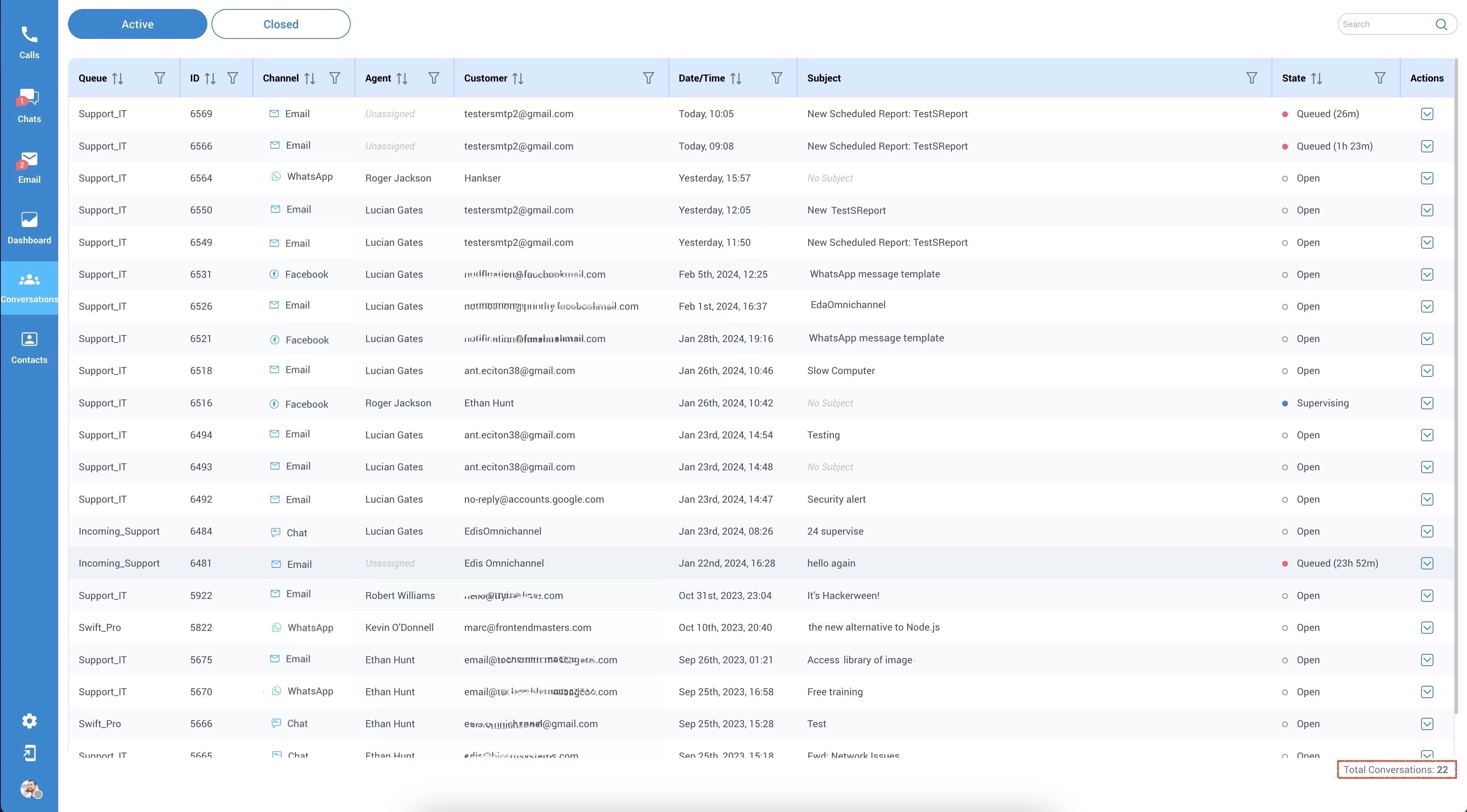
This section provides the following details about each conversation:
- Queue: This displays the name of the queue to which the conversation belongs.
- ID: This displays the conversation ID number, which uniquely identifies each conversation.
- Channel: This displays the channel through which the conversation was started (e.g. Live Chat, Email, SMS, etc.).
- Agent: This displays the name of the agent who is currently assigned to the conversation, if any.
- Customer: This displays the name of the customer who initiated the conversation, along with their email, SMS number or domain from which the conversation was started.
- Date/Time: This displays the date and time when the conversation was started.
- Subject: This displays the subject of the conversation, if any.
- State: This displays state of the conversation assigned by the agent.
- Total Conversations: This field represents the total number of active conversations.
Users can easily filter and organize active conversations based on various criteria (mentioned above), simplifying locating and handling them.
¶ Closed Conversations
This section conveniently presents all closed conversations containing chats, emails, and voice interactions for review and reference.
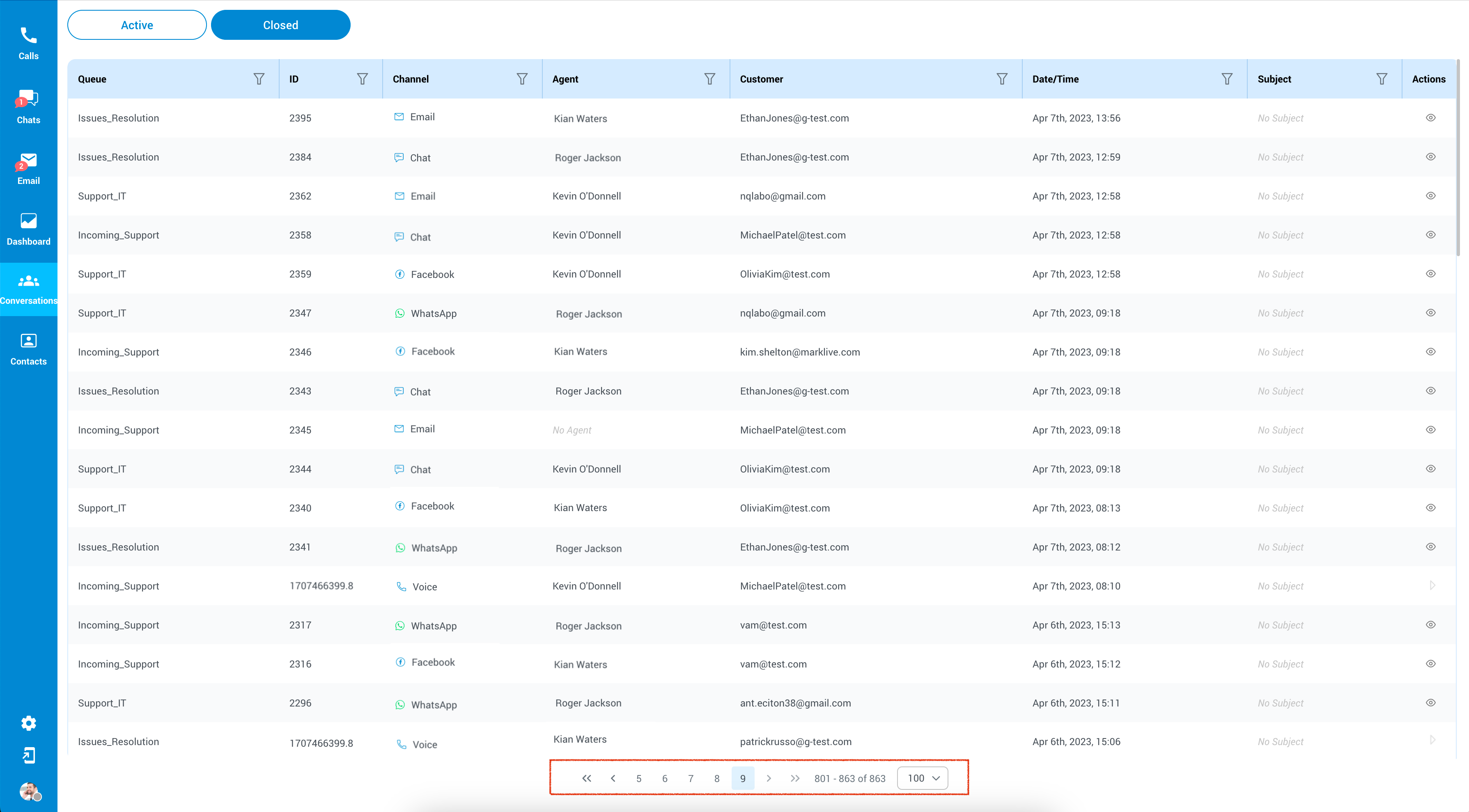
Users can conveniently refine and organize closed conversations according to different filters, making it easier to find and manage them. These filters include:
- Queue: To narrow down conversations by specific queues.
- ID: For locating conversations using unique identification numbers.
- Channel: To sort conversations by the communication method, such as Live Chat, Email, SMS, or Voice.
- Agent: For filtering based on the particular agent who handled the conversation.
- Customer: To search for conversations involving specific customers.
- Date/Time: For isolating conversations within a chosen date and time range.
- Subject: To find conversations based on their subject or topic.
- Action: Show conversation or Play recording.
¶ Show conversation or Play recording
The user's role determines the ability to view these conversations or play recordings. Supervisors can access complete details of all closed conversations within their assigned queues. Conversely, agents can only view conversations they were directly involved in.
![]() Show Conversation –This option, designed for chats and emails, allows agents to access and review the historical record of the closed conversation, providing valuable context and information.
Show Conversation –This option, designed for chats and emails, allows agents to access and review the historical record of the closed conversation, providing valuable context and information.
![]() Play Record - This feature is intended for closed voice conversations, enabling agents to playback and listen to the recorded content of past voice interactions, facilitating comprehensive analysis and assessment.
Play Record - This feature is intended for closed voice conversations, enabling agents to playback and listen to the recorded content of past voice interactions, facilitating comprehensive analysis and assessment.
The design of these viewing permissions is thoughtfully created to strike a balance between accessibility and confidentiality. This ensures that users are granted access levels aligning with their organization's responsibilities.
¶ Contacts
The Contacts module serves as a central hub for gathering contact information from various sources. Initially, it allows for contact management directly from the Agent & Supervisor app, including adding, editing, merging, and deleting contacts.
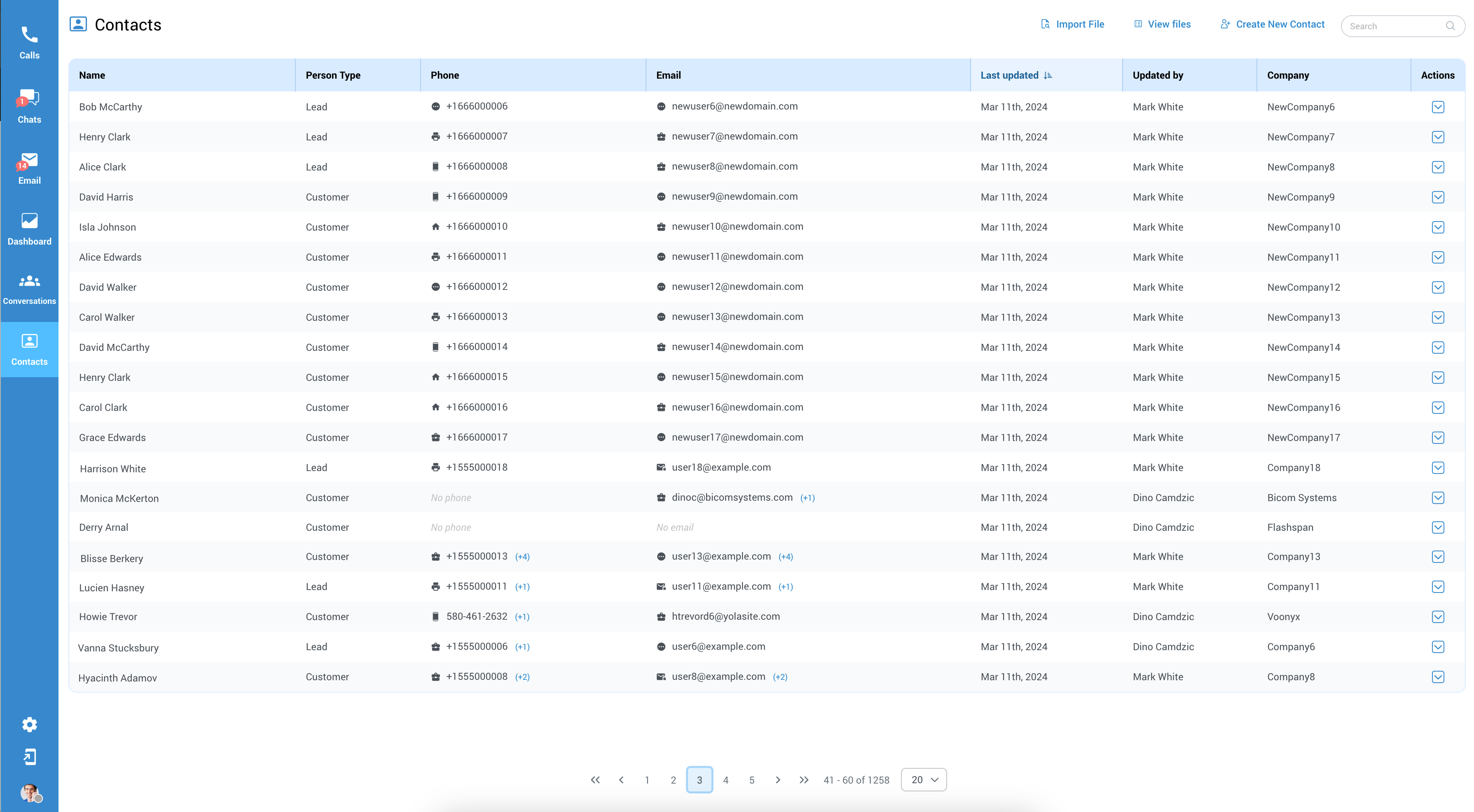
Users can add or edit new contacts through the Contact section. Supervisors have the ability to upload contacts via CSV files, while agents can only add contacts individually, one by one.
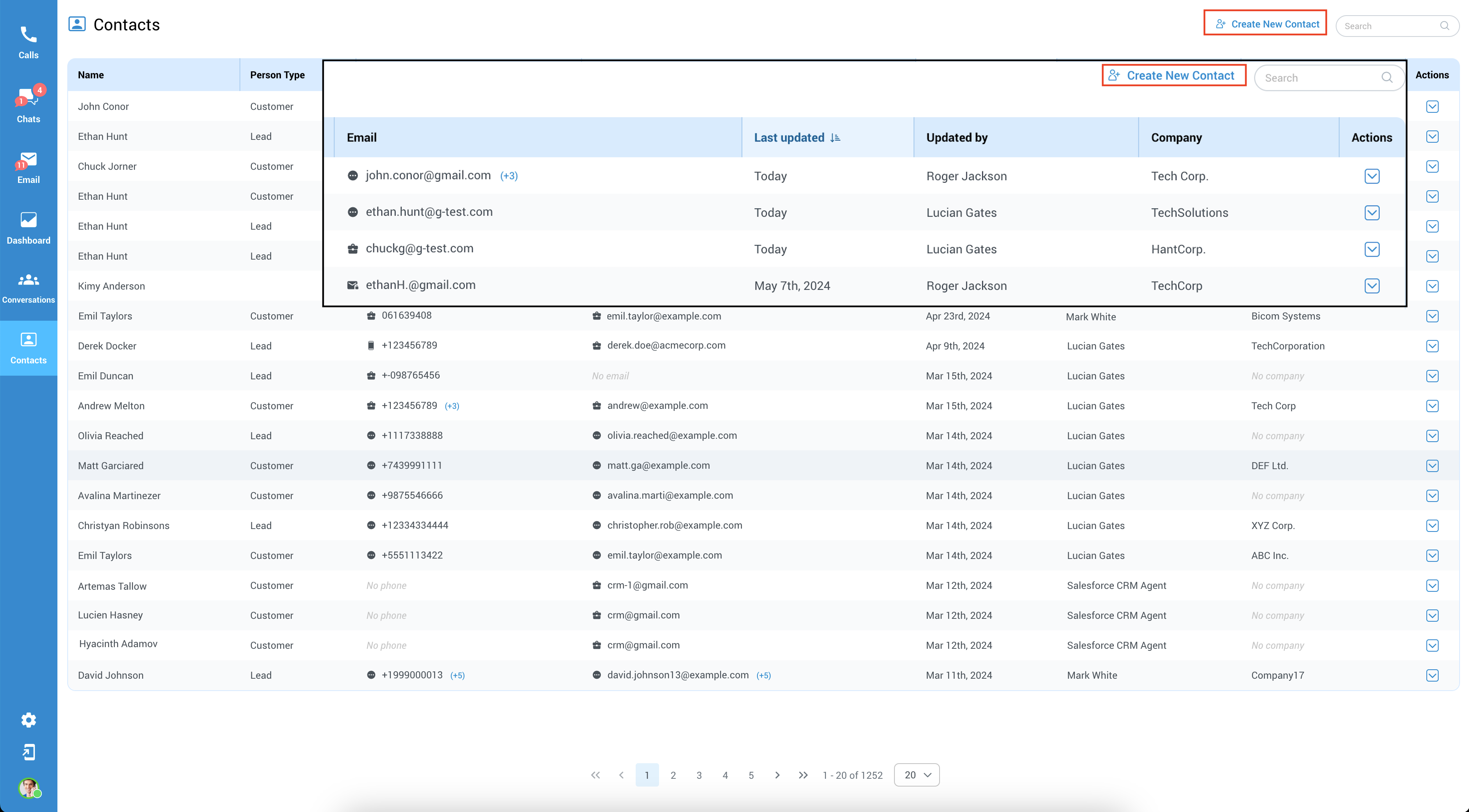
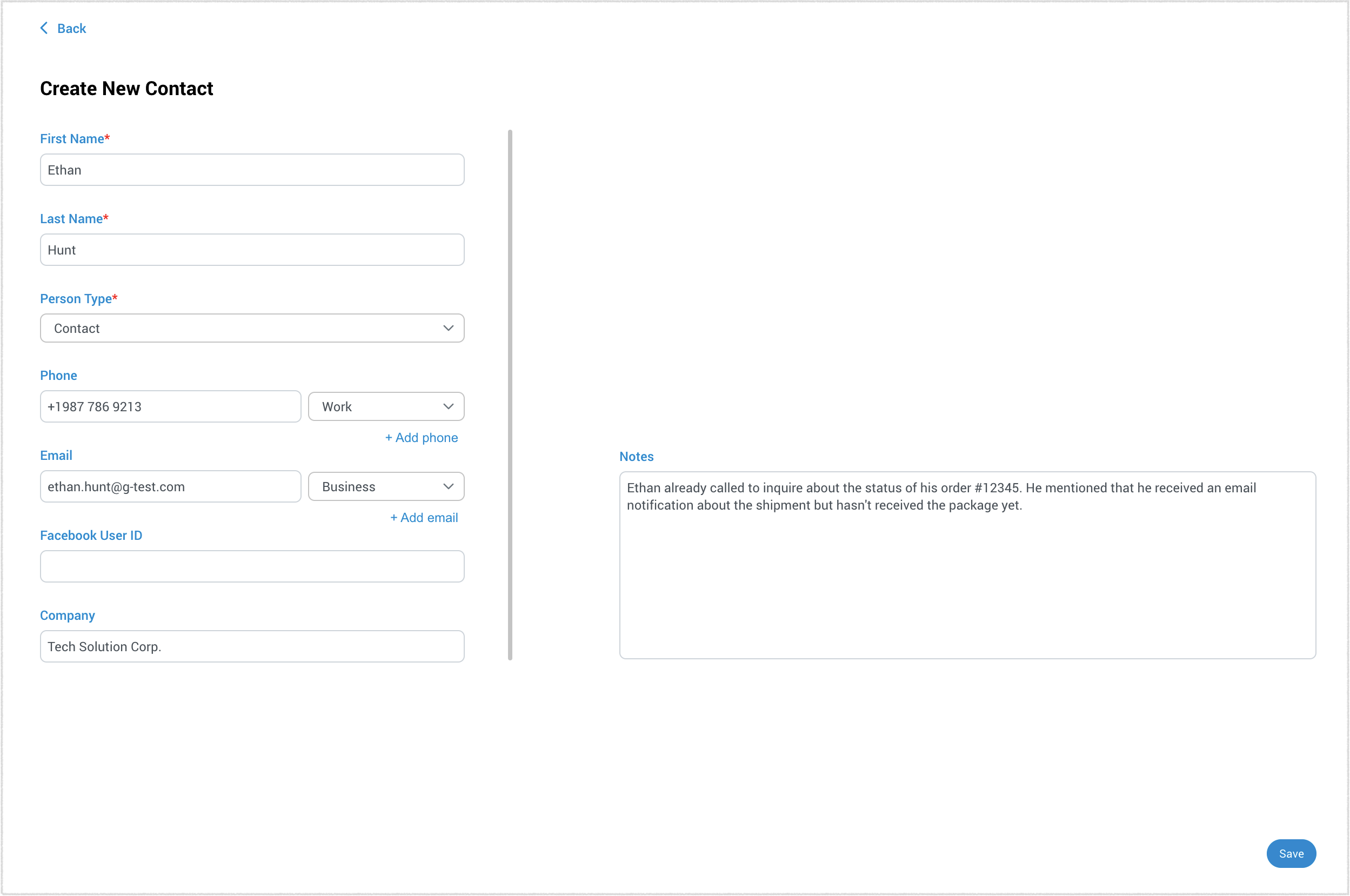
When users click on 'Create a New Contact,' a new window will appear, displaying a form for entering new contact information.
Plase be noted that first three fields are requirement to save the form. (First Name, Last Name and Person Type.)
Once the form is completed, users can click 'Save' to store the contact details.
Aditional actions for the Contacts section are:
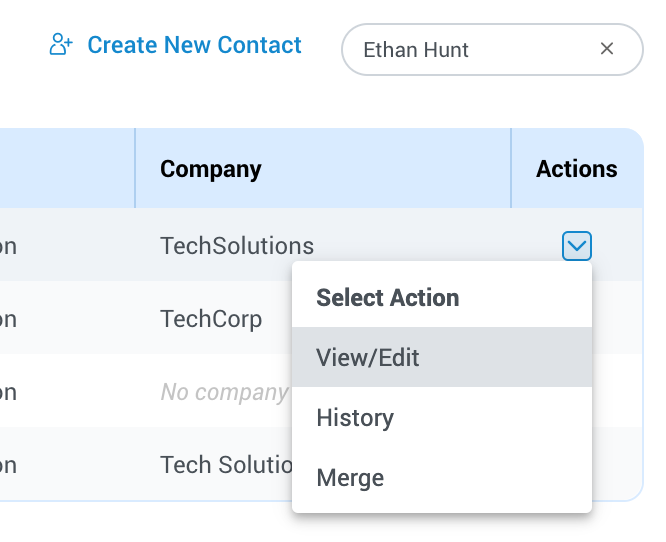
View/Edit
Selecting this action enables agents to view or edit an existing contact. Upon selection, a new window will open displaying a contact form that can be edited or reviewed.
History
Agents can utilize this option to view the history of conversations for a particular customer across all channels. Upon selection, a new window will display all conversations from the selected customer, including voice, email, SMS, live chat, Facebook, and WhatsApp conversations.
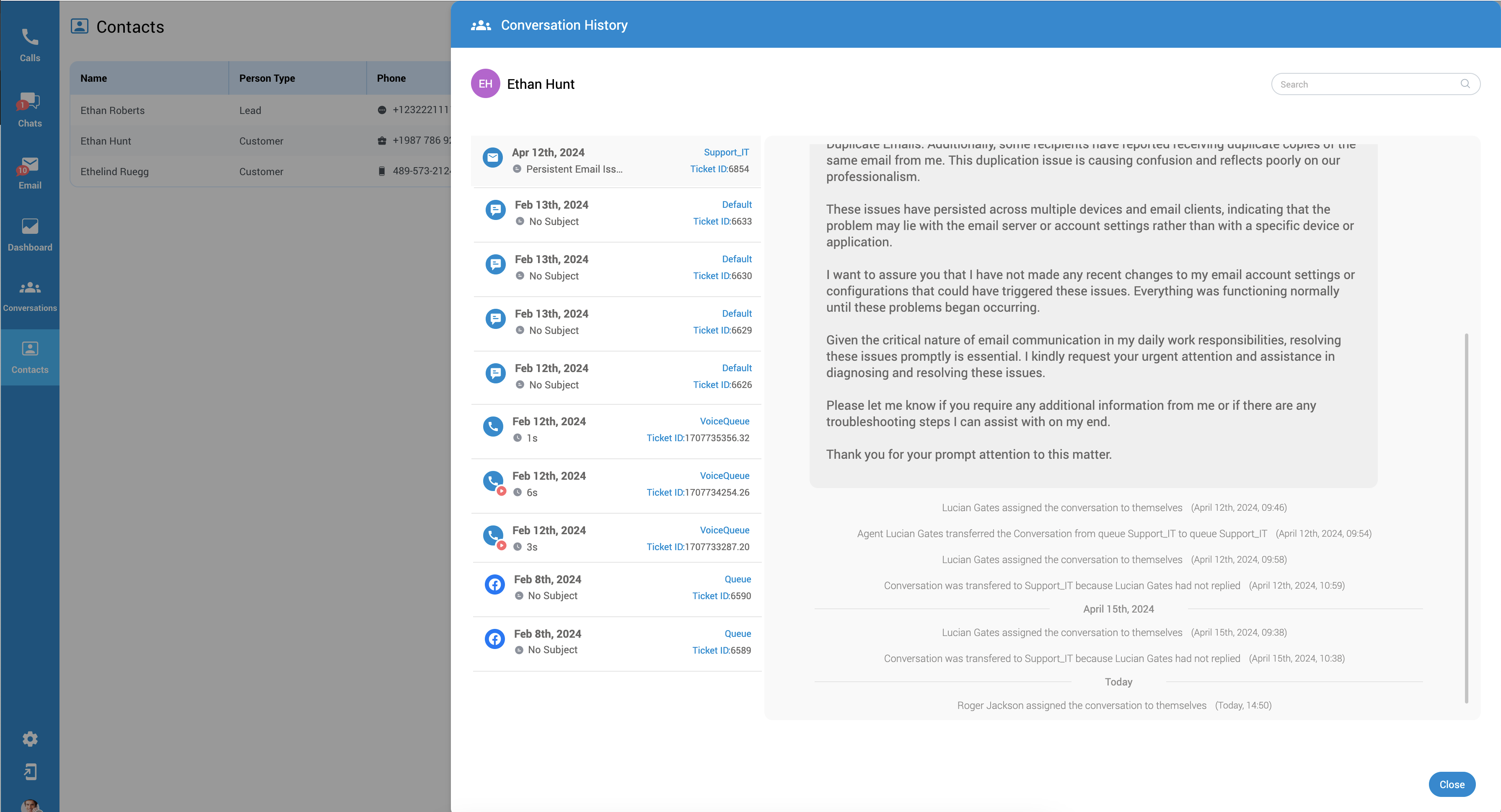
¶ Contact Merge Process
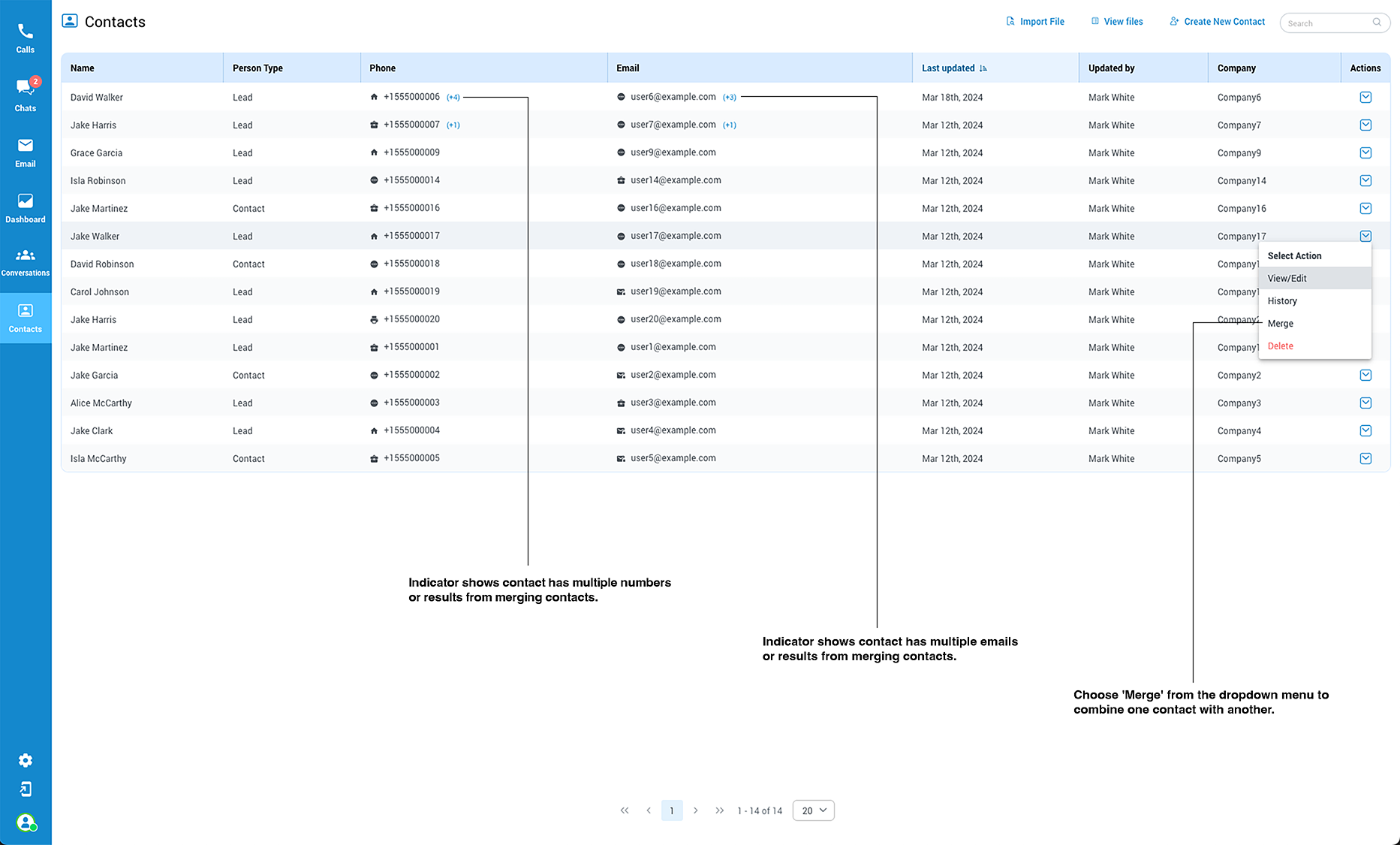
This guide walks you through the process of merging contacts in the system. Merging contacts allows you to consolidate multiple contact records into a single record. Follow the steps below to efficiently merge your contacts.
¶ Step 1: Select the Primary Contact
- Go to the
Contactslist. - Locate the contact you wish to use as the base for the merge.
- In the
Actionscolumn for your chosen contact, click on the dropdown menu and selectMerge.
¶ Step 2: Merge Contact Screen
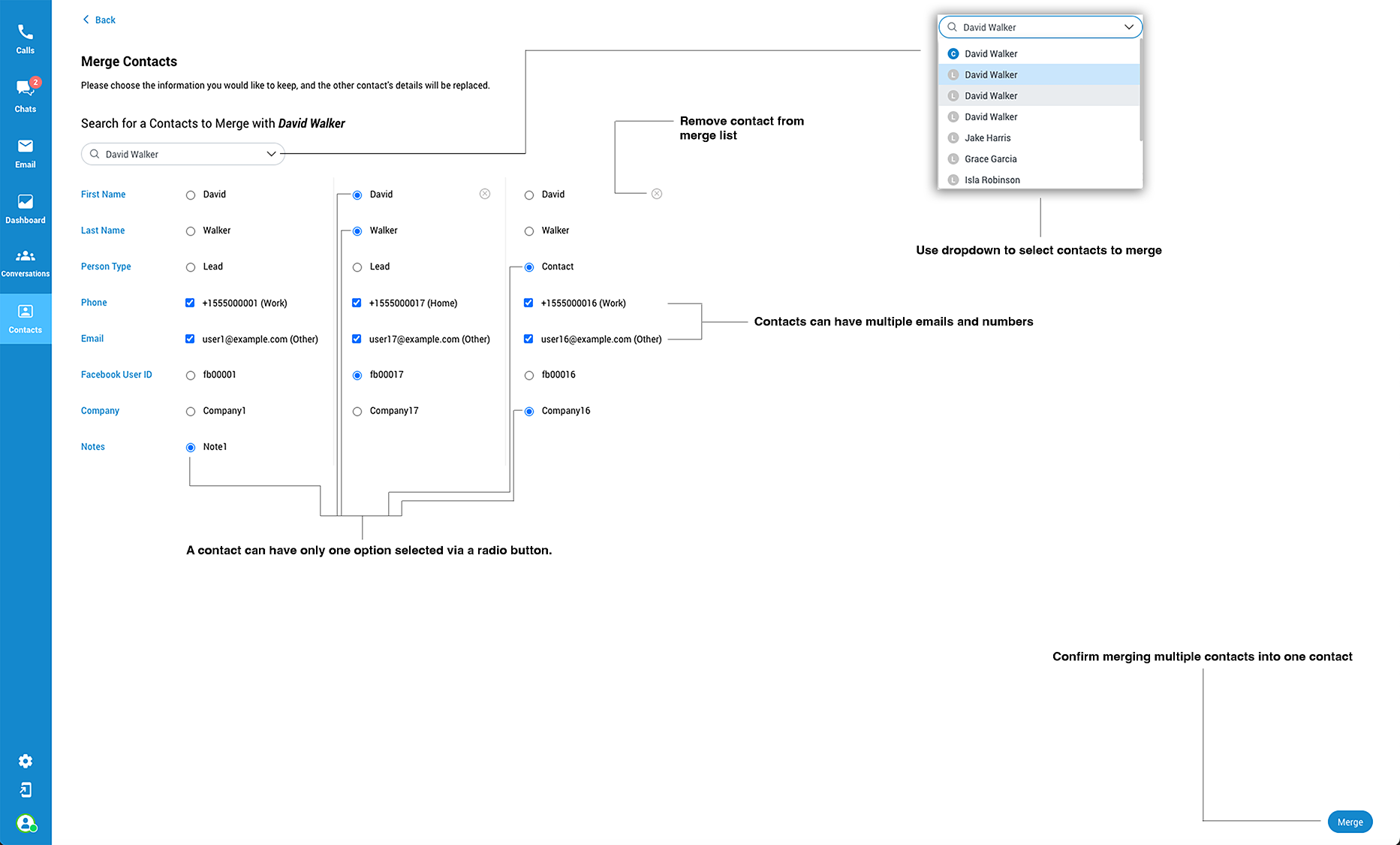
- You'll be directed to the Merge Contacts screen.
- The page title will be "Merge Contacts - Please choose the information you would like to keep, and the other contact's details will be replaced."
¶ Step 3: Choose Contacts to Merge
- Follow the prompt: "Search for Contacts to Merge with Name Surname."
- Use the dropdown menu to select another contact to merge with the initial one.
- The initially selected contact’s details will be displayed, marking it as the base for the merge.
¶ Step 4: Selection of Contact Details
- From the dropdown, select other contacts to merge.
- These will be displayed as columns next to the initial contact.
- Select details to merge:
- For single choice attributes (radio buttons):
- First Name, Last Name, Person Type, Facebook User ID, Company, and Notes.
- For multiple choice attributes (checkboxes):
- Phones and Emails.
- For single choice attributes (radio buttons):
¶ Step 5: Confirm Merge
- Click
Mergeafter making your selections. - A confirmation alert will pop up: "Are you sure you want to Merge these contacts? Merging is a one-time action and cannot be undone. Make sure you have selected the correct details to keep, as the original contacts will be permanently updated."
¶ Step 6: Finalize Merge
- Confirming the merge will consolidate the selected contacts into one unified contact.
- Redundant contacts will be removed from the system.
- The merged contact will now appear in the contact list, with the combined number of phone numbers and emails reflected.
Note: The merge action is irreversible, so please ensure you've selected the correct details to keep
¶ Facebook Page Name
- The Facebook page name is displayed in the 'Contact Profile' section of the Agent Panel, offering agents immediate visibility and access to the specific Facebook information pertinent to their tasks.
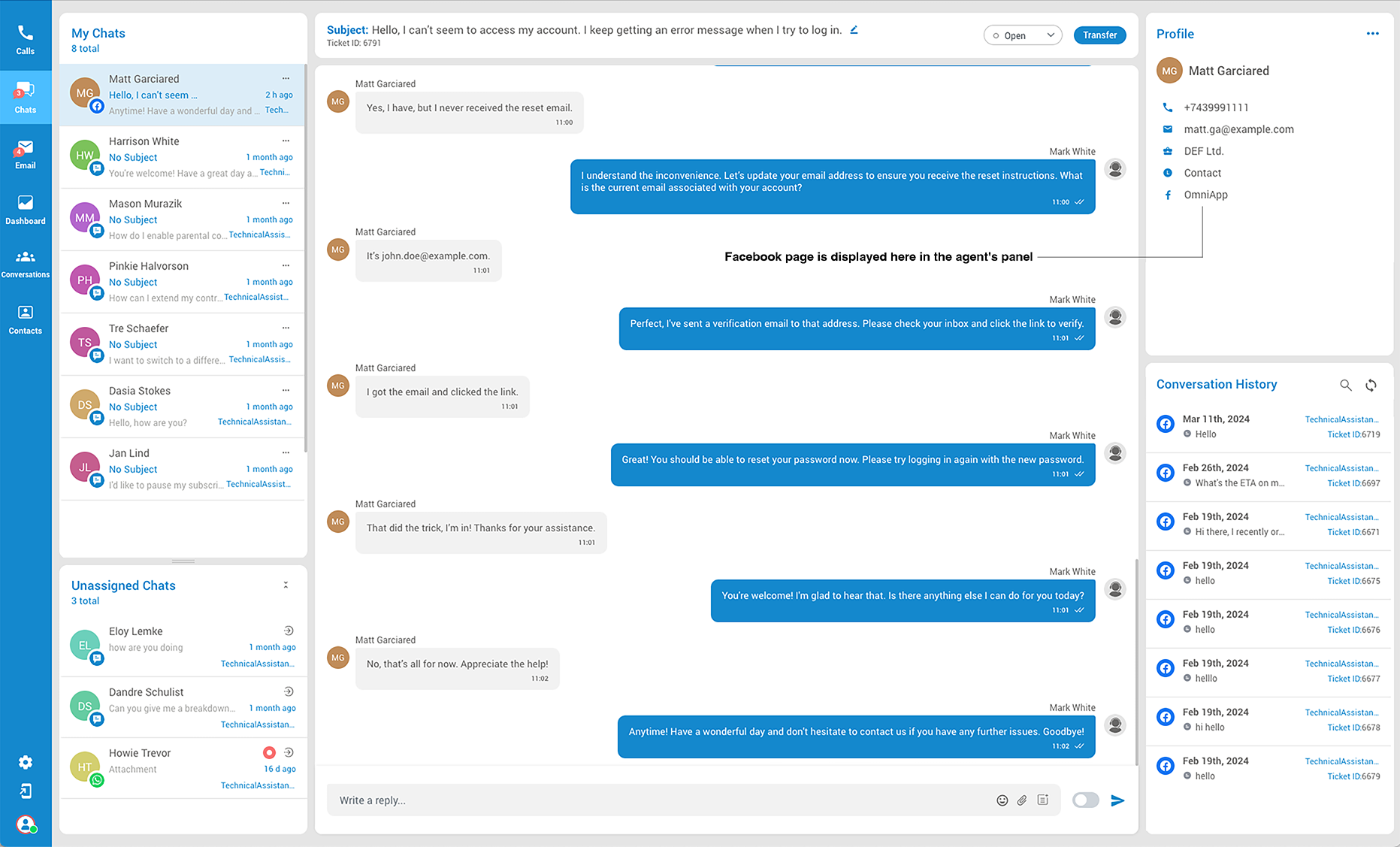
¶ Agent Name and Avatar in Facebook chat
![]()
When a customer accesses our Omnichannel service from a Facebook page, they are immediately presented with a more personalized experience. The system ensures that both the Agent Name, as set in gloCOM, and the Agent's Avatar are automatically propagated to the user. This feature aims to create a familiar and engaging environment, enhancing the customer's experience by showing them exactly who they are communicating with. This personalization helps in building trust and rapport, leading to more effective and satisfactory interactions. We strive to maintain this consistency across all channels to ensure a seamless and positive experience for all users.
¶ OpenStreetMap for Omnichannel Live Chat
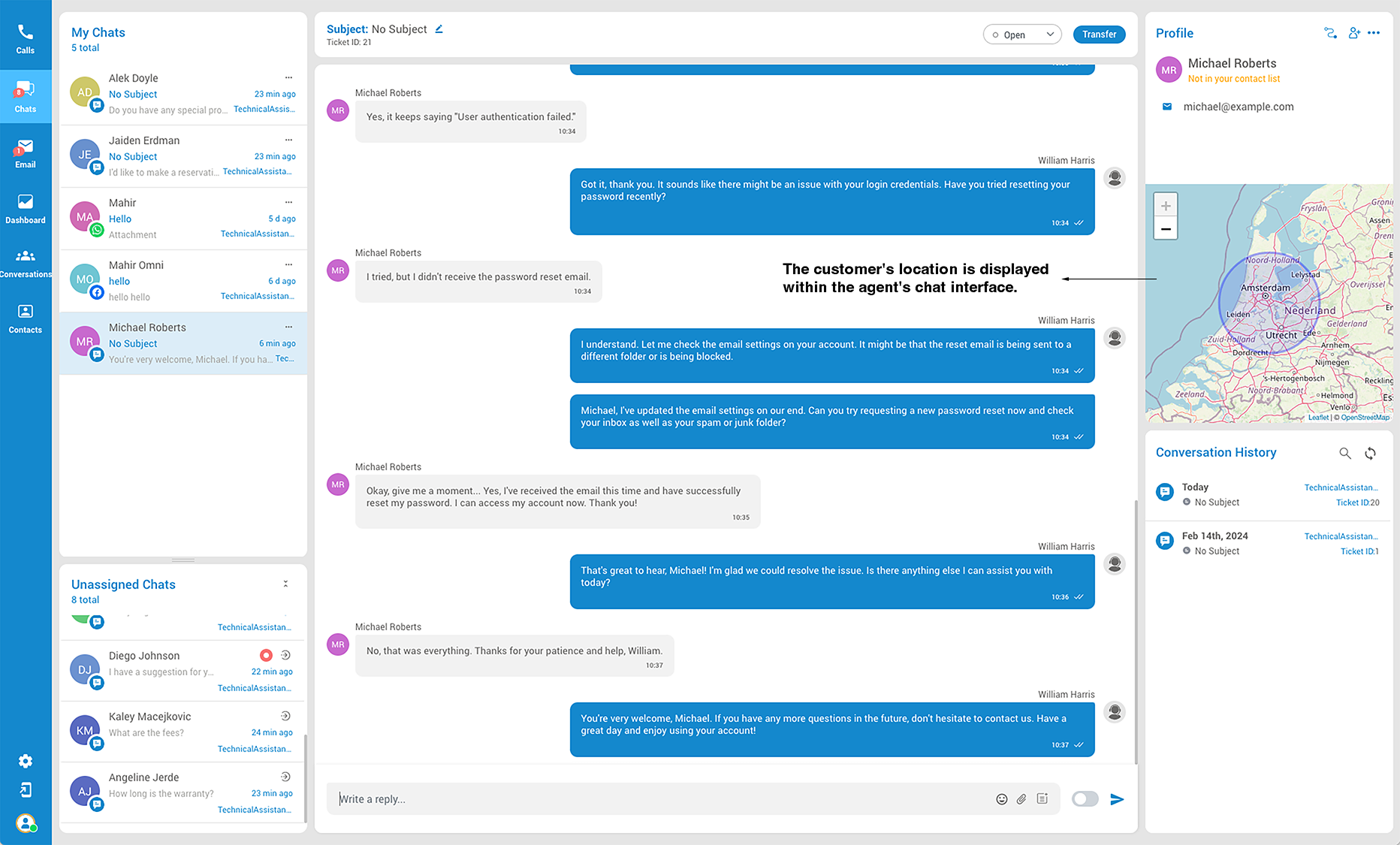
¶ Overview
Our Omnichannel Live Chat service now integrates OpenStreetMap to enhance the support experience. This feature enables agents to view the geographical location of customers initiating a chat, providing valuable context for personalized assistance.
¶ How It Works
- Customer Location Display: When a customer starts a chat session through our Omnichannel service, the agent's interface will automatically display the customer's location on an OpenStreetMap map. This is done securely and in compliance with privacy regulations.
- Agent Usage: Agents can use this location information to offer more tailored support and services, enhancing the customer's experience.
¶ Benefits
- Provides agents with immediate context about the customer's location.
- Enables more personalized and efficient customer support.
¶ Accessing Customer Locations
- The customer's location is displayed within the agent's chat interface.
- No additional action is required from the agent to view this information.
¶ Settings
This section provides agents with comprehensive access to critical functionalities, enabling seamless management of security protocols, voice configurations, application settings, voice alerts, as well as pre-defined responses and WhatsApp templates.
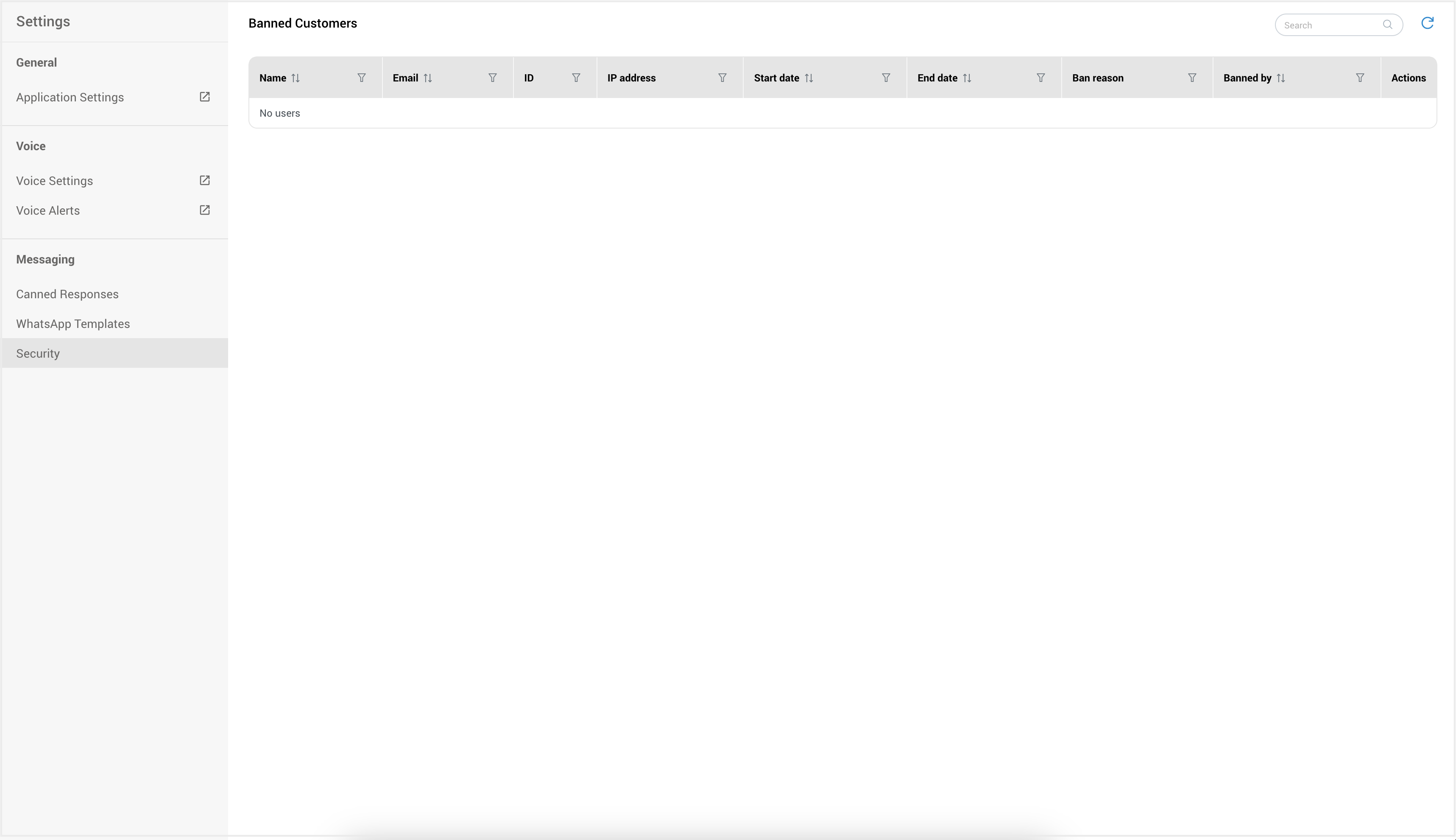
¶ Application Settings
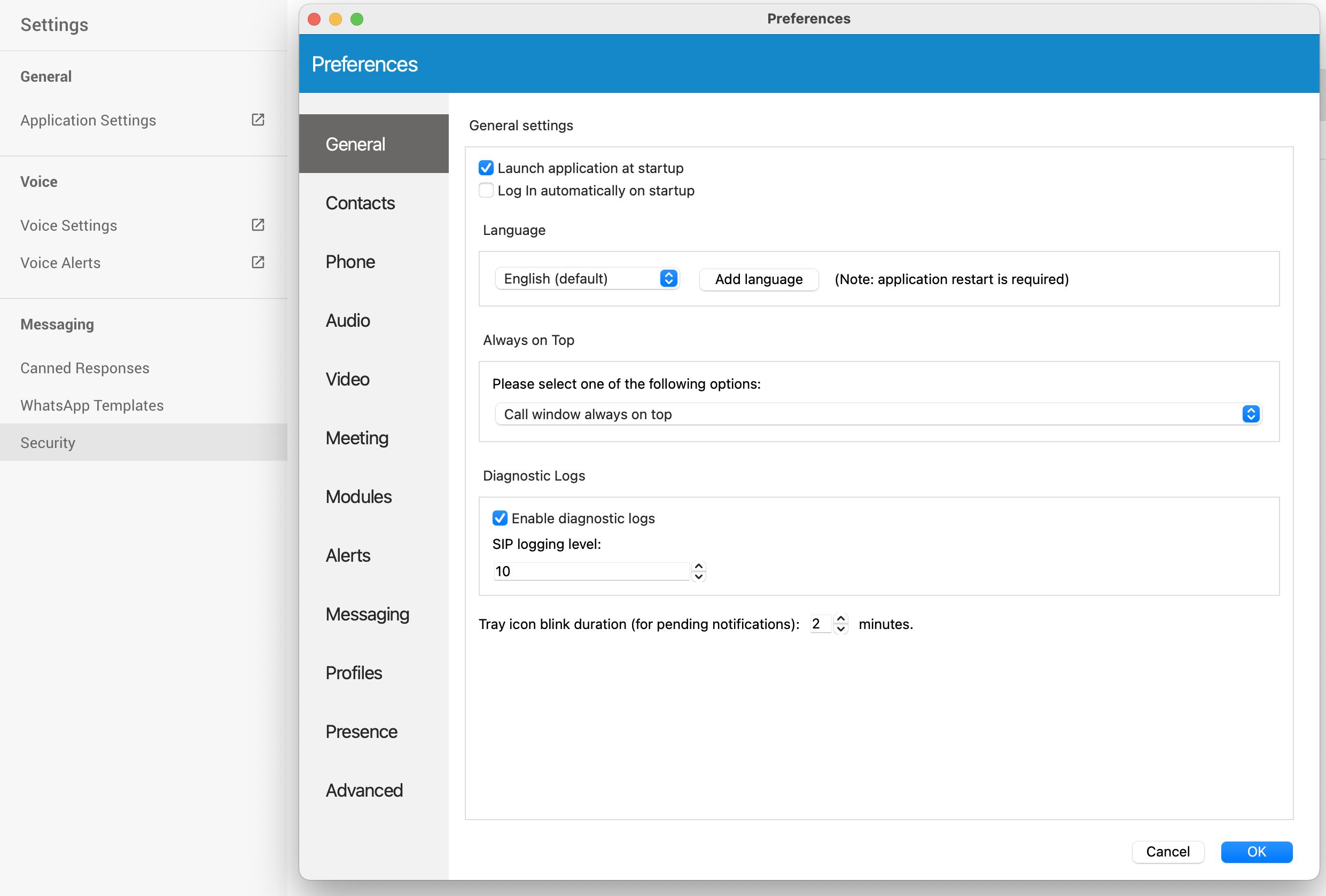
Within the Application Settings section, users have the flexibility to configure a range of parameters to suit their preferences and streamline their experience. This includes options such as automatic launch and login, preferred language, configuration options related to phone functionality, audio and video settings, alerts, module settings, etc.
¶ Voice Settings
This panel contains settings for Agents, Queues and Alerts, so accordingly, there are 3 tabs with same names.
Agents
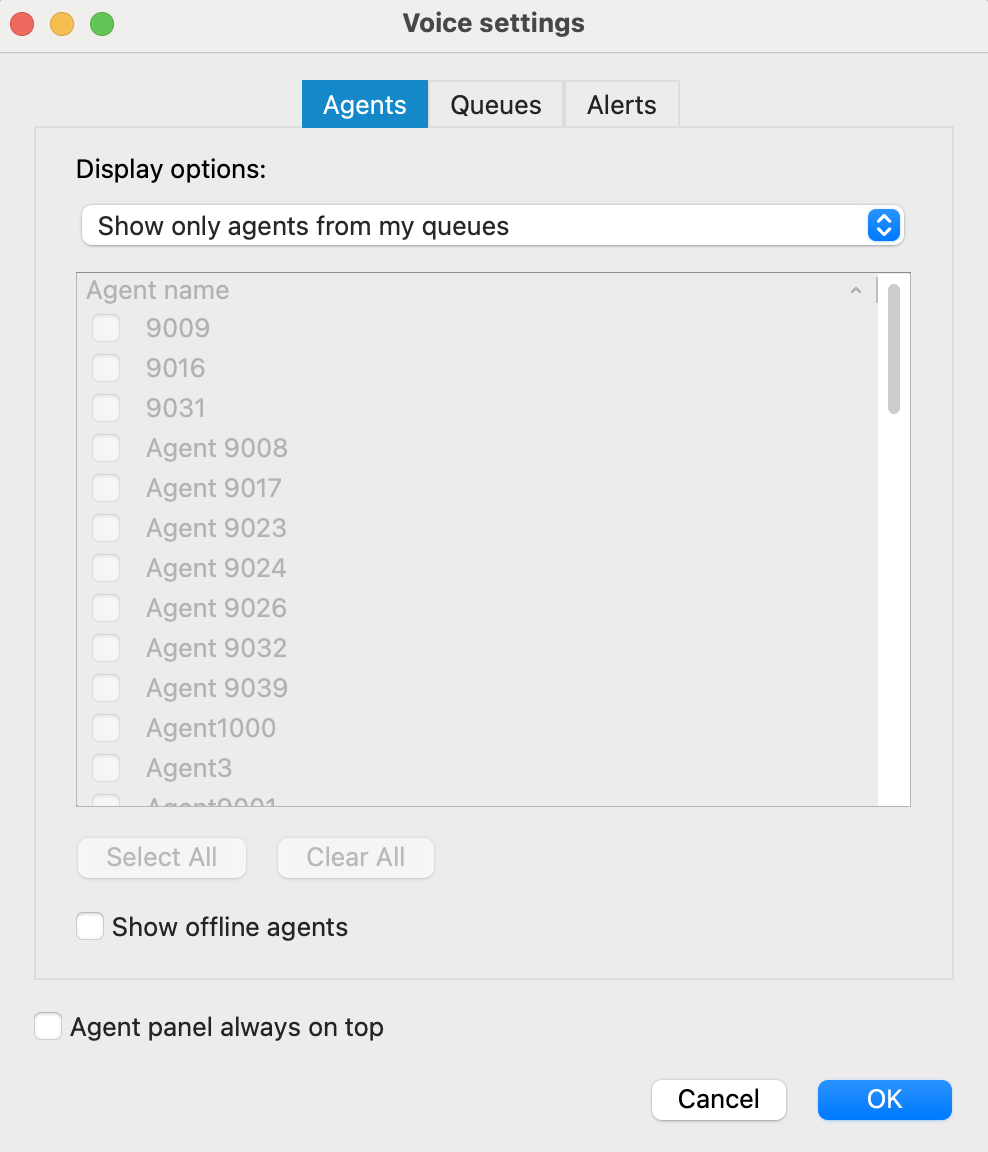
The drop-down list is used to select which agents will be visible in the Agent Panel window, inside Agents tab.
You can select the following options:
• Show only agents from my queues • Show all agents
• Show custom selected agents
Also, there is checkbox 'Show offline agents' that is used for showing offline agents inside the Agents tab.
Below, the checkbox 'Agent panel always on top' is used in case you want to set the Agent Panel always on top.
Queues
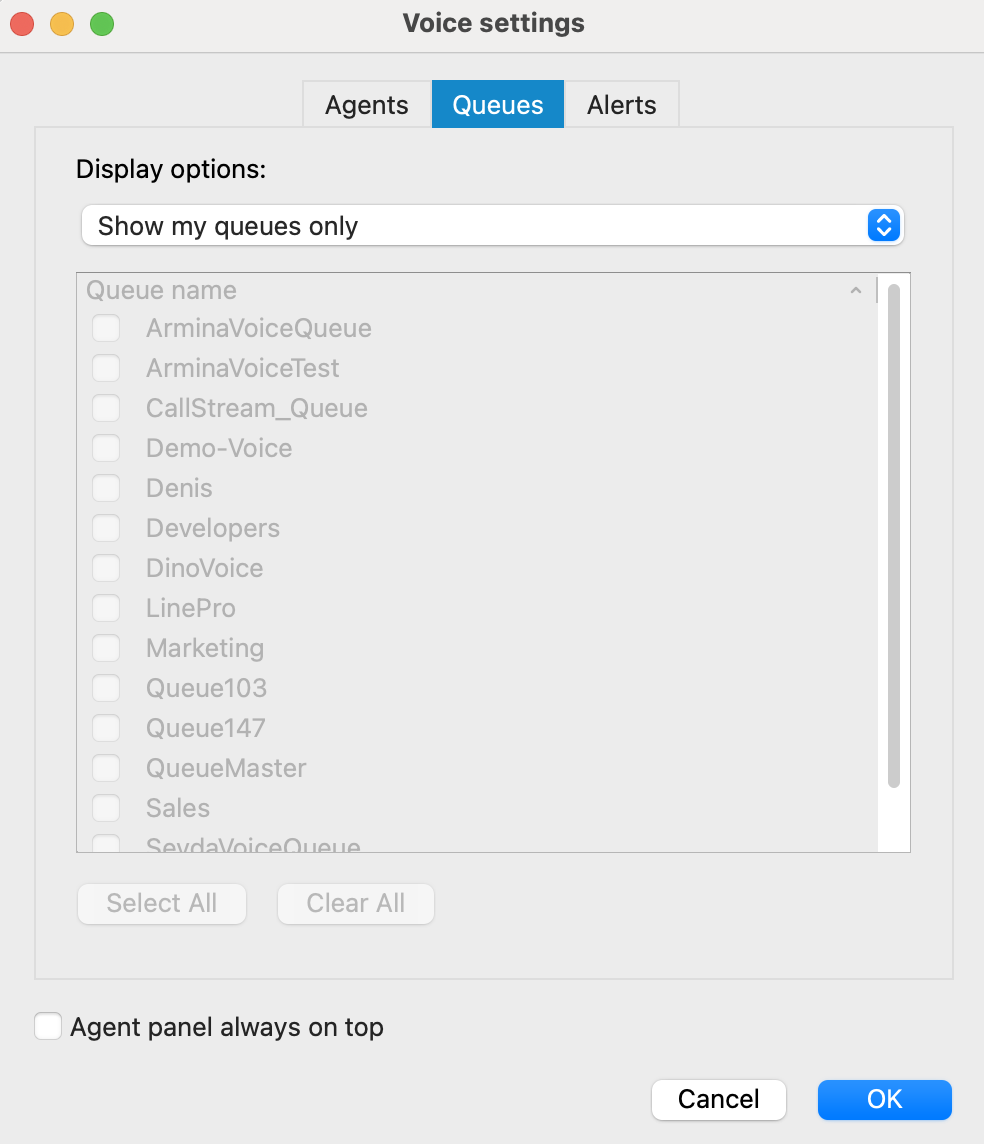
The drop-down list is used to select which queues will be visible in the Agent Panel window, inside Queues tab.
The following display options are offered:
• Show my queues only
• Show all queues
• Show custom selected queues
Below, there is a checkbox 'Agent panel always on top' that is used in case you want to set the Agent Panel always on top.
Alerts
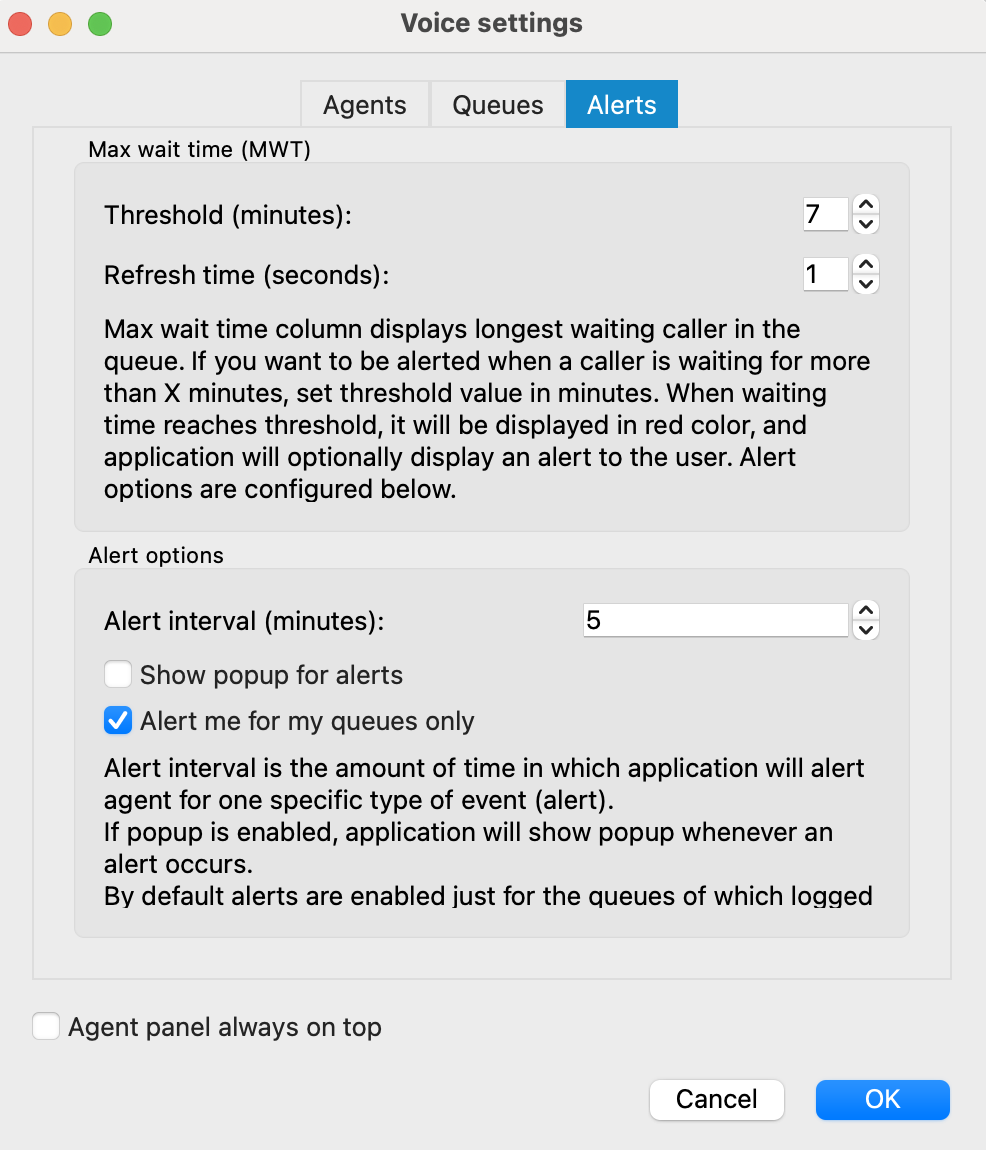
Max wait time (MWT): MWT displays longest waiting caller in the Queue.
- Threshold (minutes): If you want to be alerted when a caller is waiting for more than X minutes in the Queue, set Threshold on that value. When the waiting time reaches the Threshold, it will be displayed in red color, and application will optionally display an alert to the user.
- Refresh time (seconds): Select or enter the number which will represent refresh interval in seconds.
Alert Options
- Alert interval (minutes): Alert interval is the amount of time in which application will alert agent for one specific type of event (alert). You can select or enter the number which will represent this interval in minutes.
- Show popup for alerts: If this option is checked, the application will show popup whenever an alert occurs.
- Alert me for my queues only: If this option is checked, you will receive alerts only for your queues.
Below, there is a checkbox 'Agent panel always on top' that is used in case you want to set the Agent Panel always on top.
¶ Voice Alerts
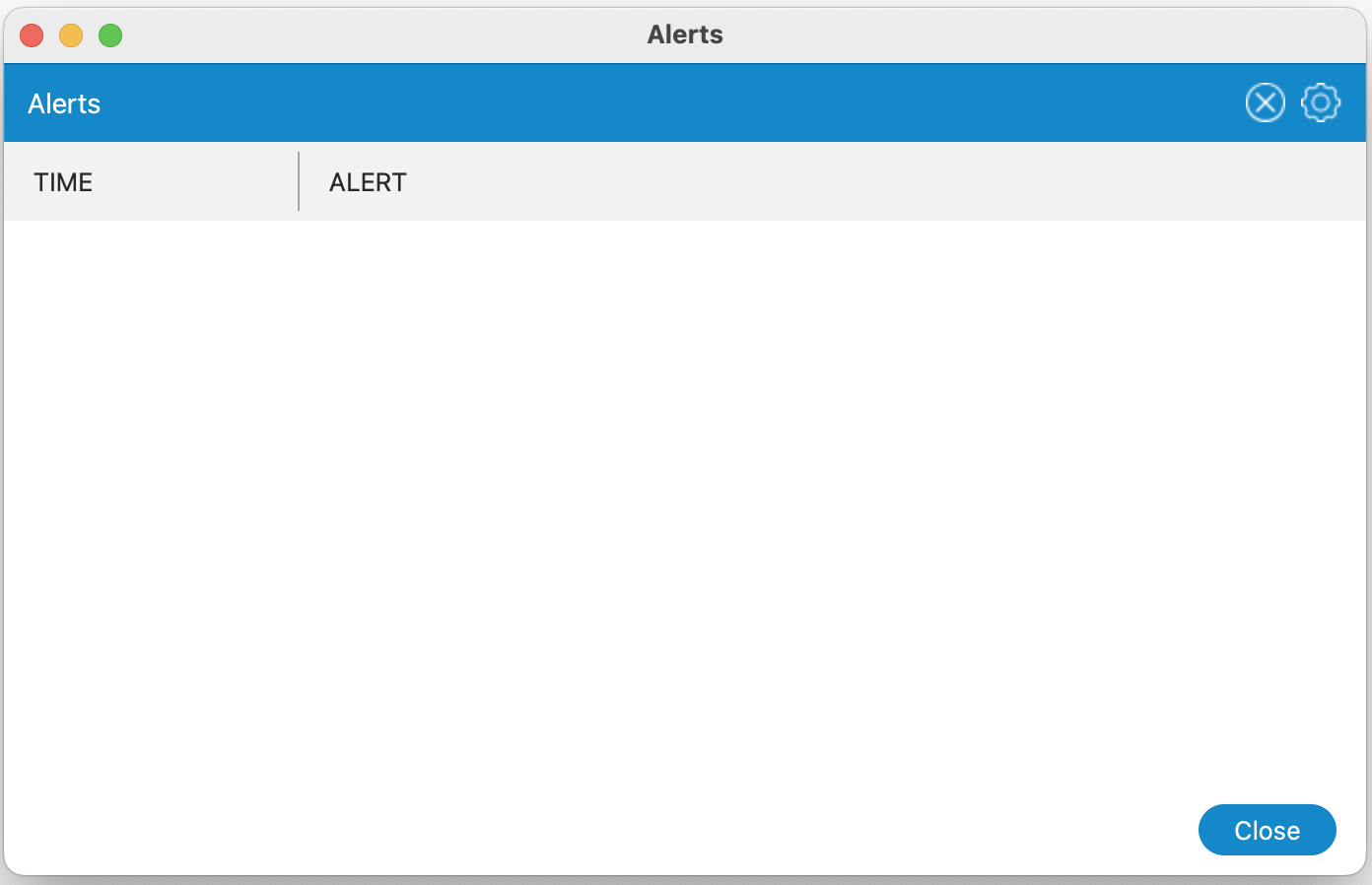
The "Alerts" dialog presents a comprehensive list of alerts. Each alert in the list includes the following details: the timestamp and specific alert information.
Located on the top right corner of the Alerts dialog, there is an option to delete all alerts from the list. Additionally, adjacent to the "Delete" button, you'll find a "Settings" button. Clicking on this button will open the "Agent Panel Settings" dialog, allowing you to modify previously configured alert options to suit your preferences.
¶ Canned Responses
Canned responses are pre-defined message templates used to quickly respond to customer inquiries. They ensure consistency and efficiency in communication across various channels, including SMS, Email, Chat, Facebook, and WhatsApp.
¶ Finding Canned Responses
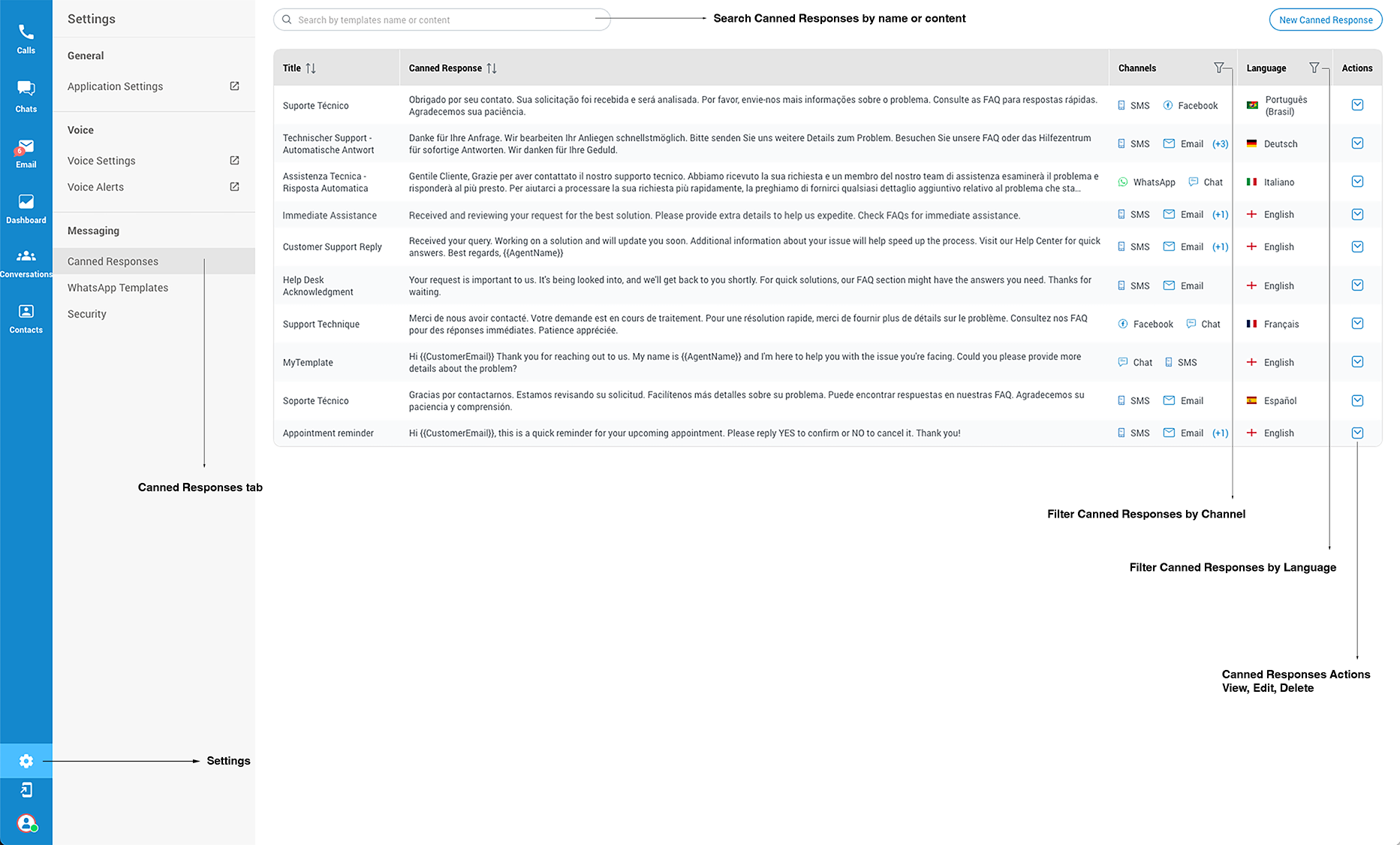
Canned responses are accessible under the Agent Panel Settings page, within the Messaging section. Upon accessing this page, agents are presented with a list of previously added canned responses. This list can be navigated using the search bar above, allowing users to search by name or content of the canned responses.
¶ List Organization
The list is organized into five columns:
- Title: Sort by name.
- Canned Response: Sort by content.
- Channels: Filter by the channel(s) assigned.
- Language: Sort by language. Available languages include English, Deutsch, Español, Français, Italiano, Português (Brasil).
- Actions: Options to View, Edit, and Delete a canned response.
¶ Responding to Customers
Responding to customers with a canned response is straightforward:
-
Navigate to the text input field in the ongoing conversation within the Agent Panel, regardless of the channel.
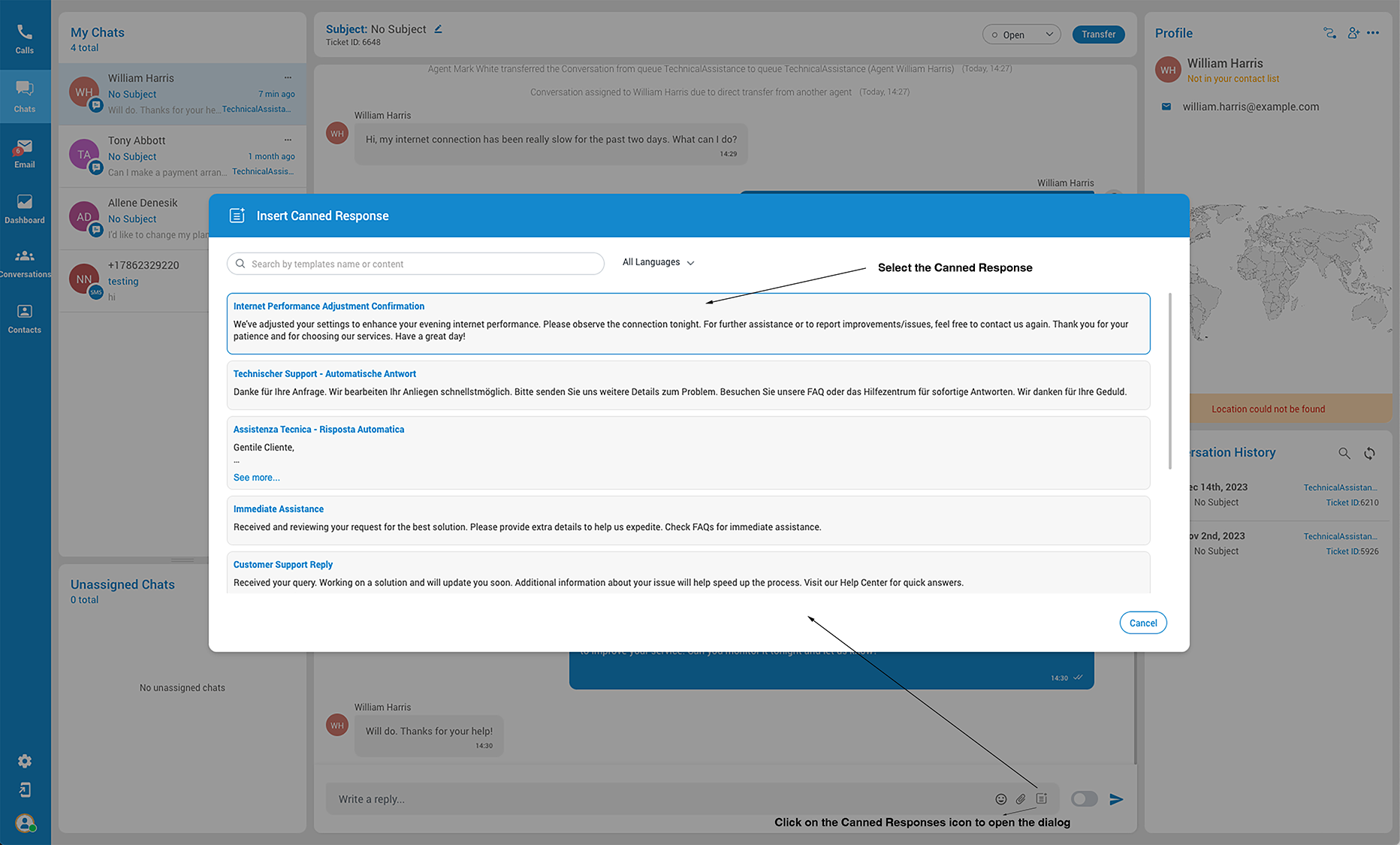
-
Click the icon for Canned Responses/WhatsApp templates located on the right part of the text input field. This opens a dialog where you can choose the desired canned response.
-
Select the canned response to have it displayed in the text input field.
-
Send your message. For messages with placeholders, they will be automatically filled with the relevant values upon sending.
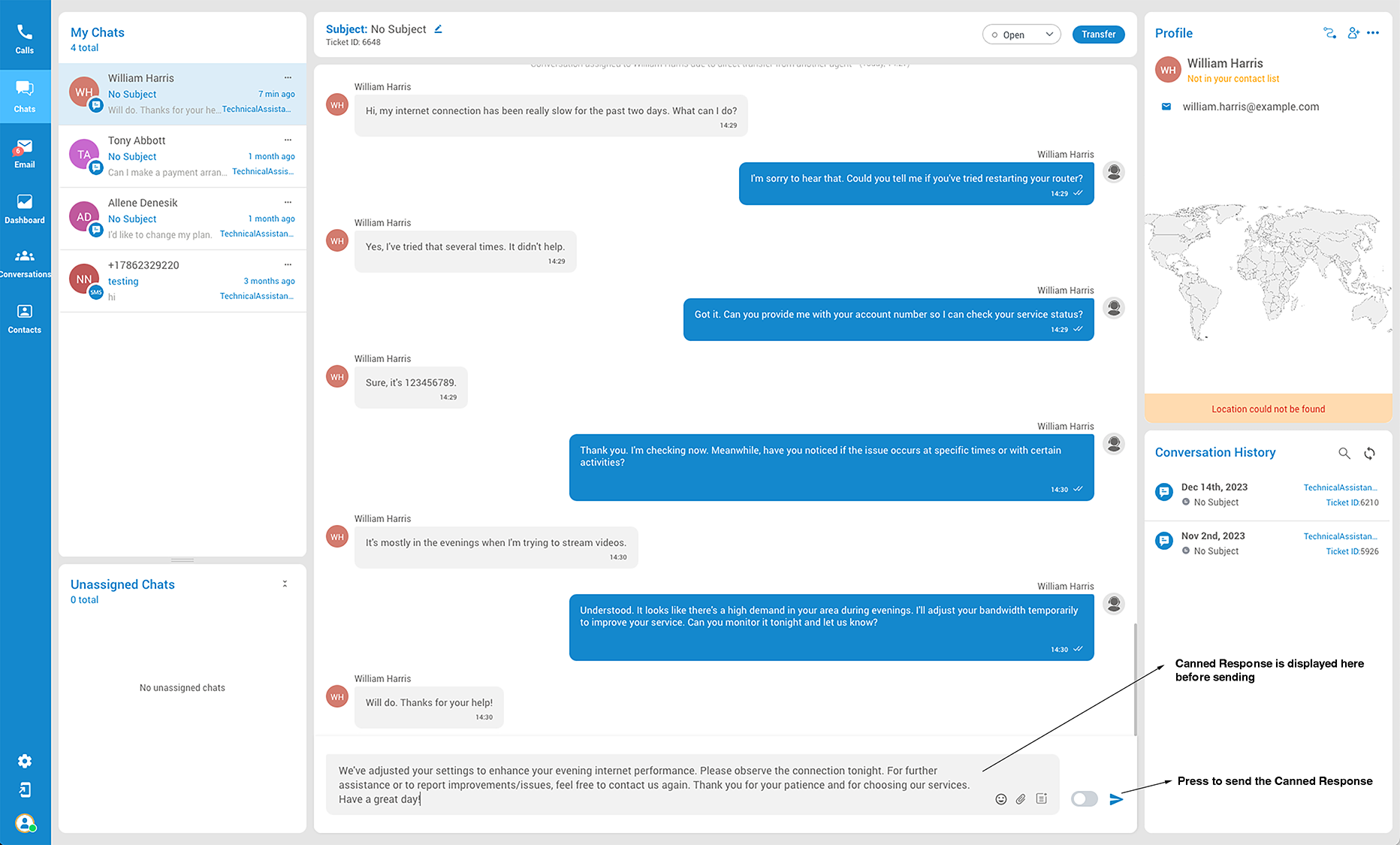
Canned responses streamline communication, ensuring quick, consistent, and personalized responses to customers across all support channels.
¶ Sending WhatsApp Templates During a Chat
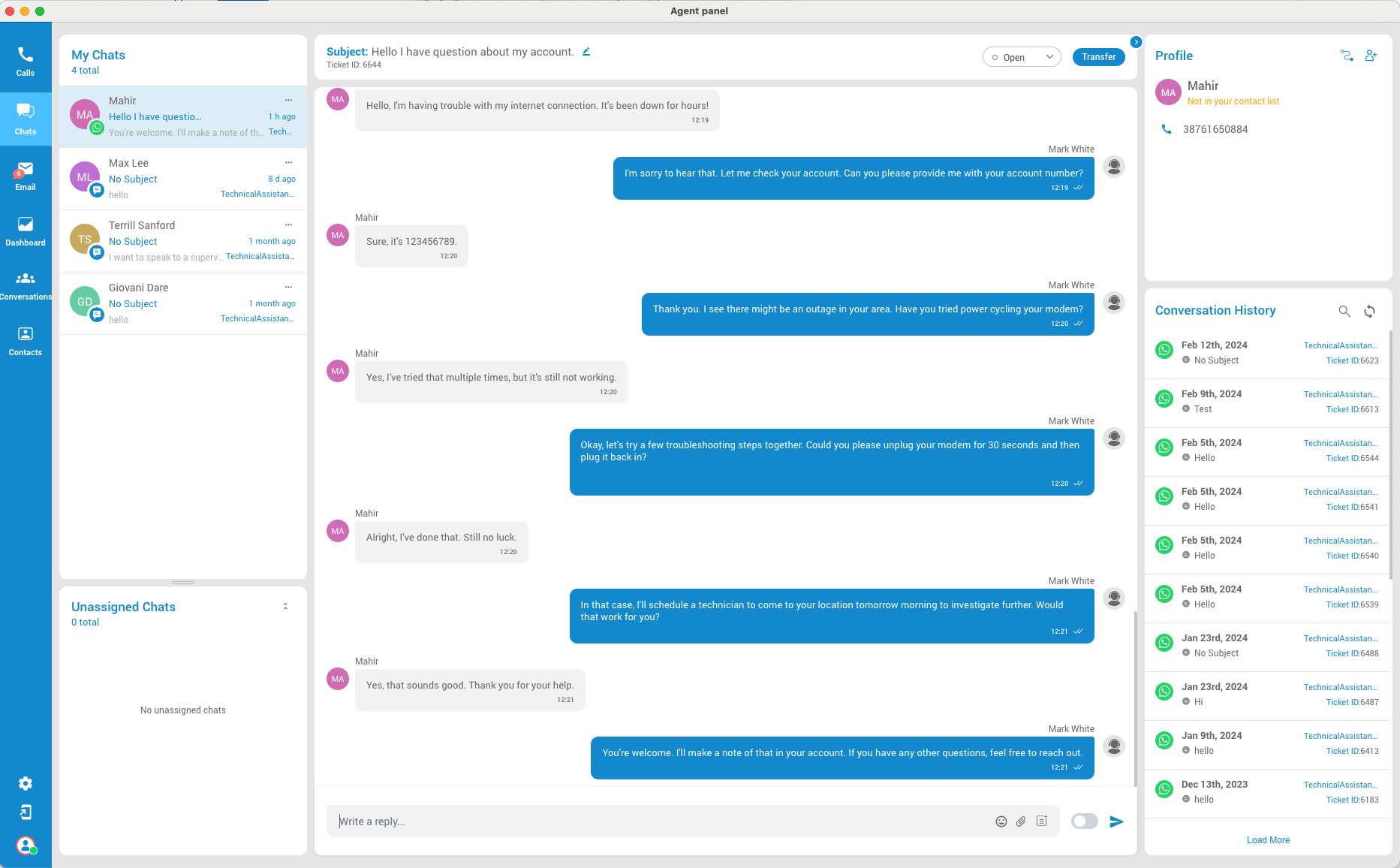
Agents can efficiently send WhatsApp templates during a chat with customers by utilizing the Canned Response/WhatsApp Templates feature. This functionality streamlines communication, ensuring quick and consistent responses.
¶ How to Send a WhatsApp Template
¶ Accessing WhatsApp Templates
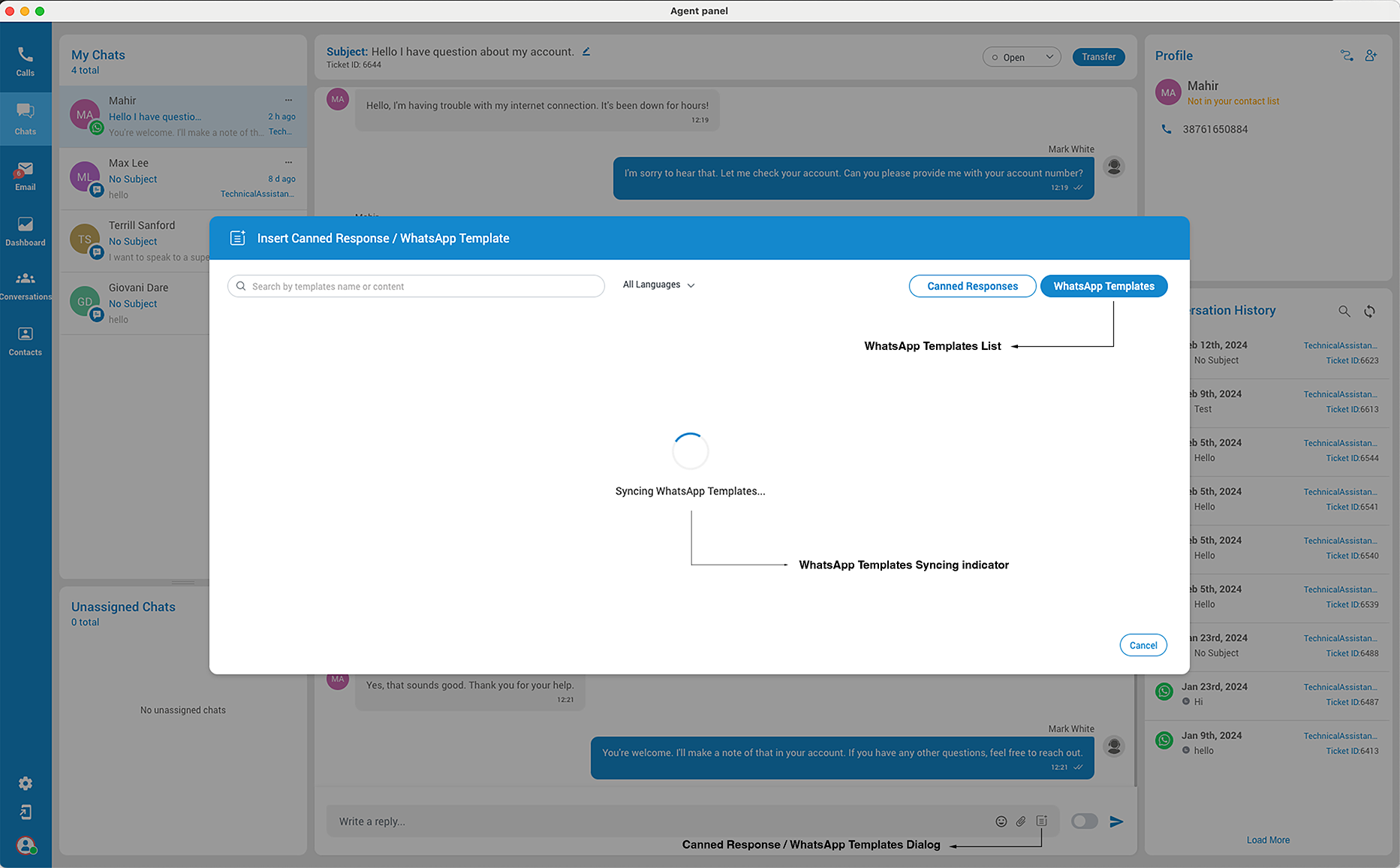
- During a chat, locate the Canned Response / WhatsApp Templates button next to the emoji and attach files buttons.
- Click on this button to open the Insert Canned Response / WhatsApp Template dialog.
¶ Selecting a WhatsApp Template
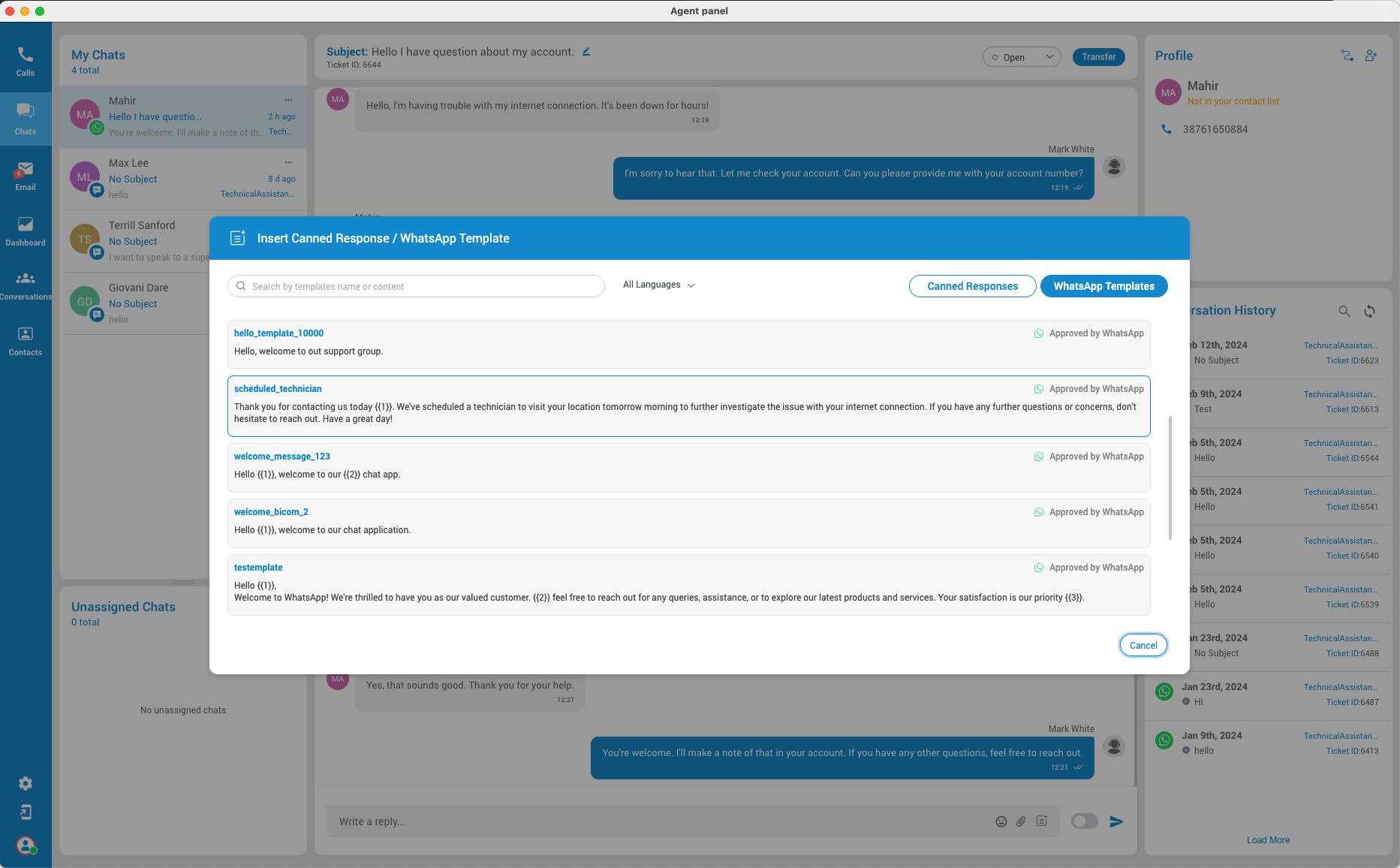
- In the dialog, click on the WhatsApp Templates button located in the upper right corner.
- Wait for the templates to sync. Once syncing is complete, all available templates will be displayed.
- Choose the appropriate template for your conversation. This action leads you to the preview page of the dialog.
¶ Entering Variables and Sending
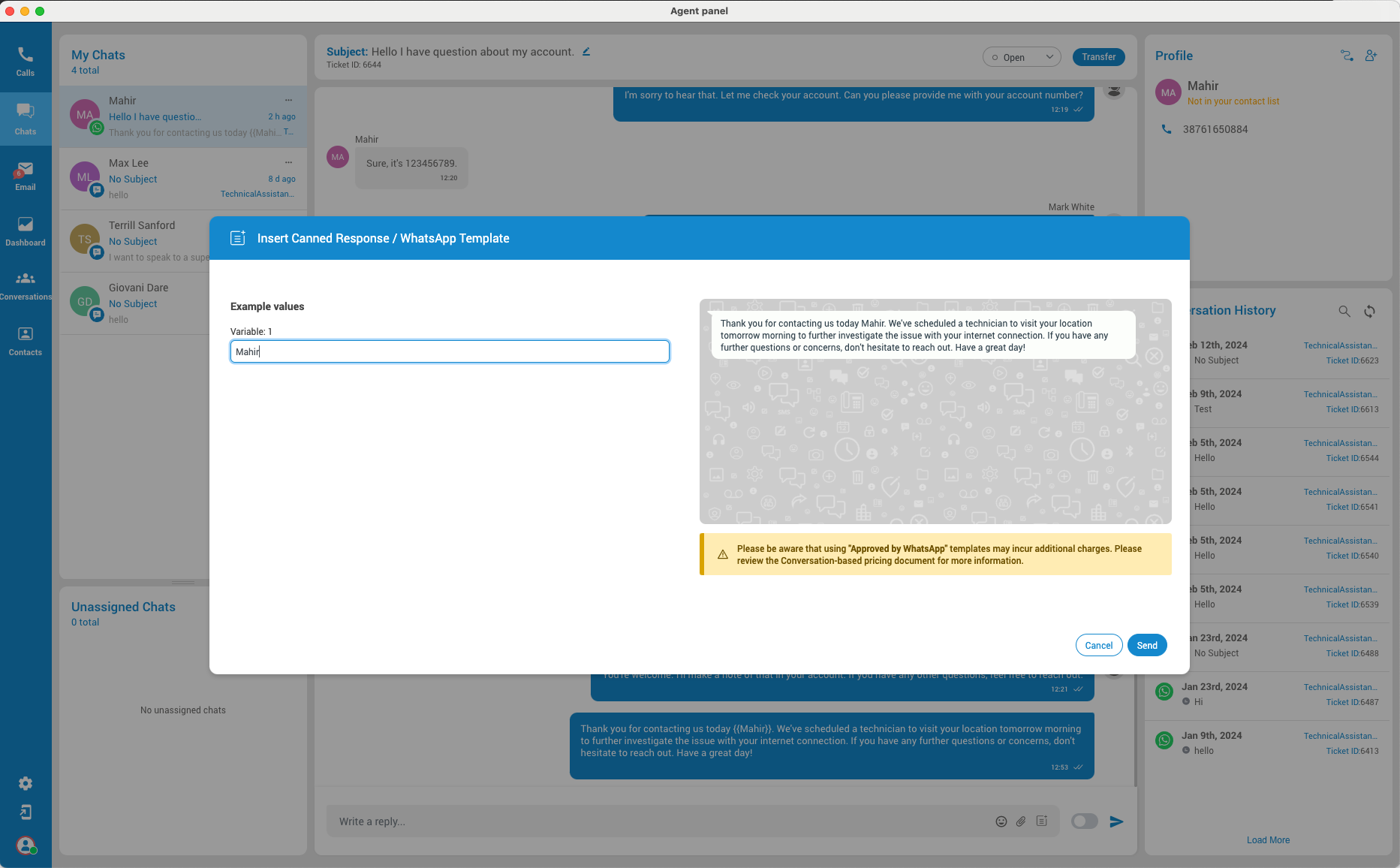
- Enter the required variable(s) for the template, such as the customer's name.
- After entering the necessary information, click the Send button to dispatch the template to the user or customer.
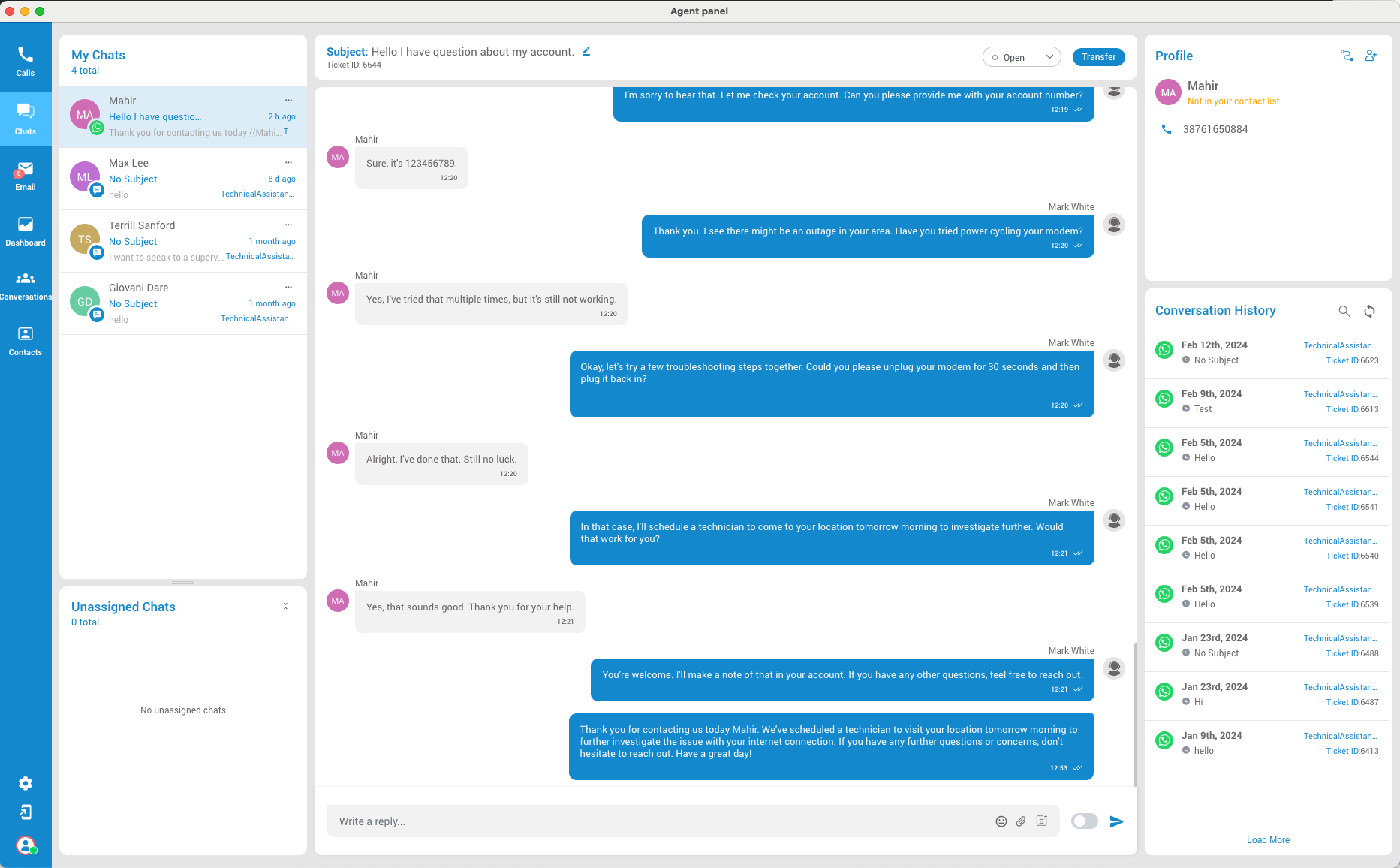
¶ Important Note on the 24-Hour Rule
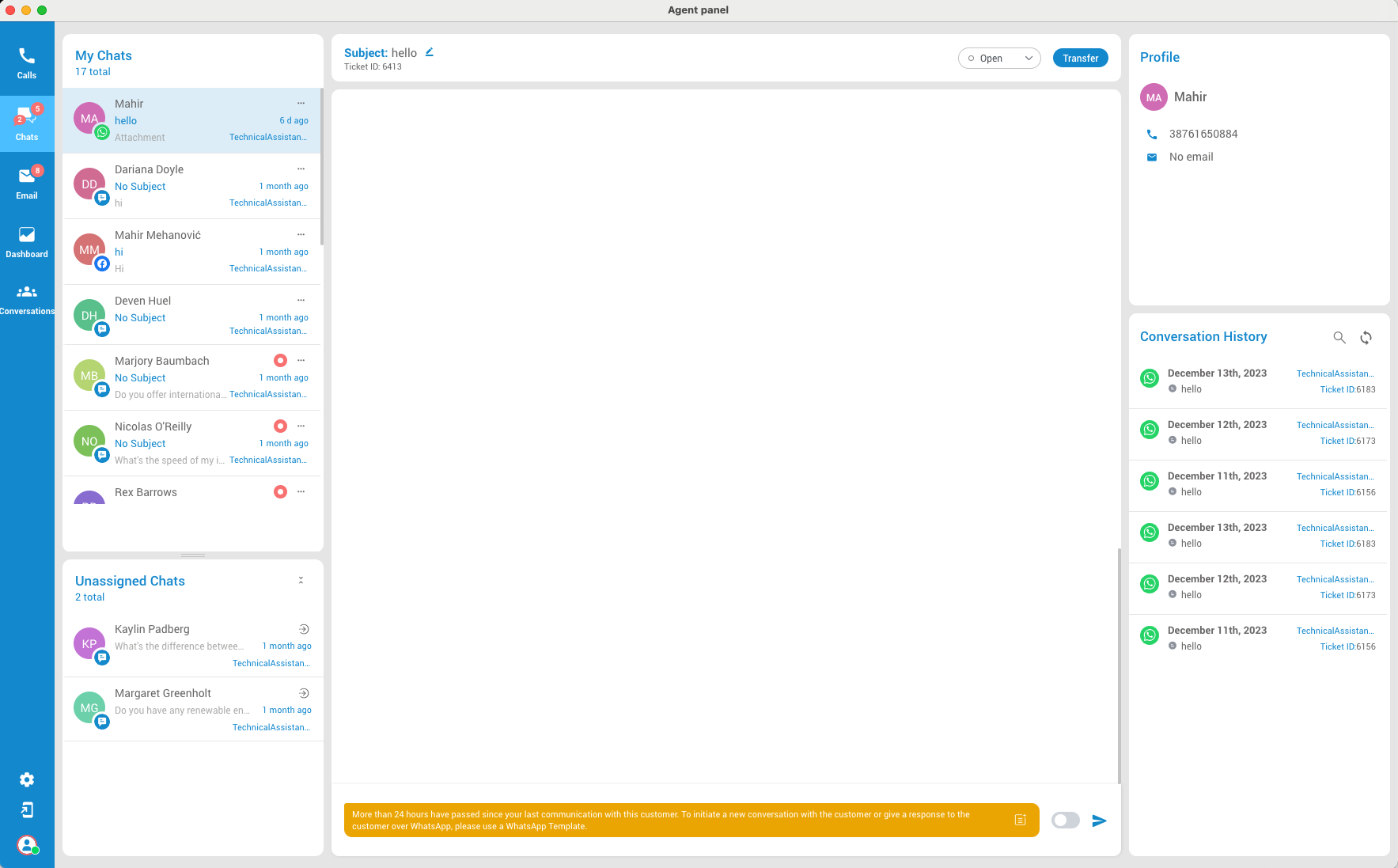
- 24-Hour Communication Window: If 24 hours have passed since the last conversation with a customer via WhatsApp chat, an info bar will cover the text input placeholder. This bar will notify that the 24-hour window has closed and the Agent is restricted to sending only WhatsApp templates until the customer responds again. This rule is part of WhatsApp's policy to ensure timely and relevant communication with customers.
Note: This restriction emphasizes the importance of timely follow-up and the strategic use of WhatsApp templates for re-engaging customers after the 24-hour window has closed.
¶ Security

Specifically designed for LiveChat, this page empowers supervisors and agents to ban and unban customers and access a comprehensive list of banned customers, featuring details about the banned customer, restricted IP, the initiator of the ban, and reasons for the ban. This enhancement bolsters security and control for customer interactions.
The "List of Banned Customers" can be accessed through the "Security" section. It provides the following information in its columns:
- Name: The full name of the banned customer.
- Email: The email address associated with the banned account.
- ID: A unique customer identifier, typically a token.
- IP Address: The last known IP address the banned customer used to access the service.
- Start Date: The date when the ban was initiated.
- End Date: The date when the ban is scheduled to expire.
- Ban Reason: The reason behind the customer's ban, either input by an agent or generated by the system.
- Banned By: Specifies whether the ban was executed by an agent or automatically by the system.
Actions Available
 Ban: Allows supervisors to impose a new ban on an IP address. Agent can not ban IP addresses.
Ban: Allows supervisors to impose a new ban on an IP address. Agent can not ban IP addresses.
 Unban: Permits the removal of a ban. Agents can unban customers they personally banned, while supervisors have the authority to unban any customer.
Unban: Permits the removal of a ban. Agents can unban customers they personally banned, while supervisors have the authority to unban any customer.
 Refresh - We highly recommend that users consistently utilize this button both before and after initiating the ban process. This practice ensures that the data in the table is displayed accurately and reliably.
Refresh - We highly recommend that users consistently utilize this button both before and after initiating the ban process. This practice ensures that the data in the table is displayed accurately and reliably.
In the event that two agents attempt to ban the same IP address, the IP address will not appear twice within the banned list. Instead, the system will consolidate the information. For example, if Agent A wishes to ban IP address 10.0.2.5 for seven days, the ban is approved and displayed in the banned table. Subsequently, when Agent B also wants to ban the same IP address (10.0.2.5) for 14 days, the data within the banned list will be updated with the information provided by the second agent. As a result, the IP address 10.0.2.5 will show a 14-day ban in the table, effectively overriding the initial 7-day ban set by Agent A.
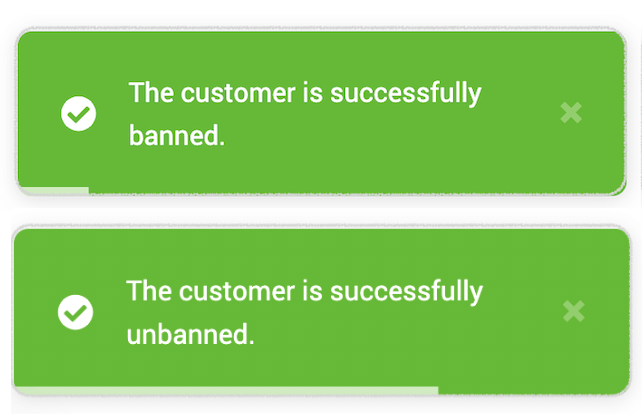
Once a customer has been successfully banned or unbanned, a corresponding message will appear within the agent panel, providing confirmation and information about the action taken.
User Permissions
- Agent Permissions: Agents can view the complete list of banned customers and unban only those customers whom they have personally banned.
- Supervisor Permissions: Supervisors can view the list and unban any customer, irrespective of who initiated the ban.
The ban feature serves various purposes, including:
- Auditing and Tracking: It facilitates the monitoring of banned customers for security and compliance purposes.
- Efficient Management: It streamlines the management of banned users, making it easier to lift bans when required.
- Informed Decision-Making: It equips agents and supervisors with the essential information to make well-informed decisions regarding bans and unbans.
¶ Show Main Window
![]()
The feature brings the application's main window to the forefront, making it the active and visible.
¶ Profile
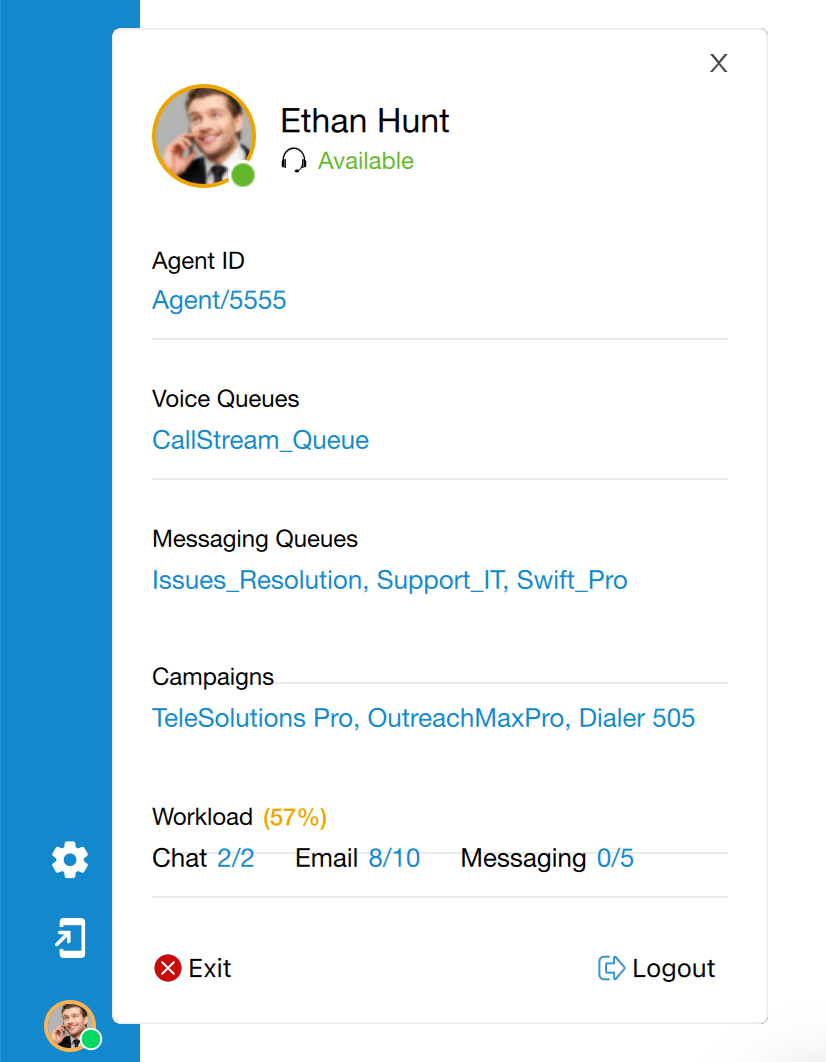
The Profile section provides comprehensive details about the agent, including their name, state, agent number, involvement in voice and messaging queues, assigned campaigns, and the agent's current workload.
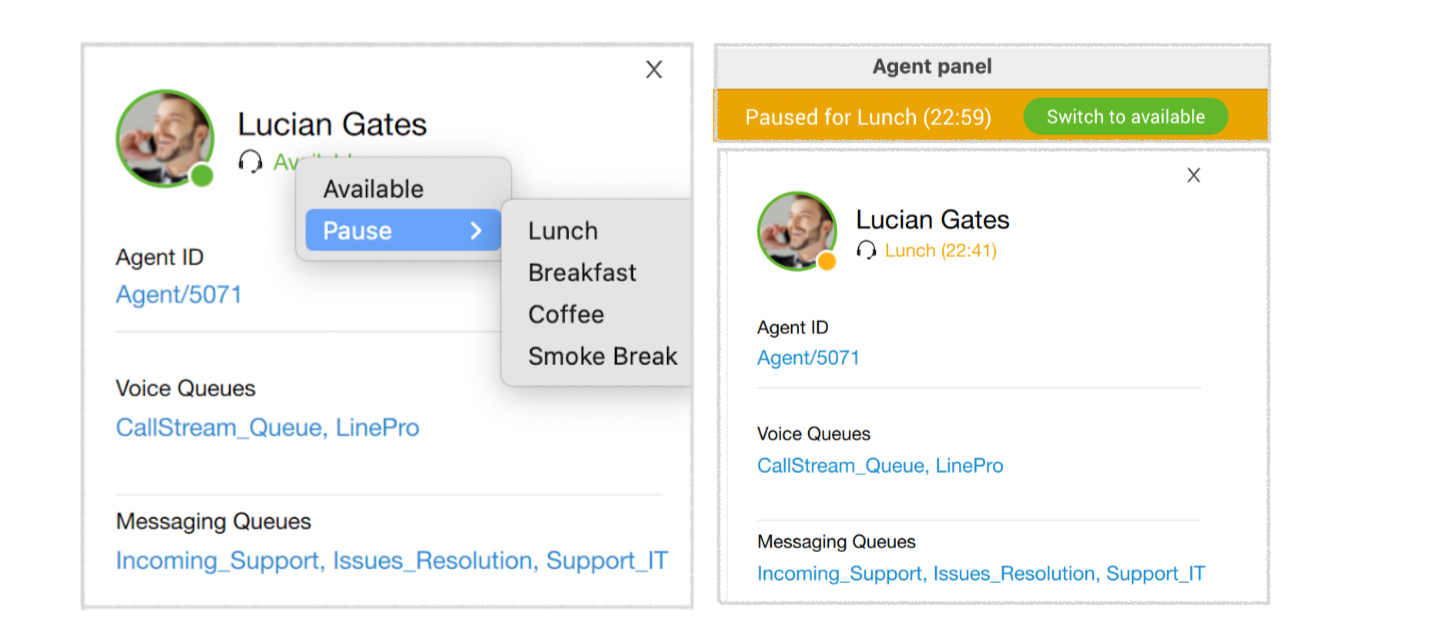
Within this section, agents have the ability to transition their status from 'Available' to 'Pause.' Through the dropdown menu, they can specify the reason for their pause.

A colored banner will display across the agent panel, indicating the duration of the pause state, allowing agents to easily track the paused time.
Towards the bottom of this section, the agent has two options. They can either select "Exit" to close the application entirely or opt for "Logout" to log out from the agent's app.
the application entirely or opt for "Logout" to log out from the agent's app.
¶ OmniChannel Licensing
Unlock the potential to elevate your customer service with the gloCOM Agent edition and OmniChannel module. Contact your provider to explore enabling the Contact Center edition with the Omnichannel module in your license and begin delivering exceptional service to your customers.
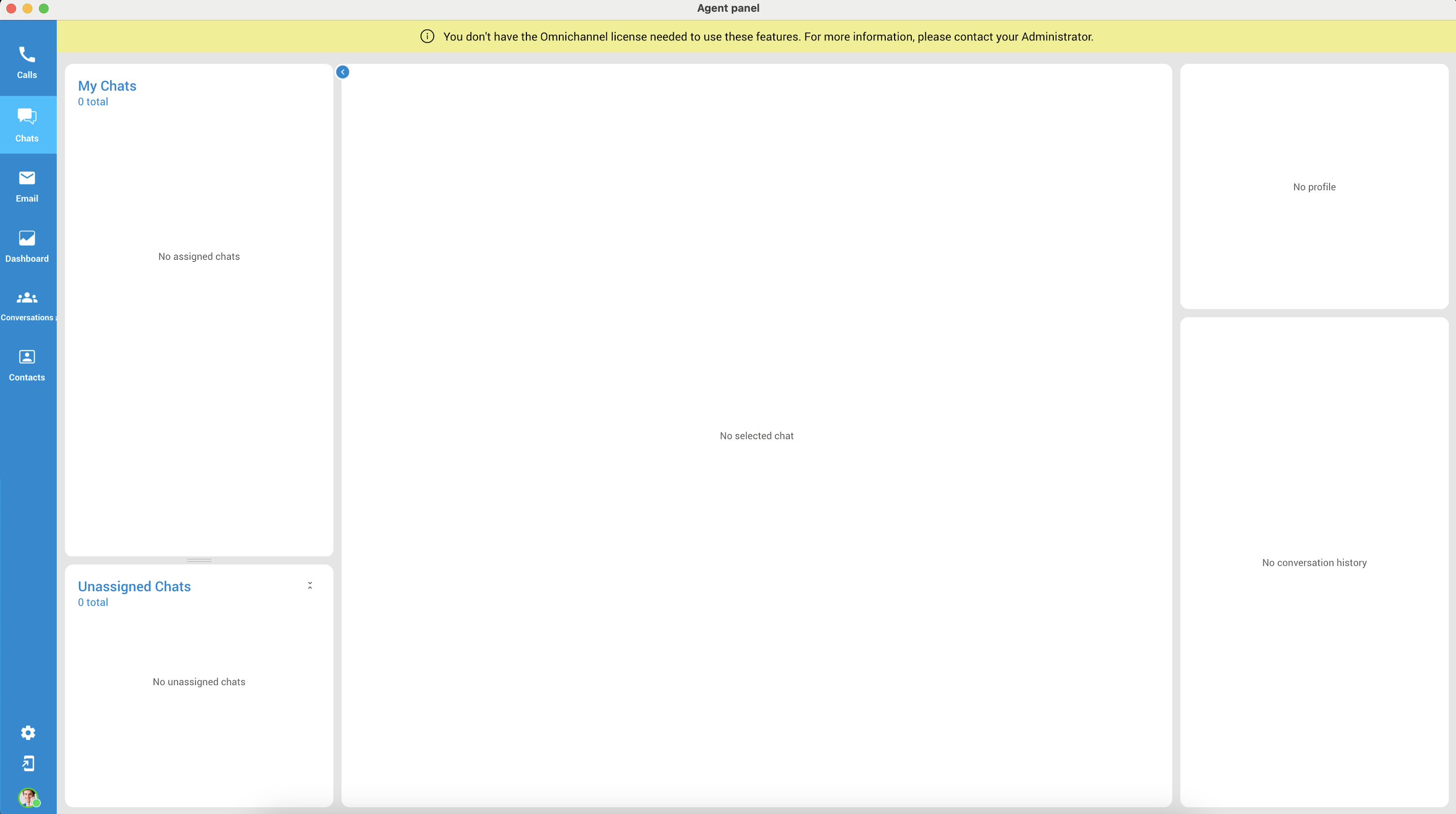
If your Contact Center edition lacks OmniChannel activation or you've reached the OmniChannel module limit, notifications will be displayed within the agent/supervisor panel.
Note: If the Omnichannel feature is not activated in the user's license, the sections associated with Omnichannel will not be presented or visible in the Agent Panel.
¶ OS Native Notifications for OMNI Messaging Events
Like gloCOM, which provides native OS notifications for various events (e.g., new messages, phone calls, missed calls), OMNI Agent app should also offer similar notifications for its messaging events. These notifications are crucial for agents who may be working in other applications, as they alert them to visually and audibly important events.
¶ Some of Key Events for Notifications:
- New Customer Message: Alert when a customer sends a new message.
- Customer in Queue: Notification when a new customer waits in the queue.
- Ticket Assignment: Important, especially for automatic assignment strategies, notifying agents when a ticket is assigned to them.
- Ticket Transfer: Alert when a ticket is transferred to the agent.
¶ Notifications and Indicators in gloCOM's Omni-Channel
¶ New Assignments and Transfers
- Chat Assignments: When a chat is automatically assigned or transferred to an agent, a notification will appear saying, "You have a new assigned chat."

- Email Assignments: Similarly, if an email is automatically assigned or transferred to an agent, the notification will state, "You have a new assigned email."

¶ Unread Messages and Emails
- Chat Messages: Unread messages, whether assigned or unassigned, will be marked with a bold red circle.

- Emails: Unread email tickets in the assigned or unassigned list will also be marked with a bold red circle. Clicking the circle will acknowledge the ticket and remove the indicator.

¶ Notifications for Ongoing Chats and Emails
- Chat Messages: If an agent is in another chat or the app is in the background, new messages in ongoing chats will trigger a "You have a new message" notification.

- Emails: If the agent is working on another task or chat, notifications for new emails in ongoing threads will be displayed similarly.

¶ Message and Email Counts
- Chat Messages: The number of new messages in ongoing chats will be displayed within each ticket in the list of assigned tickets.

- Emails: A red circle with a number will indicate the total count of new emails received by the agent.

¶ General Notifications
- Unassigned Emails: If a new email is in a queue but remains unassigned, or if an email is transferred to an agent, a notification will be triggered.

- Unassigned Messages: If a new message is in a queue but remains unassigned, or if an message is transferred to an agent, a notification will be triggered.

- gloCOM Summary: gloCOM will display the total number of unread messages and emails, as well as the count of assigned or unassigned chats and emails.
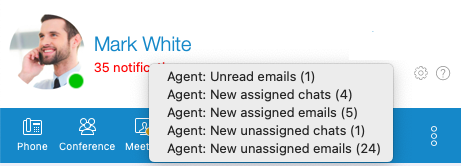
Note: For all the events described above, dock and sound notifications will be displayed, similar to those for calls and chat messages.
¶ Chat Event Notifications
Agents will receive notifications directly within the chat window whenever specific events related to conversation assignments take place. These notifications are designed to keep agents informed, ensuring they stay updated on relevant ticket assignment activities in real-time.
¶ Event Notifications
Start/Closed & Joined Conversation
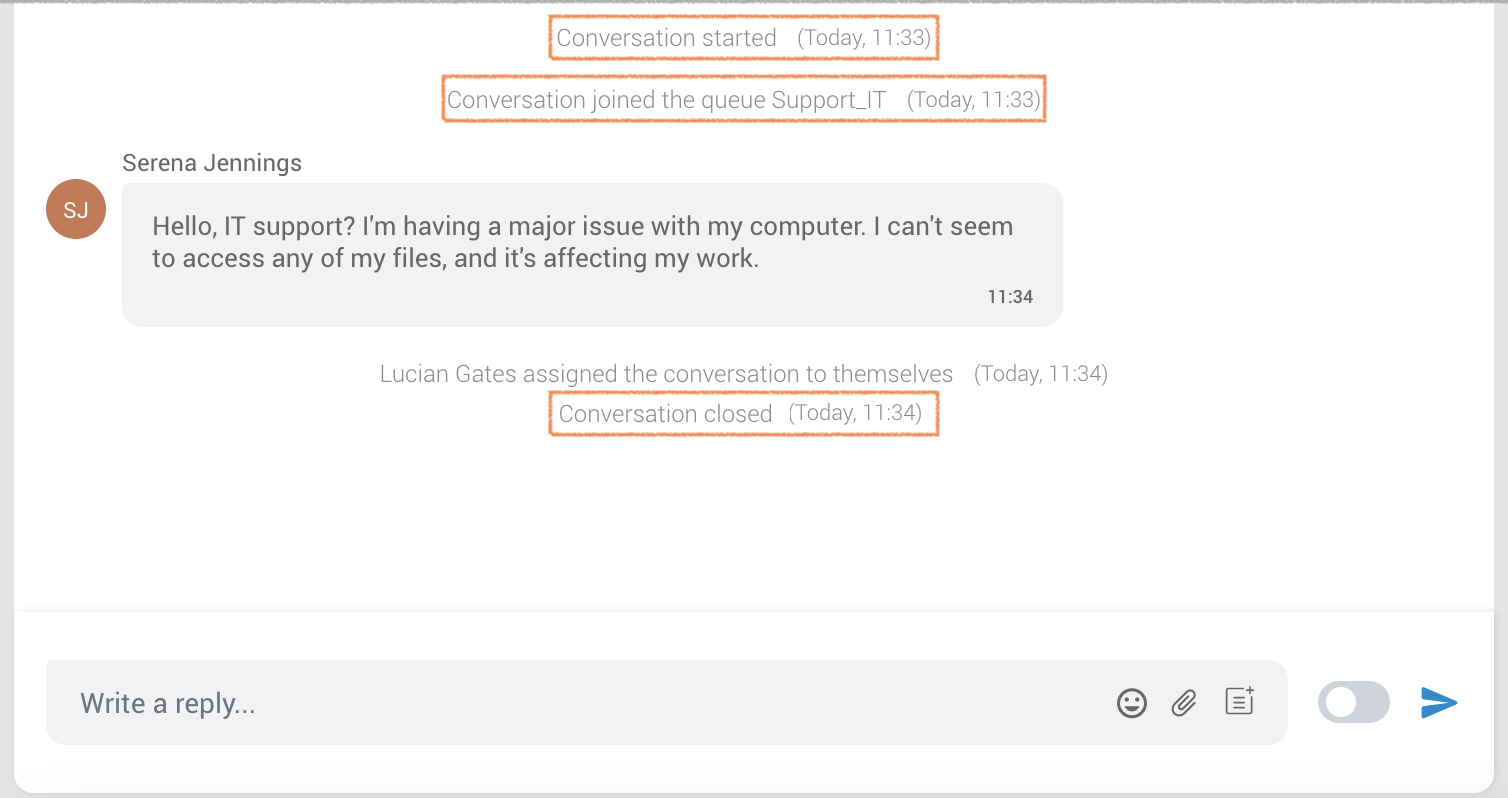
When a conversation begins, a notification is displayed to inform agents about initiating the interaction.
Upon the closure of the conversation, a corresponding notification is generated to signal the closing of the communication.
Additionally, the system reveals the queue name associated with the conversation, providing valuable context about the queue from which the customer initiated the conversation.
Auto-Assignment
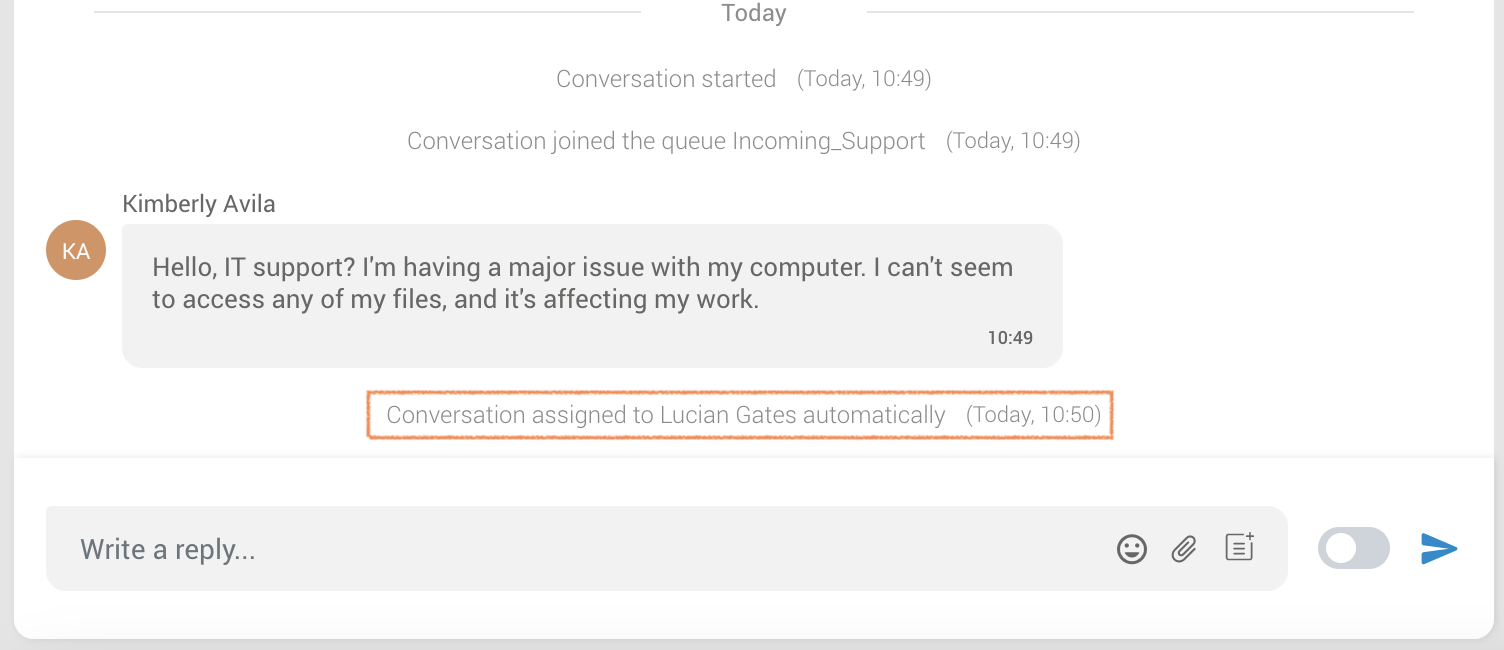
In the event of an automatic conversation assignment, a notification message will be displayed: "Conversation assigned to [Agent Name] automatically."
This ensures that agents are promptly informed when the system automatically assigns a conversation to a specific agent.
Manual Assignment
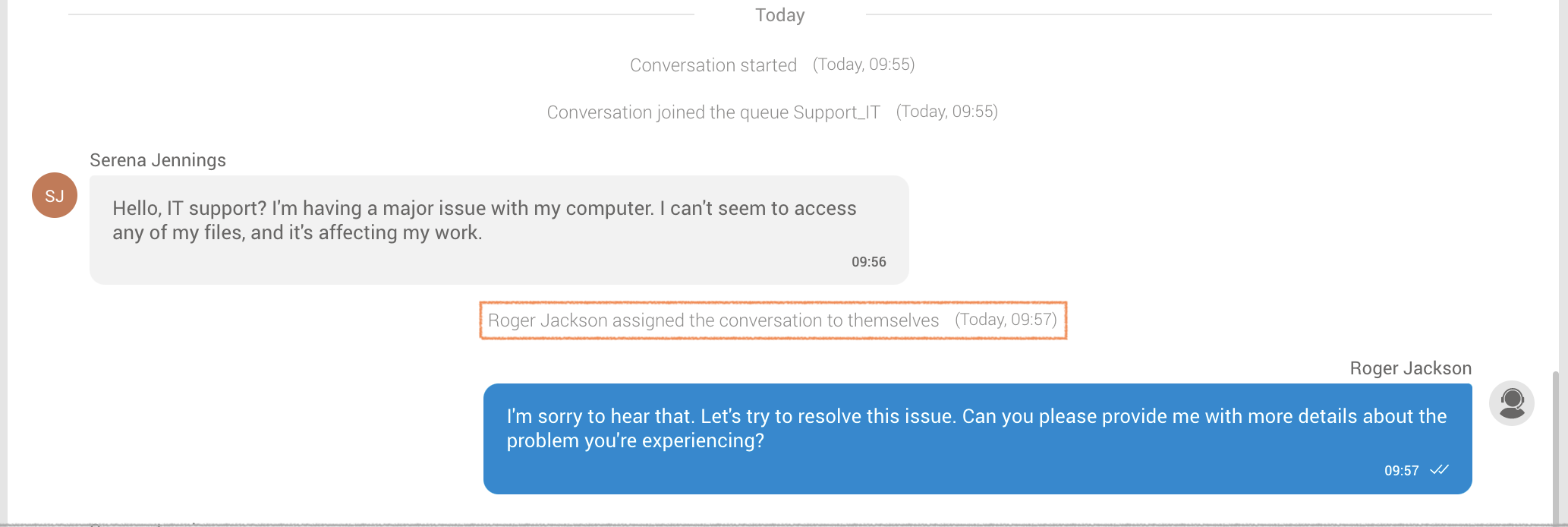
When an agent manually assigns a conversation, a notification message will appear: "[Agent Name] assigned the conversation to themselves.
This alert provides clear communication within the system, letting others know when an agent takes direct ownership of a ticket assignment.
Returning Customer

In the case of a conversation involving a returning customer, a notification message will be conveyed: "Conversation assigned to [Agent Name] due to last interaction with returning customer."
This notification ensures that agents know why the conversation is assigned, highlighting the importance of past interactions with returning customers for a more personalized and informed support experience.
Transfers
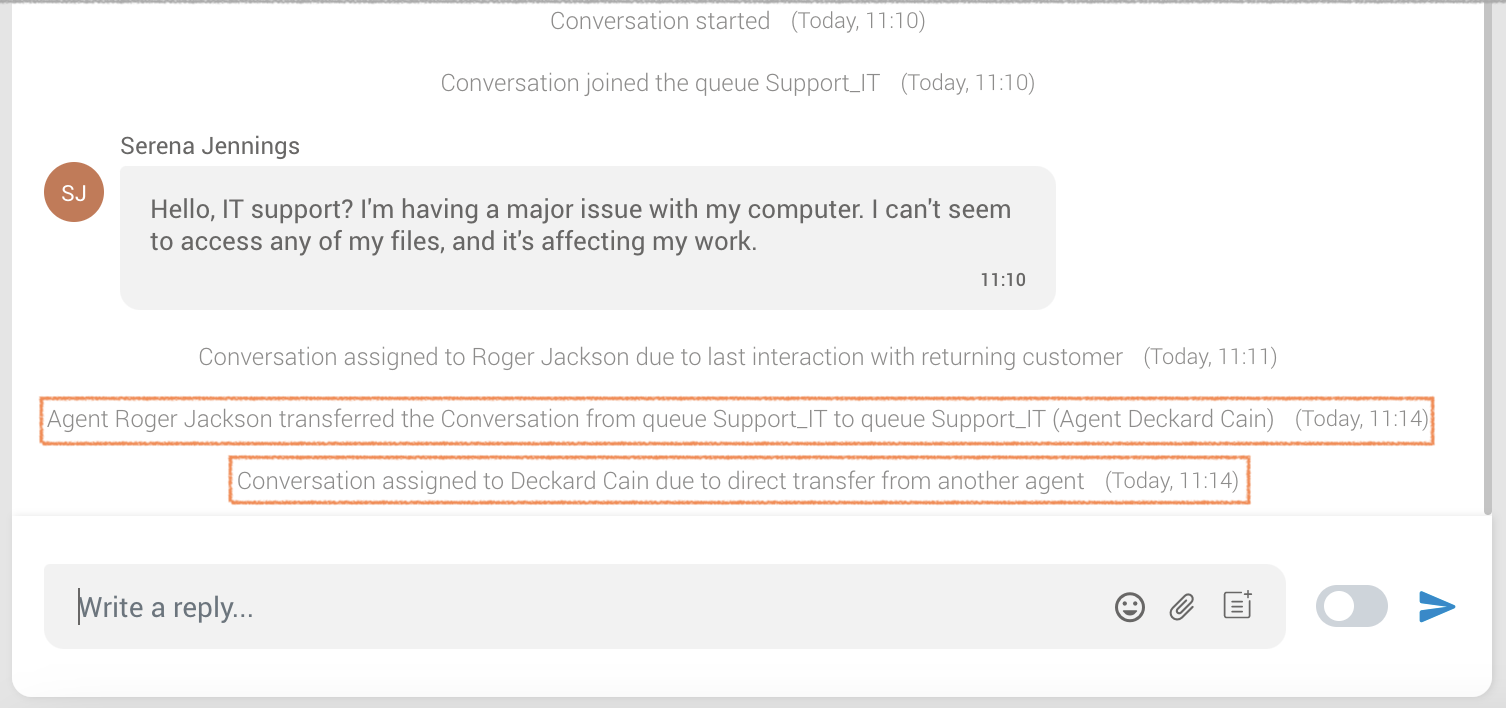
In the scenario where a conversation is transferred from another agent, a notification message will be displayed: "Conversation assigned to [Agent Name] due to direct transfer from another agent."
In the case where a conversation is transferred from the same queue, a notification message will be displayed: "[Agent Name] transferred the Conversation from queue [Queue Name_One] to queue [Queue Name_One]."
(e.g., "Agent Roger Jackson transferred the Conversation from queue Support_IT to queue Support_IT.")
In the case where a conversation is transferred from another queue, a notification message will be displayed: "[Agent Name] transferred the Conversation from queue [Queue Name_One] to queue [Queue Name_Two]."
(e.g., "Agent Roger Jackson transferred the Conversation from queue Support_IT to queue Swift_Pro.")
This notification informs agents about the source of the conversation assignment, promoting transparency and clarity in the workflow when conversations are handed over between team members.
¶ Placing Video Calls
To place a video call, right click on a gloCOM contact and select Video Call from the drop-down menu.
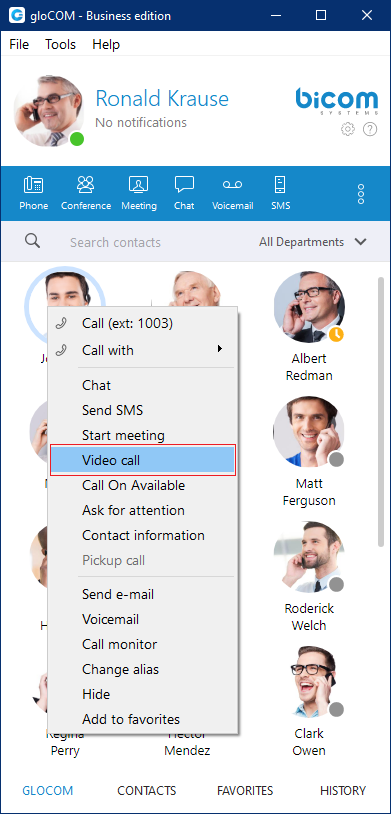
¶ Sending Fax
- Outgoing faxes
- Click on the Fax module icon, then select Send fax to open the Fax module.
- Read the information message and click the OK button.
PDF file:
- Enter the path or browse for a PDF file that you wish to send using the icon.
Information that you enter in the Send Fax wizard will be displayed on the fax cover page if you choose to send a cover page. In the Send Fax window you can see two sections, To and From.
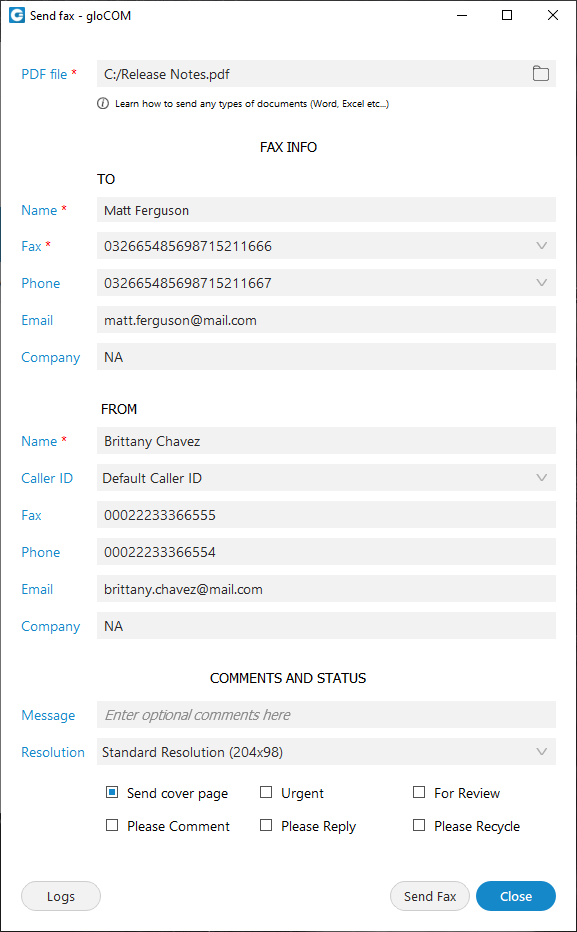
TO Section
- Name: Enter the name of the recipient. For example, Tim Barr.
- Fax: Enter the phone number to which you want to send your fax, for example, 02033998800.
- Phone: Enter the phone number of the recipient.
- Email: Enter the recipient's email.
- Company: Enter the recipient's company name.
FROM Section
- Name: This field will be automatically populated with your gloCOM username.
- Caller ID: Caller ID is a drop-down menu with the list of caller IDs allowed for an extension. Caller IDs are added from the PBXware GUI.
- Fax: Enter your fax number.
- Phone: Enter your phone number.
- Email: Enter your email.
- Company: Enter your company's name.
Additional information like comments and status can be entered also.
When sending a fax user is presented with a Sent X of Y pages so fax sending progress is more detailed.
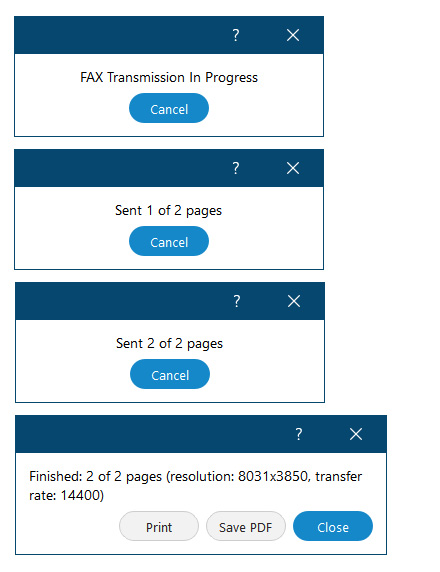
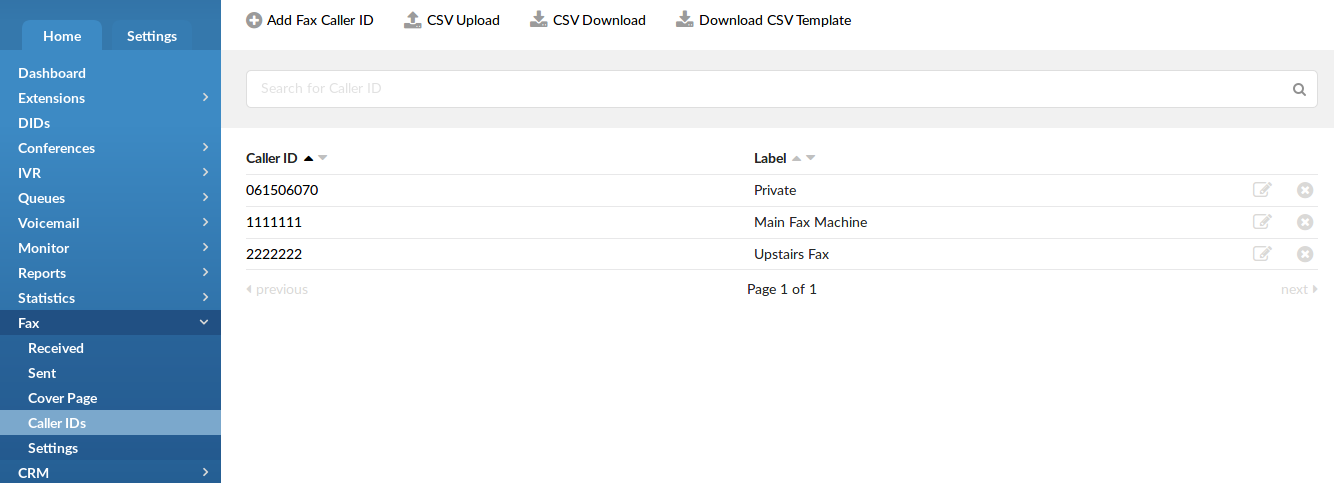
- Incoming faxes
- Show list of all received and pending fax documents.
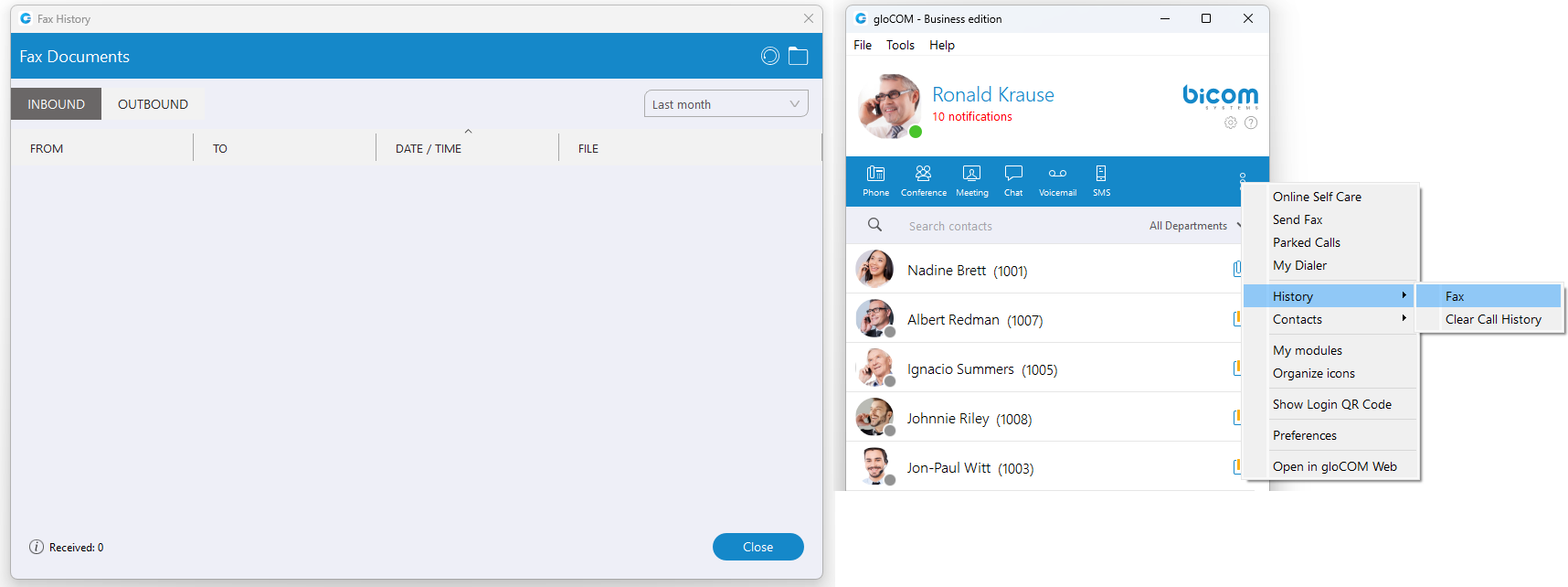
¶ Supervisor (available in gloCOM Supervisor edition)
¶ Supervisor Login With Agent Number
Refinements to the supervisor login window prioritize security measures and simplify data management, contributing to an enhanced user experience tailored for the Supervisor edition.
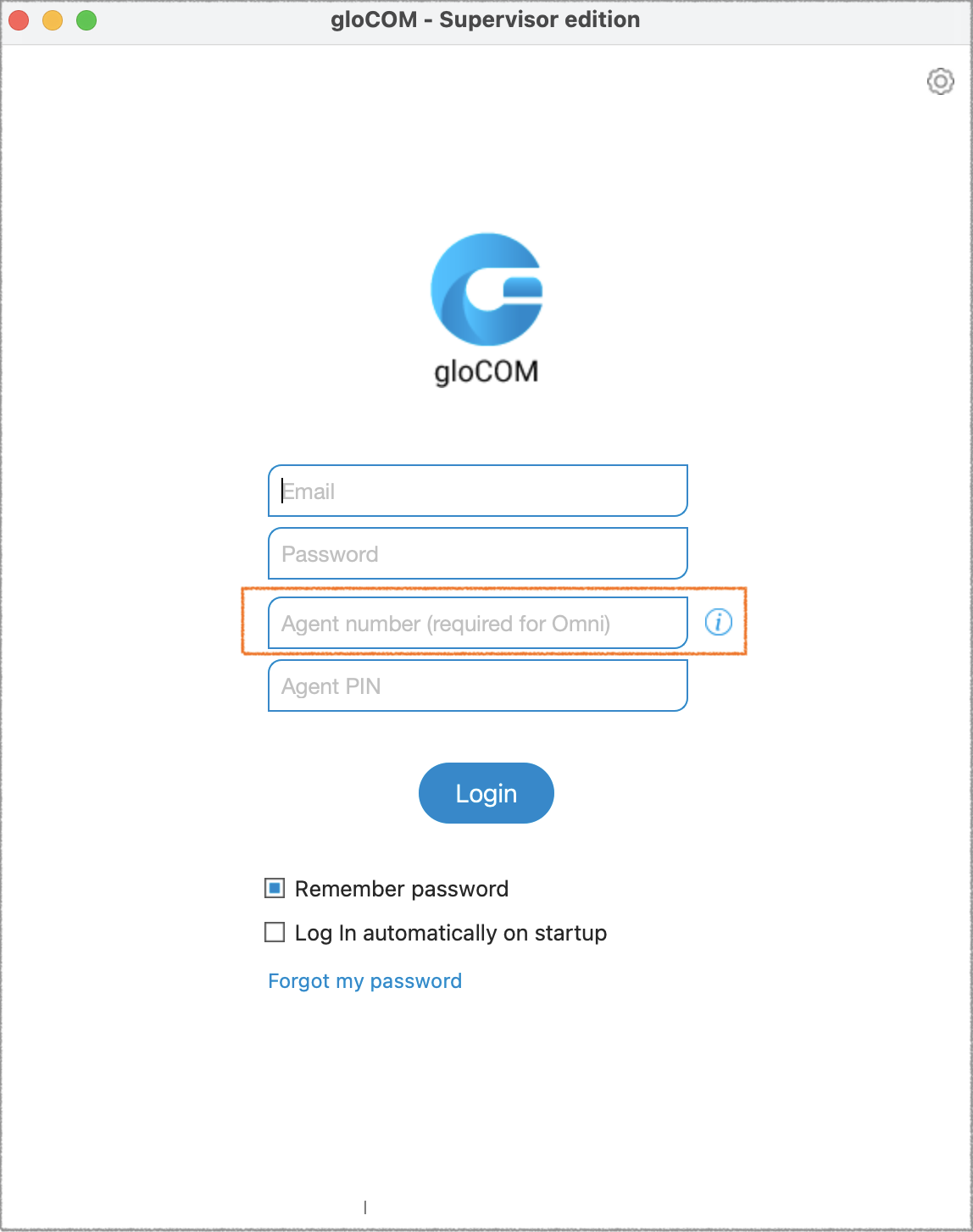
Supervisors will log in as agents using specific credentials:
- Agent number assigned to the Supervisor (required)
- Agent PIN (optional)
These changes address privacy concerns by allowing supervisors to monitor only the queues and agents they are responsible for. Also, Supervisors must be added as members of specific queues to enable monitoring.
¶ Voice Page on Initial Login
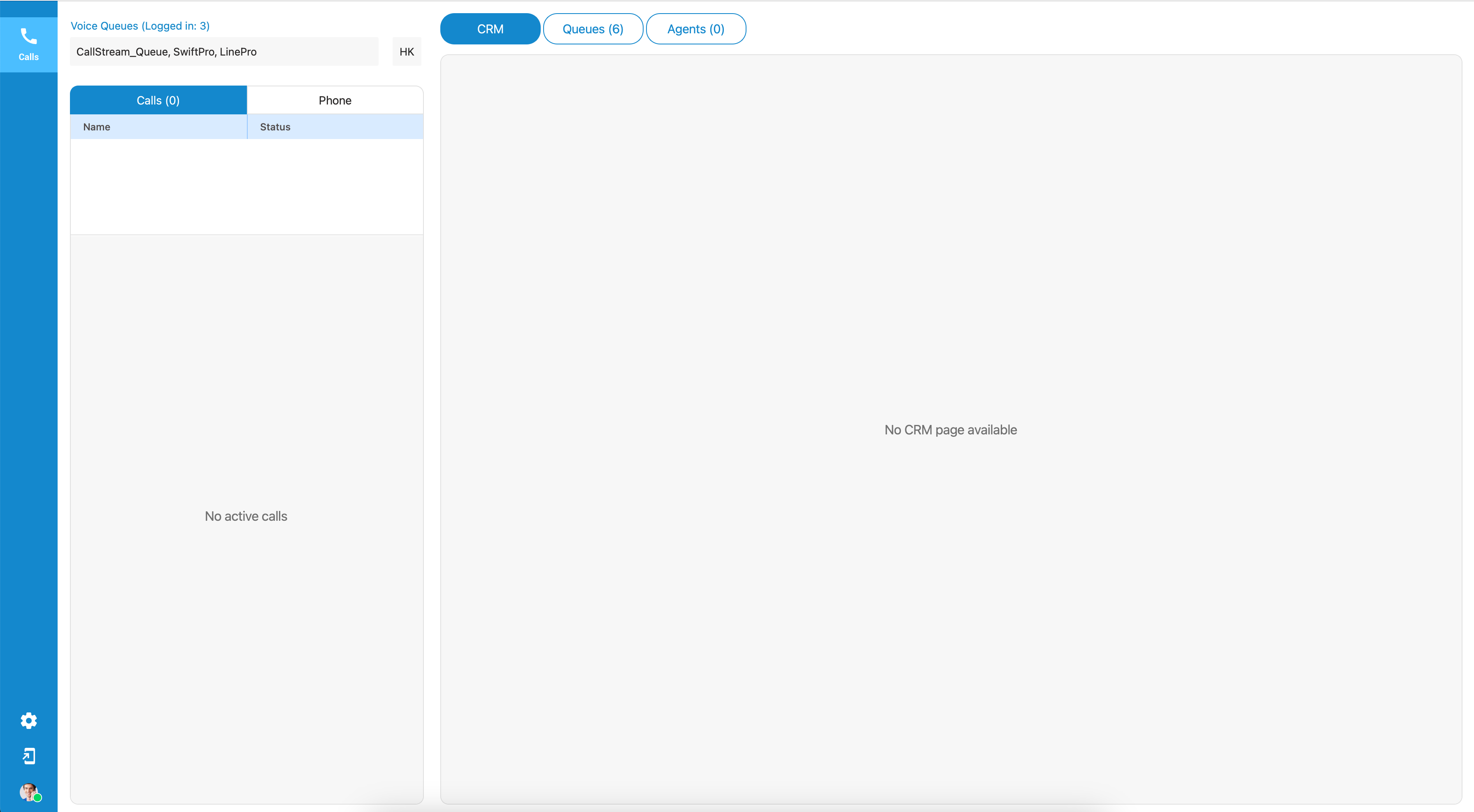
Users who have provided an agent number for login and do not have the omnichannel module enabled in their license will be directed automatically to the 'Voice' page upon opening the agent panel. All other supervisor options will remain unchanged within the supervisor panel.
This specific behavior only occurs during the initial login.
¶ Logged Off State by Default
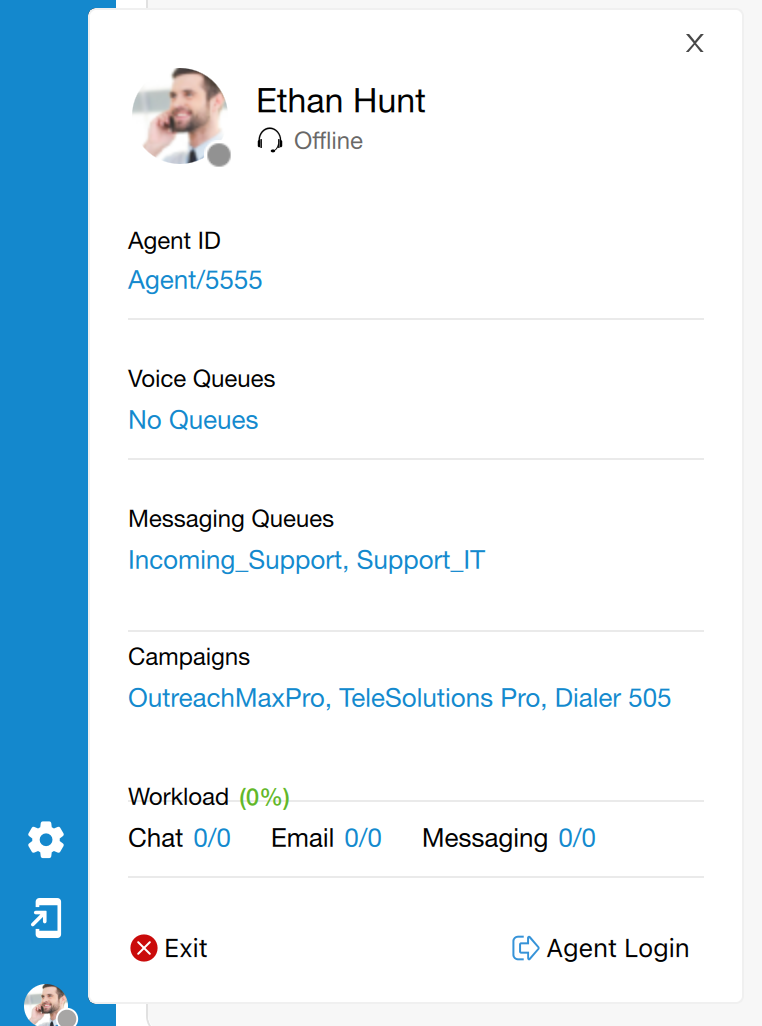
Supervisors logging in will now find themselves automatically set to an 'Offline' state. This change aims to enhance user focus by restricting the receipt of voice conversations.
Even in the 'Offline' state, supervisors maintain the ability to receive direct incoming calls, make outgoing calls, and view the online status of agents and active queues.
While in the 'Offline' state, supervisors will still have unrestricted access to all functions, including monitoring conversations and utilizing the dashboard within the Supervisor panel.
¶ Back to Online State
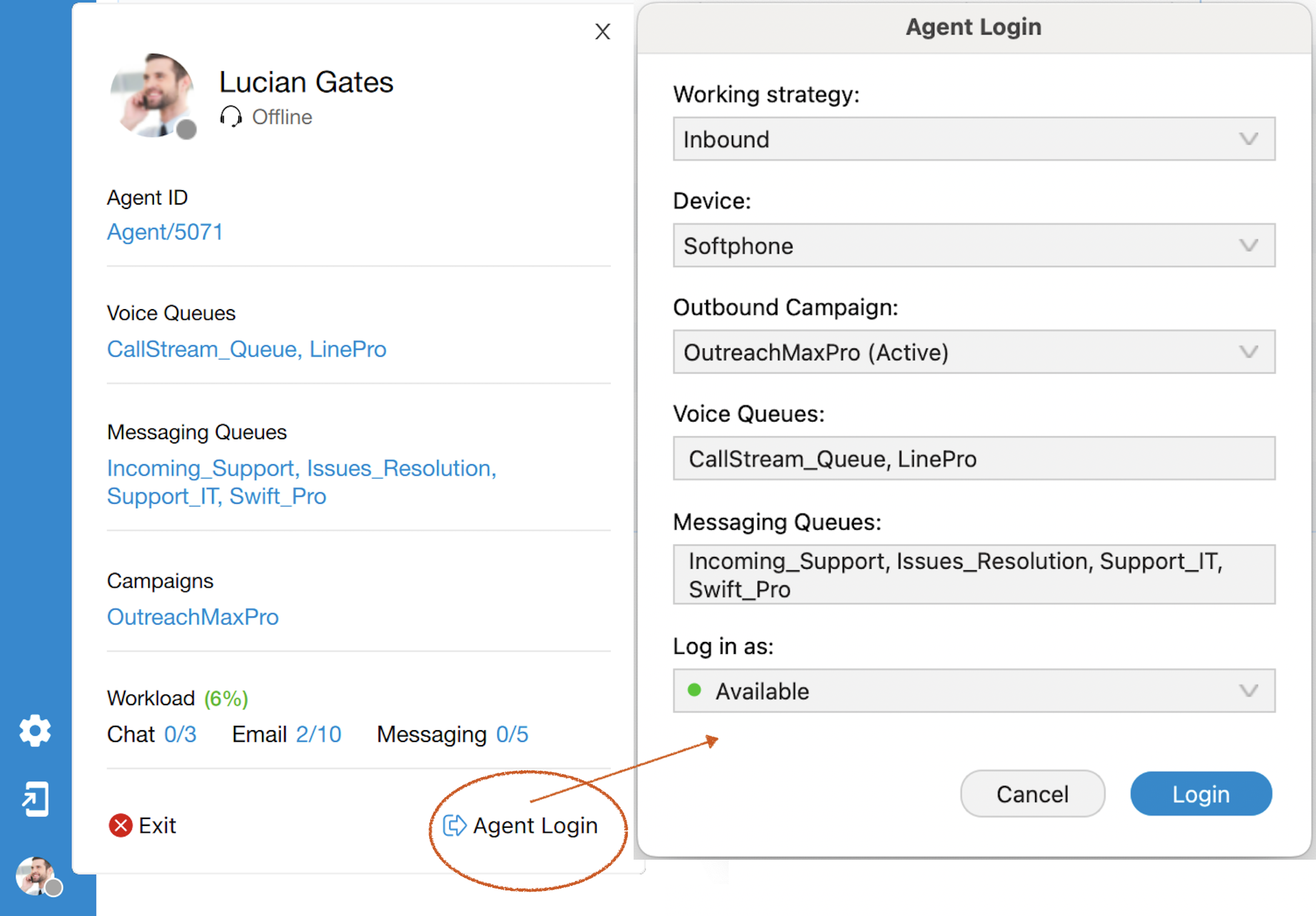
Users must click the 'Agent Login' button in the agent profile section to begin receiving voice calls. A confirmation window will prompt them to confirm their login.
¶ Supervisor Login Without Agent Number
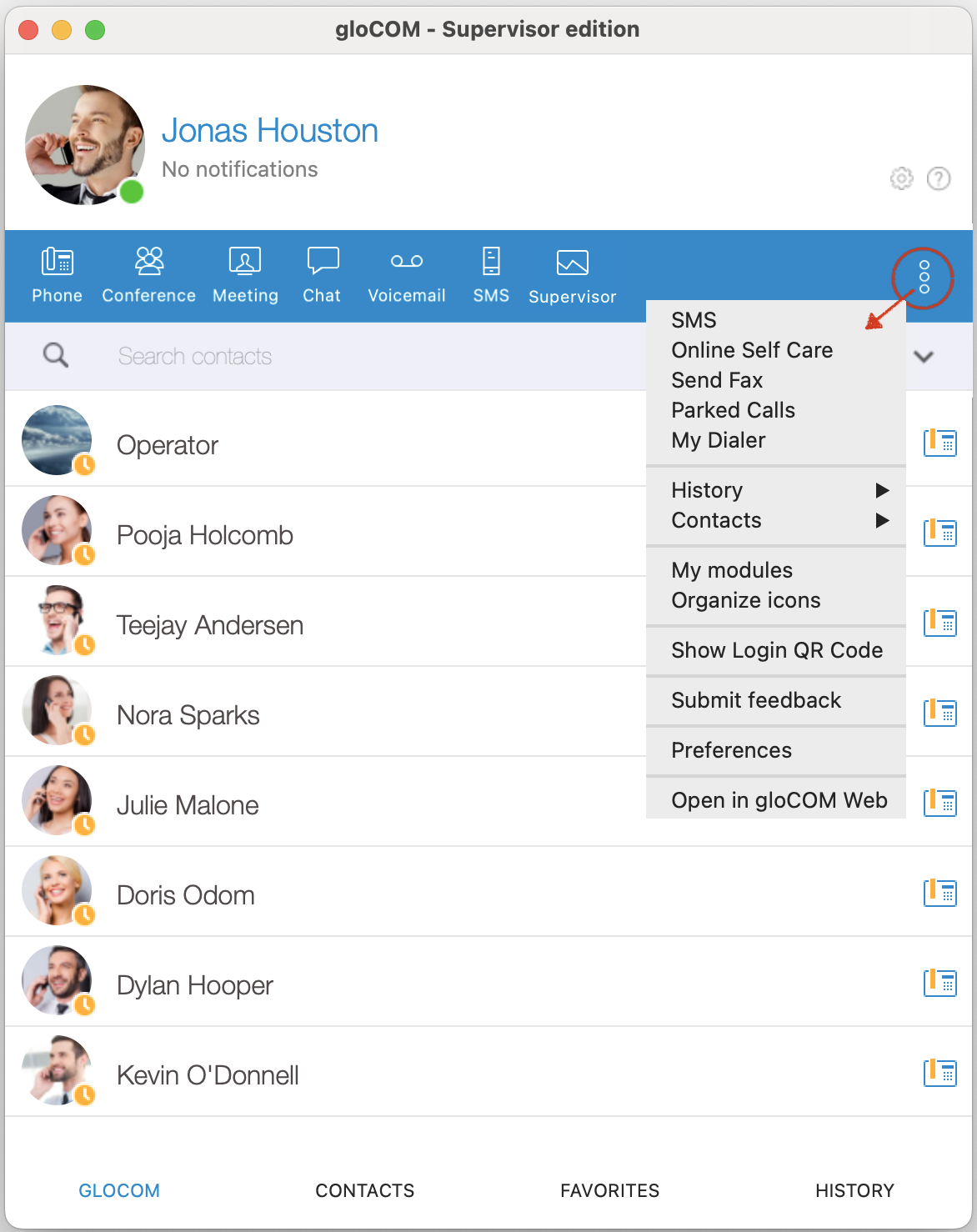
If users attempt to log in without entering an agent number, they’ll successfully access the app’s main page, but they won’t be able to use or activate the Agent panel. However, the Supervisor panel will remain accessible for use.
¶ Supervisor Panel
Advanced and improved design of the Supervisor Panel was created.
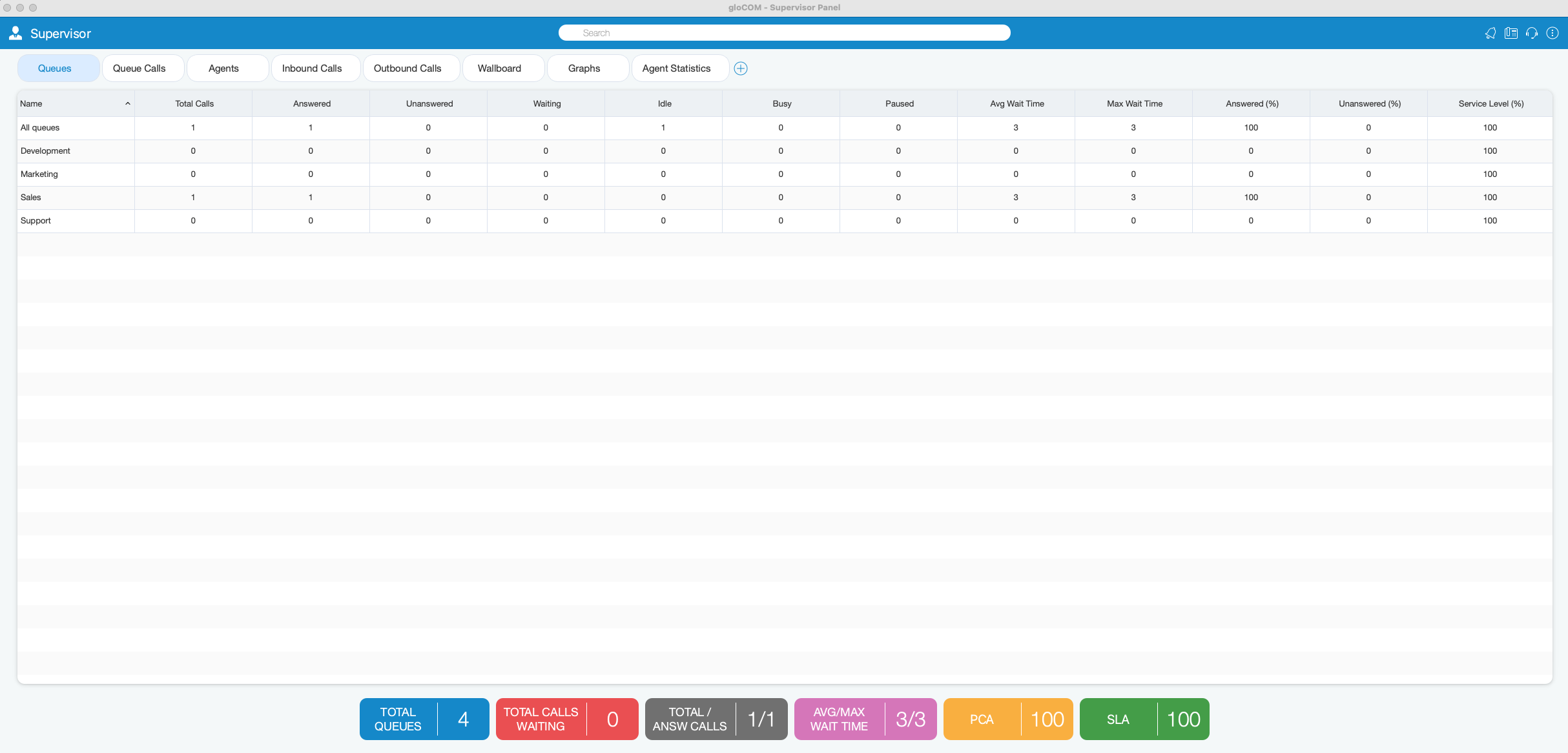
¶ Search Field
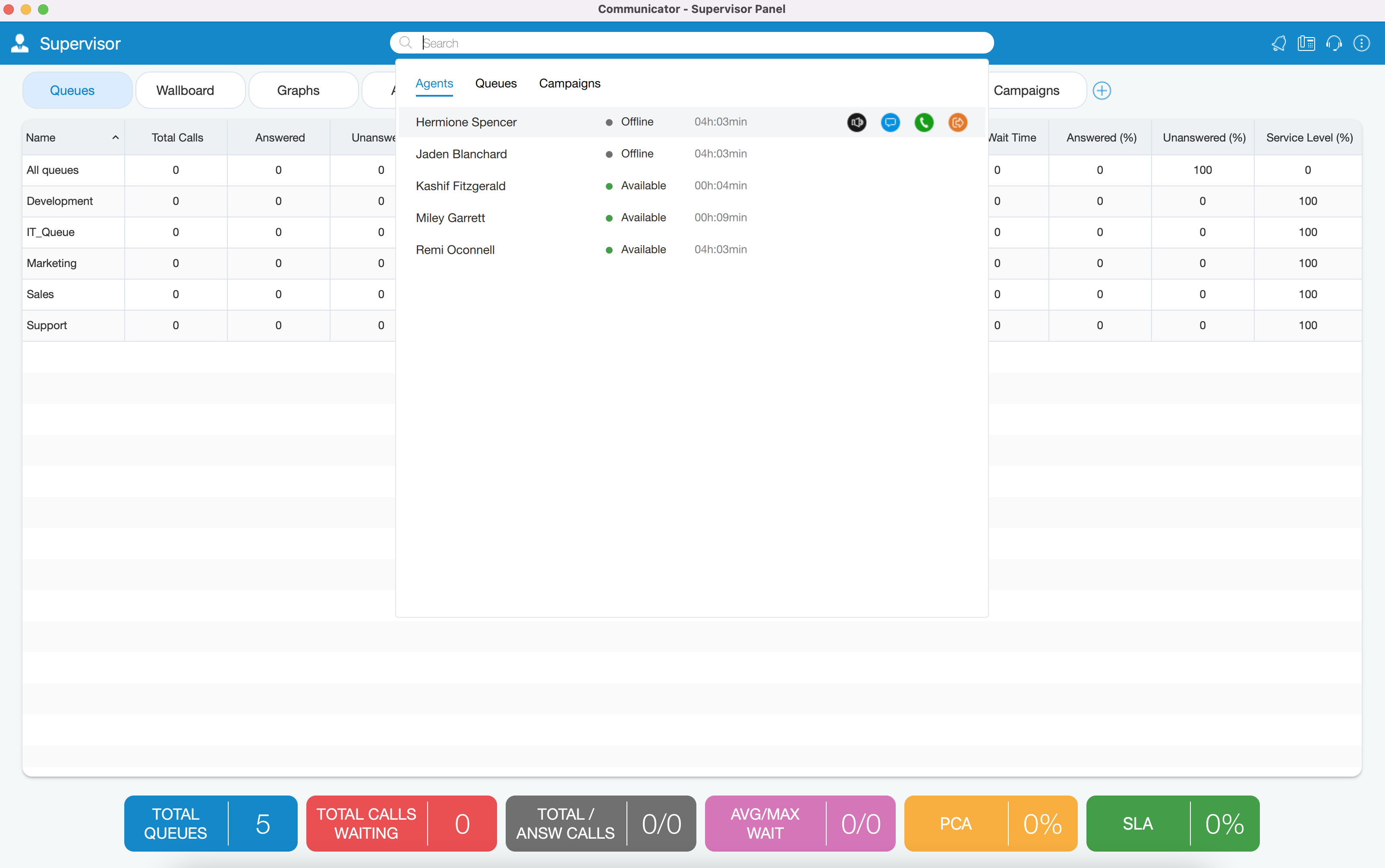
A Search field has been added inside the Supervisor Panel. It is possible to search for Agents, Queues, or Campaigns.
When the user clicks on the Search field, the view with all Agents/Queues/Campaigns should be displayed. This view is visible only if the Search field is focused. If the user clicks anywhere outside the Search field or that view, it will close.
Agents are searched by a name or number. Queues and Campaigns are searched by name.
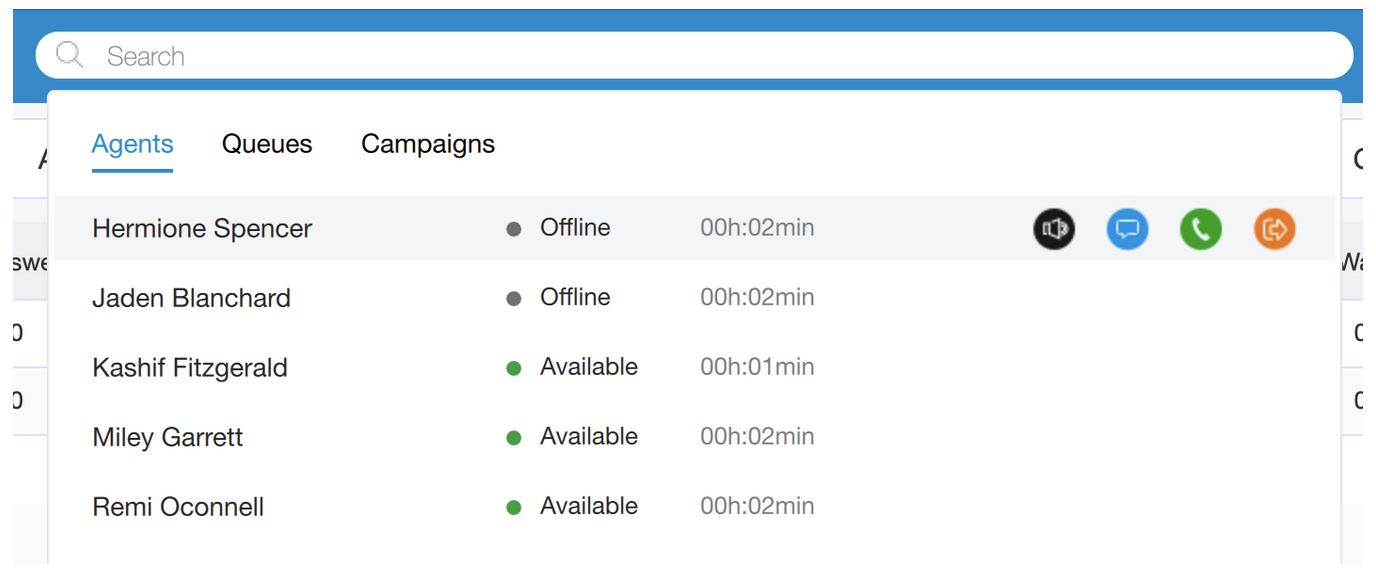
There are some additional actions provided when the user mouseover searched Agents:
- Listen: The Supervisor is authorized to Listen calls.
- Chat: The Supervisor can Chat with Agents.
- Call: The Supervisor can Take a call.
- Logout: The Supervisor may Logout specific Agent.
To exit Search mode press the ESC key or simply click anywhere outside the Search field.
If the user’s license does not support the Dialer option, the search option for Campaigns will not be available.
¶ Supervisor Toolbar
On the right side of the toolbar, there are icons that provide the following things:
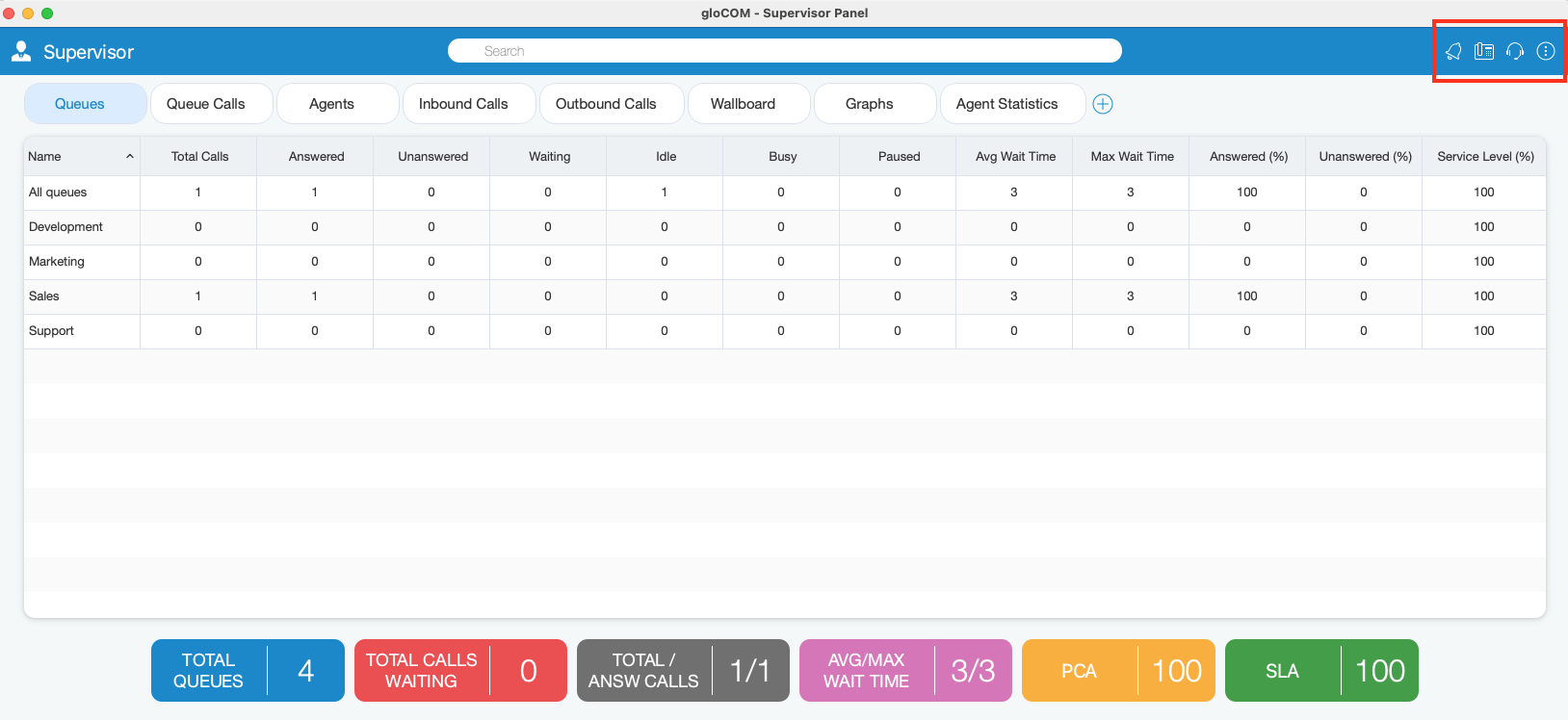
 Notification Bell: Clicking the Bell icon displays a list of all alerts.
Notification Bell: Clicking the Bell icon displays a list of all alerts. Phone Dialog: Shows Phone Dialog.
Phone Dialog: Shows Phone Dialog. Agent Panel: Shows Agent Panel.
Agent Panel: Shows Agent Panel. Preferences: When the user clicks this action, an additional menu with the options appears.
Preferences: When the user clicks this action, an additional menu with the options appears.
Additional information about icons is shown below.
¶ Notification Bell
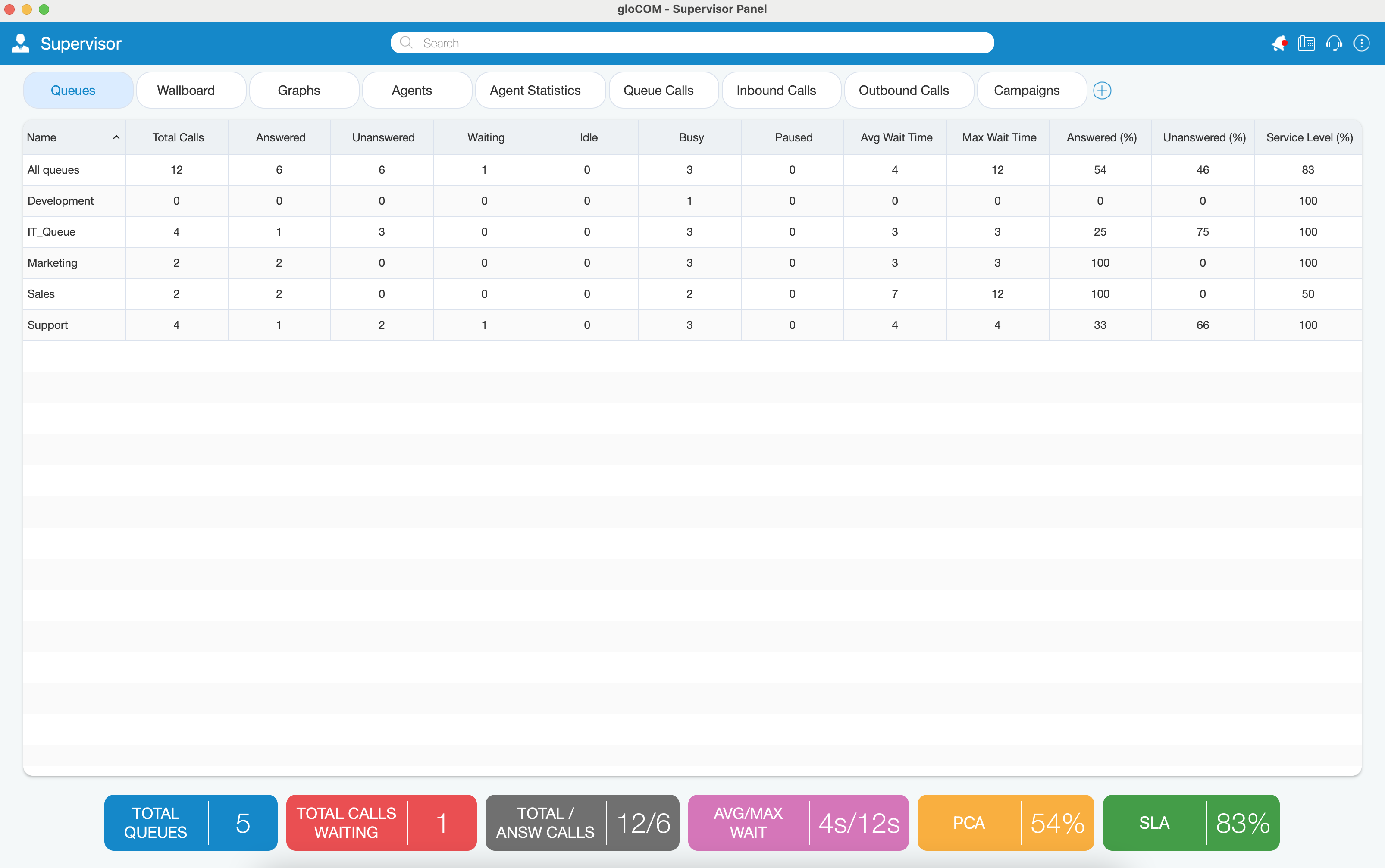
If there are new alerts, the Notification bell icon changes.
- Each item of the notification list consists of the message, the time when the alert occurred, and the state of the alert (read, unread).
- The unread message contains a blue circle on the right.
- To mark an alert as read it is necessary to hover over the alert item.
- To close the notification list click outside of the notification area, or simply by clicking on the notification bell icon again.
- To delete all notifications click the icon on the top right side (recycle bin).
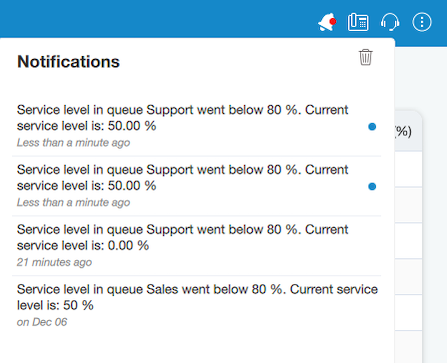
¶ Phone Dialog
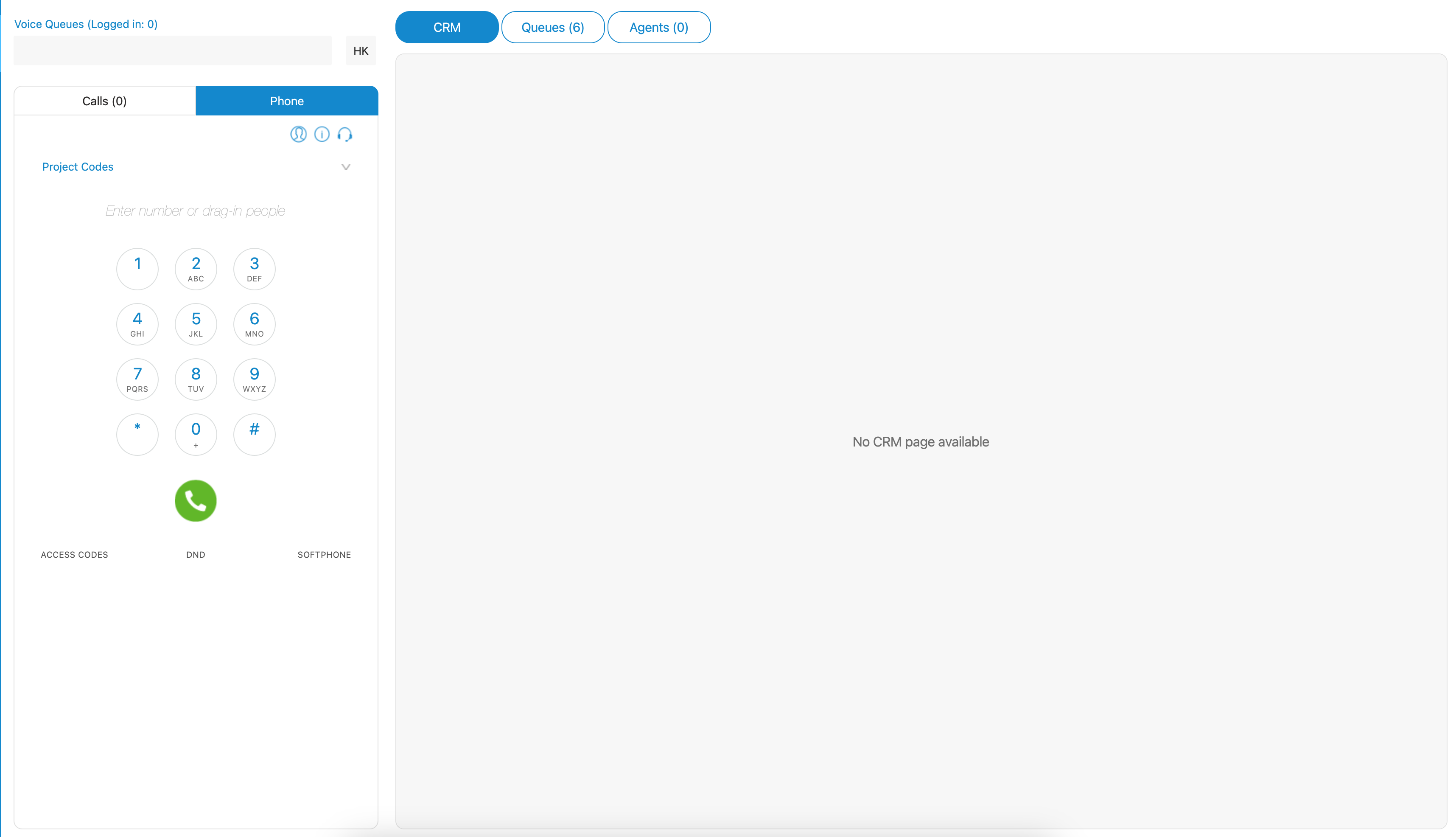
Clicking the Show Phone Dialog icon opens the Phone module area:
The phone module area provides information on missed calls and offers users the flexibility to choose their input/output and ringtone devices. It features a drag-and-drop function and enables users to adjust microphone and speaker volumes. Additionally, it displays dialed contact phone numbers and includes a dial keypad for entering numbers efficiently.
¶ Agent Panel
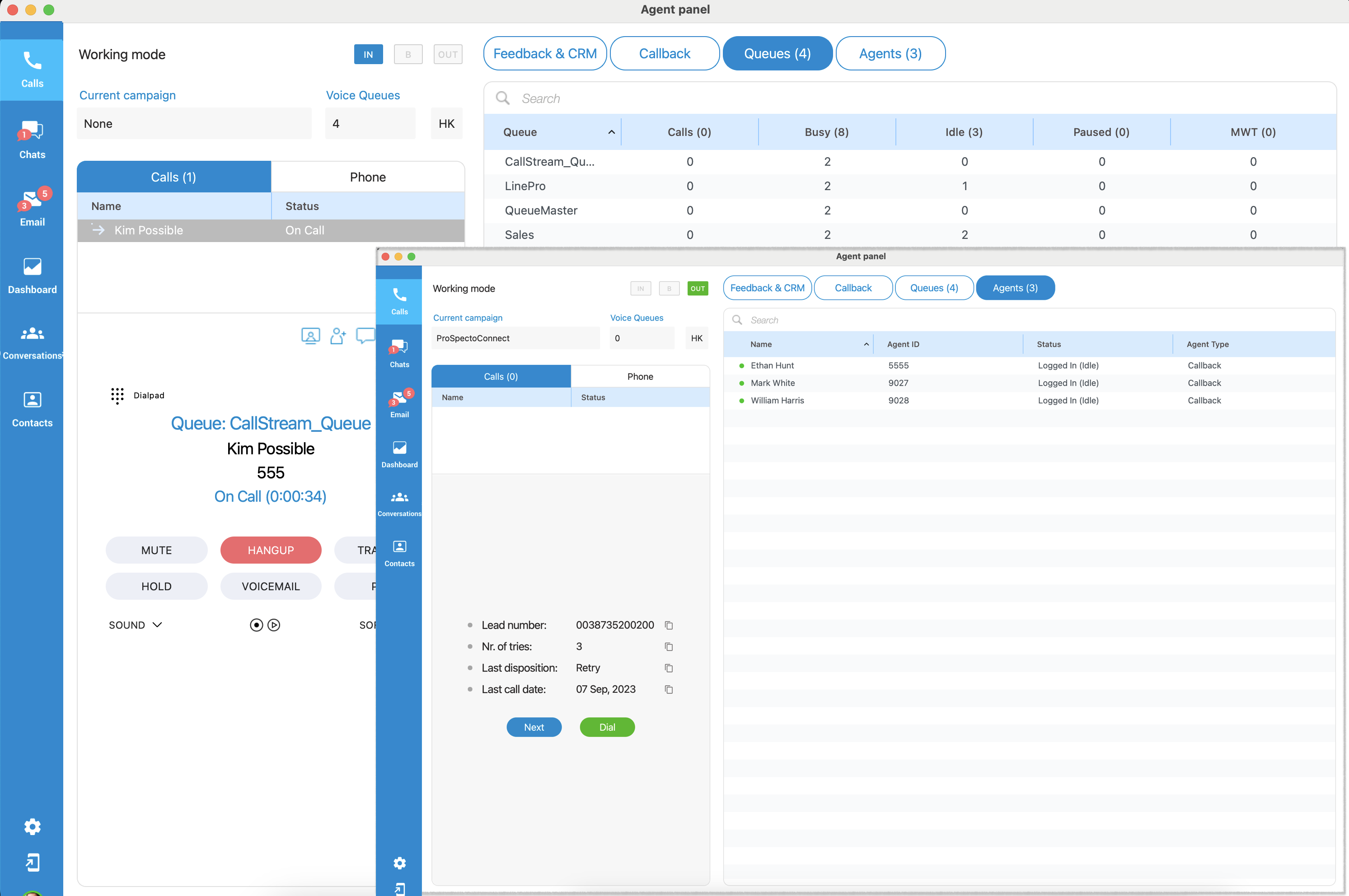
Agent Panel window can be opened by clicking the module icon from the Supervisor panel.
All agent-related features are located in this window (Agent Panel), and makes it easier for an agent to handle multiple calls, feedback forms, CRM popup, callbacks, other agents, and queues.
Also, the phone dialer and all phone-related settings will be displayed within the Agent Panel window.
¶ Preferences
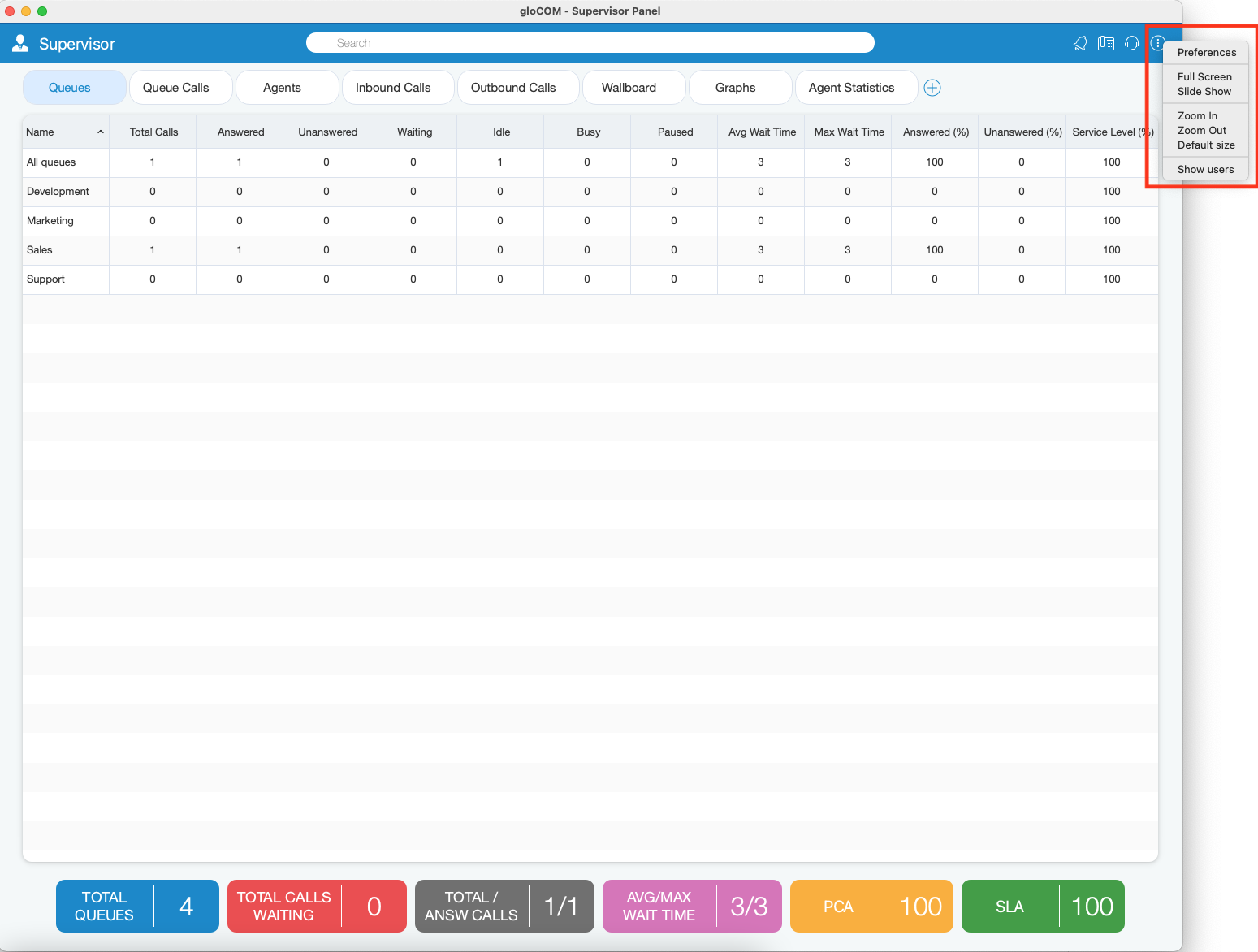
By clicking Preferences, users have additional options for:
- Preferences: Open Preferences dialog in which users have configuration options for Alerts, Queues, Agents, and Threshold. More information about Preferences Options is displayed below.
- Full Screen: This option is used to enter fullscreen mode (Supervisor window occupies the whole computer screen). If the window is already in fullscreen mode, clicking this option restore window size to the previous size.
- Slide Show: This option is used to start/stop slide show of Wallboard module content.
- Zoom In/Out: This option is used to increase/decrease the font size for the content of all modules except Wallboard module.
- Default size: This option restores font size to default size.
- Show users: Open gloCOM main window.
¶ Preferences Options
General tab
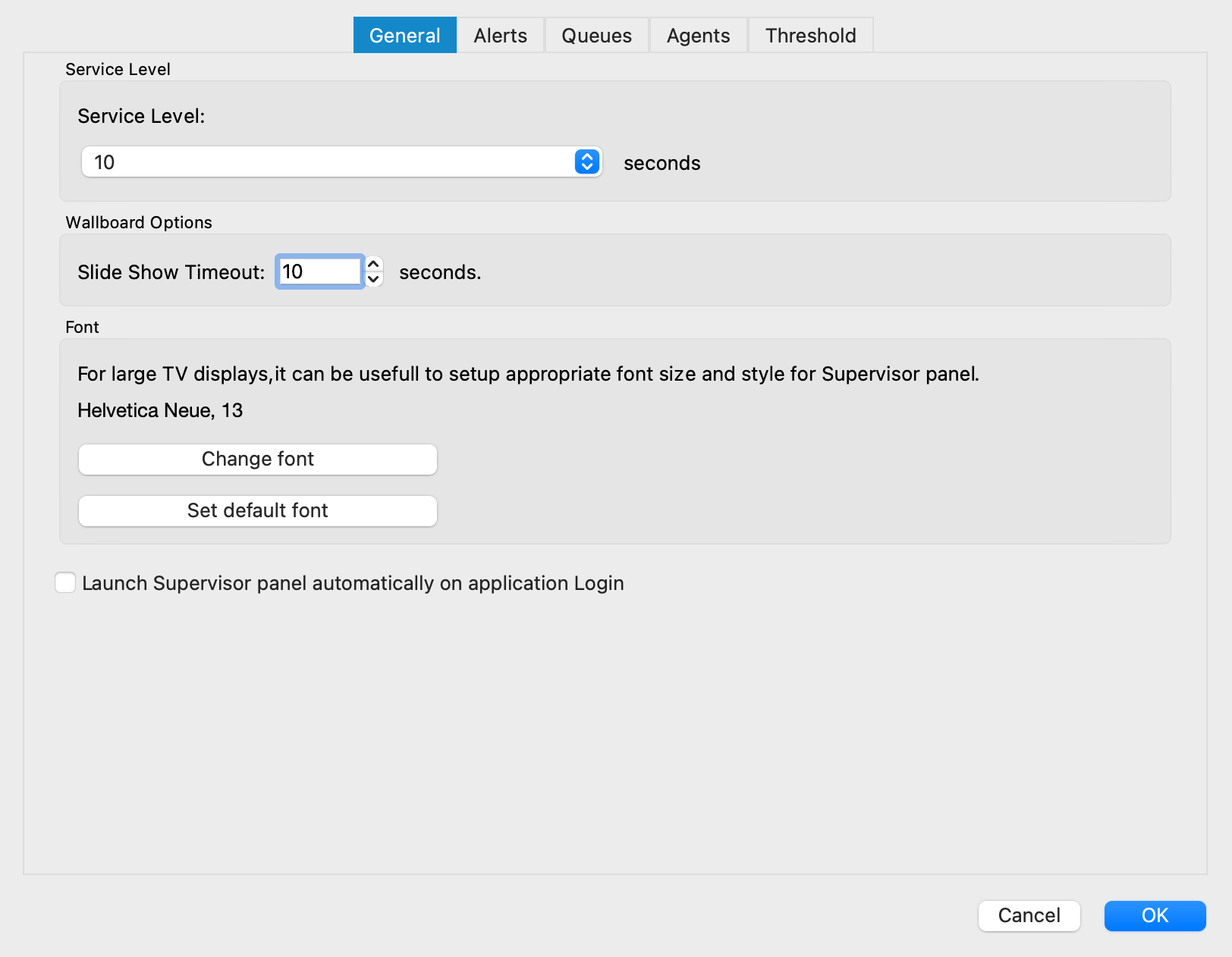
- Service level: Select time in seconds. This is used for calculating statistics inside Supervisor Panel.
- Slide Show Timeout: Select timeout for the slide show (in seconds).
- Change font: Change font and style of content inside Supervisor Panel. It can be useful for large TV screens to set up an appropriate font size.
- Set default font: Reset to the default font and style of Supervisor Panel.
- Launch Supervisor panel automatically on application Login: If this option is checked, after the Supervisor logs in, the Supervisor Panel will be automatically shown.
Alerts tab
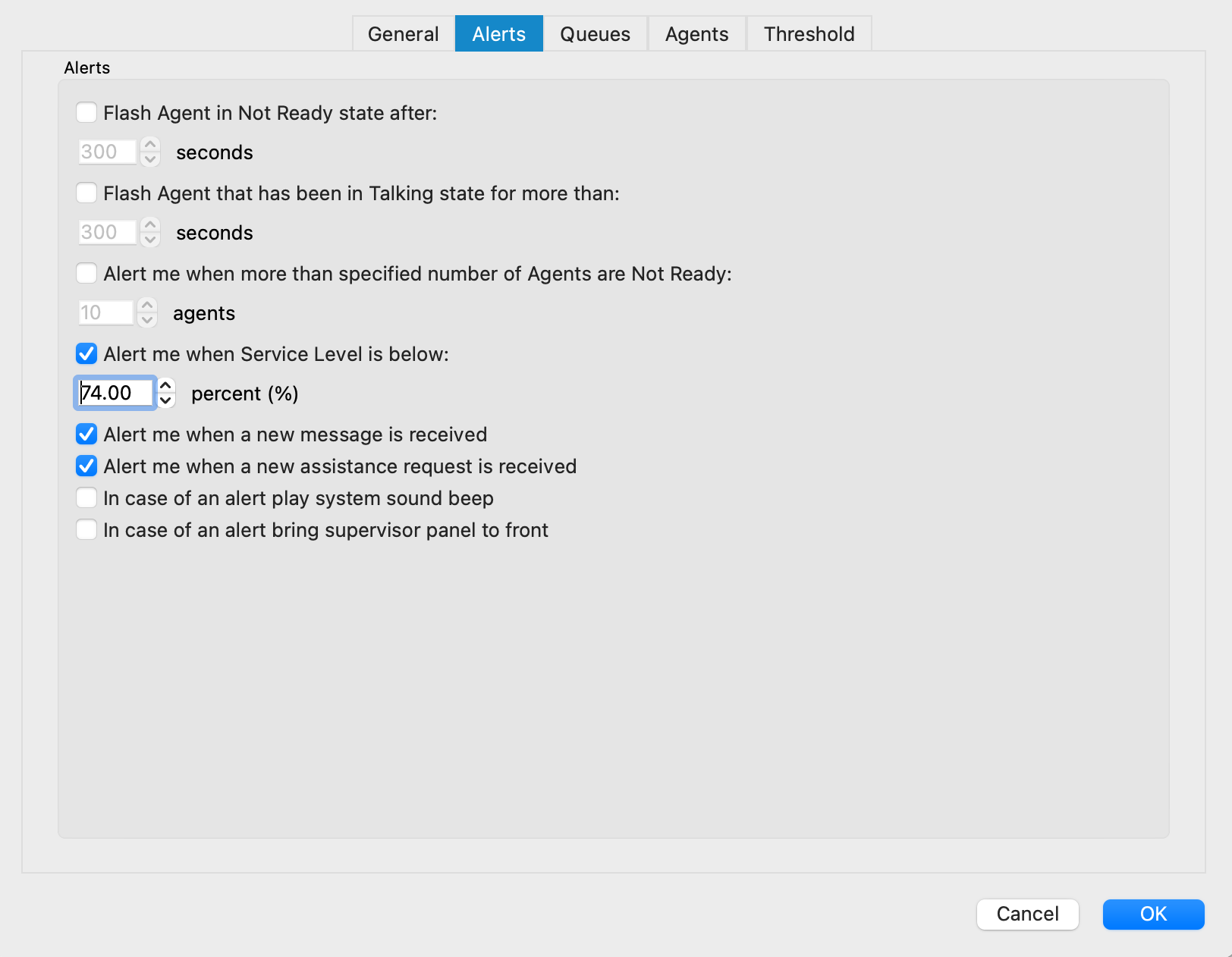
- Flash Agent in Not Ready state after: Choose time in seconds when an alert will flash if the Agent is not ready.
- Flash Agent that has been in Talking state for more than: Choose time in seconds when an alert will flash if the Agent is in Talking state.
- Alert me when more than specified number of Agents are Not Ready: Choose the number of Not Ready Agents after which the alert will popup.
- Alert me when Service Level is below: Choose percent of service level after the Alert will popup.
- Alert me when a new message is received: Click on the checkbox to enable this option.
- Alert me when a new assistance request is received: Click on the checkbox to enable this option.
- In case of an alert play system sound beep: Click on the checkbox to enable this option.
- In case of an alert bring the application: Click on the checkbox to enable this option.
Queues tab
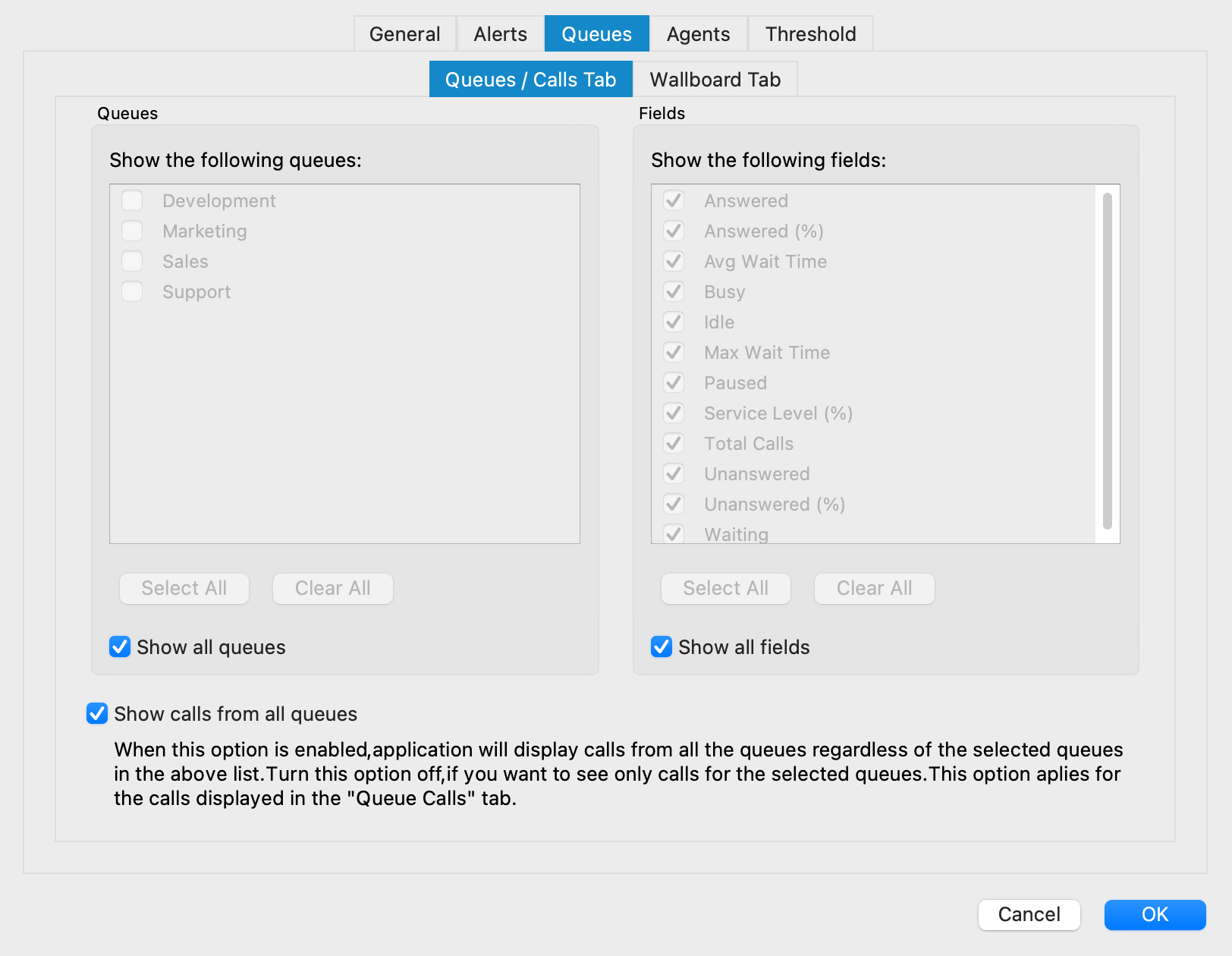
1. Queues/Calls
Inside the Queues/Calls tab you can select which Queues or fields will be visible in the Supervisor Panel, inside the Queues module.
- Select all: Select all Queues/Fields from the list of visible Queues/Fields.
- Clear all: Clear selection of all Queues/Fields from the list of visible Queues/Fields.
Also, there are options Show all Queues and Show all Fields if you want all Queues/Fields to be displayed inside the Queues module.
- Show calls from all Queues: If this option is selected, the application will display calls from all Queues regardless of the selected Queues in the above list. Otherwise, you will see only calls for the selected Queues. This option applies to the calls displayed in the Queue Calls tab.
2. Wallboard
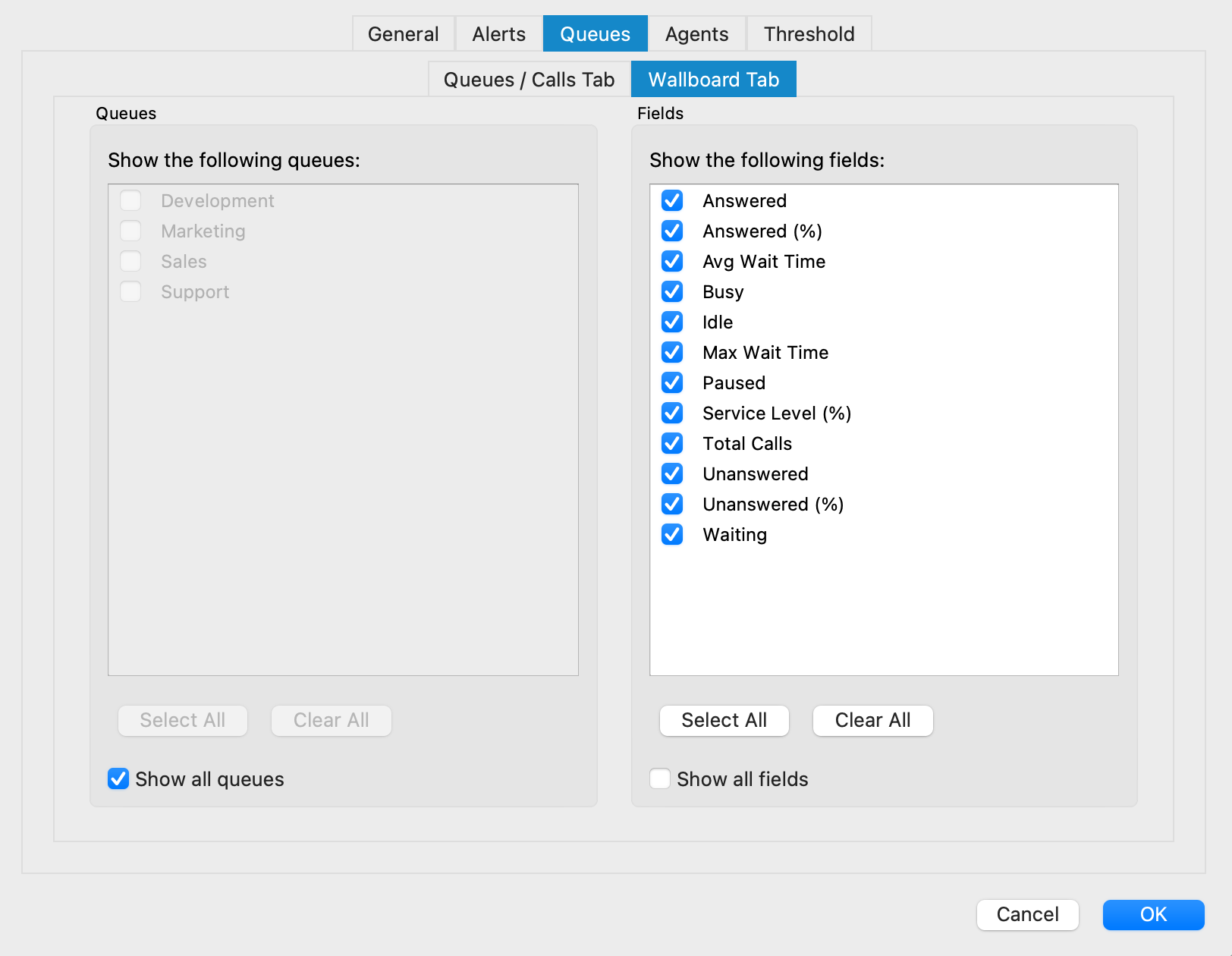
Inside the Wallboard tab you can select which Queues or Fields will be visible in the Supervisor Panel, inside Wallboard module.
- Select all: Select all Queues/Fields from the list of visible Queues/Fields.
- Clear all: Clear selection of all Queues/Fields from the list of visible Queues/Fields.
Also, there are options Show all Queues and Show all Fields if you want all Queues/Fields to be displayed inside the Wallboard module.
Agents tab
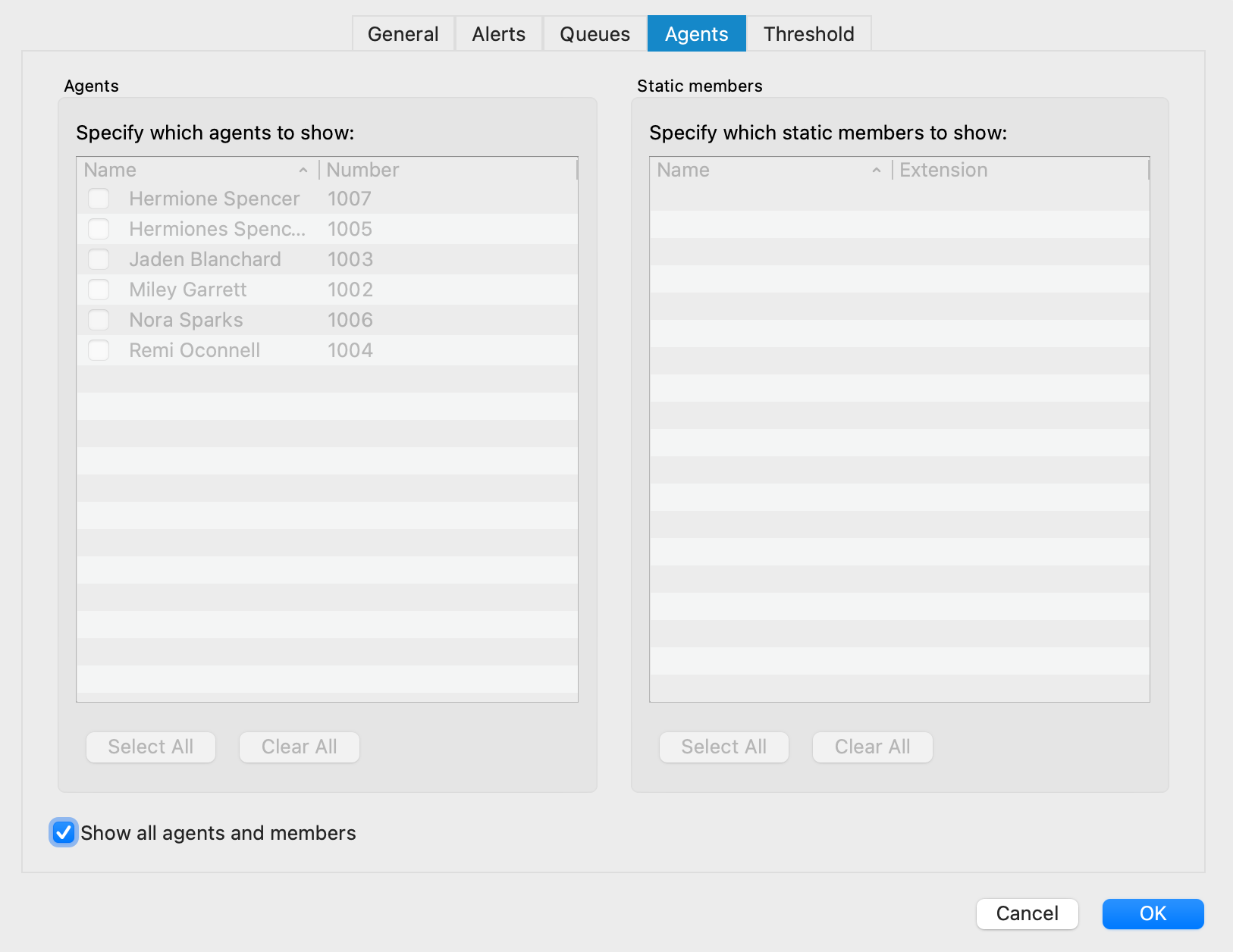
Inside the Agents tab you can select which Agents or Static Members will be visible in the Supervisor Panel, inside Agents module.
- Select all: Select all Agents/Static Members from the list of visible Agents/Static Members.
- Clear all: Clear selection of all Agents/Static Members from the list of visible Agents/Static Members.
Also, there is option Show all Agents and Members if you want all Agents/Members to be displayed inside Agents module.
Threshold
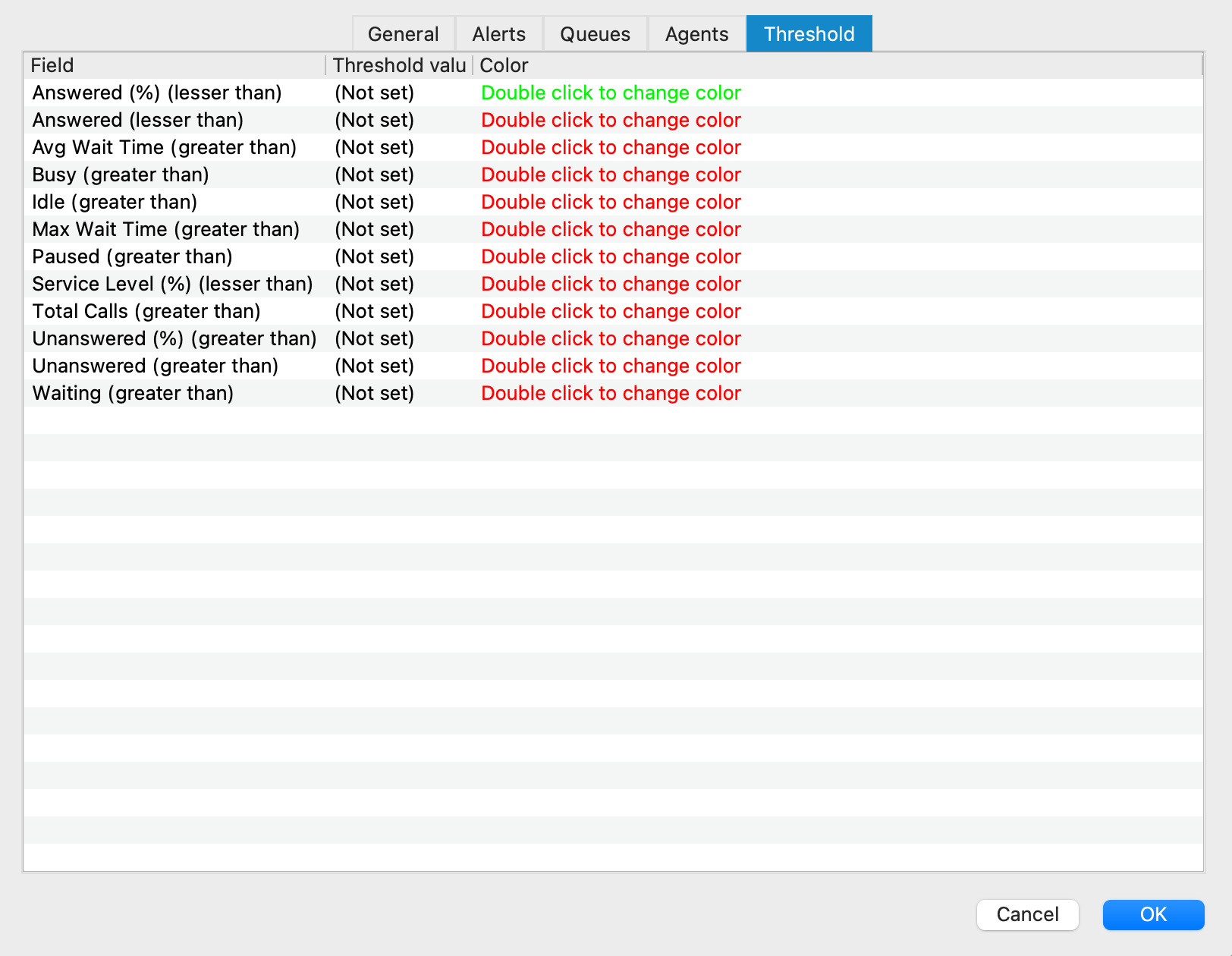
- Field: Various field are displayed, such as Answered, Busy, Idle, Paused, Unanswered, Waiting, Service Level (%), etc...
- Threshold value: Defines the value for a particular event.
- Color: Defines the color that will be used for a particular event if the threshold value is set.
¶ Supervisor Panel Modules
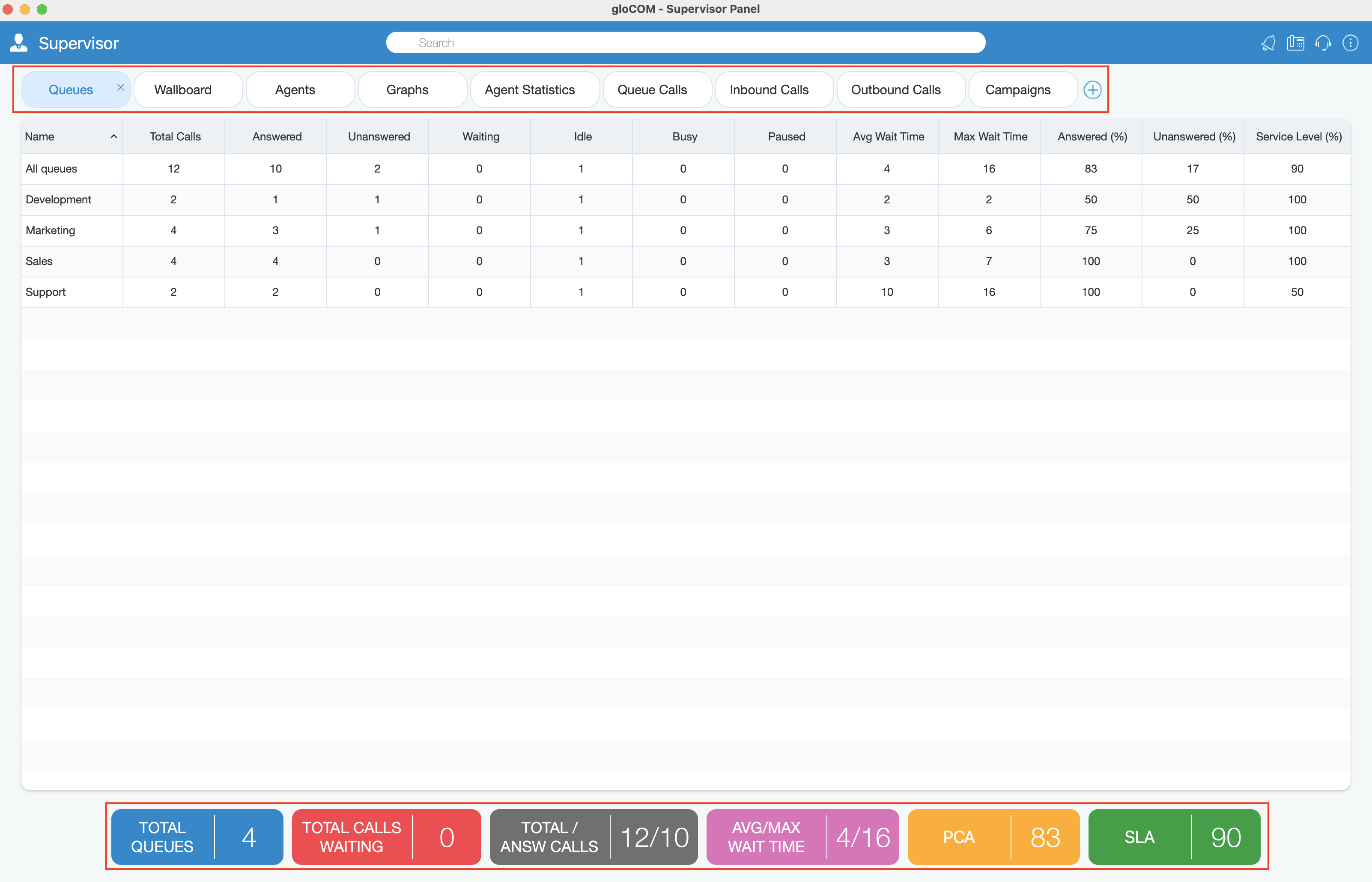
Users can decide which tabs they want to see inside the Supervisor Panel. All tabs are displayed by default, the same as before.
All tabs are stored on the server, so the user does not have to customize tabs every time he/she logs in. Tabs are saved per account, and if the server does not support saving tabs, they will be saved locally. After updating the server, when the user logs in for the first time, tabs saved locally will be saved on the server so the user does not have to customize tabs again. Local storage is used only when the server does not support storing tabs.
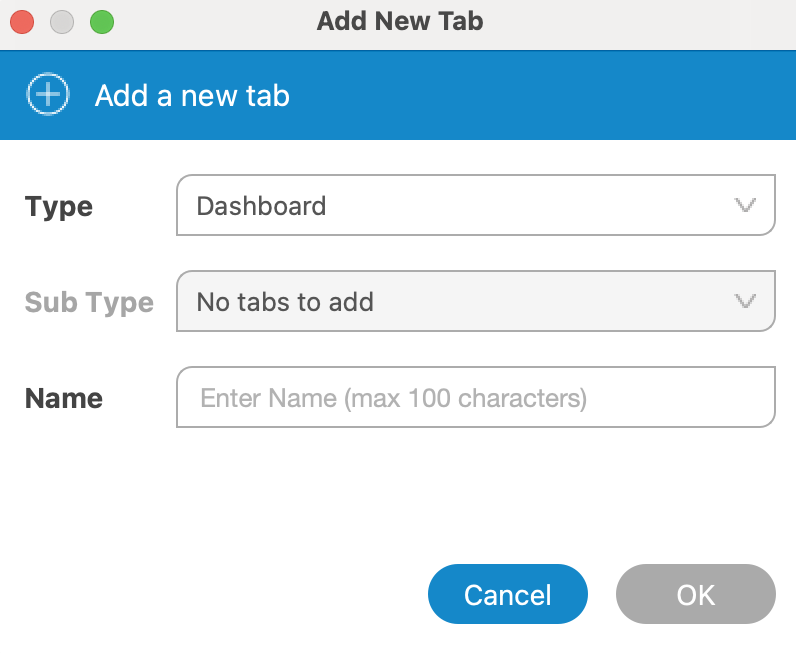
 Add a new tab: A new, + option has been added. It is used to add a new tab. When the user clicks the + button, a new window with the following information is displayed:
Add a new tab: A new, + option has been added. It is used to add a new tab. When the user clicks the + button, a new window with the following information is displayed:
- Type: Dashboard by default.
- Subtype: User can choose one of the subtypes from the dropdown menu.
- Tab name: The user can name the tab as he/she wishes, and if the user does not enter anything, the tab will be named automatically by default. (For custom Tab name, the maximum length is 100 characters)
The user will not be able to add a new tab if the max number of tabs (9) is reached.
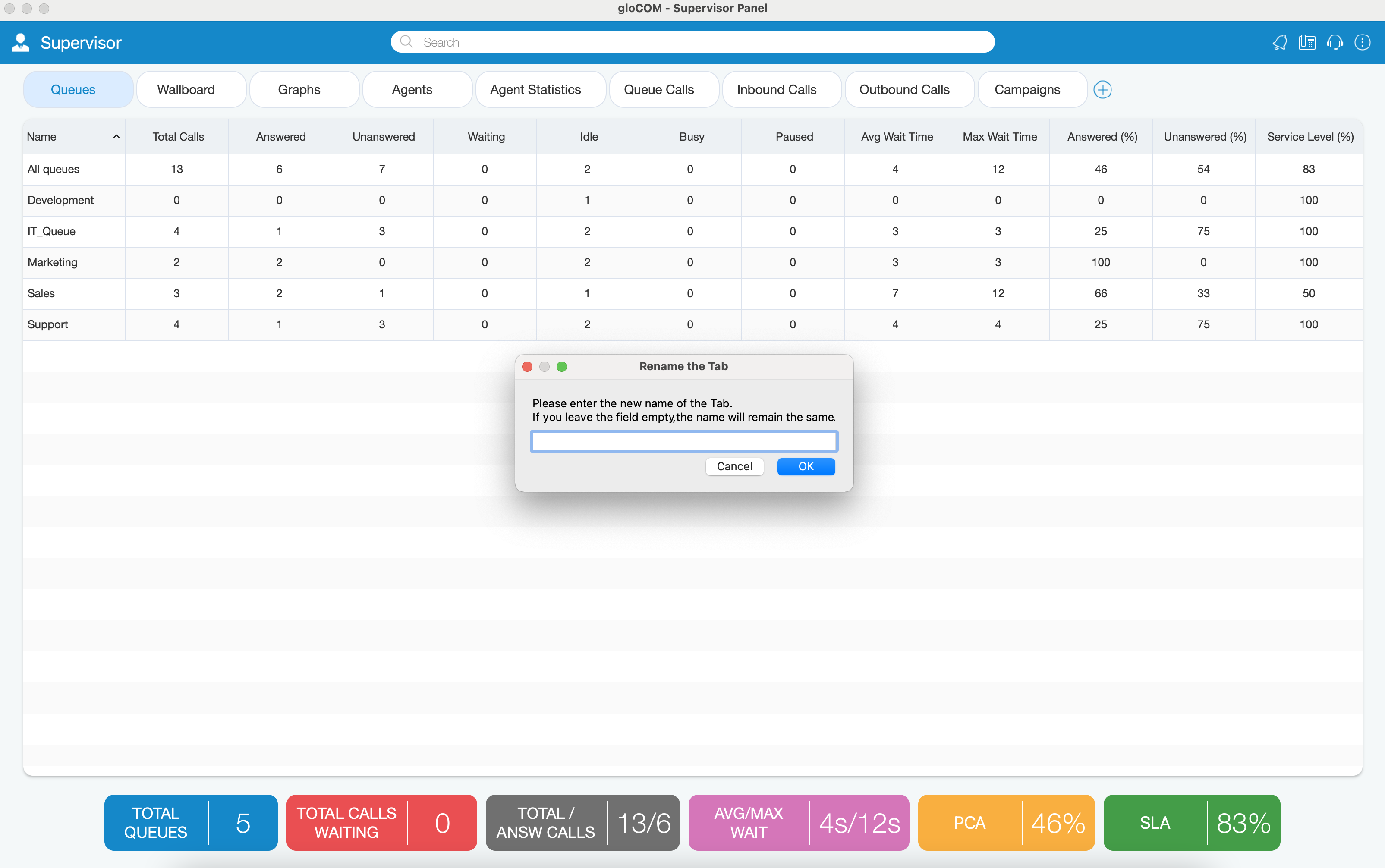
- Rename tab: The user can rename the existing tab by right-clicking on the tab.
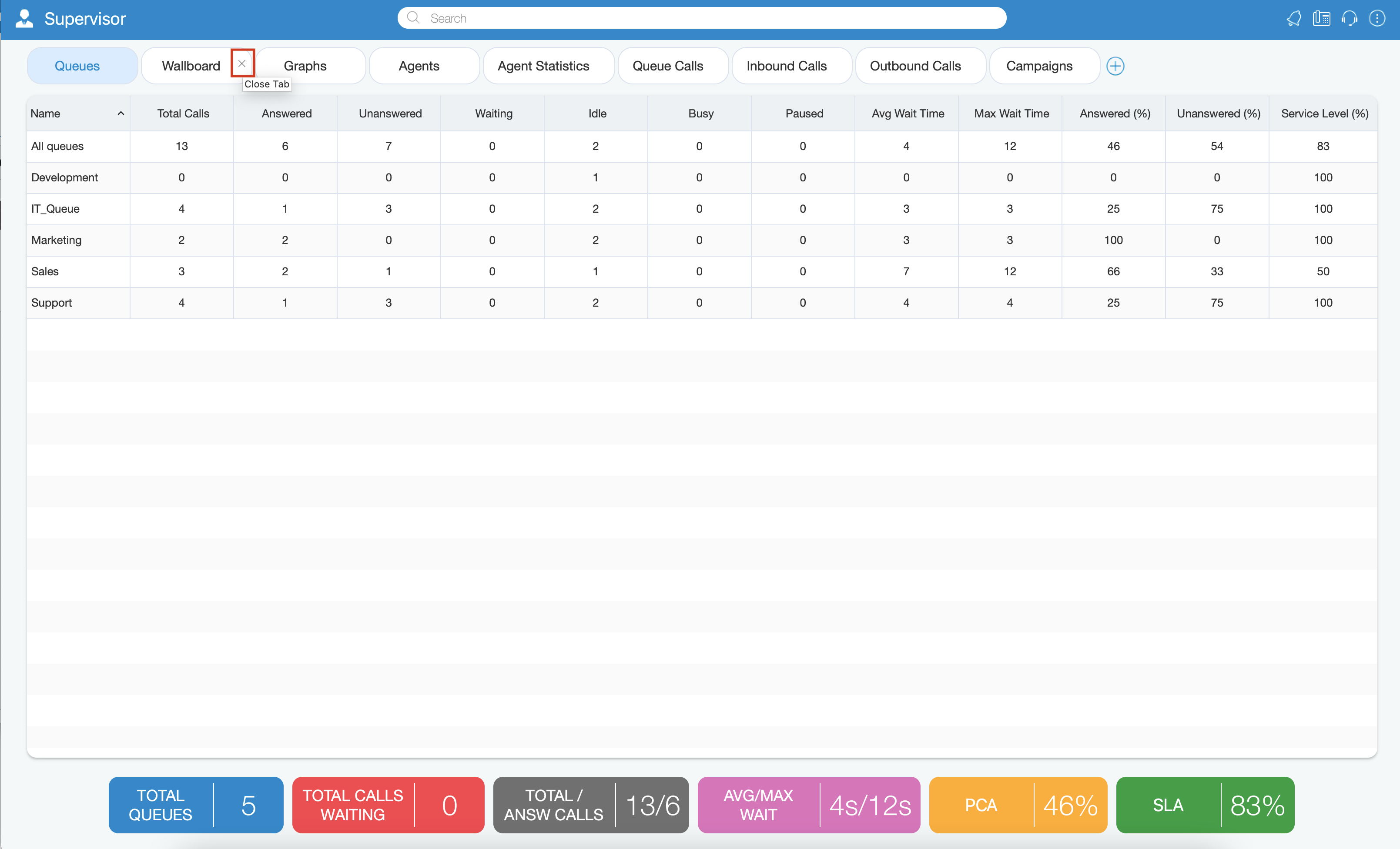
- Remove existing tab: Each tab can also be easily removed by clicking the X button.
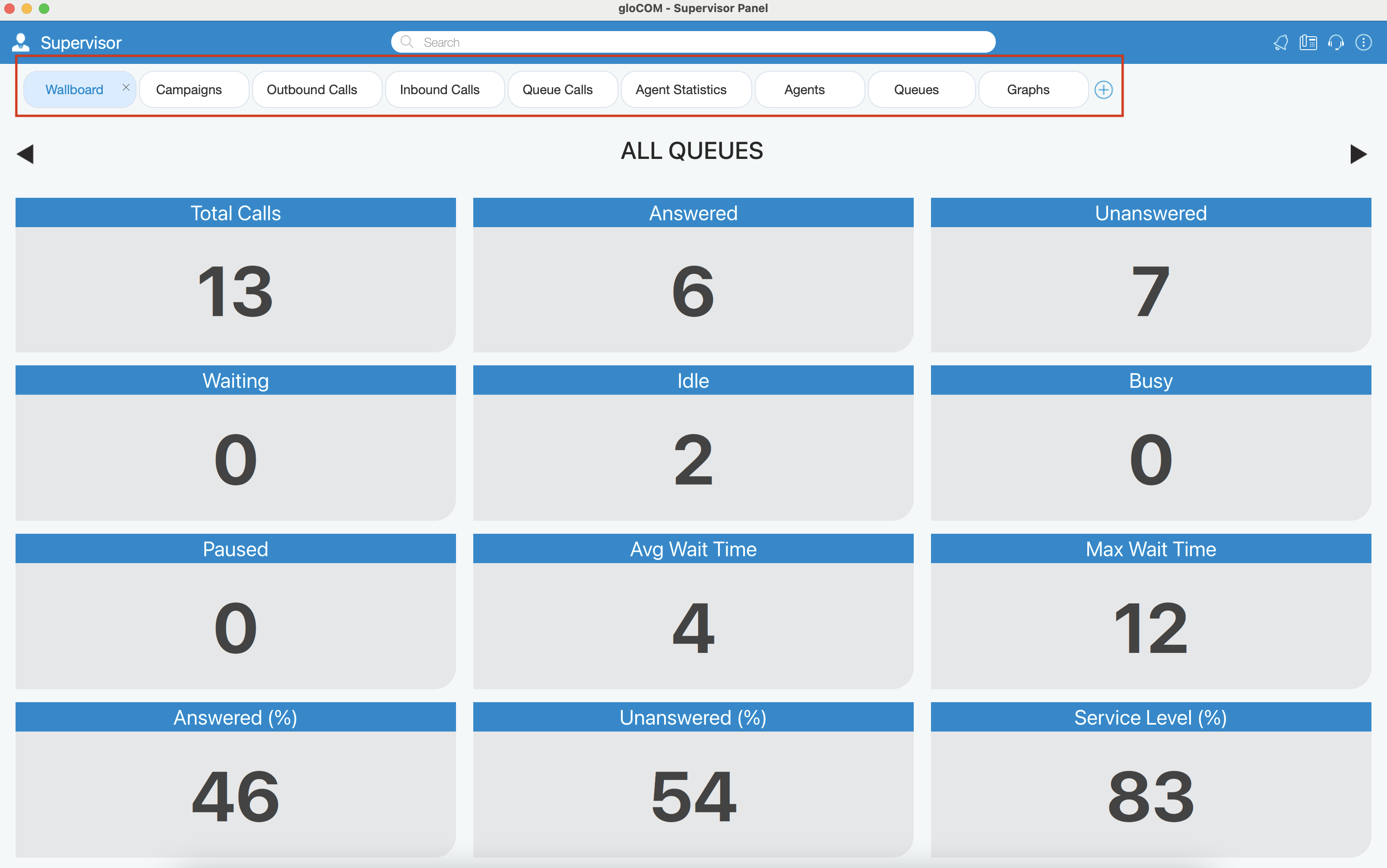
- Reorder tabs: It is also possible to change the order of the tabs, simply by grabbing the tab and dragging it to a different location.
If the user’s license does not support the Dialer option, the user will not be able to add Campaigns tab.
¶ Queues Module
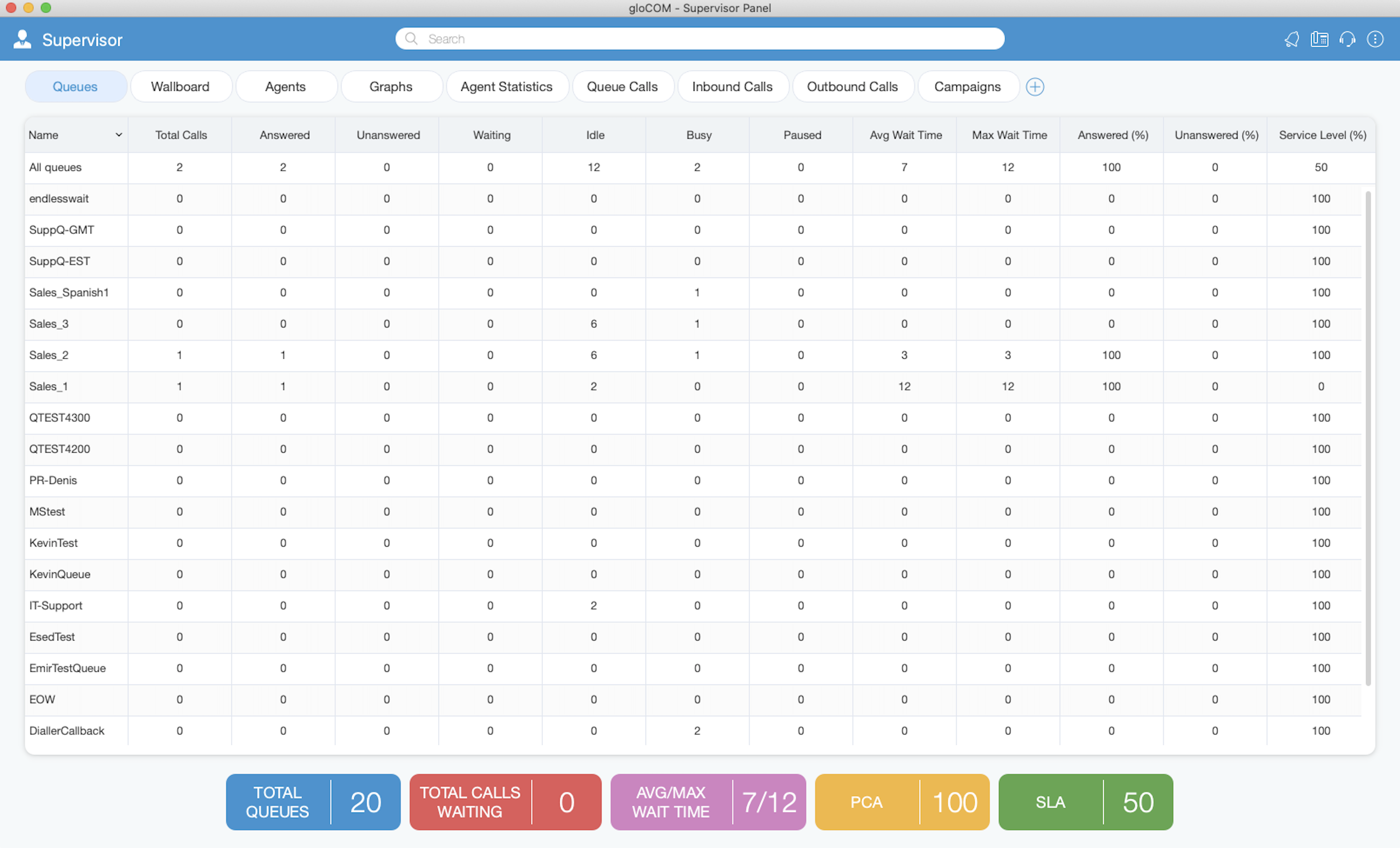
Inside of the Queues Module the Supervisor can monitor Real-time information for all Queues selected through Preferences dialog.
- Total calls: Represents the total number of calls during the day (answered + unanswered).
- Calls answered: Represents the total number of answered calls during the day.
- Calls unanswered: Represents the total number of unanswered calls during the day.
- Calls waiting: Represents the total number of calls waiting in the Queue to be answered by a free Agent.
- Members idle: Represents the total number of idle Agents.
- Members busy: Represents the total number of busy Agents.
- Members paused: Represents the total number of paused Agents.
- Average Wait Time (AWT) (in seconds): Represents the average amount of time callers must wait to reach an Agent.
- Maximum Wait Time (MWT) (in seconds): Represents the maximum amount of time callers must wait to reach an Agent.
- Calls Answered (%): Represents the percentage of answered calls during the day.
- Calls Unanswered (%): Represents the percentage of unanswered calls during the day.
- Service Level (%): Represents the percentage of calls that have been answered within a specified period of time. Service Level can be configured in the Preferences window.
The Queues module displays queue statistics for the current day.
¶ Wallboard Module
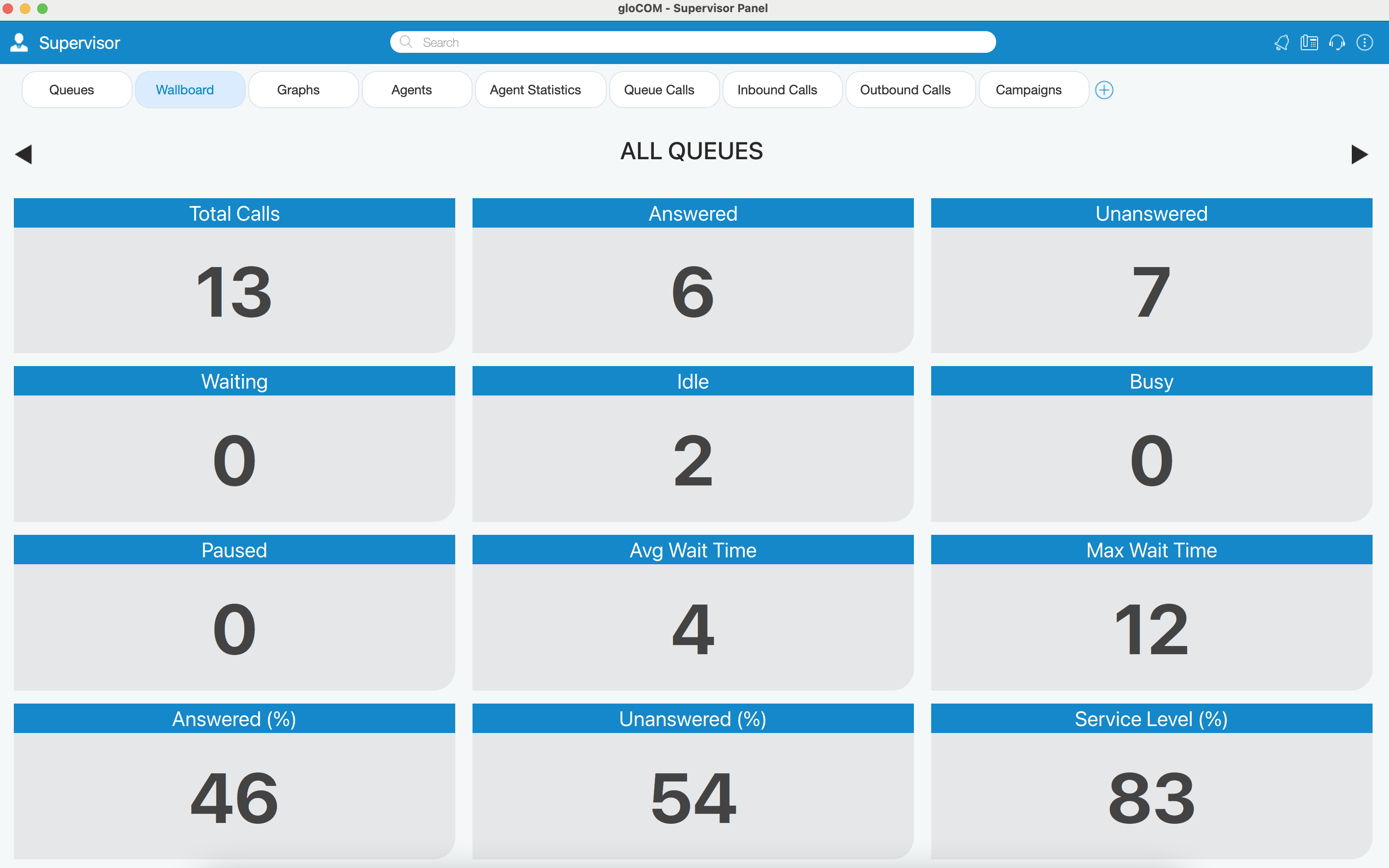
Inside the Wallboard Module the Supervisor can monitor real-time information for all Queues selected through the Preferences dialog. The Wallboard is displayed in a large format intended for use with televisions or other large screens.
For each Queue the following information is shown:
- Total calls: Represents the total number of calls during the day (answered + unanswered).
- Calls answered: Represents the total number of answered calls during the day.
- Calls unanswered: Represents the total number of unanswered calls during the day.
- Calls waiting: Represents the total number of calls waiting in the Queue to be answered by a free Agent.
- Agents idle: Represents the total number of idle Agents.
- Agents busy: Represents the total number of busy Agents.
- Agents paused: Represents the total number of paused Agents.
- Average Wait Time (AWT) (in seconds): Represents the average amount of time callers must wait to reach an Agent.
- Maximum Wait Time (MWT) (in seconds): Represents the maximum amount of time callers must wait to reach an Agent.
- Calls Answered (%): Represents the percentage of answered calls during the day.
- Calls Unanswered (%): Represents the percentage of unanswered calls during the day.
- Service Level (%): Represents the percentage of calls that have been answered within a specified period of time. Service Level can be configured in the Preferences window.
The Wallboard module displays Queue statistics for the current day.
¶ Agents Module
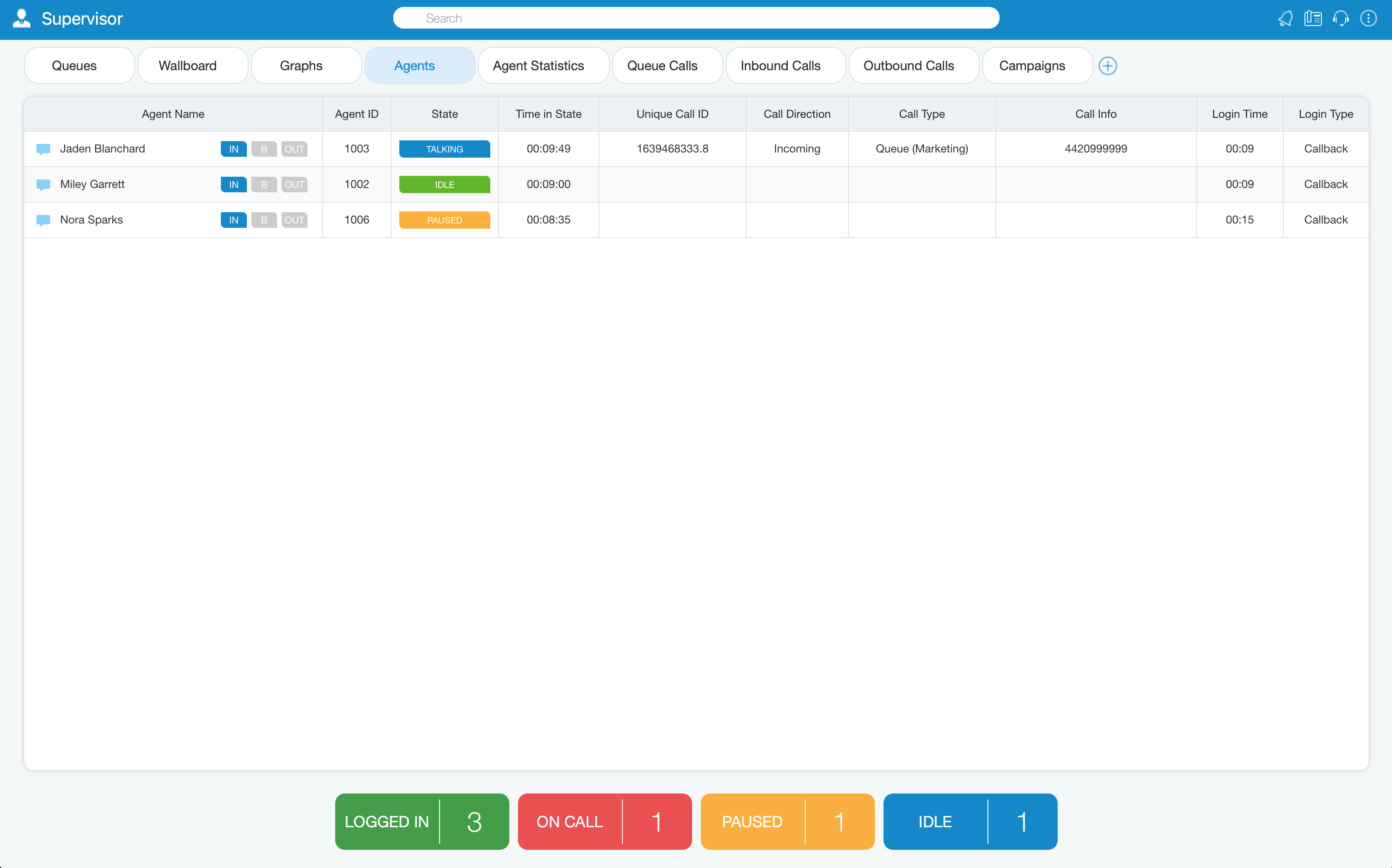
Inside the Agents module, the Supervisor can monitor information for all logged-in Agents selected through Preferences dialog.
For each Agent the following information is shown:
- Agent Name: Represents Agent's name. If the Supervisor clicks on the Agent's name the Agent Info dialog will be displayed.
- Agent ID: Represents Agent's number.
- Agent State: Represents current state of an Agent (idle, paused, busy...).
- Time In State: Represents the amount of time the Agent is in the current state.
- Unique Call ID: Represents unique ID number of a Call.
- Call Direction: Outgoing, Incoming.
- Call Type: Regular Call, Queue Call, Campaign Call.
- Call Info: Represents the information about the call (call number, project code...).
- Login Time: Represents the amount of time the Agent is logged in.
- Login Type: The login type of the Agent.
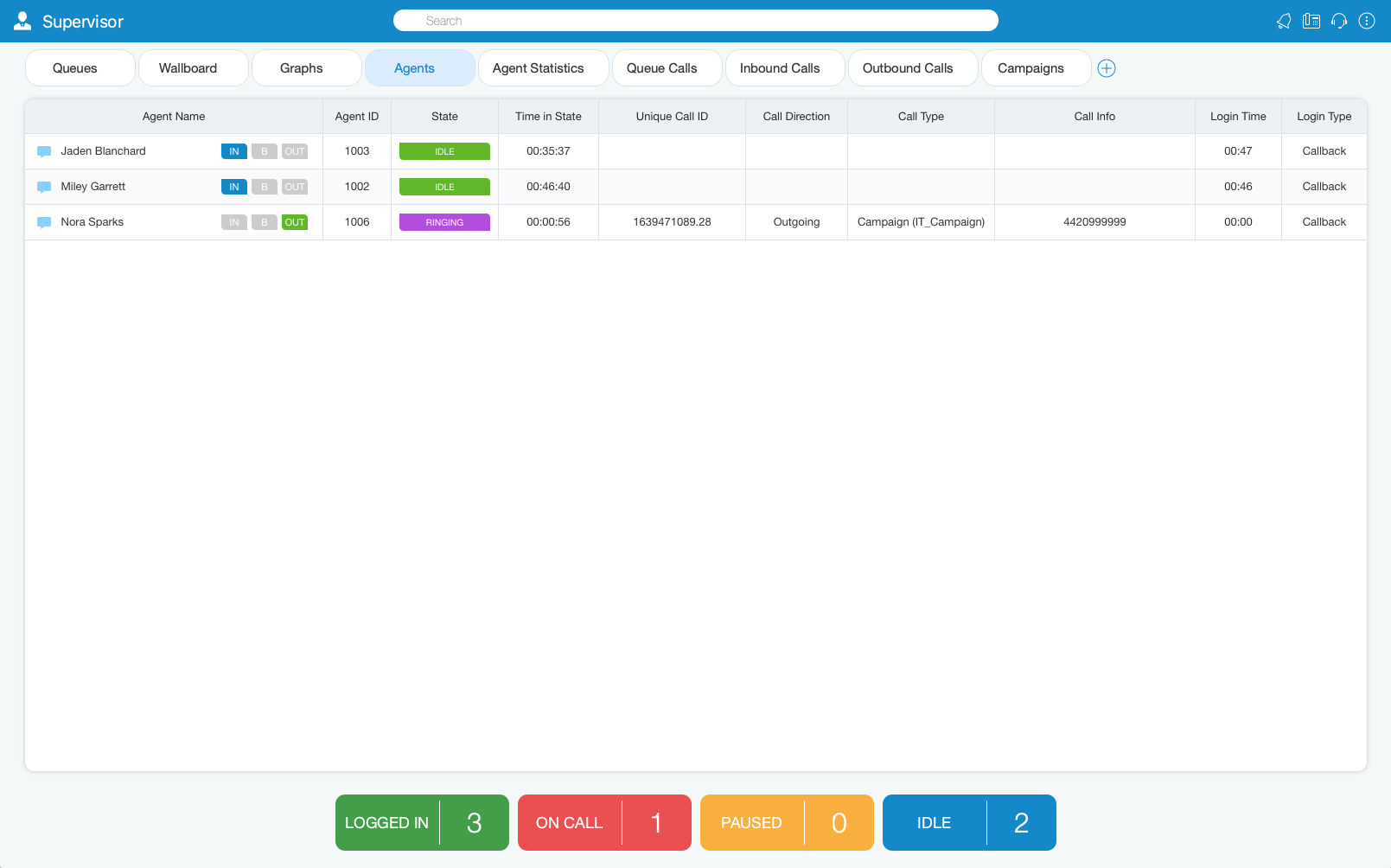
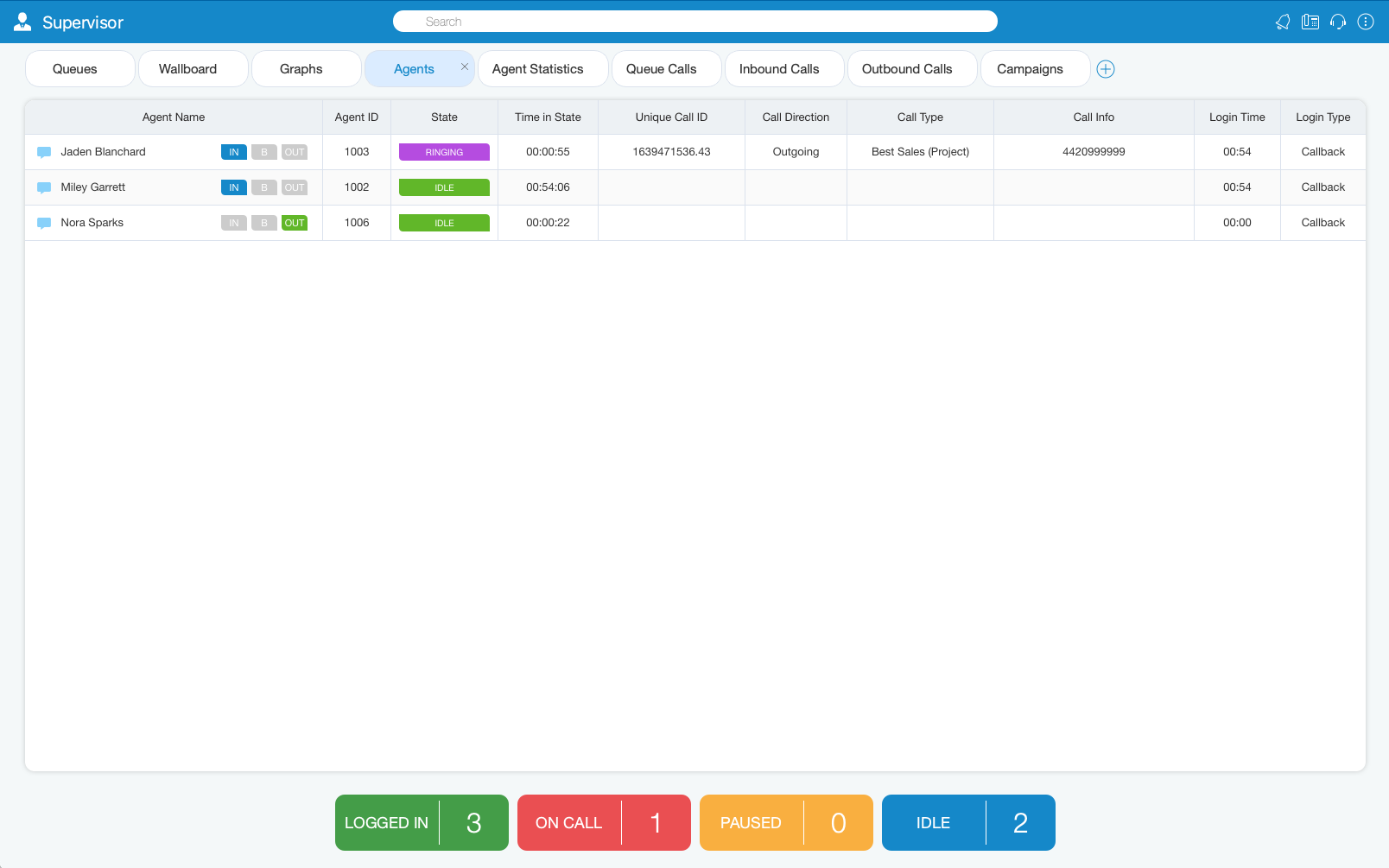
From version 6.0 it is possible to see the Agent direction and blending option in real-time. The Supervisor can change the direction of any Agent by clicking on the direction buttons. Also, the Supervisor can see which project code each Agent is using for their current calls, and it is possible to monitor Dialer calls and Campaigns from the Agents module.
¶ Graphs Module
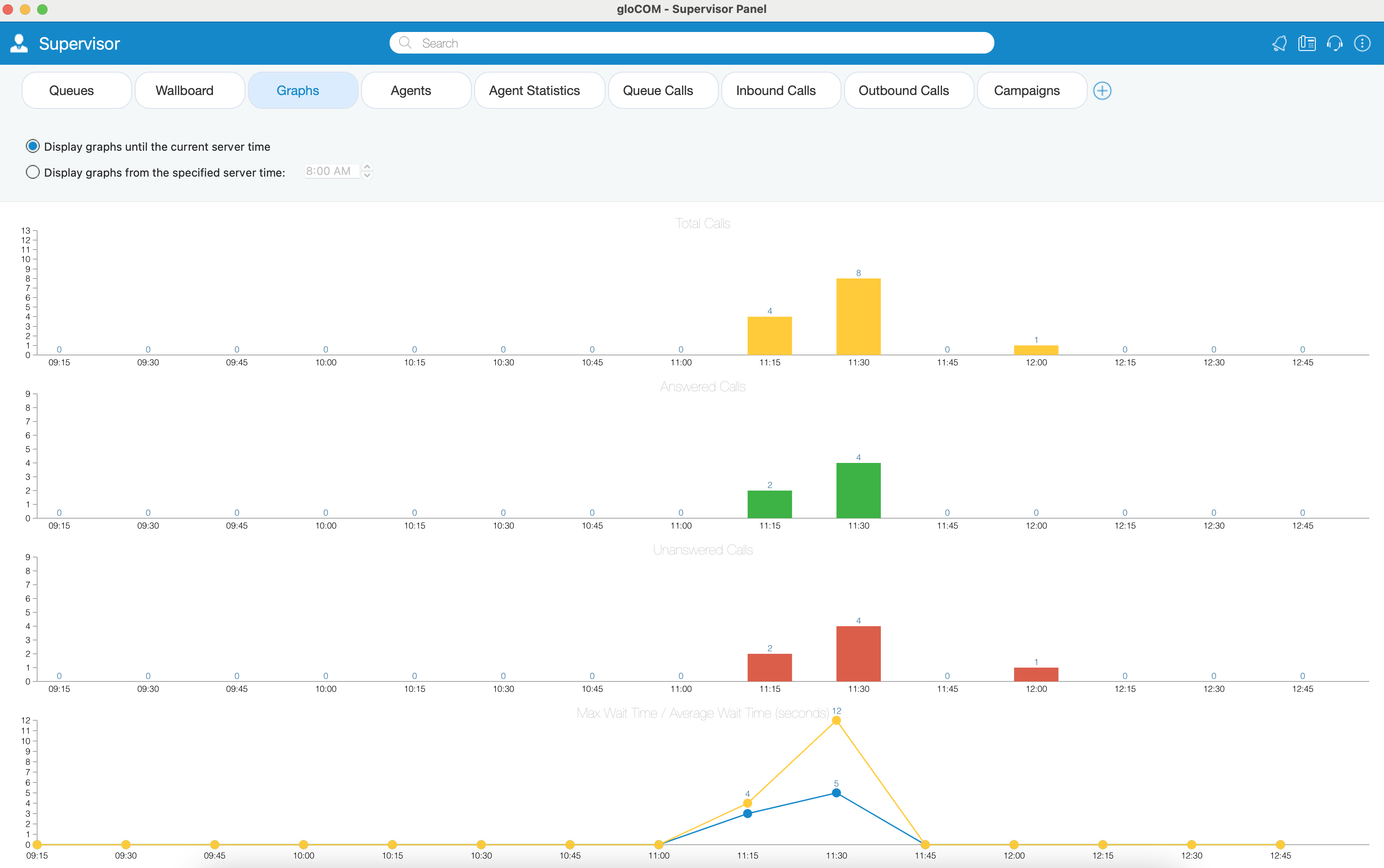
The Graphs module shows Real-time call statistics in the form of Graphs.
The following information is shown:
- Total Calls: Represents the total number of calls during the day.
- Answered Calls: Represents the total number of answered calls during the day.
- Unanswered Calls: Represents the total number of unanswered calls during the day.
- Maximum / Average Wait Time (in seconds): Represents the maximum/average amount of time callers must wait to reach an Agent.
Also, the user can choose whether he/she wants to display Graphs until the current server time, or to display Graphs from the specified server time.
¶ Agent Statistics Module
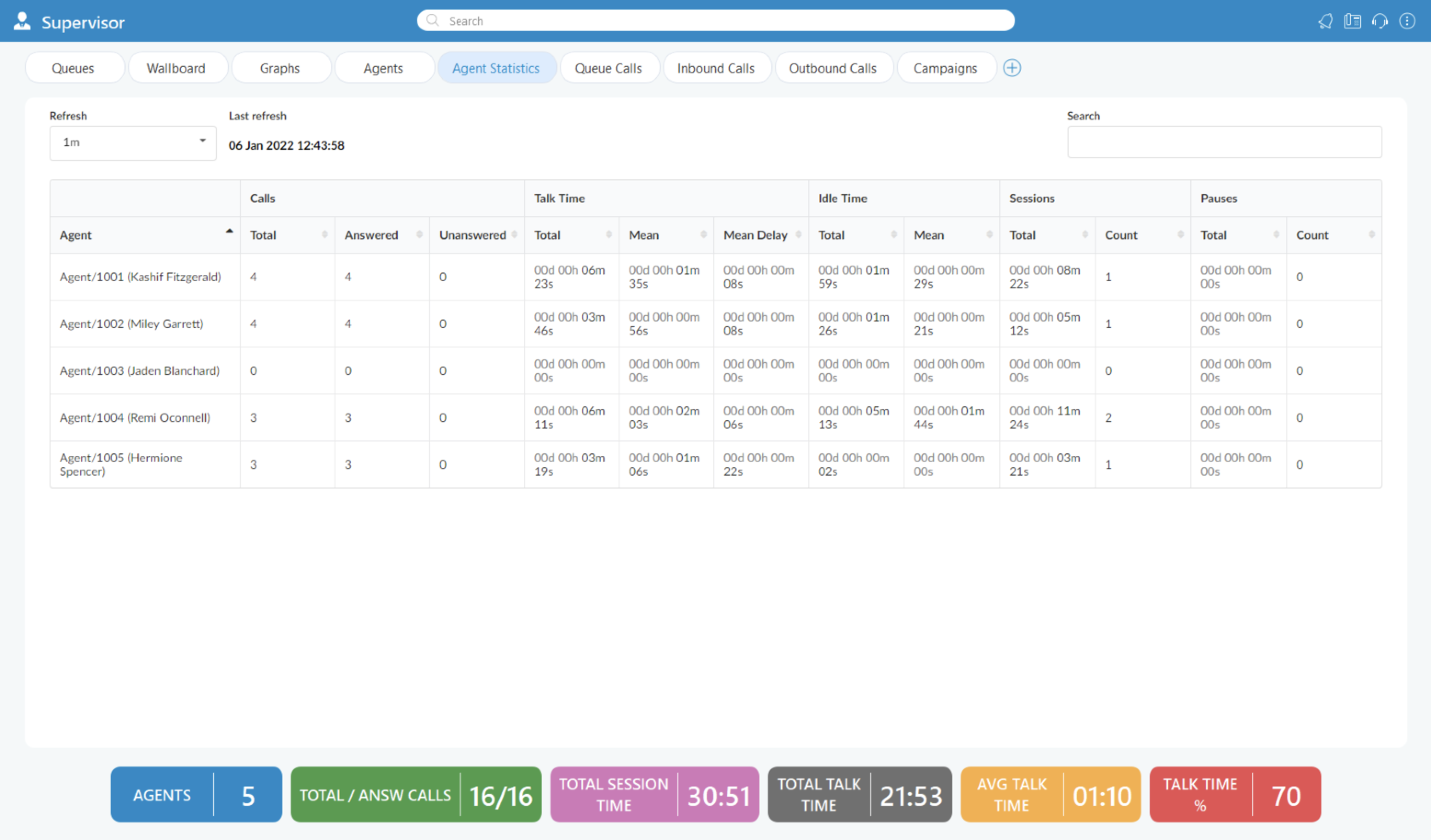
Prior to version 6.0, only Agent Inbound (real-time) statistics were available. Now, Agent Statistics module displays Agent's Inbound and Outbound statistics that include all Agent's calls (inbound, outbound, direct (in/out) ) into calculations. Calculations are reset every day starting from midnight.
For each Agent the following information is shown:
- Agent Name and Number: This section shows Agent's name and Agent's number.
- Calls: All calls answered by Agent.
- Total: Represents the total number of calls.
- Answered: Represents the total number of answered calls.
- Unanswered: Represents the total number of unanswered calls.
- Talk Time: Agent talk time.
- Total: Represents the total talking time.
- Mean: Mean/Average Agent talk time.
- Mean Delay: Mean/Average caller wait time before answered by the Agent.
- Idle Time: Agent idle time (callback Agents only).
- Total: Total Agent idle time(when Agent is not busy).
- Mean: Mean/Average Agent idle time.
- Sessions: Time Agent was logged in the queue.
- Total: Total time Agent was logged in.
- Count: Number of Agent sessions.
- Pauses: Represents Agent's time on Pauses
- Total: Total time Agent was on pause.
- Count: Number of pauses.
It is possible to set refresh time to the desired value to keep statistics updated. Also, labels on the bottom of the page are showing the total number of Agents, Total/Answered calls, Total Session Time, Total Talk Time, Average Talk Time, and Talk Time (%). More information about these labels is on the Agent Statistics tab.
¶ Queue Calls Module
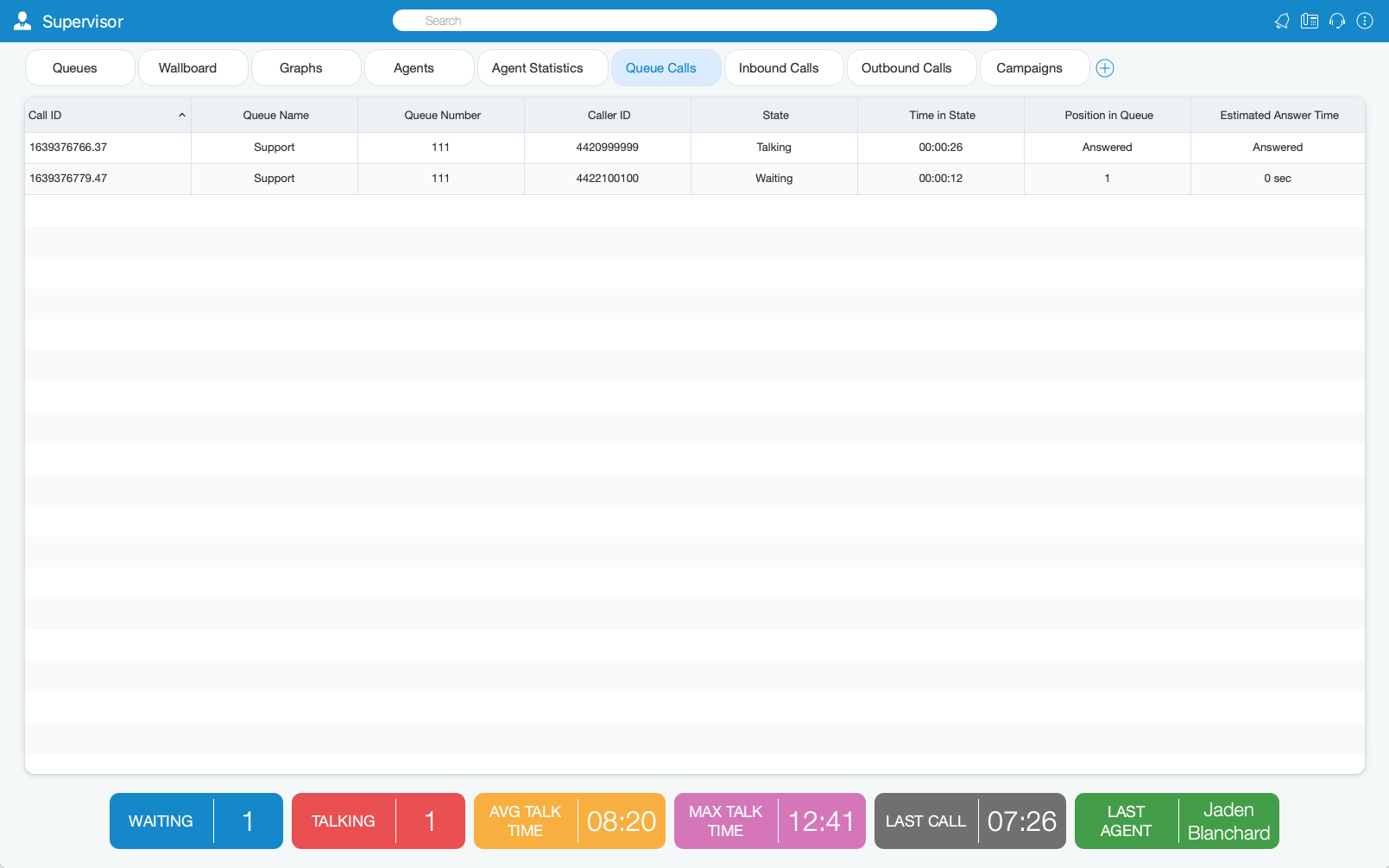
Inside the Queue Calls module, the Supervisor can monitor information for calls from all the Queues he/she selects to be visible through the Preferences dialog.
For each call the following information is shown:
- Call ID: Represents ID number of call.
- Queue Name: Displays Queue name.
- Queue Number: Shows Queue number.
- Caller ID: Represents DID number of the Caller.
- State: Represents current state of the Call.
- Time in State: Total time in current state.
- Position in Queue: Represents position number in Queue.
- Estimated Answer Time: Shows estimated answered time.
The Supervisor can perform the following operations for each call if he/she has the permissions:
- Transfer Call: The Supervisor can transfer selected call.
- Take Call: The Supervisor can take selected call.
- Monitor Call: The Supervisor can monitor selected call.
¶ Inbound Calls Module
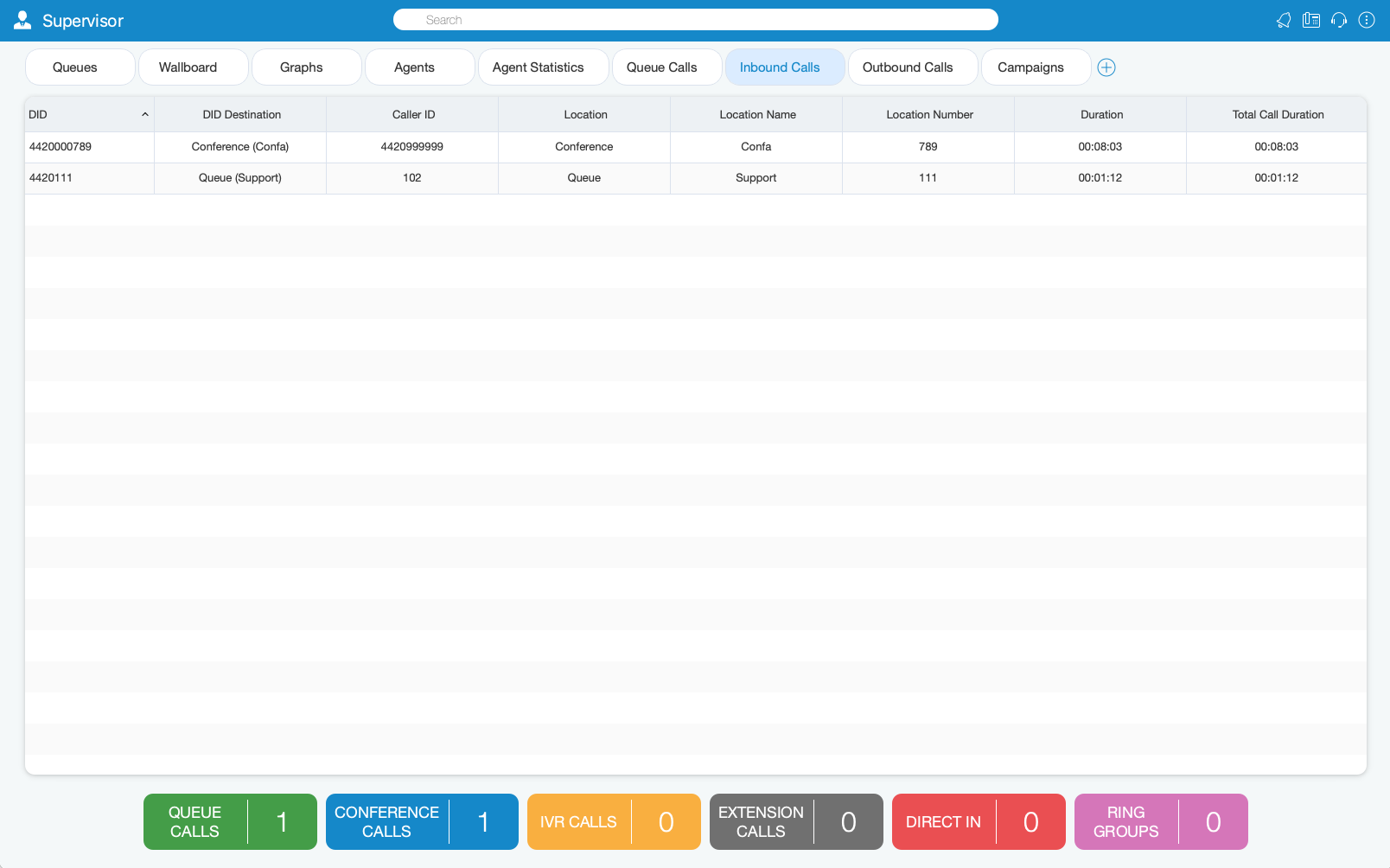
Inside the Inbound Calls module, the Supervisor can monitor information for all calls coming into the system.
For each call the following information is shown:
- DID: Displays DID Call number.
- DID Destination: Represents destionation of the Call.
- Caller ID: Shows DID number of Caller.
- Location: Represents type of location (IVR, Queue, Conference etc...)
- Location Name: Displays name of location.
- Location Number: Shows location number.
- Duration in Location: Shows current duration in location.
- Total Call Duration: Show total Call Duration.
The Supervisor can perform the Transfer Call operation for each call if he/she has the permissions.
¶ Outbound Calls Module
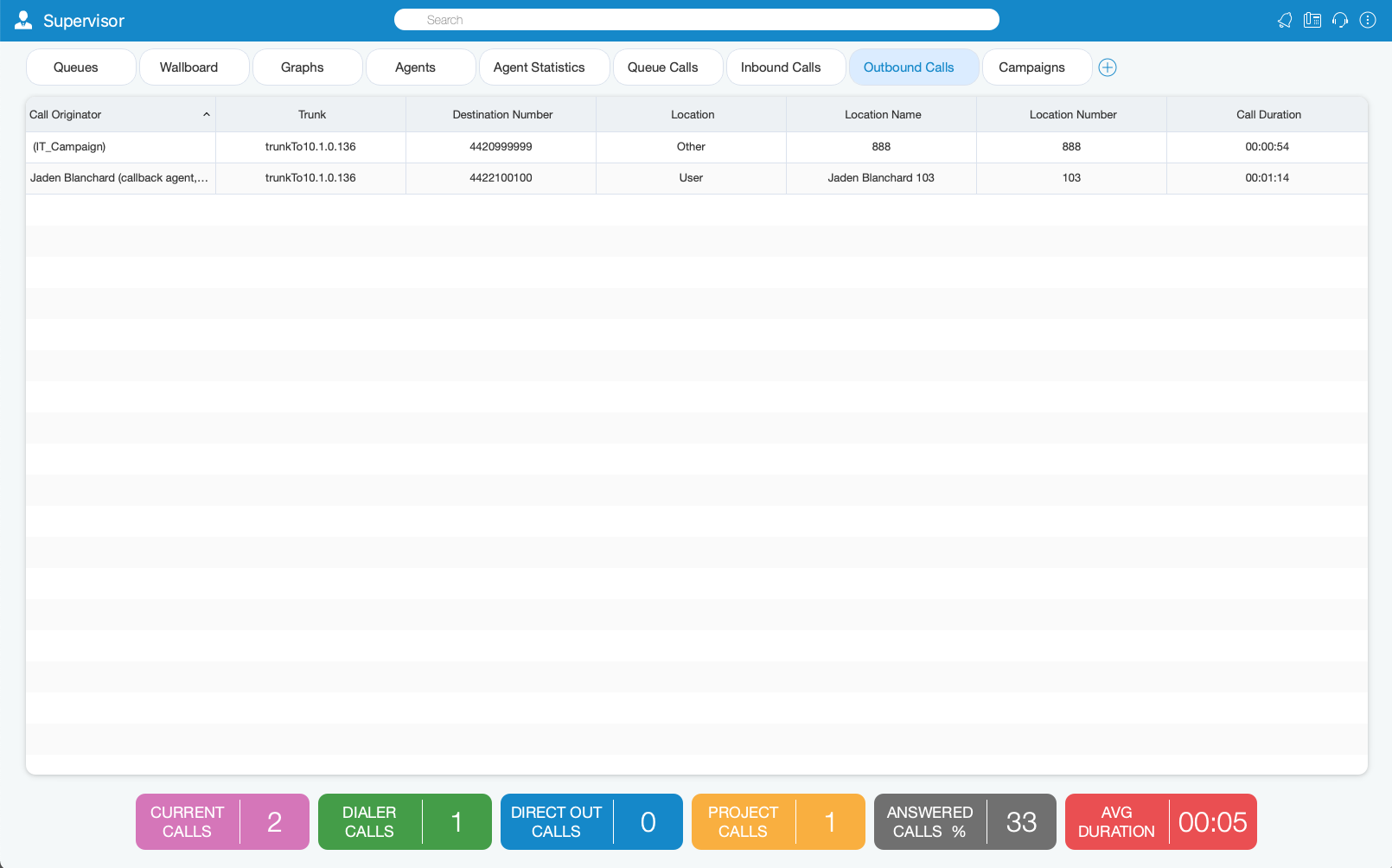
Inside the Outbound Calls module, the Supervisor can monitor information for all calls going out from the system.
For each call the following information is shown:
- Call Originator: Displays originator of the call (Agent, Dialer, Project).
- Trunk: Displays used trunks for calls.
- Destination Number: Displays DID number of the outbound call.
- Location: Displays type of location.
- Location Name: Represents location name.
- Location Number: Represents location number.
- Call Duration: Represents total call duration.
The Supervisor can perform the following operations for each call if he/she has the permissions:
- Transfer Call: The Supervisor can transfer selected call.
- Take Call: The Supervisor can take selected call.
- Monitor Call: The Supervisor can monitor selected call.
- Hangup Call: The Supervisor can hangup selected call.
¶ Campaigns Module
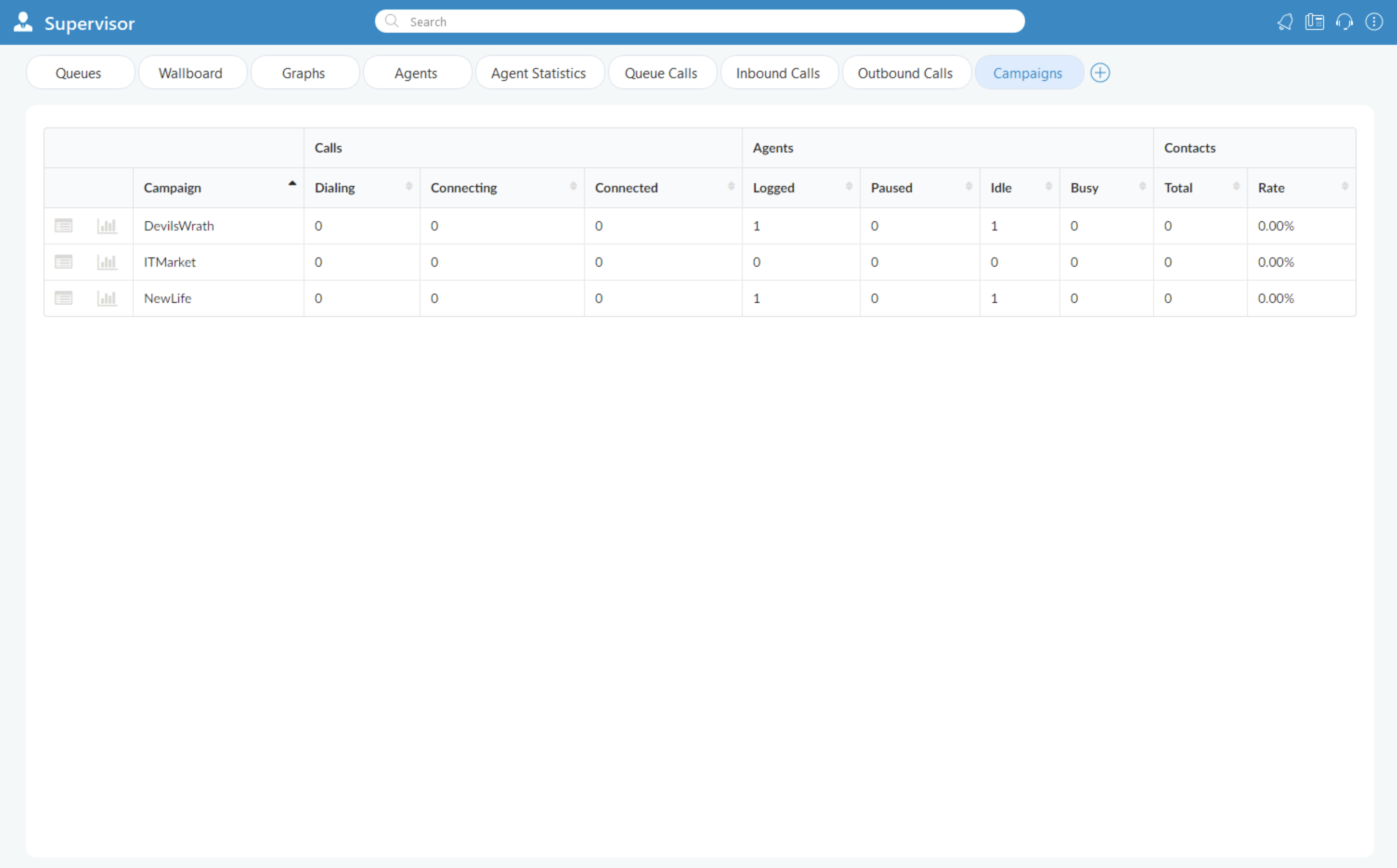
The Campaigns module displays Campaign statistics for the current day.
For each Campaign the following information is shown:
- Campaign Name: Displays Campaign name.
- Calls: Represents number of dialing, connecting and connected calls.
- Dialing: Shows number of Dialed calls.
- Connecting: Shows number of currently Connecting Calls.
- Connected: Displays number of Connected Calls.
- Agents: Displays number of Agents in current Campaigns.
- Logged: Shows number of Logged Agents.
- Paused: Shows Agents on pause.
- Idle: Displays currently Idle Agents.
- Busy: Displays number of Busy Agents.
- Contacts: Indicates successful contacts in Campaigns.
- Total: Indicates total number of successful contacts in Campaigns.
- Rate: Refers to the percentage of workload that has been done in Campaigns.
¶ Supervisor Real Time Statistics
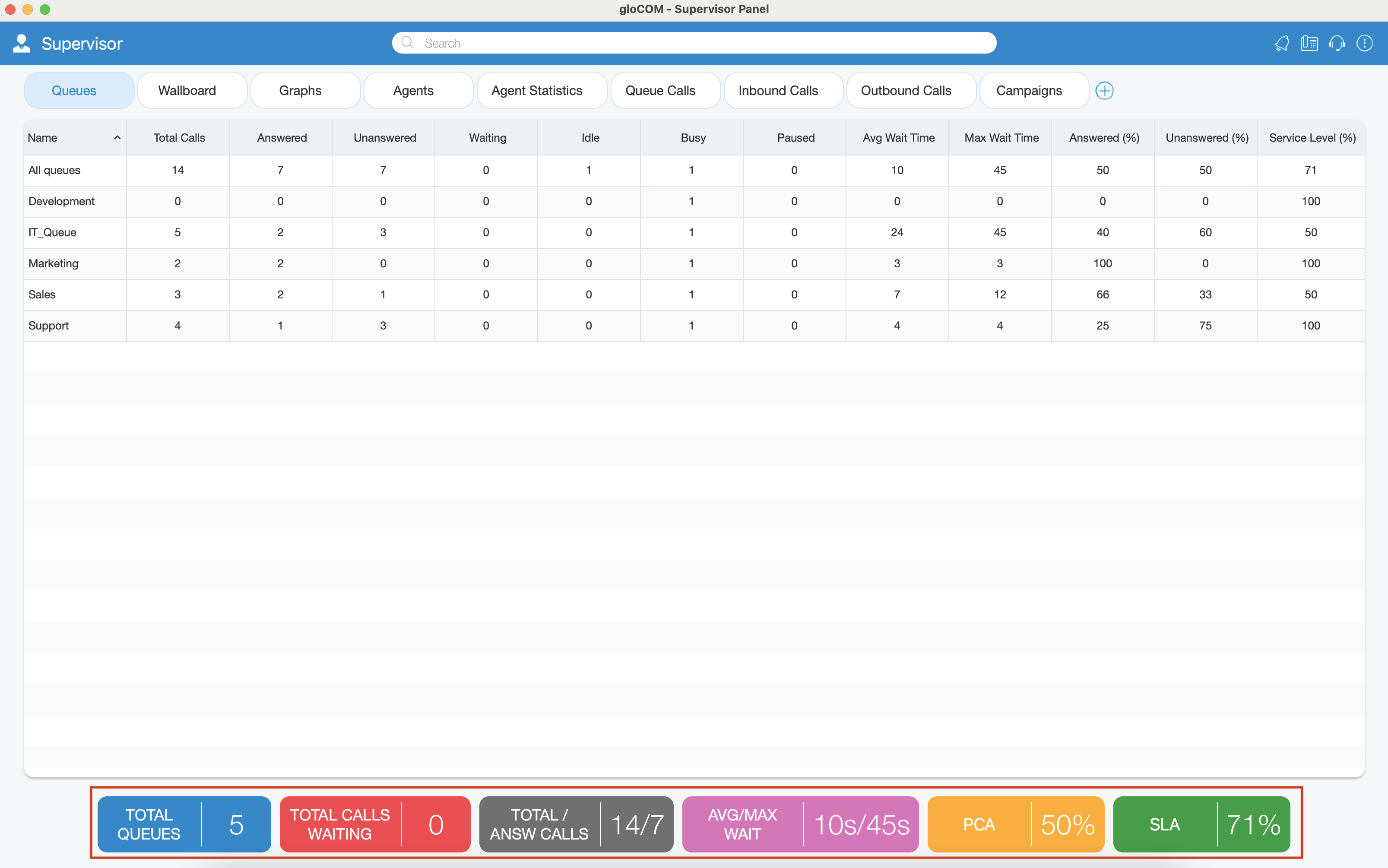
With the current fresh design of the Supervisor, advanced Global Statistics were introduced. These statistics include all Systems statistics, Queues, and Agents statistics in real-time, and can be displayed within different tabs.
For selected tabs in Supervisor Panel, there are specific areas (on the bottom of the panel) that are showing Real-time Statistics for each tab separately.
¶ Queues Tab
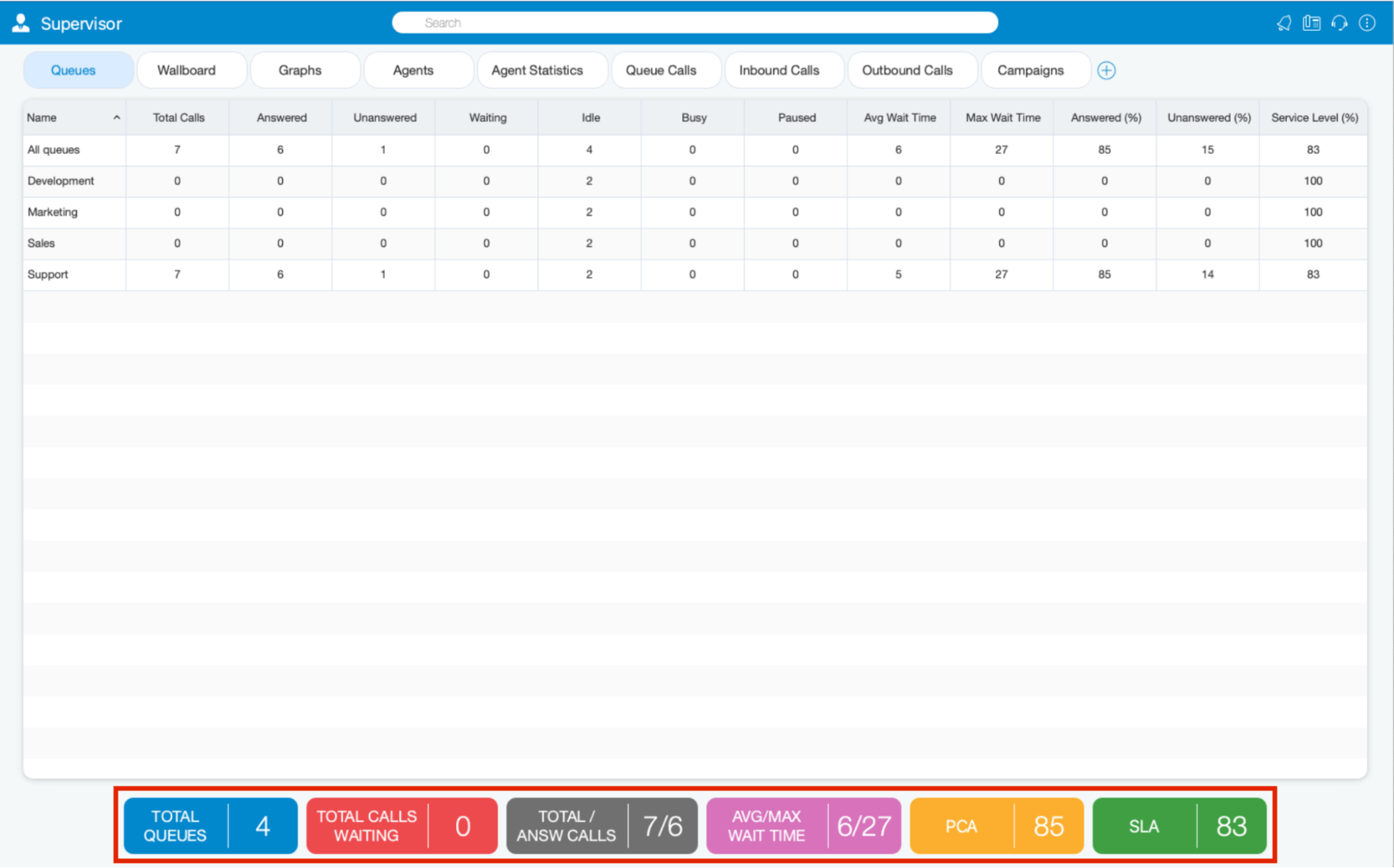
Inside the Queues tab, the Supervisor can monitor real-time information for all Queues selected through the Preferences dialog.
For the Queues tab the following statistics are shown:
- Total queues: Represents the total number of queues on the system.
- Total calls waiting: Represents the total number of calls waiting in the Queue.
- Total/Answered calls: Represents the total number of calls that entered the system and the total number of answered calls by all Queues.
- Average Wait Time (AWT) (in seconds): Represents the average amount of time callers must wait to reach an Agent.
- Maximum Wait Time (MWT) (in seconds): Represents the maximum amount of time callers must wait to reach an Agent.
- PCA: Represents the percentage of calls answered in all Queues.
- SLA (%): Represents the percentage of calls that have been answered within a specified period of time. Service Level can be configured in the Preferences window.
¶ Agents Tab
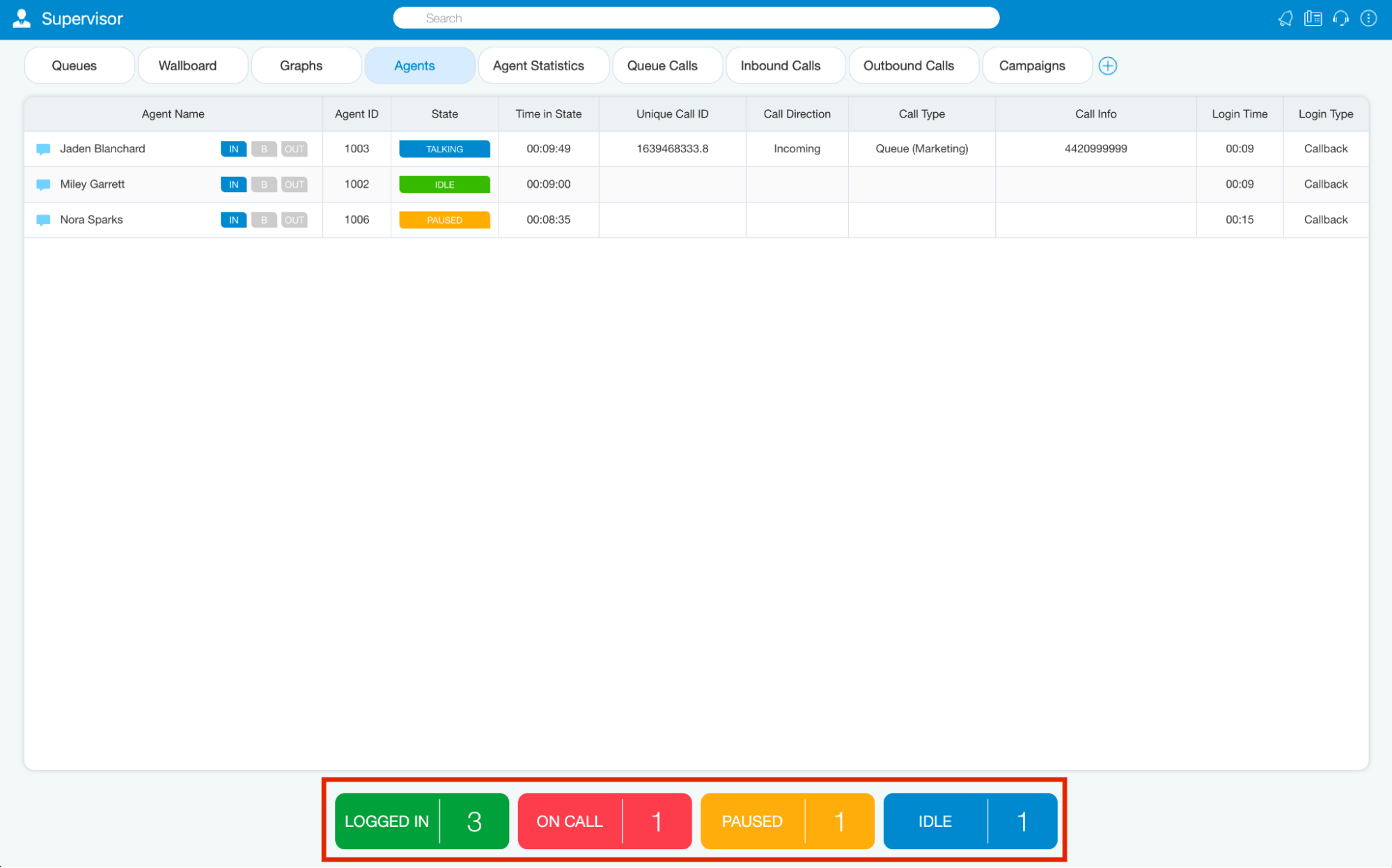
Inside the Agents tab, the Supervisor can monitor information for all logged-in Agents selected through the Preferences dialog.
For the Agents module tab the following statistics are shown:
- Logged In: Represents the total number of logged-in Agents.
- On Call: Represents a number of Agents on call.
- Paused: Represents the total number of paused Agents.
- Idle: Represents the total number of idle Agents.
¶ Agent Statistics Tab
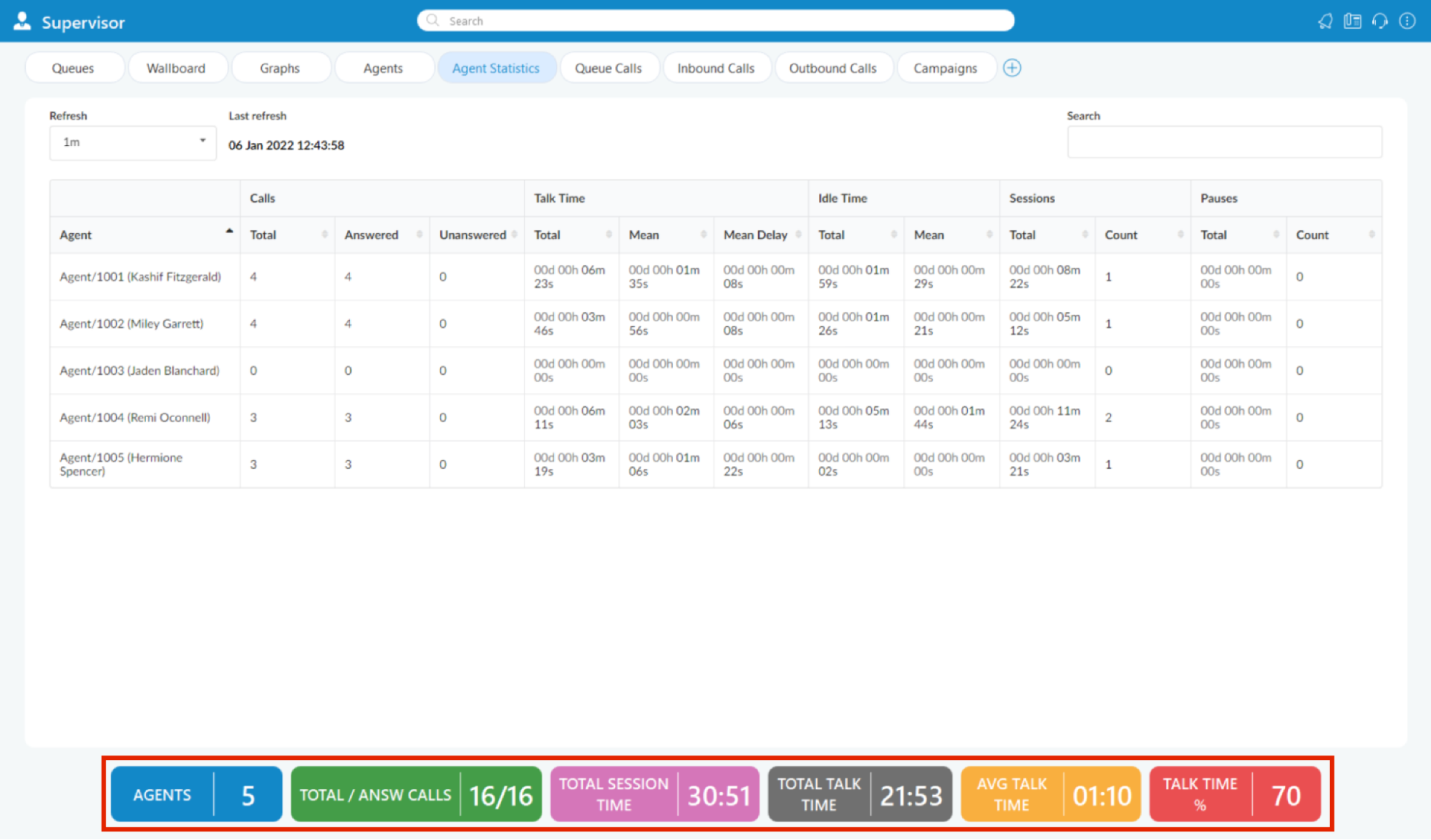
Agent Statistics tab displays Agent Inbound and Outbound statistics that include all Agent calls (inbound, outbound, direct (in/out) ) into calculations.
For the Agents Statistics tab the following statistics are shown:
- Agents: Represents the total number of Agents on the system.
- Total/Answered calls: Represents the total number of calls per Agent and the total number of answered calls by all Agents.
- Total Session Time: Represents the total amount of time Agents were logged on the system. (Total Session Time is updated every minute, and also whenever an Agent logs off, in real-time).
- Total Talk Time: Represents the total talking time for all Agents. (Total Talk Time is updated every minute, and also whenever an Agent finishes a call, in real-time).
- Average Talk Time: Represents the average amount of talking time per Agent. (Average Talk Time is updated whenever an Agent completes a call).
- Talk Time (%): Represents the percentage of all session time, Agents were on calls.
¶ Queue Calls Tab
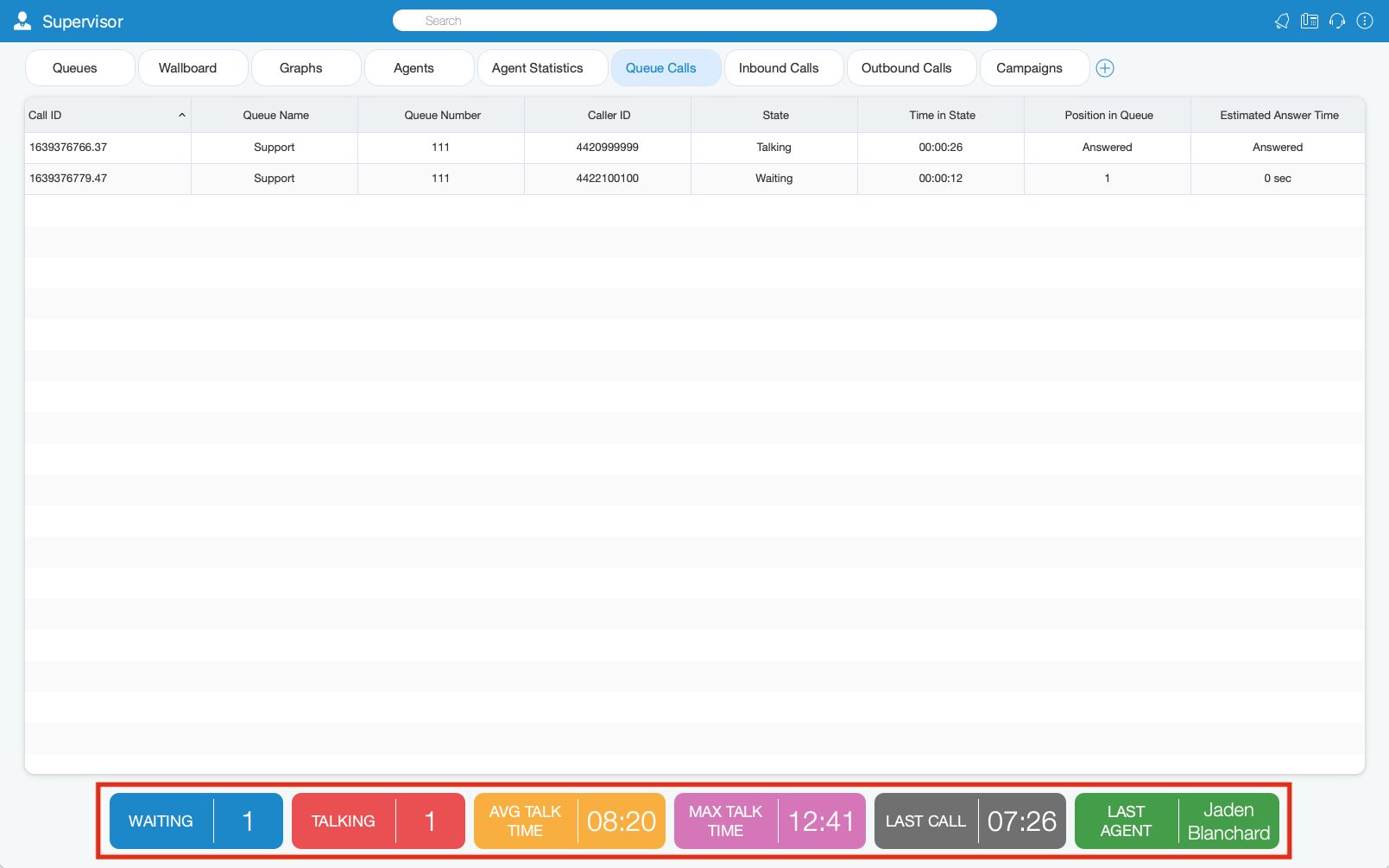
Inside the Queue Calls tab, the Supervisor can monitor information for calls from all the Queues he/she selects to be visible through the Preferences dialog.
For the Queue Calls tab the following statistics are shown:
- Waiting: Represents the number of callers in the Queues.
- Talking: Represents the number of Agents currently talking.
- Average Talk Time: Represents the average talk time for all Agents.
- Max Talk Time: Represents the longest Queue call.
- Last Call: Displays the time when the last call happened.
- Last Agent: Shows the name of the Agent who has the last call.
¶ Inbound Calls Tab
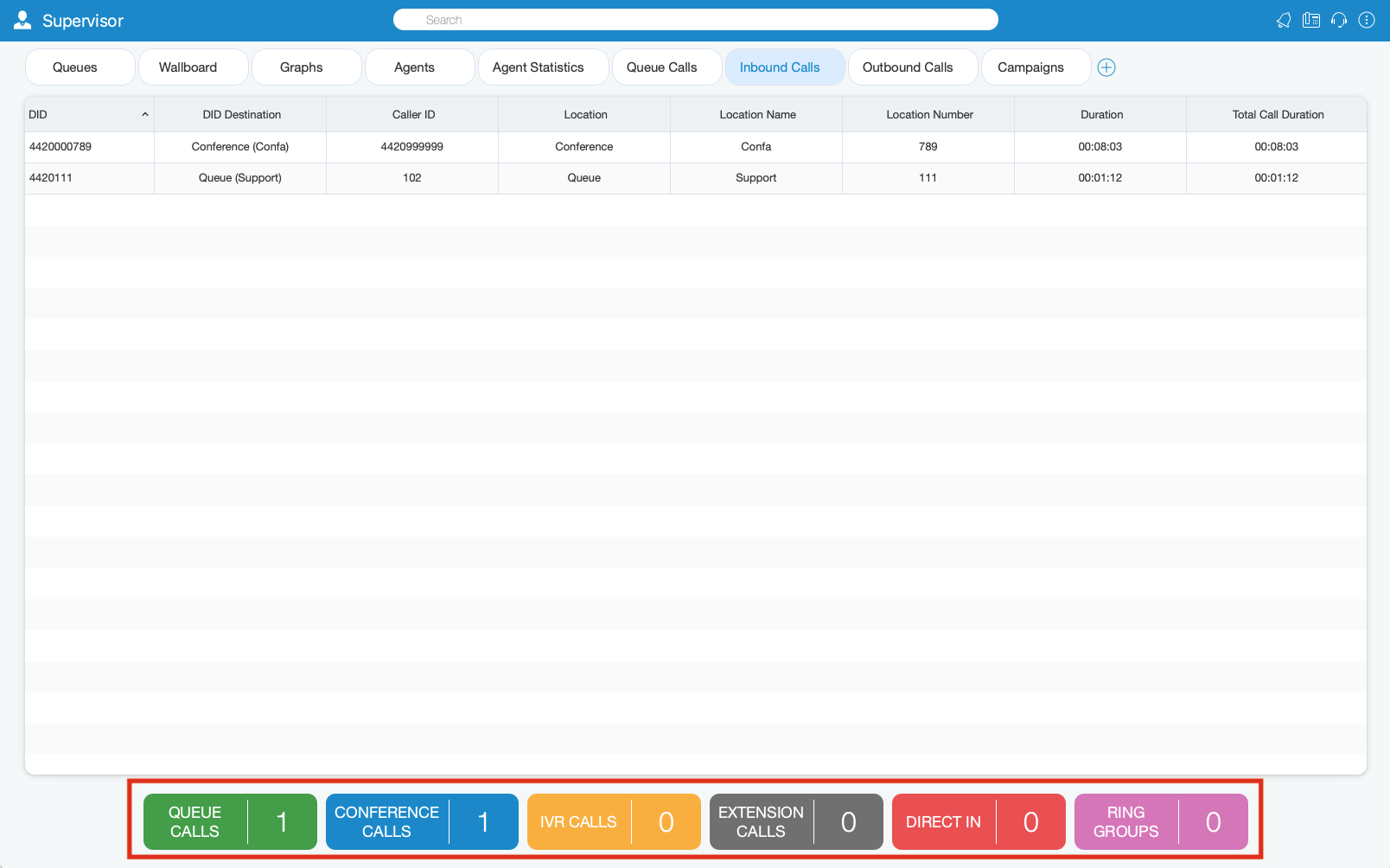
Inside the Inbound Calls module, the Supervisor can monitor information for all calls coming into the system.
For the Inbound Calls tab the following statistics are shown:
- Queue Calls: Shows the number of all Queue calls.
- Conference Calls: Shows the number of all Conference Calls.
- IVR Calls: Shows the number of all IVR Calls.
- Extension Calls: Show the number of all Extension Calls.
- Direct In: Shows the number of all Direct In Calls.
- Ring Groups: Shows the number of all Ring Group Calls.
¶ Outbound Calls Tab
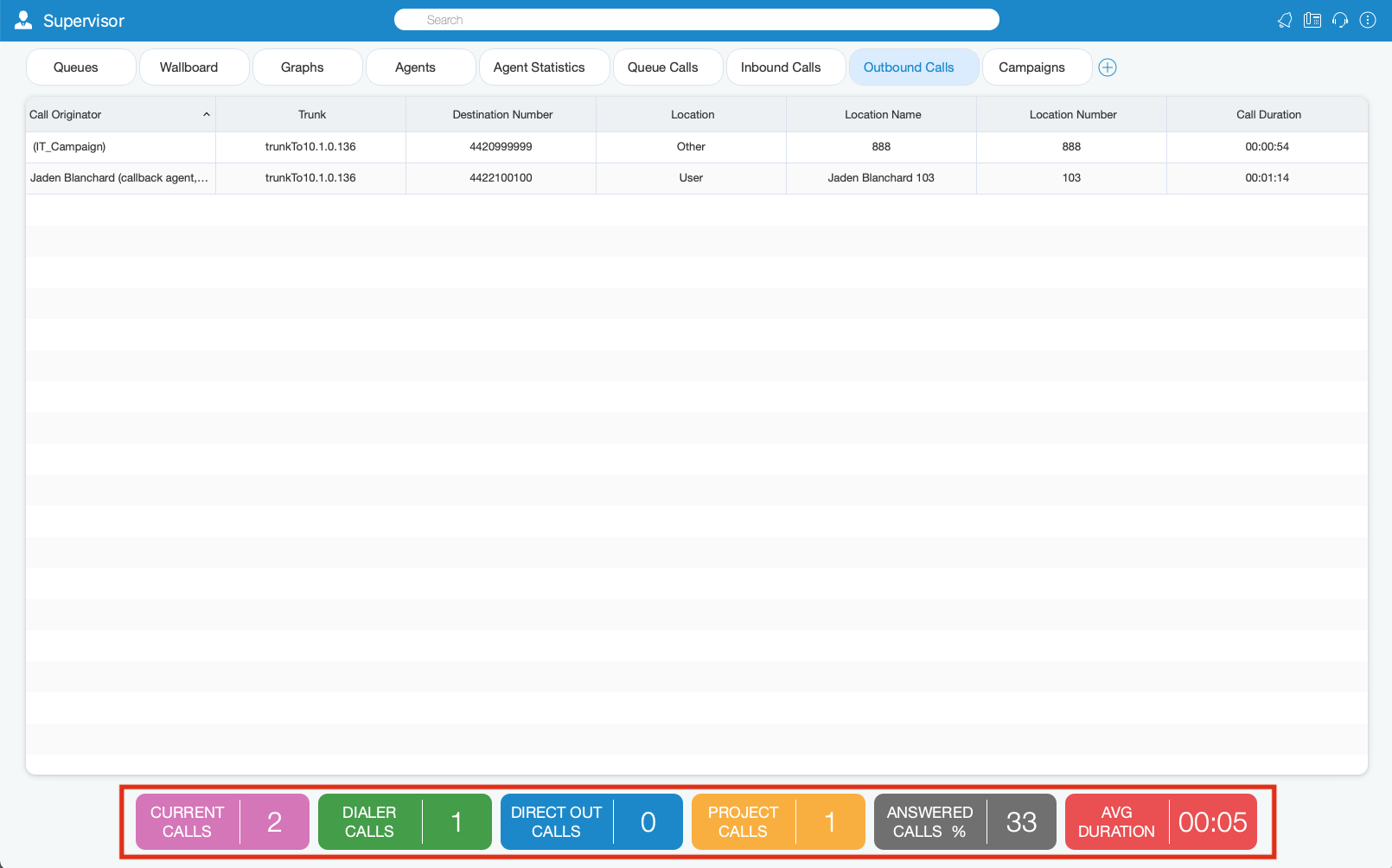
Inside the Outbound Calls module, the Supervisor can monitor information for all calls going out from the system.
For the Outbound Calls tab the following statistics are shown:
- Current Calls: Displays the number of current calls.
- Dialer Calls: Displays the number of Dialer calls.
- Direct Out Calls: Displays the number of Direct Out Calls.
- Project Calls: Displays the number of Project Calls.
- Answered Calls(%): Represents the percentage of Answered Calls during one day (starting from midnight).
- Average Duration: Represents the Average Duration of the call.
¶ Supervisor Overview

User can have an Overview of all Supervisor Agent tabs inside of Overview tab all at one place organised as dashboard where all information are easily accessible at one place.
¶ Queues Overview
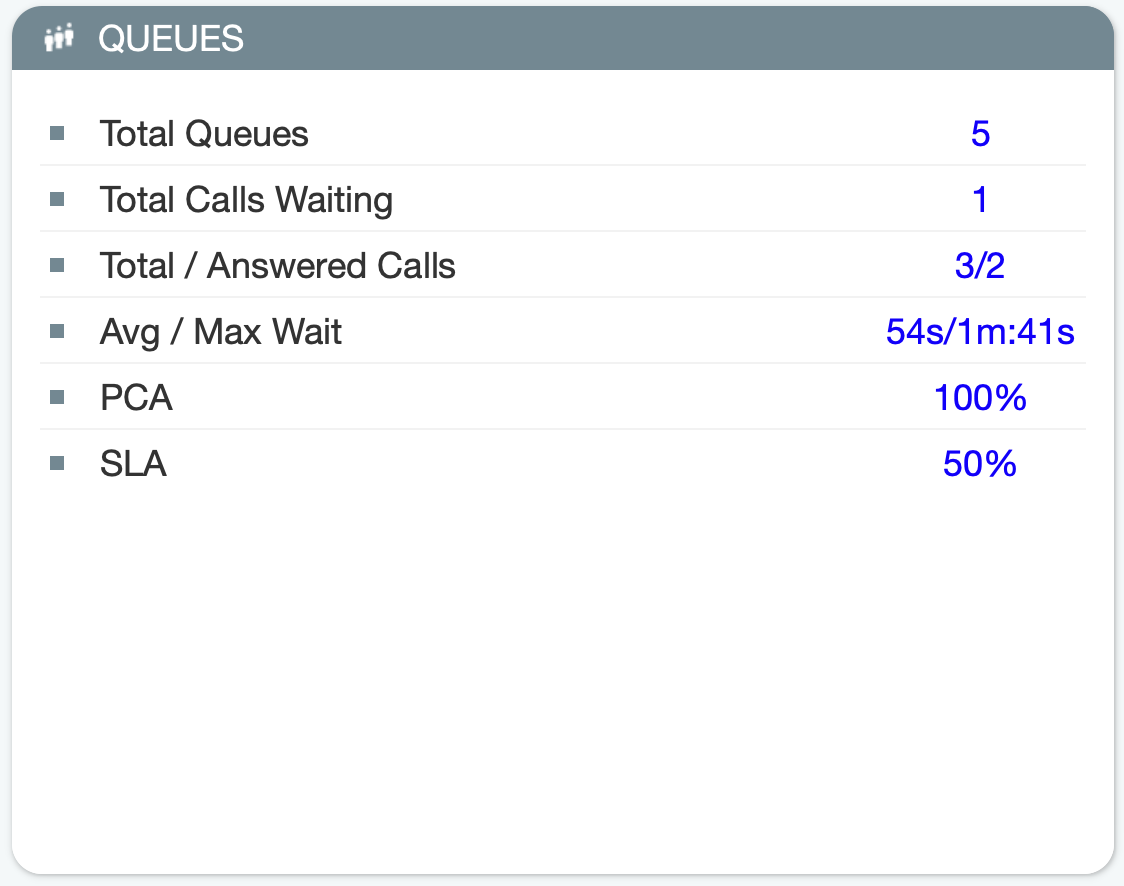
- Total Queues: Represents the total number of queues on the system.
- Total Calls Waiting: Represents the total number of calls waiting in the Queue.
- Total/Answered Calls: Represents the total number of calls that entered the system and the total number of answered calls by all Queues.
- Avg/Max Wait: Represents the average amount of time callers must wait to reach an Agent.
- PCA: Represents the percentage of calls answered in all Queues.
- SLA: Represents the percentage of calls that have been answered within a specified period of time. Service Level can be configured in the Preferences window.
¶ Agents Overview
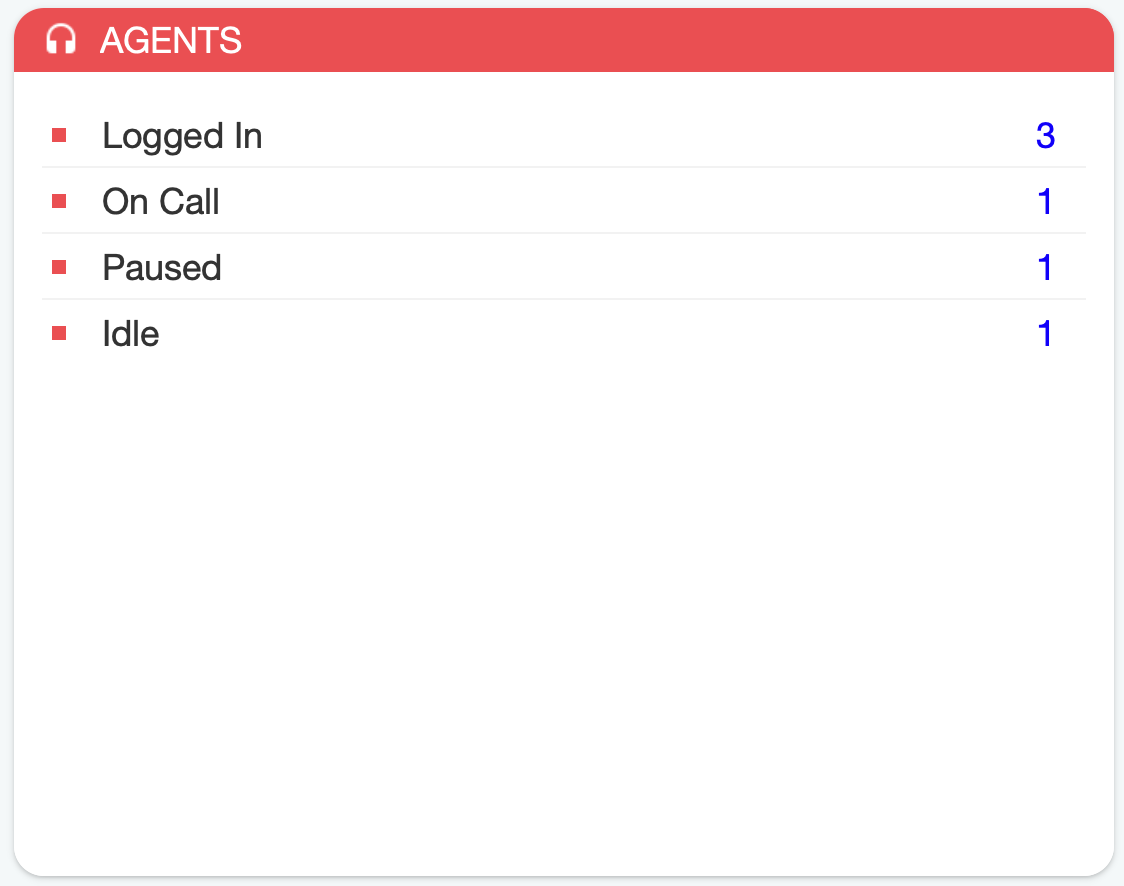
- Logged In: Represents the total number of logged-in Agents.
- On Call: Represents a number of Agents on call.
- Paused: Represents the total number of paused Agents.
- Idle: Represents the total number of idle Agents.
¶ Inbound Calls Overview
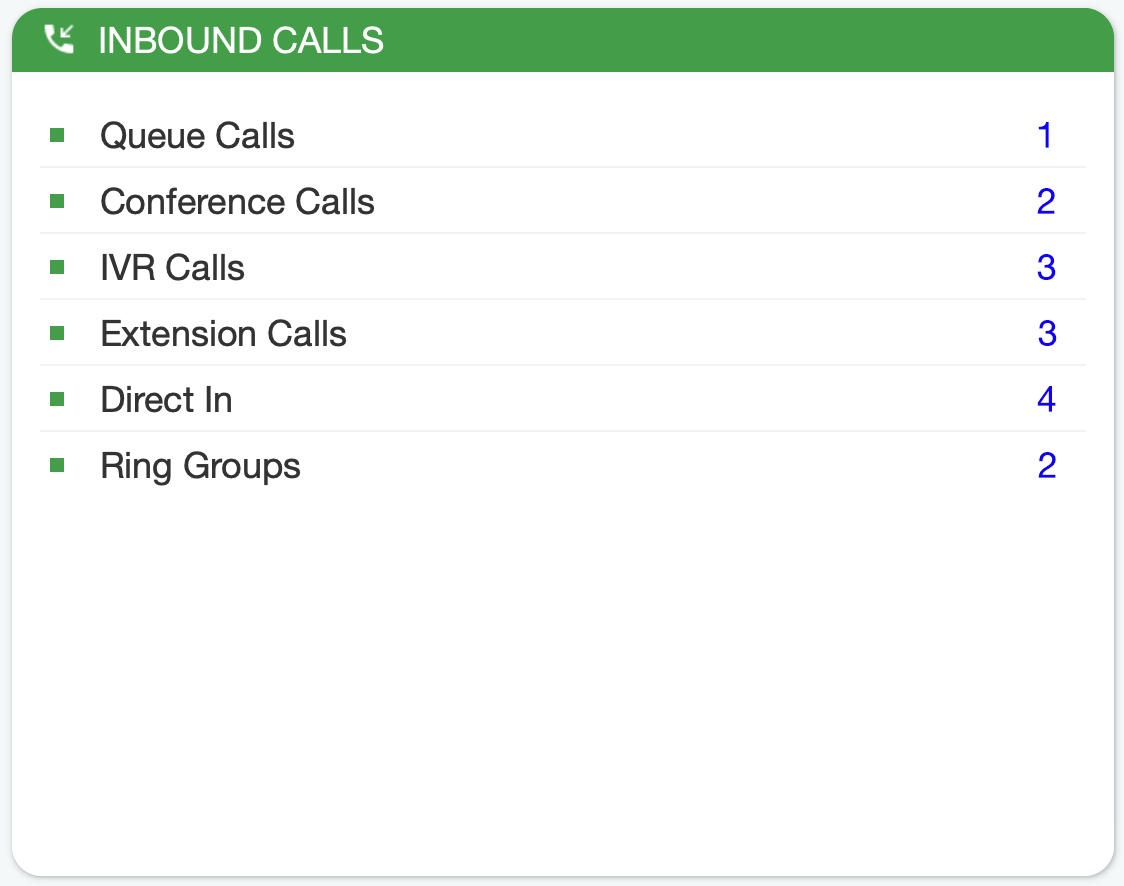
- Queue Calls: Represents the total concurrent inbound calls per Queue.
- Conference Calls: Represents the total concurrent inbound Conference Calls.
- IVR Calls: Represents the total concurrent inbound calls per IVR.
- Extension Calls: Represents the total concurrent inbound calls per Extension.
- Direct In: Represents the total concurrent inbound per Agent calls.
- Ring Groups: Represents the total concurrent inbound calls per Ring Groups.
¶ Queue Calls Overview

- Waiting: Represents the total number of concurrent calls waiting in the Queue to be answered.
- Talking: Represents the number of Agents currently talking.
- Avg Talk Time: Represents the average talk time for all Queues.
- Max Talk Time: Represents the longest Queue call.
- Last Call: Displays the time when the last call happened.
- Last Agent: Shows the name of the Agent who has the last call.
¶ Agent Statistics Overview
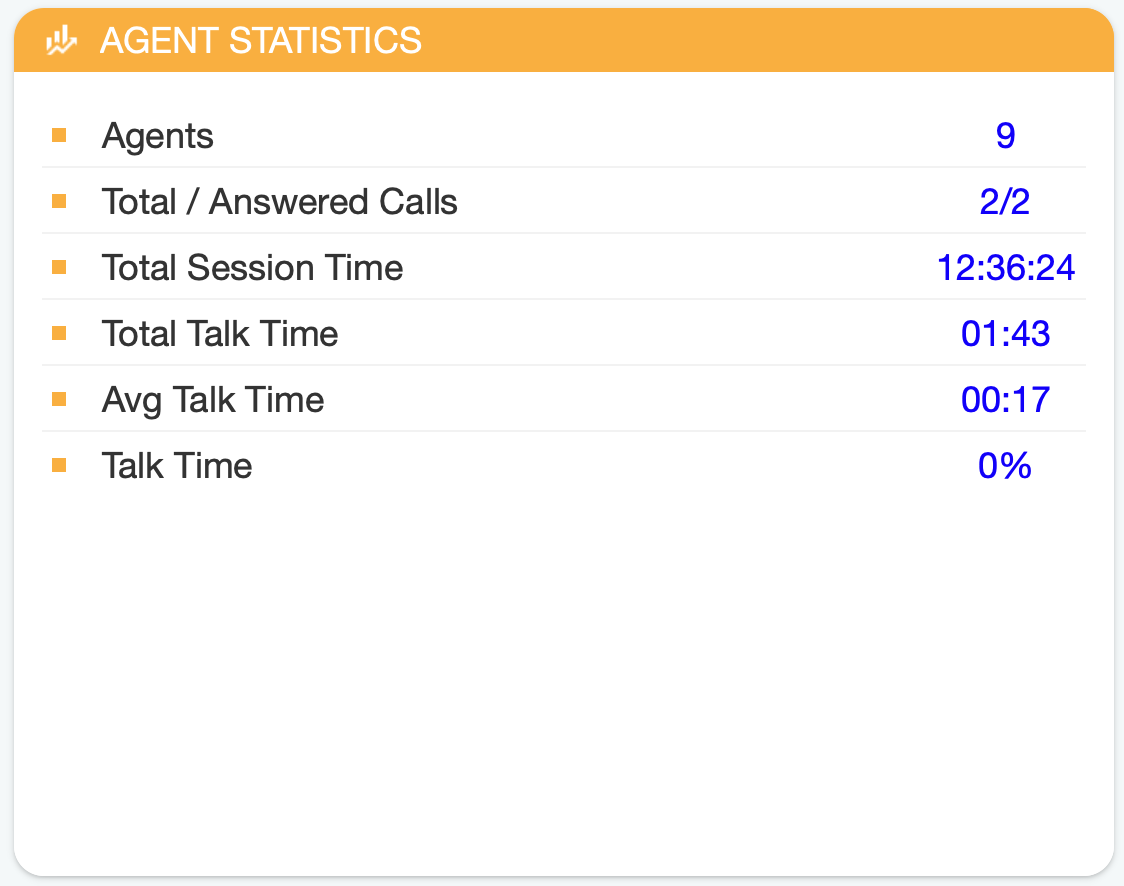
- Agents: Represents the total number of Agents on the system.
- Total/Answered Calls: Represents the total number of all answered Agent calls.
- Total Session Time: Represents the total logged in time for all agents.
- Total Talk Time: Represents the total talk time for all agents.
- Avg Talk Time: Represents the average Agent talk time.
- Talk Time: Represents the percentage of talk time for all agents.
¶ Outbound Calls Overview
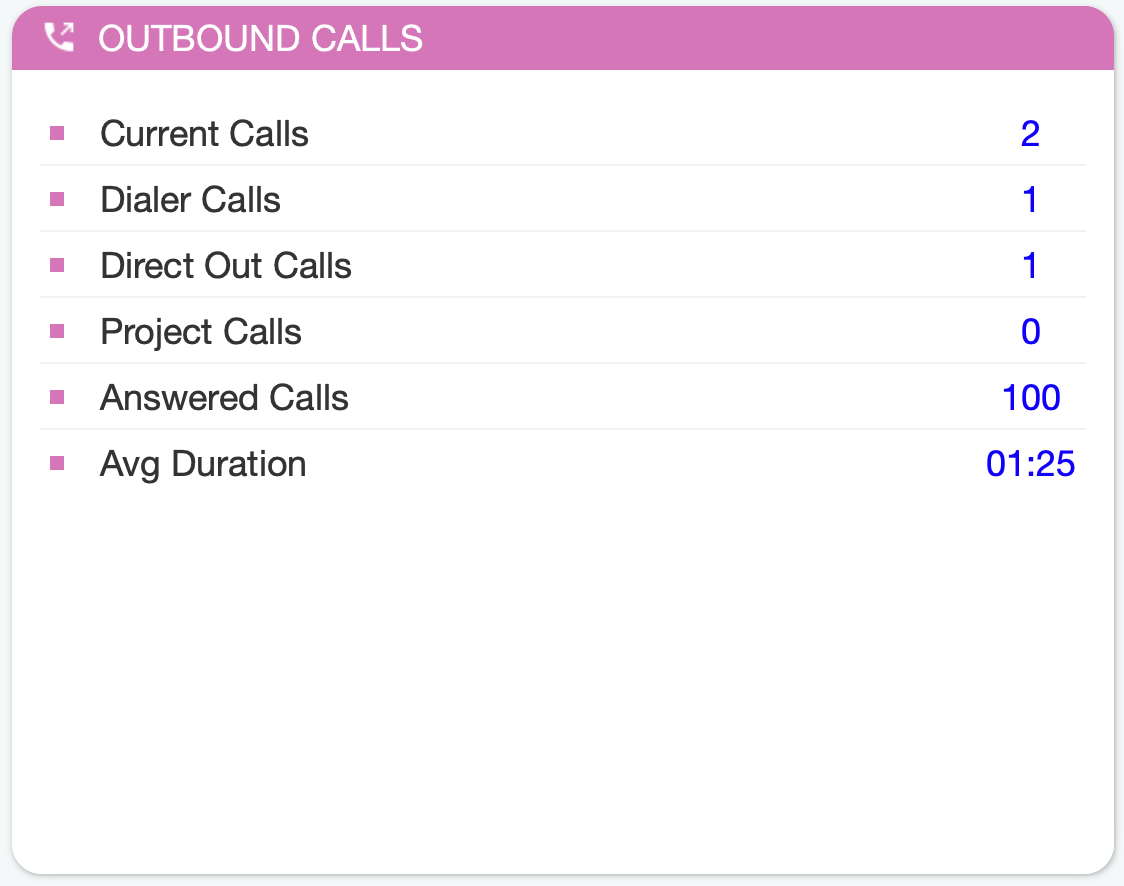
- Current Calls: Displays the number of current calls.
- Dialer Calls: Displays the number of Dialer calls.
- Direct Out Calls: Represents the total number of direct out calls.
- Project Calls: Represents the total number of concurrent per Project Code calls.
- Answered Calls: Represents the percentage of Answered Calls during one day (starting from midnight).
- Avg Duration: Represents the Average Duration of the call.
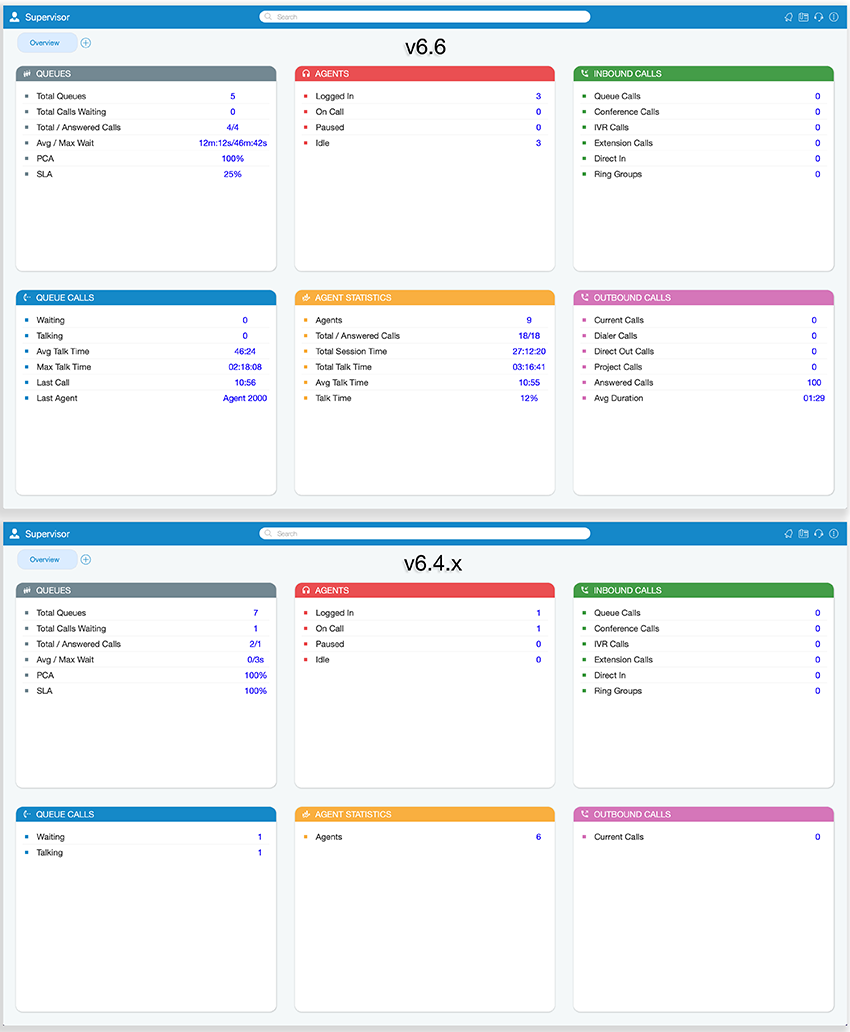
Not all information are present both on 6.6 and 6.4.x versions so here is a comparison so user can see differences and enrichment in information types introduced in 6.6 version.
¶ OmniChannel Supervisor (available in gloCOM Supervisor edition)
¶ Supervisor Login
An additional requirement for the supervisor edition has been added to log in as an agent with proper credentials (agent number, agent PIN).
If you have the omnichannel license enabled, the next step is to log in to the app. Please note that the login process for Omnichannel has been updated.
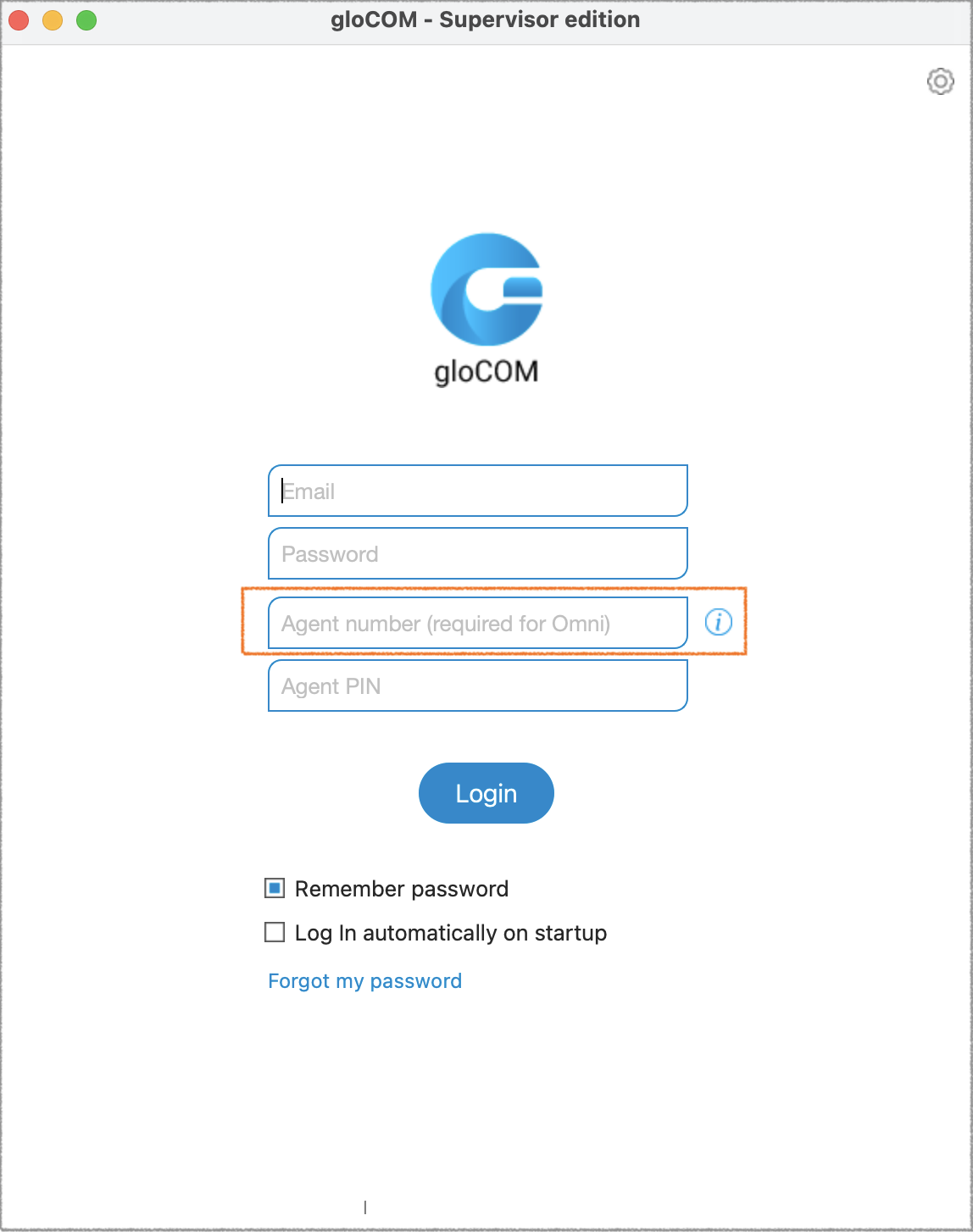
In the new Agent panel, supervisors will need to log in as agents by providing additional credentials:
- Agent number assigned to the Supervisor (required)
- Agent PIN (optional)
These changes are designed to address privacy concerns related to permissions. Supervisors can now monitor only the queues and agents they are responsible for. To enable this, supervisors must be added as members of the specific queues they need to monitor.
It's important to mention that these changes do not affect the Supervisor panel. The Supervisor panel will continue to provide comprehensive information about voice queues and other call-related statistics.
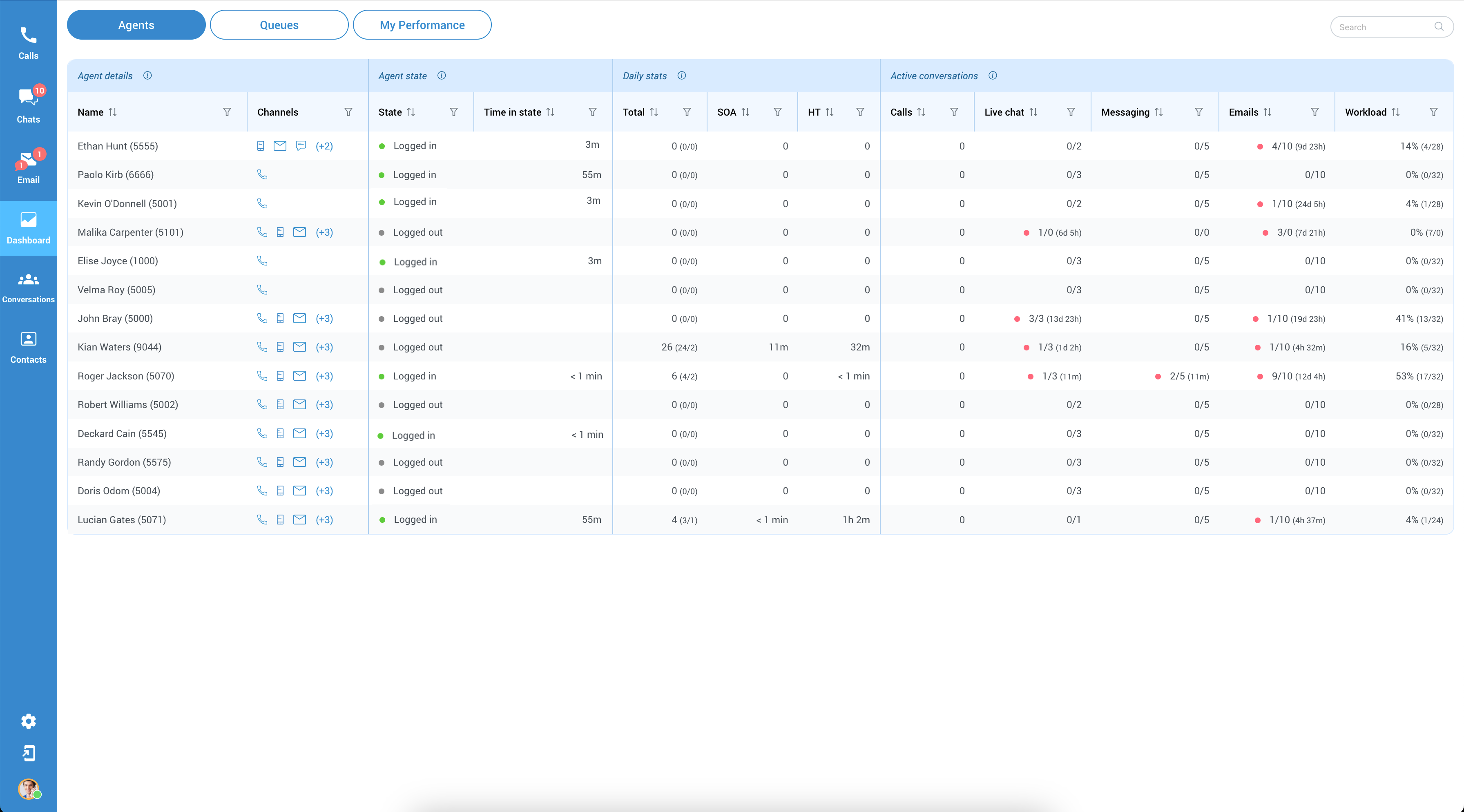
When logging in as a Supervisor for the first time, you will be automatically directed to the 'Dashboard' page. This is the default setting and only occurs during your initial login as a supervisor.

Also, with the latest update, when you log in as a supervisor, you'll find yourself in a 'Logged Off' state by default. In this state, you won't receive voice calls (as you'll appear offline in the app), but you'll still be able to receive and manage conversations via LiveChat and Emails. Even in this 'Logged Off' state, you'll have full access to all supervisor functions, including monitoring conversations, a dashboard, banning/unbanning customers, and active and closed conversations.
To begin receiving Voice calls, click the 'Agent Login' button in the agent profile section. Once clicked, you'll be prompted with an additional window to confirm your login.
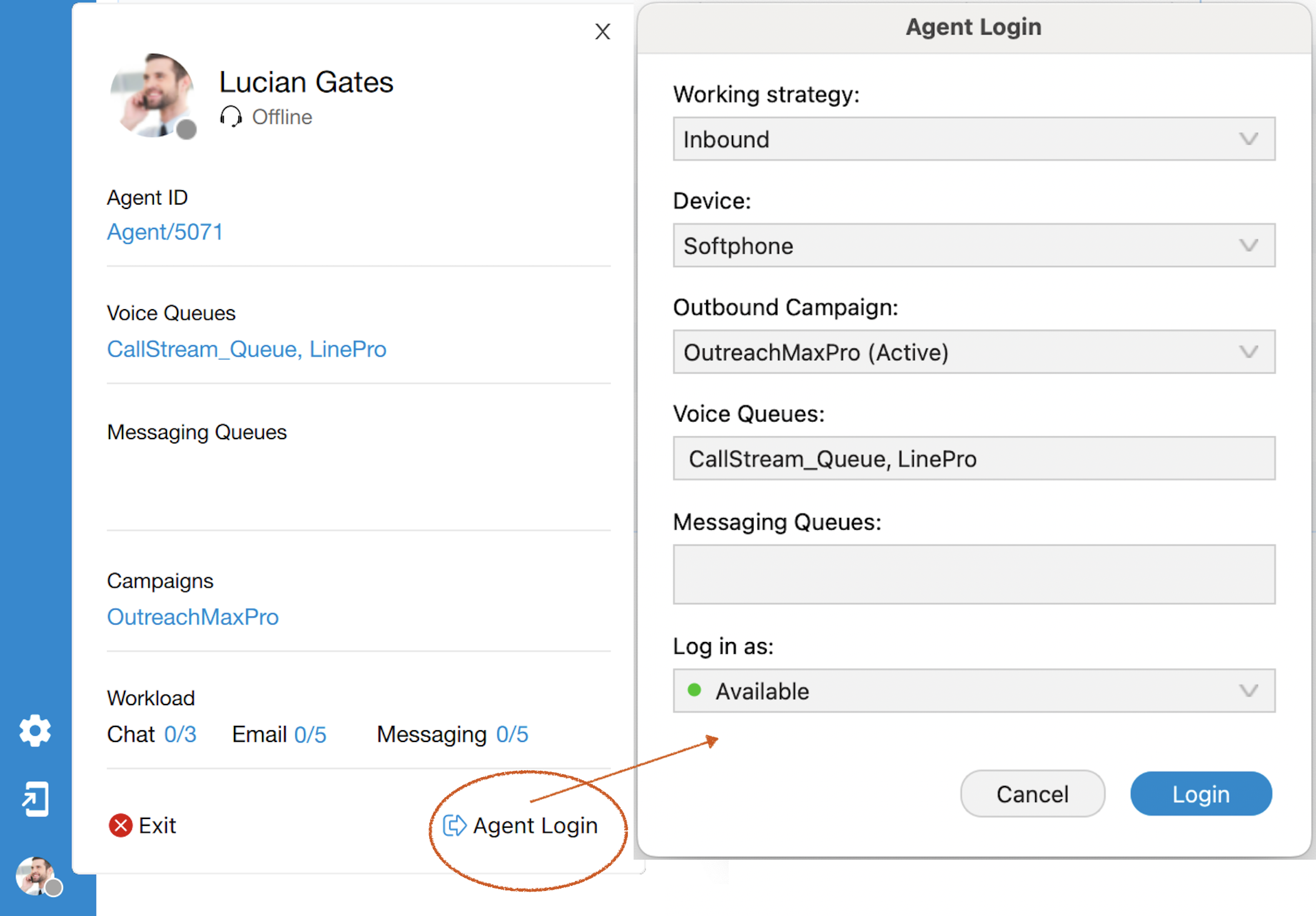
¶ Supervisor Login Without Agent Number
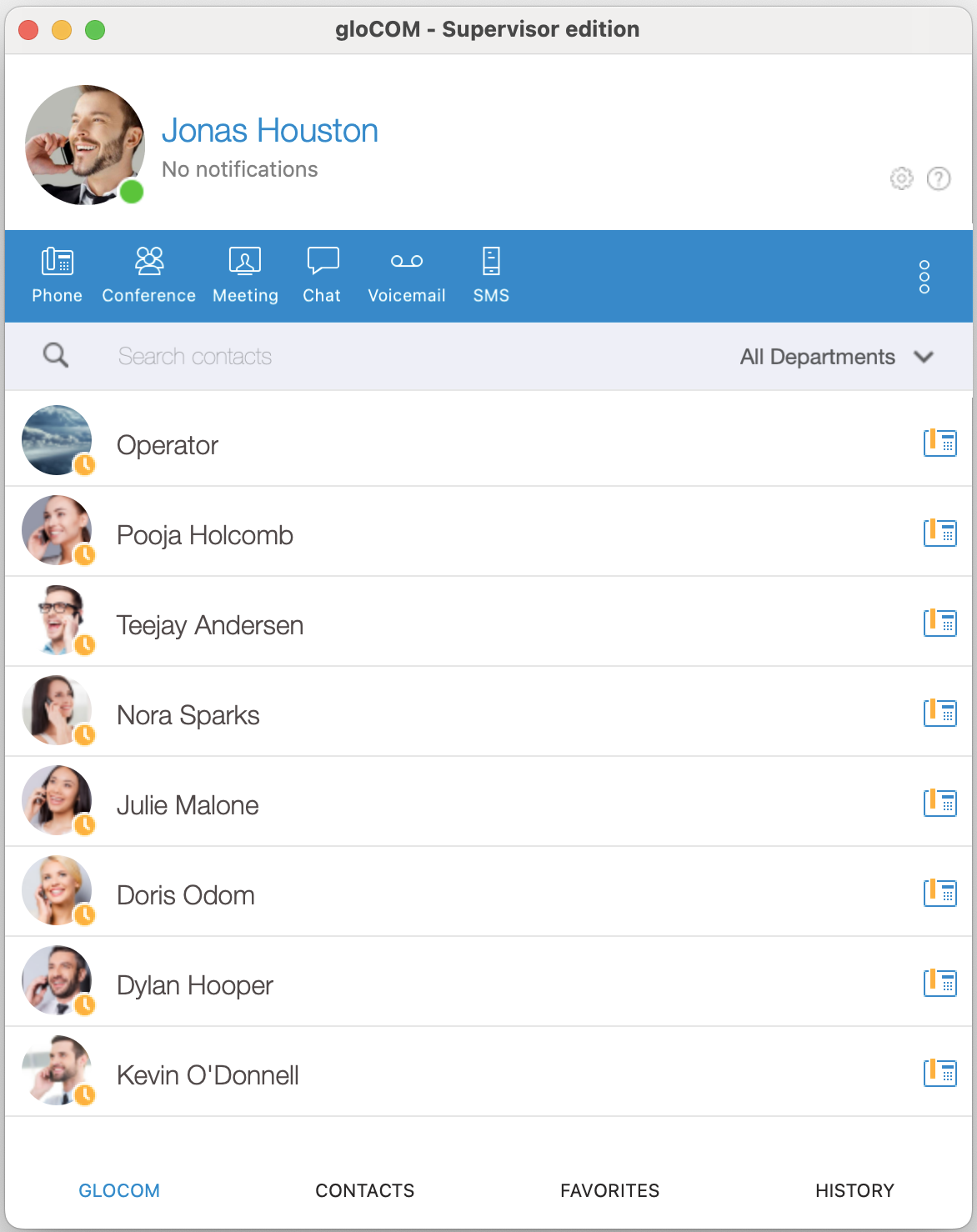
If you attempt to log in without entering an agent number, you'll successfully access the app's main page, but you won't be able to use or activate the Agent panel. However, the Supervisor panel will remain accessible for your use.
¶ Agent Panel - Supervised Chat
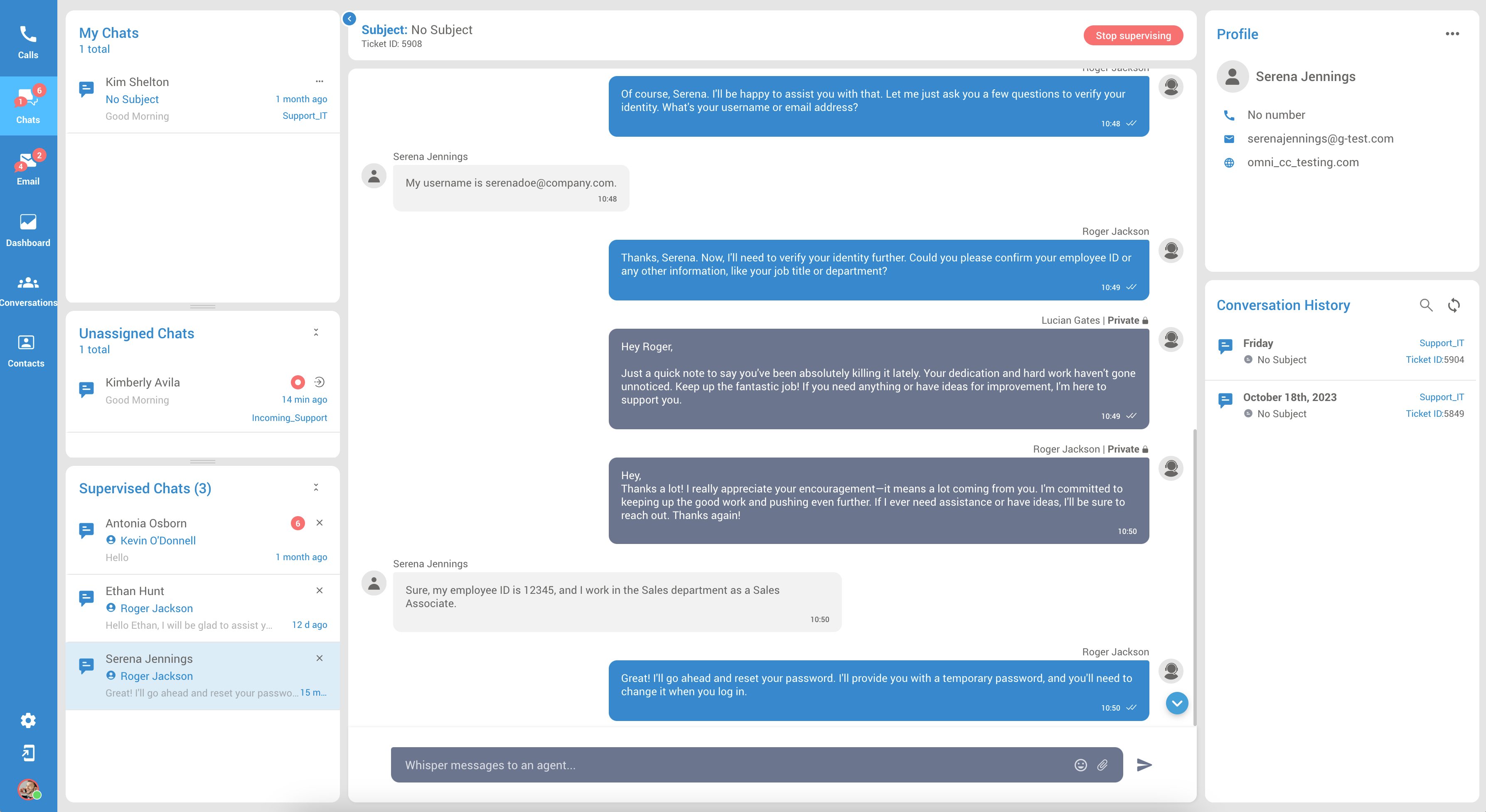
Supervisors have the capability to monitor live chat sessions between customer service representatives /agents and customers. During this session, the supervisor can intervene in chat when the agent encounters complex issues or requires assistance. They can take over the conversation to provide immediate support, answer questions, or resolve customer concerns more effectively.
Messages in the gray box are private and visible only to the supervisor and the agent. The 'Whisper' option is enabled in the supervisor edition, allowing communication solely between supervisors and agents.
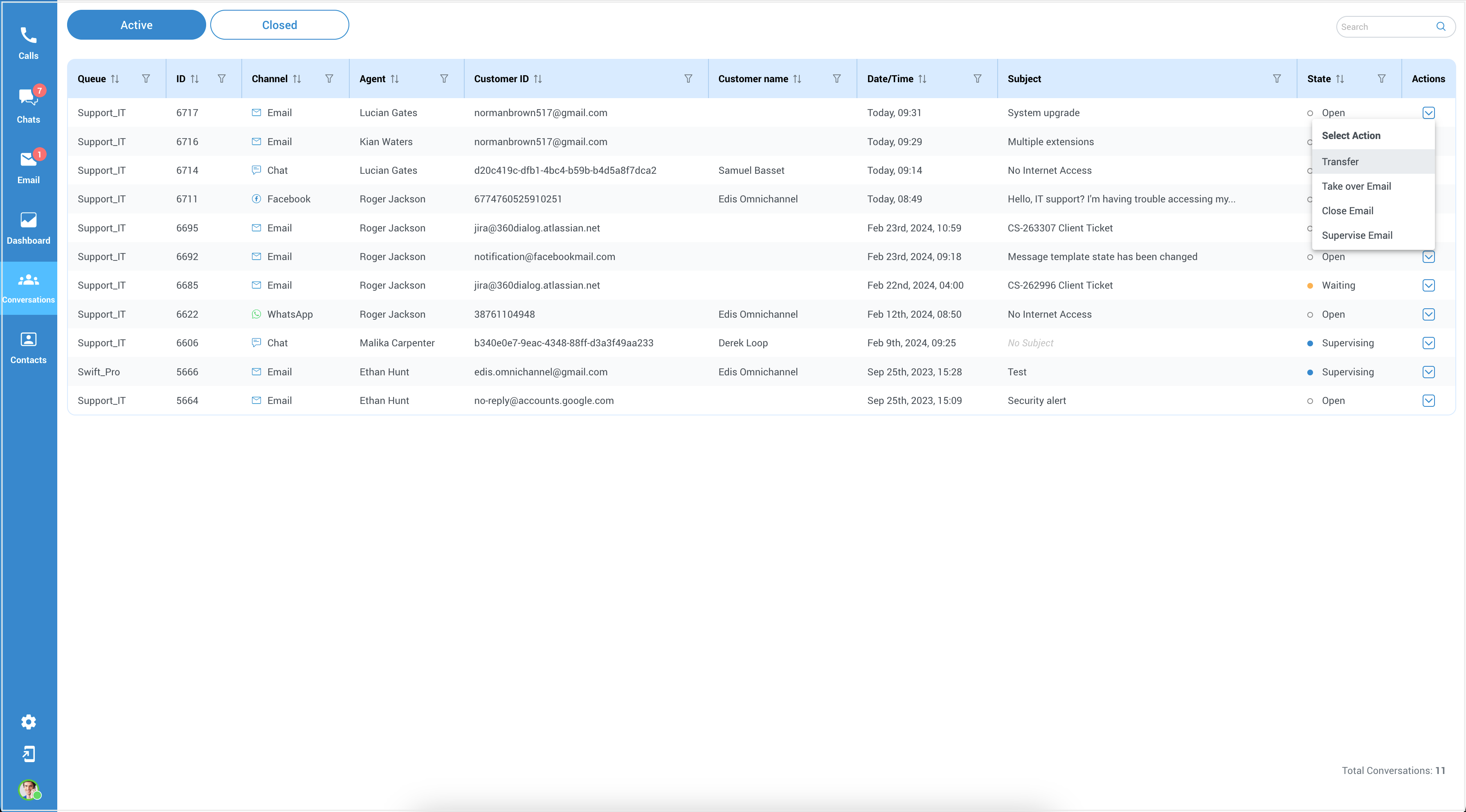
In this section, Supervisors have the ability to easily identify and choose the particular conversation they want to supervise. This is made simple through a drop-down menu located under the Actions column. This menu presents Supervisors with multiple actions and they can select the option that best suits their supervision requirements.

A corresponding notification will appear within the window when the supervisor starts or stops supervising the conversation.
It's crucial to highlight that when a conversation is being supervised, there's a notable change in its status. This modification is visible in the State column within the Conversations tab, where the status shifts to "Supervising". This updated status serves as a clear indicator that the conversation is currently under supervision.
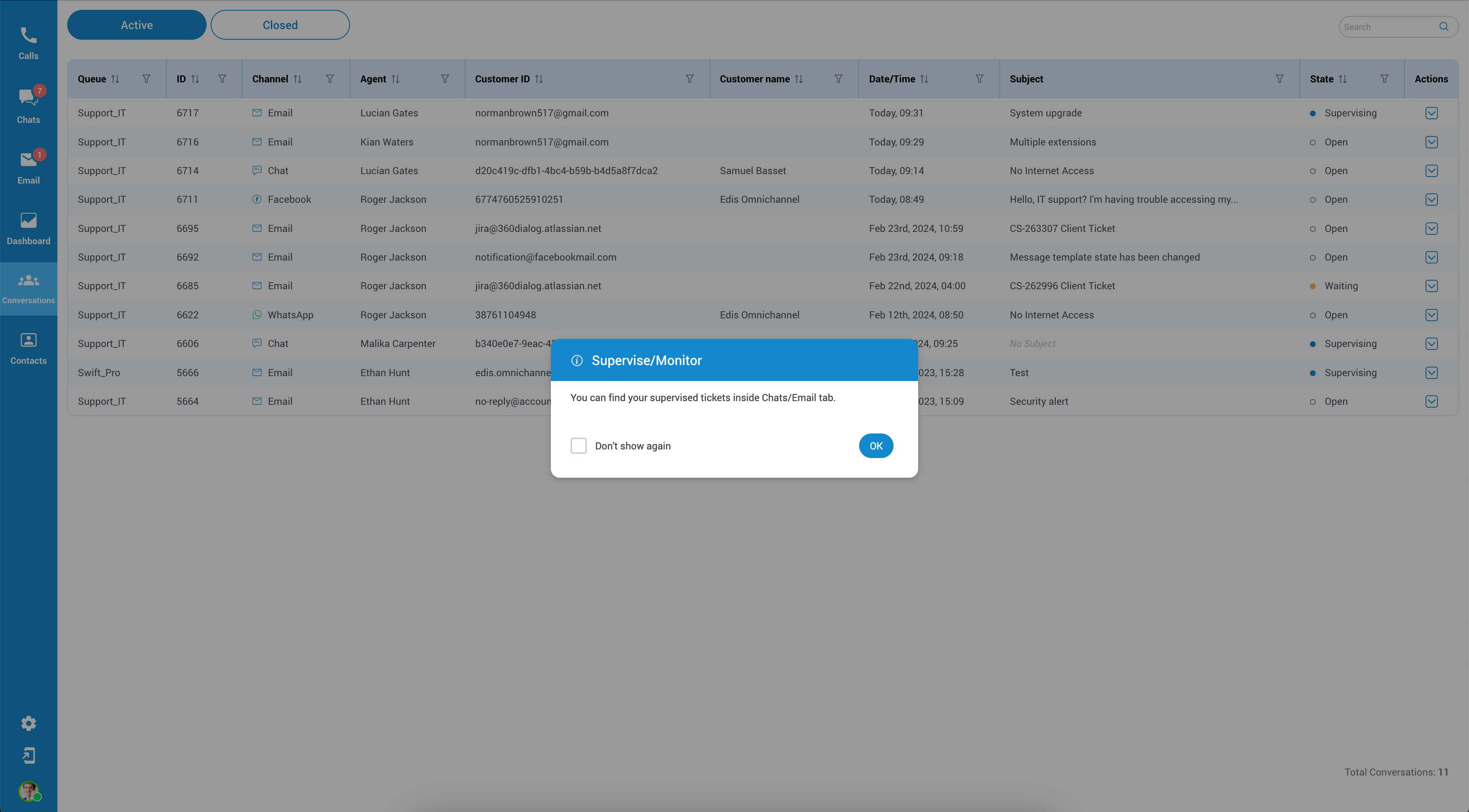
A pop-up message will appear after choosing the relevant option, displaying the guidance: "You can find your supervised tickets inside the Chats/Email tab." This message serves as a prompt, directing Supervisors to where they can locate their supervised tickets. To acknowledge this message and proceed, the Supervisor should click the OK button.
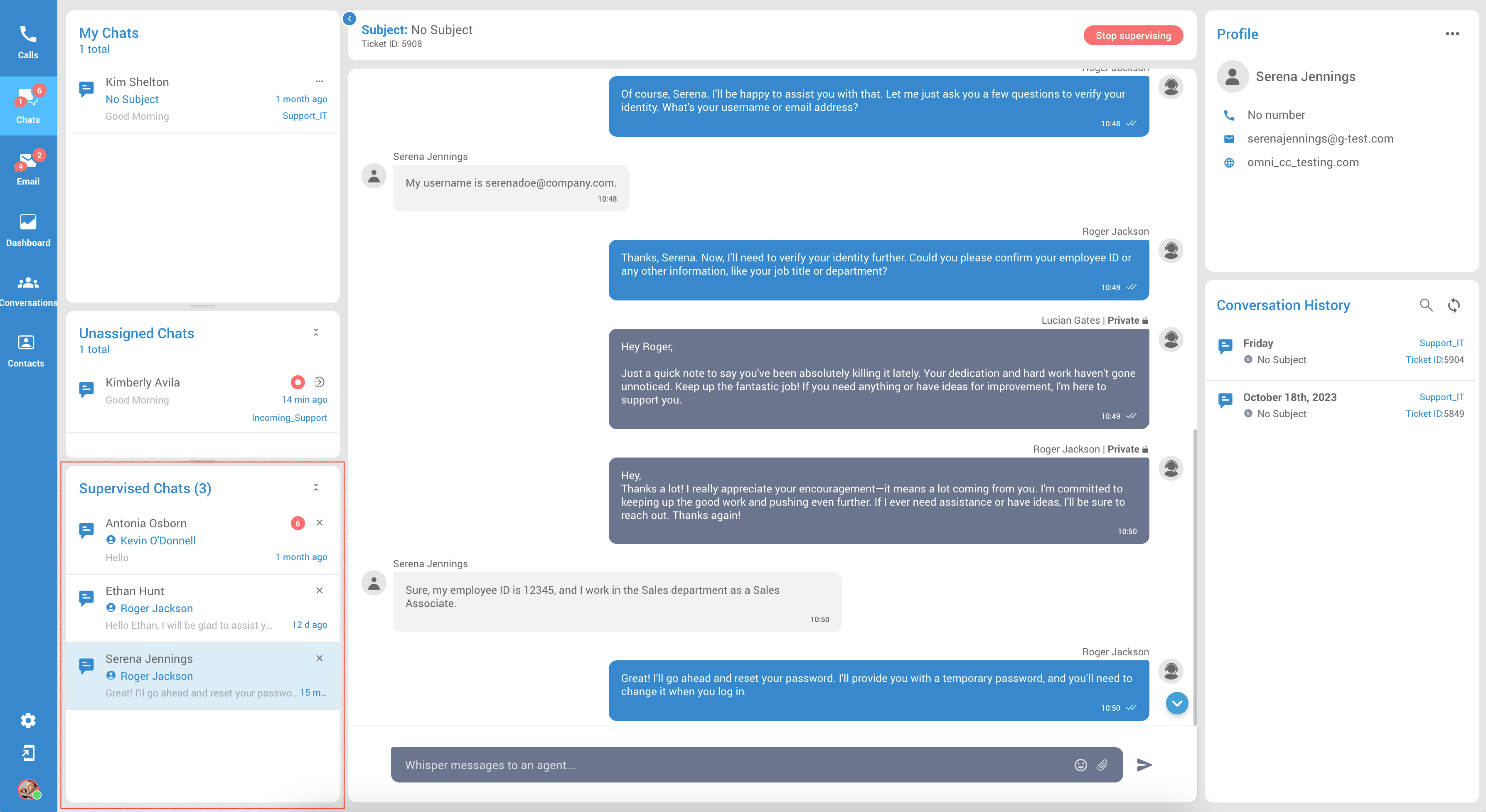
Following this step, the supervised chats become visible in a newly introduced segment. It will appear below the "Unassigned Chats" section.
The supervising can serve various purposes:
Quality Assurance: Supervisors can assess the quality of customer interactions to ensure that agents stick to company policies and provide high-quality customer service.
Training and Coaching: Supervised chat allows supervisors to provide real-time guidance and feedback to agents. They can offer suggestions, answer questions, and help agents handle complex or challenging customer inquiries more effectively.
Compliance and Regulatory Requirements: In some industries, strict regulations or compliance requirements regarding customer interactions may exist. Supervised chat can help agents follow these rules and guidelines to avoid legal and regulatory issues.
Conflict Resolution: If a chat conversation escalates into a dispute or conflict, a supervisor can intervene to mediate and attempt to reach a resolution that satisfies the customer. This can be especially important in preventing customer dissatisfaction.
Emergency Situations: In cases of emergencies or urgent customer requests, supervisors can quickly assess the situation and provide guidance to agents on how to respond appropriately
¶ Supervisor Dashboard
The supervisor dashboard closely resembles the agent's dashboard with the main distinction being the inclusion of an additional column named 'Daily Stats'. This column displays daily statistics for each agent or queue, providing enhanced monitoring and performance insights.
Please note that for the Daily Stats column to function correctly and display as intended, activation of the ClickHouse database is required.
¶ Agents
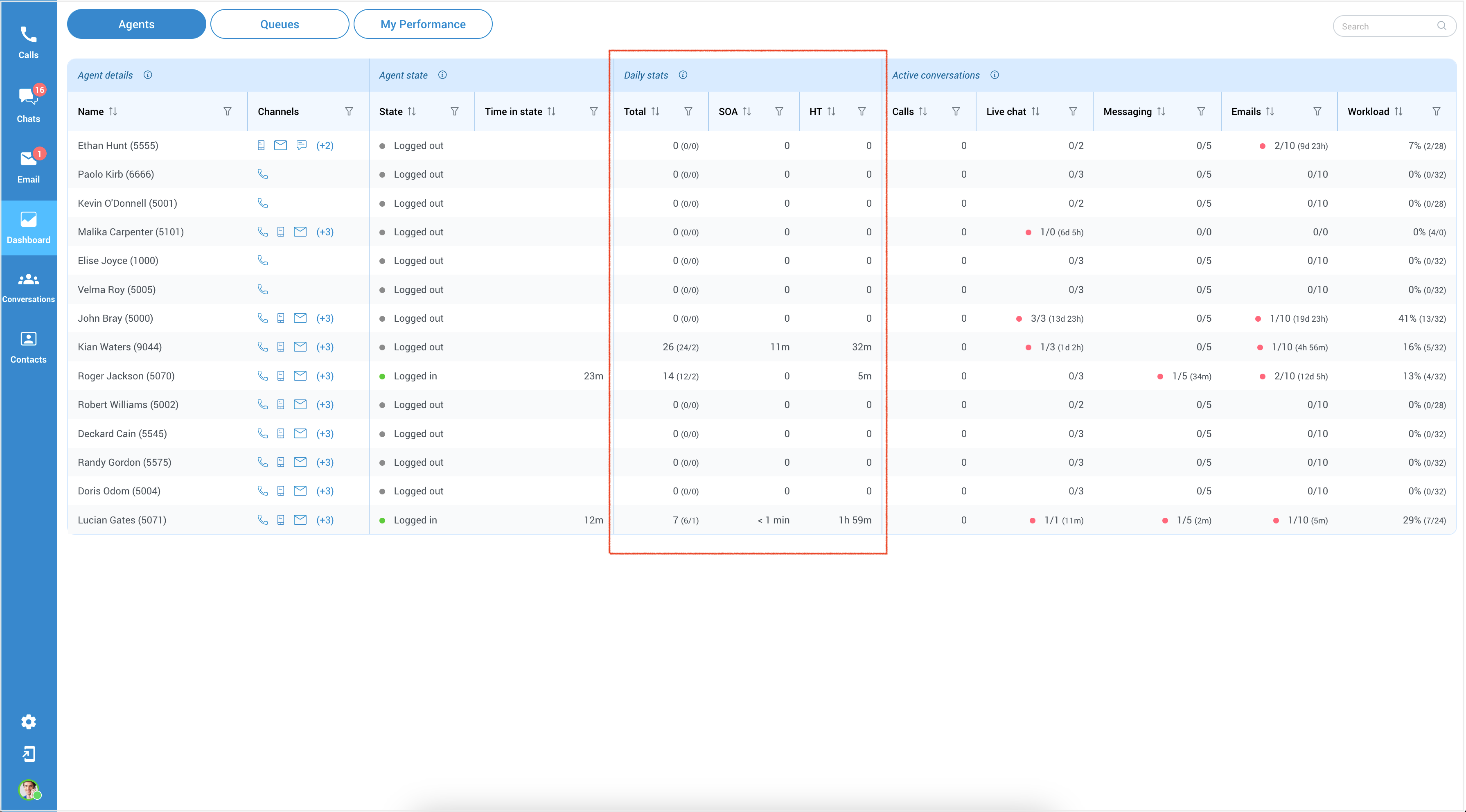
The Agents dashboard offers crucial insights into activities across diverse channels and conversations. When supervisors access this section, they gain information about their colleagues within the system, providing valuable insights for collaboration or supervision. Additionally, supervisors have access to a dedicated column displaying daily statistics for each agent.
Daily Stats
Refer to the data and information collected on a daily basis to measure agent's individual performance. This page consists of three sections:
-
Total (In/Out) - This metric indicates the current number of conversations assigned to a specific agent, distinguishing between inbound and outbound interactions. It provides an overview of the workload and responsibilities the agent is currently handling.
- [This metric works like a counter telling the supervisor how many conversations each agent is dealing with. It helps supervisors see the workload and what tasks or responsibilities each agent is currently managing.
So, an agent has a high number of conversations assigned to them. In that case, it means they're pretty busy handling customer inquiries or reaching out to customers, depending on whether the conversations are inbound or outbound. On the other hand, if an agent has a low number of conversations, they might have some spare capacity to take on more work or help out their colleague.]
- [This metric works like a counter telling the supervisor how many conversations each agent is dealing with. It helps supervisors see the workload and what tasks or responsibilities each agent is currently managing.
-
Average Speed of Answer (SOA) - The average speed of answer measures the average time it takes for an agent to respond to a call or conversation, encompassing the time spent waiting in a queue. It reflects the efficiency and responsiveness of the agent in addressing customer inquiries or issues promptly.
- [The "average speed of answer" is a way for companies to measure how quickly they respond to customers. It's like looking at the time it takes for an agent to pick up a customer's call or respond to a customer's messages, including the time a customer spends waiting in line or a queue.
If the average speed of answer is low, it means that, on average, customers don't have to wait very long to get assistance. That's a good thing because it shows that the company is efficient and responsive in promptly addressing customer questions or problems.
On the other hand, if the average speed of answer is high, it means customers often have to wait longer before someone helps them. This might indicate that the company needs to improve responsiveness to make customers happier.]
- [The "average speed of answer" is a way for companies to measure how quickly they respond to customers. It's like looking at the time it takes for an agent to pick up a customer's call or respond to a customer's messages, including the time a customer spends waiting in line or a queue.
-
Average Handling Time (HT) - The average handling time signifies the average duration an agent spends on each call or conversation. It encompasses the time spent actively engaging with the customer, addressing their needs, and providing necessary assistance.
- [The "average handling time" is like a stopwatch measuring how long the agent is actively engaged with the customer.
It includes all the time when the agent is actively helping the customer, like answering their questions, solving their issues, and ensuring they're satisfied.
So, if the average handling time is short, it means that, on average, the agent doesn't keep the customer on the phone or chat for too long. They efficiently handle the customer's needs, which is generally a good thing because it saves the customer's time.
But if the average handling time is long, it suggests that, on average, the customer might spend more time with the agent, which could sometimes mean longer conversations or problem-solving. While this can be necessary for some complex issues, companies often aim to keep this time as short as possible to provide quicker service.]
- [The "average handling time" is like a stopwatch measuring how long the agent is actively engaged with the customer.
¶ Queues
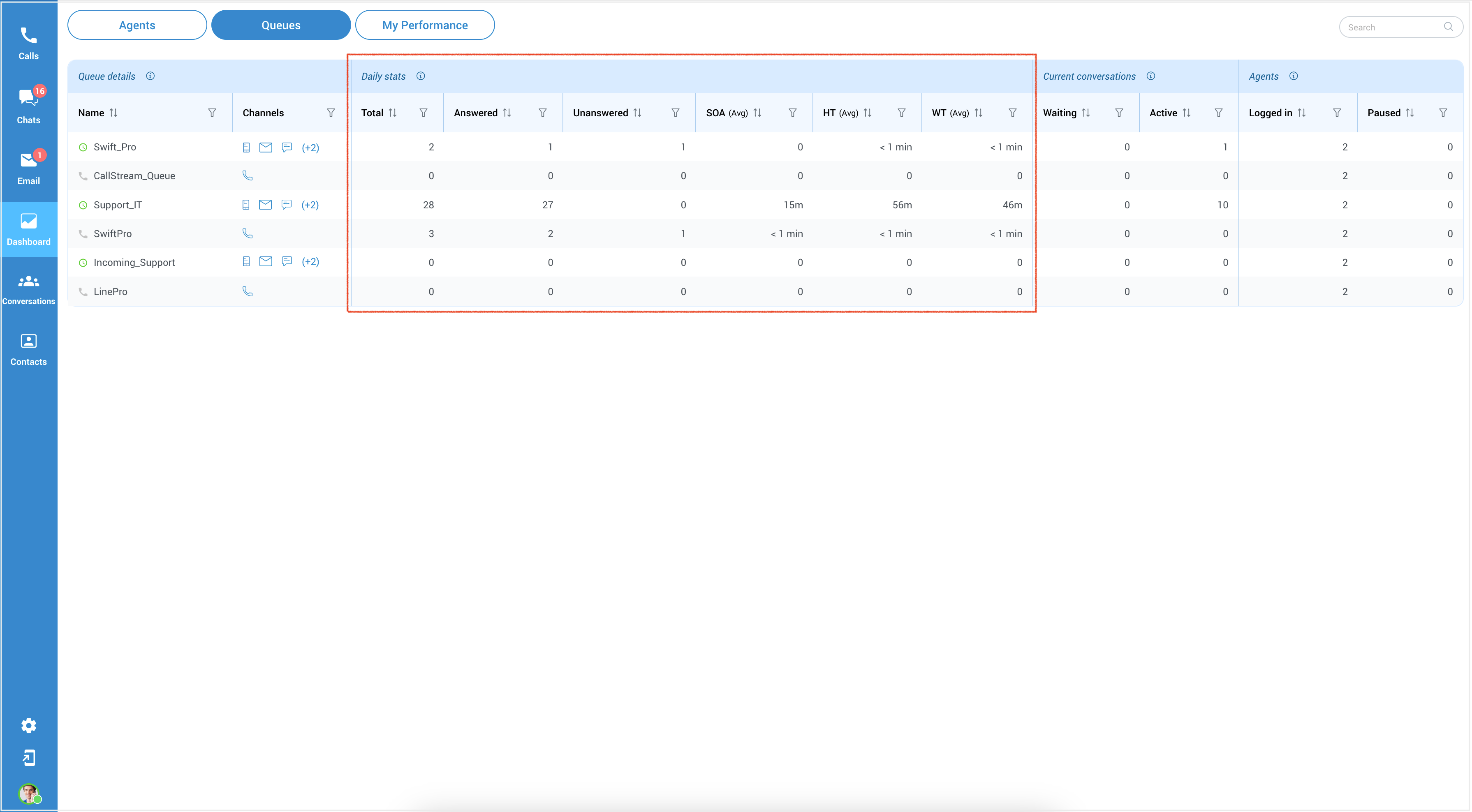
The Queues section provides a quick and convenient way to understand the activity and performance of the assigned queue, improving the ability to respond to customer inquiries efficiently. It offers insights into the queue requests actively handled by agents. Similar to the previous section, supervisors can access a dedicated column displaying daily statistics for each queue.
Daily Stats
These metrics are essential in analyzing call center performance, evaluating agent productivity, and optimizing customer service. Below there is a breakdown of the info displayed on this page:
- Total: Represents the overall count of conversations, indicating the total number of interactions.
- [The conversation count adds up all interactions, giving a supervisor a clear picture of the total number of customer conversations that have taken place. It's a precise way to keep track of the workload and activity of your support team or communication channels.]
- Answered: Represents the number of conversations that have been successfully addressed or responded to by agents.
- [Counts the number of interactions where the customer's needs were met, or the agents successfully addressed their issues. It's a way to measure how effective the support team is in providing solutions and resolving customer concerns.]
- Unanswered: Represents the number of conversations that have not yet been addressed or remain unresolved.
- [Counts the number of interactions where the agents have not fully addressed or resolved the customer's needs or issues. It's a way to measure the workload of unresolved matters that still require attention or resolution by the support team.]
- Average Speed of Answer (SOA): Represents the average time it takes for all agents in the queue to answer calls or conversations, including the time spent waiting in a queue. It helps measure the overall responsiveness of the support team.
- [The "average queue answer time" is like looking at a watch while waiting. It tells, on average, how long all support team members take to start talking to customers after customers have joined the waiting line. This includes the time customers spend waiting.
So, if the average queue answer time is low, it means that, on average, customers won't have to wait very long in line before someone from the support team starts helping them. That's good because it shows the support team quickly responds to customers' needs.
But if the average queue answer time is high, customers often have to wait a while before getting assistance. This might suggest that the support team needs to be more responsive and reduce waiting times.]
- [The "average queue answer time" is like looking at a watch while waiting. It tells, on average, how long all support team members take to start talking to customers after customers have joined the waiting line. This includes the time customers spend waiting.
- Average Handling Time (HT): Represents the average duration that all agents spend on calls or conversations, measuring the average time taken to handle customer inquiries or resolve issues.
- [It's a way to measure how long it takes agents to answer customer questions or solve their problems. This measurement includes the time spent actively talking to and helping the customer.
So, if the average handling time for agents is short, it means that, on average, these agents efficiently handle customer inquiries and resolve issues quickly. This is generally good because it shows that the agents are responsive and efficient.
However, if the average handling time for agents is long, it suggests that, on average, agents take more time on each call or conversation. While this could be necessary for complex issues, companies often aim to keep this time as short as possible to provide quicker service.]
- [It's a way to measure how long it takes agents to answer customer questions or solve their problems. This measurement includes the time spent actively talking to and helping the customer.
- Average Waiting Time (WT): Represents the average time that customers spend waiting in a queue before being connected with an agent or representative. It indicates the average waiting period for customers seeking assistance.
- [The "average queue wait time" tells, on average, how long customers have to wait in this virtual line before they can start talking to an agent who can help them.
So, if the average queue wait time is short, it means that, on average, customers don't have to wait for a long time before they get to speak with someone who can assist them. That's good because it means quick access to help.
On the other hand, if the average queue wait time is long, it suggests that, on average, customers have to wait for a while before they can connect with an agent. This might indicate that the company needs to improve its response time to reduce waiting times.]
- [The "average queue wait time" tells, on average, how long customers have to wait in this virtual line before they can start talking to an agent who can help them.
¶ Conversations Active

The Active Conversations section enables supervisors to efficiently monitor ongoing and queued conversations within the system. Here, supervisors can perform various actions such as transferring, supervising, or managing conversations as needed.
Available Actions
These features can enhance the functionality and effectiveness of the call center environment, enabling supervisors to streamline operations, ensure quality service delivery, and optimize customer experiences. Following options are:
-
Transfer: This feature allows supervisor to transfer a conversation from their queue to another agent or a different queue within the call center. It enables efficient collaboration and ensures that conversations are appropriately directed to the most suitable resources.
[Example: A customer calls in with a complex technical issue regarding internet service. The customer has already been talking to Agent A for a few minutes, but the issue is beyond Agent A's expertise. The supervisor realizes that the customer's problem requires specialized technical knowledge that Agent B, who is an expert in internet service troubleshooting, possesses. So, the supervisor decided to use the transfer feature to resolve the customer's issue promptly.]
-
Take over: As a supervisor, this feature enables you to take over conversations that are being handled by agents. By doing so, you can provide assistance, guidance, or intervene in critical situations to ensure smooth customer interactions and maintain service quality.
[Example: As the supervisor monitors the conversation between an agent and a customer, the supervisor may notice that the customer's frustration is escalating and the customer is becoming increasingly dissatisfied with the service. It's clear that the agent is having difficulty resolving the issue, and the customer's dissatisfaction may lead to a negative customer experience. To ensure a smoother customer interaction, the supervisor takes over the conversation with the customer.]
-
Close: When a conversation is deemed complete or resolved, supervisors can use the "Close" feature to mark the conversation as finished. It helps maintain an organized workflow and allows agents to focus on ongoing and new customer interactions.
-
Supervise: This functionality allows supervisors to monitor conversations between agents and customers. By supervising ongoing conversations, supervisors can assess agent performance, provide real-time coaching, and ensure adherence to quality standards.
-
GoTo: This functionality allows supervisors to switch directly to a particular conversations.
¶ Conversations Completed
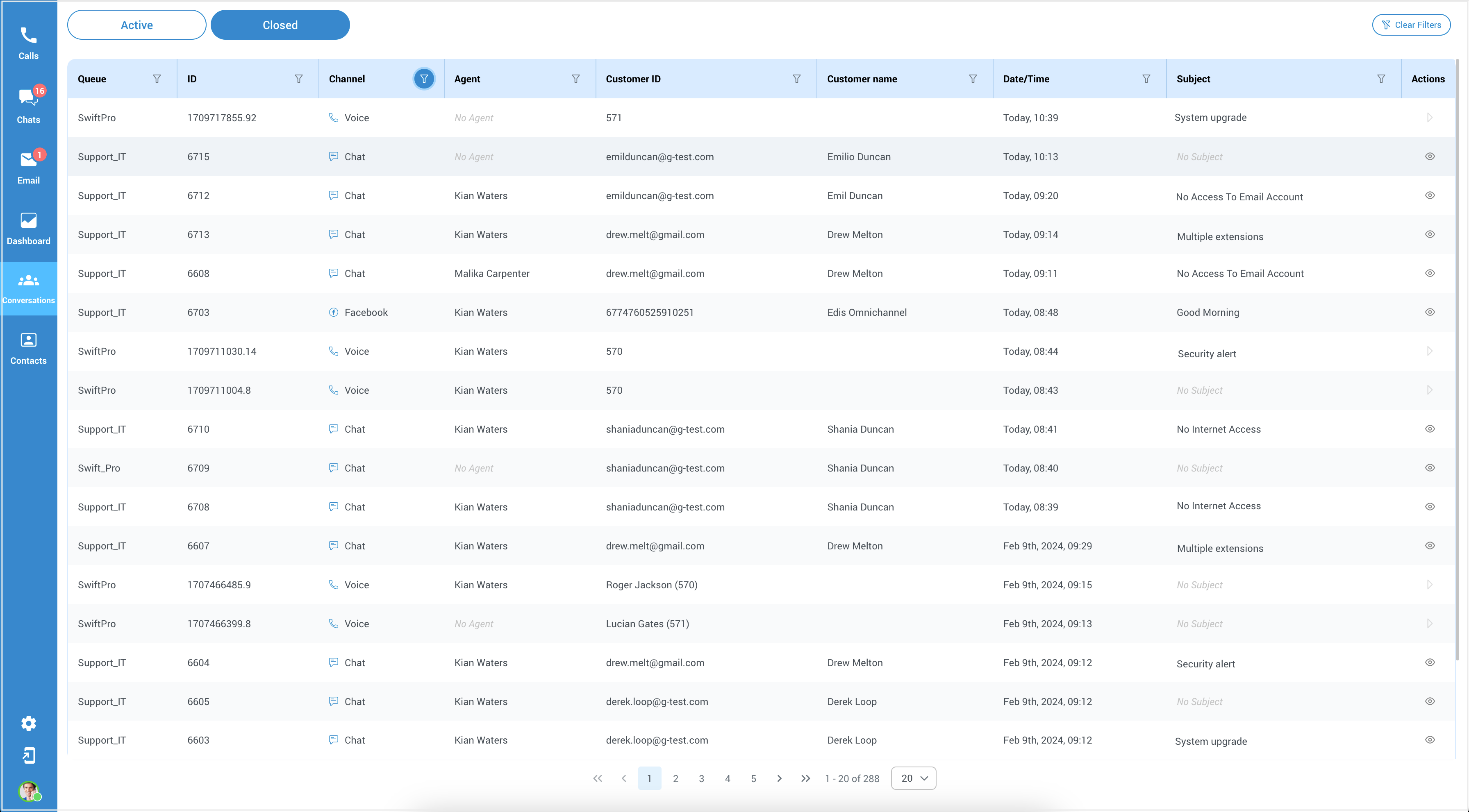
This section conveniently presents all closed conversations containing chats, emails, and voice interactions for review and reference.
Actions available
![]() Show conversation - access and review the historical record of the closed conversation.
Show conversation - access and review the historical record of the closed conversation.
![]() Play record - playback and listen to the recorded content of past voice interactions.
Play record - playback and listen to the recorded content of past voice interactions.
You can access all closed conversations and played records in the supervisor edition. If logged in as an agent, you can only view the conversations and records you were directly engaged with.
¶ Supervisor - Contacts Directory
¶ Uploading Contacts via CSV

To start uploading contacts using a CSV file, go to the Contacts tab within the Agent panel. This is where you'll initiate the process of adding contacts from your CSV file into the system.
In the upper right corner, you will find three buttons: Import File, View Files, and Create New Contact.
¶ Importing CSV File

To upload contacts via a .CSV file, follow these steps:
- Click on the Import File option. This will open a new window.
- Next, click on Attach File and select the .CSV file you want to upload.
- Once you've chosen the file, click the Upload button to commence the process of importing contacts.
Below are the instructions on how to format your CSV file for contacts upload.
After uploading the file, you can quickly review the changes made by your CSV file. Click on View Files to access the upload status, which includes details such as Total rows, New entries, Failed uploads, and Updates.
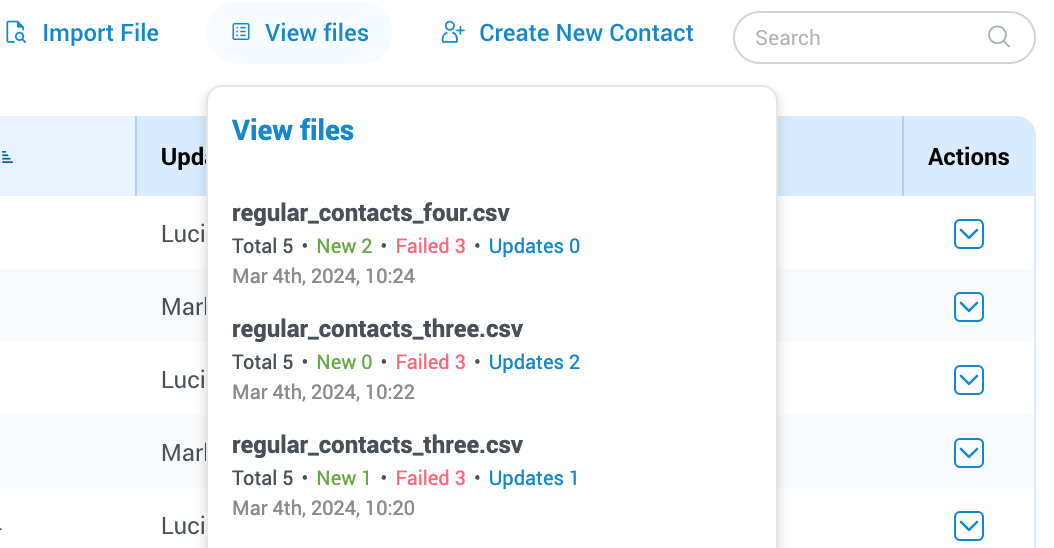
Additionally, you can view the timestamp indicating when the file was uploaded.
If needed, you have the option to cancel the synchronization process. Upon cancellation, you'll receive confirmation that the sync has been terminated.
¶ Create a CSV File
When preparing your CSV file for contact upload, it's essential to include specific headers to ensure the CSV upload works correctly. Here are the required headers:
name,last_name,company,contact_type,phone,phone_label,email,email_label,fbUserId,notes
If any header is missing or misspelled in the CSV file, it will not be considered valid, and the process of uploading contacts will not work properly.
Most headers are self-explanatory, but some may have attributes that require correct formatting:
name: Enter the contact's first name.(Required)
last_name: Enter the contact's last name. (Required)
contact_type: Choose between contact and lead.(Required)
company: Enter company's name. (This filed is optional)
phone: Enter the contact's phone number. (This field is optional but recommended)
phone_label: Define the type of phone number. (Possible options to enter: mobile, work, home, fax and other)
email: Enter the contact's email address. (This field is optional but recommended)
email_label: Define the type of email. (Available options to enter: private, business and other)
fbUserId: If applicable, enter the contact's Facebook user ID.
notes: Additional information or notes about the contact.
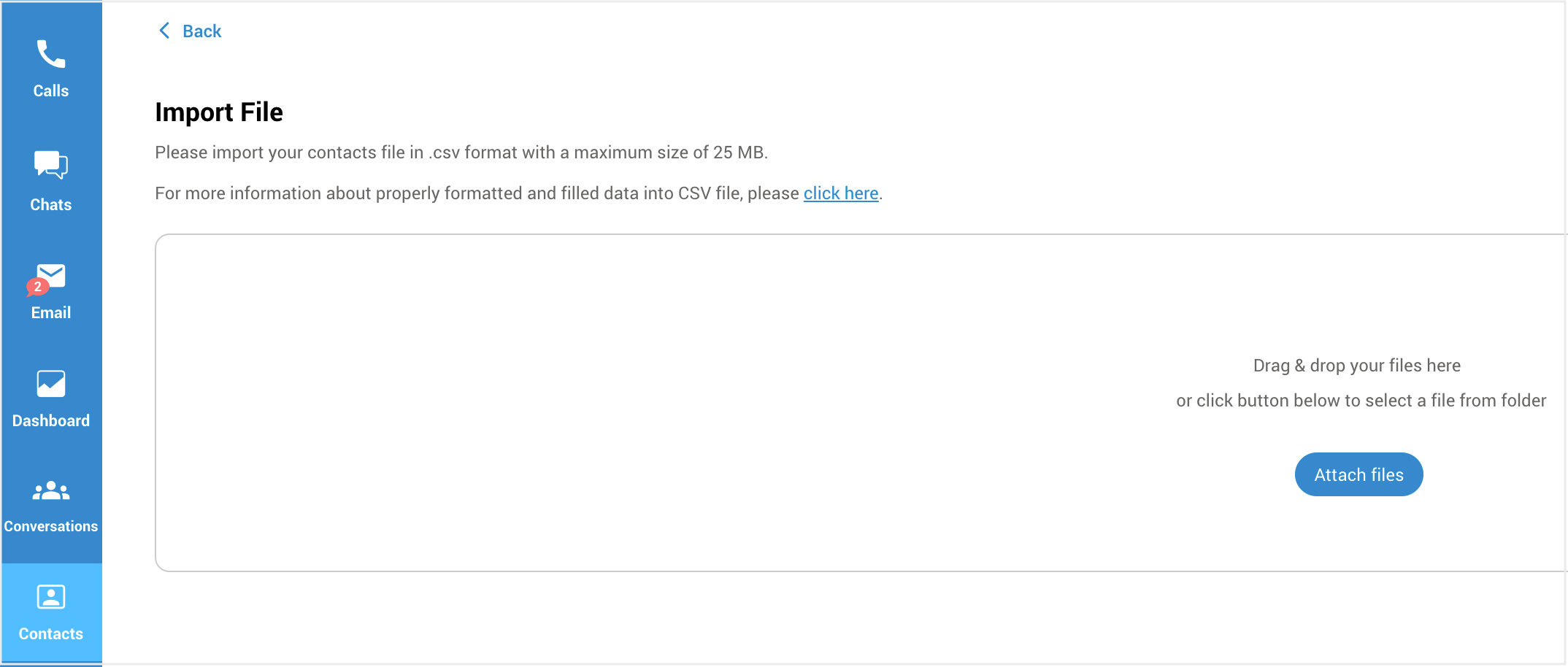
You can also access this information by clicking on the link provided within the attachment page.
Please note that the maximum file size for uploading a CSV file is 25 MB.
Below is an example of a correctly formatted CSV file:
name,last_name,company,contact_type,phone,phone_label,email,email_label,fbUserId,notes
Derek,Docker,TechCorporation,lead,+123456789,mobile,derek.dockere@acmecorp.com,business,fb12345,Interested in whole product line
Kimy,Anderson,InnovaSolutions,lead,+987654321,work,kim.anders@innovatech.com,other,fb33333,Lean towards producs C and D
¶ Merge Contacts
Contact merging is a feature that enables the consolidation of multiple contact records into a unified entity. This process streamlines and organizes contact information by merging redundant or duplicate entries, resulting in a single comprehensive record.
By merging contacts, users can avoid clutter and confusion in their contact lists, ensuring efficiency and accuracy in managing and accessing important contact details.
Here are the steps to efficiently merge your contacts:

- Navigate to your Contacts list.
- Find the contact you want to serve as the primary for the merge.
- In the Actions column next to your selected contact, click the dropdown menu, and choose the Merge option.
- Once you initiate the merge, you'll be directed to the Merge Contacts screen. Here, the page title will read: "Merge Contacts - Please select the information you wish to retain; details from the other contact will be replaced."
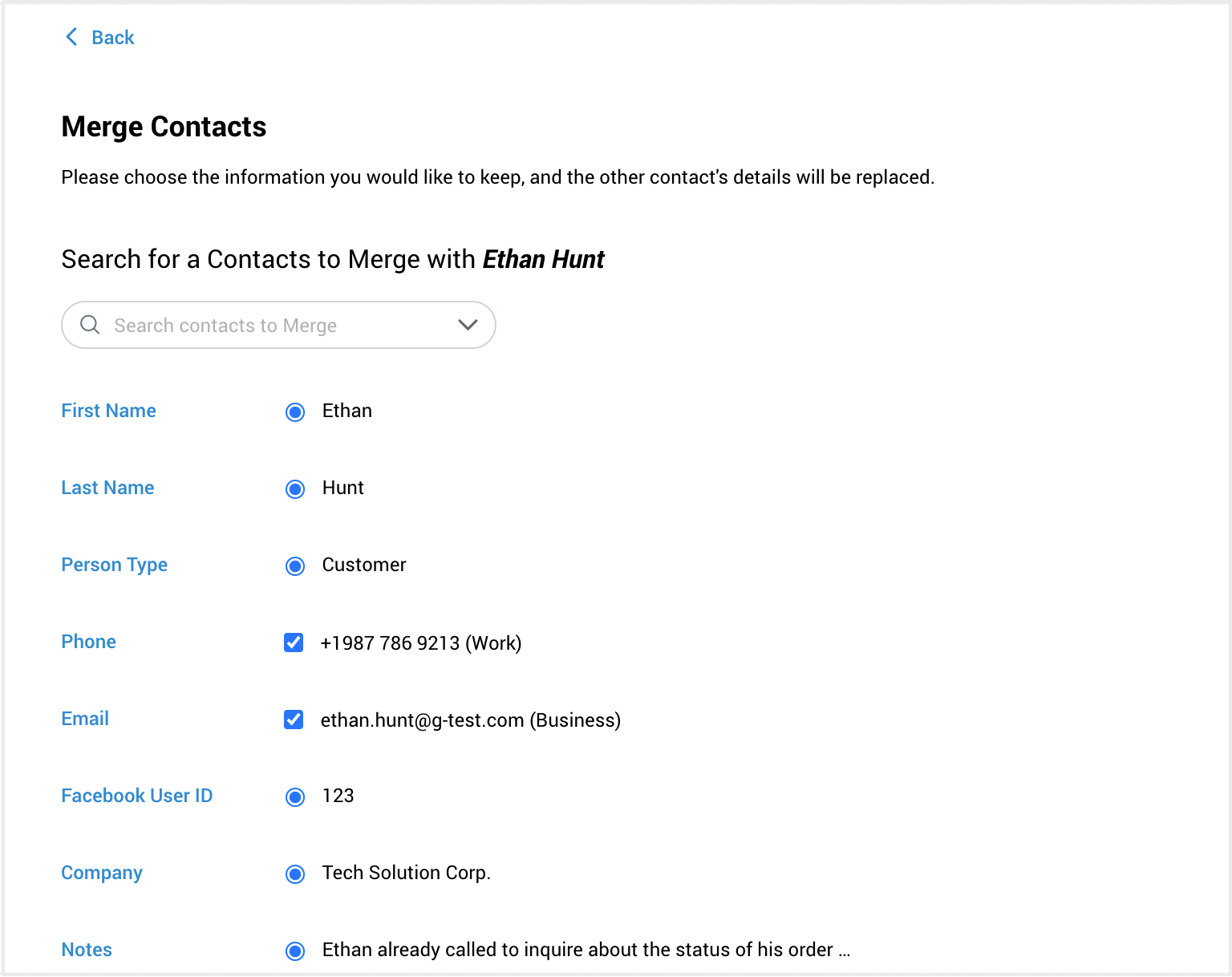
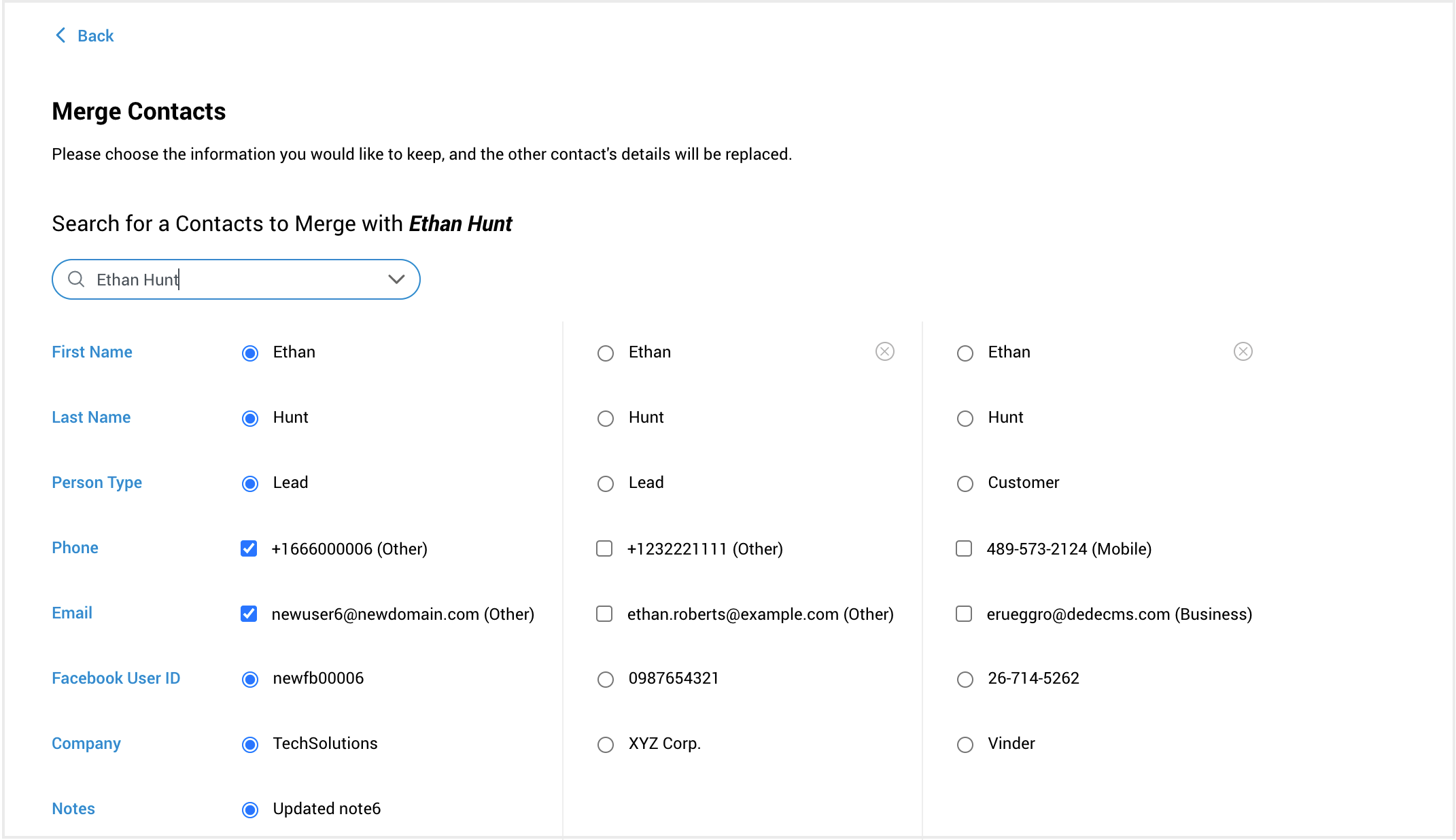
- To merge contacts, begin by searching for them using their names and surnames. Next, utilize the dropdown menu to choose another contact for merging with the initial one.
When merging contacts, you can select multiple phone numbers or emails (checkboxes), but only one option each for fields like name, last name, person type, ect. (radio buttons). Use radio buttons to indicate which information you want to retain. After merging, the selected information will be displayed in the Contacts directory.
Once you've made your selections, click Merge. A confirmation alert will appear: "Are you sure you want to merge these contacts? Merging is a one-time action and cannot be undone. Ensure you have selected the correct details to keep, as the original contacts will be permanently updated.
¶ Delete Contacts

Supervisors have an additional option compared to Agents: the ability to delete contacts. Within the Contacts directory, supervisors can select a desired contact and access the 'Action' options. From the dropdown menu, they can choose the 'Delete' option to remove the contact from the directory. It's important to note that there is no option to undo this action once it's completed.
¶ Supervisor - WhatsApp Templates
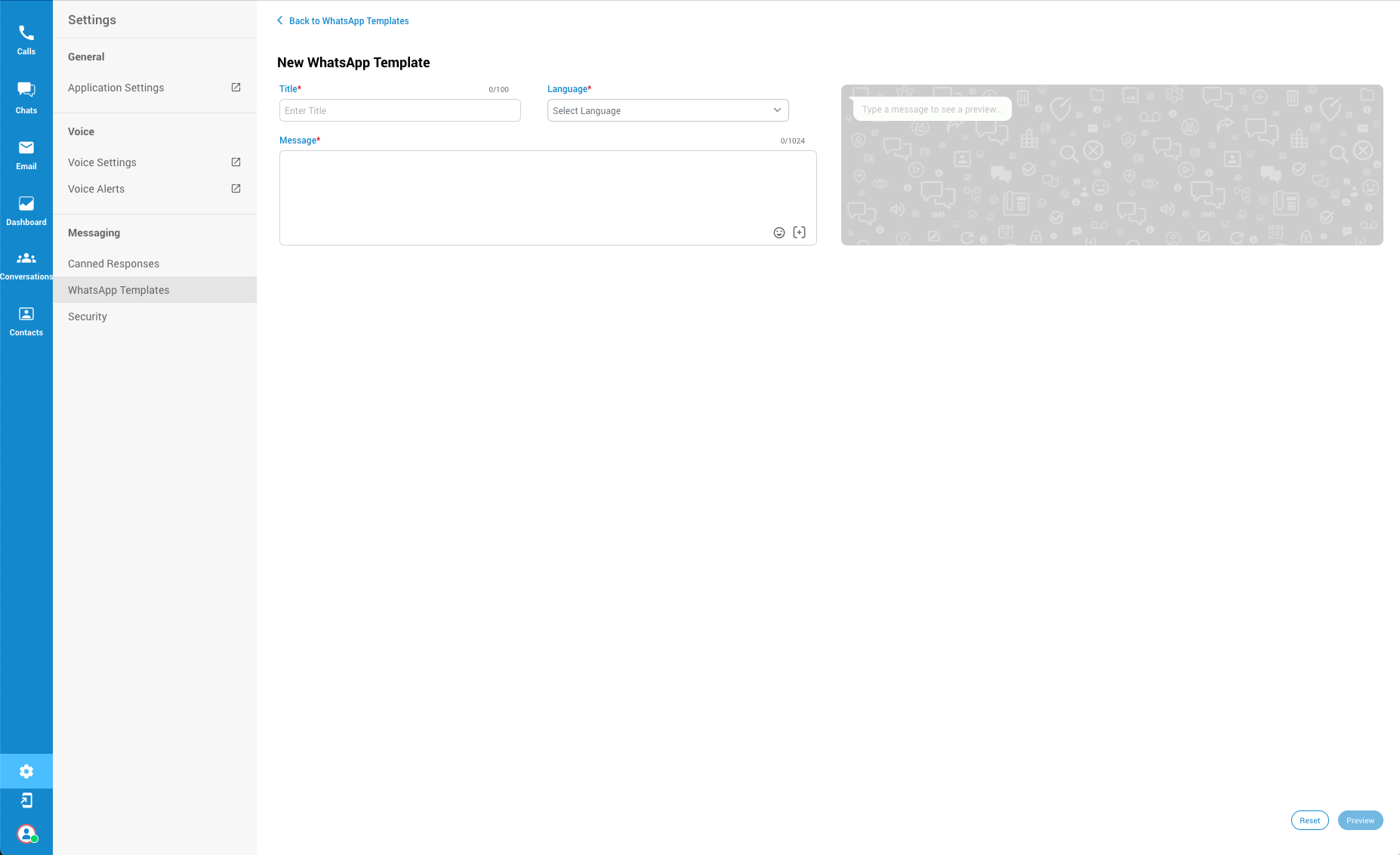
Creating a new WhatsApp template in the gloCOM Agent Panel is a straightforward process designed to facilitate efficient and compliant communication. Follow the steps below to create a template.
¶ Accessing the New Template Screen
- Click the New Template button located in the upper right corner of the WhatsApp Templates panel. This action will bring you to a new screen dedicated to creating a template.
¶ Filling Out the Template Details
¶ Title
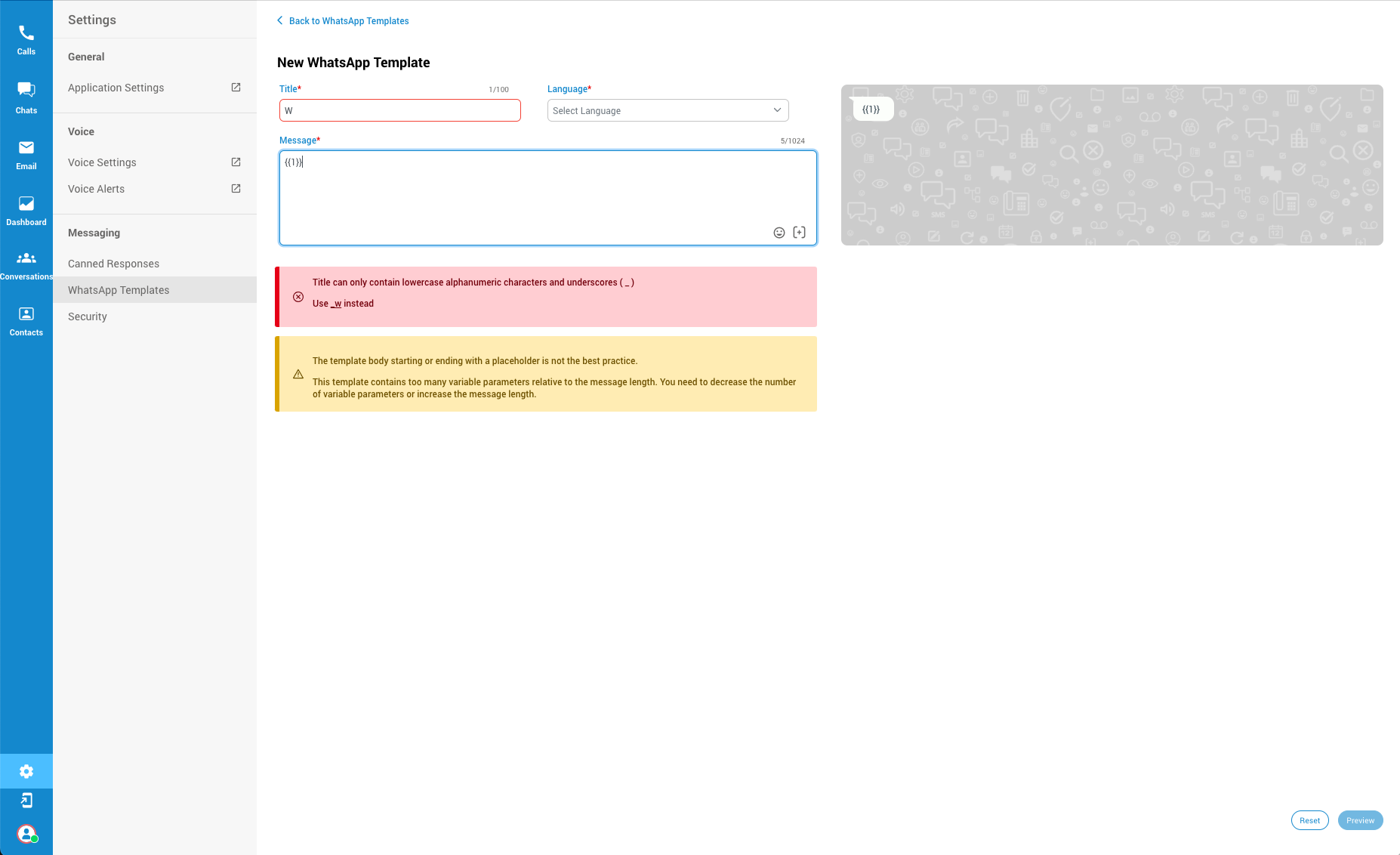
- Input Requirements: The title of the template must adhere to a specific format, utilizing only lowercase letters and underscores (e.g.,
example_template_one). If the title is input in any other format, a warning message will appear:
"Title can only contain lowercase alphanumeric characters and underscores."
¶ Language
- Selection: Choose the template's language from the dropdown menu. Currently available languages include English, German, Spanish, French, Italian, and Portuguese.
¶ Message
- Content Creation: In the Message area, write the template text. The text can include variables for dynamic content. However, starting or ending the template with a variable is discouraged. If the template does not adhere to best practices, such as beginning with a variable or containing too many variables relative to its length, an attention placeholder will appear with guidance:
The template body starting or ending with a placeholder is not the best practice. This template contains too many variable parameters relative to the message length. You need to decrease the number of variable parameters or increase the message length."- Example Message:
Hello {{1}} and welcome to the {{2}} live chat.
- Example Message:
¶ Live Preview
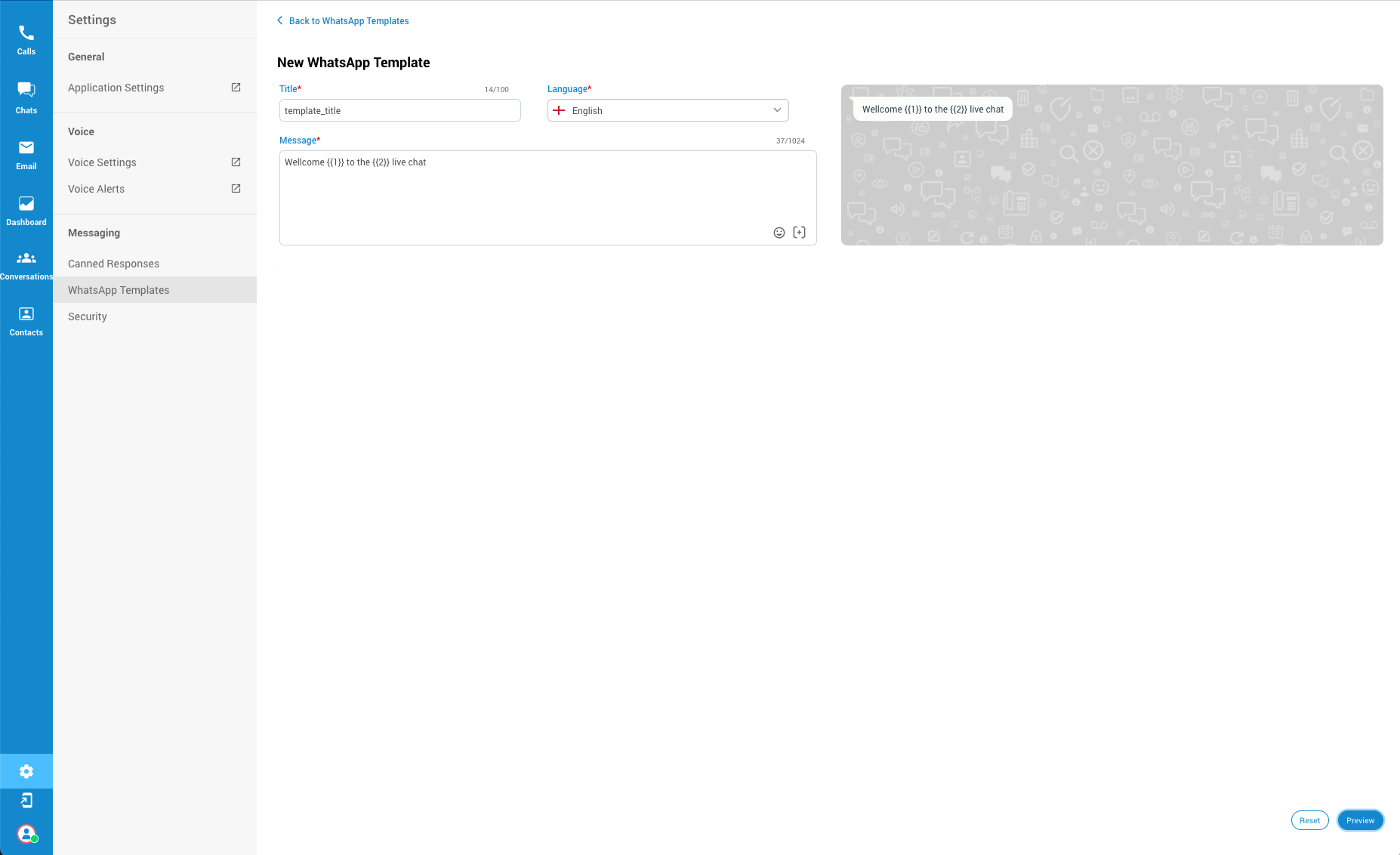
- As you input the Title, Message, and select the Language, a live preview of the template will be visible on the right side of the screen. This feature helps ensure the template appears as intended before submission. Please input the values in placeholders as these values will be sent to Meta for overall approval.
¶ Previewing and Submitting the Template
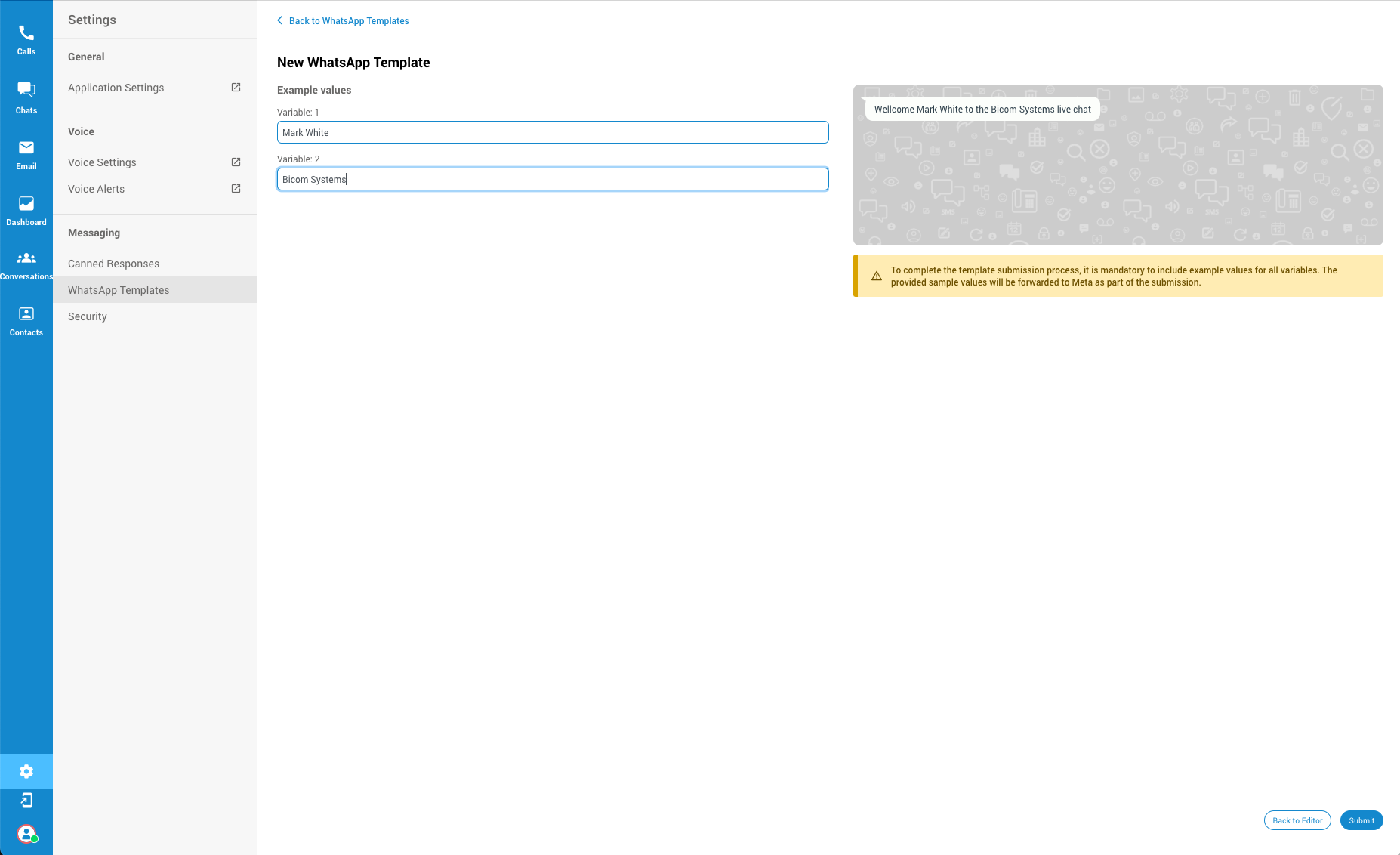
- Preview: After filling out the template details, press the Preview button to input variables into the text fields and see how the message will appear with the variables integrated.
- Submit: Once satisfied with the template, click the Submit button. If everything is in order, the template will enter the "Submitted" state and then, upon approval, the "Approved" state. If the template is not approved for any reason, a "Rejected" indicator will appear along with a message specifying the reason for rejection.
WhatsApp templates used within our Agent app require prior approval from WhatsApp before they can be used for outbound messaging. This process ensures compliance with WhatsApp's policies and enhances the reliability of our messaging service.
Steps for Approval:
Template Creation: Develop/create the WhatsApp message templates.
Submission for Approval: Submit the templates to WhatsApp for review and approval via the designated platform.
Approval Notification: Await confirmation of approval from WhatsApp before using the templates within the Agent app.
¶ Key Considerations for Template Creation
- Ensure the template title and content follow the specified guidelines to avoid rejections.
- Utilize the live preview feature to adjust the template before submission.
- Pay attention to feedback and warnings to refine the template as needed.
This process is designed to streamline the creation of WhatsApp templates, ensuring they meet both the company's and Meta's standards for approval.
¶ Supervisor - Canned Responses
Canned responses are predefined message templates utilized to promptly address customer inquiries. They ensure consistent and efficient communication across multiple channels, such as SMS, email, chat, Facebook, and WhatsApp.
¶ Location of Canned Responses

Canned responses are conveniently located within the Agent Panel Settings page, under the Messaging section. Upon navigating to this page, supervisors are greeted with a comprehensive list of preexisting canned responses. Users can easily browse through this list using the search bar provided, enabling them to search by either the name or content of the canned responses.
The list is structured into five columns:
- Title: Allows sorting by name.
- Canned Response: Facilitates sorting by content.
- Channels: Enables filtering by assigned channel(s).
- Language: Allows sorting by language. Available options include English, Deutsch, Español, Français, Italiano, and Português (Brasil).
- Actions: Provides options to View, Edit, and Delete a canned response.
Clicking the New Canned Response button opens a dialog for creating a new canned response.
¶ Creating a New Canned Response - Supervisor edition only
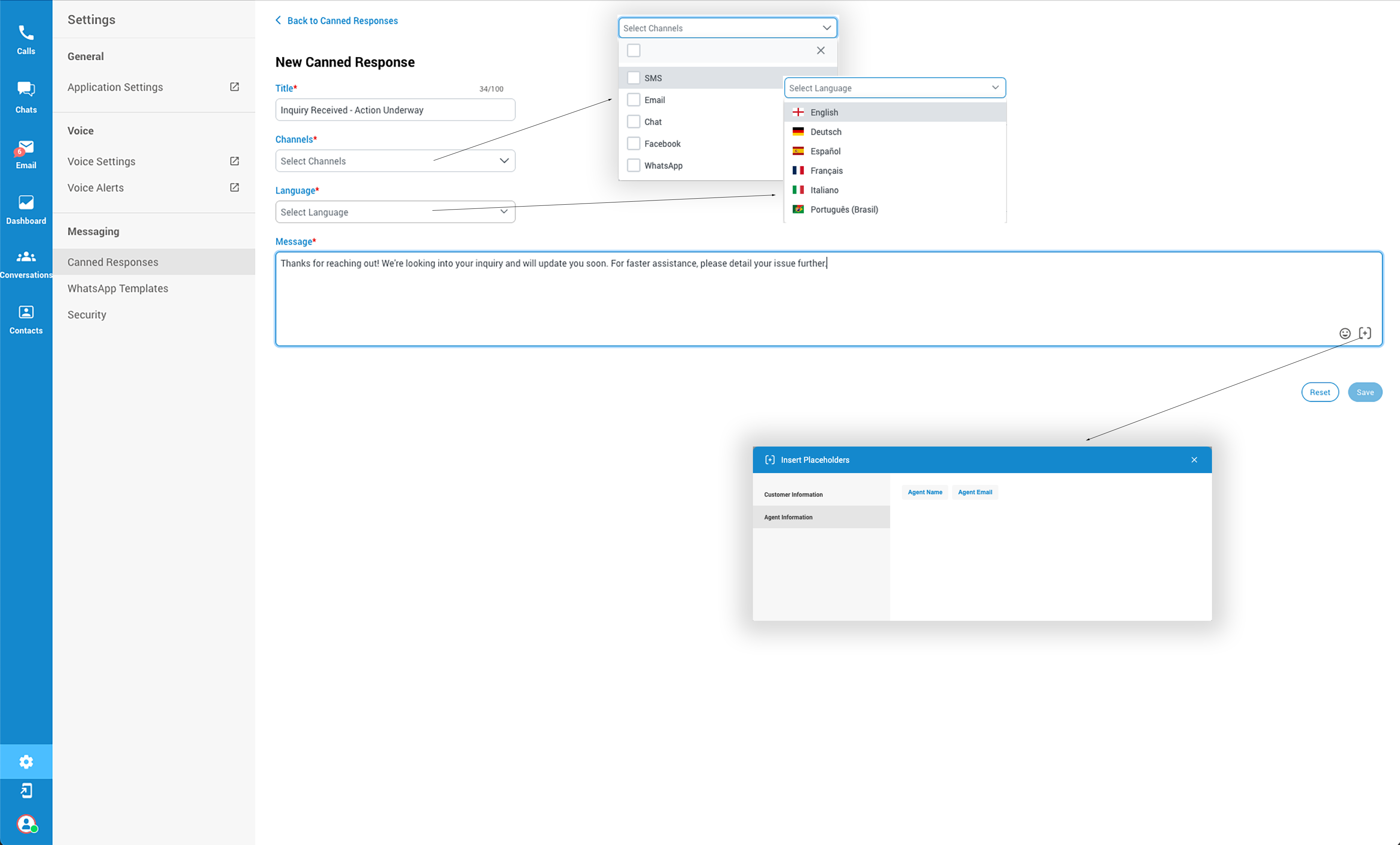
Within the Supervisor edition, you'll find a New Canned Response button located in the upper right corner. Clicking on this button will open a dialog where you can create a new canned response.
The process of creating a new canned response is straightforward:
- Enter the Title of the canned response.
- From the dropdown menu below, choose the channel(s) to which this canned response will be assigned.
- Select the language.
- Add the content of the canned response. Emojis and Placeholders (variables such as
{{CustomerEmail}},{{AgentName}}, and{{AgentEmail}}) can be included to personalize the messages. - Save the canned response to add it to the list.
The {{AgentName}} placeholder is like a blank space that gets filled with the actual name of the agent who is sending a message. For example, if the agent's name is "John," wherever you put {{AgentName}} in your message, it will automatically show "John" when John sends the message. It's a way to make messages feel more personal and tailored to the recipient.
Using canned responses to respond to customers is identical to using canned responses in the agent edition.
¶ Supervisor - Ban and Unban Customers
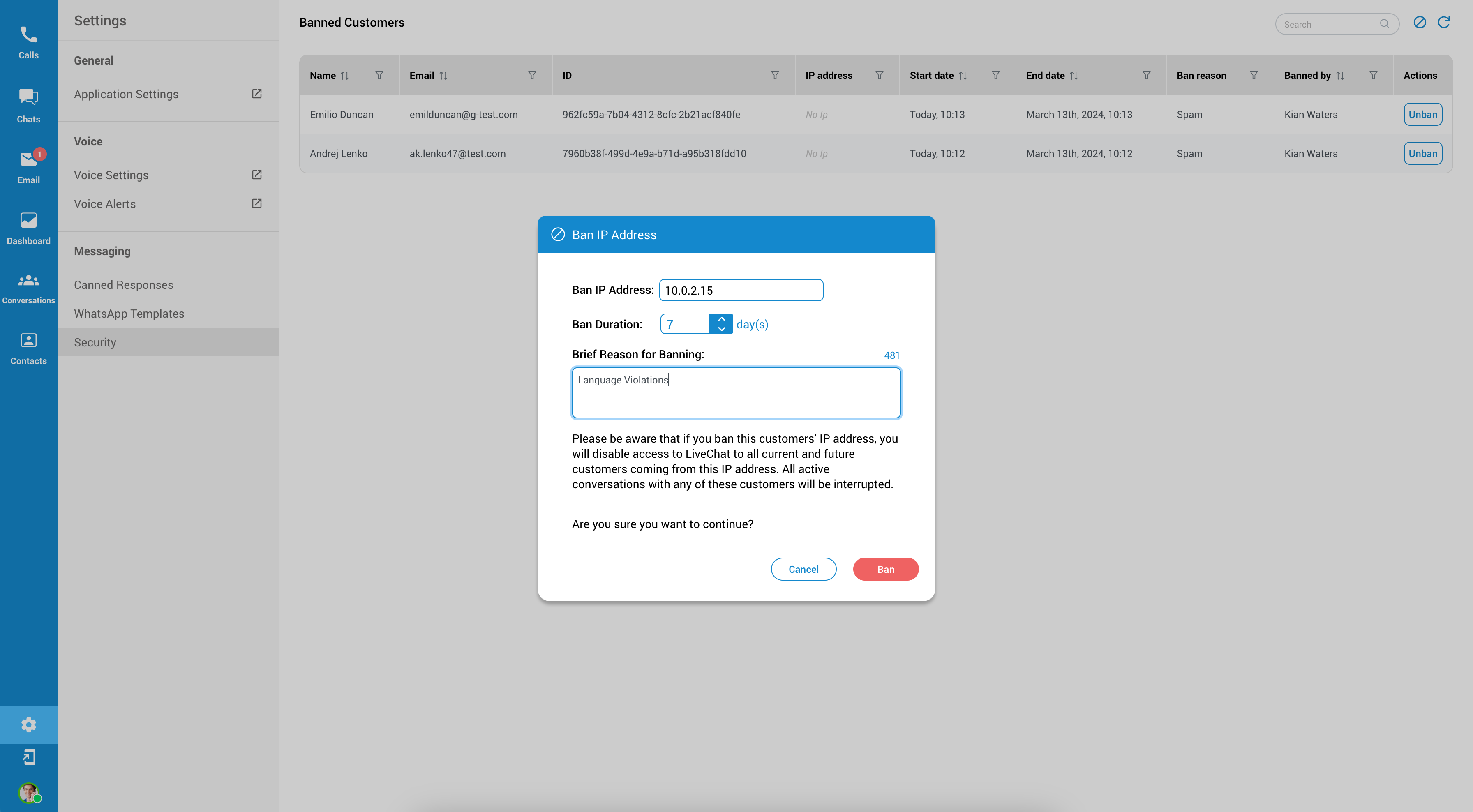
Supervisors in call centers possess the authority to both ban and unban customers. Still, this authority is generally limited to particular circumstances and is contingent upon adherence to the company's established policies and procedures. Unlike agents, supervisors have the capability to unban any customer previously banned, whereas agents can only unban customers they personally banned.
 Ban: Allows supervisors to impose a new ban on a customer.
Ban: Allows supervisors to impose a new ban on a customer.
 Unban: Permits the removal of a ban. Agents can unban customers they personally banned, while supervisors have the authority to unban any customer.
Unban: Permits the removal of a ban. Agents can unban customers they personally banned, while supervisors have the authority to unban any customer.
 Refresh - We highly recommend that users consistently utilize this button both before and after initiating the ban process. This practice ensures that the data in the table is displayed accurately and reliably.
Refresh - We highly recommend that users consistently utilize this button both before and after initiating the ban process. This practice ensures that the data in the table is displayed accurately and reliably.
Banning should be a measure of last resort, and companies should strive to provide opportunities for customers to address and fix issues that led to the ban whenever possible.
¶ Camera
- Surveillance Camera: Opens up a Surveillance Camera preview. This option will work only if you have your surveillance camera set up in the IP address in gloCOM Preferences --> Video --> Surveillance Camera.
¶ Online self care
In order to login to Online Self Care, point your browser to: http://$IPADDRESS/ (For Example: http://192.168.1.1/). When you click on the gloCOM OSC icon, you are automatically directed to your OSC page.
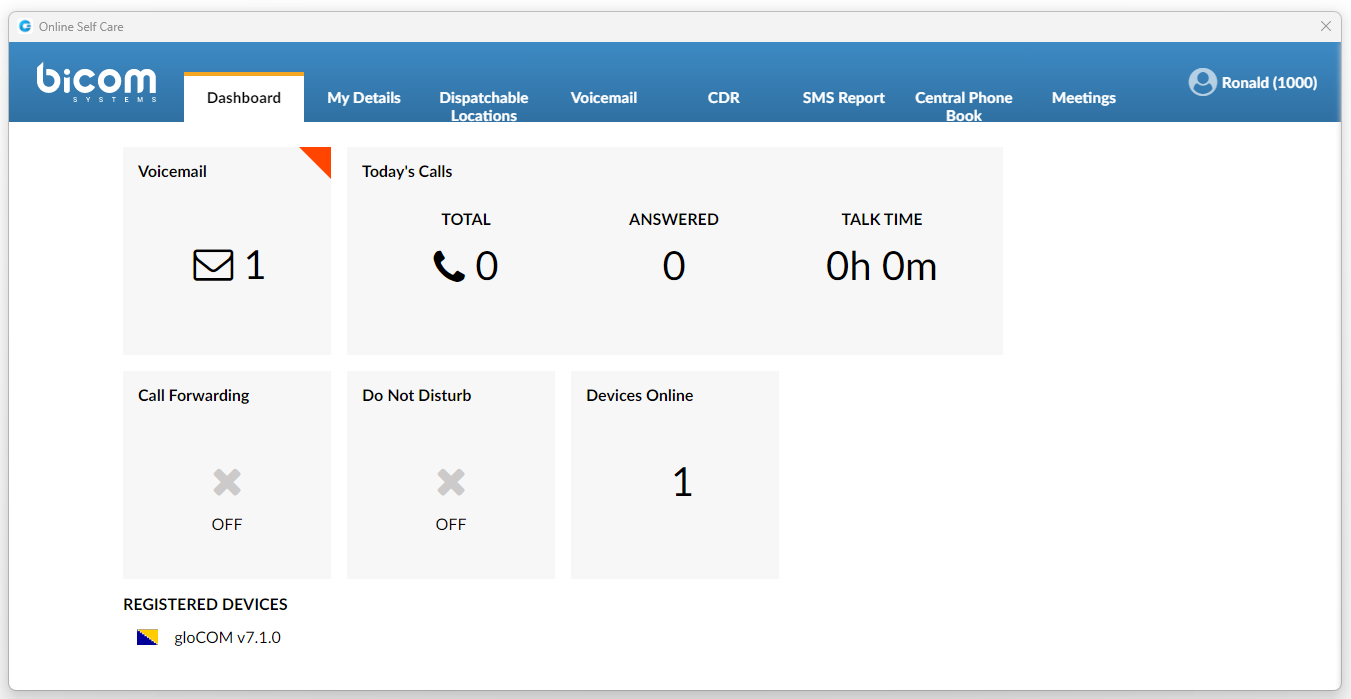
- Email: The email address assigned to the extension (ex. The provided email address is used as a username for logging into Online Self Care (e.g. email@example.com)), ([a-z] [0-9] [@_.-]).
- Password/PIN: The user password assigned to the extension (ex. This field accepts your gloCOM password (e.g.n9h*Caq1Icr)), ([0-9]).
¶ Options (3 dots) menu
Options menu can be accessed by clicking on the 3 dots icon on the far right of the module icons. This menu shows all the remaining modules besides the 6 modules visible in the main window, as well as a few additional options explained below.
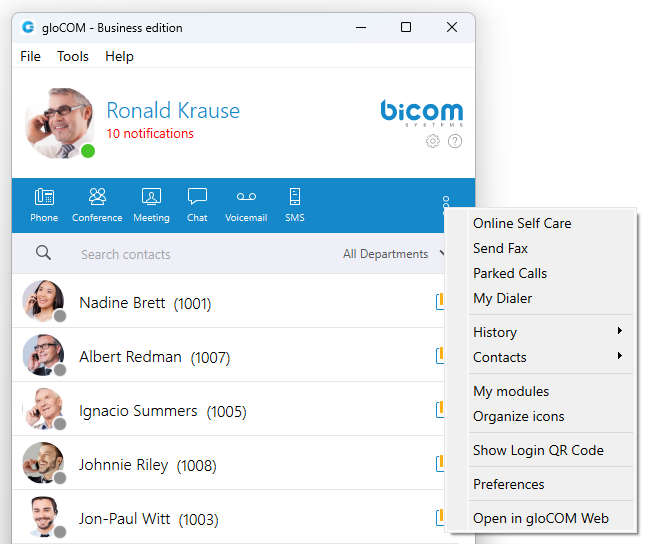
¶ History submenu
- Fax option is used for opening Fax History window which allows you to see all sent and received faxes.
- Clear Call History option is used to clear all your missed, received and dialled calls from the HISTORY tab.
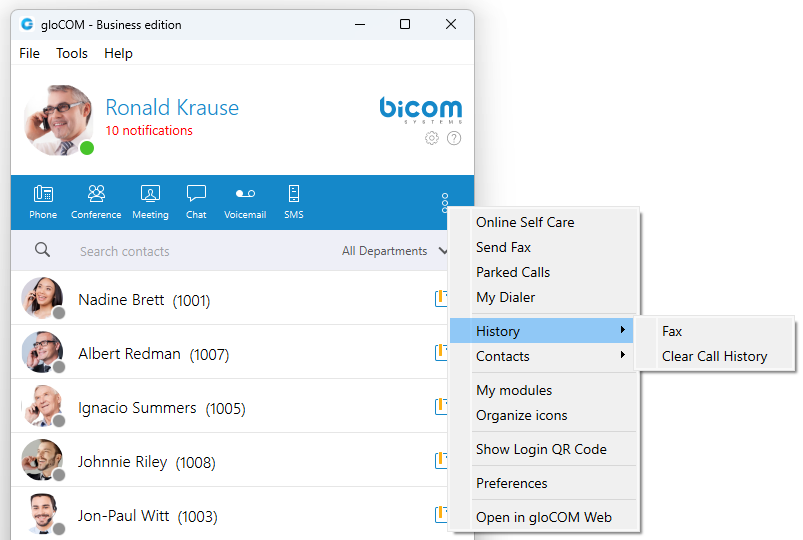
¶ Contacts submenu
- List view option is used to layout gloCOM users in a list.
- Grid view option is used to layout gloCOM users in a grid.
- Hide offline users option is used to hide all users that were not active for 8 hours or more.
- Display user numbers in list view option is used to show a user’s extension number in the parenthesis in the list view.
- Sort users by Online status option is used to sort gloCOM users according to their most recent activity.
- Sort users alphabetically option is used to sort gloCOM users according to the alphabetical order of their names.
- Refresh contacts option is used to sync Outlook (for Microsoft Windows), Address Book (for macOS), Google, CRM, and Central Phone Book contacts.
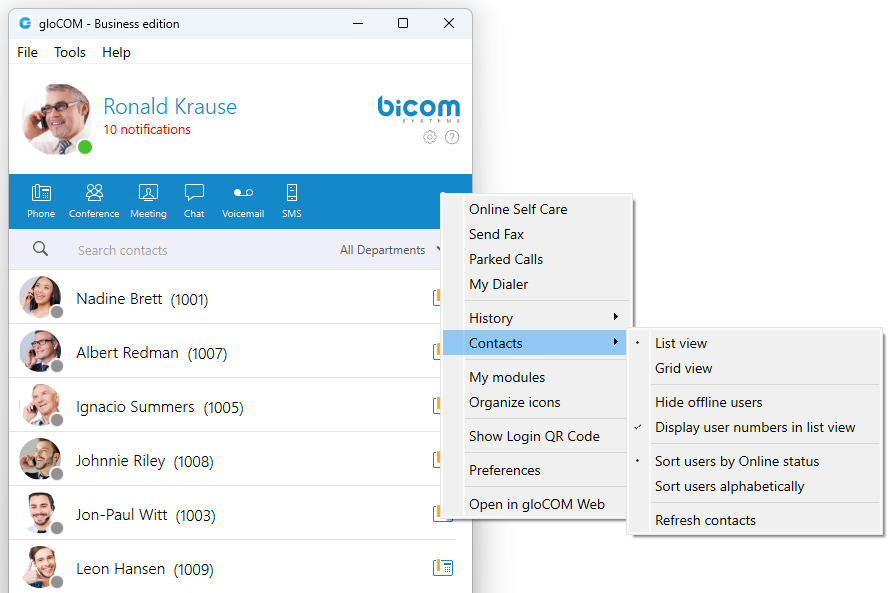
¶ Other options
- My modules option is used to quickly navigate to Modules section in the Preferences so you could see which modules are available to you, and to set up those modules.
- Organize icons option is used to personalize the module icons available in the main window. Note that the first icon has to be the Phone module, but you can rearrange the 5 other icons as it suits your needs.
- Show Login QR Code as a part of the gloCOM Desktop allows users easier login to their mobile app by scanning QR Code generated by the gloCOM Desktop app.
- Preferences option is used to open the Preferences window.
- Open in gloCOM Web option allows users access to the Web app through the Desktop app by selecting the "Open in gloCOM Web" option from the drop-down menu.
¶ Central Phone Book
Central Phone Book is a centralized list of contacts managed by the PBXware administrator. It is shared across all gloCOM users, and synced together with the rest of your contacts (Google, CRM, etc.). To access your Central Phone Book contacts navigate to the CONTACTS tab, and select CENTRAL PHONE BOOK from the dropdown.
You can use Search contact field to find a contact by their name. Double click on a contact to initiate a phone call. Right-click on a contact to open a context menu with additional options.
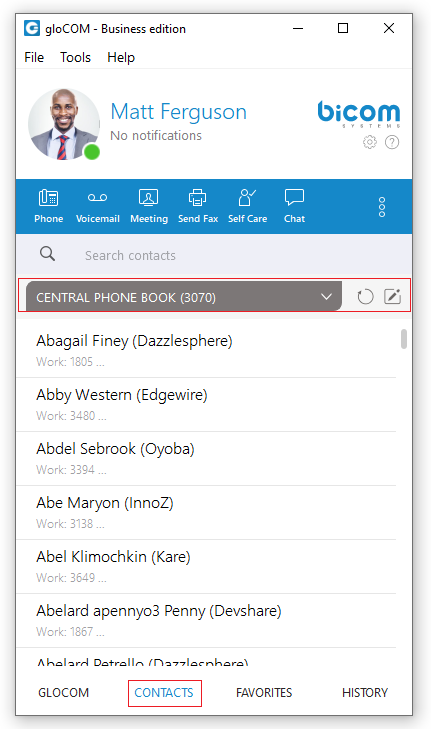
Besides contacts managed by the administrator, each user can manage his own personal list of contacts. This personal list is private and visible only to you. Clicking on the  button while in the CONTACTS tab opens up the Online Self Care window and switches to Phone Book tab. Here you can see all of your Personal Phone Book contacts, add new contacts, import/export contacts, or download a CSV template. To remove a contact click on the
button while in the CONTACTS tab opens up the Online Self Care window and switches to Phone Book tab. Here you can see all of your Personal Phone Book contacts, add new contacts, import/export contacts, or download a CSV template. To remove a contact click on the  button on the right side of each contact.
button on the right side of each contact.
After you close the Online Self Care window, the application will automatically refresh contacts if necessary, so the modifications you made in the Online Self Care are now synced inside of gloCOM.
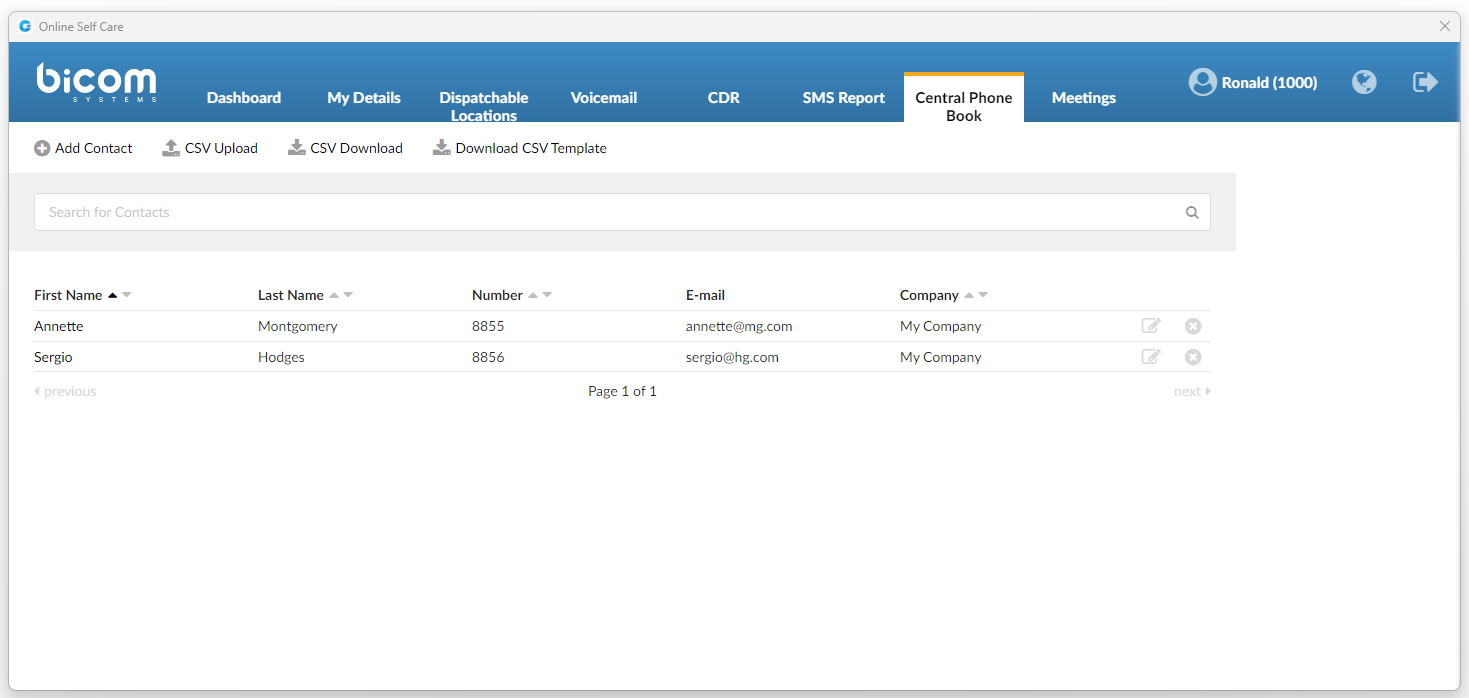
¶ Quick List
Quick list buttons enable a quick overview of gloCOM, Contacts, Favorites, and Recent tabs.

- gloCOM: Displays a list of all gloCOM contacts.
- Contacts: Displays a list of all saved and imported contacts.
- Favorites: Displays all contacts that you marked as a favorite.
- History: Displays log of all recent missed, received, and dialed.
¶ Menu
¶ File Menu
- Log Out: Click on Log Out to log out from active connection(s).
- Exit: Click on Exit button to log out from active connection(s) and close gloCOM application.
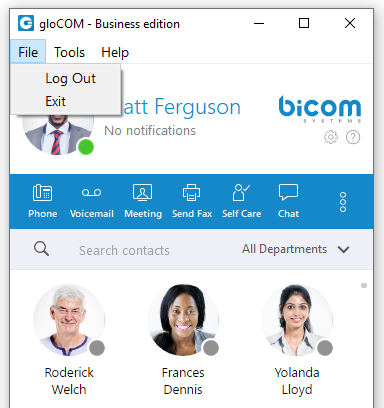
¶ Tools Menu
¶ Diagnostic Logs
Here you can see diagnostic logs with the level of verbosity that you have set in Preferences --> General --> Diagnostic Logs.
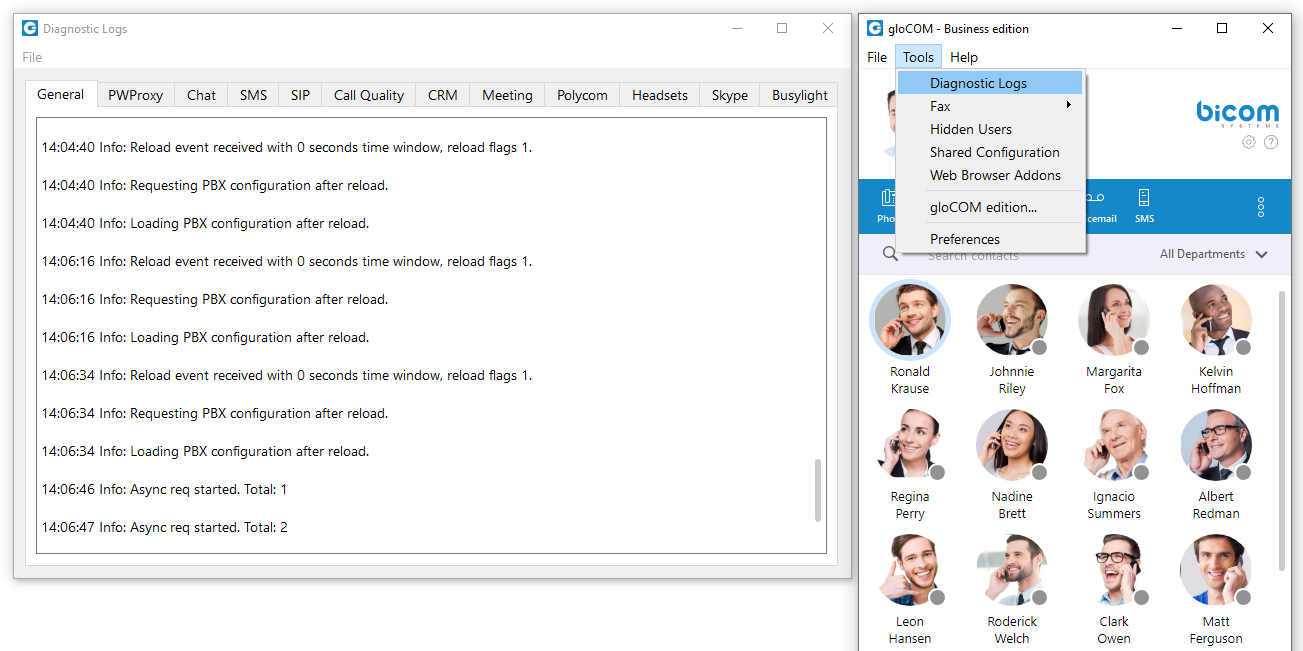
¶ Fax
- Add Fax Printer Automatically
- Add Fax Printer Manually
- Install Port Monitor
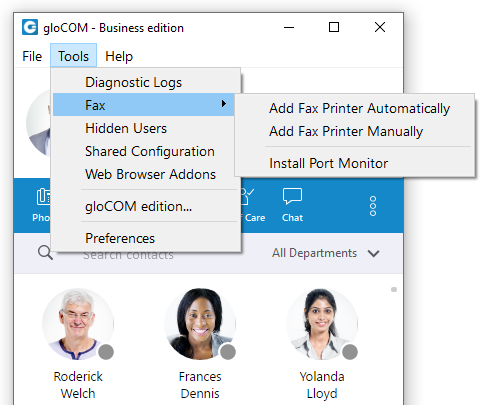
¶ Hidden Users
Opens a dialog showing all your hidden users. Uncheck the box next to a user's name if you want to unhide them.
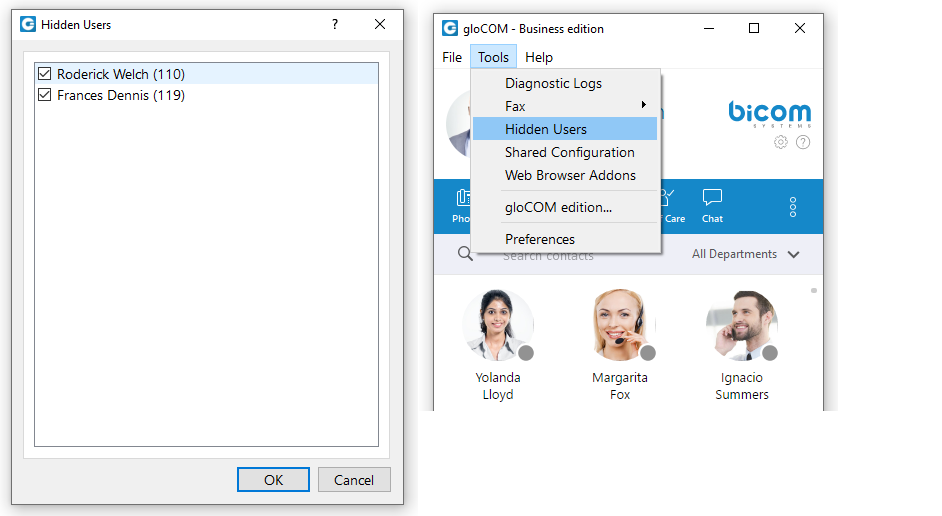
¶ Shared configuration
Enable:
By enabling shared configuration, all users on this computer will share the same Login account, phone mode, and edition.
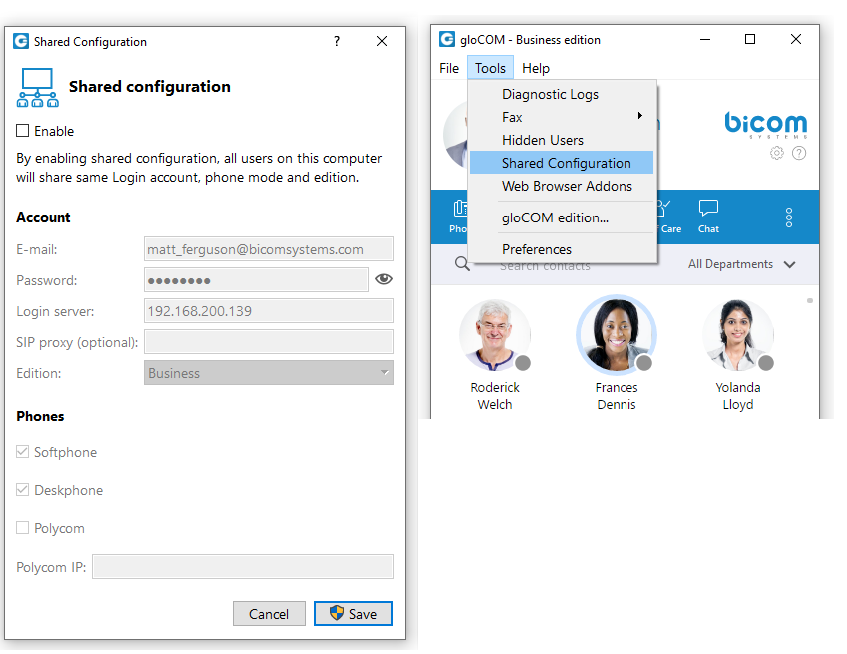
Account:
- E-mail: email address is displayed in this field.
- Password: in case the option Enable is unchecked, the password will be hidden. After you check the Enable option, the option Show Password will be functional.
- Login Server: Shows IP address of server.
- SIP proxy (optional): this field is optional.
- Edition: In this option select edition for your gloCOM. The current edition is displayed, but the possibility to choose between other editions is given.
Phones:
Choose which phones you want to use:
- Softphone: choose to use Softphone.
- Deskphone: choose to use Deskphone.
- Polycom: choose to use Polycom phone.
Polycom IP:
In case the user chose Polycom, in this option user needs to provide the IP address of the Polycom phone.
¶ Web browser add-ons...
Click on Download web browser add-ons to add the browser add-on which will allow the user to select and dial a phone number directly from a web page. Supported browsers: Internet Explorer, Firefox, Safari, Edge, and Chrome.
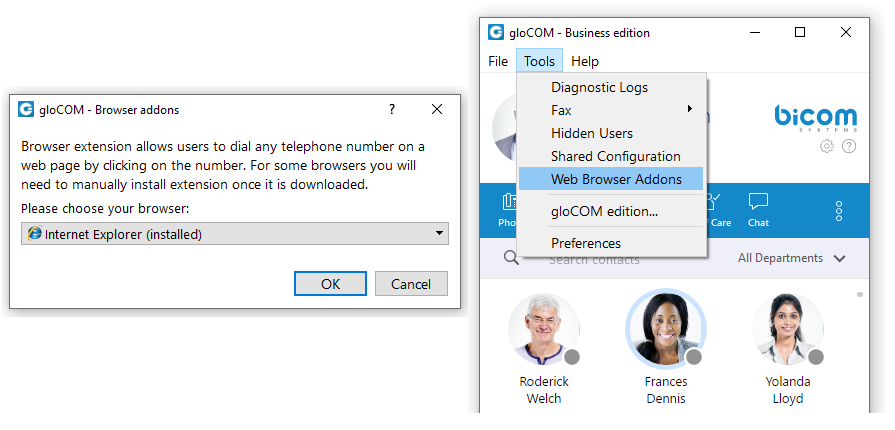
¶ gloCOM edition...
- Change the gloCOM edition.
- Changing gloCOM editions is not possible in case if Shared configuration is enabled.
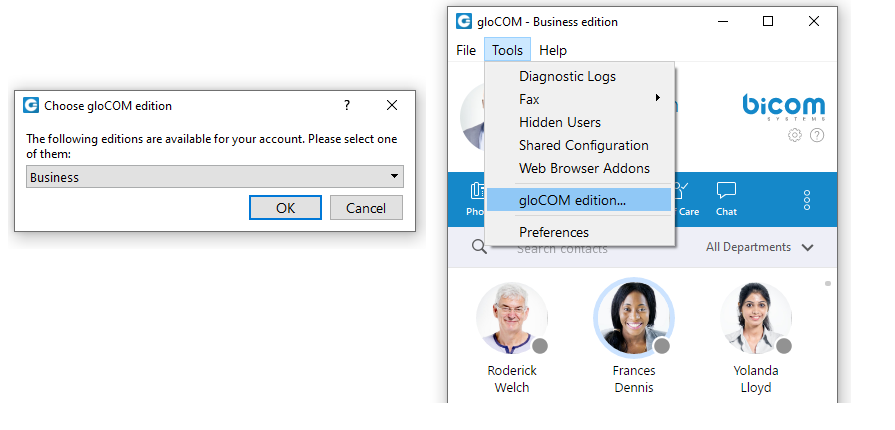
¶ Preferences
Click on Preferences to open gloCOM settings. For more about preferences, please visit the Preferences chapter.
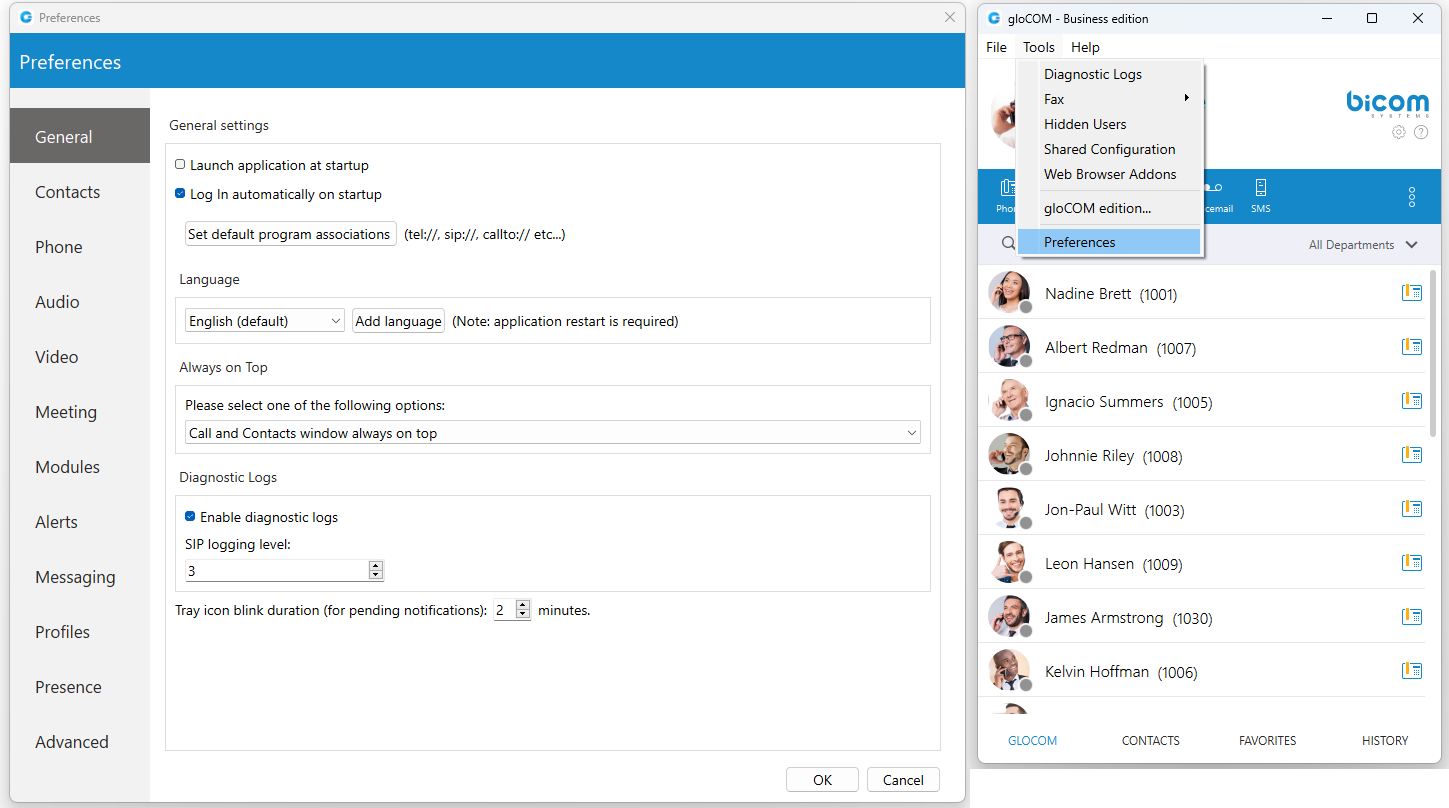
¶ Help
¶ gloCOM Help
- Redirect to our official website [http://www.bicomsystems.com/ www.bicomsystems.com].
- Additional documentation and guides are available on our official website: [http://www.bicomsystems.com/ www.bicomsystems.com]. If you still have any questions, please feel free to contact our support department.
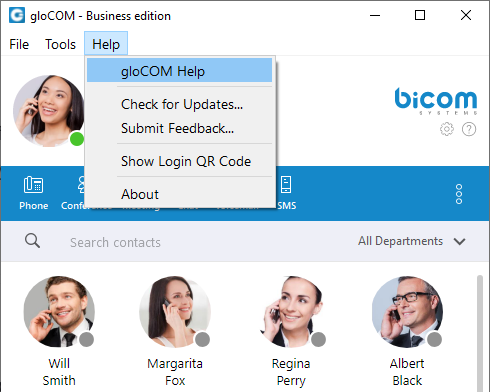
¶ Check for updates
- Check online for official product updates.
- If there are updates available, the software will apply them automatically. If your software is up to date, you will receive a message as stated above.
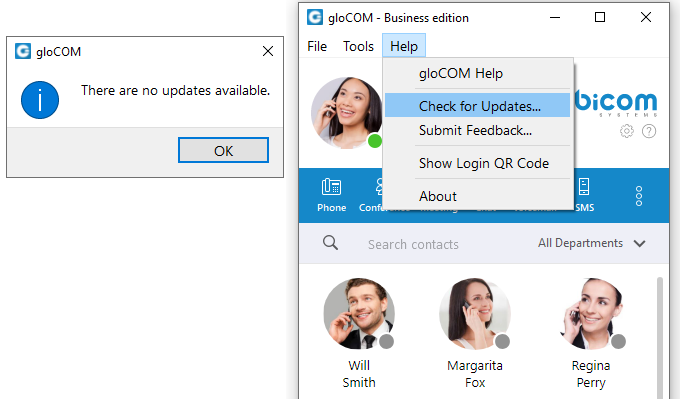
¶ Submit Feedback
- User can now easily send feedback from the Help --> Submit Feedback...
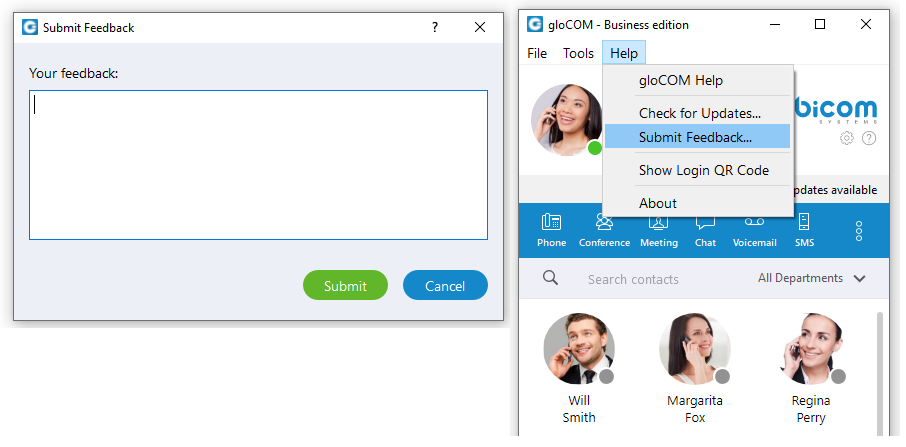
¶ Show Login QR Code
- Show Login QR Code as a part of the gloCOM Desktop allows users easier login to their mobile app by scanning QR Code generated by the gloCOM Desktop app.
- QR Code can be accessed from the Help menu or the three dots menu within the gloCOM Desktop main window.
- Selecting the Show Login QR Code option from one of these menus opens the QR Code window, which will stay open for 15 seconds.
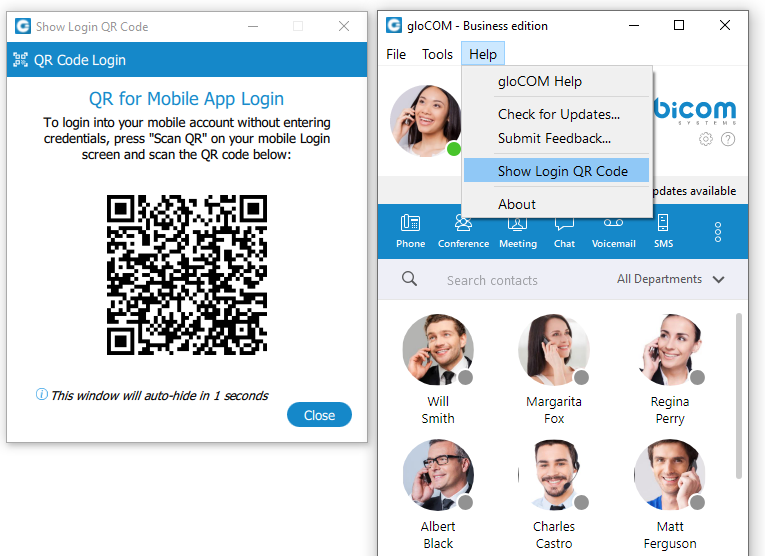
¶ About
- gloCOM About dialog contain information regarding application version, revision, PBX information, libraries, and other important information. Users can easily access/copy and paste info for support if needed.
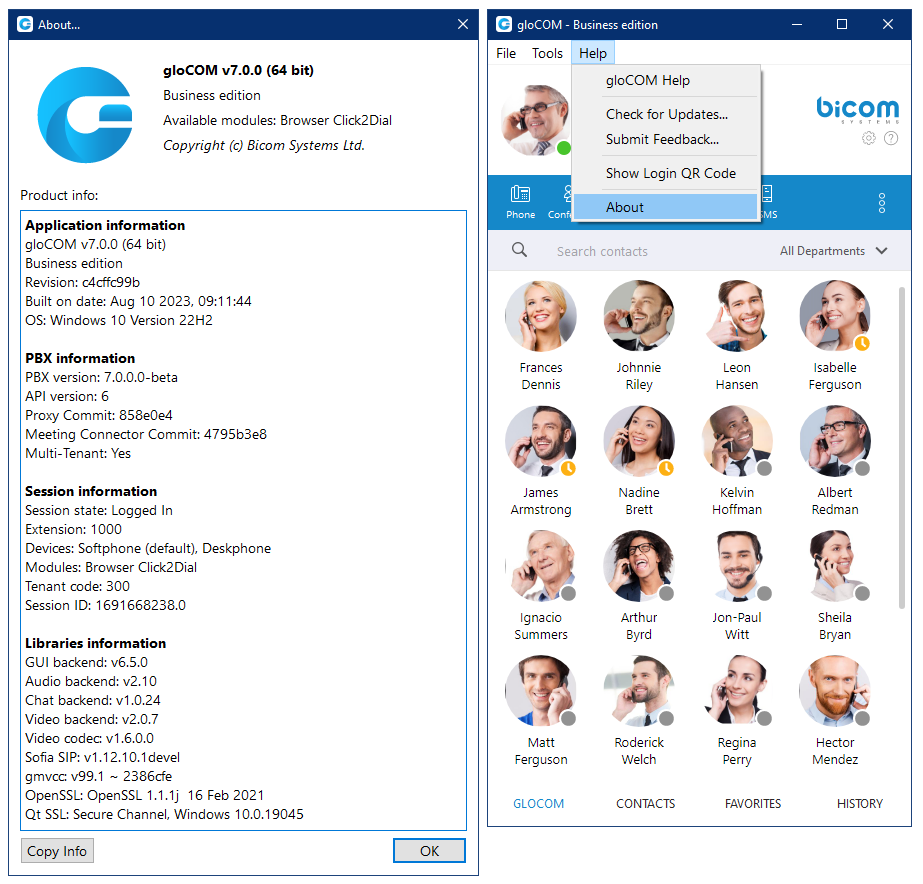
¶ Automatic crash report system.
- When gloCOM crashes, the user has the option to send a crash report for developers to analyze the issue and solve the problem.
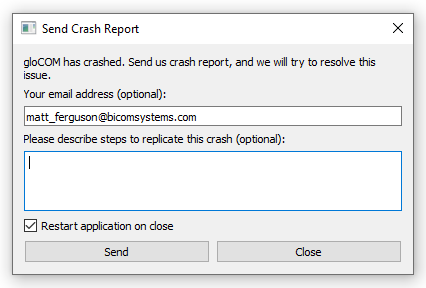
¶ Preferences
Any changes made within the Preferences of the gloCOM Desktop application will be applied only to the gloCOM Desktop application on which they were made.
¶ General
General settings
To start click on the Settings icon inside the toolbar.
Inside the General Settings section, checking the box next to Launch application at startup will start the application when your operating system starts, while checking the Log in automatically on startup will log the user in automatically every time the application is launched.
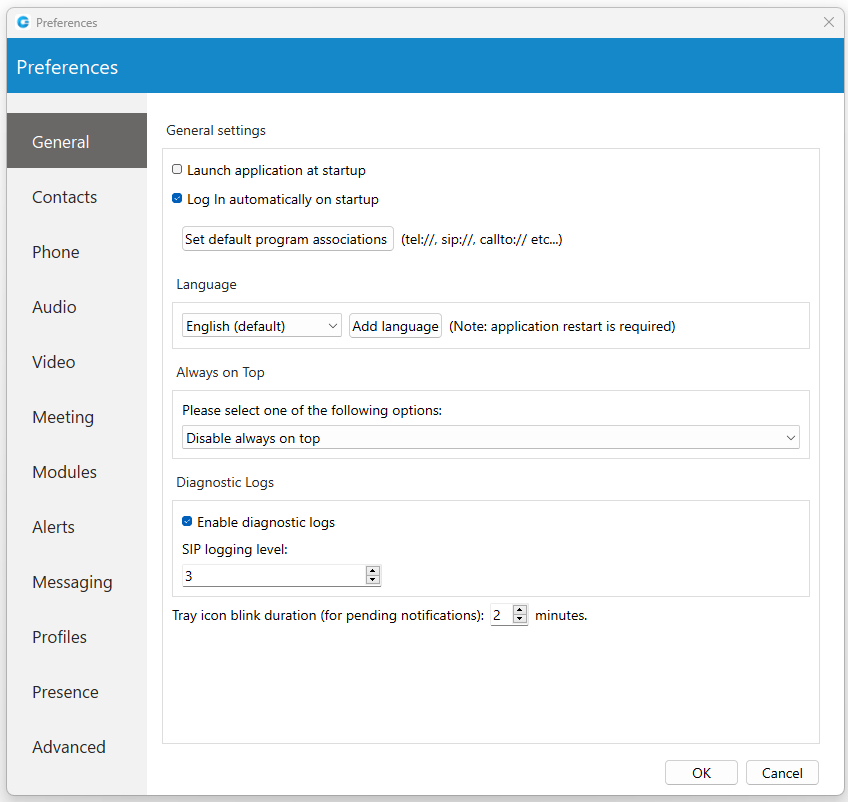
Depending on your Operating System, the Set default program associations button will allow you to choose which protocols the application will open by default (tel://, sip://, callto://, etc.).
From the drop-down menu, you can select the language and if you have your own language file you can add it by clicking the Add language button, then select the language that you wish to add from a list and then choose your language file. You will need to restart the application for the language change to take effect.
Please be informed that some pages in the Supervisor panel will be translated into a language set on PBXware.
Under the Always on Top section, you can choose whether you would like to have a call or call and contacts window always on top or if you wish to disable the always on top option. This feature will keep the gloCOM window on top even if another window, e.g., a web browser window is selected.
You can turn on or off diagnostic logs by checking the box next to it. When turned on, gloCOM will store all logs on your computer/machine. You can specify how much data/information you want to store by editing SIP and Jabber logging levels. By default, the SIP level is set at 3.
Depending on the situation you can choose between 1 to 10 levels where Level 1 would store the least amount of information and Level 10 would store all information.
You can set for how long the gloCOM tray icon will blink while you have notifications pending such as missed calls or unread messages.
¶ Contacts
To start click on the Settings icon inside the toolbar, and navigate to the Contacts settings section. At the top, you have 3 tabs: General, Google, and Outlook.
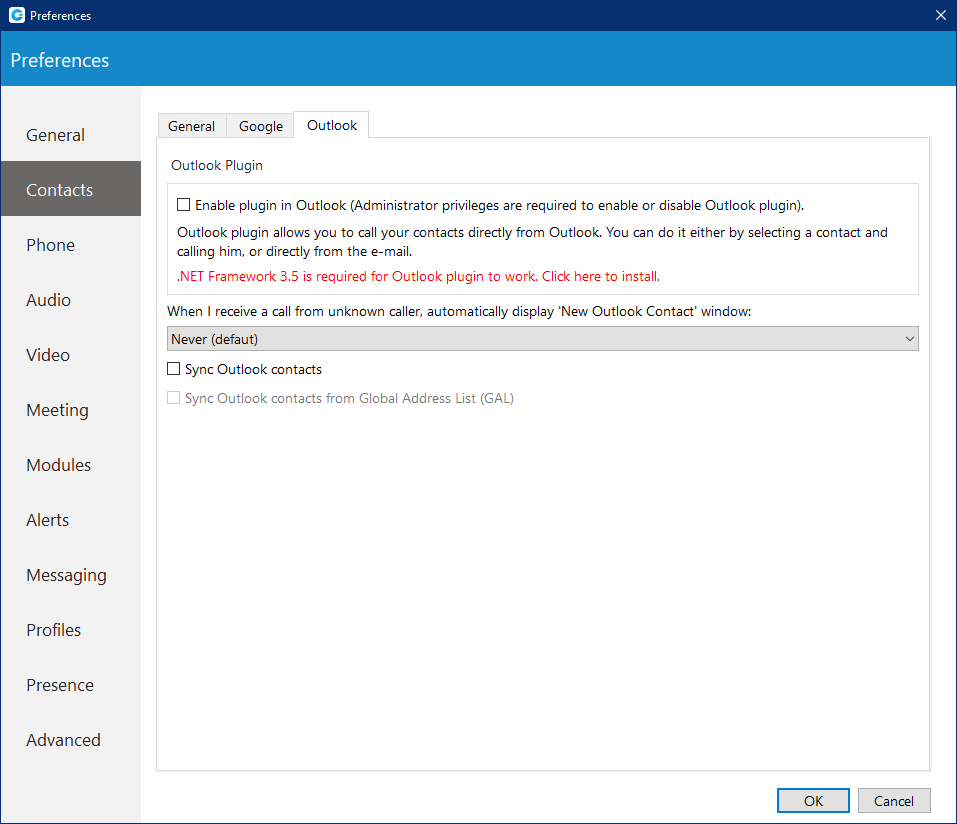
Under the Default contact double-click action you can set what action will be initiated when the user double-clicks on a contact. If chat is selected then a chat window with contacts will open, and if a call is selected then double-clicking the contact will call the contact. If you wish to sync your contacts daily, check the box next to Sync my contacts daily. Furthermore, if the user wants to convert contact numbers to E164 format, they can check the box next to Convert contact numbers to E164 format.
Next, go to the Google tab. Here you can choose to integrate your Google account contacts with gloCOM. Simply check the Enable Google contacts integration, enter your Google email and your Google contacts will sync automatically.
Outlook Plugin with gloCOM navigate to the Outlook tab and check the Enable Plugin in Outlook Contacts box. This will enable you to initiate calls directly from Outlook.
Users can control if Outlook’s add new contact windows shows up on Call started, answered or finished.
gloCOM automatically syncs your Outlook contacts. (When I receive a call from an unknown caller, automatically displays the new Outlook contact window) option, when turned on, it will open a new Outlook contact form every time you receive a call on gloCOM from a number that is not on your contacts list.
To disable syncing Outlook contact from the Global Address List, please navigate to Preferences -> Contacts -> Outlook and uncheck the Sync Outlook contacts from the Global Address List (GAL) option. By default, it is enabled.
¶ Phone
To start click on the Settings icon inside the toolbar, and navigate to the Phone Settings section.
When turned on, Confirm the Number when calling from a web browser and other apps will ask you to confirm the number and will also give you an option to make corrections if necessary. When the Call Waiting option is disabled, the softphone will automatically reject incoming calls if the user is on another call already. Callee will hear a message saying that the user is currently busy on another call.
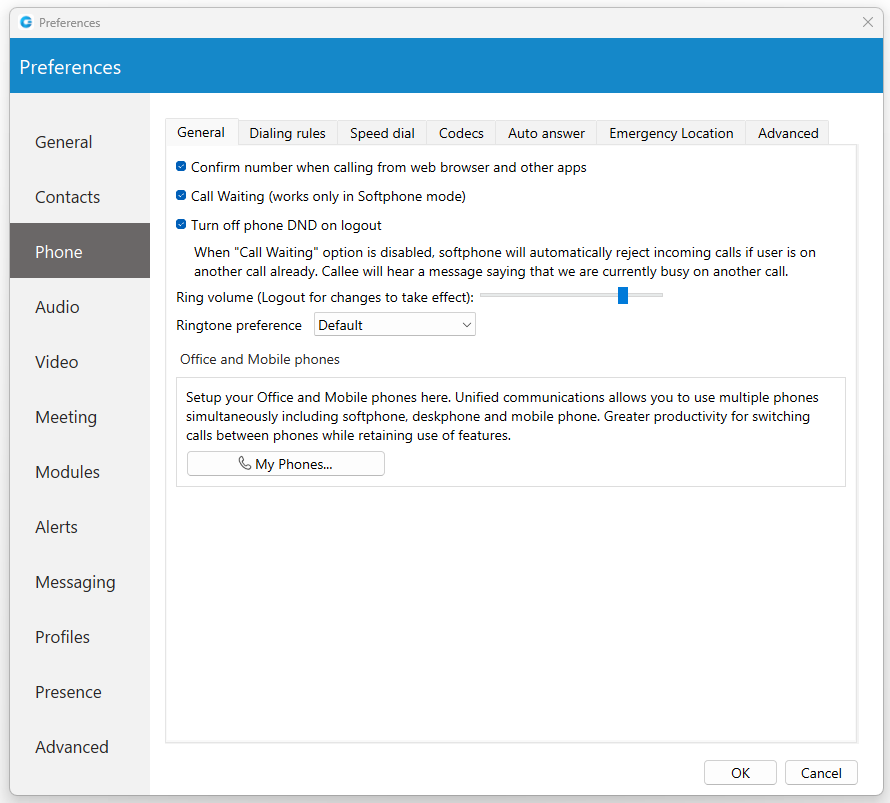
The Turn off phone DND on logout option by default is enabled. When enabled, phone DND will be turned off on logout. Otherwise, phone DND will not be turned off on logout.
Use the ring Volume slider to adjust the ring volume.
The Ringtone preference option allows the user to select between Default, Silent, and Custom ringtone mode for incoming calls.
A Default mode will generate a standard ringtone of gloCOM upon receiving a call. As the name suggests, gloCOM will remain silent upon receiving a call by selecting the ''Silent'' mode.
Additionally, suppose the user decides to use the Custom ringtone mode. After selecting it, the file picker window will be displayed, allowing the user to select the desired audio file as a ringtone for incoming calls. The selected audio file must be in mp3 or wav format. However, thanks to the implemented filter, a file picker window will not display audio files that are not in the formats specified above. This way, the application ensures that the user will not be able to select an audio file with an unsupported format.
You will need to restart the application for changes to take effect. My phones... button allows you setup your deskphone, softphone, and add a mobile number.
Inside the Dialing rules tab you can set rules for outbound calls. e.g., If you enter 061 under text to replace and under replacement text you enter 0038761, gloCOM will replace every phone number that has 061 with 0038761. However, sometimes you would only want to replace numbers that begin with 061, and not the ones ending in 061...
For a more precise replacement, you can use regular expressions. For example, if you enter 061{6}/d under text replacement, and 0038761/1 under replacement text and you turn regular expressions on, this will replace 061 digits of every number that begins with 061 and has 6 more digits with 0038761 followed by those 6 digits. E.g. 061-123-456 would be replaced with 0038761-123-456.
Enabling the Detect and format USA and UK phone numbers for outbound calls option will auto-detect and format your local USA & UK numbers so that they can go through the system. This may cause problems in some countries so be careful when using this feature.
Inside the Speed Dial tab click on the Add button and from a drop-down menu and choose a number from 1 to 99, and in the field next to it assign the phone number that you want to Speed dial. For example, dialing #7 will dial 061-123-456 To edit an existing speed dial number select the number from the list and click the Edit button or press Remove to remove the number.
Inside the Codecs tab, select the codecs that you wish to use. Some codecs offer higher quality but take more bandwidth, some offer better compression so they are less heavy on network resources, depending on your needs you might want to turn some codecs on or off, and if you have more than one codec you can sort them by priority using the up and down arrows on the right.
Inside the Advanced tab, you can choose to turn the encryption on or off for voice and video calls, or you can select Use the settings from server to use the settings that your admin has set.
Under the Register field, you can set how often gloCOM will send the SIP register to the SIP Server or VoIP provider to let it know where it is. It is recommended to leave the local sip port empty to allow SIP Protocol to use any port available. However, if you wish to restrict SIP (outgoing) traffic to a specific port you can enter the port number here.
Check the Send keep alives option to send SIP keep-alive to the server.
Check the Enable QoS to enable the Quality of Service feature. QoS is a set of technologies that work on a network to guarantee its ability to dependably run high-priority applications and traffic under limited network capacity (must be supported by the user network).
¶ Emergency Location - Ray Baum’s act
Ray Baum’s Act requires that first responders have the necessary information needed to pinpoint the “dispatchable location”, and quickly reach a 911/112 caller regardless of the device they dial from or their exact location inside a large building.
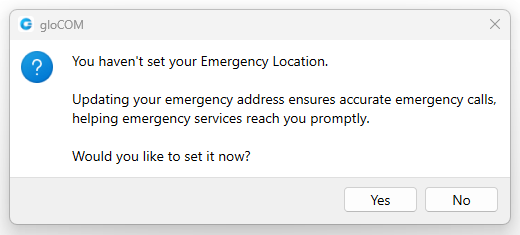
For VoIP trunk testing purposes, please use the number 933.
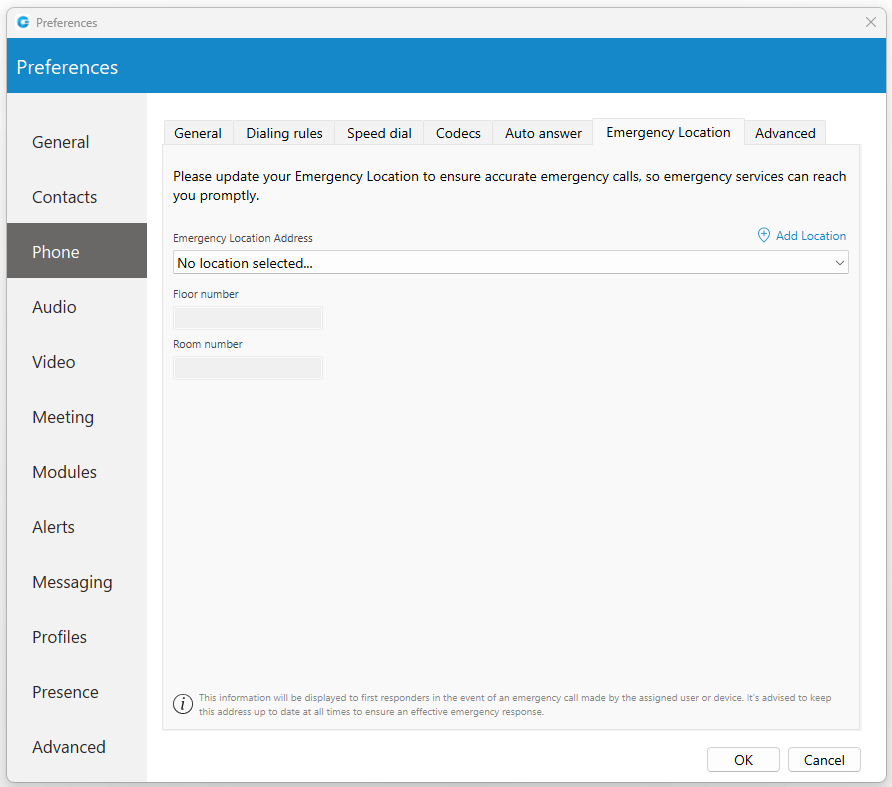
Regarding the above, the Emergency Location feature will only be available when the server locality is set to the United States.
If a user's Emergency Location is not set within the app, a pop-up message will appear on login asking them to set their location.
Also, the location can be set by navigating to the Preferences -> Phone -> Emergency Location tab, where the user can set their Emergency Location Address, Floor number, and Room number or add a new location.
Emergency Location will be displayed within the Phone window after entering the 911/112/933 number, with the possibility to change or set it.
Users should always keep their Emergency Location up to date to ensure an accurate location is provided to the emergency call dispatcher.
Also, it will be displayed within the Call window.
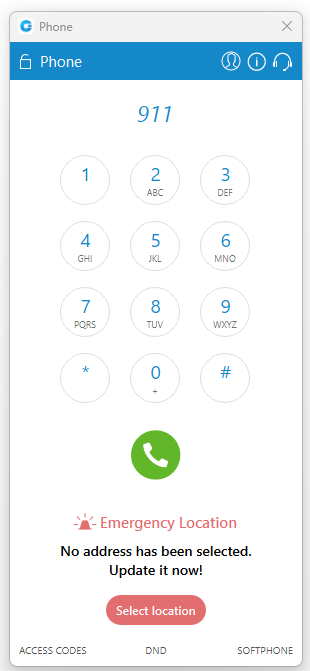
¶ Audio
You can set input, output, and ringtone devices, or test your devices. To test your microphone, say something on it and watch the changes in the microphone progress bar. For testing your speaker or ringing device, press the Test button to hear a sound on the selected device.
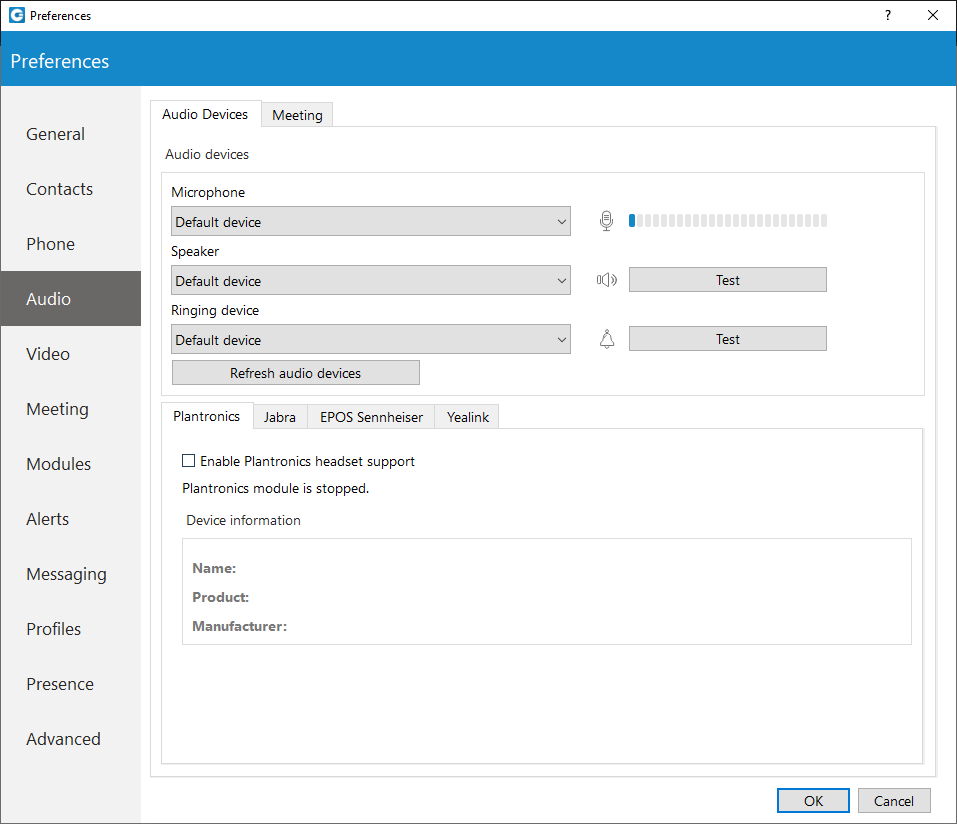
Check the Enable Plantronics headset support option in order to integrate a Plantronics headset with gloCOM. This will enable the use of Plantronics headset buttons such as answer, hold, transfer...
The same applies for Jabra and EPOS Sennheiser headsets. Turn on the Enable Jabra headset support option, in order to integrate a Jabra headset with gloCOM. Turn on the Enable EPOS Sennheiser headset support option, in order to integrate an EPOS Sennheiser headset with gloCOM.
Check the Enable Yealink headset integration option to integrate a Yealink headset with gloCOM. It will enable Yealink headset buttons such as answer, hold, transfer, etc...
¶ Plantronics Runtime (Only for Windows)
gloCOM deploys Plantronics Runtime, which is required for the Plantronics module to work properly. Runtime is installed automatically during the setup wizard.
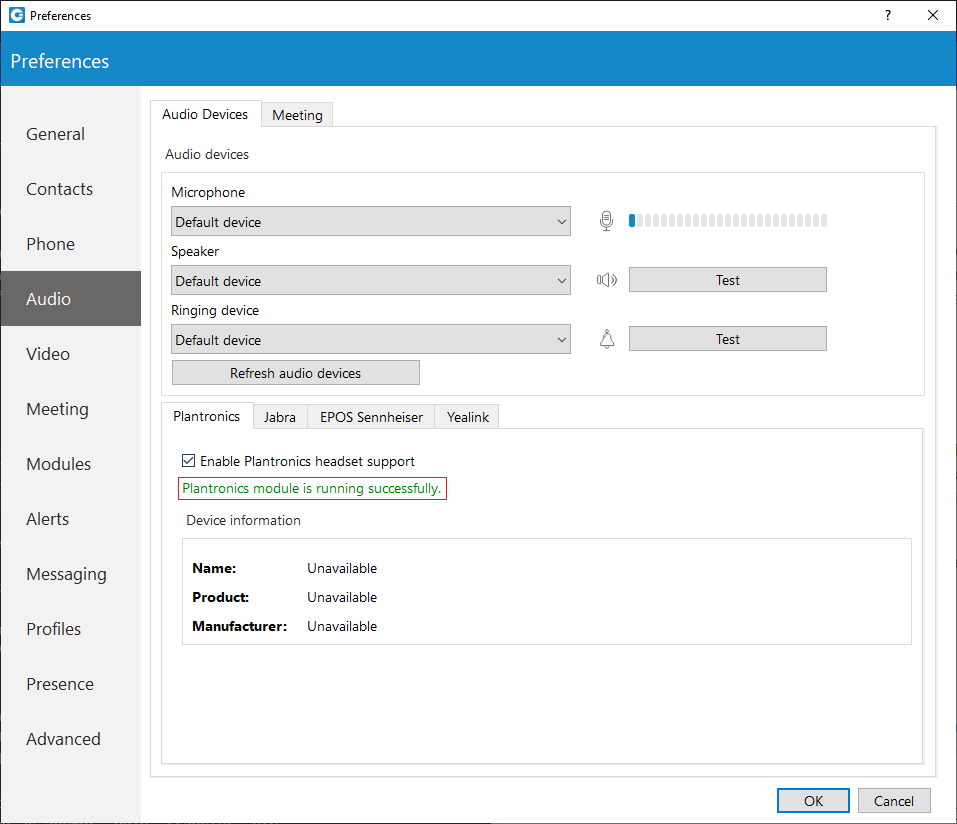
If Runtime is not installed properly for whatever reason, gloCOM will detect it on startup and automatically alert the user about it. It will redirect the user to the Preferences --> Audio dialog where gloCOM allows the user to install Runtime manually. To do that, check the Enable Plantronics headset support option, and click on the Install Plantronics Runtime.
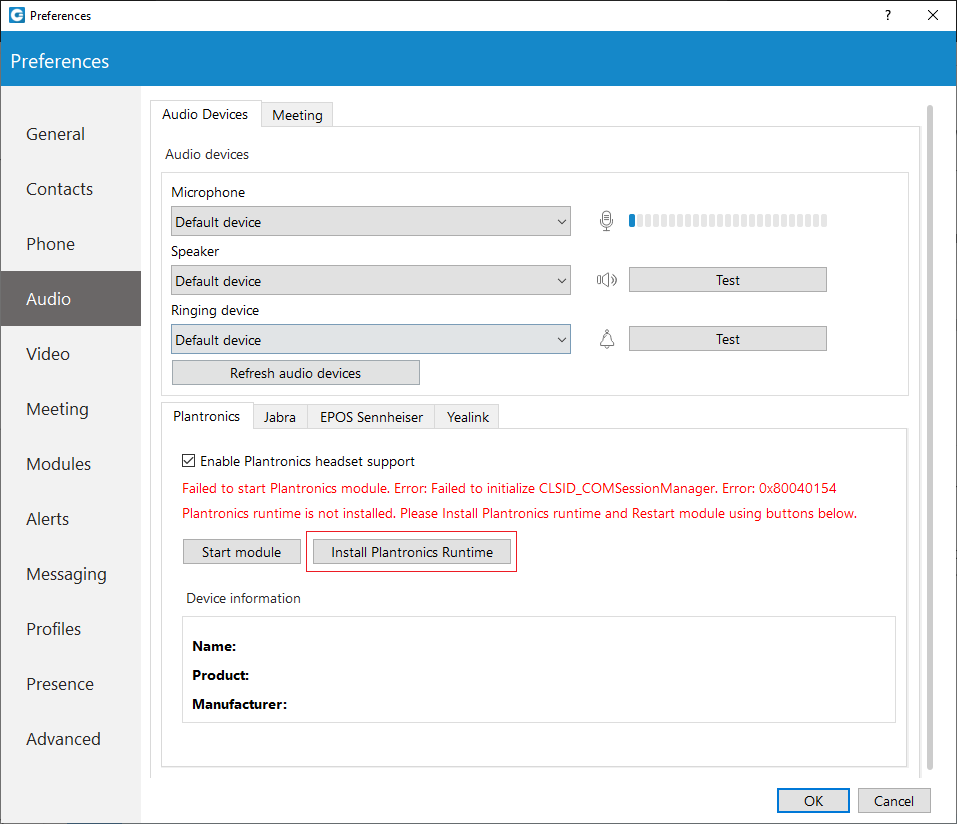
MSI installer cannot install Plantronics Runtime automatically because Windows OS does not allow to run two MSI installers at the same time. In case you are using the MIS installer to install gloCOM, you should start gloCOM manually and install Plantronics Runtime from the Audio dialog. To do that, please navigate to Preferences --> Audio. Check the Enable Plantronics headset support button, and click on the Install Plantronics Runtime, or go to the gloCOM installation folder → Plantronics subfolder, and run all three MSI installers for Plantronics Runtime.
¶ Video
Video Settings section is divided into 5 tabs. Inside the Quality tab, you can set the resolution of the video call. You should adjust these settings based on the quality of your network connection.
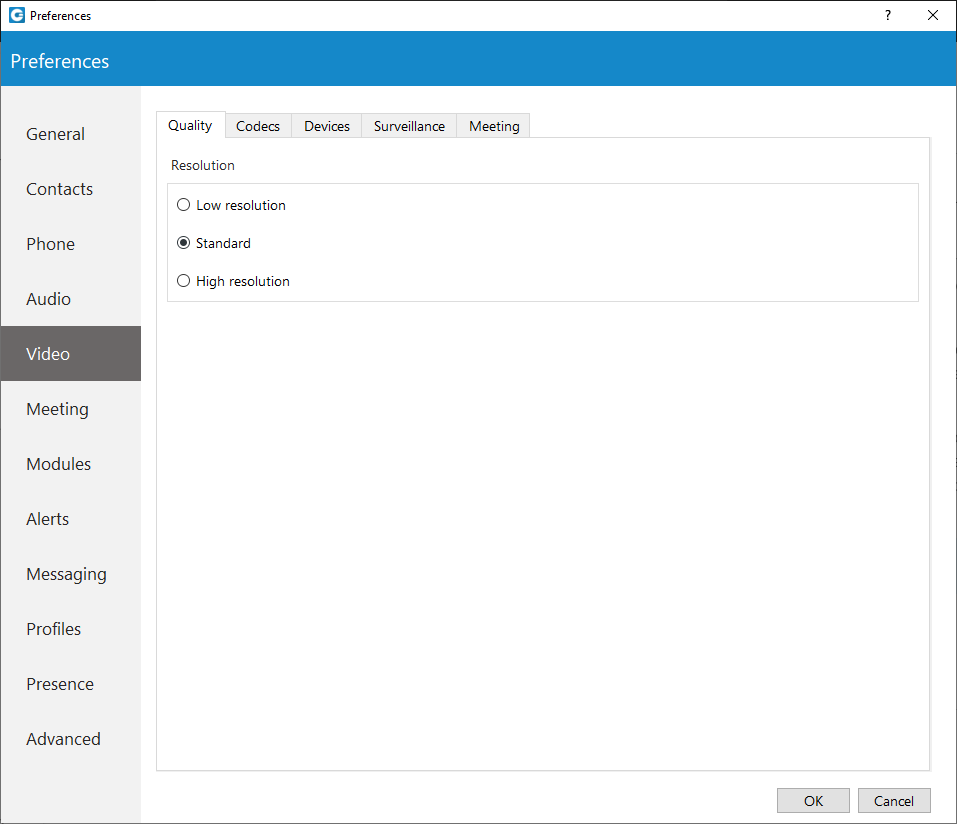
For example: If your bandwidth is low or you are experiencing temporary network issues, you can set the video quality to Low resolution to get better video call performance. Inside the Codecs tab, you can enable or disable video codecs, and if you have more than one codec you can sort them by priority using the up and down arrows on the right.
Under Advanced codecs settings, you can adjust how much compression the codecs will use. The higher the bitrate the less compression codecs will use, which directly relates to better video quality but also larger files. Use default values for codecs if you are not familiar with video codecs.
Inside the Devices tab, you can select the video capture device. e.g., if you have a laptop with an integrated web camera, and you connect another web camera to your laptop, you can specify which camera gloCOM will use for video the call from a drop-down menu. Next, inside the surveillance camera tab, you can enable or disable the surveillance camera and choose if the surveillance camera video should always stay on top even if another window is selected. Under the URL field, enter the URL of your IP surveillance camera stream.
Please be aware that only MJEPG stream over HTTP is supported at the moment.
¶ Meeting
In the Meeting menu, you can set how will your meeting window look when someone shares the screen.
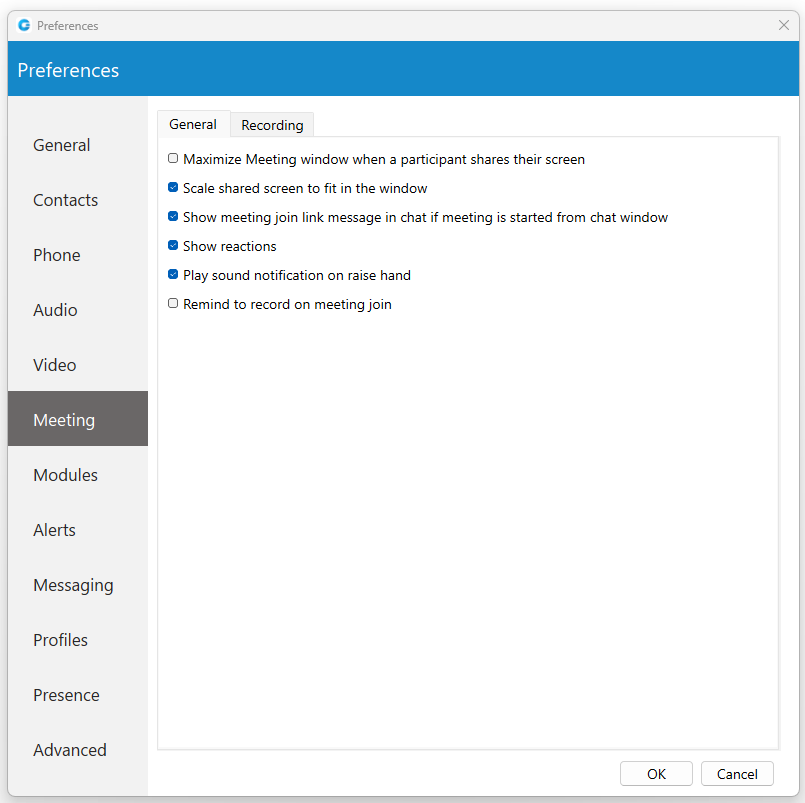
You have two options:
- Maximize Meeting window when a participant shares their screen.
- Scale shared screen to fit in the window

¶ Modules
gloCOM is compatible with several Customer Relationship Management solutions, such as Salesforce, SugarCRM, Zoho, Zendesk, MS Dynamics, and Bullhorn.
¶ CRM
To enable CRM integration with gloCOM, click on the Settings icon, navigate to the CRM section and check the box next to Enable CRM integration.
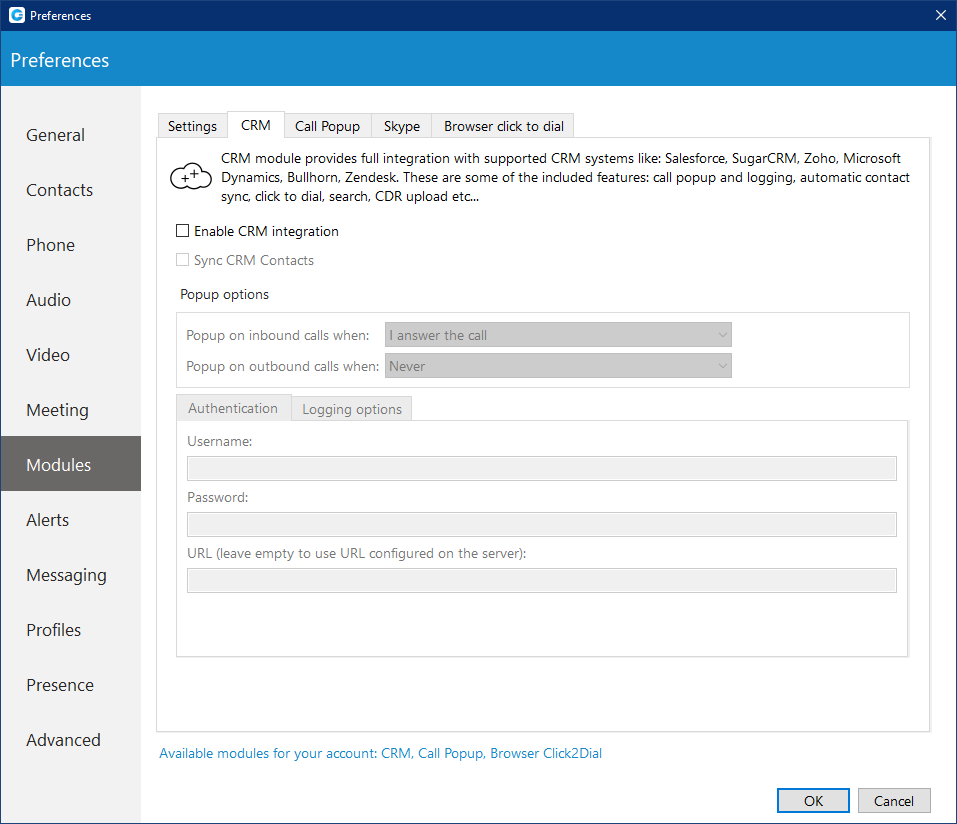
Under the Popup Options the users can set:
- When a page with customer information should open (This can be set to open when answering the call, or immediately when the phone starts ringing before even answering, and not to open at all for Incoming calls).
- For Outbound calls, the users can set it to pop up when the call is initiated or when the call is answered, and same as with Incoming calls this can be disabled by selecting the option Never.
Under the Authentication, users can enter account details for CRM. Each CRM is different and requires from the user to enter a security token, password, or a combination of both.
Under the Logging options, users can specify which information they want to log. Also, users can choose to log information that their admin has set by selecting the Use the settings from the server option.
¶ Call Popup
Call Popup module can be used to push the call details to the browser or third-party software.
It is possible to do a Call popup based on the URL, and this can be set per Queue and ERG. This can be done only if the option "Enable Queue/ERG URL Popup. If enabled, application will use URL configured on server." is checked. (Preferences --> Modules --> Call Popup).
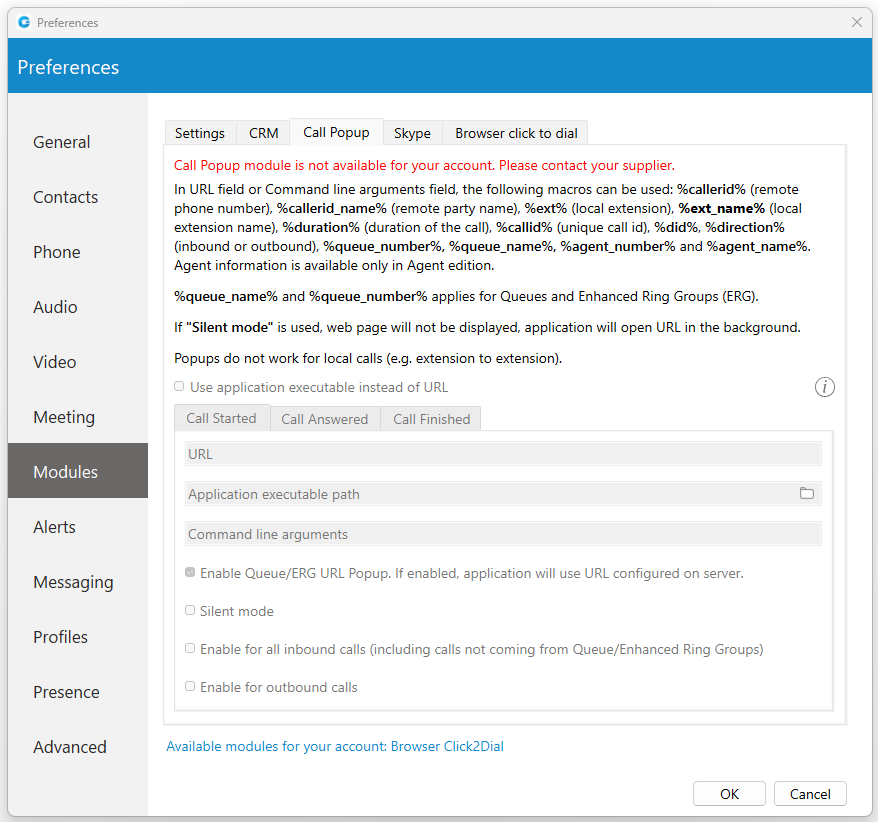
Users can set the Call popup to open when the call has started/answered or when the call has finished. For each setting, the user can specify to enable it for Inbound and/or Outbound calls, and turn it on Silent mode. In the Silent mode, a URL request will silently be sent to the server, meaning it will not open a web browser.
Call popup is macro-based. In the URL field the following macros can be used: callerid, callerid_name, ext, ext_name, duration, callid, did, direction, queue_number, queue_name, agent_number and agent_name.
(e.g., In Call started URL field the user may enter yourcrm.com/calls?id=�llerid% and check the Inbound calls below. Now, whenever the user receives a call from a customer Call popup will open a web browser and will write the customer’s phone number.).
All this information can be sent silently to the user's CRM server and create reports such as how many inbound calls the user has received, how many outbound calls the user has made, average call duration, etc.
Specify EXE file, APP in MacOS, or URL that will be executed in Call Popup module.
¶ Alerts
To start click on the Settings icon inside the toolbar and navigate to the Alerts section. Check the bring application to front when I receive a call option to bring gloCOM to the front whenever someone calls you. You might not want to have your work interrupted by call alerts, in that case, you can uncheck this option. You will still be able to receive the calls, however, you will have to navigate to the application yourself.
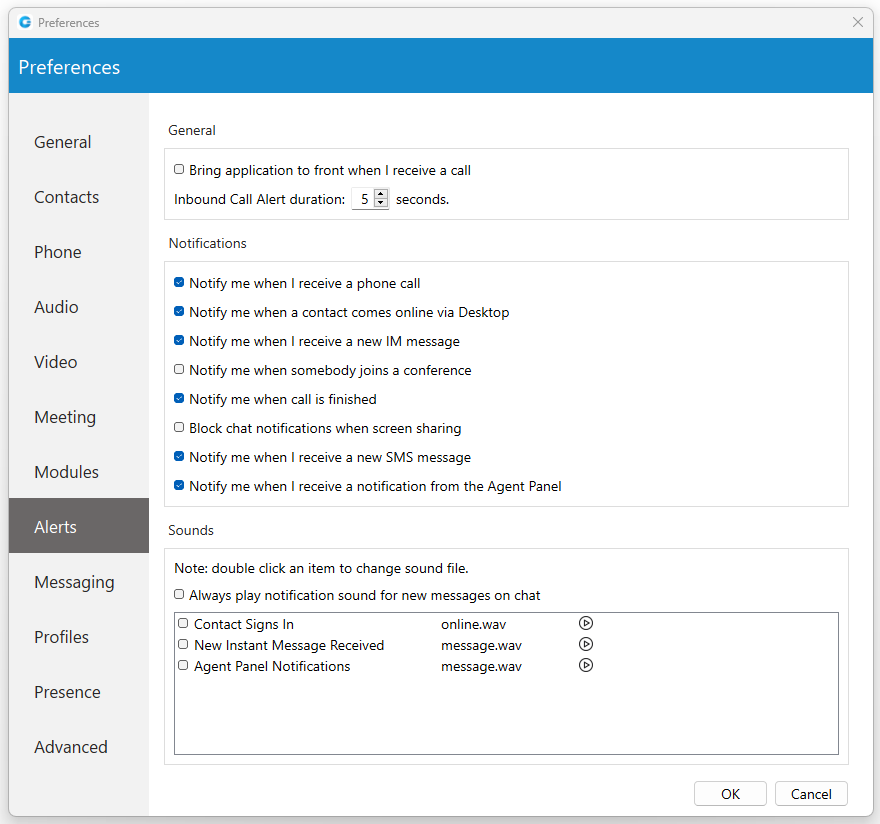
If you want the Agent panel to pop up when you receive a call please navigate to the Alerts section in Preferences and check the option Bring application to front when I receive a call.
Inbound Call Alert duration can be set between 5 and 15 seconds. This option controls the duration of a small notification window that pops up in a lower right corner of the screen whenever you receive a call.
To turn off the inbound call alert completely, simply uncheck the Notify me when I receive a phone call option. You can also set to receive notifications when a contact comes online, when you receive a new message, when somebody joins a conference, when a call is finished, and etc. Only the duration of the call alert notification can be adjusted, all other notifications have a fixed duration of 5 seconds.
Under the Sounds section, you can choose to turn sound notifications on or off for contact sign-in and or for new chat messages. If you select Always play notification sound for new messages, you will hear a sound notification for every message received, even if you have a chat window currently open. For this feature to work the New instant message received option has to be selected as well, otherwise, you will hear no sound.
To preview a sound, click on the play button on the right, and if you wish to change a sound, double-click an item and select the sound file you wish to use. Please note that only .wav files are supported.
¶ Messaging
Click on the drop-down menu below the Save received files to and select Other to specify the location where gloCOM will save received files. Under the Change font menu, the user can choose the default font for the chat layout.
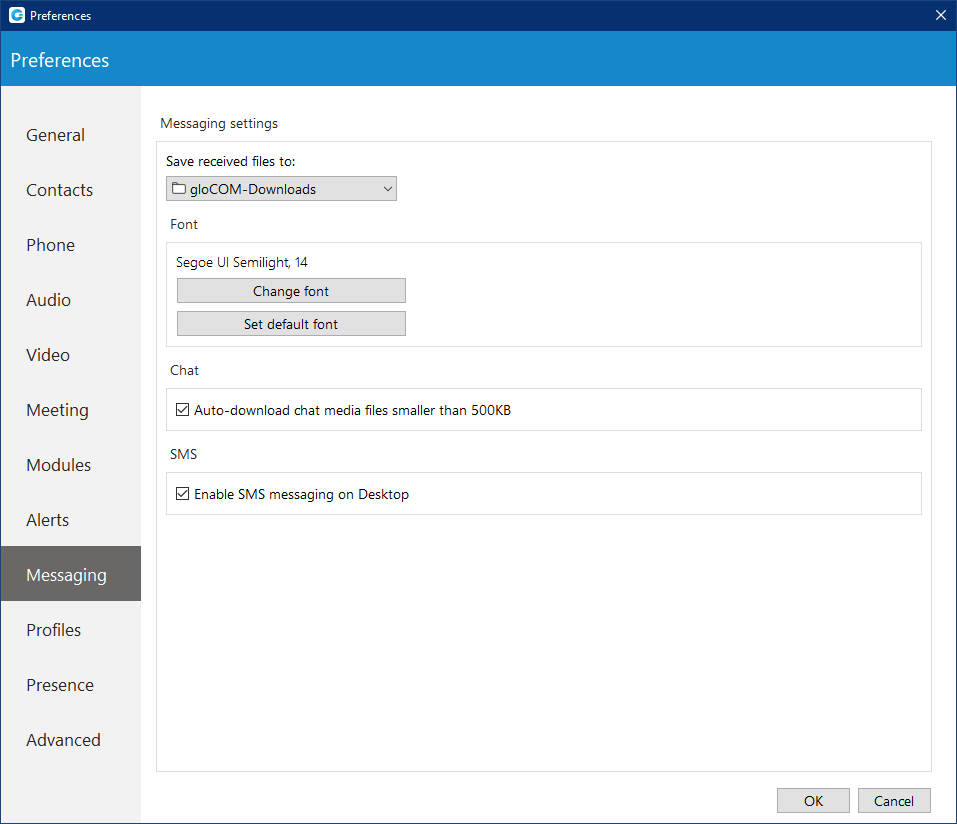
The Auto-download chat media files smaller than 500 KB option allows the user to enable/disable auto-download for media files smaller than 500 KB within the chat conversations. By default, this option is enabled. (Does not apply to SMS conversations.)
Changes in this section will apply to both Chat and SMS messages.
¶ Profiles
To enable profiles click on the Enable multiple login profiles mode. With this option enabled you can add, edit or remove an existing profile.
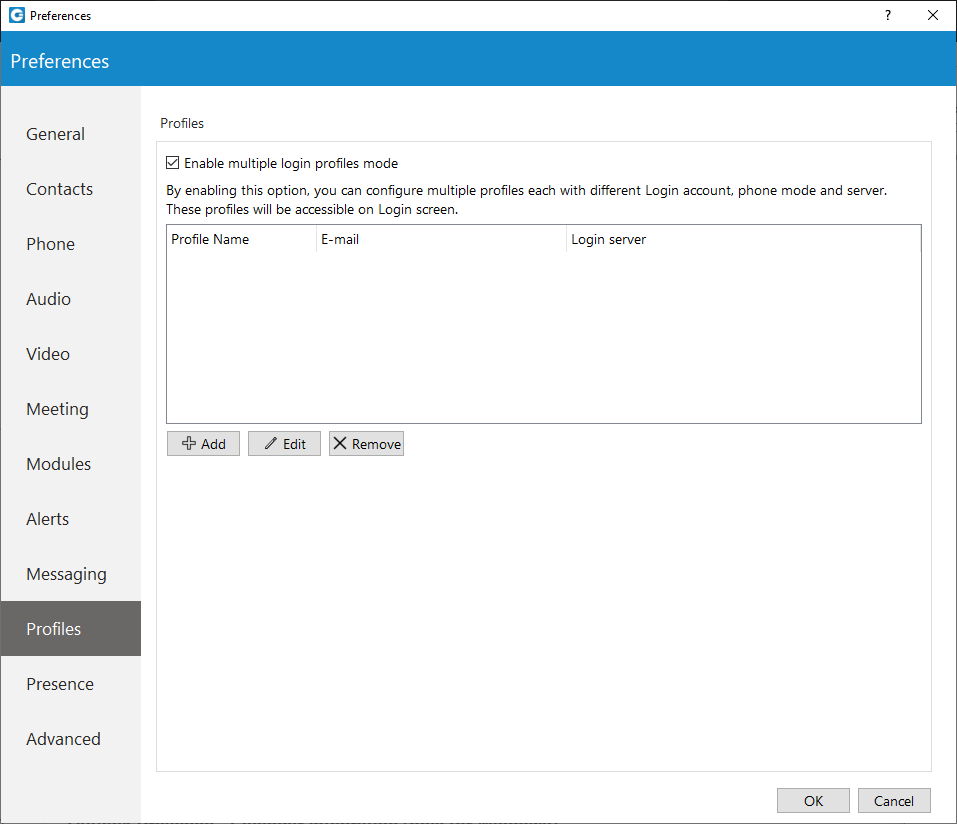
To add a profile click the Add button, follow the setup wizard, enter the profile name, enter your gloCOM email and password, and under the Advanced tab enter the server address, and if needed specify the SIP proxy as well. When done click Next to continue.
Adjust the phone settings to your preference and click Next, review your information once more, and click Finish to create a profile. Once created you can edit the profile by selecting it from the list, and clicking the Edit button or you can remove the selected profile by clicking the Remove button.
To log in with your newly created profile on the gloCOM login screen, from a profile drop-down menu select your profile and click on the Login button.
¶ Presence
¶ Busylight
Busylight integration allows users to use their Busylight devices as a part of the gloCOM Desktop application. This way, they can inform colleagues about their current presence status.
To start using Busylight integration, click on the Settings icon placed on the right side of the main window just above the blue bar, navigate to the Busylight section, and check the Enable Busylight integration option. On the right side of the window, the user can see the status message, which gives them information on whether their device is connected or not.
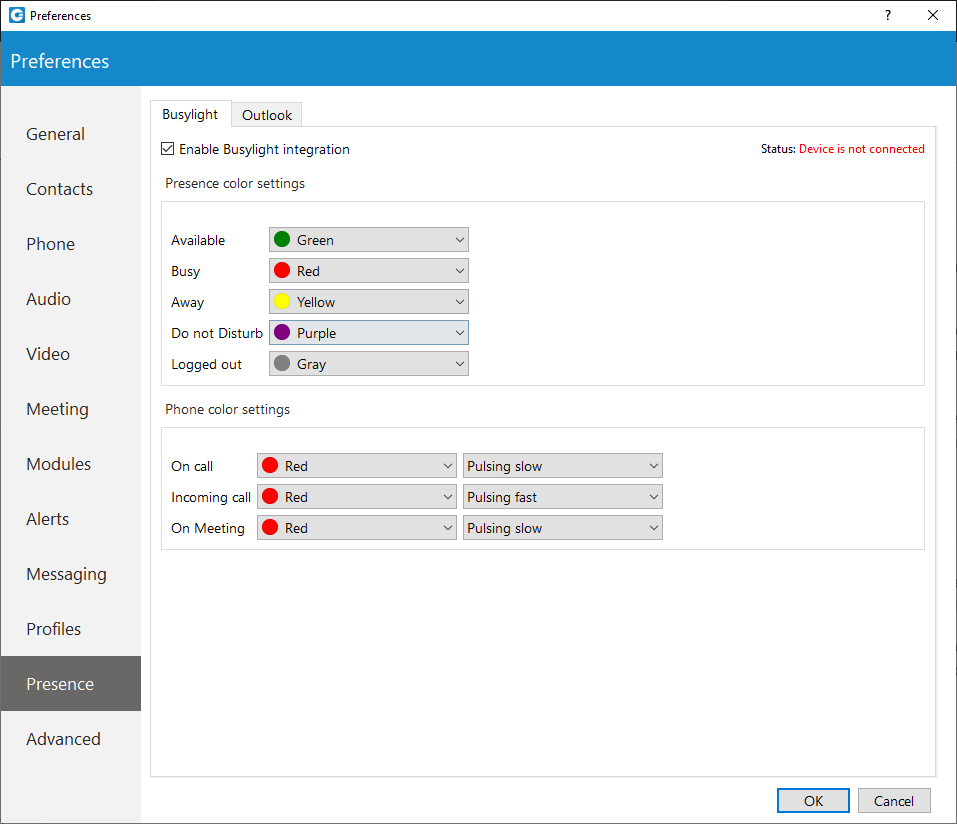
Furthermore, users can change the Presence status color for each status per their wish. By default, these colors match the Presence status colors within the gloCOM app, and we do not recommend changing them. Additionally, users can change Phone status color and pulse rate as well.
¶ Outlook Presence - Calendar integration (only for Windows)
Outlook presence integration works only for Windows. To enable Outlook integration with the gloCOM Desktop application, please, navigate to the Preference --> Presence --> Outlook and check the Enable Presence - Outlook Calendar Integration option, which is disabled by default.
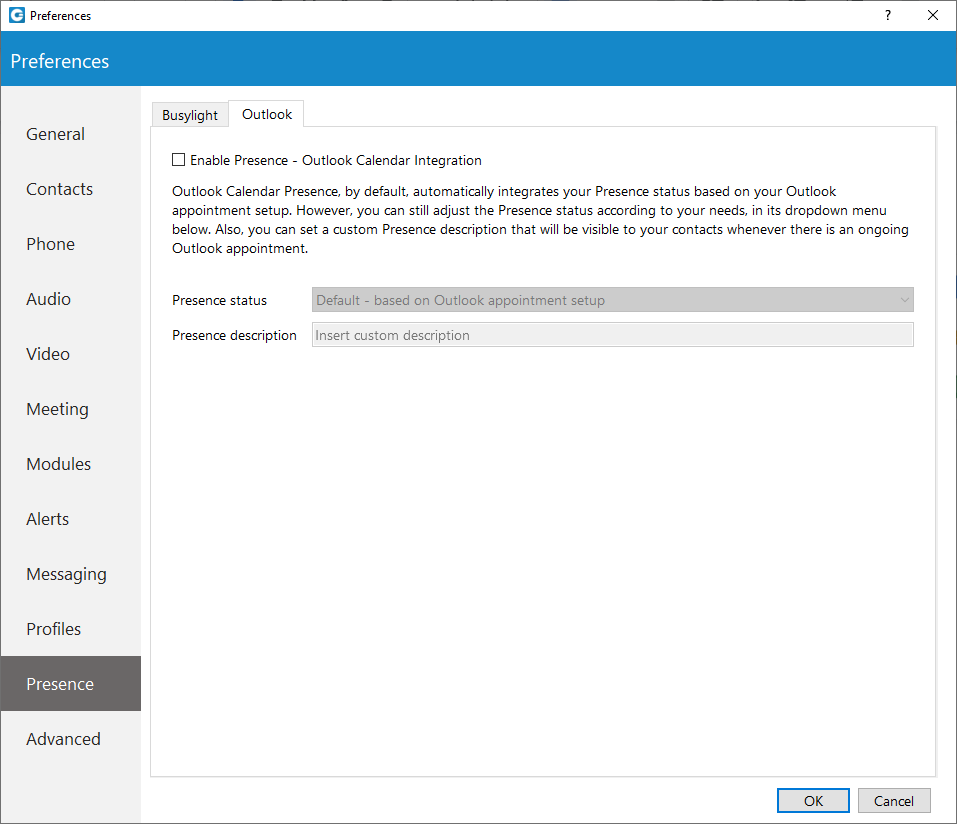
Outlook Calendar Presence, by default, automatically integrates users' Presence status based on their Outlook appointment setup. However, the user can still adjust their Presence status according to their needs. Also, they can set a custom Presence description that will be visible to their contacts whenever there is an ongoing Outlook appointment.
¶ Advanced
In the Advanced menu you can change the Polycom listening port to suit requirements of your Polycom phone.
The default port is set to 10983 which can be changed by clicking inside the box and entering your listening port number.
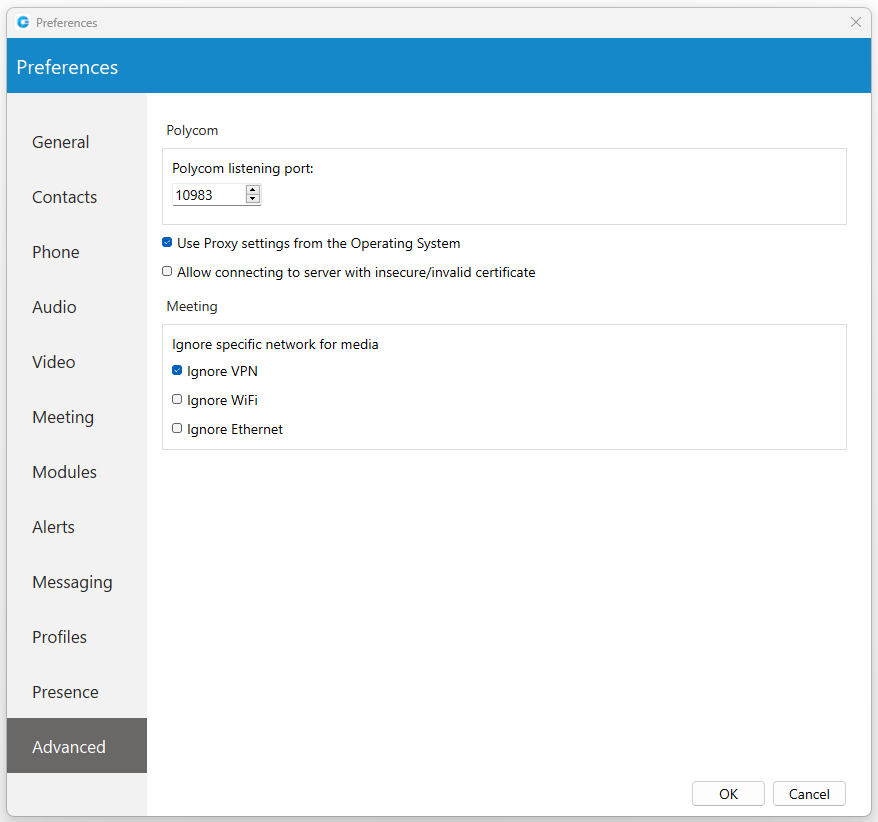
¶ Skype for Business Module
Skype For Business module is used for integration between Skype For Business and gloCOM. The idea behind this module is to provide integration between Skype For Business client and the user’s phone system (PBXware).
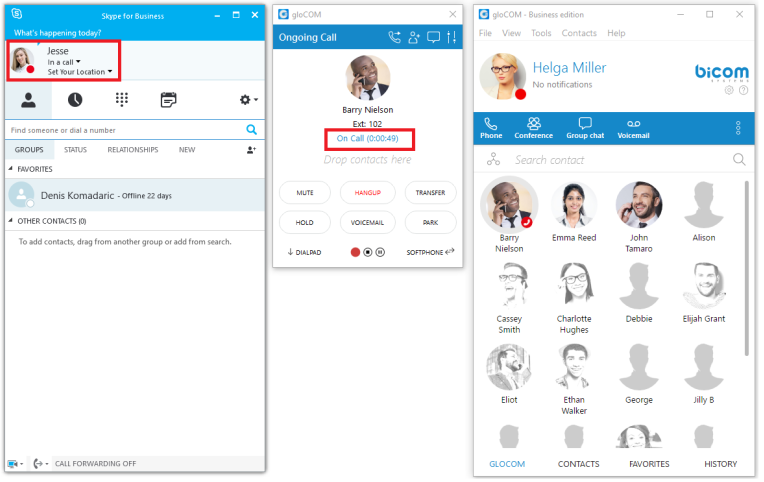
It consists of four parts:
- Presence
- Click to dial
- Conferencing
- Control of ANY SIP deskphone/softphone/mobile device registered on the PBXware telephony platform from the PC.
¶ Presence
Whenever a user is on a call with ANY of their devices, including deskphone, softphone, or mobile phone, Skype For Business will change its presence automatically, and other Skype users will see this presence as On a call. Once the call is completed, Skype presence will revert back to the previous state.
Red marked squares are showing status change inside Skype for Business.
¶ Click to Dial
The click-to-dial plugin allows you to make regular or conference calls from Skype For Business using the PBXware phone system. It allows the user to use ANY of their devices to make the call through their Phone System.
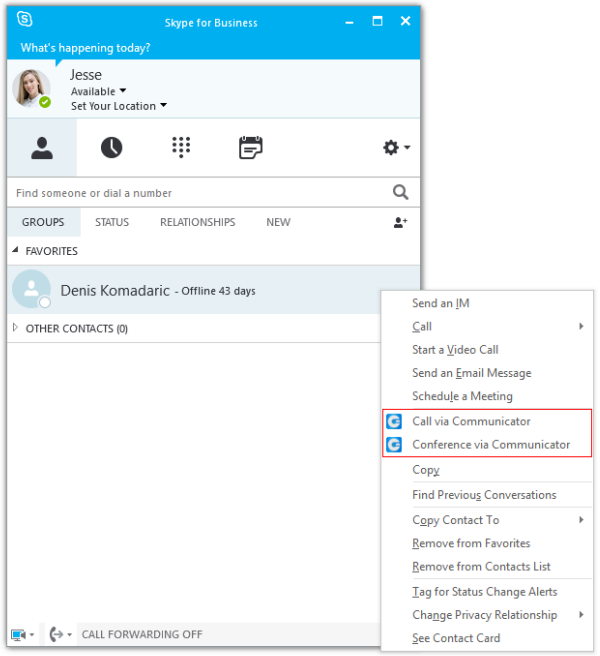
This includes: deskphone, softphone, and mobile phone. The user can even make a call from Skype with a single click through the mobile network (GSM) and Skype will still show its status as On Call until the user hangs up on GSM. When click to dial plugin is enabled, two options appear in Skype For Business: Call via gloCOM and Conference via gloCOM.
When we click on the Call via gloCOM option, a dialogue appears, as seen in the next image. We have to choose the contact number that we want to call and the device from which we want to make a call. Only one Skype For Business contacts can be selected if we want to use this option. If the check box below Show this window before placing a call is selected, every time we are placing a call from Skype for Business this window will popup (this can be changed in preferences). Once we press Call, the call will be placed, in this case using our deskphone.
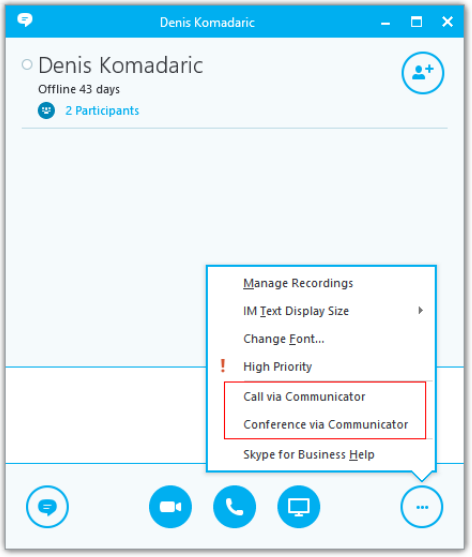
¶ Conferencing
We can also invite gloCOM contacts to this conference. We add them by typing their name or number into the search field where we can also enter any other number we want and then press Enter. X button is used to remove contact/number from the list of users that we want to invite to the conference. Once we press Start Conference, an audio bridge will be automatically created on the PBX, and all the invitees will join automatically. We will join on our deskphone in this example. Although the call is in progress on our deskphone, we can see and control this audio conference on the PC in the gloCOM app, as displayed in the next image.
¶ Settings
If we want to enable/disable Skype For Business module plugins for all gloCOM users on one computer, we need to navigate to Preferences --> Modules --> Skype. After we enable/disable Skype For Business module plugins, we have to restart the Skype For Business application in order to apply the changes made. Even if these plugins are enabled, we can use them only if the logged user has Skype For Business module enabled by the supplier.
